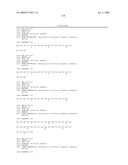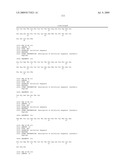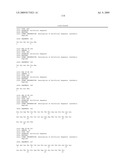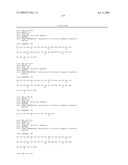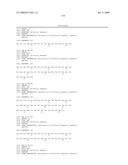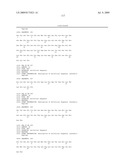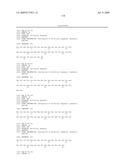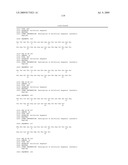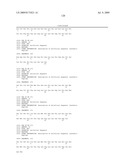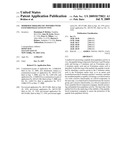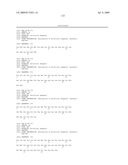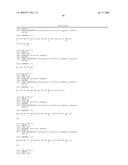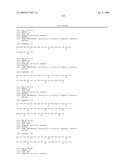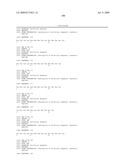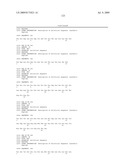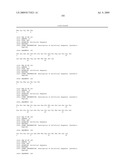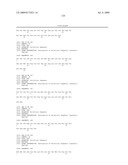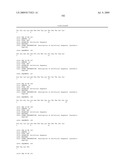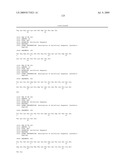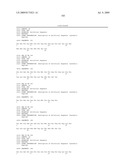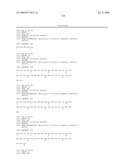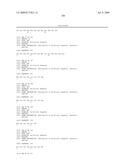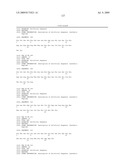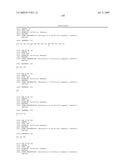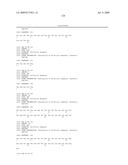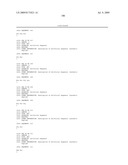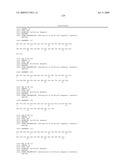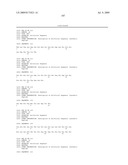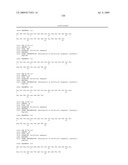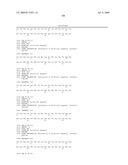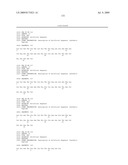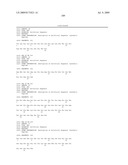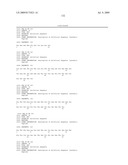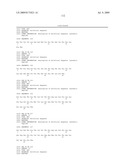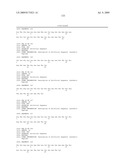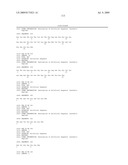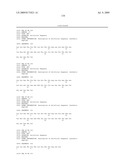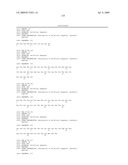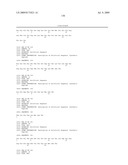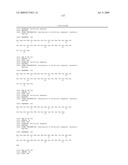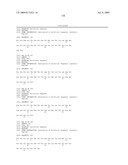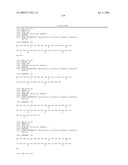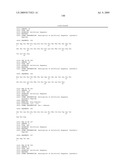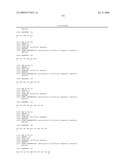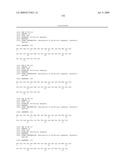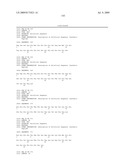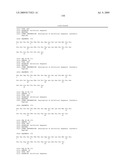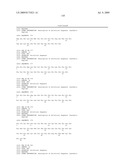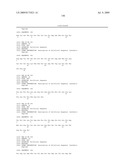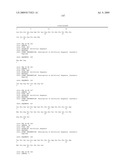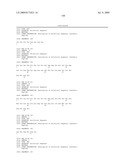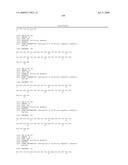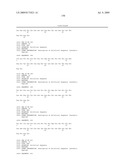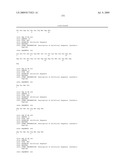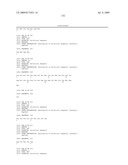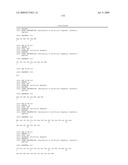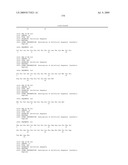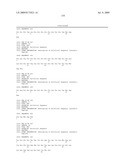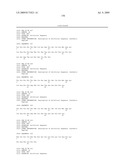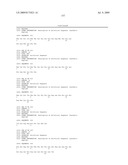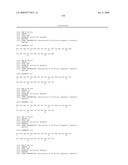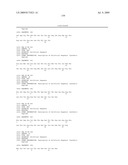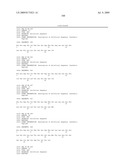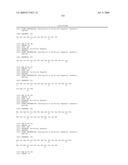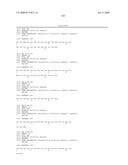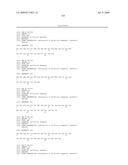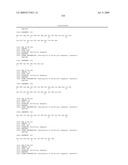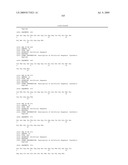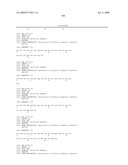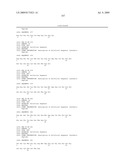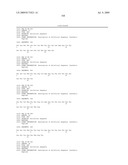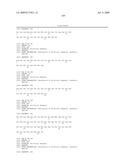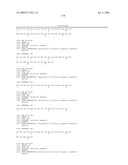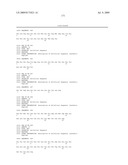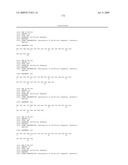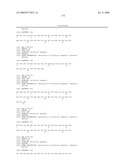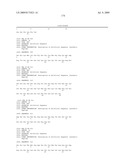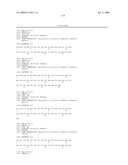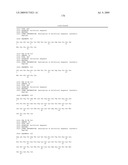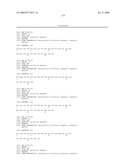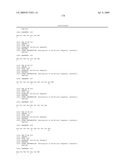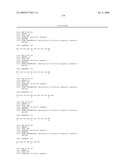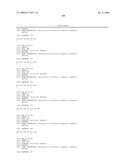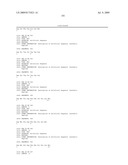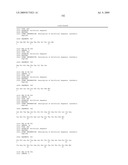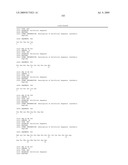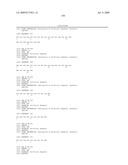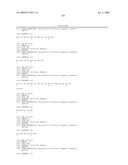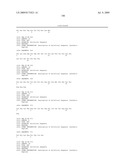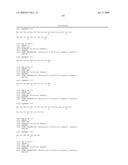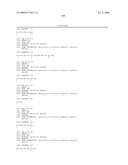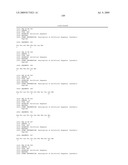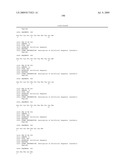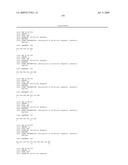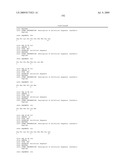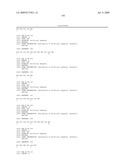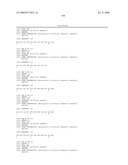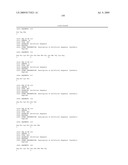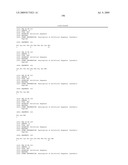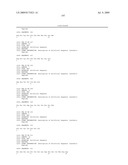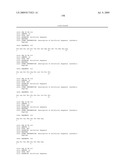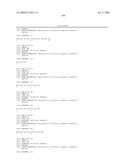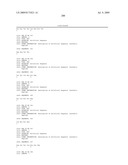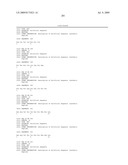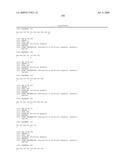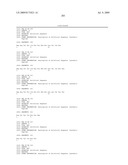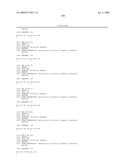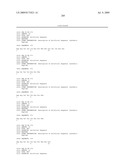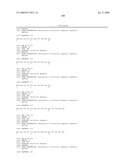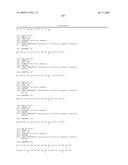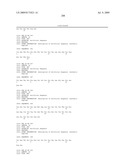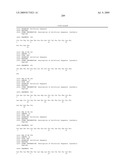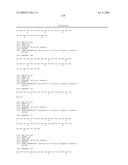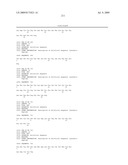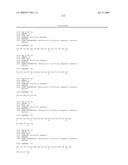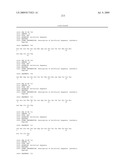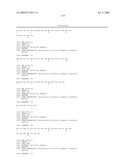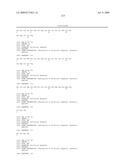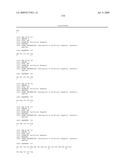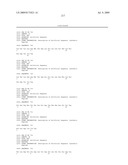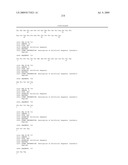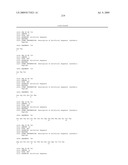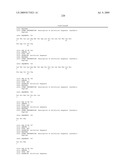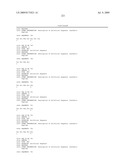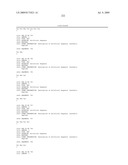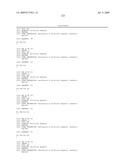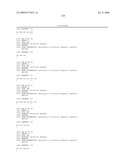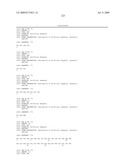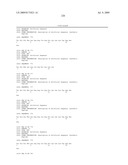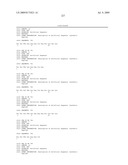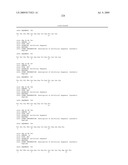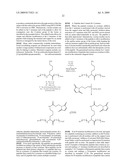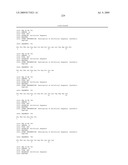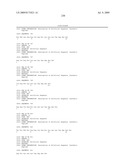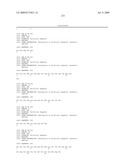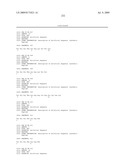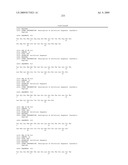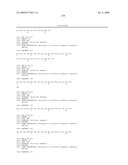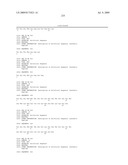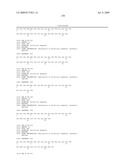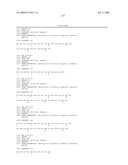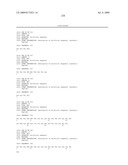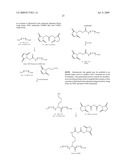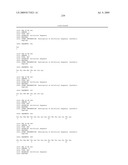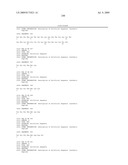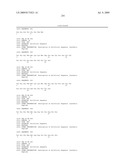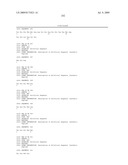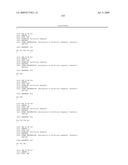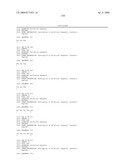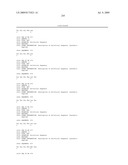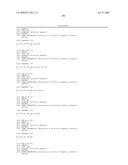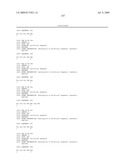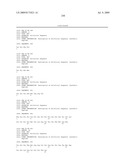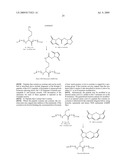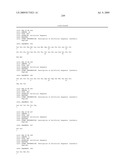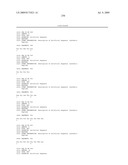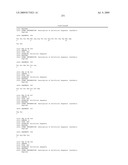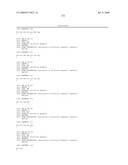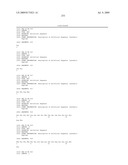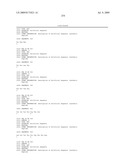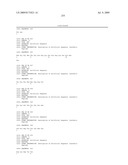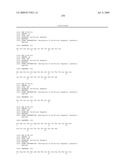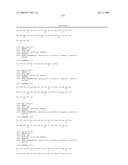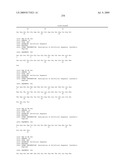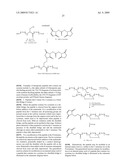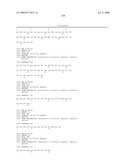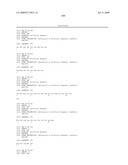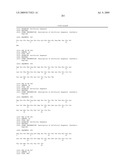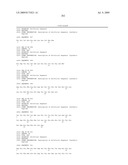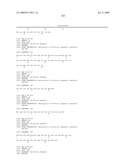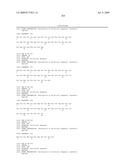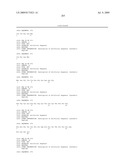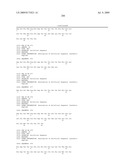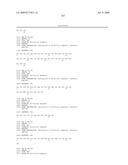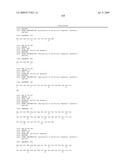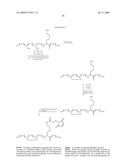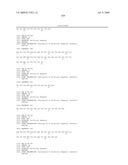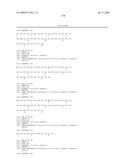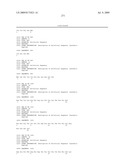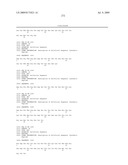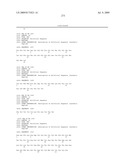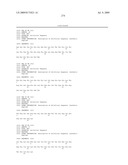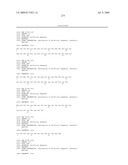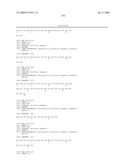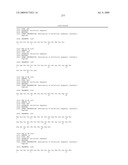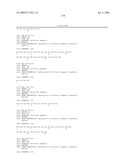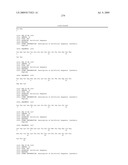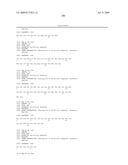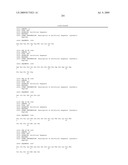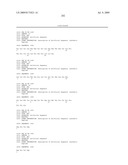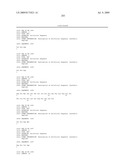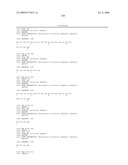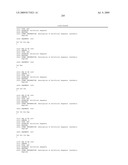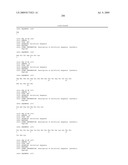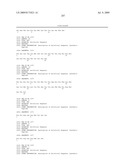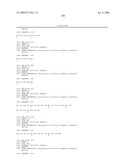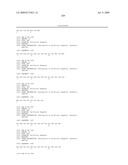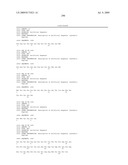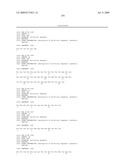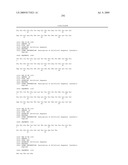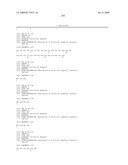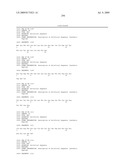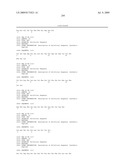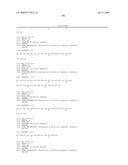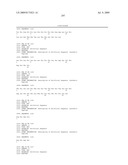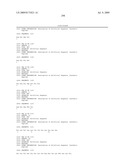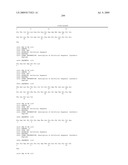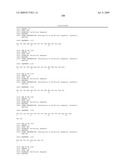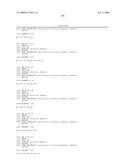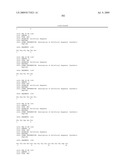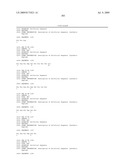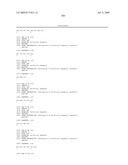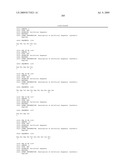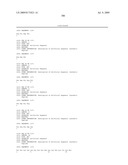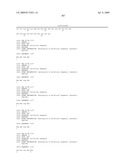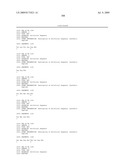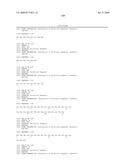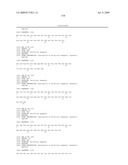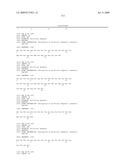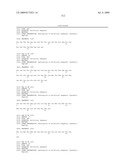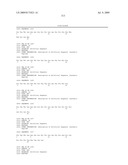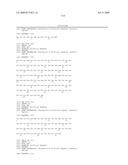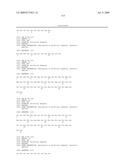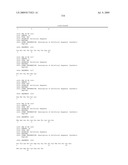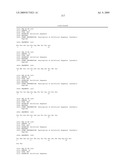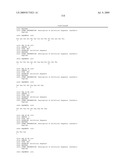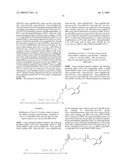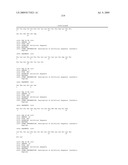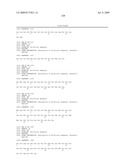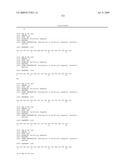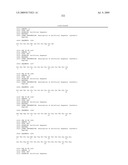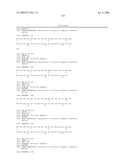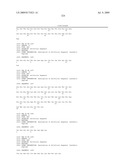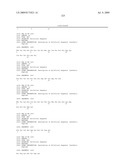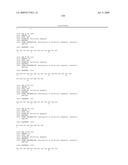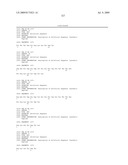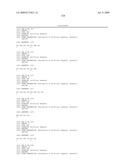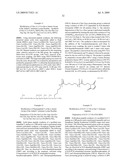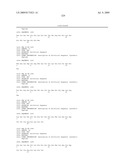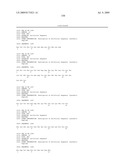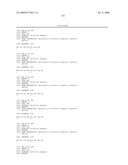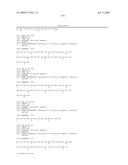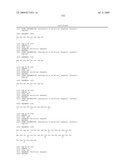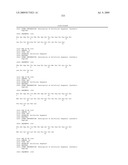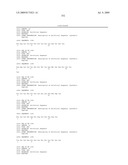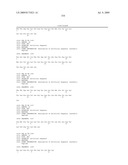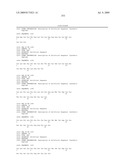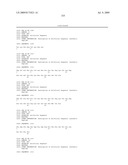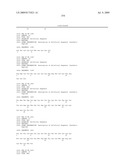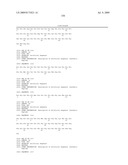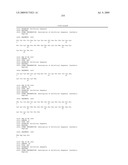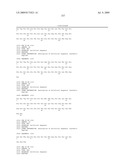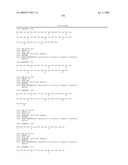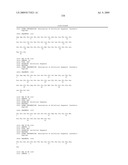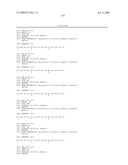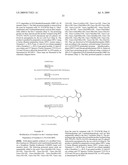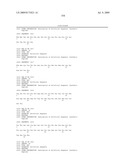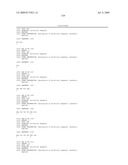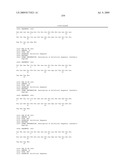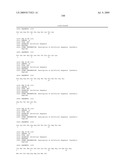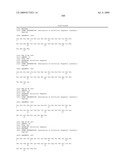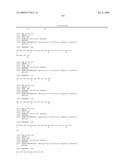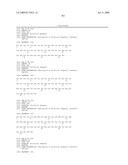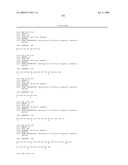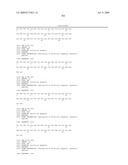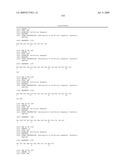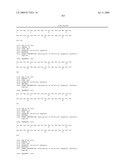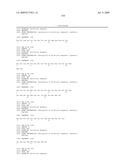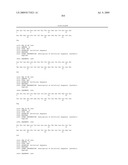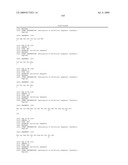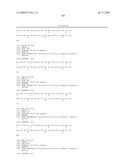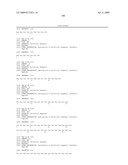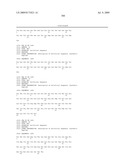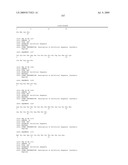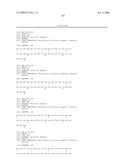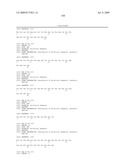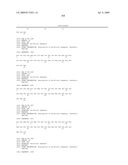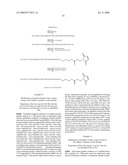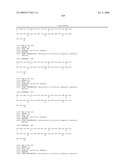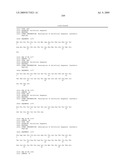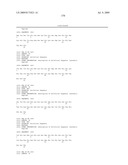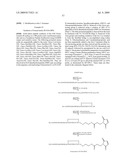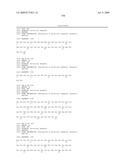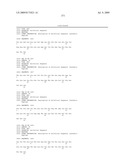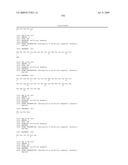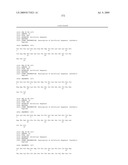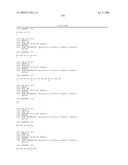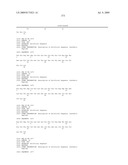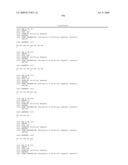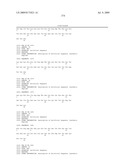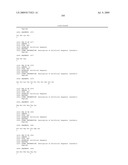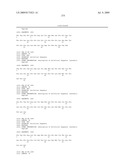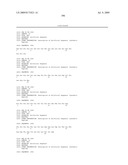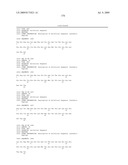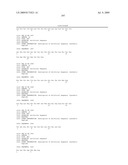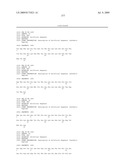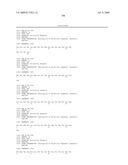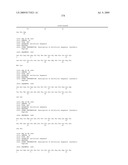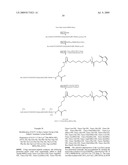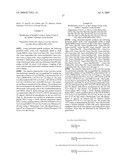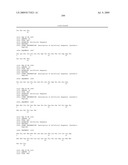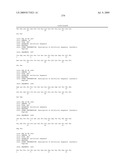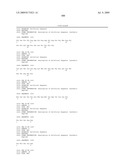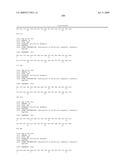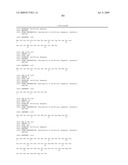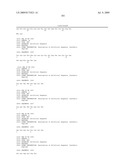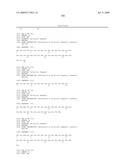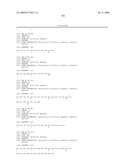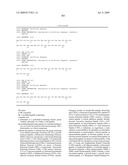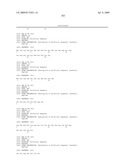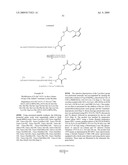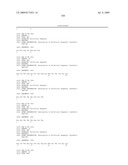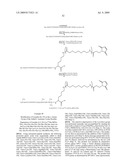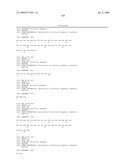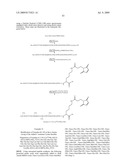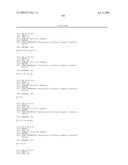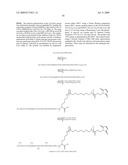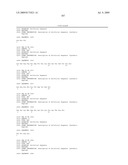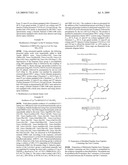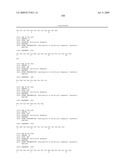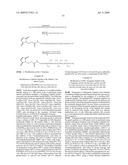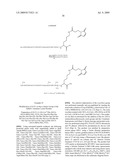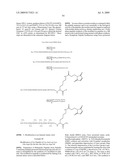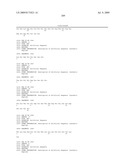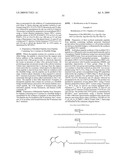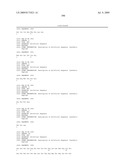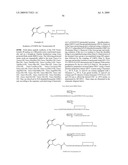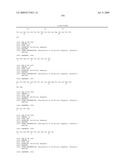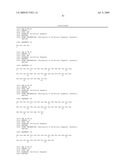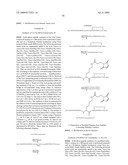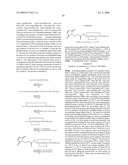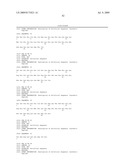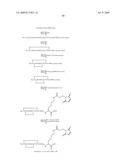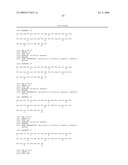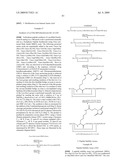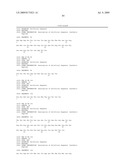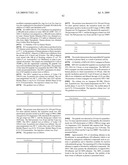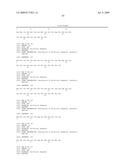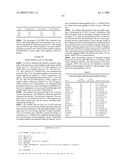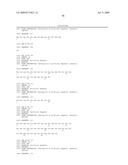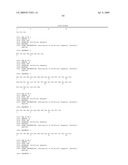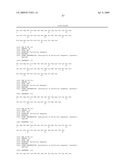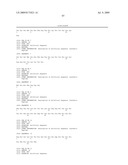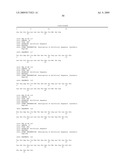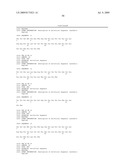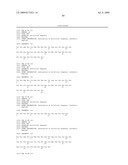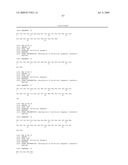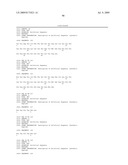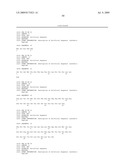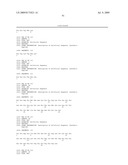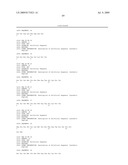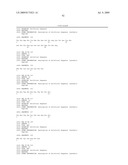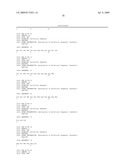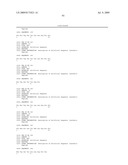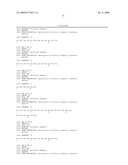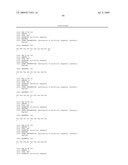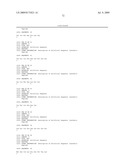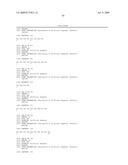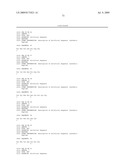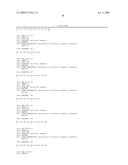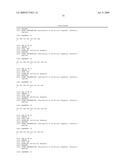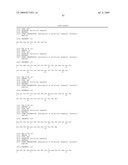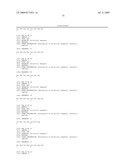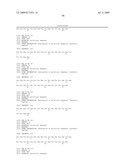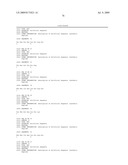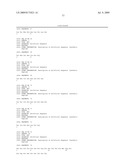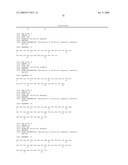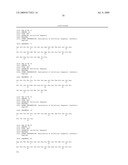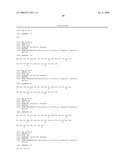Patent application title: Modified therapeutic peptides with extended half-lives in vivo
Inventors:
Dominique P. Bridon (Franklin, MA, US)
Alan M. Ezrin (Miami, FL, US)
Alan M. Ezrin (Miami, FL, US)
Peter G. Milner (Los Altos Hills, CA, US)
Darren L. Holmes (Anaheim, CA, US)
Karen Thibaudeau (Rosemere, CA)
IPC8 Class: AA61K3838FI
USPC Class:
424 855
Class name: Lymphokine interferon gamma or immune
Publication date: 2009-07-09
Patent application number: 20090175821
Claims:
1.-25. (canceled)
26. A modified peptide comprising:a peptide; anda maleimide or a maleimido-containing reactive group coupled, optionally via a linker, to the peptide,the modified peptide being capable of covalently binding in vivo or in vitro by reaction of the reactive group, with a functionality on a blood component;wherein the peptide is selected from the group consisting of an Adrenocorticotropic Hormone (ACTH), a growth hormone peptide, a Melanocyte Stimulating Hormone (MSH), Oxytocin, Vasopressin, Corticotropin Releasing Factor (CRF), a CRF-related peptide, a Gonadotropin Releasing Hormone Associated Peptide (GAP), Growth Hormone Releasing Factor (GRF), Lutenizing Hormone Release Hormone (LH-RH), an orexin, a Prolactin Releasing Peptide (PRP), a somatostatin, Thyrotropin Releasing Hormone (THR), a THR analog, Calcitonin (CT), a CT-precursor peptide, a Calcitonin Gene Related Peptide (CGRP), a Parathyroid Hormone (PTH), a Parathyroid Hormone Related Protein (PTHrP), Amylin, Glucagon, Insulin, an Insulin-like peptide, NeuroPeptide Y (NPY), a Pancreatic Polypeptide (PP), Peptide YY (PYY), Cholecystokinin (CCK), a CCK-related peptide, Gastrin Releasing Peptide (GRP), Gastrin, a Gastrin-related peptide, a Gastrin inhibitory peptide, Motilin, Secretin, Vasoactive Intestinal Peptide (VIP), a VIP-related peptide, an Atrial-Natriuretic Peptide (ANP), a Brain Natriuretic Peptide (BNP), a C-Type Natriuretic Peptide (CNP), a tachykinin, an angiotensin, a renin substrate, a renin inhibitor, an endothelin, an endothelin-related peptide, an opioid peptide, a thymic peptide, an adrenomedullin peptide, an allostatin peptide, an amyloid beta-protein fragment, an antimicrobial peptide, an antioxidant peptide, an apoptosis related peptide, a Bag Cell Peptide (BCPs), Bombesin, a bone Gla protein peptide, a Cocaine and Amphetamine Related Transcript (CART) peptide, a cell adhesion peptide, a chemotactic peptide, a complement inhibitor, a cortistatin peptide, a fibronectin fragment, a fibrin related peptide, FMRF, a FMRF amide-related peptide (FaRP), Galanin, a Galanin-related peptide, a growth factor, a growth factor-related peptide, a G-Therapeutic Peptide-Binding Protein fragment, Gualylin, Uroguanylin, an Inhibin peptide, Interleukin (IL), an Interleukin Receptor protein, a laminin fragment, a leptin fragment peptide, a leucokinin, Pituitary Adenylate Cyclase Activating Polypeptide (PAPCAP), Pancreastatin, a polypeptide repetitive chain, a signal transducing reagent, a thrombin inhibitor, a toxin, a trypsin inhibitor, a virus-related peptide, an adjuvant peptide analog, Alpha Mating Factor, Antiarrhythmic Peptide, Anorexigenic Peptide, Alpha-1 Antitrypsin, Bovine Pineal Antireproductive Peptide, Bursin, C3 Peptide P16, Cadherin Peptide, Chromogranin A Fragment, Contraceptive Tetrapeptide, Conantokin G, Conantokin T, Crustacean Cardioactive Peptide, C-Telopeptide, Cytochrome b588 Peptide, Decorsin, Delicious Peptide, Delta-Sleep-Inducing Peptide, Diazempam-Binding Inhibitor Fragment, Nitric Oxide Synthase Blocking Peptide, OVA Peptide, Platelet Calpain Inhibitor (P1), Plasminogen Activator Inhibitor 1, Rigin, Schizophrenia Related Peptide, Sodium Potassium Atherapeutic Peptidase Inhibitor-1, Speract, Sperm Activating Peptide, Systemin, a Thrombin receptor agonist, Tuftsin, Adipokinetic Hormone, Uremic Pentapeptide, Antifreeze Polypeptide, Tumor Necrosis Factor (TNF), Leech [Des Asp10]Decorsin, L-Ornithyltaurine Hydrochloride, P-Aminophenylacetyl Tuftsin, Ac-Glu-Glu-Val-Val-Ala-Cys-pNA, Ac-Ser-Asp-Lys-Pro, Ac-rfwink-NH2, Cys-Gly-Tyr-Gly-Pro-Lys-Lys-Lys-Arg-Lys-Val-Gly-Gly, D-Ala-Leu, D-D-D-D-D, D-D-D-D-D-D, N-P-N-A-N-P-N-A, V-A-I-T-V-L-V-K, V-G-V-R-V-R, V-I-H-S, V-P-D-P-R, Val-Thr-Cys-Gly, R-S-R, Sea Urchin Sperm Activating Peptide, a SHU-9119 antagonist, a MC3-R antagonist, a MC4-R antagonist, Glaspimod, HP-228, Alpha 2-Plasmin Inhibitor, APC Tumor Suppressor, Early Pregnancy Factor, Gamma Interferon, Glandular Kallikrei N-1, Placental Ribonuclease Inhibitor, Sarcolecin Binding Protein, Surfactant Protein D, Wilms' Tumor Suppressor, GABAB 1b Receptor Peptide, Prion Related Peptide (iPRP13), Choline Binding Protein Fragment, Telomerase Inhibitor, Cardiostatin Peptide, Endostatin Derived Peptide, Prion Inhibiting Peptide, N-Methyl D-Aspartate Receptor Antagonist, and C-Peptide Analog.
27. The modified peptide of claim 26, wherein the blood component is albumin.
28. The modified peptide of claim 26, wherein the functionality on the blood component is an amino group, an hydroxyl group, or a thiol group.
29. A conjugate formed by conjugating(a) a peptide coupled, optionally via a linker, to a maleimide or a maleimido-containing reactive group, with(b) a blood component, by covalent linking of the reactive group with a functionality on the blood component,wherein the peptide is selected from the group consisting of an Adrenocorticotropic Hormone (ACTH), a growth hormone peptide, a Melanocyte Stimulating Hormone (MSH), Oxytocin, Vasopressin, Corticotropin Releasing Factor (CRF), a CRF-related peptide, a Gonadotropin Releasing Hormone Associated Peptide (GAP), Growth Hormone Releasing Factor (GRF), Lutenizing Hormone Release Hormone (LH-RH), an orexin, a Prolactin Releasing Peptide (PRP), a somatostatin, Thyrotropin Releasing Hormone (THR), a THR analog, Calcitonin (CT), a CT-precursor peptide, a Calcitonin Gene Related Peptide (CGRP), a Parathyroid Hormone (PTH), a Parathyroid Hormone Related Protein (PTHrP), Amylin, Glucagon, Insulin, an Insulin-like peptide, NeuroPeptide Y (NPY), a Pancreatic Polypeptide (PP), Peptide YY (PYY), Cholecystokinin (CCK), a CCK-related peptide, Gastrin Releasing Peptide (GRP), Gastrin, a Gastrin-related peptide, a Gastrin inhibitory peptide, Motilin, Secretin, Vasoactive Intestinal Peptide (VIP), a VIP-related peptide, an Atrial-Natriuretic Peptide (ANP), a Brain Natriuretic Peptide (BNP), a C-Type Natriuretic Peptide (CNP), a tachykinin, an angiotensin, a renin substrate, a renin inhibitor, an endothelin, an endothelin-related peptide, an opioid peptide, a thymic peptide, an adrenomedullin peptide, an allostatin peptide, an amyloid beta-protein fragment, an antimicrobial peptide, an antioxidant peptide, an apoptosis related peptide, a Bag Cell Peptide (BCPs), Bombesin, a bone Gla protein peptide, a Cocaine and Amphetamine Related Transcript (CART) peptide, a cell adhesion peptide, a chemotactic peptide, a complement inhibitor, a cortistatin peptide, a fibronectin fragment, a fibrin related peptide, FMRF, a FMRF amide-related peptide (FaRP), Galanin, a Galanin-related peptide, a growth factor, a growth factor-related peptide, a G-Therapeutic Peptide-Binding Protein fragment, Gualylin, Uroguanylin, an Inhibin peptide, Interleukin (IL), an Interleukin Receptor protein, a laminin fragment, a leptin fragment peptide, a leucokinin, Pituitary Adenylate Cyclase Activating Polypeptide (PAPCAP), Pancreastatin, a polypeptide repetitive chain, a signal transducing reagent, a thrombin inhibitor, a toxin, a trypsin inhibitor, a virus-related peptide, an adjuvant peptide analog, Alpha Mating Factor, Antiarrhythmic Peptide, Anorexigenic Peptide, Alpha-1 Antitrypsin, Bovine Pineal Antireproductive Peptide, Bursin, C3 Peptide P16, Cadherin Peptide, Chromogranin A Fragment, Contraceptive Tetrapeptide, Conantokin G, Conantokin T, Crustacean Cardioactive Peptide, C-Telopeptide, Cytochrome b588 Peptide, Decorsin, Delicious Peptide, Delta-Sleep-Inducing Peptide, Diazempam-Binding Inhibitor Fragment, Nitric Oxide Synthase Blocking Peptide, OVA Peptide, Platelet Calpain Inhibitor (P1), Plasminogen Activator Inhibitor 1, Rigin, Schizophrenia Related Peptide, Sodium Potassium Atherapeutic Peptidase Inhibitor-1, Speract, Sperm Activating Peptide, Systemin, a Thrombin receptor agonist, Tuftsin, Adipokinetic Hormone, Uremic Pentapeptide, Antifreeze Polypeptide, Tumor Necrosis Factor (TNF), Leech [Des Asp10]Decorsin, L-Ornithyltaurine Hydrochloride, P-Aminophenylacetyl Tuftsin, Ac-Glu-Glu-Val-Val-Ala-Cys-pNA, Ac-Ser-Asp-Lys-Pro, Ac-rfwink-NH2, Cys-Gly-Tyr-Gly-Pro-Lys-Lys-Lys-Arg-Lys-Val-Gly-Gly, D-Ala-Leu, D-D-D-D-D, D-D-D-D-D-D, N-P-N-A-N-P-N-A, V-A-I-T-V-L-V-K, V-G-V-R-V-R, V-I-H-S, V-P-D-P-R, Val-Thr-Cys-Gly, R-S-R, Sea Urchin Sperm Activating Peptide, a SHU-9119 antagonist, a MC3-R antagonist, a MC4-R antagonist, Glaspimod, HP-228, Alpha 2-Plasmin Inhibitor, APC Tumor Suppressor, Early Pregnancy Factor, Gamma Interferon, Glandular Kallikrei N-1, Placental Ribonuclease Inhibitor, Sarcolecin Binding Protein, Surfactant Protein D, Wilms' Tumor Suppressor, GABAB 1b Receptor Peptide, Prion Related Peptide (iPRP13), Choline Binding Protein Fragment, Telomerase Inhibitor, Cardiostatin Peptide, Endostatin Derived Peptide, Prion Inhibiting Peptide, N-Methyl D-Aspartate Receptor Antagonist, and C-Peptide Analog.
30. The conjugate of claim 29 according to the formula: ##STR00033## wherein X is S, O, or NH of an amino acid of the blood component;wherein L is present or absent, and when present is selected from the group consisting of --NH(CH2)2NH--, --[C(O)--CH2--O--(CH2)2--NH]m--, and --[C(O)--CH2--O--(CH2)2--O--(CH2)2--NH]m--;- wherein Z is a peptide selected from the group consisting of an Adrenocorticotropic Hormone (ACTH), a growth hormone peptide, a Melanocyte Stimulating Hormone (MSH), Oxytocin, Vasopressin, Corticotropin Releasing Factor (CRF), a CRF-related peptide, a Gonadotropin Releasing Hormone Associated Peptide (GAP), Growth Hormone Releasing Factor (GRF), Lutenizing Hormone Release Hormone (LH-RH), an orexin, a Prolactin Releasing Peptide (PRP), a somatostatin, Thyrotropin Releasing Hormone (THR), a THR analog, Calcitonin (CT), a CT-precursor peptide, a Calcitonin Gene Related Peptide (CGRP), a Parathyroid Hormone (PTH), a Parathyroid Hormone Related Protein (PTHrP), Amylin, Glucagon, Insulin, an Insulin-like peptide, NeuroPeptide Y (NPY), a Pancreatic Polypeptide (PP), Peptide YY (PYY), Cholecystokinin (CCK), a CCK-related peptide, Gastrin Releasing Peptide (GRP), Gastrin, a Gastrin-related peptide, a Gastrin inhibitory peptide, Motilin, Secretin, Vasoactive Intestinal Peptide (VIP), a VIP-related peptide, an Atrial-Natriuretic Peptide (ANP), a Brain Natriuretic Peptide (BNP), a C-Type Natriuretic Peptide (CNP), a tachykinin, an angiotensin, a renin substrate, a renin inhibitor, an endothelin, an endothelin-related peptide, an opioid peptide, a thymic peptide, an adrenomedullin peptide, an allostatin peptide, an amyloid beta-protein fragment, an antimicrobial peptide, an antioxidant peptide, an apoptosis related peptide, a Bag Cell Peptide (BCPs), Bombesin, a bone Gla protein peptide, a Cocaine and Amphetamine Related Transcript (CART) peptide, a cell adhesion peptide, a chemotactic peptide, a complement inhibitor, a cortistatin peptide, a fibronectin fragment, a fibrin related peptide, FMRF, a FMRF amide-related peptide (FaRP), Galanin, a Galanin-related peptide, a growth factor, a growth factor-related peptide, a G-Therapeutic Peptide-Binding Protein fragment, Gualylin, Uroguanylin, an Inhibin peptide, Interleukin (IL), an Interleukin Receptor protein, a laminin fragment, a leptin fragment peptide, a leucokinin, Pituitary Adenylate Cyclase Activating Polypeptide (PAPCAP), Pancreastatin, a polypeptide repetitive chain, a signal transducing reagent, a thrombin inhibitor, a toxin, a trypsin inhibitor, a virus-related peptide, an adjuvant peptide analog, Alpha Mating Factor, Antiarrhythmic Peptide, Anorexigenic Peptide, Alpha-1 Antitrypsin, Bovine Pineal Antireproductive Peptide, Bursin, C3 Peptide P16, Cadherin Peptide, Chromogranin A Fragment, Contraceptive Tetrapeptide, Conantokin G, Conantokin T, Crustacean Cardioactive Peptide, C-Telopeptide, Cytochrome b588 Peptide, Decorsin, Delicious Peptide, Delta-Sleep-Inducing Peptide, Diazempam-Binding Inhibitor Fragment, Nitric Oxide Synthase Blocking Peptide, OVA Peptide, Platelet Calpain Inhibitor (P1), Plasminogen Activator Inhibitor 1, Rigin, Schizophrenia Related Peptide, Sodium Potassium Atherapeutic Peptidase Inhibitor-1, Speract, Sperm Activating Peptide, Systemin, a Thrombin receptor agonist, Tuftsin, Adipokinetic Hormone, Uremic Pentapeptide, Antifreeze Polypeptide, Tumor Necrosis Factor (TNF), Leech [Des Asp 10]Decorsin, L-Ornithyltaurine Hydrochloride, P-Aminophenylacetyl Tuftsin, Ac-Glu-Glu-Val-Val-Ala-Cys-pNA, Ac-Ser-Asp-Lys-Pro, Ac-rfwink-NH2, Cys-Gly-Tyr-Gly-Pro-Lys-Lys-Lys-Arg-Lys-Val-Gly-Gly, D-Ala-Leu, D-D-D-D-D, D-D-D-D-D-D, N-P-N-A-N-P-N-A, V-A-I-T-V-L-V-K, V-G-V-R-V-R, V-I-H-S, V-P-D-P-R, Val-Thr-Cys-Gly, R-S-R, Sea Urchin Sperm Activating Peptide, a SHU-9119 antagonist, a MC3-R antagonist, a MC4-R antagonist, Glaspimod, HP-228, Alpha 2-Plasmin Inhibitor, APC Tumor Suppressor, Early Pregnancy Factor, Gamma Interferon, Glandular Kallikrei N-1, Placental Ribonuclease Inhibitor, Sarcolecin Binding Protein, Surfactant Protein D, Wilms' Tumor Suppressor, GABAB 1b Receptor Peptide, Prion Related Peptide (iPRP13), Choline Binding Protein Fragment, Telomerase Inhibitor, Cardiostatin Peptide, Endostatin Derived Peptide, Prion Inhibiting Peptide, N-Methyl D-Aspartate Receptor Antagonist, and C-Peptide Analog;wherein m is 1, 2 or 3.
31. The conjugate of claim 30, wherein L is present.
32. The conjugate of claim 31, wherein Z is covalently attached to L through the NH of an amino acid of Z.
33. The conjugate of claim 31, wherein L is a poly ethoxy amino acid.
34. The conjugate of claim 33, wherein the poly ethoxy amino acid is according to the formula:--[C(O)--CH2--O--(CH2)2--NH]m--wherein m is 1, 2 or 3.
35. The conjugate of claim 33, wherein the poly ethoxy amino acid is according to the formula:--[C(O)--CH2--O--(CH2)2--O--(CH2)2--NH].- sub.m--wherein m is 1, 2 or 3.
36. The conjugate of claim 30, wherein X is S.
37. The conjugate of claim 30, wherein the blood component is albumin.
38. The conjugate of claim 37, wherein the S is of Cys-34 of human albumin.
39. A pharmaceutical composition comprising the modified peptide of claim 26 or 27 and a physiologically acceptable medium.
40. A method of synthesizing a modified peptide comprising:(a) if the peptide does not contain a cysteine, then synthesizing the peptide from the carboxy terminal amino acid and adding a reactive group to the carboxy terminal amino acid, or adding a terminal lysine to the carboxy terminal amino acid and adding the reactive group to the terminal lysine;(b) if the peptide contains only one cysteine, then reacting the cysteine with a protective group prior to addition of the reactive group to the amino acid;(c) if the peptide contains two cysteines as a disulfide bridge, then oxidizing the two cysteines and adding the reactive group to the amino terminal amino acid, or to the carboxy terminal amino acid, or to an amino acid positioned between the carboxy terminal amino acid and the amino terminal acid of the peptide; and(d) if the peptide contains more than two cysteines as disulfide bridges, then sequentially oxidizing the cysteines in the disulfide bridges and purifying the peptide prior to the addition of the reactive groups to the carboxy terminal amino acid;wherein the peptide is selected from the group consisting of an Adrenocorticotropic Hormone (ACTH), a growth hormone peptide, a Melanocyte Stimulating Hormone (MSH), Oxytocin, Vasopressin, Corticotropin Releasing Factor (CRF), a CRF-related peptide, a Gonadotropin Releasing Hormone Associated Peptide (GAP), Growth Hormone Releasing Factor (GRF), Lutenizing Hormone Release Hormone (LH-RH), an orexin, a Prolactin Releasing Peptide (PRP), a somatostatin, Thyrotropin Releasing Hormone (THR), a THR analog, Calcitonin (CT), a CT-precursor peptide, a Calcitonin Gene Related Peptide (CGRP), a Parathyroid Hormone (PTH), a Parathyroid Hormone Related Protein (PTHrP), Amylin, Glucagon, Insulin, an Insulin-like peptide, NeuroPeptide Y (NPY), a Pancreatic Polypeptide (PP), Peptide YY (PYY), Cholecystokinin (CCK), a CCK-related peptide, Gastrin Releasing Peptide (GRP), Gastrin, a Gastrin-related peptide, a Gastrin inhibitory peptide, Motilin, Secretin, Vasoactive Intestinal Peptide (VIP), a VIP-related peptide, an Atrial-Natriuretic Peptide (ANP), a Brain Natriuretic Peptide (BNP), a C-Type Natriuretic Peptide (CNP), a tachykinin, an angiotensin, a renin substrate, a renin inhibitor, an endothelin, an endothelin-related peptide, an opioid peptide, a thymic peptide, an adrenomedullin peptide, an allostatin peptide, an amyloid beta-protein fragment, an antimicrobial peptide, an antioxidant peptide, an apoptosis related peptide, a Bag Cell Peptide (BCPs), Bombesin, a bone Gla protein peptide, a Cocaine and Amphetamine Related Transcript (CART) peptide, a cell adhesion peptide, a chemotactic peptide, a complement inhibitor, a cortistatin peptide, a fibronectin fragment, a fibrin related peptide, FMRF, a FMRF amide-related peptide (FaRP), Galanin, a Galanin-related peptide, a growth factor, a growth factor-related peptide, a G-Therapeutic Peptide-Binding Protein fragment, Gualylin, Uroguanylin, an Inhibin peptide, Interleukin (IL), an Interleukin Receptor protein, a laminin fragment, a leptin fragment peptide, a leucokinin, Pituitary Adenylate Cyclase Activating Polypeptide (PAPCAP), Pancreastatin, a polypeptide repetitive chain, a signal transducing reagent, a thrombin inhibitor, a toxin, a trypsin inhibitor, a virus-related peptide, an adjuvant peptide analog, Alpha Mating Factor, Antiarrhythmic Peptide, Anorexigenic Peptide, Alpha-1 Antitrypsin, Bovine Pineal Antireproductive Peptide, Bursin, C3 Peptide P16, Cadherin Peptide, Chromogranin A Fragment, Contraceptive Tetrapeptide, Conantokin G, Conantokin T, Crustacean Cardioactive Peptide, C-Telopeptide, Cytochrome b588 Peptide, Decorsin, Delicious Peptide, Delta-Sleep-Inducing Peptide, Diazempam-Binding Inhibitor Fragment, Nitric Oxide Synthase Blocking Peptide, OVA Peptide, Platelet Calpain Inhibitor (P1), Plasminogen Activator Inhibitor 1, Rigin, Schizophrenia Related Peptide, Sodium Potassium Atherapeutic Peptidase Inhibitor-1, Speract, Sperm Activating Peptide, Systemin, a Thrombin receptor agonist, Tuftsin, Adipokinetic Hormone, Uremic Pentapeptide, Antifreeze Polypeptide, Tumor Necrosis Factor (TNF), Leech [Des Asp 10]Decorsin, L-Ornithyltaurine Hydrochloride, P-Aminophenylacetyl Tuftsin, Ac-Glu-Glu-Val-Val-Ala-Cys-pNA, Ac-Ser-Asp-Lys-Pro, Ac-rfwink-NH2, Cys-Gly-Tyr-Gly-Pro-Lys-Lys-Lys-Arg-Lys-Val-Gly-Gly, D-Ala-Leu, D-D-D-D-D, D-D-D-D-D-D, N-P-N-A-N-P-N-A, V-A-I-T-V-L-V-K, V-G-V-R-V-R, V-I-H-S, V-P-D-P-R, Val-Thr-Cys-Gly, R-S-R, Sea Urchin Sperm Activating Peptide, a SHU-9119 antagonist, a MC3-R antagonist, a MC4-R antagonist, Glaspimod, HP-228, Alpha 2-Plasmin Inhibitor, APC Tumor Suppressor, Early Pregnancy Factor, Gamma Interferon, Glandular Kallikrei N-1, Placental Ribonuclease Inhibitor, Sarcolecin Binding Protein, Surfactant Protein D, Wilms' Tumor Suppressor, GABAB 1b Receptor Peptide, Prion Related Peptide (iPRP13), Choline Binding Protein Fragment, Telomerase Inhibitor, Cardiostatin Peptide, Endostatin Derived Peptide, Prion Inhibiting Peptide, N-Methyl D-Aspartate Receptor Antagonist, and C-Peptide Analog.
41. The method of claim 40, wherein the reactive group is maleimide or a maleimido-containing group.
42. The method of claim 40, wherein the reactive group is succinimide or a succinimido-containing group.
43. A method of preparing a conjugate comprising:contacting a modified peptide of claim 26 with a blood component under conditions suitable for formation of a conjugate between said modified peptide and said blood component.
44. The method of claim 43, wherein the reactive group of the modified peptide is a maleimido-containing group.
45. The method of claim 43, wherein the blood component is albumin.
46. The method of claim 45 wherein said modified peptide is conjugated to Cys-34 of human albumin.
47. The method of claim 43, wherein the contacting occurs in vitro.
48. A method for the treatment of a disorder or disease in a subject comprising administering to a subject in need thereof a therapeutically effective amount of the modified peptide of claim 26.
49. A method for the treatment of a disorder or disease in a subject comprising administering to a subject in need thereof a therapeutically effective amount of the conjugate of claim 29.
Description:
[0001]This application is a continuation-in-part of U.S. patent
application Ser. No. 11/040,810, filed Jan. 21, 2005, which is a
continuation-in-part of U.S. patent application Ser. No. 09/657,276,
filed Sep. 7, 2000, now U.S. Pat. No. 6,887,470 B1, which claims the
benefit of U.S. Provisional Application No. 60/153,406, filed Sep. 10,
1999, and U.S. Provisional Application No. 60/159,783, filed Oct. 15,
1999, all of which applications are herein incorporated by reference in
their entireties; U.S. patent application Ser. No. 11/040,810 is also a
continuation-in-part of U.S. patent application Ser. No. 09/623,548, now
U.S. Pat. No. 6,849,714, which is the National Stage of International
Application No. PCT/US00/13576, filed May 17, 2000, which claims the
benefit of U.S. Provisional Application No. 60/134,406, filed May 17,
1999, U.S. Provisional Application No. 60/153,406, filed Sep. 10, 1999,
and U.S. Provisional Application No. 60/159,783, filed Oct. 15, 1999, all
of which applications are herein incorporated by reference in their
entireties.
FIELD OF THE INVENTION
[0002]This invention relates to modified therapeutic peptides. In particular, this invention relates to protection of endogenous therapeutic peptides from peptidase activity through a modification that enables the peptide to selectively conjugate to blood components, thus protecting the peptide from peptidase activity and increasing the duration of action of the therapeutic peptide for the treatment of various disorders.
BACKGROUND OF THE INVENTION
[0003]Many endogenous peptides have been described as key components of biological processes. Some of these peptides have been identified as key therapeutic agents for the management of various disorders. In general, endogenous peptides are more desirable as therapeutic agents than synthetic peptides with non-native sequences, because they do not produce an immune response due to their endogenous character. In addition, endogenous peptides are highly specific for their target receptors and are easy to synthesize and manufacture. However, a major difficulty with the delivery of such therapeutic peptides is their short plasma half-life, mainly due to rapid serum clearance and proteolytic degradation via the action of peptidases.
[0004]Peptidases break a peptide bond in peptides by inserting a water molecule across the bond. Generally, most peptides are broken down by peptidases in the body in a manner of a few minutes or less. In addition, some peptidases are specific for certain types of peptides, making their degradation even more rapid. Thus, if a peptide is used as a therapeutic agent, its activity is generally reduced as the peptide quickly degrades in the body due to the action of peptidases.
[0005]One way to overcome this disadvantage is to administer large dosages of the therapeutic peptide of interest to the patient so that even if some of the peptide is degraded, enough remains to be therapeutically effective. However, this method is quite uncomfortable for the patient. Since most therapeutic peptides cannot be administered orally, the therapeutic peptide would have to be either constantly infused, frequently administered by intravenous injections, or administered frequently by the inconvenient route of subcutaneous injections. The need for frequent administration also results in many potential peptide therapeutics having an unacceptably high projected cost per treatment course. The presence of large amounts of degraded peptide may also generate undesired side effects.
[0006]Discomfort in administration and high costs are two reasons why most therapeutic peptides with attractive bioactivity profiles are not developed as drug candidates. Instead, these therapeutic peptides are used as templates for the development of peptidomimetic compounds to substitute for the therapeutic peptide. Biotechnology and large pharmaceutical firms frequently undertake lengthy and expensive optimization programs to attempt to develop non-peptide, organic compounds which mimic the activity seen with therapeutic peptides without incurring an unacceptable side effect profile. For example, cyclic peptides, peptidomimetics and small molecules coming from expensive SAR (Structure Activity Relationship) and molecular modeling studies have led to the development of an incredible amount of peptide mimics. However, these peptide mimics in no way reflect the exact original biological nature of the therapeutic peptide, and thus are inferior to the endogenous therapeutic peptide as therapeutic agents.
[0007]An alternative to creating peptide mimics is to block the action of peptidases to prevent degradation of the therapeutic peptide or to modify the therapeutic peptides in such a way that their degradation is slowed down while still maintaining biological activity. Such methods include conjugation with polymeric materials such as dextrans, polyvinyl pyrrolidones, glycopeptides, polyethylene glycol and polyamino acids, conjugation with adroitin sulfates, as well as conjugation with polysaccharides, low molecular weight compounds such as aminolethicin, fatty acids, vitamin B12, and glycosides. These conjugates, however, are still often susceptible to protease activity. In addition, the therapeutic activity of these peptides is often reduced by the addition of the polymeric material. Finally, there is the risk of the conjugates generating an immune response when the material is injected in vivo. Several methods include ex vivo conjugation with carrier proteins, resulting in the production of randomized conjugates. Since conjugates are difficult to manufacture, and their interest is limited by commercial availability of the carriers, as well as by their poor pharmaco economics.
[0008]There is thus a need for novel methods to modify therapeutic peptides to protect them from peptidase activity and to provide longer duration of action in vivo, while maintaining low toxicity yet retaining the therapeutic advantages of the modified peptides.
SUMMARY OF THE INVENTION
[0009]This invention is directed to overcoming the problem of peptide degradation in the body by modifying the therapeutic peptide of interest and attaching it to protein carriers, such that the action of peptidases is prevented, or slowed down. More specifically, this invention relates to novel chemically reactive derivatives of therapeutic peptides that can react with available functionalities on blood proteins to form covalent linkages, specifically a therapeutic peptide-maleimide derivative. The invention also relates to novel chemically reactive derivatives or analogs of such therapeutic peptides. The invention additionally pertains to the therapeutic uses of such compounds.
[0010]The present invention is directed to modifying and attaching therapeutic peptides to protein carriers, preferentially albumin, through in vivo or ex vivo technology to prevent or reduce the action of peptidases by virtue of a synthetic modification on the first residue to be cleaved. Therapeutic peptides are usually active at the N-terminus portion, at the C-terminus portion, or in an interior portion of the peptide chain. Using the technology of this invention, a site other than the active portion of a therapeutic peptide is modified with certain reactive groups. These reactive groups are capable of forming covalent bonds with functionalities present on blood components. The reactive group is placed at a site such that when the therapeutic peptide is bonded to the blood component, the peptide retains a substantial proportion of the parent compound's activity.
[0011]The modification of the therapeutic peptide through the chemical modification used in the invention is done in such a way that all or most of the peptide specificity is conserved despite attachment to a blood component. This therapeutic peptide-blood component complex is now capable of traveling to various body regions without and being degraded by peptidases, with the peptide still retaining its therapeutic activity. The invention is applicable to all known therapeutic peptides and is easily tested under physiological conditions by the direct comparison of the pharmacokinetic parameters for the free and the modified therapeutic peptide.
[0012]The present invention is directed to a modified therapeutic peptide capable of forming a peptidase stablilized therapeutic peptide composed of between 3 and 50 amino acids. The peptide has a carboxy terminal amino acid, an amino terminal amino acid, a therapeutically active region of amino acids and a less therapeutically active region of amino acids. The peptide comprises a reactive group which reacts with amino groups, hydroxyl groups, or thiol groups on blood components to form a stable covalent bond and thereby forms the peptidase stabilized therapeutic peptide. In the peptide of the invention the reactive group is selected from the group consisting of succinimidyl and maleimido groups and the reactive group is attached to an amino acid positioned in the less therapeutically active region of amino acids.
[0013]In one embodiment, the therapeutically active region of the peptide includes the carboxy terminal amino acid and the reactive group is attached to said amino terminal amino acid.
[0014]In another embodiment, the therapeutically active region of the peptide includes the amino terminal amino acid and the reactive group is attached to the carboxy terminal amino acid.
[0015]In another embodiment, the therapeutically active region of the peptide includes the carboxy terminal amino acid and the reactive group is attached to an amino acid positioned between the amino terminal amino acid and the carboxy terminal amino acid.
[0016]In yet another embodiment, the therapeutically active region includes the amino terminal amino acid and the reactive group is attached to an amino acid positioned between the amino terminal amino acid and the carboxy terminal amino acid.
[0017]The present invention is also directed to a method of synthesizing the modified therapeutic peptide. The method comprises the following steps. In the first step, if the therapeutic peptide does not contain a cysteine, then the peptide is synthesized from the carboxy terminal amino acid and the reactive group is added to the carboxy terminal amino acid. Alternatively, a terminal lysine is added to the carboxy terminal amino acid and the reactive group is added to the terminal lysine. In the second step, if the therapeutic peptide contains only one cysteine, then the cysteine is reacted with a protective group prior to addition of the reactive group to an amino acid in the less therapeutically active region of the peptide. In the third step, if the therapeutic peptide contains two cysteines as a disulfide bridge, then the two cysteines are oxidized and the reactive group is added to the amino terminal amino acid, or to the carboxy terminal amino acid, or to an amino acid positioned between the carboxy terminal amino acid and the amino terminal amino acid of the therapeutic peptide. In the fourth step, if the therapeutic peptide contains more than two cysteines as disulfide bridges, the cysteines are sequentially oxidized in the disulfide bridges and the peptide is purified prior to the addition of the reactive groups to the carboxy terminal amino acid.
[0018]The present invention is also directed to a method for protecting a therapeutic peptide from peptidase activity in vivo, the peptide being composed of between 3 and 50 amino acids and having a carboxy terminus and an amino terminus and a carboxy terminal amino acid amino acid and an amino terminal amino acid. The method comprises the following steps:
[0019](a) modifying the peptide by attaching a reactive group to the carboxy terminal amino acid, to the amino terminal amino acid, or to an amino acid located between the amino terminal amino acid and the carboxy terminal amino acid, such that the modified peptide is capable of forming a covalent bond in vivo with a reactive functionality on a blood component;
[0020](b) forming a covalent bond between the reactive group and a reactive functionality on a blood component to form a peptide-blood component conjugate, thereby protecting the peptide from peptidase activity; and
[0021](c) analyzing the stability of the peptide-blood component conjugate to assess the protection of the peptide from peptidase activity. These steps may be performed either in vivo or ex vivo.
[0022]The present invention is also directed to a method for protecting a therapeutic peptide from peptidase activity in vivo, the peptide being composed of between 3 and 50 amino acids and having a therapeutically active region of amino acids and a less therapeutically active region of amino acids. The method comprises the following steps:
[0023](a) determining the therapeutically active region of amino acids;
[0024](b) modifying the peptide at an amino acid included in the less therapeutically active region of amino acids by attaching a reactive group to the amino acid to form a modified peptide, such that the modified peptide has therapeutic activity and is capable of forming a covalent bond in vivo with a reactive functionality on a blood component;
[0025](c) forming a covalent bond between the reactive entity and a reactive functionality on a blood component to form a peptide-blood component conjugate, thereby protecting the peptide from peptidase activity; and
[0026](d) analyzing the stability of the peptide-blood component conjugate to assess the protection of the peptide from peptidase activity. These steps may be performed either in vivo or ex vivo.
[0027]The present invention also provides kits comprising in a container the modified peptides or peptide-blood component conjugates described herein, and optionally instructions for use.
[0028]The peptides useful in the compositions and methods of the present invention include, but are not limited to, the peptides presented in SEQ ID NO:1 to SEQ ID NO:1617.
DETAILED DESCRIPTION OF THE INVENTION
Definitions
[0029]To ensure a complete understanding of the invention, the following definitions are provided:
[0030]Reactive Groups: Reactive groups are entities capable of forming a covalent bond. Such reactive groups are coupled or bonded to a therapeutic peptide of interest. Reactive groups will generally be stable in an aqueous environment and will usually be carboxy, phosphoryl, or convenient acyl group, either as an ester or a mixed anhydride, or an imidate, thereby capable of forming a covalent bond with functionalities such as an amino group, a hydroxy or a thiol at the target site on mobile blood components. For the most part, the esters will involve phenolic compounds, or be thiol esters, alkyl esters, phosphate esters, or the like. Reactive groups include succimidyl and maleimido groups.
[0031]Functionalities: Functionalities are groups on blood components, including mobile and fixed proteins, to which reactive groups on modified therapeutic peptides react to form covalent bonds. Functionalities usually include hydroxyl groups for bonding to ester reactive groups, thiol groups for bonding to maleimides, imidates and thioester groups; amino groups for bonding to activated carboxyl, phosphoryl or any other acyl groups on reactive groups.
[0032]Blood Components: Blood components may be either fixed or mobile. Fixed blood components are non-mobile blood components and include tissues, membrane receptors, interstitial proteins, fibrin proteins, collagens, platelets, endothelial cells, epithelial cells and their associated membrane and membranous receptors, somatic body cells, skeletal and smooth muscle cells, neuronal components, osteocytes and osteoclasts and all body tissues especially those associated with the circulatory and lymphatic systems. Mobile blood components are blood components that do not have a fixed situs for any extended period of time, generally not exceeding 5, more usually one minute. These blood components are not membrane-associated and are present in the blood for extended periods of time and are present in a minimum concentration of at least 0.1 μg/ml. Mobile blood components include serum albumin, transferrin, ferritin and immunoglobulins such as IgM and IgG. The half-life of mobile blood components is at least about 12 hours.
[0033]Protective Groups: Protective groups are chemical moieties utilized to protect peptide derivatives from reacting with themselves. Various protective groups are disclosed herein and in U.S. Pat. No. 5,493,007 which is hereby incorporated by reference. Such protective groups include acetyl, fluorenylmethyloxycarbonyl (Fmoc), t-butyloxycarbonyl (Boc), benzyloxycarbonyl (Cbz), and the like. The specific protected amino acids are depicted in Table 1.
[0034]Linking Groups: Linking groups are chemical moieties that link or connect reactive groups to therapeutic peptides. Linking groups may comprise one or more alkyl groups, alkoxy group, alkenyl group, alkynyl group or amino group substituted by alkyl groups, cycloalkyl group, polycyclic group, aryl groups, polyaryl groups, substituted aryl groups, heterocyclic groups, and substituted heterocyclic groups. Linking groups may also comprise poly ethoxy aminoacids such as AEA ((2-amino) ethoxy acetic acid) or a preferred linking group AEEA ([2-(2-amino)ethoxy)]ethoxy acetic acid). A preferred linking group is aminoethoxyethoxyacetic acid (AEEA).
[0035]Sensitive Functional Groups--A sensitive functional group is a group of atoms that represents a potential reaction site on a therapeutic peptide. If present, a sensitive functional group may be chosen as the attachment point for the linker-reactive group modification. Sensitive functional groups include but are not limited to carboxyl, amino, thiol, and hydroxyl groups.
[0036]Modified Therapeutic Peptides--A modified therapeutic peptide peptide is a therapeutic peptide that has been modified by attaching a reactive group, and is capable of forming a peptidase stabalized peptide through conjugation to blood components. The reactive group may be attached to the therapeutic peptide either via a linking group, or optionally without using a linking group. It is also contemplated that one or more additional amino acids may be added to the therapeutic peptide to facilitage the attachment of the reactive group. Modified peptides may be administered in vivo such that conjugation with blood components occurs in vivo, or they may be first conjugated to blood components in vitro and the resulting peptidase stabalized peptide (as defined below) administered in vivo. The terms "modified therapeutic peptide" and "modified peptide" may be used interchangeably in this application.
[0037]Peptidase Stabalized Therapeutic Peptides--A peptidase stabalized therapeutic peptide is a modified peptide that has been conjugated to a blood component via a covalent bond formed between the reactive group of the modified peptide and the functionalities of the blood component, with or without a linking group. Peptidase stabalized peptides are more stable in the presence of peptidases in vivo than a non-stabalized peptide. A peptidase stabalized therapeutic peptide generally has an increased half life of at least 10-50% as compared to a non-stabalized peptide of identical sequence. Peptidase stability is determined by comparing the half life of the unmodified therapeutic peptide in serum or blood to the half life of a modified counterpart therapeutic peptide in serum or blood. Half life is determined by sampling the serum or blood after administration of the modified and non-modified peptides and determining the activity of the peptide. In addition to determining the activity, the length of the therapeutic peptide may also be measured.
[0038]Therapeutic Peptides--As used in this invention, therapeutic peptides are amino acid chains of between 2-50 amino acids with therapeutic activity, as defined below. Each therapeutic peptide has an amino terminus (also referred to as N-terminus or amino terminal amino acid), a carboxyl terminus (also referred to as C-terminus terminal carboxyl terminal amino acid) and internal amino acids located between the amino terminus and the carboxyl terminus. The amino terminus is defined by the only amino acid in the therapeutic peptide chain with a free α-amino group. The carboxyl terminus is defined by the only amino acid in the therapeutic peptide chain with a free α-carboxyl group.
[0039]Therapeutic peptides used in the present invention contain a therapeutically active region generally located at the amino terminus, at the carboxyl terminus, or at an internal amino acid. The therapeutically active region may be identified using blind or structure activity relationship (SAR) driven substitution, as defined in more detail in this application. SAR is an analysis which defines the relationship between the structure of a molecule and its pharmacological activity for a series of compounds. Alternatively, where the therapeutically active region has previously been defined and is available in the literature, it may be obtained by referring to references such as scientific journals. Knowledge of the location of the therapeutically active region of the peptide is important for modifying the therapeutic peptide, as defined in more detail below.
[0040]Therapeutic peptides used in this invention also contain a less therapeutically active region generally located at the amino terminus, at or near the carboxyl terminus, or at or near an internal amino acid. The less therapeutically active region is a region of amino acids that does not coincide with the therapeutically active region of the therapeutic peptide. The less therapeutically active reion is generally located away from the therapeutically active region, such that modification at the less therapeutically active region does not substantially affect the therapeutic activity of the therapeutic peptide. For example, if the therapeutically active region is located at the amino terminus, the therapeutic peptide will be modified at either the carboxyl terminus or at an internal amino acid. Alternatively, if the therapeutically active region is located at the carboxyl terminus, the therapeutic peptide will be modified at either the amino terminus or at an internal amino acid. Finally, if the therapeutically active region is located at an internal region, the therapeutic peptide will be modified at either the amino terminus or the carboxyl terminus.
[0041]"Therapeutic activity" is any activity directed toward healing or curing a biological disorder in a patient. Examples of said therapeutic peptides include pituitary hormones such as vasopressin, oxytocin, melanocyte stimulating hormones, adrenocorticotropic hormones, growth hormones; hypothalamic hormones such as growth hormone releasing factor, corticotropin releasing factor, prolactin releasing peptides, gonadotropin releasing hormone and its associated peptides, luteinizing hormone release hormones, thyrotropin releasing hormone, orexin, and somatostatin; thyroid hormones such as calcitonins, calcitonin precursors, and calcitonin gene related peptides; parathyroid hormones and their related proteins; pancreatic hormones such as insulin and insulin-like peptides, glucagon, somatostatin, pancreatic polypeptides, amylin, peptide YY, and neuropeptide Y; digestive hormones such as gastrin, gastrin releasing peptides, gastrin inhibitory peptides, cholecystokinin, secretin, motilin, and vasoactive intestinal peptide; natriuretic peptides such as atrial natriuretic peptides, brain natriuretic peptides, and C-type natriuretic peptides; neurokinins such as neurokinin A, neurokinin B, and substance P; renin related peptides such as renin substrates and inhibitors and angiotensins; endothelins, including big endothelin, endothelin A receptor antagonists, and sarafotoxin peptides; and other peptides such as adrenomedullin peptides, allatostatin peptides, amyloid beta protein fragments, antibiotic and antimicrobial peptides, apoptosis related peptides, bag cell peptides, bombesin, bone Gla protein peptides, CART peptides, chemotactic peptides, cortistatin peptides, fibronectin fragments and fibrin related peptides, FMRF and analog peptides, galanin and related peptides, growth factors and related peptides, Gtherapeutic peptide-binding protein fragments, guanylin and uroguanylin, inhibin peptides, interleukin and interleukin receptor proteins, laminin fragments, leptin fragment peptides, leucokinins, mast cell degranulating peptides, pituitary adenylate cyclase activating polypeptides, pancreastatin, peptide T, polypeptides, virus related peptides, signal transduction reagents, toxins, and miscellaneous peptides such as adjuvant peptide analogs, alpha mating factor, antiarrhythmic peptide, antifreeze polypeptide, anorexigenic peptide, bovine pineal antireproductive peptide, bursin, C3 peptide P16, tumor necrosis factor, cadherin peptide, chromogranin A fragment, contraceptive tetrapeptide, conantokin G, conantokin T, crustacean cardioactive peptide, C-telopeptide, cytochrome b588 peptide, decorsin, delicioius peptide, delta-sleep-inducing peptide, diazempam-binding inhibitor fragment, nitric oxide synthase blocking peptide, OVA peptide, platelet calpain inhibitor (P1), plasminogen activator inhibitor 1, rigin, schizophrenia related peptide, serum thymic factor, sodium potassium Atherapeutic peptidease inhibiro-1, speract, sperm activating peptide, systemin, thrombin receptor agonist, thymic humoral gamma2 factor, thymopentin, thymosin alpha 1, thymus factor, tuftsin, adipokinetic hormone, uremic pentapeptide and other therapeutic peptides.
[0042]Taking into account these definitions, the focus of this invention is to modify therapeutic peptides to protect them from peptidase activity in vivo and thereby extend the effective therapeutic life of the therapeutic peptide in question as compared to administration of the peptide per se to a patient.
1. Therapeutic Peptides Used in the Present Invention
[0043]Peptide fragments chosen from the determined amino acid sequence of a therapeutic peptide as provided in the attached SEQUENCE LISTING constitute the starting point in the development comprising the present invention. The peptides range from 2 to 50 amino acids in length. The interchangeable terms "peptide fragment" and "peptide moiety" are meant to include both synthetic and naturally occurring amino acid sequences derivable from a naturally occurring amino acid sequence.
[0044]In one embodiment, peptide and peptide fragments are synthesized by conventional means, either by bench-top methods or by automated peptide synthesis machines as discussed in detail below. However, it is also possible to obtain fragments of the peptides by fragmenting the naturally occurring amino acid sequence, using, for example, a proteolytic enzyme. Further, it is possible to obtain the desired fragments of the therapeutic peptide through the use of recombinant DNA technology, as disclosed by Maniatis, T., et al., Molecular Biology: A Laboratory Manual, Cold Spring Harbor, N.Y. (1982), which is hereby incorporated by reference. The use of other new modifications to existing methodologies is also contemplated.
[0045]The present invention includes peptides which are derivable from the naturally occurring sequence of the therapeutic peptide. A peptide is said to be "derivable from a naturally occurring amino acid sequence" if it can be obtained by fragmenting a naturally occurring sequence, or if it can be synthesized based upon a knowledge of the sequence of the naturally occurring amino acid sequence or of the genetic material (DNA or RNA) which encodes this sequence. Included within the scope of the present invention are those molecules which are said to be "derivatives" of a peptide. Such a "derivative" has the following characteristics: (1) it shares substantial homology with the therapeutic peptide or a similarly sized fragment of the peptide and (2) it is capable of functioning with the same therapeutic activity as the peptide.
[0046]A derivative of a peptide is said to share "substantial homology" with the peptide if the amino acid sequences of the derivative is at least 80%, and more preferably at least 90%, and most preferably at least 95%, the same as that of either the peptide or a fragment of the peptide having the same number of amino acid residues as the derivative.
[0047]The derivatives of the present invention include fragments which, in addition to containing a sequence that is substantially homologous to that of a naturally occurring therapeutic peptide may contain one or more additional amino acids at their amino and/or their carboxy termini as discussed in detail below. Thus, the invention pertains to polypeptide fragments of the therapeutic peptide that may contain one or more amino acids that may not be present in a naturally occurring therapeutic peptide sequence provided that such fragments have a therapeutic activity which exceeds that of the therapeutic peptide.
[0048]Similarly, the invention includes polypeptide fragments which, although containing a sequence that is substantially homologous to that of a naturally occurring therapeutic peptide, may lack one or more additional amino acids at their amino and/or their carboxy termini that are naturally found on the therapeutic peptide. Thus, the invention pertains to polypeptide fragments of the therapeutic peptide that may lack one or more amino acids that are normally present in the naturally occurring peptide sequence provided that such polypeptides have a therapeutic activity which exceeds that of the therapeutic peptide.
[0049]The invention also encompasses the obvious or trivial variants of the above-described fragments which have inconsequential amino acid substitutions (and thus have amino acid sequences which differ from that of the natural sequence) provided that such variants have an activity which is substantially identical to that of the above-described derivatives. Examples of obvious or trivial substitutions include the substitution of one basic residue for another (i.e. Arg for Lys), the substitution of one hydrophobic residue for another (i.e. Leu for Ile), or the substitution of one aromatic residue for another (i.e. Phe for Tyr), etc.
[0050]As is known in the art, the amino acid residues may be in their protected or unprotected form, using appropriate amino or carboxyl protecting groups as discussed in detail below. The variable length peptides may be in the form of the free amines (on the N-terminus), or acid-addition salts thereof. Common acid addition salts are hydrohalic acid salts, i.e., HBr, HI, or, more preferably, HCl. Useful cations are alkali or alkaline earth metallic cations (i.e., Na, K, Li, Ca, Ba, etc.) or amine cations (i.e., tetraalkylammonium, trialkylammonium, where alkyl can be C1C12).
[0051]Any peptide having a therapeutic activity may be used in this invention. The following list of peptides provides examples of peptides that may be used in this invention, but is not exhaustive and in no way limits the number or type of peptides that may be used in this invention. These therapeutic peptides and fragments produced from these peptides may be modified according to the present invention, and used therapeutically in the body.
A. Pituitary Hormones (SEQ ID NOS: 1-72)
[0052]Adrenocortiocotropic Hormones (ACTH, aka corticotropin) (SEQ ID NOS: 1-22)--The endocrine functions of the adrenal cortex are regulated by an anterior pituitary hormone, ACTH. ACTH, a 39-amino acid peptide is generated in the corticotrophic cells of the anterior pituitary under the control of corticotropin releasing factor. ACTH is derived by post-translational modification from a 241-amino acid precursor known as pro-opiomelanocortin (POMC).
[0053]The biological role of ACTH is to maintain the bulk and the viability of the adrenal cortex and to stimulate the production of adrenal cortex steroids, principally cortisol and costicosterone. The mechanism of action of ACTH involves binding to the ACTH receptor followed by activation of adenylate cyclase, elevation of cyclic AMP (cAMP), and increased protein kinase A (PKA) activity of adrenal cortex tissue. The main effect of these events is to increase the activity of a side chain-cleaving enzyme, which converts cholesterol to pregnenolone. Because of the distribution of enzymes in the various adrenal cortex subdivisions, the principal physiological effect of ACTH is production of the glucocorticosteroids.
[0054]Aside from its function controlling adrenal cortical activity, ACTH appears to have diverse biological roles including modulation of endocrine and exocrine glands, temperature regulation and influences on nerve regeneration and development. In addition, ACTH and its fragments affect motivation, learning, and behavior. The use of ACTH as a therapeutic agent may thus help the control of these functions. ACTH release from the anterior pituitary is mediated by corticotropin releasing factor (CRF).
[0055]Growth Hormone Peptides (SEQ ID NOS: 23-24, 45)--Human placental lactogen (hPL), growth hormones, and prolactin (PrI) comprise the growth hormone family. All have about 200 amino acids, 2 disulfide bonds, and no glycosylation. Although each has special receptors and unique characteristics to their activity, they all possess growth-promoting and lactogenic activity. Mature GH (22,000 daltons) is synthesized in acidophilic pituitary somatotropes as a single polypeptide chain. Because of alternate RNA splicing, a small amount of a somewhat smaller molecular form is also secreted.
[0056]There are a number of genetic deficiencies associated with GH. GH-deficient dwarfs lack the ability to synthesize or secrete GH, and these short-statured individuals respond well to GH therapy. Pygmies lack the IGF-1 response to GH but not its metabolic effects; thus in pygmies the deficiency is post-receptor in nature. Finally, Laron dwarfs have normal or excess plasma GH, but lack liver GH receptors and have low levels of circulating IGF-1. The defect in these individuals is clearly related to an inability to respond to GH by the production of IGF-1. The production of excessive amounts of GH before epiphyseal closure of the long bones leads to gigantism, and when GH becomes excessive after epiphyseal closure, acral bone growth leads to the characteristic features of acromegaly. Using GH as a therapeutic agent would aid in treating these disorders, and potentially stimulate growth in other cases of short stature with low or normal GH levels.
[0057]Melanocyte Stimulating Hormones (MSH) (SEQ ID NOS: 25-39)--Melanocyte stimulating hormone (MSH) is generated in the intermediary pituitary under the control of dopamine. MSH may have important physiological roles in the control of vertebrate pigment cell melanogenesis, neural functioning related to learning and behavior, and fetal development. See Sawyer, T. K. et al., Proc. Nat. Acad. Sci. USA, 79, 1751 (1982).
[0058]Oxytocin (SEQ ID NOS: 40-44)--Oxytocin is involved in the enhancement of lactation, contraction of the uterus, and relaxation of the pelvis prior to childbirth. Oxytocin secretion in nursing women is stimulated by direct neural feedback obtained by stimulation of the nipple during suckling. Its physiological effects include the contraction of mammary gland myoepithelial cells, which induces the ejection of milk from mammary glands, and the stimulation of uterine smooth muscle contraction leading to childbirth. Oxytocin causes myoepithelial cells surrounding secretory acini of mammary glands to contract, pushing milk through ducts. In addition, it stimulates the release of prolactin, and prolactin is trophic on the breast and stimulates acinar formation of milk. A conjugated oxytocin could thus be used to aid lactation and help relax the pelvis prior to birth. It could also be used to prevent post partum uterine hemorrhage.
[0059]Vasopressin (ADH) (SEQ ID NOS: 46-72)--Vasopressin is also known as antidiuretic hormone (ADH), because it is the main regulator of body fluid osmolarity, causing antidiuresis and increase in blood pressure. Vasopressin binds plasma membrane receptors and acts through G-proteins to activate the cyclic AMP/protein kinase A (cAMP/PKA) regulatory system. The secretion of vasopressin is regulated in the hypothalamus by osmoreceptors, which sense water concentration and stimulate increased vasopressin secretion when plasma osmolarity increases. The secreted vasopressin increases the reabsorption rate of water in kidney tubule cells, causing the excretion of urine that is concentrated in Na.sup.+ and thus yielding a net drop in osmolarity of body fluids. Vasopressin deficiency leads to watery urine and polydipsia, a condition known as diabetes insipidus. Using conjugated vasopressin or vasopressin fragments would thus prevent these disorders and allow the regular maintenance of the body's osmolarity.
B. Hypothalamic Hormones (Releasing Factors)
[0060]Corticotropin Releasing Factor (CRF) & related peptides (SEQ ID NOS: 73-102)--Corticotrophin-releasing factor (CRF), a 41 amino acid peptide, plays a significant role in coordinating the overall response to stress through actions both in the brain and the periphery. In the brain, CRF is produced and secreted primarily from parvocellular neurons of the paraventricular hypothalamic nucleus. From there, the CRF-containing neurons project to the portal capillary zone of the median eminence and act to stimulate the secretion of adrenocorticotrophic hormone (ACTH), beta-endorphin, and other proopiomelanocortin (POMC)-derived peptides from the pituitary gland. The subsequent ACTH-induced release of adrenal glucocorticoids represents the final stage in the hypothalamic-pituitary-adrenal axis (HPA), which mediates the endocrine response to stress. Besides its neuroendocrine role, CRF also functions as a neurotransmitter and neuromodulator to elicit a wide spectrum of autonomic, behavioral and immune effects to physiological, pharmacological, and pathological stimuli.
[0061]Clinical studies indicated that CRF hypersecretion is associated with various diseases, such as major depression, anxiety-related illness, eating disorder, as well as inflammatory disorder. Low levels of CRF have been found in Alzheimer's disease, dementias, obesity, and many endocrine diseases. Therefore, the use of CRF as a therapeutic agent to counter the effects associated with high levels or low levels of CRF will provide a basis for the treatment of diseases that are associated with abnormal CRF levels. Several peptide antagonists and nonpeptide antagonists have been discovered and widely studied, including a-helical CRF(9-41), Astressin, D-PheCRF(12-41) (peptide antagonist) and CP-154526 (nonpeptide antagonist). These CRF antagonists may provide a novel agent for treatment of depression, anxiety and other CRF related illnesses. Conjugated CRF peptides could thus be used to maintain adrenal health and viability during long term steroid use or as anti-inflamatory agents.
[0062]Gonadotropin Releasing Hormone Associated peptides (GAP) (SEQ ID NOS: 103-110)--GAP is contained in the precursor molecule to gonadotropin-releasing hormone (GnRH). GAP has prolactin inhibiting properties. Gn-RH is a hormone secreted by the hypothalamus that stimulate the release of gonadotrophic hormones follicle stimulating hormone (FSH) and luteinizing hormone (LH). Low levels of circulating sex hormone reduce feedback inhibition on GnRH synthesis, leading to elevated levels of FSH and LH. The latter peptide hormones bind to gonadal tissue, resulting in sex hormone production via cyclic AMP (cAMP) and protein kinase A (PKA) mediated pathways. A conjugated GnRM could be used to aid fertility, or as a contraceptive in either males or females. This agent would have use in animals as well as humans.
[0063]Growth Hormone Releasing Factor (GRF) (SEQ ID NOS: 111-134)--GRF is a hypothalamic peptide that plays a critical role in controlling the synthesis and secretion of growth hormone in the anterior pituitary. Some structurally unrelated short peptides have also been reported to elicit growth hormone secretion by a different mechanism.
[0064]Under the influence of GRF, growth hormone is released into the systemic circulation, causing the target tissue to secrete IGF-1. Growth hormone also has other more direct metabolic effects; it is both hyperglycemic and lipolytic. The principal source of systemic IGF-1 is the liver, although most other tissues secrete and contribute to systemic IGF-1. Liver IGF-1 is considered to be the principal regulator of tissue growth. In particular, the IGF-1 secreted by the liver is believed to synchronize growth throughout the body, resulting in a homeostatic balance of tissue size and mass. IGF-1 secreted by peripheral tissues is generally considered to be autocrine or paracrine in its biological action. The use of a conjugated GRF as a therapeutic agent to increase GH release, would then help treat disorders involving growth functions regulated by GRF.
[0065]Lutenizing Hormone Release Hormones (LH-RH) (SEQ ID NOS: 135-161)--Luteinizing hormone releasing hormone is the key mediator in the neuroregulation of the secretion of gonadotropins, luteinizing hormone (LH) and follicle stimulating hormone (FSH). LH-RH can modify sexual behavior by regulating plasma gonadotropin and sex steroid levels. See Vale, W. W. et al., Peptides, Structure and Biological Function, Proceedings of the Sixth American Peptide Symposium, Gross, E. and Meienhofer, M., eds., 781 (1979). A conjugated LH-RH agent could be used to stimulate ovulation in humans or animals as an aid to fertility.
[0066]Orexins (SEQ ID NOS: 162-164)--Orexins are a family of neuropeptides from the hypothalamus that have been recently discovered and characterized. Orexins stimulate appetite and food consumption. Their genes are expressed bilaterally and symmetrically in the lateral hypothalamus, which was earlier determined to be the "feeding center" of the hypothalamus. In contrast, the so-called satiety center is expressed in the ventromedial hypothalamus and is dominated by the leptin-regulated neuropeptide network.
[0067]Prolactin Releasing Peptides (SEQ ID NOS: 65-170)--Prolactin is produced by acidophilic pituitary lactotropes. Prolactin releasing peptides act on lactotrope to release prolactin. PRL initiates and maintains lactation in mammals, but normally only in mammary tissue that has been primed with estrogenic sex hormones. A conjugated PRP could be used to increase lactation in humans or animals.
[0068]Somatostatin (SEQ ID NOS: 171-201)--Also known as Growth Hormone Release Inhibiting Factors (GIF), somatostatin is a 14 amino acid peptide is secreted by both the hypothalamus and by d cells of the pancreas (its pancreatic version is discussed below). Somatostatin has been reported to modulate physiological functions at various sites including pituitary, pancreas, gut and brain. It inhibits the release of growth hormone, insulin, and glucagon. It has many biological roles, including: inhibition of basal and stimulated hormone secretion from endocrine and exocrine cells, an effect on locomotor activity and cognitive function, and possible therapeutic value in small cell lung cancer. See Reubi, J. C. et al, Endocrinology, 110, 1049 (1982). A conjugated somatostatin could be used to treat giantism in children or acromegaly in the adult.
[0069]Thyrotropin Releasing Hormone (THR) and Analogs (SEQ ID NOS: 202-214)--THR stimulates the production of thyroid stimulating hormone (TSH, also known as thyrotropin) and prolactin secretion. In adults, TSH is responsible for up-regulating general protein synthesis and inducing a state of positive nitrogen balance. In the embryo, it is necessary for normal development. Hypothyroidism in the embryo is responsible for cretinism, which is characterized by multiple congenital defects and mental retardation. A conjugated THR could then be used as a therapeutic agent in the treatment of these disorders. It could also be used to treat pituitary causes of thyroid insufficiency or in the diagnosis of human tumors of the thyroid.
C. Thyroid Hormones
[0070]Calcitonins (CT) & Caltitonins Precursor Peptides (SEQ ID NOS: 215-224)--Calcitonin (CT) is a 32-amino acid peptide secreted by C cells of the thyroid gland. Calcitonin is employed therapeutically to relieve the symptoms of osteoporosis, although details of its mechanism of action remain unclear. However, it has been observed that CT induces the synthesis of parathyroid hormone (PTH) in isolated cells, which leads in vivo to increased plasma Ca2+ levels. In addition, CT has been shown to reduce the synthesis of osteoporin (Opn), a protein made by osteoclasts and responsible for attaching osteoclasts to bone. Thus, using conjugated CT as a therapeutic peptide would elevate plasma Ca2+ via PTH induction and reduce bone reabsorption by decreasing osteoclast binding to bone.
[0071]Calcitonins Gene Related Peptide (CGRP) (SEQ ID NOS: 225-253)--CGRP is a 37 amino acid peptide that results from alternative splicing of calcitonin gene transcripts. It exists in at least two forms: alpha-CGRP (or CGRP-I) and beta-CGRP (or CGRP-II). CGRP has considerable homology with amylin and adrenomedullin, and is widely distributed both centrally and peripherally in organs including the skin, the heart, the pancreas, the lungs, and the kidneys. CGRP has many biological roles, affecting the nervous and cardiovascular systems, inflammation and metabolism.
D. Parathyroid Hormones and Related Proteins
[0072]Parathyroid Hormones (PTH) (SEQ ID NOS: 254-293)--Parathyroid hormone (PTH) is synthesized and secreted by chief cells of the parathyroid in response to systemic Ca2+ levels. It plays a major role in the modulation of serum calcium concentration and thereby affect the physiology of mineral and bone metabolism. The Ca2+ receptor of the parathyroid gland responds to Ca2+ by increasing intracellular levels of PKC, Ca2+ and IP3; this stage is followed, after a period of protein synthesis, by PTH secretion. The synthesis and secretion of PTH in chief cells is constitutive, but Ca2+ regulates the level of PTH in chief cells (and thus its secretion) by increasing the rate of PTH proteolysis when plasma Ca2+ levels rise and by decreasing the proteolysis of PTH when Ca2+ levels fall. The role of PTH is to regulate Ca2+ concentration in extracellular fluids. The feedback loop that regulates PTH secretion therefore involves the parathyroids, Ca2+, and the target tissues described below.
[0073]PTH acts by binding to cAMP-coupled plasma membrane receptors, initiating a cascade of reactions that culminates in the biological response. The body's response to PTH is complex but is aimed in all tissues at increasing Ca2+ levels in extracellular fluids. PTH induces the dissolution of bone by stimulating osteoclast activity, which leads to elevated plasma Ca2+ and phosphate. In the kidney, PTH reduces renal Ca2+ clearance by stimulating its reabsorption; at the same time, PTH reduces the reabsorption of phosphate and thereby increases its clearance. Finally, PTH acts on the liver, kidney, and intestine to stimulate the production of the steroid hormone 1,25-dihydroxycholecalciferol (calcitriol), which is responsible for Ca2+ absorption in the intestine. A conjugated PTH could be used to regulate calcium homeostasis in patients with parathyroid hormone deficiency states. Inhibitor analogues could be used to block PTH action in renal failure or other patients with excessive PTH levels.
[0074]Parathyroid Hormone Related Proteins (PTHrP) (SEQ ID NOS: 294-309)--Parathyroid hormone-related protein (PTHrP) has received attention as a physiological regulator attenuating chondrocytic differentiation and preventing apoptotic cell death. PTHrP was initially identified as a tumor-derived, secretory protein with structural similarity to parathyroid hormone (PTH), the major regulator of calcium homeostasis. PTH and PTHrP bind to a common G protein-coupled cell surface receptor (PTH/PTHrP or PTH-1 receptor) that recognizes the N-terminal (1-34) region of these peptides. Hence, when tumor-derived PTHrP enters the circulation, it activates receptors in classic PTH target organs such as bone and kidney and elicits PTH-like bioactivity. By promoting bone resorption and inhibiting calcium excretion, circulating PTHrP gives rise to the common paraneoplastic syndrome of malignancy-associated humoral hypercalcemia.
[0075]Although initially discovered in tumors, PTHrP was subsequently shown to be expressed in a remarkable variety of normal tissues including the fetal and adult skeleton, where acting in concert with its amino terminal PTH-1 receptor, it serves to regulate cellular growth and differentiation. The anabolic effects of intermittent PTH administration on bone and its therapeutic potential in osteoporosis have been extensively explored. With the recognition that PTHrP is the endogenous ligand for the PTH/PTHrP receptor in osteoblasts, its use as an anabolic agent has also been investigated. Modified PTHrP peptides could be used for similar indications as PTH.
E. Pancreatic Hormones--
[0076]The principal role of the pancreatic hormones is the regulation of whole-body energy metabolism, principally by regulating the concentration and activity of numerous enzymes involved in catabolism and anabolism of the major cell energy supplies.
[0077]Amylin (SEQ ID NOS: 310-335)--Pancreatic beta-cell hormone amylin is a 37-amino-acid peptide related to CGRP and calcitonin. It is co-secreted with insulin from pancreatic beta-cells. Amylin is deficient with type 1 diabetes mellitus. Amylin appears to work with insulin to regulate plasma glucose concentrations in the bloodstream, suppressing the postherapeutic peptiderandial secretion of glucagon and restraining the rate of gastric emptying. People with diabetes have a deficiency in the secretion of amylin that parallels the deficiency in insulin secretion, resulting in an excessive inflow of glucose into the bloodstream during the postherapeutic peptiderandial period.
[0078]While insulin replacement therapy is a cornerstone of diabetes treatment, replacement of the function of both amylin and insulin may allow a more complete restoration of the normal physiology of glucose control. Type 2 diabetes is characterized by islet amyloid deposits, which are primarily composed of the amyloidogenic human form of islet amyloid polypeptide. A conjugated amylin could be used in the management of diabetes to limit post prandial hyperglysemia.
[0079]Glucagon (SEQ ID NOS: 336-376)--Glucagon is a 29-amino acid hormone synthesized by the a cells of the islets of Langerhans as a very much larger proglucagon molecule. Like insulin, glucagon lacks a plasma carrier protein, and like insulin its circulating half life is also about 5 minutes. As a consequence of the latter trait, the principal effect of glucagon is on the liver, which is the first tissue perfused by blood containing pancreatic secretions. Glucagon binds to plasma membrane receptors and is coupled through G-proteins to adenylate cyclase. The resultant increases in cAMP and PKA reverse all of the effects described above that insulin has on liver. The increases also lead to a marked elevation of circulating glucose, with the glucose being derived from liver gluconeogenesis and liver glycogenolysis. A conjugated glucagon construct could be used to manage brittle diabetes with recurrent hypoglycemia or to prevent or treat iatrogenic hypoglycemia.
[0080]Insulin and Insulin-Like peptides (SEQ ID NOS: 377-382)--The earliest of these hormones recognized was insulin, a disulfide bonded dipeptide of 21 and 30 amino acids produced by the pancreas, whose major function is to counter the concerted action of a number of hyperglycemia-generating hormones and to maintain low blood glucose levels. Insulin is a member of a family of structurally and functionally similar molecules that include IGF-1, IGF-2, and relaxin. The tertiary structure of all 4 molecules is similar, and all have growth-promoting activities, but the dominant role of insulin is metabolic while the dominant roles of the IGFs and relaxin are in the regulation of cell growth and differentiation.
[0081]Insulin is synthesized as a preprohormone in the b cells of the islets of Langerhans. Its signal peptide is removed in the cisternae of the endoplasmic reticulum and it is packaged into secretory vesicles in the Golgi, folded to its native structure, and locked in this conformation by the formation of 2 disulfide bonds. Specific protease activity cleaves the center third of the molecule, which dissociates as C peptide, leaving the amino terminal B peptide disulfide bonded to the carboxy terminal A peptide.
[0082]Insulin generates its intracellular effects by binding to a plasma membrane receptor, which is the same in all cells. The receptor is a disulfide-bonded glycoprotein. One function of insulin (aside from its role in signal transduction) is to increase glucose transport in extrahepatic tissue is by increasing the number of glucose transport molecules in the plasma membrane. Glucose transporters are in a continuous state of turnover. Increases in the plasma membrane content of transporters stem from an increase in the rate of recruitment of new transporters into the plasma membrane, deriving from a special pool of preformed transporters localized in the cytoplasm.
[0083]In addition to its role in regulating glucose metabolism (and its therapeutic use in treating diabetes), insulin stimulates lipogenesis, diminishes lipolysis, and increases amino acid transport into cells. Insulin also modulates transcription, altering the cell content of numerous mRNAs. It stimulates growth, DNA synthesis, and cell replication, effects that it holds in common with the IGFs and relaxin. A conjugated insulin could thus be used to manage diabetes.
[0084]NeuroPeptide Y (SEQ ID NOS: 383-389)--Neuropeptide Y (NPY), a peptide with 36 amino acid residues, is one of the most abundant neuropeptides in both the peripheral and the central nervous systems. It belongs to the pancreatic polypeptide family of peptides. Like its relatives, peptide YY (PYY) and pancreatic polypeptide (PP), NPY is bent into hairpin configuration that is important in bringing the free ends of the molecule together for binding to the receptors.
[0085]NPY exerts a wide range of effects in the central nervous system (CNS) and the periphery. Its CNS actions include major effects on feeding and energy expenditure, and alterations in heart rate, blood pressure, arousal and mood. In the periphery, NPY causes vasoconstriction and hypertension; it is also found in the gastrointestinal and urogenital tract, implicating its functions by action upon gastrointestinal and renal targets. In recent studies, hypothalamic NPY has been found to play a fundamental role in developing the features of obesity, it is a major transducer in the pathways signalling body fat to the hypothalamus, and in regulating body fat content. Leptin, an obese gene product, has been found to decrease NPY gene expression in obese (ob/ob) mice. Insulin and corticosteroids are also involved in the regulation of hypothalamic NPY synthesis, with insulin decreasing and corticosteroids increasing NPY expression. A conjugated NPY could be used to treat obesity and MODM (Type II DM) in obese patients.
[0086]Pancreatic Polypeptides (PP) (SEQ ID NOS: 390-396)--Pancreatic polypeptide (PP) is a 36-amino acid hormone produced by F cells within the pancreatic islets and the exocrine pancreas. It is a member of the PP fold family of regulatory peptides, and increases glycogenolysis and regulates gastrointestinal activity. A conjugated pancreatic polypeptide could thus be used to alter absorption and metabolism of foods.
[0087]Peptide YY (SEQ ID NOS: 397-400)--PYY is a thirty six amino acid long peptide, first isolated from porcine intestinal tissue and mainly localized in intestinal endocrine cells. It has many biological activities, including a range of activities within the digestive system and potent inhibition of intestinal electrolyte and fluid secretion.
[0088]Somatostatin (SEQ ID NOS: 171-201)--The somatostatin secreted by d cells of the pancreas is a 14-amino acid peptide identical to somatostatin secreted by the hypothalamus. In neural tissue somatostatin inhibits GH secretion and thus has systemic effects. In the pancreas, somatostatin acts a paracrine inhibitor of other pancreatic hormones and thus also has systemic effects. It has been speculated that somatostatin secretion responds principally to blood glucose levels, increasing as blood glucose levels rise and thus leading to down-regulation of glucagon secretion. A conjugated somatostatin could then be used to aid in the management of diabetes.
F. Digestive Hormones
[0089]Cholecystokinin (CCK) & related peptides (SEQ ID NOS: 401-416)--CCK is a polypeptide of 33 amino acids originally isolated from pig small intestine that stimulates gallbladder contraction and bile flow and increases secretion of digestive enzymes from pancreas. It exists in multiple forms, including CCK-4 and CCK-8, with the octapeptide representing the dominant molecular species showing the greatest activity. It belongs to the CCK/gastrin peptide family and is distributed centrally in the nervous system and peripherally in the gastrointestinal system. It has many biological roles, including stimulation of pancreatic secretion, gall bladder contraction and intestinal mobility in the GI tract as well as the possible mediation of satiety and painful stimuli. A conjugated CCK could be used in diagnostic studies of the gall bladder or in chronic cholecystisis.
[0090]Gastrin Releasing Peptide (GRP) (SEQ ID NOS: 417-429)--GRP is a 27-amino acid peptide originally isolated from porcine non-antral gastric tissue, and is the homolog of the frog skin peptide named bombesin growth. It is widely distributed both centrally and peripherally in tissues including brain, lung and gastrointestinal tract It regulates a variety of cell physiological processes including secretion, smooth muscle contraction, neurotransmission and cell growth. A conjugated GRP could be used in the treatment of adynamic ileus or constipation in the elderly.
[0091]Gastrin & related peptides (SEQ ID NOS: 417-429)--Gastrin is a polypeptide of 17 amino acids produced by stomach antrum, which stimulates acid and pepsin secretion. Gastrin also stimulates pancreatic secretions. Multiple active products are generated from the gastrin precursor, and there are multiple control points in gastrin biosynthesis. Biosynthetic precursors and intermediates (progastrin and Gly-gastrins) are putative growth factors; their products, the amidated gastrins, regulate epithelial cell proliferation, the differentiation of acid-producing parietal cells and histamine-secreting enterochromaffin-like (ECL) cells, and the expression of genes associated with histamine synthesis and storage in ECL cells, as well as acutely stimulating acid secretion. Gastrin also stimulates the production of members of the epidermal growth factor (EGF) family, which in turn inhibit parietal cell function but stimulate the growth of surface epithelial cells. Plasma gastrin concentrations are elevated in subjects with Helicobacter pylori, who are known to have increased risk of duodenal ulcer disease and gastric cancer. The use of gastrin or gastrin antagonists as a therapeutic agent may therefore contribute to treating major upper gastrointestinal tract disease.
[0092]Gastrin Inhibitory peptides (SEQ ID NOS: 417-429)--Gastrin inhibitory peptide is a polypeptide of 43 amino acids that inhibits secretion of gastrin. A conjugated GIP could be used to treat severe peptic ulcer disease.
[0093]Motilin (SEQ ID NOS: 430-433)--Motilin is a polypeptide of 22 amino acids that controls gastrointestinal muscles. Motilin-producing cells are distributed in the duodenum, upper jejunum, and colorectal adenocarinomas and in midgut carcinoids. Motilin stimulates gut motility.
[0094]Secretin (SEQ ID NOS: 434-441)--Secretin is a polypeptide of 27 amino acids secreted from duodenum at pH values below 4.5, stimulates pancreatic acinar cells to release bicarbonate and H2O, Secretin is a neurotransmitter (a chemical messenger) in the neuropeptide group. It is one of the hormones that controls digestion (gastrin and cholecystokinin are the others). It is a polypeptide composed of 27 amino acids and is secreted by cells in the digestive system when the stomach empties. Secretin stimulates the pancreas to emit digestive fluids that are rich in bicarbonate which neutralizes the acidity of the intestines, the stomach to produce pepsin (an enzyme that aids digestion of protein), and the liver to produce bile.
[0095]Secretin may be useful in treating autism. In one study, children with autistic spectrum disorders underwent upper gastrointestinal endoscopy and intravenous administration of secretin to stimulate pancreaticobiliary secretion. All three had an increased pancreaticobiliary secretory response when compared with nonautistic patients (7.5 to 10 mL/min versus 1 to 2 mL/min). Within 5 weeks of the secretin infusion, a significant amelioration of the children's gastrointestinal symptoms was observed, as was a dramatic improvement in their behavior, manifested by improved eye contact, alertness, and expansion of expressive language. These clinical observations suggest an association between gastrointestinal and brain function in patients with autistic behavior.
[0096]Vasoactive Intestinal Peptide (VIP) and related peptides (SEQ ID NOS: 442-464)-VIP is a polypeptide of 28 residues produced by hypothalamus and GI tract. It relaxes the GI, inhibits acid and pepsin secretion, acts as a neurotransmitter in peripheral autonomic nervous system, and increases secretion of H2O and electrolytes from pancreas and gut. It was originally discovered in lung and intestine and is also found in tissues including brain, liver, pancreas, smooth muscle and lymphocytes. It is structurally related to a family of peptides which include PACAP, PHI, secretin and glucagon. It has a diverse range of biological actions including vasodilation, electrolyte secretion, modulation of immune function and neurotransmission. A conjugated VIP may be useful in the treatment of achlorhydria, ischemic colitis and irritable bowel syndrome (IBS).
G. Natriuretic Peptides
[0097]There are three members in the natriuretic peptide hormone family, atrial natriuretic peptide (ANP), B-type natriuretic peptide (BNP, brain natriuretic peptide), and C-type natriuretic peptide (CNP), that are involved in the regulation of blood pressure and fluid homeostasis.
[0098]Atrial-Natriuretic Peptides (ANP) (SEQ ID NOS: 465-507)--ANP is a 28-amino acid peptide hormone containing a disulfide bond. It exerts natriuretic, diuretic, and vasorelaxant effects and play an important role in the body's blood volume and blood pressure homeostasis. See Smith, F. G. et al., J. Dev. Physiol. 12, 55 (1989). The mechanisms controlling ANP release have been the subject of intense research, and are now fairly well understood. The major determinant of ANP secretion is myocyte stretch. Although much less is known about the factors regulating BNP release from the heart, myocyte stretch has also been reported to stimulate BNP release from both atria and ventricles. However, whether wall stretch acts directly or via factors such as endothelin-1, nitric oxide, or angiotensin II liberated in response to distension has not been established. Recent studies show that by stimulating endothelin type A receptors endothelin plays an important physiological role as a mediator of acute-volume load-induced ANP secretion from atrial myocytes in conscious animals. In fact, endogenous paracrine/autocrine factors liberated in response to atrial wall stretch rather than direct stretch appears to be responsible for activation of ANP secretion in response to volume load, as evidenced by almost complete blockade of ANP secretion during combined inhibition of endothelin type A/B and angiotensin II receptors. Furthermore, under certain experimental conditions angiotensin II and nitric oxide may also exert a significant modulatory effect on stretch-activated ANP secretion. The molecular mechanisms by which endothelin-1, angiotensin II, and nitric oxide synergistically regulate stretch-activated ANP release are yet unclear. Abstract Volume 75 Issue 11/12 (1997) pp 876-885, Journal of Molecular Medicine. A conjugated would be useful in the management of malignant hypertension or severe hypertension and renal failure.
[0099]Brain Natriuretic Peptides (BNP) (SEQ ID NOS: 507-516)--Brain natriuretic peptide (BNP), a member of the natriuretic peptide family, is produced and released from cardiac ventricles. BNP regulates the body fluid volume, blood pressure, and vascular tones through the A-type guanylate cyclase-coupled receptor. The BNP plays a role in electrolyte-fluid homeostasis such as atrial natriuretic peptides (ANP). A conjugated BNP could be useful in the management of heart failure.
[0100]C-Type Natriuretic Peptides (CNP) (SEQ ID NOS: 517-524)--C-type natriuretic peptide (CNP), the third member of the natriuretic peptide family, is produced in vascular endothelial cells (ECs) and acts as an endothelium-derived relaxing peptide. Although atrial and brain natriuretic peptides are well known to be involved in the regulation of cardiovascular and endocrine functions as circulating hormones, the roles of the C-type natriuretic peptide (CNP) remain unknown.
[0101]CNP is found principally in the central nervous system and vascular endothelial cells while ANP and BNP are cardiac hormones. ANP is synthesized mainly in the atria of the normal adult heart, while BNP is produced by both the atria and ventricles.
H. Tachykinins (SEQ ID NOS: 525-627)--
[0102]A family of peptides, including neurokinin A and substance P, that share a common C terminal sequence (F-X-GLM-NH2) which is required for full biological activity including Neurokinin A, B, and Substance P. Neurokinin A--Neurokinin A is a decapeptide, previously known as substance K. It is a member of the tachykinin family of neuropeptides which includes substance P and neurokinin B. It exhibits a variety of activities related to smooth muscle contraction, pain transmission, bronchoconstriction, vasodilation and modulation of the immune system.
[0103]Neuromedin--Neuromedins, smooth-muscle-stimulating peptides, are commonly divided into four groups: bombesin-like, kassinin-like, neurotensin-like and neuromedins U. These neuropeptides and their receptors are localized to all components of the HPA hypophyseal pituitary axis, the only exemption seems to be neurokinin B, which is not detected in the adenohypophysis. Neuromedins exert a manifold effect on HPA axis, and their action on the adrenal suggests their involvement in the regulation of growth, structure and function of the adrenal cortex. Neuromedins may exert both direct and indirect effects on the adrenal cortex. Direct effect is proven by the stimulation of mineralo- and glucocorticoid therapeutic peptides by isolated or cultured adrenocortical cells and by mobilisation of intracellular [Ca2+]. Indirect effects, on the other hand, may be mediated by ACTH, arginine-vasopressin, angiotensin II, catecholamines or by other regulatory substances of medullary origin.
[0104]Substance P and Related Peptides--Substance P is an eleven amino acid peptide, first isolated from brain and intestine. It has been proposed as a neuromodulator involved in pain transmission in the spinal cord. It also affects contraction of smooth muscle, reduction of blood pressure, stimulation of secretory tissue, and release of histimine from mast cells.
I. Renin Related Peptides
[0105]Angiotensins (SEQ ID NOS: 628-677)--Angiotensin is a 10 amino acid peptide derived from enzymatic cleavage of a2-globin by the kidney enzyme renin. The C-terminal 2 amino acids are then released to yield angiotensin 1, which is responsible for essential hypertension through stimulated synthesis and release of aldosterone from adrenal cells. It is a multifunctional hormone regulating blood pressure, plasma volume, neuronal function thirst, and water intake.
[0106]Angiotensin II is an octapeptide derived from angiotensin I by angiotensin converting enzyme, and is widely distributed both centrally and peripherally in organs such as the heart, the kidneys, and the liver. Angiotensin IV is the terminal hexapeptide fragment of angiotensin II formed metabolically by proteolytic cleavage from either angiotensin I or angiotensin II. It plays a role in vascular control, cardiac growth, renal blood flow and memory function.
[0107]Angiotensin II is the key peptide hormone that regulates vascular smooth muscle tone, blood pressure, free water intake and sodium retension. It controls vascular homeostasis compensating for loss of intravascular volume by stimulating increased vasospastic tone, increase sodium retention and increased free water intake.
[0108]Renin substrates and Inhibitors (SEQ ID NOS: 678-684)--Renin is a very specific aspartic protease, which is synthesized and released by differentiated smooth muscle cells in the vasculature of the kidney called granular epithelial cells. Renin is specific for its substrate, angiotensinogen, which it cleaves specifically at the Leu10-Val11 bond to form the decapeptide, angiotensin I (Al). The renin-angiotensin system is involved in the control of fluid and mineral balance throughout the vertebrates. Renin can be found in mammals, birds, reptiles, amphibians, bony fishes, cartilaginous fishes, and agnathans. Specific renin inhibitors can also be designed, with therapeutic applications for treatment of for example hypertension and congestive heart failure (Blundell et al., 1987).
J. Endothelins and Related Peptides (SEQ ID NOS: 685-744)
[0109]The endothelin peptide family consists of the 21 amino acid isoforms endothelin-1, endothelin-2, endothelin-3, sarafotoxin (a snake venom) and scorpion toxin.
[0110]Endothelins (ET) and Big Endothelins--Endothelins are found on endothelial cells in a wide variety of organ systems. Examples of pathologies and physiological processes associated with changes in endothelin levels and synthetics include: atherosclerosis and hypertension, coronary vasospasm, acute renal failure, changes in intracellular Ca2+ levels, and effects on the renin-angiotensin system. Endothelins are released in reponse to variations in angiotensin II, vasopressin, and cytokines (e.g. TGF-βm TNF-α, IL-β-) levels as well as other physiological events including increase blood flow.
[0111]The endothelin family of peptides consists of highly potent endogenous vasoconstrictor agents first isolated from endothelial cell supernatant. They regulate blood flow to organs by exporting a vasoconstrictive effect on arteries. Endothelins are derived from big-endothelin, which is cleaved by a unique membrane-bound metalloprotease, endothelin-converting enzyme, into the 21-amino-acid bioactive forms (ET-1, ET-2 and ET-3).
[0112]Of the 3 isoforms (ET-1, ET-2, ET-3), endothelin-1 is the major isoform and plays an important role for regulation of vascular function.
[0113]Endogenous endothelin peptides and their receptors are differentially distributed throughout the many smooth muscle tissues including blood vessels, uterus, bladder and intestine. Through this widespread distribution and localization, they exert biological functions in regulating vascular tone and causing mitogenesis. ETs and their receptor subtypes are also present in various endocrine organs. It appears to act as a modulator of secretion of prolactin, gonadotropins GH and TSH. Endothelin may also be the disease marker or an etiologic factor in ischemic heart disease, atherosclerosis, congestive heart failure, renal failure, systemic hypertension, pulmonary hypertension, cerebral vasospasm.
[0114]Exogenously administered endothelin-1 has been demonstrated to increase peripheral resistance and blood pressure in a dose-dependent manner. However, during the first minutes of intravenous administration endothelins also decrease peripheral resistance and blood pressure, presumably due to the release of vasodilatory compounds such as nitric oxide, prostacyclin, and atrial natriuretic peptide.
[0115]ET(A) Receptor Antacionists--Endothelin receptors exist as two types: A (ET-A) and B (ET-B1 and ET-B2). ET-A receptors are responsible for while ET-B1 and ET-B2 mediate vasorelaxation and vasoconstriction respectively.
[0116]Sarafotoxin peptides--As already described, endothelin (ET) peptides are potent growth factors binding to G protein-coupled receptors. Sarafotoxins (S6) isolated from Atractaspis engaddensis are highly homologous to endothelins. Sarafotoxin peptides have marked vasoconstrictive activity and are responsible for the ischemic limb loss that follows snake or scorpion bites. They could be used therapeutically as a peptidase stabalized peptide as a vasopressive agent in shock and sepsis.
K. Opioid Peptides (SEQ ID NOS: 745-927)
[0117]Opioids are a large class of drugs, used clinically as painkillers, that include both plant-derived and synthetic alkaloids and peptides found endogenously in the mammalian brain. While the plant-derived alkaloids have been known and used for thousands of years, the endogenous opioid peptides were discovered only in the mid-1970s.
[0118]Opioids include casomorphin peptides, demorphins, endorphins, enkephalins, deltorphins, dynorphins, and analogs and derivatives of these.
[0119]Casomorphin Peptides--Casomorphin peptides are novel opioid peptides derived from casein(§-casomorphins). Beta casomorphins are the more exstensive studied opioid peptides arising from food proteins (beta-caseins). They were originally isolated from bovine beta-casein, the same sequences occur in ovine and buffalo beta-caseins.
[0120]Dermorphins--Demorphin is a is a seven amino acid peptide, originally isolated from Phylomedusa sauvagei frog skin. It is a ligand which binds with high affinity to the μ opioid receptor, and has many biological roles including analgesia, endocrine modulation, immunomodulation, increased K.sup.+ conductance and inhibition of action potentials.
[0121]Dynorphin/New-Endorphin Precursor Related Peptides--Dynorphins are a class of endogenous opioids that exist in multiple forms in the central nervous system. Dynorphins are derived from the precursor prodynorphin (proenkephalin B). Dynorphin, also known as Dynorphin A1-17, is a well known opioid which has the sequence Tyr-Gly-Gly-Phe-Leu5-Arg-Arg-Ile-Arg-Pro10-Lys-Leu-Lys-Trp-Asp.- sup.15-Asn-Gln. SEQ ID NO:1. A number of derivatives and analogs of dynorphin are known including Dyn A1-13, SEQ ID NO: 2 Dyn A2-13, SEQ ID NO:3, Dyn A1-12, Dyn A2-12 and Dyn A2-17 as well as amide analogs such as those mentioned in U.S. Pat. No. 4,462,941 of Lee et al., N-terminus truncated dynorphin analogs such as those described in International Patent Application WO 96/06626 of Lee et al. and des-Tyr or des-Tyr-Gly analogs such as those disclosed in International Patent Application WO 93/25217 also of Lee et al. The dynorphis are highly potent opioids, and demonstrate selective affinity for the kappa receptor. See Goldstein, A., Peptides, Structure and Function, Proceedings of the 8th American Peptides Symposium, Hruby, V. J. and Rich, D. H., eds., 409 (1983).
[0122]Endorphins--The endorphis are derived from the precursor protein β-lipotropin. They have been found to elicit several biological reactions such as analgesia, behavioral changes and growth hormone release. See Akil, H. et al., Ann. Rev. Neurosci., 7, 223 (1984).
[0123]Enkepalins & related peptides--Enkephalins and endorphins are neurohormones that inhibit transmission of pain impulses. The activity of neurons in both the central and peripheral nervous systems is affected by a large number of neurohormones that act on cells quite distant from their site of release. Neurohormones can modify the ability of nerve cells to respond to synaptic neurotransmitters. Several small peptides with profound effects on the nervous system have been discovered recently, for example enkephalins (e.g. Met-enkephalin and Leu-enkephalin) and endorphins (e.g. β endorphin). These three contain a common tetrapeptide sequence (Tyr-Gly-Gly-Phe) that is essential to their functions. Enkephalins and endorphins function as natural pain killers or opiates and decrease the pain responses in the central nervous system. See also Akil, H. et al., Ann. Rev. Neurosci., 7, 223 (1984).
L. Thymic Peptides (SEQ ID NOS: 928-934)
[0124]The thymus is thought to be responsible for the development and regulation of T cell immunity in both infants and adults. The thymus seems to exert its regulatory functions through the secretion of various noncellular, hormonelike products via its epithelial cells, called thymic peptides.
[0125]Thymic peptides are reported to have many effects on T cells. Several studies have reported that thymic peptides can assist development of immature, precursor cells into fully competent T cells. Thymic peptides seem to regulate the expression of various cytokine and monokine receptors on T cells and induce secretion of IL-2, interferon alpha, and interferon gamma (disease-fighting substances) when the immune system is challenged. There are reports that the use of thymic hormones in children with immuno-deficiencies caused by chemotherapy has resulted in an increase in circulating T cells, normalization of T cell subsets, and restoration of delayed hypersensitivity reactions.
[0126]Thymopoietin--Thymopoietin is the largest of the known thymic hormones and consists of 49 amino acids.
[0127]Thymulin--Previously known as thymic serum factor, thymulin is the smallest of the chemically characterized thymic hormones and consists of 9 amino acids. Thymulin is the hormone responsible for stimulating the production of immune-system T cells
[0128]Thymopentin--Thymopentin is a small, synthesized thymic peptide drug, also known as therapeutic peptide-5 or Timunox. In the U.S. it is being developed as an AIDS therapy by the Immunobiology Research Institute. Thymopentin has been studied more extensively than most other thymic peptide drugs. At least one study has claimed a significant rise in T cells and slight clinical improvement in those patients who received thymopentin three times a week, compared to untreated control participants. Compared to the 14 untreated control participants, those taking the drug showed greater "immunologic stability" and some clinical improvement.
[0129]Thymosin--Thymosin is a mixture of 15 or more proteins. One of these proteins is thymosin alpha-1 which consists of 28 amino acids. Thymosin has therapeutic use for the treatment of primary immunodeficiencies and as a booster for influenza vaccine in renal dialysis patients. It is also being tested in ongoing clinical trials for activity against chronic hepatitis B and C, HIV infection, and certain forms of cancer.
[0130]Thymic Humoral Factor (THF)--THF is a thymic peptide currently being examined as an anti-HIV treatment. In preclinical studies in rats with CMV-related immunosuppression, THF restored immune competence through modulation of T cells. In addition, it may have therapeutic use in the treatment of herpes, causing (at least in one study) the viral infection's rapid regression and increase of T-cell populations.
L. Other Peptides
[0131]Adrenomedullin Peptides (AM) (SEQ ID NOS: 935-945)--Adrenomedullin is a potent vasodilator peptide that exerts major effects on cardiovascular functions. Its systemic administration causes a rapid and profound fall in blood pressure and an increase in pulmonary blood flow. Its other actions are bronchodilatation, being an inhibitor of drinking behavior and an inhibitor of angiotensin-induced aldosterone secretion. See The Journal of Biological Chemistry, Vol. 270, No. 43, pp 25344-25347, 1995 and in the references cited therein
[0132]Allatostatin Peptides (SEQ ID NOS: 946-949)--Allatostatins are 6-18 amino acid peptides synthesized by insects to control production of juvenile hormones, which in turn regulate functions including metamorphosis and egg production. While neuropeptides of the allatostatin family inhibit in vitro production of juvenile hormone, which modulates aspects of development and reproduction in the cockroach, Diploptera punctata, they are susceptible to inactivation by peptidases in the hemolymph, gut, and bound to internal tissues.
[0133]Amyloid Beta-Protein Fragments (Aβ fragments) (SEQ ID NOS: 950-1010)--These are the principle component of the amyloid plaques that accumulate intracellularly and extracellularly in the neuritic plaques in the brain in Alzheimer's Disease. Aβ is a 4.5 kD protein, about 40-42 amino acids long, that is derived from the C-terminus of amyloid precursor protein (APP). APP is a membrane-spanning glycoprotein that, in the normal processing pathway, is cleaved inside the Aβ protein to produce α-sAPP, a secreted form of APP. Formation of α-sAPP precludes formation of Aβ. It has been proposed that Aβ accumulates by virtue of abnormal processing of APP, so that compounds that inhibit the activity of enzymes responsible for Aβ production are being sought. See, e.g., Wagner et al. Biotech. Report (1994/1995), pp. 106-107; and Selkoe (1993) TINS 16:403-409. Under certain conditions Aβ peptides first aggregate and then are deposited as a folded β-sheet structure that is characteristic of amyloid fibrils. β-amyloid (1-42) forms aggregates at a significantly greater rate and to a greater extent than β-amyloid (1-40).
[0134]Antimicrobial peptides (SEQ ID NOS: 1011-1047)--Antimicrobial peptides are a key component of the innate immune systems of most multicellular organisms, being active against one or more microorganisms such as bacteria, fungi, protozoa, yeast, and mycobacteria. Examples of such peptides include defensin, cecropin, buforin, and magainin. Despite broad divergences in sequence and taxonomy, most antimicrobial peptides share a common mechanism of action, i.e. membrane permeabilization of the pathogen. They are classified in two broad groups: linear and cyclic. In the linear antimicrobial peptides, there are two subgroups: linear peptides tending to adopt α-helical amphipathic conformation and linear peptides of unusual composition, rich in amino acids such as Pro, Arg, or Trp. The cyclic group encompasses all cysteine-containing peptides, and can be further divided into two subgroups corresponding to single or multiple disulfide structures.
[0135]Most antimicrobial peptides provoke an increase in plasma membrane permeability. There is also evidence of other mechanisms, such as inhibition of specific membrane proteins, synthesis of stress proteins, arrest of DNA synthesis, breakage of single-strand DNA by defensins, interaction with DNA (without arrest of synthesis) by buforins, or production of hydrogen peroxide. Antimicrobial peptides can also act by triggering self-destructive mechanisms such as apoptosis in eukaryotic cells or autolysis in bacterial targets. Antimicrobial peptides are also known to act as inhibitors of enzymes produced by pathogenic organisms, either by serving as pseudo-substrates or by tight binding to the active sight that disturbs the access of the substrate.
[0136]Increased levels of antimicrobial peptides have been reported for several animal and human infections for example for α-defensins in Mycobacterium, Pasteurella, or Cryptoporidium infections and for a variety of peptides in blisters and wound fluid. Inflammatory situations or stimuli are also associated with induction of antibiotic peptides.
[0137]Depleted levels of antimicrobial peptides are associated to several pathologies. Thus, patients of specific granule-deficiency syndrome, completely lacking in α-defensins, suffer from frequent and severe bacterial infections. Low levels of histatins from saliva in HIV patients has been correlated with a higher incidence of oral candidiasis and fungal infections. Perhaps the most compelling illustration of the implication of antimicrobial peptides in human pathology comes from cystic fibrosis, a genetic disease associated with recurrent bacterial infections of the airways. The defective chloride channel causing the disease increases the salinity of the alveolar fluid, and thus impairs the bactericidal activity of β-defensins, which are salt sensitive. Andreu D, (Ed.)(1998) "Antimicrobial peptides" Biopolymers (Peptide Science) vol 47, No 6, pp 413-491. A. Andreu, L. Rivas (1998) Animal Antimicrobial Peptides An Overview, Biopolymers (Pep. Sci.) 47: pp 415-433.
[0138]Antioxidant Peptides (SEQ ID NOS: 1048-1050)--Antioxidants are agents that prevents oxidative damage to tissue. Mammalian cells are continuously exposed to activated oxygen species such as superoxide, hydrogen peroxide, hydroxyl radical, and singlet oxygen. These reactive oxygen intermediates are generated in vivo by cells in response to aerobic metabolism, catabolism of drugs and other xenobiotics, ultraviolet and x-ray radiation, and the respiratory burst of phagocytic cells (such as white blood cells) to kill invading bacteria such as those introduced through wounds. Hydrogen peroxide, for example, is produced during respiration of most living organisms especially by stressed and injured cells.
[0139]One example of antioxidant peptides is natural killer-enhancing factor B (NKEF-B), which belongs to a highly conserved family of recently discovered antioxidants. Natural killer-enhancing factor (NKEF) was identified and cloned on the basis of its ability to increase NK cytotoxicity. Two genes, NKEF-A and -B, encode NKEF proteins and sequence analysis presented suggests that each belongs to a highly conserved family of antioxidants. The role of NKEF-B as an antioxidant has been demonstrated by its protection of transfected cells to oxidative damage by hydrogen peroxide. NKEF-B has antioxidant activities toward prooxidants such as alkyl hydroperoxide and MeHg. Together with its antioxidant activity, the induction of NKEF-B by HP indicates that NKEF-B is an important oxidative stress protein providing protection against a variety of xenobiotic toxic agents.
[0140]Apoptosis Related Peptides (SEQ ID NOS: 1051-1075)--Animal cells can self-destruct via an intrinsic program of cell death (Steller, 1995). Apoptosis is a form of programmed cell death that is characterized by specific morphologic and biochemical properties (Wyllie et al., 1980). Morphologically, apoptosis is characterized by a series of structural changes in dying cells: blebbing (i.e. blistering) of the plasma membrane, condensation of the cytoplasm and nucleus, and cellular fragmentation into membrane apoptotic bodies (Steller, 1995; Wyllie et al., 1980).
[0141]Biochemically, apoptosis is characterized by the degradation of chromatin, initially into large fragments of 50-300 kilobases and subsequently into smaller fragments that are monomers and multimers of 200 bases (Oberhammer et al., 1993; Wyllie, 1980). Other biochemical indicators of apoptosis are induced or increased levels of the protein clusterin (Pearse et al., 1992), also known as TRPM-2 or SGP-2, and activation of the enzyme typeII transglutaminase, which crosslinks proteins to the envelope of apoptotic bodies (Fesus et al., 1991). Apoptosis is a complex phenomenon of related morphological and biochemical processes that can vary with tissue and cell type (Zakeri et al., 1995).
[0142]The execution of apoptosis minimizes the leakage of cellular constituents from dying cells (apoptosis causes the cell to involute). For example, proteases could damage adjacent cells or stimulate an inflammatory response. This cardinal feature of apoptosis distinguishes it from necrosis, which usually results from trauma that causes injured cells to swell and lyse, releasing the cytoplasmic material that stimulates an inflammatory response (Steller, 1995; Wyllie et al., 1980)
[0143]Bag Cell Peptides (BCP) (SEQ ID NOS: 1076-1080)--The neuropeptidergic bag cells of the marine mollusc Aplysia californica are involved in the egg-laying behavior of the animal. These neurosecretory cells synthesize an egg-laying hormone (ELH) precursor protein, yielding multiple bioactive peptides, including ELH, several bag cell peptides (BCP) and acidic peptide (AP). The bag cells of the marine mollusc Aplysia californica are well-characterized neuroendocrine cells that initiate egg laying. During sexual maturation, these cells (bag cell neurons), develop the capability of storing hormones that are released during periods of nervous system stimulation. The hormones are important to the process of egg laying, and so must not be released before the animal is sexually mature. Alpha-bag cell peptide belong to a small family of structurally related peptides that can elicit bag-cell activity in vitro.
[0144]Bombesin (SEQ ID NOS: 1081-1090)--Bombesin is a bioactive tetradecapeptide neuropeptide that belongs to a family of peptides sharing a common C terminal sequence, Trp-Ala-X-Gly-His-Met-NH2, and the N terminal region. It has a modulatory role found in nerves of the brain and gut that prevents gastric injury by release of endogenous gastrin. The mammalian homologue of bombesin is gastrin-releasing peptide (GRP).
[0145]Bone Gla Protein Peptides (SEQ ID NOS: 1091-1097)--Osteocalcin (bone Gla-protein, or BGP) is produced and secreted by osteoblasts in the process of bone formation. As with collagen, this protein is a component of bone matrix. Serum osteocalcin rises when bone formation rates increase. Levels are high during puberty when bone growth is most rapid. Often levels are also high in diseases having high bone turnover, such as hyperparathyroidism and hyperthyroidism. In postmenopausal osteoporosis, osteocalcin levels are sometimes increased, reflecting the increased turnover of bone secondary to rapid bone resorption. In senile osteoporosis, occurring in more elderly subjects, osteocalcin levels are more likely to be low, reflecting reduced rates of both bone turnover and bone formation. A treatment regimen that increases bone formation also raises the serum osteocalcin levels.
[0146]CART Peptides (SEQ ID NOS: 1098-1100)--Cocaine and amphetamine regulated transcript peptide (CART), is a recently discovered hypothalamic peptide with a potent appetite suppressing activity. In the rat the CART gene encodes a peptide of either 129 or 116 amino acid residues whereas only the short form exists in humans. The predicted signal sequence is 27 amino acid residues resulting in a prohormone of 102 or 89 residues. The C-terminal end of CART, consisting of 48 amino acid residues and 3 disulphide bonds, is thought to constitute a biologically active part of the molecule.
[0147]In the central nervous system CART is highly expressed in many hypothalamic nuclei, some of which are involved in regulating feeding behavior. The CART mRNA is regulated by leptin, and the expressed CART is a potent inhibitor of feeding that even overrides the feeding response induced by neuropeptide Y. The putative CART receptor is therefore a potential therapeutic target for an anti-obesity drug. See CART, a new anorectic peptide Thim L; Kristensen P; Larsen P J; Wulff B S, Int J Biochem Cell Biol, 30(12):1281-4 1998 Dec.
[0148]Cell Adhesion Peptides (SEQ ID NO: 1101)--Cellular adhesion peptides are directly involved in the cellular response to external stimuli. For example, during an inflammatory response, leukocytes must leave the plasma compartment and migrate to the point of antigenic insult. The mechanism of this migratory event is a complex interplay between soluble mediators and membrane-bound cellular adhesion molecules. Soluble cellular chemotactic factors, which are produced in the damaged tissue by a variety of resident cells, set up a chemical concentration gradient out to the plasma compartment. Interaction of these factors with their receptors on leukocytes leads to a directional migration of the leukocytes toward increasing concentrations of the chemotactic factor. Simultaneously, various adhesion peptides are upregulated on the leukocyte which mediate the initial rolling on the endothelial tissue, binding to a specific ligand on the activated endothelial tissue, and finally migration between endothelial cells into the tissue. The steps in this cascade of events are mediated by the interaction of specific cell surface proteins, termed "cell adhesion molecules such as. E-selectin (ELAM-1, endothelial leukocyte adhesion molecule-1), ICAM-1 (intercellular adhesion molecule-1), and VCAM-1 (vascular cell adhesion molecule-1).
[0149]Chemotactic Peptides (SEQ ID NOS: 1102-1113)-Chemotactic peptides are peptides that stimulate the migration of white cells, leukocytes and macrophages into tissues at the site of infection or injury or alternatively the prevent the migration of these same cells away from these sites.
[0150]Complement Inhibitors (SEQ ID NOS: 1114-1120)--Inhibition of complement attack on xenotransplants may be accomplished by the use of complement inhibitors. The rejection of transplanted organs may involve both an extremely rapid hyperacute rejection (HAR) phase and a slower cellular rejection phase. HAR of xenotransplants is initiated by preformed "natural" antibodies that bind to donor organ endothelium and activate complement attack by the recipient immune system. Activation of complement leads to the generation of fluid phase (C3a, C5a) and membrane bound (C3b and C5b-9, i.e., C5b, C6, C7, C8, and C9) proteins with chemotactic, procoagulant, proinflammatory, adhesive, and cytolytic properties. Complement inhibitors inhibit this process.
[0151]Cortistatin Peptides (SEQ ID NOS: 1121-1124)--Cortistatin, whose mRNA accumulates during sleep deprivation, apparently acts by antagonizing the effects of acetylcholine on cortical excitability, thereby causing synchronization brain slow waves. Cortistatin-14 (CST-14) shares 11 of its 14 residues with somatostatin-14 (SRIF-14), yet its effects on sleep physiology, locomotor behavior and hippocampal function are quite different from those of somatostatin.
[0152]Fibronectin Fragments & Fibrin Related Peptides (SEQ ID NOS: 1125-1174)--Fibronectin is a large glycoprotein that is composed of blocks of three types of repeating, homologous peptide sequences. Several of the homologous blocks form functional domains that are organized in a linear array on two nearly identical subunit arms. Each arm can be divided into functional domains, which are often referred to by one of the substances which bind in that region, for example the heparin-binding fragment, the fibrin binding fragment, and the cell-binding fragment. In several cell types, the Arg-Gly-Asp (RGD) sequence in the cell-binding domain of fibronectin interacts with a cell-surface glycoprotein designated lib/IIIa. Fibronectin also binds to extracellular and basement-membrane components, to the envelope glycoprotein of viruses, to a variety of bacteria including staphylococci and streptococci, and to parasites such as Trypanosoma cruzi and Leishmania species.
[0153]Fibronectin has several adhesive functions, for example cell-to-cell adhesion, cell-to-basement-membrane attachment, and clot stabilization. In addition, fibronectin promotes embryogenesis, nerve regeneration, fibroblast migration, macrophage function, and pathogen (virus, fungus, bacteria, and protozoa) binding to mammalian cells and extracellular matrix. Thus, fibronectin is involved in the pathogenesis of infections from the initiation of the infection through the final stages of wound healing. See Proctor, R. A., Rev. Infect. Dis., 9, 317 (1987).
[0154]FMRF and Analog peptides (SEQ ID NOS: 1175-1187)--FMRF are neuropeptides encoded in the FMRFamide gene and have a common C-terminal FMRFamide but different N-terminal extensions. FMRFamide-related peptides (FaRPs) are present throughout the animal kingdom and affect both neural and gastrointestinal functions. Organisms have several genes encoding numerous FaRPs with a common C-terminal structure but different N-terminal amino acid extensions.
[0155]Galanin & related peptides (SEQ ID NOS: 1188-1208)--Galanin is a 29-30 amino acid peptide originally isolated from pig small intestine. It is found in two biologically active forms: GAL (1-19), and GAL (1-30), a non-amidated form. It has many biological roles including: the inhibition of the release of biogenic amines in the hypothalamus, the pre- and post-synaptic inhibition of cholinergic function, the maintenance of gastrointestinal homeostasis, and the regulation of insulin and glucagon secretion.
[0156]Growth Factors & related peptides (SEQ ID NOS: 1209-1240)--Growth factors are a family of proteins that regulate cell division. Some growth factors are cell type specific, stimulating division of only those cells with appropriate receptors. Other growth factors are more general in their effects. There are also extracellular factors that antagonize the effects of growth factors, slowing or preventing division (for example transforming growth factor beta and tumor necrosis factor). These extracellular signals act through cell surface receptors very similar to those for hormones, and by similar mechanisms: the production of intracellular second messangers, protein phosphorylation, and ultimately, alteration of gene expression.
[0157]Gtherapeutic peptide-Binding protein fragments (SEQ ID NOS: 1241-1246)--Members of a family of Gtherapeutic peptide-binding regulatory proteins (G-proteins) transduce signals from membrane-bound receptors to intracellular effectors. The family includes Gs and Gi, which are responsible for stimulation and inhibition, respectively, of adenylate cyclase. Transducin (T), localized in the disc membranes of retinal rod outer segments, couples activation of rhodopsin by light to increased cyclinc GMP phosphodiesterase activity. Go, found originally in bovine brain, is a fourth member of the family.
[0158]Purified G proteins have similar physical properties. They are heterodimers composed of α, β, and γ subunits. The α subunits bind and hydrolyze Gtherapeutic peptide. See S. M. Mumby et al., PNAS 83, 265 (1986) and Lehninger p. 764.
[0159]Guanylin and Uroquanylin (SEQ ID NOS: 1247-1249)--Guanylin and uroguanylin are peptides isolated from intestinal mucosa, and urine, which regulate cyclic GMP production in enterocytes bind to and activate guanylate cyclase C and control salt and water transport in many epithelia in vertebrates, mimicking the action of several heat-stable bacteria enterotoxins. In the kidney, both of them have well-documented natriuretic and kaliuretic effects.
[0160]Chloride secretion in the intestine is regulated by these hormones via activation of guanylate cyclase C (GC-C). Both peptides are expressed in a variety of tissues and organs, including the kidney. In the isolated perfused kidney and in vivo these hormones induce natriuresis and diuresis, however, localisation and cellular mechanisms of their action in the kidney are still unknown.
[0161]Inhibin Peptides (SEQ ID NOS: 1250-1255)--Inhibin is composed of two subunits (α is 134 amino acids; β is 115 and 116 amino acids). Its role is inhibition of FSH secretion. The two inhibin isoforms, inhibin A and inhibin B, are produced by the gonads in the course of gamete maturation and have different patterns of secretion during the menstrual cycle. Inhibins are also produced by the placenta and fetal membranes and may be involved in physiological adaptation of pregnancy. Clinically, inhibins may serve as sensitive tumor markers in postmenopausal women, or as useful tools for evaluating ovarian reserve in infertile women; they may also be used in the diagnosis of materno-fetal disorders and to prevent maturation of the ovum or to inhibit ovulation.
[0162]Interleukin (IL) and Interleukin Receptor Proteins (SEQ ID NOS: 1256-1263)--Interleukins are growth factors targeted to cells of hematopoietic origin. A variety of biological activities associated with immune and inflammatory responses have been ascribed to interleukins. These responses include fever, cartilage breakdown, bone resorption, thymocyte proliferation, activation of T and B lymphocytes, induction of acute-phase protein synthesis from hepatocytes, fibroblast proliferation, and differentiation and proliferation of bone marrow cells.
[0163]Laminin Fragments (SEQ ID NOS: 1264-1284)--Laminin, the major noncollagenous glycoprotein of basement membranes, has been shown to promote the adhesion, spreading, and migration of a variety of tumor cell types in vitro. In particular, the major current studies in the laboratory utilize intact laminin, purified proteolytic fragments of laminin, and synthetic peptides of laminin to identify functionally active sites on this large protein. Components of such basement membranes are important modulators of growth, development, and differentiation for various cell types. A conjugated laminin could be used to prevent inflamation or fibrosis in tissues.
[0164]This category also includes the peptide kringle-5 (or K-5). As used herein, the term "kringle 5" refers to the region of mammalian plasminogen having three disulfide bonds which contribute to the specific three-dimensional confirmation defined by the fifth kringle region of the mammalian plasminogen molecule. One such disulfide bond links the cysteine residues located at amino acid positions 462 and 541, a second links the cysteine residues located at amino acid positions 483 and 524 and a third links the cysteine residues located at amino acid positions 512 and 536. The term "kringle 5 peptide peptides" refers to peptides with anti-angiogenic activity of between 4 and 104 amino acids (inclusive) with a substantial sequence homology to the corresponding peptide fragment of mammalian plasminogen.
[0165]Leptin Fragment Peptides (SEQ ID NOS: 1285-1288)--Leptin, the protein product of the obesity gene, is secreted by fat cells. Leptin is involved in the regulation of bodyweight and metabolism in man and might also be involved in the pathophysiology of the insulin resistance syndrome, which is associated with the development of cardiovascular diseases
[0166]Leucokinins (SEQ ID NOS: 1289-98)--Leucokinins are a group of widespread insect hormones that stimulate gut motility and tubule fluid secretion rates. In tubules, their major action is to raise chloride permeability by binding to a receptor on the basolateral membrane.
[0167]Pituitary Adenylate Cyclase Activating Polypeptide (PACAP) (SEQ ID NOS: 1299-1311)--It is a thirty-eight amino acid peptide first isolated from ovine hypothalamus, which also occurs in a 27 amino acid form called PACAP-27. PACAP has been localized in the hypothalamus, elsewhere in the brain, respiratory tract and gastrointestinal system. It has many biological actions, including neurotransmitter and hormonal functions, involvement in regulation of energy metabolism, and neuronal cytoprotective activity.
[0168]Pancreastatin (SEQ ID NOS: 1312-1324)--Pancreastatin is a 49 amino acid peptide first isolated, purified and characterized from porcine pancreas. Its biological activity in different tissues can be assigned to the C-terminal part of the molecule. Pancreastatin has a prohormonal precursor, chromogranin A, which is a glycoprotein present in neuroendocrine cells, including the endocrine pancreas
[0169]Polypeptides (SEQ ID NOS: 1325-1326)--these are repetitive chains. Two examples are provided: (pro-Hyp-Gly)10*20H20 and Poly-L-Lysine Hydrochloride.
[0170]Signal Transduction Reagents (SEQ ID NOS: 1327-1367)--Signal transduction is the process by which an extracellular signal (for example chemical, mechanical, or electrical) is amplified and converted to a cellular response. Many reagents are involved in this process, for example achatin-1, glycogen synthase, autocamtide 2, calcineurin autoinhibitory peptide, calmodulin dependent protein kinase II, calmodulin dependent protein kinase substrate, calmodulin dependent protein kinase substrate analog, CKS-17, Cys-Kemptide, autocamtide 2, malantide, melittin, phosphate acceptor peptide, protein kinase C fragments, P34cd2 kinase fragment, P60c-src substrate II, protein kinase A fragments, tyrosine protein kinase substrate, syntide 2, S6 kinase substrate peptide 32, tyrosine specific protein kinase inhibitor, and their derivatives and fragments.
[0171]Thrombin Inhibitors (SEQ ID NOS: 1368-1377)--Thrombin is a key regulatory enzyme in the coagulation cascade; it serves a pluralistic role as both a positive and negative feedback regulator. In addition to its direct effect on hemostasis, thrombin exerts direct effects on diverse cell types that support and amplify pathogenesis of arterial thrombus disease. The enzyme is the strongest activator of platelets causing them to aggregate and release substances (eg. ADP TXA2 NE) that further propagate the thrombotic cycle. Platelets in a fibrin mesh comprise the principal framework of a white thrombus. Thrombin also exerts direct effects on endothelial cells causing release of vasoconstrictor substances and translocation of adhesion molecules that become sites for attachment of immune cells. In addition, the enzyme causes mitogenesis of smooth muscle cells and proliferation of fibroblasts. From this analysis, it is apparent that inhibition of thrombin activity by thrombin inhibitors constitutes a viable therapeutic approach towards the attenuation of proliferative events associated with thrombosis.
[0172]Toxins (SEQ ID NOS: 1378-1415)--A toxin can be conjugated using the present invention to target cancer cells, receptors, viruses, or blood cells. Once the toxin binds to the target cells the toxin is allowed to internalize and cause cell toxicity and eventually cell death. Toxins have been widely used as cancer therapeutics.
[0173]One example of a class of toxins is the mast cell degranulating peptide, a cationic 22-amino acid residue peptide with two disulfide bridges isolated from bee venom, causes mast cell degranulation and histamine release at low concentrations and has anti-inflammatory activity at higher concentrations. It is a powerful anti-inflammatory, more than 100 times more effective than hydrocortisone in reducing inflammation. Because of these unique immunologic properties, MCD peptide may serve as a useful tool for studying secretory mechanisms of inflammatory cells such as mast cells, basophils, and leukocytes, leading to the design of compounds with therapeutic potential.
[0174]An example of a mast cell degranulating peptide is mastoparans, originating from wasp venom. It degranulates mast cells in the concentration of 0.5 μg/ml and releases histamine from the cells in the same concentration. See IY. Hirai et al., Chem. Pharm. Bull. 27, 1942 (1979).
[0175]Other examples of such toxins include omega-agatoxin TK, agelenin, apamin, calcicudine, calciseptine, charbdotoxin, chlorotoxin, conotoxins, endotoxin inhibitors, gegraphutoxins, iberiotoxin, kaliotoxin, mast cell degranulating peptides, margatoxin, neurotoxin NSTX-3, PLTX-II, scyllatoxin, stichodactyla toxin, and derivatives and fragments thereof.
[0176]Trypsin Inhibitors (SEQ ID NOS: 1416-1418)--Trypsin inhibitors functions as an inhibitors of trypsin, as well as other serine proteases. Useful for treatment of lung inflammation, pancreatitis, myocardial infarction, cerebrovascular ischemia
[0177]Virus Related Peptides (SEQ ID NOS: 1419-1529)--Virus related peptides are proteins related to viruses, for example virus receptors, virus inhibitors, and envelope proteins. Examples include but are not limited to peptide inhibitors of human immunodeficiency virus (HIV), respiratory syncytial virus (RSV), human parainfluenza virus (HPV), measles virus (MeV), and simian immunodeficiency virus (SIV), fluorogenic Human CMV Protease Substrate, HCV Core Protein, HCV NS4A Protein, Hepatitis B Virus Receptor Binding Fragment, Hepatitis B Virus Pre-S Region, Herpes Virus Inhibitor 2, HIV Envelope Protein Fragment, HIV gag fragment, HIV substrate, HIV-1 Inhibitory Peptide, peptide T, T21, V3 decapeptide, Virus Replication Inhibitor Peptide, and their fragments and derivatives.
[0178]These peptides can be administered therapeutically. For example, peptide T is a chain of 8 amino acids from the V2 region of HIV-1 gp120. These amino acids look like a portion of HIV's outer envelope. It is under investigation as a treatment for HIV-related neurological and constitutional symptoms, as peptide T may be able to alleviate symptoms like fevers, night sweats, weight loss, and fatigue. It has also been shown to resolve psoriatic lesions.
[0179]Miscellaneous peptides (SEQ ID NOS: 1529-1617)--Including adjuvant peptide analogs, alpha mating factor, antiarrhythmic peptide, anorexigenic peptide, alpha-1 antitrypsin, bovine pineal antireproductive peptide, bursin, C3 peptide P16, cadherin peptide, chromogranin A fragment, contraceptive tetrapeptide, conantokin G, conantokin T, crustacean cardioactive peptide, C-telopeptide, cytochrome b588 peptide, decorsin, delicious peptide, delta-sleep-inducing peptide, diazempam-binding inhibitor fragment, nitric oxide synthase blocking peptide, OVA peptide, platelet calpain inhibitor (P1), plasminogen activator inhibitor 1, rigin, schizophrenia related peptide, sodium potassium Atherapeutic peptidease inhibitor-1, speract, sperm activating peptide, systemin, thrombin receptor agonist (three peptides), tuftsin, adipokinetic hormone, uremic pentapeptide, Antifreeze Polypeptide, tumor necrosis factor, leech [Des Asp10]Decorsin, L-Ornithyltaurine Hydrochloride, p-Aminophenylacetyl Tuftsin, Ac-Glu-Glu-Val-Val-Ala-Cys-pNA, Ac-Ser-Asp-Lys-Pro, Ac-rfwink-NH2, Cys-Gly-Tyr-Gly-Pro-Lys-Lys-Lys-Arg-Lys-Val-Gly-Gly, DAla-Leu, D-D-D-D-D, D-D-D-D-D-D, N-P-N-A-N-P-N-A, V-A-I-T-V-L-V-K, V-G-V-R-V-R, V-I-H-S, V-P-D-P-R, Val-Thr-Cys-Gly, R-S-R, Sea Urchin Sperm Activating Peptide, SHU-9119 MC3-R & MC4-R Antagonist, glaspimod (immunostimulant, useful against bacterial infections, fungal infections, immune deficiency immune disorder, leukopenia), HP-228 (melanocortin, useful against chemotherapy induced emesis, toxicity, pain, diabetes mellitus, inflammation, rheumatoid arthritis, obesity), alpha 2-plasmin inhibitor (plasmin inhibitor), APC tumor suppressor (tumor suppressor, useful against neoplasm), early pregnancy factor (immunosuppressor), endozepine diazepam binding inhibitor (receptor peptide), gamma interferon (useful against leukemia), glandular kallikrei n-1 (immunostimulant), placental ribonuclease inhibitor, sarcolecin binding protein, surfactant protein D, wilms' tumor suppressor, wilm's tumor suppressor, GABAB 1b receptor peptide, prion related peptide (iPrP13), choline binding protein fragment (bacterial related peptide), telomerase inhibitor, cardiostatin peptide, endostatin derived peptide (angiogenesis inhibitor), prion inhibiting peptide, N-methyl D-aspartate receptor antagonist, C-peptide analog (useful against diabetic complications).
2. Modified Therapeutic Peptides
[0180]This invention relates to modified therapeutic peptides and their derivatives. The modified therapeutic peptides of the invention include reactive groups which can react with available reactive functionalities on blood components to form covalent bonds. The invention also relates to such modifications, such combinations with blood components and methods for their use. These methods include extending the effective therapeutic in vivo half life of the modified therapeutic peptides.
[0181]To form covalent bonds with functionalities on a protein, one may use as a reactive group a wide variety of active carboxyl groups, particularly esters, where the hydroxyl moiety is physiologically acceptable at the levels required to modify the therapeutic peptide. While a number of different hydroxyl groups may be employed in these linking agents, the most convenient would be N-hydroxysuccinimide (NHS), and N-hydroxy-sulfosuccinimide (sulfo-NHS).
[0182]Primary amines are the principal targets for NHS esters as diagramed in schematic 1A below. Accessible α-amine groups present on the N-termini of proteins react with NHS esters. However, α-amino groups on a protein may not be desirable or available for the NHS coupling. While five amino acids have nitrogen in their side chains, only the ε-amine of lysine reacts significantly with NHS esters. An amide bond is formed when the NHS ester conjugation reaction reacts with primary amines releasing N-hydroxysuccinimide as demonstrated in schematic 1A below.
##STR00001##
[0183]In the preferred embodiments of this invention, the functionality on the protein will be a thiol group and the reactive group will be a maleimido-containing group such as gamma-maleimide-butyralamide (GMBA) or MPA. The maleimido group is most selective for sulfhydryl groups on peptides when the pH of the reaction mixture is kept between 6.5 and 7.4 as shown in schematic 1B below. At pH 7.0, the rate of reaction of maleimido groups with sulfhydryls is 1000-fold faster than with amines. A stable thioether linkage between the maleimido group and the sulfhydryl is formed which cannot be cleaved under physiological conditions.
##STR00002##
[0184]The therapeutic peptides and peptide derivatives of the invention may be modified for specific labeling and non-specific labeling of blood components.
A. Specific Labeling
[0185]Preferably, the therapeutic peptides of this invention are designed to specifically react with thiol groups on mobile blood proteins. Such reaction is preferably established by covalent bonding of a therapeutic peptide modified with a maleimide link (e.g. prepared from GMBS, MPA or other maleimides) to a thiol group on a mobile blood protein such as serum albumin or IgG.
[0186]Under certain circumstances, specific labeling with maleimides offers several advantages over non-specific labeling of mobile proteins with groups such as NHS and sulfo-NHS. Thiol groups are less abundant in vivo than amino groups. Therefore, the maleimide derivatives of this invention will covalently bond to fewer proteins. For example, in albumin (the most abundant blood protein) there is only a single thiol group. Thus, therapeutic peptide-maleimide-albumin conjugates will tend to comprise approximately a 1:1 molar ratio of therapeutic peptide to albumin. In addition to albumin, IgG molecules (class II) also have free thiols. Since IgG molecules and serum albumin make up the majority of the soluble protein in blood they also make up the majority of the free thiol groups in blood that are available to covalently bond to maleimide-modified therapeutic peptides.
[0187]Further, even among free thiol-containing blood proteins, specific labeling with maleimides leads to the preferential formation of therapeutic peptide-maleimide-albumin conjugates, due to the unique characteristics of albumin itself. The single free thiol group of albumin, highly conserved among species, is located at amino acid residue 34 (Cys34). It has been demonstrated recently that the Cys34 of albumin has increased reactivity relative to free thiols on other free thiol-containing proteins. This is due in part to the very low pK value of 5.5 for the Cys34 of albumin. This is much lower than typical pK values for cysteines residues in general, which are typically about 8. Due to this low pK, under normal physiological conditions Cys34 of albumin is predominantly in the ionized form, which dramatically increases its reactivity. In addition to the low pK value of Cys34, another factor which enhances the reactivity of Cys34 is its location, which is in a crevice close to the surface of one loop of region V of albumin. This location makes Cys34 very available to ligands of all kinds, and is an important factor in Cys34's biological role as free radical trap and free thiol scavenger. These properties make Cys34 highly reactive with therapeutic peptide-maleimides, and the reaction rate acceleration can be as much as 1000-fold relative to rates of reaction of therapeutic peptide-maleimides with other free-thiol containing proteins.
[0188]Another advantage of therapeutic peptide-maleimide-albumin conjugates is the reproducibility associated with the 1:1 loading of peptide to albumin specifically at Cys34. Other techniques, such as glutaraldehyde, DCC, EDC and other chemical activations of, for example, free amines lack this selectivity. For example, albumin contains 52 lysine residues, 25-30 of which are located on the surface of albumin and accessible for conjugation. Activating these lysine residues, or alternatively modifying peptides to couple through these lysine residues, results in a heterogenous population of conjugates. Even if 1:1 molar ratios of peptide to albumin are employed, the yield will consist of multiple conjugation products, some containing 0, 1, 2 or more peptides per albumin, and each having peptides randomly coupled at any one of the 25-30 available lysine sites. Given the numerous combinations possible, characterization of the exact composition and nature of each batch becomes difficult, and batch-to-batch reproducibility is all but impossible, making such conjugates less desirable as a therapeutic. Additionally, while it would seem that conjugation through lysine residues of albumin would at least have the advantage of delivering more therapeutic agent per albumin molecule, studies have shown that a 1:1 ratio of therapeutic agent to albumin is preferred. In an article by Stehle, et al., "The Loading Rate Determines Tumor Targeting Properties of Methotrexate-Albumin Conjugates in Rats," Anti-Cancer Drugs, Vol. 8, pp. 677-685 (1997), incorporated herein in its entirety, the authors report that a 1:1 ratio of the anti-cancer methotrexate to albumin conjugated via glutaraldehyde gave the most promising results. These conjugates were taken up by tumor cells, whereas conjugates bearing 5:1 to 20:1 methotrexate molecules had altered HPLC profiles and were quickly taken up by the liver in vivo. It is postulated that at these higher ratios, conformational changes to albumin diminish its effectiveness as a therapeutic carrier.
[0189]Through controlled administration of maleimide-therapeutic peptides in vivo, one can control the specific labeling of albumin and IgG in vivo. In typical administrations, 80-90% of the administered maleimide-therapeutic peptides will label albumin and less than 5% will label IgG. Trace labeling of free thiols such as glutathione will also occur. Such specific labeling is preferred for in vivo use as it permits an accurate calculation of the estimated half-life of the administered agent.
[0190]In addition to providing controlled specific in vivo labeling, maleimide-therapeutic peptides can provide specific labeling of serum albumin and IgG ex vivo. Such ex vivo labeling involves the addition of maleimide-therapeutic peptides to blood, serum or saline solution containing serum albumin and/or IgG. Once modified ex vivo with maleimide-therapeutic peptides, the blood, serum or saline solution can be readministered to the blood for in vivo treatment.
[0191]In contrast to NHS-peptides, maleimide-therapeutic peptides are generally quite stable in the presence of aqueous solutions and in the presence of free amines. Since maleimide-therapeutic peptides will only react with free thiols, protective groups are generally not necessary to prevent the maleimide-therapeutic peptides from reacting with itself. In addition, the increased stability of the peptide permits the use of further purification steps such as HPLC to prepare highly purified products suitable for in vivo use. Lastly, the increased chemical stability provides a product with a longer shelf life.
B. Non-Specific Labeling
[0192]The therapeutic peptides of the invention may also be modified for non-specific labeling of blood components. Bonds to amino groups will generally be employed, particularly with the formation of amide bonds for non-specific labeling. To form such bonds, one may use as a chemically reactive group coupled to the therapeutic peptide a wide variety of active carboxyl groups, particularly esters, where the hydroxyl moiety is physiologically acceptable at the levels required. While a number of different hydroxyl groups may be employed in these linking agents, the most convenient would be N-hydroxysuccinimide (NHS) and N-hydroxy-sulfosuccinimide (sulfo-NHS).
[0193]Other linking agents which may be utilized are described in U.S. Pat. No. 5,612,034, which is hereby incorporated herein.
[0194]The various sites with which the chemically reactive groups of the non-specific therapeutic peptides may react in vivo include cells, particularly red blood cells (erythrocytes) and platelets, and proteins, such as immunoglobulins, including IgG and IgM, serum albumin, ferritin, steroid binding proteins, transferrin, thyroxin binding protein, α-2-macroglobulin, and the like. Those receptors with which the derivatized therapeutic peptides react, which are not long-lived, will generally be eliminated from the human host within about three days. The proteins indicated above (including the proteins of the cells) will remain in the bloodstream at least three days, and may remain five days or more (usually not exceeding 60 days, more usually not exceeding 30 days) particularly as to the half life, based on the concentration in the blood.
[0195]For the most part, reaction will be with mobile components in the blood, particularly blood proteins and cells, more particularly blood proteins and erythrocytes. By "mobile" is intended that the component does not have a fixed situs for any extended period of time, generally not exceeding 5 minutes, more usually one minute, although some of the blood components may be relatively stationary for extended periods of time. Initially, there will be a relatively heterogeneous population of labeled proteins and cells. However, for the most part, the population within a few days after administration will vary substantially from the initial population, depending upon the half-life of the labeled proteins in the blood stream. Therefore, usually within about three days or more, IgG will become the predominant labeled protein in the blood stream.
[0196]Usually, by day 5 post-administration, IgG, serum albumin and erythrocytes will be at least about 60 mole %, usually at least about 75 mole %, of the conjugated components in blood, with IgG, IgM (to a substantially lesser extent) and serum albumin being at least about 50 mole %, usually at least about 75 mole %, more usually at least about 80 mole %, of the non-cellular conjugated components.
[0197]The desired conjugates of non-specific therapeutic peptides to blood components may be prepared in vivo by administration of the therapeutic peptides directly to the patient, which may be a human or other mammal. The administration may be done in the form of a bolus or introduced slowly over time by infusion using metered flow or the like.
[0198]If desired, the subject conjugates may also be prepared ex vivo by combining blood with modified therapeutic peptides of the present invention, allowing covalent bonding of the modified therapeutic peptides to reactive functionalities on blood components and then returning or administering the conjugated blood to the host. Moreover, the above may also be accomplished by first purifying an individual blood component or limited number of components, such as red blood cells, immunoglobulins, serum albumin, or the like, and combining the component or components ex vivo with the chemically reactive Itherapeutic peptides. The labeled blood or blood component may then be returned to the host to provide in vivo the subject therapeutically effective conjugates. The blood also may be treated to prevent coagulation during handling ex vivo.
3. Synthesis of Therapeutic Peptides Used in the Present Invention
[0199]Peptide fragments may be synthesized by standard methods of solid phase peptide chemistry known to those of ordinary skill in the art. For example, peptide fragments may be synthesized by solid phase chemistry techniques following the procedures described by Steward and Young (Steward, J. M. and Young, J. D., Solid Phase Peptide Synthesis, 2nd Ed., Pierce Chemical Company, Rockford, Ill., (1984) using an Applied Biosystem synthesizer. Similarly, multiple fragments may be synthesized then linked together to form larger fragments. These synthetic peptide fragments can also be made with amino acid substitutions at specific locations.
[0200]For solid phase peptide synthesis, a summary of the many techniques may be found in J. M. Stewart and J. D. Young, Solid Phase Peptide Synthesis, W.H. Freeman Co. (San Francisco), 1963 and J. Meienhofer, Hormonal Proteins and Peptides, vol. 2, p. 46, Academic Press (New York), 1973. For classical solution synthesis see G. Schroder and K. Lupke, The Peptides, Vol. 1, Acacemic Press (New York). In general, these methods comprise the sequential addition of one or more amino acids or suitably protected amino acids to a growing peptide chain. Normally, either the amino or carboxyl group of the first amino acid is protected by a suitable protecting group. The protected or derivatized amino acid is then either attached to an inert solid support or utilized in solution by adding the next amino acid in the sequence having the complimentary (amino or carboxyl) group suitably protected and under conditions suitable for forming the amide linkage. The protecting group is then removed from this newly added amino acid residue and the next amino acid (suitably protected) is added, and so forth.
[0201]After all the desired amino acids have been linked in the proper sequence, any remaining protecting groups (and any solid support) are removed sequentially or concurrently to afford the final polypeptide. By simple modification of this general procedure, it is possible to add more than one amino acid at a time to a growing chain, for example, by coupling (under conditions which do not racemize chiral centers) a protected tripeptide with a properly protected dipeptide to form, after deprotection, a pentapeptide.
[0202]A particularly preferred method of preparing compounds of the present invention involves solid phase peptide synthesis wherein the amino acid α-N-terminal is protected by an acid or base sensitive group. Such protecting groups should have the properties of being stable to the conditions of peptide linkage formation while being readily removable without destruction of the growing peptide chain or racemization of any of the chiral centers contained therein. Suitable protecting groups are 9-fluorenylmethyloxycarbonyl (Fmoc), t-butyloxycarbonyl (Boc), benzyloxycarbonyl (Cbz), biphenylisopropyloxycarbonyl , t-amyloxycarbonyl, isobornyloxycarbonyl, α,α-dimethyl-3,5-dimethoxybenzyloxycarbonyl, o-nitrophenylsulfenyl, 2-cyano-t-butyloxycarbonyl, and the like. The 9-fluorenyl-methyloxycarbonyl (Fmoc) protecting group is particularly preferred for the synthesis of Itherapeutic peptide fragments. Other preferred side chain protecting groups are, for side chain amino groups like lysine and arginine, 2,2,5,7,8-pentamethylchroman-6-sulfonyl (pmc), nitro, p-toluenesulfonyl, 4-methoxybenzene-sulfonyl, Cbz, Boc, and adamantyloxycarbonyl; for tyrosine, benzyl, o-bromobenzyloxycarbonyl, 2,6-dichlorobenzyl, isopropyl, t-butyl (t-Bu), cyclohexyl, cyclopenyl and acetyl (Ac); for serine, t-butyl, benzyl and tetrahydropyranyl; for histidine, trityl, benzyl, Cbz, p-toluenesulfonyl and 2,4-dinitrophenyl; for tryptophan, formyl; for asparticacid and glutamic acid, benzyl and t-butyl and for cysteine, triphenylmethyl (trityl).
[0203]In the solid phase peptide synthesis method, the α-C-terminal amino acid is attached to a suitable solid support or resin. Suitable solid supports useful for the above synthesis are those materials which are inert to the reagents and reaction conditions of the stepwise condensation-deprotection reactions, as well as being insoluble in the media used. The preferred solid support for synthesis of α-C-terminal carboxy peptides is 4-hydroxymethylphenoxymethyl-copoly(styrene-1% divinylbenzene). The preferred solid support for α-C-terminal amide peptides is the 4-(2',4'-dimethoxyphenyl-Fmoc-aminomethyl)phenoxyacetamidoethyl resin available from Applied Biosystems (Foster City, Calif.). The α-C-terminal amino acid is coupled to the resin by means of N,N'-dicyclohexylcarbodiimide (DCC), N,N'-diisopropylcarbodiimide (DIC) or O-benzotriazol-1-yl-N,N,N',N'-tetramethyluronium-hexafluorophosphate (HBTU), with or without 4-dimethylaminopyridine (DMAP), 1-hydroxybenzotriazole (HOBT), benzotriazol-1-yloxy-tris(dimethylamino)phosphonium-hexafluorophosphate (BOP) or bis(2-oxo-3-oxazolidinyl)phosphine chloride (BOPCl), mediated coupling for from about 1 to about 24 hours at a temperature of between 100 and 50° C. in a solvent such as dichloromethane or DMF.
[0204]When the solid support is 4-(2',4'-dimethoxyphenyl-Fmoc-aminomethyl)phenoxy-acetamidoethyl resin, the Fmoc group is cleaved with a secondary amine, preferably piperidine, prior to coupling with the α-C-terminal amino acid as described above. The preferred method for coupling to the deprotected 4-(2',4'-dimethoxyphenyl-Fmoc-aminomethyl)phenoxy-acetamidoethyl resin is O-benzotriazol-1-yl-N,N,N',N'-tetramethyluroniumhexafluoro-phosphate (HBTU, 1 equiv.) and 1-hydroxybenzotriazole (HOBT, 1 equiv.) in DMF. The coupling of successive protected amino acids can be carried out in an automatic polypeptide synthesizer as is well known in the art. In a preferred embodiment, the α-N-terminal amino acids of the growing peptide chain are protected with Fmoc. The removal of the Fmoc protecting group from the α-N-terminal side of the growing peptide is accomplished by treatment with a secondary amine, preferably piperidine. Each protected amino acid is then introduced in about 3-fold molar excess, and the coupling is preferably carried out in DMF. The coupling agent is normally O-benzotriazol-1-yl-N,N,N',N'-tetramethyluroniumhexafluorophosphate (HBTU, 1 equiv.) and 1-hydroxybenzotriazole (HOBT, 1 equiv.).
[0205]At the end of the solid phase synthesis, the polypeptide is removed from the resin and deprotected, either in successively or in a single operation. Removal of the polypeptide and deprotection can be accomplished in a single operation by treating the resin-bound polypeptide with a cleavage reagent comprising thianisole, water, ethanedithiol and trifluoroacetic acid. In cases wherein the α-C-terminal of the polypeptide is an alkylamide, the resin is cleaved by aminolysis with an alkylamine. Alternatively, the peptide may be removed by transesterification, e.g. with methanol, followed by aminolysis or by direct transamidation. The protected peptide may be purified at this point or taken to the next step directly. The removal of the side chain protecting groups is accomplished using the cleavage cocktail described above. The fully deprotected peptide is purified by a sequence of chromatographic steps employing any or all of the following types: ion exchange on a weakly basic resin (acetate form); hydrophobic adsorption chromatography on underivitized polystyrene-divinylbenzene (for example, Amberlite XAD); silica gel adsorption chromatography; ion exchange chromatography on carboxymethylcellulose; partition chromatography, e.g. on Sephadex G-25, LH-20 or countercurrent distribution; high performance liquid chromatography (HPLC), especially reverse-phase HPLC on octyl- or octadecylsilyl-silica bonded phase column packing.
[0206]Molecular weights of these therapeutic peptides are determined using Fast Atom Bombardment (FAB) Mass Spectroscopy.
[0207]The therapeutic peptides of the invention may be synthesized with N- and C-terminal protecting groups for use as pro-drugs.
[0208](1) N-Terminal Protective Groups
[0209]As discussed above, the term "N-protecting group" refers to those groups intended to protect the α-N-terminal of an amino acid or peptide or to otherwise protect the amino group of an amino acid or peptide against undesirable reactions during synthetic procedures. Commonly used N-protecting groups are disclosed in Greene, "Protective Groups In Organic Synthesis," (John Wiley & Sons, New York (1981)), which is hereby incorporated by reference. Additionally, protecting groups can be used as pro-drugs which are readily cleaved in vivo, for example, by enzymatic hydrolysis, to release the biologically active parent. α-N-protecting groups comprise loweralkanoyl groups such as formyl, acetyl ("Ac"), propionyl, pivaloyl, t-butylacetyl and the like; other acyl groups include 2-chloroacetyl, 2-bromoacetyl, trifluoroacetyl, trichloroacetyl, phthalyl, o-nitrophenoxyacetyl, -chlorobutyryl, benzoyl, 4-chlorobenzoyl, 4-bromobenzoyl, 4-nitrobenzoyl and the like; sulfonyl groups such as benzenesulfonyl, p-toluenesulfonyl and the like; carbamate forming groups such as benzyloxycarbonyl, p-chlorobenzyloxycarbonyl, p-methoxybenzyloxycarbonyl, p-nitrobenzyloxycarbonyl, 2-nitrobenzyloxycarbonyl, p-bromobenzyloxycarbonyl, 3,4-dimethoxybenzyloxycarbonyl, 3,5-dimethoxybenzyloxycarbonyl, 2,4-dimethoxybenzyloxycarbonyl, 4-ethoxybenzyloxycarbonyl, 2-nitro-4,5-dimethoxybenzyloxycarbonyl, 3,4,5-trimethoxybenzyloxycarbonyl, 1-(p-biphenylyl)-1-methylethoxycarbonyl, α,α-dimethyl-3,5-dimethoxybenzyloxycarbonyl, benzhydryloxycarbonyl, t-butyloxycarbonyl, diisopropylmethoxycarbonyl, isopropyloxycarbonyl, ethoxycarbonyl, methoxycarbonyl, allyloxycarbonyl, 2,2,2,-trichloroethoxycarbonyl, phenoxycarbonyl, 4-nitrophenoxycarbonyl, fluorenyl-9-methoxycarbonyl, cyclopentyloxycarbonyl, adamantyloxycarbonyl, cyclohexyloxycarbonyl, phenylthiocarbonyl and the like; arylalkyl groups such as benzyl, triphenylmethyl, benzyloxymethyl, 9-fluorenylmethyloxycarbonyl (Fmoc) and the like and silyl groups such as trimethylsilyl and the like.
[0210](2) Carboxy Protective Groups
[0211]As discussed above, the term "carboxy protecting group" refers to a carboxylic acid protecting ester or amide group employed to block or protect the carboxylic acid functionality while the reactions involving other functional sites of the compound are performed. Carboxy protecting groups are disclosed in Greene, "Protective Groups in Organic Synthesis" pp. 152-186 (1981), which is hereby incorporated by reference. Additionally, a carboxy protecting group can be used as a pro-drug whereby the carboxy protecting group can be readily cleaved in vivo, for example by enzymatic hydrolysis, to release the biologically active parent. Such carboxy protecting groups are well known to those skilled in the art, having been extensively used in the protection of carboxyl groups in the penicillin and cephalosporin fields as described in U.S. Pat. Nos. 3,840,556 and 3,719,667, the disclosures of which are hereby incorporated herein by reference. Representative carboxy protecting groups are C1-C8 loweralkyl (e.g., methyl, ethyl or t-butyl and the like); arylalkyl such as phenethyl or benzyl and substituted derivatives thereof such as alkoxybenzyl or nitrobenzyl groups and the like; arylalkenyl such as phenylethenyl and the like; aryl and substituted derivatives thereofsuch as 5-indanyl and the like; dialkylaminoalkyl such as dimethylaminoethyl and the like); alkanoyloxyalkyl groups such as acetoxymethyl, butyryloxymethyl, valeryloxymethyl, isobutyryloxymethyl, isovaleryloxymethyl, 1-(propionyloxy)-1-ethyl, 1-(pivaloyloxyl)-1-ethyl, 1-methyl-1-(propionyloxy)-1-ethyl, pivaloyloxymethyl, propionyloxymethyl and the like; cycloalkanoyloxyalkyl groups such as cyclopropylcarbonyloxymethyl, cyclobutylcarbonyloxymethyl, cyclopentylcarbonyloxymethyl, cyclohexylcarbonyloxymethyl and the like; aroyloxyalkyl such as benzoyloxymethyl, benzoyloxyethyl and the like; arylalkylcarbonyloxyalkyl such as benzylcarbonyloxymethyl, 2-benzylcarbonyloxyethyl and the like; alkoxycarbonylalkyl or cycloalkyloxycarbonylalkyl such as methoxycarbonylmethyl, cyclohexyloxycarbonylmethyl, 1-methoxycarbonyl-1-ethyl and the like; alkoxycarbonyloxyalkyl or cycloalkyloxycarbonyloxyalkyl such as methoxycarbonyloxymethyl, t-butyloxycarbonyloxymethyl, 1-ethoxycarbonyloxy-1-ethyl, 1-cyclohexyloxycarbonyloxy-1-ethyl and the like; aryloxycarbonyloxyalkyl such as 2-(phenoxycarbonyloxy)ethyl, 2-(5-indanyloxycarbonyloxy)ethyl and the like; alkoxyalkylcarbonyloxyalkyl such as 2-(1-methoxy-2-methylpropan-2-oyloxy)ethyl and like; arylalkyloxycarbonyloxyalkyl such as 2-(benzyloxycarbonyloxy)ethyl and the like; arylalkenyloxycarbonyloxyalkyl such as 2-(3-phenylpropen-2-yloxycarbonyloxy)ethyl and the like; alkoxycarbonylaminoalkyl such as t-butyloxycarbonylaminomethyl and the like; alkylaminocarbonylaminoalkyl such as methylaminocarbonylaminomethyl and the like; alkanoylaminoalkyl such as acetylaminomethyl and the like; heterocycliccarbonyloxyalkyl such as 4-methylpiperazinylcarbonyloxymethyl and the like; dialkylaminocarbonylalkyl such as dimethylaminocarbonylmethyl, diethylaminocarbonylmethyl and the like; (5-(loweralkyl)-2-oxo-1,3-dioxolen-4-yl)alkyl such as (5-t-butyl-2-oxo-1,3-dioxolen-4-yl)methyl and the like; and (5-phenyl-2-oxo-1,3-dioxolen-4-yl)alkyl such as (5-phenyl-2-oxo-1,3-dioxolen-4-yl)methyl and the like.
[0212]Representative amide carboxy protecting groups are aminocarbonyl and loweralkylaminocarbonyl groups.
[0213]Preferred carboxy-protected compounds of the invention are compounds wherein the protected carboxy group is a loweralkyl, cycloalkyl or arylalkyl ester, for example, methyl ester, ethyl ester, propyl ester, isopropyl ester, butyl ester, sec-butyl ester, isobutyl ester, amyl ester, isoamyl ester, octyl ester, cyclohexyl ester, phenylethyl ester and the like or an alkanoyloxyalkyl, cycloalkanoyloxyalkyl, aroyloxyalkyl or an arylalkylcarbonyloxyalkyl ester. Preferred amide carboxy protecting groups are loweralkylaminocarbonyl groups. For example, aspartic acid may be protected at the α-C-terminal by an acid labile group (e.g. t-butyl) and protected at the β-C-terminal by a hydrogenation labile group (e.g. benzyl) then deprotected selectively during synthesis.
[0214]Alternatively, it is also possible to obtain fragments of the peptides by fragmenting the naturally occurring amino acid sequence, using, for example, a proteolytic enzyme according to methods well known in the art. Further, it is possible to obtain the desired fragments of the therapeutic peptide through the use of recombinant DNA technology using methods well known in the art.
4. Modification of Therapeutic Peptides
[0215]The manner of producing the modified therapeutic peptides of the present invention will vary widely, depending upon the nature of the various elements comprising the molecule. The synthetic procedures will be selected so as to be simple, provide for high yields, and allow for a highly purified stable product. Normally, the reactive group will be created as the last stage, for example, with a carboxyl group, esterification to form an active ester will be the last step of the synthesis. Specific methods for the production of modified therapeutic peptides of the present invention are described below.
[0216]Generally, the modified therapeutic peptides of the present invention may be made using blind or structure activity relationship (SAR) driven substitution. SAR is an analysis which defines the relationship between the structure of a molecule and its pharmacological activity for a series of compounds. Various studies relative to individual therapeutic peptides show how the activity of the peptide varies according to the variation of chemical structure or chemical properties. More specifically, first the therapeutic activity of the free peptide is assayed. Next, the peptide is modified according to the invention, either at the N-terminus, at the C-terminus, or in the interior of the peptide with the linking group only. The linking group will include the reactive group as discussed above. The therapeutic activity of this modified peptide-linking group is assayed next, and based on the detected activity a decision is made regarding the modification site. Next, the peptide conjugate is prepared and its therapeutic activity is determined. If the therapeutic activity of the peptide after conjugation is not substantially reduced (i.e. if the therapeutic activity is reduced by less than 10 fold), then the stability of the peptide is measured as indicated by its in vivo lifetime. If the stability is not improved to a desired level, then the peptide is modified at an alternative site, and the procedure is repeated until a desired level of therapeutic activity and a desired stability are achieved.
[0217]More specifically, each therapeutic peptide selected to undergo the derivatization with a linker and a reactive group will be modified according to the following criteria: if a terminal carboxylic group is available on the therapeutic peptide and is not critical for the retention of pharmacological activity, and no other sensitive functional group is present on the therapeutic peptide, then the carboxylic acid will be chosen as attachment point for the linker-reactive group modification. If the terminal carboxylic group is involved in pharmacological activity, or if no carboxylic acids are available, then any other sensitive functional group not critical for the retention of pharmacological activity will be selected as the attachment point for the linker-reactive group modification. If several sensitive functional groups are available on a therapeutic peptide, a combination of protecting groups will be used in such a way that after addition of the linker/reactive group and deprotection of all the protected sensitive functional groups, retention of pharmacological activity is still obtained. If no sensitive functional groups are available on the therapeutic peptide, or if a simpler modification route is desired, synthetic efforts will allow for a modification of the original peptide in such a way that retention of biological activity and retention of receptor or target specificity is obtained. In this case the modification will occur at the opposite end of the peptide.
[0218]An NHS derivative may be synthesized from a carboxylic acid in absence of other sensitive functional groups in the therapeutic peptide. Specifically, such a therapeutic peptide is reacted with N-hydroxysuccinimide in anhydrous CH2 Cl2 and EDC, and the product is purified by chromatography or recrystallized from the appropriate solvent system to give the NHS derivative.
[0219]Alternatively, an NHS derivative may be synthesized from a therapeutic peptide that contains an amino and/or thiol group and a carboxylic acid. When a free amino or thiol group is present in the molecule, it is preferable to protect these sensitive functional groups prior to perform the addition of the NHS derivative. For instance, if the molecule contains a free amino group, a transformation of the amine into a Fmoc or preferably into a tBoc protected amine is necessary prior to perform the chemistry described above. The amine functionality will not be deprotected after preparation of the NHS derivative. Therefore this method applies only to a compound whose amine group is not required to be freed to induce a pharmacological desired effect. If the amino group needs to be freed to retain the original biological properties of the molecule, then another type of chemistry described in example 3-6 has to be performed.
[0220]In addition, an NHS derivative may be synthesized from a therapeutic peptide containing an amino or a thiol group and no carboxylic acid. When the selected molecule contains no carboxylic acid, an array of bifunctional linkers can be used to convert the molecule into a reactive NHS derivative. For instance, ethylene glycol-bis(succinimydylsuccinate) (EGS) and triethylamine dissolved in DMF and added to the free amino containing molecule (with a ratio of 10:1 in favor of EGS) will produce the mono NHS derivative. To produce an NHS derivative from a thiol derivatized molecule, one can use N-[-maleimidobutyryloxy]succinimide ester (GMBS) and triethylamine in DMF. The maleimido group will react with the free thiol and the NHS derivative will be purified from the reaction mixture by chromatography on silica or by HPLC.
[0221]An NHS derivative may also be synthesized from a therapeutic peptide containing multiple sensitive functional groups. Each case will have to be analyzed and solved in a different manner. However, thanks to the large array of protecting groups and bifunctional linkers that are commercially available, this invention is applicable to any therapeutic peptide with preferably one chemical step only to derivatize the therapeutic peptide (as described in example 1 or 3) or two steps (as described in example 2 and involving prior protection of a sensitive group) or three steps (protection, activation and deprotection). Under exceptional circumstances only, would we require to use multiple steps (beyond three steps) synthesis to transform a therapeutic peptide into an active NHS or maleimide derivative.
[0222]A maleimide derivative may also be synthesized from a therapeutic peptide containing a free amino group and a free carboxylic acid. To produce a maleimide derivative from a amino derivatized molecule, one can use N-[γ-maleimidobutyryloxy]succinimide ester (GMBS) and triethylamine in DMF. The succinimide ester group will react with the free amino and the maleimide derivative will be purified from the reaction mixture by crystallization or by chromatography on silica or by HPLC.
[0223]Finally, a maleimide derivative may be synthesized from a therapeutic peptide containing multiple other sensitive functional groups and no free carboxylic acids. When the selected molecule contains no carboxylic acid, an array of bifunctional crosslinking reagents can be used to convert the molecule into a reactive NHS derivative. For instance maleimidopropionic acid (MPA) can be coupled to the free amine to produce a maleimide derivative through reaction of the free amine with the carboxylic group of MPA using HBTU/HOBt/DIEA activation in DMF. Alternatively, a lysine residue can be added on the C-terminus end of the peptide to allow for conjugation onto the quadrature-amino group of the lysine as described in the examples below. This added lysine allows for simple and efficient modification at the C-terminus of the peptide while keeping the terminal end capped by an amide function as designed by the initial choice of the resin
[0224]Many other commercially available heterobifunctional crosslinking reagents can alternatively be used when needed. A large number of bifunctional compounds are available for linking to entities. Illustrative reagents include: azidobenzoyl hydrazide, N-[4-(p-azidosalicylamino)butyl]-3'-[2'-pyridyldithio)propionamide), bis-sulfosuccinimidyl suberate, dimethyl adipimidate, disuccinimidyl tartrate, N-y-maleimidobutyryloxysuccinimide ester, N-hydroxy sulfosuccinimidyl-4-azidobenzoate, N-succinimidyl [4-azidophenyl]-1,3'-dithiopropionate, N-succinimidyl [4-iodoacetyl]aminobenzoate, glutaraldehyde, and succinimidyl 4-[N-maleimidomethyl]cyclohexane-1-carboxylate.
[0225]Even more specifically, the peptides are preferably modified according to the nature of their substituents and the presence or absence of free cysteines. Most peptides can be gathered into three distinct categories: (1) peptides that contain no cysteines; (2) peptides that contain one cysteine, (3) peptides that contain two cysteines as a disulfide bridge (cystine); and (4) peptides that contain multiple cysteines.
[0226]A. Peptides that Contain No Cysteines
[0227]Where the peptide contains no cysteine, addition from the C terminus is performed with all residues cleaved from the support resin and fully protected. Solution phase activation of C-terminus with EDC and NHS can be reacted with an amino-alkyl-maleimide in one pot. The peptide is then fully deprotected. Alternatively, a lysine residue can be added on the C-terminus of the peptide to allow modification at the epsilon amino group of the lysine while keeping the carboxy terminus capped with an amide group. Such an addition of a lysine residue is preferably performed only where the addition does not substantially affect the therapeutic activity of the peptide. The generalized reaction scheme for C-terminus modification of peptides that contain no cysteines is illustrated in the schematic diagram below.
##STR00003##
[0228]If an N-terminus modification is favored, and again for a peptide containing no cysteine, addition on the N terminus is performed with all residues still on the support resin and fully protected. Addition of activated NHS-Mal bifunctional linker could be performed on deprotected N-terminus with peptide still on resin. The peptide is then fully deprotected. Examples of therapeutic peptides that contain no cystein and undergo a C-terminus modification are described in examples 7-26. Examples of therapeutic peptides that contain no cystein and undergo a N-terminus modification are described in examples 27-38. The generalized reaction scheme for N-terminus modification of peptides that contain no cysteines is illustrated in the schematic diagrams below, using hetero NHS maleimide (GMBS like) and 3-MPA, respectively.
##STR00004##
[0229]Alternatively, the peptide may be modified at an internal amino acid (i.e. neither at the C-terminus nor at the N-terminus). The generalized reaction scheme for modification at an internal amino acid of a peptide that contains no free cysteines is illustrated in the schematic diagrams below, using homo bis NHS and hetero NHS maleimide.
##STR00005##
[0230]Peptides that contain no cysteine and can be modified as described above include fragments of the Kringle 5 peptide, of the GLP-1 peptide, of dynorphin A, human growth hormone releasing factor, the 1-24 fragment of human neuropeptide Y, and human secretin. Full description of the chemistry for each of these peptides is reported in the Example section.
[0231]B. Peptides that Contain One Cysteine
[0232]Where the peptide contains one cysteine, the cysteine must stay capped after addition of the maleimide. If the cysteine is involved in binding site, assessment has to be made of how much potency is lost is cysteine is capped by a protecting group. If the cysteine can stay capped, then the synthetic path is similar to that described in section A above for either a C or an N terminus modification.
[0233]Alternatively, the peptide may be modified at an internal amino acid (i.e. neither at the C-terminus nor at the N-terminus). The generalized reaction scheme for modification at an internal amino acid of a peptide that contains no cysteines is illustrated in the schematic diagram below, using homobis maleimide and hetero NHS maleimide (GMBS like).
##STR00006##
[0234]Examples of therapeutic peptides that contain one cysteine include G.sub.α (the alpha subunit of Gtherapeutic peptide binding protein), the 724-739 fragment of rat brain nitric oxide synthase blocking peptide, the alpha subunit 1-32 fragment of human [Tyr0] inhibin, the 254-274 fragment of HIV envelope protein, and P34cdc2 kinase fragment.
[0235]C. Peptides that Contain Two Cysteines as a Disulfide Bridge (Cystine)
[0236]Where the peptide contains two cysteines as a disulfide bridge, the peptide is cleaved from the support resin before addition of the maleimide. For a modification of the peptide from the C terminus end, all protecting groups are present except at the carboxy terminus (which stays unprotected due to cleavage from the support resin) and at the two cysteines, which need to be deprotected when peptide is cleaved from resin. Mild air oxidation yields the disulfide bridge, and the peptide can be purified at that stage. Solution phase chemistry is then required to activate the C-terminus in presence of the disulfide bridge and add the maleimide (through an amino-alkyl-maleimide) to the C-terminus. The peptide is then fully deprotected.
[0237]For a modification of the peptide at the N-terminus, the peptide can remain on the support resin. The two cysteines are selectively deprotected before addition of the maleimide. Air oxidation, potentially helped by a catalyst (heterogeneous) can yield the disulfide with the peptide still on the resin. Maleimide is then added on the N-terminus and peptide cleaved from resin and fully deprotected. The generalized reaction scheme for modification at an internal amino acid of a peptide that contains two cysteines in a disulfide bridge is illustrated in the schematic diagram below.
##STR00007##
[0238]Alternatively, the peptide may be modified at an internal amino acid (i.e. neither at the C-terminus nor at the N-terminus). The generalized reaction scheme for modification at an internal amino acid of a peptide that contains two cysteines in a disulfide bridge is illustrated in the schematic diagram below.
##STR00008##
[0239]Examples of therapeutic peptides that contain two cysteines as a disulfide bridge include human osteocalcin 149, human diabetes associated peptide, the 5-28 fragment of human/canine atrial natriuretic peptide, bovine bactenecin, and human [Tyr0]-cortistatin 29.
[0240]D. Peptides Containing Multiple Cysteines
[0241]Where the peptide contains multiple cysteines as disulfide bridges, the peptide is cleaved from the support resin before addition of the maleimide. For a modification of the peptide from the C terminus end, all protecting groups are present except at the carboxy terminus (which stays unprotected due to cleavage from the support resin) and at the two cysteines that are supposed to build a disulfide bridge. Cysteines that are involved in other disulfide bridges are deprotected sequentially in pairs using a choice of protecting groups. It is recommended to build and purify each bridge one at a time prior to moving on to the next bridge. Mild air oxidation yields the disulfide bridge, and the peptide should be purified at each stage. Solution phase chemistry is then required to activate the C-terminus in presence of the disulfide bridge and add the maleimide (through an amino-alkyl-maleimide) to the C-terminus. The peptide is then fully deprotected.
[0242]For a modification of the peptide from the N terminus end, one can leave the peptide on the support resin and selectively deprotect the first two cysteines to build the disulfide under mild air oxidation. Subsequent deprotection will offer the other disulfides before addition of the maleimide. Air oxidation, potentially helped by a catalyst (heterogeneous) can yield the disulfides with the peptide still on the resin. Maleimide is then added on the N-terminus and peptide cleaved from resin and fully deprotected.
[0243]Alternatively, the peptide may be modified at an internal amino acid (i.e. neither at the C-terminus nor at the N-terminus).
[0244]Peptides containing multiple cysteines include human endothelins and [Lys4] Sarafotoxin S6c.
5. Administration of the Modified Therapeutic Peptides
[0245]The modified therapeutic peptide will be administered in a physiologically acceptable medium, e.g. deionized water, phosphate buffered saline (PBS), saline, aqueous ethanol or other alcohol, plasma, proteinaceous solutions, mannitol, aqueous glucose, alcohol, vegetable oil, or the like. Other additives which may be included include buffers, where the media are generally buffered at a pH in the range of about 5 to 10, where the buffer will generally range in concentration from about 50 to 250 mM, salt, where the concentration of salt will generally range from about 5 to 500 mM, physiologically acceptable stabilizers, and the like. The compositions may be lyophilized for convenient storage and transport.
[0246]The modified Itherapeutic peptides will for the most part be administered orally, parenterally, such as intravascularly (IV), intraarterially (IA), intramuscularly (IM), subcutaneously (SC), or the like. Administration may in appropriate situations be by transfusion. In some instances, where reaction of the functional group is relatively slow, administration may be oral, nasal, rectal, transdermal or aerosol, where the nature of the conjugate allows for transfer to the vascular system. Usually a single injection will be employed although more than one injection may be used, if desired. The modified therapeutic peptides may be administered by any convenient means, including syringe, trocar, catheter, or the like. The particular manner of administration will vary depending upon the amount to be administered, whether a single bolus or continuous administration, or the like. Preferably, the administration will be intravascularly, where the site of introduction is not critical to this invention, preferably at a site where there is rapid blood flow, e.g., intravenously, peripheral or central vein. Other routes may find use where the administration is coupled with slow release techniques or a protective matrix. The intent is that the Itherapeutic peptides be effectively distributed in the blood, so as to be able to react with the blood components. The concentration of the conjugate will vary widely, generally ranging from about 1 pg/ml to 50 mg/ml. The total administered intravascularly will generally be in the range of about 0.1 mg/ml to about 10 mg/ml, more usually about 1 mg/ml to about 5 mg/ml.
[0247]By bonding to long-lived components of the blood, such as immunoglobulin, serum albumin, red blood cells and platelets, a number of advantages ensue. The activity of the modified therapeutic peptides compound is extended for days to weeks. Only one administration need be given during this period of time. Greater specificity can be achieved, since the active compound will be primarily bound to large molecules, where it is less likely to be taken up intracellularly to interfere with other physiological processes.
[0248]The formation of the covalent bond between the blood component may occur in vivo or ex vivo. For ex vivo covalent bond formation, the modified Itherapeutic peptide is added to blood, serum or saline solution containing human serum albumin or IgG to permit covalent bond formation between the modified therapeutic peptide and the blood component. In a preferred format, the therapeutic peptide is modified with maleimide and it is reacted with human serum albumin in saline solution. Once the modified therapeutic peptide has reacted with the blood component, to form a therapeutic peptide-protein conjugate, the conjugate may be administered to the patient.
[0249]Alternatively, the modified therapeutic peptide may be administered to the patient directly so that the covalent bond forms between the modified Itherapeutic peptide and the blood component in vivo.
[0250]In addition, where localized delivery of therapeutic peptides is desired, several methods of delivery may be used:
[0251]A. Open Surgical Field Lavage
[0252]There are a number of indications for local therapeutic compounds which would entail administration of the therapeutic compound as an adjunct to open surgery. In these cases, the therapeutic compound would either be lavaged in the surgical site (or a portion of that site) prior to closure, or the therapeutic compound would be incubated for a short time in a confined space (e.g., the interior of a section of an artery following an endarterectomy procedure or a portion of GI tract during resection) and the excess fluid subsequently evacuated.
[0253]B. Incubation of Tissue Grafts
[0254]Tissue grafts such as autologous and xenobiotic vein/artery and valve grafts as well as organ grafts can be pretreated with therapeutic compounds that have been modified to permit covalent bond formation by either incubating them in a therapeutic solution and/or perfusing them with such a solution.
[0255]C. Catheter Delivery
[0256]A catheter is used to deliver the therapeutic compound either as part of an endoscopic procedure into the interior of an organ (e.g., bladder, GI tract, vagina/uterus) or adjunctive to a cardiovascular catheter procedure such as a balloon angioplasty. Standard catheters as well as newer drug delivery and iontophoretic catheters can be utilized.
[0257]D. Direct Injection
[0258]For certain poorly vascularized spaces such as intra-articular joint spaces, a direct injection of a therapeutic compound may be able to bioconjugate to surface tissues and achieve a desirable duration of drug effect. Other applications could include intra medullary, intratumor, intravaginal, intrauterine, intra intestinal, intra eustachian tube, intrathecal, subcutaneous, intrarticular, intraperitoneal or intraocular injections as weel as via bronchoscope, via nasogastiric tube and via nophrostomy.
6. Monitoring the Presence of Modified Therapeutic Peptide Derivatives
[0259]Another aspect of this invention relates to methods for determining the concentration of the therapeutic peptides and/or analogs, or their derivatives and conjugates in biological samples (such as blood) and determining the peptidase stability of the modified peptides. The blood of the mammalian host may be monitored for the presence of the modified therapeutic peptide compounds one or more times. By taking a portion or sample of the blood of the host, one may determine whether the therapeutic peptide has become bound to the long-lived blood components in sufficient amount to be therapeutically active and, thereafter, the level of therapeutic peptide compound in the blood. If desired, one may also determine to which of the blood components the therapeutic peptide derivative molecule is bound. This is particularly important when using non-specific therapeutic peptides. For specific maleimide-therapeutic peptides, it is much simpler to calculate the half life of serum albumin and IgG.
[0260]One method for determining the concentration of the therapeutic peptide, analogs, derivatives and conjugates is to use antibodies specific to the therapeutic peptides or therapeutic peptide analogs or their derivatives and conjugates, and to use such antibodies as a treatment for toxicity potentially associated with such therapeutic peptides, analogs, and/or their derivatives or conjugates. This is advantageous because the increased stability and life of the therapeutic peptides in vivo in the patient might lead to novel problems during treatment, including increased possibility for toxicity. It should be mentioned, however, that in some cases, the traditional antibody assay may not recognize the difference between cleaved and uncleaved therapeutic peptides. In such cases, other assay techniques may be employed, for example LC/MS (Liquid Chromatography/Mass Spectrometry).
[0261]The use of antibodies, either monoclonal or polyclonal, having specificity for a particular therapeutic peptide, analog or derivative thereof, can assist in mediating any such problem. The antibody may be generated or derived from a host immunized with the particular therapeutic peptide, analog or derivative thereof, or with an immunogenic fragment of the agent, or a synthesized immunogen corresponding to an antigenic determinant of the agent. Preferred antibodies will have high specificity and affinity for native, derivatized and conjugated forms of the therapeutic peptide or therapeutic peptide analog. Such antibodies can also be labeled with enzymes, fluorochromes, or radiolabels.
[0262]Antibodies specific for derivatized therapeutic peptides may be produced by using purified therapeutic peptides for the induction of derivatized therapeutic peptide-specific antibodies. By induction of antibodies, it is intended not only the stimulation of an immune response by injection into animals, but analogous steps in the production of synthetic antibodies or other specific binding molecules such as screening of recombinant immunoglobulin libraries. Both monoclonal and polyclonal antibodies can be produced by procedures well known in the art. In some cases, the use of monoclonal antibodies may be preferred over polyclonal antibodies, such as when degradation occurs over an area not covered by epitope/antibody recognition.
[0263]The antibodies may be used to treat toxicity induced by administration of the therapeutic peptide, analog or derivative thereof, and may be used ex vivo or in vivo. Ex vivo methods would include immuno-dialysis treatment for toxicity employing antibodies fixed to solid supports. In vivo methods include administration of antibodies in amounts effective to induce clearance of antibody-agent complexes.
[0264]The antibodies may be used to remove the therapeutic peptides, analogs or derivatives thereof, and conjugates thereof, from a patient's blood ex vivo by contacting the blood with the antibodies under sterile conditions. For example, the antibodies can be fixed or otherwise immobilized on a column matrix and the patient's blood can be removed from the patient and passed over the matrix. The therapeutic peptide analogs, derivatives or conjugates, will bind to the antibodies and the blood containing a low concentration of the therapeutic peptide, analog, derivative or conjugate, then may be returned to the patient's circulatory system. The amount of therapeutic peptide compound removed can be controlled by adjusting the pressure and flow rate. Preferential removal of the therapeutic peptides, analogs, derivatives and conjugates from the plasma component of a patient's blood can be affected, for example, by the use of a semipermeable membrane, or by otherwise first separating the plasma component from the cellular component by ways known in the art prior to passing the plasma component over a matrix containing the anti-therapeutic antibodies. Alternatively the preferential removal of therapeutic peptide-conjugated blood cells, including red blood cells, can be effected by collecting and concentrating the blood cells in the patient's blood and contacting those cells with fixed anti-therapeutic antibodies to the exclusion of the serum component of the patient's blood.
[0265]The antibodies can be administered in vivo, parenterally, to a patient that has received the therapeutic peptide, analogs, derivatives or conjugates for treatment. The antibodies will bind the therapeutic peptide compounds and conjugates. Once bound the therapeutic peptide, activity will be hindered if not completely blocked thereby reducing the biologically effective concentration of therapeutic peptide compound in the patient's bloodstream and minimizing harmful side effects. In addition, the bound antibody-therapeutic peptide complex will facilitate clearance of the therapeutic peptide compounds and conjugates from the patient's blood stream.
[0266]The invention having been fully described is now exemplified by the following non-limiting examples.
EXAMPLES
A. General Method of Synthesis of a Modified Therapeutic Peptide
[0267]Solid phase peptide synthesis of the modified peptide on a 100 μmole scale was performed on a Symphony Peptide Synthesizer using Fmoc protected Rink Amide MBHA resin, Fmoc protected amino acids, O-benzotriazol-1-yl-N,N,N',N'-tetramethyl-uronium hexafluorophosphate (H BTU) in N,N-dimethylformamide (DMF) solution and activation with N-methyl morpholine (NMM), and piperidine deprotection of Fmoc groups (Step 1). The deprotection of the terminal Fmoc group is accomplished using 20% piperidine (Step 2) followed by either the coupling of 3-maleimidopropionic acid (3-MPA), the coupling of acetic acid or the coupling of one or multiple Fmoc-AEEA followed by the coupling of 3-MPA (Step 3). Resin cleavage and products isolation are performed using 86% TFA/5% TIS/5% H2O/2% thioanisole and 2% phenol, followed by precipitation by dry-ice cold Et2O (Step 4). The products are purified by preparative reverse phase HPLC using a Varian (Rainin) preparative binary HPLC system using a Dynamax C18, 60 Å, 8 μm, 21 mm×25 cm column equipped with a Dynamax C18, 60 Å, 8 μm guard module, 21 mm×25 cm column and UV detector (Varian Dynamax UVD II) at λ 214 and 254 nm. The product should have >95% purity as determined by RP-HPLC mass spectrometry using a Hewlett Packard LCMS-1100 series spectrometer equipped with a diode array detector and using electro-spray ionization.
B. Alteration of the Native Peptide Chain
[0268]To facilitate modification of the peptide, one or more amino acid residues may be added to the peptide as described in examples 1 to 5, and/or one or more amino acid residues may be replaced with other amino acid residues. This alteration aids attachment of the reactive group.
Example 1
Addition of Lys at C-Terminus of Kringle-5
Preparation of NAc-Pro-Arg-Lys-Leu-Tyr-Asp-Tyr-Lys-NH2.3TFA
[0269]Using automated peptide synthesis, the following protected amino acids were sequentially added to Rink Amide MBHA resin: Fmoc-Lys(Boc)-OH, Fmoc-Tyr(tBu)OH, Fmoc-Asp(OtBu)-OH, Fmoc-Tyr(tBu)OH, Fmoc-Leu-OH, Fmoc-Lys(Boc)-OH, Fmoc-Arg(Pbf)-OH, Fmoc-Pro-OH. Deblocking of the Fmoc group the N-terminal of the resin-bound amino acid was performed with 20% piperidine in DMF for about 15-20 minutes. Coupling of the acetic acid was performed under conditions similar to amino acid coupling. Final cleavage from the resin was performed using cleavage mixture as described above. The product was isolated by precipitation and purified by preparative HPLC to afford the desired product as a white solid upon lyophilization .
Example 2
Addition of Lys at C-Terminus of Kringle-5
Preparation of NAc-Arg-Lys-Leu-Tyr-Asp-Tyr-Lys-NH2.2TFA.3TFA
[0270]Using automated peptide synthesis, the following protected amino acids were sequentially added to Rink Amide MBHA resin: Fmoc-Lys(Boc)-OH, Fmoc-Tyr(tBu)OH, Fmoc-Asp(OtBu)-OH, Fmoc-Tyr(tBu)OH, Fmoc-Leu-OH, Fmoc-Lys(Boc)-OH, Fmoc-Arg(Pbf)-OH. Deblocking of the Fmoc group the N-terminal of the resin-bound amino acid was performed with 20% piperidine in DMF for about 15-20 minutes. Coupling of the acetic acid was performed under conditions similar to amino acid coupling. Final cleavage from the resin was performed using cleavage mixture as described above. The product was isolated by precipitation and purified by preparative HPLC to afford the desired product as a white solid upon lyophilization.
Example 3
Addition of Lys at N-Terminus of Kringle-5
Preparation of NAc-Tyr-Thr-Thr-Asn-Pro-Arg-Lys-Leu-Tyr-Asp-Tyr-Lys-NH2.3TFA
[0271]Using automated peptide synthesis, the following protected amino acids were sequentially added to Rink Amide MBHA resin: Fmoc-Lys(Boc)-OH, Fmoc-Tyr(tBu)OH, Fmoc-Asp(OtBu)-OH, Fmoc-Tyr(tBu)OH, Fmoc-Leu-OH, Fmoc-Lys(Boc)-OH, Fmoc-Arg(Pbf)-OH, Fmoc-Pro-OH, Fmoc-Asn(Trt)-OH, Fmoc-Thr(tBu)-OH, Fmoc-Thr(tBu)-OH, Fmoc-Tyr(tBu)OH. Deblocking of the Fmoc group the N-terminal of the resin-bound amino acid was performed with 20% piperidine in DMF for about 15-20 minutes. Coupling of the acetic acid was performed under conditions similar to amino acid coupling. Final cleavage from the resin was performed using cleavage mixture as described above. The product was isolated by precipitation and purified by preparative HPLC to afford the desired product as a white solid upon lyophilization.
Example 4
Addition of Lys at N-Terminus of Kringle-5, Substitution of Cys with Ala at Position 524
Preparation of NAc-Arg-Asn-Pro-Asp-Gly-Asp-Val-Gly-Gly-Pro-Trp-Ala524-Tyr-Thr-Thr-A- sn-Pro-Arg-Lys-Leu-Tyr-Asp-Tyr-Lys-NH2.4TFA
[0272]Using automated peptide synthesis, the following protected amino acids were sequentially added to Rink Amide MBHA resin: Fmoc-Lys(Boc)-OH, Fmoc-Tyr(tBu)OH, Fmoc-Asp(OtBu)-OH, Fmoc-Tyr(tBu)OH, Fmoc-Leu-OH, Fmoc-Lys(Boc)-OH, Fmoc-Arg(Pbf)-OH, Fmoc-Pro-OH, Fmoc-Asn(Trt)-OH, Fmoc-Thr(tBu)-OH, Fmoc-Thr(tBu)-OH, Fmoc-Tyr(tBu)OH, Fmoc-Ala-OH, Fmoc-Trp-OH, Fmoc-Pro-OH, Fmoc-Gly-OH, Fmoc-Gly-OH, Fmoc-Val-OH, Fmoc-Asp(OtBu)-OH, Fmoc-Asp(OtBu)-OH, Fmoc-Pro-OH, Fmoc-Asn(Trt)-OH, Fmoc-Arg(Pbf)-OH. Deblocking of the Fmoc group the N-terminal of the resin-bound amino acid was performed with 20% piperidine in DMF for about 15-20 minutes. Coupling of the acetic acid was performed under conditions similar to amino acid coupling. Final cleavage from the resin was performed using cleavage mixture as described above. The product was isolated by precipitation and purified by preparative HPLC to afford the desired product as a white solid upon lyophilization.
Example 5
Addition of Lys at N-Terminus of Kringle-5
Preparation of NAc-Arg-Asn-Pro-Asp-Gly-Asp-Val-Gly-Gly-Pro-Trp-Lys-NH2.2TFA
[0273]Using automated peptide synthesis, the following protected amino acids were sequentially added to Rink Amide MBHA resin: Fmoc-Lys(Boc)-OH, Fmoc-Trp-OH, Fmoc-Pro-OH, Fmoc-Gly-OH, Fmoc-Gly-OH, Fmoc-Asp(OtBu)-OH, Fmoc-Gly-OH, Fmoc-Val-OH, Fmoc-Asp(OtBu)-OH, Fmoc-Pro-OH, Fmoc-Asn(Trt)-OH, Fmoc-Arg(Pbf)-OH. Deblocking of the Fmoc group the N-terminal of the resin-bound amino acid was performed with 20% piperidine in DMF for about 15-20 minutes. Coupling of the acetic acid was performed under conditions similar to amino acid coupling. Final cleavage from the resin was performed using cleavage mixture as described above. The product was isolated by precipitation and purified by preparative HPLC to afford the desired product as a white solid upon lyophilization.
Example 6
Preparation of D-Ala2 GLP-1 (7-36) Amide
[0274]Solid phase peptide synthesis of the GLP-1 analog on a 100 μmole scale is performed using manual solid-phase synthesis and a Symphony Peptide Synthesizer using Fmoc protected Rink Amide MBHA resin, Fmoc protected amino acids, O-benzotriazol-1-yl-N,N,N',N'-tetramethyl-uronium hexafluorophosphate (HBTU) in N,N-dimethylformamide (DMF) solution and activation with N-methyl morpholine (NMM), and piperidine deprotection of Fmoc groups (Step 1). Resin cleavage and product isolation is performed using 85% TFA/5% TIS/5% thioanisole and 5% phenol, followed by precipitation by dry-ice cold Et2O (Step 2). The product is purified by preparative reversed phased HPLC using a Varian (Rainin) preparative binary HPLC system: gradient elution of 30-55% B (0.045% TFA in H2O (A) and 0.045% TFA in CH3CN (B)) over 180 min at 9.5 mL/min using a Phenomenex Luna 10μ phenyl-hexyl, 21 mm×25 cm column and UV detector (Varian Dynamax UVD II) at λ 214 and 254 nm to afford the desired peptide in >95% purity, as determined by RP-HPLC. These steps are illustrated in the schematic diagram below.
##STR00009##
C. Preparation of Modified Peptides from Peptides Containing No Cysteines
[0275]Preparation of Maleimido Peptides from Therapeutic Peptides containing multiple protected functional groups and no Cysteine is exemplified by the synthesis of peptides as described below. The peptide may be modified at the N-terminus, the C-terminus, or at an amino acid located between the N-terminus and the C-terminus. The modified peptide is synthesized by linking off the N-terminus of the natural peptide sequence or by linking off the modified C-terminus of the natural peptide sequence. One or more additional amino acids may be added to the therapeutic peptide to facilitate attachment of the reactive group.
1. Modification of the Therapeutic Peptide at the C-Terminus
Example 7
Modification of RSV Peptide at the ε-Amino Group of the Added C-terminus Lysine Residue
Preparation of Val-Ile-Thr-Ile-Glu-Leu-Ser-Asn-Ile-Lys-Glu-Asn-Lys-Met-Asn-Gly-Ala-Lys-V- al-Lys-Leu-Ile-Lys-Gln-Glu-Leu-Asp-Lys-Tyr-Lys-Asn-Ala-Val-Lys-(Nε- -MPA)
[0276]Solid phase peptide synthesis of the DAC analog on a 100 μmole scale is performed using manual solid-phase synthesis, a Symphony Peptide Synthesizer and Fmoc protected Rink Amide MBHA. The following protected amino acids are sequentially added to resin: Fmoc-Lys(Aloc)-OH, Fmoc-Val-OH, Fmoc-Ala-OH, Fmoc-Asn(Trt)-OH, Fmoc-Lys(Boc)-OH, Fmoc-Tyr(tBu)-OH, Fmoc-Lys(Boc)-OH, Fmoc-Asp(tBu)-OH, Fmoc-Leu-OH, Fmoc-Glu(tBu)-OH, Fmoc-Gln(Trt)-OH, Fmoc-Lys(Boc)-OH, Fmoc-Ile-OH, Fmoc-Leu-OH, Fmoc-Lys(Boc)-OH, Fmoc-Val-OH, Fmoc-Lys(Boc)-OH, Fmoc-Ala-OH, Fmoc-Gly-OH, Fmoc-Asn(Trt)-OH, Fmoc-Met-OH, Fmoc-Lys(Boc)-OH, Fmoc-Asn(Trt)-OH, Fmoc-Glu(tBu)-OH, Fmoc-Lys(Boc)-OH, Fmoc-Ile-OH, Fmoc-Asn(Trt)-OH, Fmoc-Ser(tBu)-OH, Fmoc-Leu-OH, Fmoc-Glu(tBu)-OH, Fmoc-Ile-OH, Fmoc-Thr(tBu)-OH, Fmoc-Ile-OH, Fmoc-Val-OH. They are dissolved in N,N-dimethylformamide (DMF) and, according to the sequence, activated using O-benzotriazol-1-yl-N,N,N',N'-tetramethyl-uronium hexafluorophosphate (HBTU) and Diisopropylethylamine (DIEA). Removal of the Fmoc protecting group is achieved using a solution of 20% (V/V) piperidine in N,N-dimethylformamide (DMF) for 20 minutes (step 1). The selective deprotection of the Lys (Aloc) group is performed manually and accomplished by treating the resin with a solution of 3 eq of Pd(PPh3)4 dissolved in 5 mL of CHCl3:NMM:HOAc (18:1:0.5) for 2 h (Step 2). The resin is then washed with CHCl3 (6×5 mL), 20% HOAc in DCM (6×5 mL), DCM (6×5 mL), and DMF (6×5 mL). The synthesis is then re-automated for the addition of the 3-maleimidopropionic acid (Step 3). Between every coupling, the resin is washed 3 times with N,N-dimethylformamide (DMF) and 3 times with isopropanol. The peptide is cleaved from the resin using 85% TFA/5% TIS/5% thioanisole and 5% phenol, followed by precipitation by dry-ice cold Et2O (Step 4). The product is purified by preparative reverse phase HPLC using a Varian (Rainin) preparative binary HPLC system: gradient elution of 30-55% B (0.045% TFA in H2O (A) and 0.045% TFA in CH3CN (B)) over 180 min at 9.5 mL/min using a Phenomenex Luna 10μ phenyl-hexyl, 21 mm×25 cm column and UV detector (Varian Dynamax UVD II) at λ 214 and 254 nm to afford the desired DAC in >95% purity, as determined by RP-HPLC.
Example 8
Modification of Dyn A 1-13 at the ε-Amino Group of the Added C-terminus Lysine Residue--Synthesis of Dyn A 1-13(Nε-MPA)-NH2 Tyr-Gly-Gly-Phe-Leu-Arg-Arg-Ile-Arg-Pro-Lys-Leu-Lys-(Nε-MPA)-NH.s- ub.2
[0277]Solid phase peptide synthesis of a modified Dyn A 1-13 on a 100 μmole scale was performed using manual solid-phase synthesis, a Symphony Peptide Synthesizer and Fmoc protected Rink Amide MBHA. The following protected amino acids were sequentially added to resin: Fmoc-Lys(Aloc)-OH, Fmoc-Leu-OH, Fmoc-Lys(Boc)-OH, Fmoc-Pro-OH, Fmoc-Arg(Pbf)-OH, Fmoc-Ile-OH, Fmoc-Arg(Pbf)-OH, Fmoc-Arg(Pbf)-OH, Fmoc-Leu-OH, Fmoc-Phe-OH, Fmoc-Gly-OH, Fmoc-Gly-OH, Fmoc-Tyr(tBu)-OH. They were dissolved in N,N-dimethylformamide (DMF) and, according to the sequence, activated using O-benzotriazol-1-yl-N,N,N',N'-tetramethyl-uronium hexafluorophosphate (H BTU) and Diisopropylethylamine (DIEA). Removal of the Fmoc protecting group is achieved using a solution of 20% (V/V) piperidine in N,N-dimethylformamide (DMF) for 20 minutes (Step 1). The selective deprotection of the Lys (Aloc) group is performed manually and accomplished by treating the resin with a solution of 3 eq of Pd(PPh3)4 dissolved in 5 mL of CHCl3:NMM:HOAc (18:1:0.5) for 2 h (Step 2). The resin is then washed with CHCl3 (6×5 mL), 20% HOAc in DCM (6×5 mL), DCM (6×5 mL), and DMF (6×5 mL). The synthesis is then re-automated for the addition of the 3-maleimidopropionic acid (Step 3). Between every coupling, the resin is washed 3 times with N,N-dimethylformamide (DMF) and 3 times with isopropanol. The peptide is cleaved from the resin using 85% TFA/5% TIS/5% thioanisole and 5% phenol, followed by precipitation by dry-ice cold Et2O (Step 4). The product is purified by preparative reverse phase HPLC using a Varian (Rainin) preparative binary HPLC system: gradient elution of 30-55% B (0.045% TFA in H2O (A) and 0.045% TFA in CH3CN (B)) over 180 min at 9.5 mL/min using a Phenomenex Luna 10μ phenyl-hexyl, 21 mm×25 cm column and UV detector (Varian Dynamax UVD II) at λ 214 and 254 nm to afford the desired DAC in >95% purity, as determined by RP-HPLC.
[0278]The structure of this product is
##STR00010##
Example 9
Modification of Dyn A 2-13 at the s-Amino Group of the Added C-terminus Lysine Residue--Synthesis of Dyn A 2-13(Nε-MPA)-NH2 Gly-Gly-Phe-Leu-Arg-Arg-Ile-Arg-Pro-Lys-Leu-Lys-(Nε-MPA)-NH2
[0279]Using automated peptide synthesis, the following protected amino acids were sequentially added to Rink Amide MBHA resin: Fmoc-Lys(Mtt)-OH, Fmoc-Leu-OH, Fmoc-Lys(Boc)-OH, Fmoc-Pro-OH, Fmoc-Arg(Pbf)-OH, Fmoc-Ile-OH, Fmoc-Arg(Pbf)-OH, Fmoc-Arg(Pbf)-OH, Fmoc-Leu-OH, Fmoc-Phe-OH, Fmoc-Gly-OH, and Boc-Gly-OH. Manual synthesis was employed for the remaining steps: selective removal of the Mtt group and coupling of MPA using HBTU/HOBt/DIEA activation in DMF. The target dynorphin analog was removed from the resin; the product was isolated by precipitation and purified by preparative HPLC to afford the desired product as a white solid upon lyophilization in a 35% yield. Anal. HPLC indicated product to be >95% pure with Rt=30.42 min. ESI-MS m/z for C73H123N25O15 (MH.sup.+), calcd 1590.0, found MH3+531.3.
Example 10
Modification of Dyn A 1-13 at the ε-Amino Group of the Added C-terminus Lysine Residue--Synthesis of Dyn A 1-13(AEA3-MPA)--NH2 Tyr-Gly-Gly-Phe-Leu-Arg-Arg-Ile-Arg-Pro-Lys-Leu-Lys-(AEA3-MPA)-NH.su- b.2
[0280]Using automated peptide synthesis, the following protected amino acids were sequentially added to Rink Amide MBHA resin: Fmoc-Lys(Mtt)-OH, Fmoc-Leu-OH, Fmoc-Lys(Boc)-OH, Fmoc-Pro-OH, Fmoc-Arg(Pbf)-OH, Fmoc-Ile-OH, Fmoc-Arg(Pbf)-OH, Fmoc-Arg(Pbf)-OH, Fmoc-Leu-OH, Fmoc-Phe-OH, Fmoc-Gly-OH, Fmoc-Gly-OH, and Boc-Tyr(Boc)-OH. Manual synthesis was employed for the remaining steps: selective removal of the Mtt group, the coupling of three-Fmoc-AEA-OH groups (AEA=aminoethoxyacetic acid) with Fmoc removal in-between each coupling, and MPA acid using HBTU/HOBt/DIEA activation in DMF. The target dynorphin analog was removed from the resin; the product was isolated by precipitation and purified by preparative HPLC to afford the desired product as a white solid upon lyophilization in a 29% yield. Anal. HPLC indicated product to be >95% pure with Rt=33.06 min. ESI-MS m/z for C94H154N29O23 (MH.sup.+), calcd 2057.2, found MH4+515.4, MH3+686.9, MH2+1029.7.
##STR00011##
Example 11
Modification of Dyn A 2-13 at the ε-Amino Group of the Added C-terminus Lysine Residue--Synthesis of Dyn A 2-13(AEA3-MPA)-NH2 Gly-Gly-Phe-Leu-Arg-Arg -Ile-Arg-Pro-Lys-Leu-Lys-(AEA3-MPA)-NH2
[0281]Using automated peptide synthesis, the following protected amino acids were sequentially added to Rink Amide MBHA resin: Fmoc-Lys(Mtt)-OH, Fmoc-Leu-OH, Fmoc-Lys(Boc)-OH, Fmoc-Pro-OH, Fmoc-Arg(Pbf)-OH, Fmoc-Ile-OH, Fmoc-Arg(Pbf)-OH, Fmoc-Arg(Pbf)-OH, Fmoc-Leu-OH, Fmoc-Phe-OH, Fmoc-Gly-OH, and Fmoc-Gly-OH. Manual synthesis was employed for the remaining steps: selective removal of the Mtt group, the coupling of three-Fmoc-AEA-OH groups, with Fmoc removal in-between each coupling, and MPA using HBTU/HOBt/DIEA activation in DMF. The target dynorphin analog was removed from the resin; the product was isolated by precipitation and purified by preparative HPLC to afford the desired product as a white solid upon lyophilization in a 29% yield. Anal. HPLC indicated product to be >95% pure with Rt=31.88 min. ESI-MS m/z for C85H145N25O21 (MH.sup.+), calcd 1894.3, found MH4+474.6, MH3+632.4, MH2+948.10.
##STR00012##
Example 12
Modification of Neuropeptide Y at the ε-Amino Group of the Added C-terminus Lysine Residue
Preparation of Tyr-Pro-Ser-Lys-Pro-Asp-Asn-Pro-Gly-Glu-Asp-Ala-Pro-Ala-Glu-Asp-Met-Ala-A- rg-Tyr-Tyr-Ser-Ala-Leu-Lys-(N-εMPA)-NH2
[0282]Solid phase peptide synthesis of a modified neuropeptide Y analog on a 100 μmole scale is performed using manual solid-phase synthesis, a Symphony Peptide Synthesizer and Fmoc protected Rink Amide MBHA. The following protected amino acids were sequentially added to resin: Fmoc-Lys(Aloc)-OH, Fmoc-Leu-OH, Fmoc-Ala-OH, Fmoc-Ser(tBu)-OH, Fmoc-Tyr(tBu)-OH, Fmoc-Tyr(tBu)-OH, Fmoc-Arg(Pbf)-OH, Fmoc-Ala-OH, Fmoc-Met-OH, Fmoc-Asp(tBu)-OH, Fmoc-Glu(tBu)-OH, Fmoc-Ala-OH, Fmoc-Pro-OH, Fmoc-Ala-OH, Fmoc-Asp(tBu)-OH, Fmoc-Glu(tBu)-OH, Fmoc-Gly-OH, Fmoc-Pro-OH, Fmoc-Asn(Trt)-OH, Fmoc-Asp(tBu)-OH, Fmoc-Pro-OH, Fmoc-Lys(Boc)-OH, Fmoc-Ser(tBu)-OH, Fmoc-Pro-OH, Fmoc-Tyr(tBu)-OH, They are dissolved in N,N-dimethylformamide (DMF) and, according to the sequence, activated using O-benzotriazol-1-yl-N,N,N',N'-tetramethyl-uronium hexafluorophosphate (HBTU) and Diisopropylethylamine (DIEA). Removal of the Fmoc protecting group is achieved using a solution of 20% (V/V) piperidine in N,N-dimethylformamide (DMF) for 20 minutes (Step 1). The selective deprotection of the Lys (Aloc) group is performed manually and accomplished by treating the resin with a solution of 3 eq of Pd(PPh3)4 dissolved in 5 mL of CHCl3:NMM:HOAc (18:1:0.5) for 2 h (Step 2). The resin is then washed with CHCl3 (6×5 mL), 20% HOAc in DCM (6×5 mL), DCM (6×5 mL), and DMF (6×5 mL). The synthesis is then re-automated for the addition of the 3-maleimidopropionic acid (Step 3). Between every coupling, the resin is washed 3 times with N,N-dimethylformamide (DMF) and 3 times with isopropanol. The peptide is cleaved from the resin using 85% TFA/5% TIS/5% thioanisole and 5% phenol, followed by precipitation by dry-ice cold Et2O (Step 4). The product is purified by preparative reverse phase HPLC using a Varian (Rainin) preparative binary HPLC system: gradient elution of 30-55% B (0.045% TFA in H2O (A) and 0.045% TFA in CH3CN (B)) over 180 min at 9.5 mL/min using a Phenomenex Luna 10μ phenyl-hexyl, 21 mm×25 cm column and UV detector (Varian Dynamax UVD II) at λ 214 and 254 nm to afford the desired DAC in >95% purity, as determined by RP-HPLC.
Example 13
Modification of GLP-1 (7-36) at the C-Terminus Arginine
Preparation of GLP-1 (7-36)-EDA-MPA
[0283]Solid phase peptide synthesis of a modified GLP-1 analog on a 100 μmole scale is performed manually and on a Symphony Peptide Synthesizer SASRIN (super acid sensitive resin). The following protected amino acids are sequentially added to the resin: Fmoc-Arg(Pbf)-OH, Fmoc-Gly-OH, Fmoc-Lys(Boc)-OH, Fmoc-Val-OH, Fmoc-Leu-OH, Fmoc-Trp(Boc)-OH, Fmoc-Ala-OH, Fmoc-Ile-OH, Fmoc-Phe-OH, Fmoc-Glu(OtBu)-OH, Fmoc-Lys(Boc)-OH, Fmoc-Ala-OH, Fmoc-Ala-OH, Fmoc-Gln(Trt)-OH, Fmoc-Gly-OH, Fmco-Glu(OtBu)-OH, Fmoc-Leu-OH, Fmoc-Tyr(tBu)-OH, Fmoc-Ser(tBu)-OH, Fmoc-Ser(tBu)-OH, Fmoc-Val-OH, Fmoc-Asp(tBu)-OH, Fmoc-Ser(tBu)-OH, Fmoc-Thr(tBu)-OH, Fmoc-Phe-OH, Fmoc-Thr(tBu)-OH, Fmoc-Gly-OH, Fmoc-Glu(OtBu)-OH, Fmoc-Ala-OH, Boc-His(Trt)-OH. They are dissolved in N,N-dimethylformamide (DMF) and, according to the sequence, activated using O-benzotriazol-1-yl-N,N,N',N'-tetramethyl-uronium hexafluorophosphate (H BTU) and Diisopropylethylamine (DIEA). Removal of the Fmoc protecting group is achieved using a solution of 20% (V/V) piperidine in N,N-dimethylformamide (DMF) for 20 minutes (Step 1). The fully protected peptide is cleaved from the resin by treatment with 1% TFA/DCM (Step 2). Ethylenediamine and 3-maleimidopropionic acid are then sequentially added to the free C-terminus (Step 3). The protecting groups are then cleaved and the product isolated using 86% TFA/5% TIS/5% H2O/2% thioanisole and 2% phenol, followed by precipitation by dry-ice cold Et2O (Step 4). The product is purified by preparative reverse phase HPLC using a Varian (Rainin) preparative binary HPLC system using a Dynamax C18, 60 Å, 8 μm, 21 mm×25 cm column equipped with a Dynamax C18, 60 Å, 8 μm guard module, 21 mm×25 cm column and UV detector (Varian Dynamax UVD II) at λ 214 and 254 nm to afford the desired DAC in >95% purity, as determined by RP-HPLC. These steps are illustrated in the schematic diagram below.
##STR00013##
Example 14
Modification of Exendin-4 at the C-terminus Serine
Preparation of Exendin-4 (1-39)-EDA-MPA
[0284]Solid phase peptide synthesis of a modified Exendin-4 analog on a 100 μmole scale is performed manually and on a Symphony Peptide Synthesizer SASRIN (super acid sensitive resin). The following protected amino acids are sequentially added to the resin: Fmoc-Ser(tBu)-OH, Fmoc-Pro-OH, Fmoc-Pro-OH, Fmoc-Pro-OH, Fmoc-Ala-OH, Fmoc-Gly-OH, Fmoc-Ser(tBu)-OH, Fmoc-Ser(tBu)-OH, Fmoc-Pro-OH, Fmoc-Gly-OH, Fmoc-Gly-OH, Fmoc-Asn(Trt)-OH, Fmoc-Lys(Boc)-OH, Fmoc-Leu-OH, Fmoc-Trp(Boc)-OH, Fmoc-Glu(OtBu)-OH, Fmoc-Ile-OH, Fmoc-Phe-OH, Fmoc-Leu-OH, Fmoc-Arg(Pbf)-OH, Fmoc-Val-OH, Fmoc-Ala-OH, Fmoc-Glu(OtBu)-OH, Fmoc-Glu(OtBu)-OH, Fmoc-Glu(OtBu)-OH, Fmoc-Met-OH, Fmoc-Gln(Trt)-OH, Fmoc-Lys(Boc)-OH, Fmoc-Ser(tBu)-OH, Fmoc-Leu-OH, Fmoc-Asp(OtBu)-OH, Fmoc-Ser(tBu)-OH, Fmoc-Thr(tBu)-OH, Fmoc-Phe-OH, Fmoc-Thr(tBu)-OH, Fmoc-Gly-OH, Fmoc-Glu(OtBu)-OH, Fmoc-Gly-OH, Boc-His(Trt)-OH. They are dissolved in N,N-dimethylformamide (DMF) and, according to the sequence, activated using O-benzotriazol-1-yl-N,N,N',N'-tetramethyl-uronium hexafluorophosphate (HBTU) and Diisopropylethylamine (DIEA). Removal of the Fmoc protecting group is achieved using a solution of 20% (V/V) piperidine in N,N-dimethylformamide (DMF) for 20 minutes (Step 1). The fully protected peptide is cleaved from the resin by treatment with 1% TFA/DCM (Step 2). Ethylenediamine and 3-maleimidopropionic acid are then sequentially added to the free C-terminus (Step 3). The protecting groups are then cleaved and the product isolated using 86% TFA/5% TIS/5% H2O/2% thioanisole and 2% phenol, followed by precipitation by dry-ice cold Et2O (Step 4). The product is purified by preparative reverse phase HPLC using a Varian (Rainin) preparative binary HPLC system using a Dynamax C18, 60 Å, 8 μm, 21 mm×25 cm column equipped with a Dynamax C18, 60 Å, 8 μm guard module, 21 mm×25 cm column and UV detector (Varian Dynamax UVD II) at λ214 and 254 nm to afford the desired DAC in >95% purity, as determined by RP-HPLC.
##STR00014##
Example 15
Modification of Secretin Peptide at the ε-Amino Group of the Added C-terminus Lysine Residue
Preparation of his-Ser-Asp-Gly-Thr-Phe-Thr-Ser-Glu-Leu-Ser-Arg-Leu-Arg-Glu-Gly-Ala-Arg-L- eu-Glu-Arg-Leu-Leu-Gln-Gly-Leu-Val-Lys-(Nε-MPA)-NH2
[0285]Solid phase peptide synthesis of a modified secretin peptide analog on a 100 μmole scale is performed using manual solid-phase synthesis, a Symphony Peptide Synthesizer and Fmoc protected Rink Amide MBHA. The following protected amino acids are sequentially added to resin: Fmoc-Lys(Aloc)-OH, Fmoc-Val-OH, Fmoc-Leu-OH, Fmoc-Gly-OH, Fmoc-Gln(Trt)-OH, Fmoc-Leu-OH, Fmoc-Leu-OH, Fmoc-Arg(Pbf)-OH, Fmoc-Glu(tBu)-OH, Fmoc-Leu-OH, Fmoc-Arg(Pbf)-OH, Fmoc-Ala-OH, Fmoc-Gly-OH, Fmoc-Glu(tBu)-OH, Fmoc-Arg(Pbf)-OH, Fmoc-Leu-OH, Fmoc-Arg(Pbf)-OH, Fmoc-Ser(tBu)-OH, Fmoc-Leu-OH, Fmoc-Glu(tBu)-OH, Fmoc-Ser(tBu)-OH, Fmoc-Thr(tBu)-OH, Fmoc-Phe-OH, Fmoc-Thr(tBu)-OH, Fmoc-Gly-OH, Fmoc-Asp(tBu)-OH, Fmoc-Ser(tBu)-OH, Fmoc-His(Boc)-OH. They are dissolved in N,N-dimethylformamide (DMF) and, according to the sequence, activated using O-benzotriazol-1-yl-N,N,N',N'-tetramethyl-uronium hexafluorophosphate (HBTU) and Diisopropylethylamine (DIEA). Removal of the Fmoc protecting group is achieved using a solution of 20% (V/V) piperidine in N,N-dimethylformamide (DMF) for 20 minutes (Step 1). The selective deprotection of the Lys (Aloc) group is performed manually and accomplished by treating the resin with a solution of 3 eq of Pd(PPh3)4 dissolved in 5 mL of CHCl3:NMM:HOAc (18:1:0.5) for 2 h (Step 2). The resin is then washed with CHCl3 (6×5 mL), 20% HOAc in DCM (6×5 mL), DCM (6×5 mL), and DMF (6×5 mL). The synthesis is then re-automated for the addition of the 3-maleimidopropionic acid (Step 3). Between every coupling, the resin is washed 3 times with N,N-dimethylformamide (DMF) and 3 times with isopropanol. The peptide is cleaved from the resin using 85% TFA/5% TIS/5% thioanisole and 5% phenol, followed by precipitation by dry-ice cold Et2O (Step 4). The product is purified by preparative reverse phase HPLC using a Varian (Rainin) preparative binary HPLC system: gradient elution of 30-55% B (0.045% TFA in H2O (A) and 0.045% TFA in CH3CN (B)) over 180 min at 9.5 mL/min using a Phenomenex Luna 10μ phenyl-hexyl, 21 mm×25 cm column and UV detector (Varian Dynamax UVD II) at λ 214 and 254 nm to afford the desired DAC in >95% purity, as determined by RP-HPLC.
Example 16
Modification of Kringle-5 at the ε-Amino Group of the Added C-terminus Lysine Residue
Preparation of NAc-Pro-Arg-Lys-Leu-Tyr-Asp-Tyr-Lys-(Nε-MPA)-NH2.2TFA
[0286]Solid phase peptide synthesis of a modified Kringle-5 peptide on a 100 μmole scale was performed using manual solid-phase synthesis, a Symphony Peptide Synthesizer and Fmoc protected Rink Amide MBHA. The following protected amino acids are sequentially added to resin: Fmoc-Lys(Aloc)-OH, Fmoc-Tyr(tBu)-OH, Fmoc-Asp(tBu)-OH, Fmoc-Tyr(tBu)-OH, Fmoc-Leu-OH, Fmoc-Lys(Boc)-OH, Fmoc-Arg(Pbf)-OH, Fmoc-Pro-OH. They were dissolved in N,N-dimethylformamide (DMF) and, according to the sequence, activated using O-benzotriazol-1-yl-N,N,N',N'-tetramethyl-uronium hexafluorophosphate (HBTU) and Diisopropylethylamine (DIEA). Removal of the Fmoc protecting group is achieved using a solution of 20% (V/V) piperidine in N,N-dimethylformamide (DMF) for 20 minutes (step 1). At the end of the synthesis Acetic Anhydride was added to acetylate the N-terminal. The selective deprotection of the Lys (Aloc) group is performed manually and accomplished by treating the resin with a solution of 3 eq of Pd(PPh3)4 dissolved in 5 mL of CHCl3:NMM:HOAc (18:1:0.5) for 2 h (Step 2). The resin is then washed with CHCl3 (6×5 mL), 20% HOAc in DCM (6×5 mL), DCM (6×5 mL), and DMF (6×5 mL). The synthesis is then re-automated for the addition of the 3-maleimidopropionic acid (Step 3). Between every coupling, the resin is washed 3 times with N,N-dimethylformamide (DMF) and 3 times with isopropanol. The peptide is cleaved from the resin using 85% TFA/5% TIS/5% thioanisole and 5% phenol, followed by precipitation by dry-ice cold Et2O (Step 4). The product is purified by preparative reverse phase HPLC using a Varian (Rainin) preparative binary HPLC system: gradient elution of 30-55% B (0.045% TFA in H2O (A) and 0.045% TFA in CH3CN (B)) over 180 min at 9.5 mL/min using a Phenomenex Luna 10μ phenyl-hexyl, 21 mm×25 cm column and UV detector (Varian Dynamax UVD II) at λ 214 and 254 nm to afford the desired DAC in >95% purity, as determined by RP-HPLC.
Example 17
Modification of Kringle-5 at the ε-Amino Group of the Added C-terminus Lysine Residue
Preparation of Nac-Tyr-Thr-Thr-Asn-Pro-Arg-Lys-Leu-Tyr-Asp-Tyr-Lys-(Nε-MPA)-NH.s- ub.2.2TFA
[0287]Using automated peptide synthesis, the following protected amino acids were sequentially added to Rink Amide MBHA resin: Fmoc-Lys(Aloc)-OH, Fmoc-Tyr(tBu)OH, Fmoc-Asp(OtBu)-OH, Fmoc-Tyr(tBu)OH, Fmoc-Leu-OH, Fmoc-Lys(Boc)-OH, Fmoc-Arg(Pbf)-OH, Fmoc-Pro-OH, Fmoc-Asn(Trt)-OH, Fmoc-Thr(tBu)-OH, Fmoc-Thr(tBu)-OH, Fmoc-Tyr(tBu)OH (step 1). Deblocking of the Fmoc group the N-terminal of the resin-bound amino acid was performed with 20% piperidine in DMF for about 15-20 minutes. Final cleavage from the resin was performed using cleavage mixture as described above. The product was isolated by precipitation and purified by preparative HPLC to afford the desired product as a white solid upon lyophilization The selective deprotection of the Lys(Aloc) group was performed manually and accomplished by treating the resin with a solution of 3 eq of Pd(PPh3)4 dissolved in 5 mL of CHCl3:NMM:HOAc (18:1:0.5) for 2 h (Step 2). The resin was then washed with CHCl3 (6×5 mL), 20% HOAc in DCM (6×5 mL), DCM (6×5 mL), and DMF (6×5 mL). The synthesis was then re-automated for the addition of the 3-maleimidopropionic acid (Step 3). Resin cleavage and product isolation was performed using 85% TFA/5% TIS/5% thioanisole and 5% phenol, followed by precipitation by dry-ice cold Et2O (Step 4). The product was purified by preparative reversed phased HPLC using a Varian (Rainin) preparative binary HPLC system: gradient elution of 30-55% B (0.045% TFA in H2O (A) and 0.045% TFA in CH3CN (B)) over 180 min at 9.5 mL/min using a Phenomenex Luna 10μ phenyl-hexyl, 21 mm×25 cm column and UV detector (Varian Dynamax UVD II) at λ 214 and 254 nm.
Example 18
Modification of Kringle-5 at the ε-Amino Group of the Added C-terminus Lysine Residue
Preparation of NAc-Arg-Asn-Pro-Asp-Gly-Asp-Val-Gly-Gly-Pro-Trp-Ala-Tyr-Thr-Thr-Asn-Pro-A- rg-Lys-Leu-Tyr-Asp-Tyr-Lys-(Nε-MPA)-NH2.3TFA
[0288]Using automated peptide synthesis, the following protected amino acids were sequentially added to Rink Amide MBHA resin: Fmoc-Lys(Aloc)-OH, Fmoc-Tyr(tBu)OH, Fmoc-Asp(OtBu)-OH, Fmoc-Tyr(tBu)OH, Fmoc-Leu-OH, Fmoc-Lys(Boc)-OH, Fmoc-Arg(Pbf)-OH, Fmoc-Pro-OH, Fmoc-Asn(Trt)-OH, Fmoc-Thr(tBu)-OH, Fmoc-Thr(tBu)-OH, Fmoc-Tyr(tBu)OH, Fmoc-Ala-OH, Fmoc-Trp-OH, Fmoc-Pro-OH, Fmoc-Gly-OH, Fmoc-Gly-OH, Fmoc-Val-OH, Fmoc-Asp(OtBu)-OH, Fmoc-Gly-OH, Fmoc-Asp(OtBu)-OH, Fmoc-Pro-OH, Fmoc-Asn(Trt)-OH, Fmoc-Arg(Pbf)-OH (step 1). Deblocking of the Fmoc group the N-terminal of the resin-bound amino acid was performed with 20% piperidine in DMF for about 15-20 minutes. Coupling of the acetic acid was performed under conditions similar to amino acid coupling. Final cleavage from the resin was performed using cleavage mixture as described above. The product was isolated by precipitation and purified by preparative HPLC to afford the desired product as a white solid upon lyophilization.
[0289]The selective deprotection of the Lys(Aloc) group was performed manually and accomplished by treating the resin with a solution of 3 eq of Pd(PPh3)4 dissolved in 5 mL of CHCl3:NMM:HOAc (18:1:0.5) for 2 h (Step 2). The resin was then washed with CHCl3 (6×5 mL), 20% HOAc in DCM (6×5 mL), DCM (6×5 mL), and DMF (6×5 mL). The synthesis was then re-automated for the addition of the 3-maleimidopropionic acid (Step 3). Resin cleavage and product isolation was performed using 85% TFA/5% TIS/5% thioanisole and 5% phenol, followed by precipitation by dry-ice cold Et2O (Step 4). The product was purified by preparative reversed phased HPLC using a Varian (Rainin) preparative binary HPLC system: gradient elution of 30-55% B (0.045% TFA in H2O (A) and 0.045% TFA in CH3CN (B)) over 180 min at 9.5 mL/min using a Phenomenex Luna 10μ phenyl-hexyl, 21 mm×25 cm column and UV detector (Varian Dynamax UVD II) at λ 214 and 254 nm.
Example 19
Modification of Kringle-5 at the ε-Amino Group of the Added C-terminus Lysine Residue
Preparation of NAc-Arg-Asn-Pro-Asp-Gly-Asp-Val-Gly-Gly-Pro-Trp-Lys-(Nε-MPA)-NH.s- ub.2.TFA
[0290]Using automated peptide synthesis, the following protected amino acids were sequentially added to Rink Amide MBHA resin: Fmoc-Lys(Aloc)-OH, Fmoc-Trp-OH, Fmoc-Pro-OH, Fmoc-Gly-OH, Fmoc-Gly-OH, Fmoc-Val-OH, Fmoc-Asp(OtBu)-OH, Fmoc-Gly-OH, Fmoc-Asp(OtBu)-OH, Fmoc-Pro-OH, Fmoc-Asn(Trt)-OH, Fmoc-Arg(Pbf)-OH (Step 1). The selective deprotection of the Lys(Aloc) group was performed manually and accomplished by treating the resin with a solution of 3 eq of Pd(PPh3)4 dissolved in 5 mL of CHCl3:NMM:HOAc (18:1:0.5) for 2 h (Step 2). The resin was then washed with CHCl3 (6×5 mL), 20% HOAc in DCM (6×5 mL), DCM (6×5 mL), and DMF (6×5 mL). The synthesis was then re-automated for the addition of the 3-maleimidopropionic acid (Step 3). Resin cleavage and product isolation was performed using 85% TFA/5% TIS/5% thioanisole and 5% phenol, followed by precipitation by dry-ice cold Et2O (Step 4). The product was purified by preparative reversed phased HPLC using a Varian (Rainin) preparative binary HPLC system: gradient elution of 30-55% B (0.045% TFA in H2O (A) and 0.045% TFA in CH3CN (B)) over 180 min at 9.5 mL/min using a Phenomenex Luna 10μ phenyl-hexyl, 21 mm×25 cm column and UV detector (Varian Dynamax UVD II) at λ 214 and 254 nm.
Example 20
Modification of Kringle-5 at the ε-Amino Group of the Added C-terminus Lysine Residue
Preparation of NAc-Arg-Lys-Leu-Tyr-Asp-Tyr-Lys-(Nε-MPA)-NH2.2TFA
[0291]Using automated peptide synthesis, the following protected amino acids were sequentially added to Rink Amide MBHA resin: Fmoc-Lys(Aloc)-OH, Fmoc-Tyr(tBu)OH, Fmoc-Asp(OtBu)-OH, Fmoc-Tyr(tBu)OH, Fmoc-Leu-OH, Fmoc-Lys(Boc)-OH, Fmoc-Arg(Pbf)-OH (Step 1). Deblocking of the Fmoc group the N-terminal of the resin-bound amino acid was performed with 20% piperidine in DMF for about 15-20 minutes. Coupling of the acetic acid was performed under conditions similar to amino acid coupling. Final cleavage from the resin was performed using cleavage mixture as described above. The product was isolated by precipitation and purified by preparative HPLC to afford the desired product as a white solid upon lyophilization
[0292]The selective deprotection of the Lys(Aloc) group was performed manually and accomplished by treating the resin with a solution of 3 eq of Pd(PPh3)4 dissolved in 5 mL of CHCl3:NMM:HOAc (18:1:0.5) for 2 h (Step 2). The resin was then washed with CHCl3 (6×5 mL), 20% HOAc in DCM (6×5 mL), DCM (6×5 mL), and DMF (6×5 mL). The synthesis was then re-automated for the addition of the 3-maleimidopropionic acid (Step 3). Resin cleavage and product isolation was performed using 85% TFA/5% TIS/5% thioanisole and 5% phenol, followed by precipitation by dry-ice cold Et2O (Step 4). The product was purified by preparative reversed phased HPLC using a Varian (Rainin) preparative binary HPLC system: gradient elution of 30-55% B (0.045% TFA in H2O (A) and 0.045% TFA in CH3CN (B)) over 180 min at 9.5 mL/min using a Phenomenex Luna 10μ phenyl-hexyl, 21 mm×25 cm column and UV detector (Varian Dynamax UVD II) at λ 214 and 254 nm.
Example 21
Modification of Kringle-5 at the ε-Amino Group of the Added C-terminus Lysine Residue
Preparation of NAc-Pro-Arg-Lys-Leu-Tyr-Asp-Lys-(Nε-MPA)-NH2.2TFA
[0293]Using automated peptide synthesis, the following protected amino acids were sequentially added to Rink Amide MBHA resin: Fmoc-Lys(Aloc)-OH, Fmoc-Asp(OtBu)-OH, Fmoc-Tyr(tBu)OH, Fmoc-Leu-OH, Fmoc-Lys(Boc)-OH, Fmoc-Arg(Pbf)-OH, Fmoc-Pro-OH (Step 1). Deblocking of the Fmoc group the N-terminal of the resin-bound amino acid was performed with 20% piperidine in DMF for about 15-20 minutes. Coupling of the acetic acid was performed under conditions similar to amino acid coupling. Final cleavage from the resin was performed using cleavage mixture as described above. The product was isolated by precipitation and purified by preparative HPLC to afford the desired product as a white solid upon lyophilization
[0294]The selective deprotection of the Lys(Aloc) group was performed manually and accomplished by treating the resin with a solution of 3 eq of Pd(PPh3)4 dissolved in 5 mL of CHCl3:NMM:HOAc (18:1:0.5) for 2 h (Step 2). The resin was then washed with CHCl3 (6×5 mL), 20% HOAc in DCM (6×5 mL), DCM (6×5 mL), and DMF (6×5 mL). The synthesis was then re-automated for the addition of the 3-maleimidopropionic acid (Step 3). Resin cleavage and product isolation was performed using 85% TFA/5% TIS/5% thioanisole and 5% phenol, followed by precipitation by dry-ice cold Et2O (Step 4). The product was purified by preparative reversed phased HPLC using a Varian (Rainin) preparative binary HPLC system: gradient elution of 30-55% B (0.045% TFA in H2O (A) and 0.045% TFA in CH3CN (B)) over 180 min at 9.5 mL/min using a Phenomenex Luna 10μ phenyl-hexyl, 21 mm×25 cm column and UV detector (Varian Dynamax UVD II) at λ 214 and 254 nm.
Example 22
Modification of Kringle-5 at the ε-Amino Group of the Added C-terminus Lysine Residue
Preparation of NAc-Pro-Arg-Lys-Leu-Tyr-Asp-Tyr-Lys-(Nε-AEEA-MPA)-NH2.2TFA
[0295]Using automated peptide synthesis, the following protected amino acids were sequentially added to Rink Amide MBHA resin: Fmoc-Lys(Aloc)-OH, Fmoc-Tyr(tBu)OH, Fmoc-Asp(OtBu)-OH, Fmoc-Tyr(tBu)OH, Fmoc-Leu-OH, Fmoc-Lys(Boc)-OH, Fmoc-Arg(Pbf)-OH, Fmoc-Pro-OH (Step 1). Deblocking of the Fmoc group at the N-terminal of the resin-bound amino acid was performed with 20% piperidine in DMF for about 15-20 minutes. Coupling of the acetic acid was performed under conditions similar to amino acid coupling.
[0296]The selective deprotection of the Lys(Aloc) group was performed manually and accomplished by treating the resin with a solution of 3 eq of Pd(PPh3)4 dissolved in 5 mL of CHCl3:NMM:HOAc (18:1:0.5) for 2 h (Step 2). The resin was then washed with CHCl3 (6×5 mL), 20% HOAc in DCM (6×5 mL), DCM (6×5 mL), and DMF (6×5 mL). The synthesis was then re-automated for the addition. The synthesis was then re-automated for the addition of the AEEA (aminoethoxyethoxyacetic acid) group and of the 3-maleimidopropionic acid (MPA) (Step 3). Resin cleavage and product isolation was performed using 85% TFA/5% TIS/5% thioanisole and 5% phenol, followed by precipitation by dry-ice cold Et2O (Step 4). The product was purified by preparative reversed phased HPLC using a Varian (Rainin) preparative binary HPLC system: gradient elution of 30-55% B (0.045% TFA in H2O (A) and 0.045% TFA in CH3CN (B)) over 180 min at 9.5 mL/min using a Phenomenex Luna 10μ phenyl-hexyl, 21 mm×25 cm column and UV detector (Varian Dynamax UVD II) at λ 214 and 254 nm.
Example 23
Modification of Kringle-5 at the ε-Amino Group of the Added C-terminus Lysine Residue
Preparation of NAc-Pro-Arg-Lys-Leu-Tyr-Asp-Tyr-Lys-(Nε-AEEAn-MPA)-NH2.- 2TFA
[0297]Using automated peptide synthesis, the following protected amino acids were sequentially added to Rink Amide MBHA resin: Fmoc-Lys(Aloc)-OH, Fmoc-Tyr(tBu)OH, Fmoc-Asp(OtBu)-OH, Fmoc-Tyr(tBu)OH, Fmoc-Leu-OH, Fmoc-Lys(Boc)-OH, Fmoc-Arg(Pbf)-OH, Fmoc-Pro-OH (Step 1). Deblocking of the Fmoc group at the N-terminal of the resin-bound amino acid was performed with 20% piperidine in DMF for about 15-20 minutes. Coupling of the acetic acid was performed under conditions similar to amino acid coupling.
[0298]The selective deprotection of the Lys(Aloc) group was performed manually and accomplished by treating the resin with a solution of 3 eq of Pd(PPh3)4 dissolved in 5 mL of CHCl3:NMM:HOAc (18:1:0.5) for 2 h (Step 2). The resin was then washed with CHCl3 (6×5 mL), 20% HOAc in DCM (6×5 mL), DCM (6×5 mL), and DMF (6×5 mL). The synthesis was then re-automated for the addition. The synthesis was then re-automated for the addition of n AEEA (aminoethoxyethoxyacetic acid) groups and of the 3-maleimidopropionic acid (MPA) (Step 3). Resin cleavage and product isolation was performed using 85% TFA/5% TIS/5% thioanisole and 5% phenol, followed by precipitation by dry-ice cold Et2O (Step 4). The product was purified by preparative reversed phased HPLC using a Varian (Rainin) preparative binary HPLC system: gradient elution of 30-55% B (0.045% TFA in H2O (A) and 0.045% TFA in CH3CN (B)) over 180 min at 9.5 mL/min using a Phenomenex Luna 10μ phenyl-hexyl, 21 mm×25 cm column and UV detector (Varian Dynamax UVD II) at λ 214 and 254 nm.
Example 24
Modification of GLP-1 at the ε-Amino Group of the Added C-terminus Lysine Residue
Preparation of GLP-1 (1-36)-Lys37(Nε-MPA)-NH2.5TFA; His-Asp-Glu-Phe-Glu-Arg-His-Ala-Glu-Gly-Thr-Phe-Thr-Ser-Asp-Val-Ser-Ser-T- yr-Leu-Glu-Gly-Gln-Ala-Ala-Lys-Glu-Phe-Ile-Ala-Trp-Leu-Val-Lys-Gly-Arg-Lys- (Nε-MPA)-NH2.5TFA
[0299]Using automated peptide synthesis, the following protected amino acids were sequentially added to Rink Amide MBHA resin: Fmoc-Lys(Aloc)-OH, Fmoc-Arg(Pbf)-OH, Fmoc-Gly-OH, Fmoc-Lys(tBoc)-OH, Fmoc-Val-OH, Fmoc-Leu-OH, Fmoc-Trp-OH, Fmoc-Ala-OH, Fmoc-Ile-OH, Fmoc-Phe-OH, Fmoc-Glu(OtBu)-OH, Fmoc-Lys(tBoc)-OH, Fmoc-Ala-OH, Fmoc-Ala-OH, Fmoc-Gln(Trt)-OH, Fmoc-Gly-OH, Fmoc-Glu(OtBu)-OH, Fmoc-Leu-OH, Fmoc-Tyr(Pbf)-OH, Fmoc-Ser(tBu)-OH, Fmoc-Ser(tBu)-OH, Fmoc-Val-OH, Fmoc-Asp(OtBu)-OH, Fmoc-Ser(tBu)-OH, Fmoc-Thr(tBu)-OH, Fmoc-Phe-OH, Fmoc-Thr(tBu)-OH, Fmoc-Gly-OH, Fmoc-Glu(OtBu)-OH, Fmoc-Ala-OH, Boc-His(N-Trt)-OH, Fmoc-Arg(Pbf)-OH, Fmoc-Glu(OtBu)-OH, Fmoc-Phe-OH, Fmoc-Glu(OtBu)-OH, Fmoc-Asp(OtBu)-OH, Boc-His(N-Trt)-OH (step 1)
[0300]The selective deprotection of the Lys(Aloc) group was performed manually and accomplished by treating the resin with a solution of 3 eq of Pd(PPh3)4 dissolved in 5 mL of CHCl3:NMM:HOAc (18:1:0.5) for 2 h (Step 2). The resin was then washed with CHCl3 (6×5 mL), 20% HOAc in DCM (6×5 mL), DCM (6×5 mL), and DMF (6×5 mL). The synthesis was then re-automated for the addition of the 3-maleimidopropionic acid (Step 3). Resin cleavage and product isolation was performed using 85% TFA/5% TIS/5% thioanisole and 5% phenol, followed by precipitation by dry-ice cold Et2O (Step 4). The product was purified by preparative reverse phase HPLC using a Varian (Rainin) preparative binary HPLC system: gradient elution of 30-55% B (0.045% TFA in H2O (A) and 0.045% TFA in CH3CN (B)) over 180 min at 9.5 mL/min using a Phenomenex Luna 10μ phenyl-hexyl, 21 mm×25 cm column and UV detector (Varian Dynamax UVD II) at λ 214 and 254 nm. The product had >95% purity as determined by RP-HPLC mass spectrometry using a Hewlett Packard LCMS-1100 series spectrometer equipped with a diode array detector and using electro-spray ionization. These steps are illustrated in the schematic diagram below.
##STR00015##
Example 25
Modification of GLP-1 at the ε-Amino Group of the Added C-terminus Lysine Residue
Preparation of GLP-1 (1-36)-Lys37(Nε-AEEA-AEEA-MPA)-NH2.5TFA; His-Asp-Glu-Phe-Glu-Arg-His-Ala-Glu-Gly-Thr-Phe-Thr-Ser-Asp-Val-Ser-Ser-T- yr-Leu-Glu-Gly-Gln-Ala-Ala-Lys-Glu-Phe-Ile-Ala-Trp-Leu-Val-Lys-Gly-Arg-Lys- (Nε-AEEA-AEEA-MPA)-NH2.5TFA
[0301]Using automated peptide synthesis, the following protected amino acids were sequentially added to Rink Amide MBHA resin: Fmoc-Lys(Aloc)-OH, Fmoc-Arg(Pbf)-OH, Fmoc-Gly-OH, Fmoc-Lys(tBoc)-OH, Fmoc-Val-OH, Fmoc-Leu-OH, Fmoc-Trp-OH, Fmoc-Ala-OH, Fmoc-Ile-OH, Fmoc-Phe-OH, Fmoc-Glu(OtBu)-OH, Fmoc-Lys(tBoc)-OH, Fmoc-Ala-OH, Fmoc-Ala-OH, Fmoc-Gln(Trt)-OH, Fmoc-Gly-OH, Fmoc-Glu(OtBu)-OH, Fmoc-Leu-OH, Fmoc-Tyr(Pbf)-OH, Fmoc-Ser(tBu)-OH, Fmoc-Ser(tBu)-OH, Fmoc-Val-OH, Fmoc-Asp(OtBu)-OH, Fmoc-Ser(tBu)-OH, Fmoc-Thr(tBu)-OH, Fmoc-Phe-OH, Fmoc-Thr(tBu)-OH, Fmoc-Gly-OH, Fmoc-Glu(OtBu)-OH, Fmoc-Ala-OH, Boc-His(N-Trt)-OH, Fmoc-Arg(Pbf)-OH, Fmoc-Glu(OtBu)-OH, Fmoc-Phe-OH, Fmoc-Glu(OtBu)-OH, Fmoc-Asp(OtBu)-OH, Boc-His(N-Trt)-OH (step 1).
[0302]The selective deprotection of the Lys(Aloc) group was performed manually and accomplished by treating the resin with a solution of 3 eq of Pd(PPh3)4 dissolved in 5 mL of CHCl3:NMM:HOAc (18:1:0.5) for 2 h (Step 2). The resin was then washed with CHCl3 (6×5 mL), 20% HOAc in DCM (6×5 mL), DCM (6×5 mL), and DMF (6×5 mL). The synthesis was then re-automated for the addition of the two AEEA (aminoethoxyethoxyacetic acid) groups and the 3-maleimidopropionic acid (Step 3). Resin cleavage and product isolation was performed using 85% TFA/5% TIS/5% thioanisole and 5% phenol, followed by precipitation by dry-ice cold Et2O (Step 4). The product was purified by preparative reverse phase HPLC using a Varian (Rainin) preparative binary HPLC system: gradient elution of 30-55% B (0.045% TFA in H2O (A) and 0.045% TFA in CH3CN (B)) over 180 min at 9.5 mL/min using a Phenomenex Luna 10μ phenyl-hexyl, 21 mm×25 cm column and UV detector (Varian Dynamax UVD II) at λ 214 and 254 nm. The product had >95% purity as determined by RP-HPLC mass spectrometry using a Hewlett Packard LCMS-1100 series spectrometer equipped with a diode array detector and using electro-spray ionization, ESI-MS m/z for C174H265N44O56 (MH.sup.+), calcd 3868, found [M+H2]2+1934, [M+H3]3+1290, [M+H4]4+967. These steps are illustrated in the schematic diagram below.
##STR00016##
Example 26
Modification of GLP-1 at the ε-Amino Group of the Added C-terminus Lysine Residue
Preparation of GLP-1 (7-36)-Lys37(Nε-MPA)-NH2.4TFA; His-Ala-Glu-Gly-Thr-Phe-Thr-Ser-Asp-Val-Ser-Ser-Tyr-Leu-Glu-Gly-GIn-Ala-A- la-Lys-Glu-Phe-Ile-Ala-Trp-Leu-Val-Lys-Gly-Arg-Lys(NεE-MPA)-NH.sub- .2.4TFA
[0303]Using automated peptide synthesis, the following protected amino acids were sequentially added to Rink Amide MBHA resin: Fmoc-Lys(Aloc)-OH, Fmoc-Arg(Pbf)-OH, Fmoc-Gly-OH, Fmoc-Lys(tBoc)-OH, Fmoc-Val-OH, Fmoc-Leu-OH, Fmoc-Trp-OH, Fmoc-Ala-OH, Fmoc-Ile-OH, Fmoc-Phe-OH, Fmoc-Glu(OtBu)-OH, Fmoc-Lys(tBoc)-OH, Fmoc-Ala-OH, Fmoc-Ala-OH, Fmoc-Gln(Trt)-OH, Fmoc-Gly-OH, Fmoc-Glu(OtBu)-OH, Fmoc-Leu-OH, Fmoc-Tyr(Pbf)-OH, Fmoc-Ser(tBu)-OH, Fmoc-Ser(tBu)-OH, Fmoc-Val-OH, Fmoc-Asp(OtBu)-OH, Fmoc-Ser(tBu)-OH, Fmoc-Thr(tBu)-OH, Fmoc-Phe-OH, Fmoc-Thr(tBu)-OH, Fmoc-Gly-OH, Fmoc-Glu(OtBu)-OH, Fmoc-Ala-OH, Boc-His(N-Trt)-OH (Step 1).
[0304]The selective deprotection of the Lys(Aloc) group was performed manually and accomplished by treating the resin with a solution of 3 eq of Pd(PPh3)4 dissolved in 5 mL of CHCl3:NMM:HOAc (18:1:0.5) for 2 h (Step 2). The resin was then washed with CHCl3 (6×5 mL), 20% HOAc in DCM (6×5 mL), DCM (6×5 mL), and DMF (6×5 mL). The synthesis was then re-automated for the addition of the 3-maleimidopropionic acid (Step 3). Resin cleavage and product isolation was performed using 85% TFA/5% TIS/5% thioanisole and 5% phenol, followed by precipitation by dry-ice cold Et2O (Step 4). The product was purified by preparative reverse phase HPLC using a Varian (Rainin) preparative binary HPLC system: gradient elution of 30-55% B (0.045% TFA in H2O (A) and 0.045% TFA in CH3CN (B)) over 180 min at 9.5 mL/min using a Phenomenex Luna 10μ phenyl-hexyl, 21 mm×25 cm column and UV detector (Varian Dynamax UVD II) at λ 214 and 254 nm. The product had >95% purity as determined by RP-HPLC mass spectrometry using a Hewlett Packard LCMS-1100 series spectrometer equipped with a diode array detector and using electro-spray ionization.
Example 27
Modification of GLP-1 at the ε-Amino Group of the Added C-terminus Lysine Residue
Preparation of GLP-1 (7-36)-Lys37(Nε-AEEA-AEEA-MPA)-NH2.4TFA His-Ala-Glu-Gly-Thr-Phe-Thr-Ser-Asp-Val-Ser-Ser-Tyr-Leu-Glu-Gly-Gln-Ala-A- la-Lys-Glu-Phe-Ile-Ala-Trp-Leu-Val-Lys-Gly-Arg-Lys(Nε-AEEA-AEEA-MP- A)-NH2.4TFA
[0305]Using automated peptide synthesis, the following protected amino acids were sequentially added to Rink Amide MBHA resin: Fmoc-Lys(Aloc)-OH, Fmoc-Arg(Pbf)-OH, Fmoc-Gly-OH, Fmoc-Lys(tBoc)-OH, Fmoc-Val-OH, Fmoc-Leu-OH, Fmoc-Trp-OH, Fmoc-Ala-OH, Fmoc-Ile-OH, Fmoc-Phe-OH, Fmoc-Glu(OtBu)-OH, Fmoc-Lys(tBoc)-OH, Fmoc-Ala-OH, Fmoc-Ala-OH, Fmoc-Gln(Trt)-OH, Fmoc-Gly-OH, Fmoc-Glu(OtBu)-OH, Fmoc-Leu-OH, Fmoc-Tyr(Pbf)-OH, Fmoc-Ser(tBu)-OH, Fmoc-Ser(tBu)-OH, Fmoc-Val-OH, Fmoc-Asp(OtBu)-OH, Fmoc-Ser(tBu)-OH, Fmoc-Thr(tBu)-OH, Fmoc-Phe-OH, Fmoc-Thr(tBu)-OH, Fmoc-Gly-OH, Fmoc-Glu(OtBu)-OH, Fmoc-Ala-OH, Boc-His(N-Trt)-OH (Step 1).
[0306]The selective deprotection of the Lys(Aloc) group was performed manually and accomplished by treating the resin with a solution of 3 eq of Pd(PPh3)4 dissolved in 5 mL of CHCl3:NMM:HOAc (18:1:0.5) for 2 h (Step 2). The resin was then washed with CHCl3 (6×5 mL), 20% HOAc in DCM (6×5 mL), DCM (6×5 mL), and DMF (6×5 mL). The synthesis was then re-automated for the addition of the two AEEA (aminoethoxyethoxyacetic acid) groups and the 3-maleimidopropionic acid (Step 3). Resin cleavage and product isolation was performed using 85% TFA/5% TIS/5% thioanisole and 5% phenol, followed by precipitation by dry-ice cold Et2O (Step 4). The product was purified by preparative reverse phase HPLC using a Varian (Rainin) preparative binary HPLC system: gradient elution of 30-55% B (0.045% TFA in H2O (A) and 0.045% TFA in CH3CN (B)) over 180 min at 9.5 mL/min using a Phenomenex Luna 10μ phenyl-hexyl, 21 mm×25 cm column and UV detector (Varian Dynamax UVD II) at λ 214 and 254 nm. The product had >95% purity as determined by RP-HPLC mass spectrometry using a Hewlett Packard LCMS-1100 series spectrometer equipped with a diode array detector and using electro-spray ionization.
Example 28
Modification of D-Ala2 GLP-1 at the c-Amino Group of the Added C-terminus Lysine Residue
Preparation of D-Ala2 GLP-1 (7-36)-Lys37(Nε-MPA)-NH2.4TFA His-d-Ala-Glu-Gly-Thr-Phe-Thr-Ser-Asp-Val-Ser-Ser-Tyr-Leu-Glu-Gly-Gln-Ala- -Ala-Lys-Glu-Phe-Ile-Ala-Trp-Leu-Val-Lys-Gly-Arg-Lys(Nε-MPA)-NHh.s- ub.2.4TFA
[0307]Using automated peptide synthesis, the following protected amino acids were sequentially added to Rink Amide MBHA resin: Fmoc-Lys(Aloc)-OH, Fmoc-Arg(Pbf)-OH, Fmoc-Gly-OH, Fmoc-Lys(tBoc)-OH, Fmoc-Val-OH, Fmoc-Leu-OH, Fmoc-Trp-OH, Fmoc-Ala-OH, Fmoc-Ile-OH, Fmoc-Phe-OH, Fmoc-Glu(OtBu)-OH, Fmoc-Lys(tBoc)-OH, Fmoc-Ala-OH, Fmoc-Ala-OH, Fmoc-Gln(Trt)-OH, Fmoc-Gly-OH, Fmoc-Glu(OtBu)-OH, Fmoc-Leu-OH, Fmoc-Tyr(Pbf)-OH, Fmoc-Ser(tBu)-OH, Fmoc-Ser(tBu)-OH, Fmoc-Val-OH, Fmoc-Asp(OtBu)-OH, Fmoc-Ser(tBu)-OH, Fmoc-Thr(tBu)-OH, Fmoc-Phe-OH, Fmoc-Thr(tBu)-OH, Fmoc-Gly-OH, Fmoc-Glu(OtBu)-OH, Fmoc-d-Ala-OH, Boc-His(N-Trt)-OH (Step 1).
[0308]The selective deprotection of the Lys(Aloc) group was performed manually and accomplished by treating the resin with a solution of 3 eq of Pd(PPh3)4 dissolved in 5 mL of CHCl3:NMM:HOAc (18:1:0.5) for 2 h (Step 2). The resin was then washed with CHCl3 (6×5 mL), 20% HOAc in DCM (6×5 mL), DCM (6×5 mL), and DMF (6×5 mL). The synthesis was then re-automated for the addition of the 3-maleimidopropionic acid (Step 3). Resin cleavage and product isolation was performed using 85% TFA/5% TIS/5% thioanisole and 5% phenol, followed by precipitation by dry-ice cold Et2O (Step 4). The product was purified by preparative reverse phase HPLC using a Varian (Rainin) preparative binary HPLC system: gradient elution of 30-55% B (0.045% TFA in H2O (A) and 0.045% TFA in CH3CN (B)) over 180 min at 9.5 mL/min using a Phenomenex Luna 10μ phenyl-hexyl, 21 mm×25 cm column and UV detector (Varian Dynamax UVD II) at λ 214 and 254 nm. The product had >95% purity as determined by RP-HPLC mass spectrometry using a Hewlett Packard LCMS-1100 series spectrometer equipped with a diode array detector and using electro-spray ionization. These steps are illustrated in the schematic diagram below.
##STR00017##
Example 29
Modification of D-Ala2 GLP-1 at the ε-Amino Group of the Added C-terminus Lysine Residue
Preparation of D-Ala2 GLP-1 (7-36)-Lys37(Nε-AEEA-AEEA-MPA)-NH2.4TFA His-D-Ala-Glu-Gly-Thr-Phe-Thr-Ser-Asp-Val-Ser-Ser-Tyr-Leu-Glu-Gly-GIn-Ala- -Ala-Lys-Glu-Phe-Ile-Ala-Trp-Leu-Val-Lys-Gly-Arg-Lys (Nε-AEEA-AEEA-MPA)-NH2.4TFA
[0309]Using automated peptide synthesis, the following protected amino acids were sequentially added to Rink Amide MBHA resin: Fmoc-Lys(Aloc)-OH, Fmoc-Arg(Pbf)-OH, Fmoc-Gly-OH, Fmoc-Lys(tBoc)-OH, Fmoc-Val-OH, Fmoc-Leu-OH, Fmoc-Trp-OH, Fmoc-Ala-OH, Fmoc-Ile-OH, Fmoc-Phe-OH, Fmoc-Glu(OtBu)-OH, Fmoc-Lys(tBoc)-OH, Fmoc-Ala-OH, Fmoc-Ala-OH, Fmoc-Gln(Trt)-OH, Fmoc-Gly-OH, Fmoc-Glu(OtBu)-OH, Fmoc-Leu-OH, Fmoc-Tyr(Pbf)-OH, Fmoc-Ser(tBu)-OH, Fmoc-Ser(tBu)-OH, Fmoc-Val-OH, Fmoc-Asp(OtBu)-OH, Fmoc-Ser(tBu)-OH, Fmoc-Thr(tBu)-OH, Fmoc-Phe-OH, Fmoc-Thr(tBu)-OH, Fmoc-Gly-OH, Fmoc-Glu(OtBu)-OH, Fmoc-d-Ala-OH, Boc-His(N-Trt)-OH (Step 1).
[0310]The selective deprotection of the Lys(Aloc) group was performed manually and accomplished by treating the resin with a solution of 3 eq of Pd(PPh3)4 dissolved in 5 mL of CHCl3:NMM:HOAc (18:1:0.5) for 2 h (Step 2). The resin was then washed with CHCl3 (6×5 mL), 20% HOAc in DCM (6×5 mL), DCM (6×5 mL), and DMF (6×5 mL). The synthesis was then re-automated for the addition of the two AEEA (aminoethoxyethoxyacetic acid) groups and the 3-maleimidopropionic acid (Step 3). Resin cleavage and product isolation was performed using 85% TFA/5% TIS/5% thioanisole and 5% phenol, followed by precipitation by dry-ice cold Et2O (Step 4). The product was purified by preparative reverse phase HPLC using a Varian (Rainin) preparative binary HPLC system: gradient elution of 30-55% B (0.045% TFA in H2O (A) and 0.045% TFA in CH3CN (B)) over 180 min at 9.5 mL/min using a Phenomenex Luna 10μ phenyl-hexyl, 21 mm×25 cm column and UV detector (Varian Dynamax UVD II) at λ 214 and 254 nm. The product had >95% purity as determined by RP-HPLC mass spectrometry using a Hewlett Packard LCMS-1100 series spectrometer equipped with a diode array detector and using electro-spray ionization. These steps are illustrated in the schematic diagram below.
##STR00018##
Example 30
Modification of Exendin-4(1-39) at the c-Amino Group of the Added C-terminus Lysine Residue
Preparation of Exendin-4 (1-39)-Lys40(Nε-MPA)-NH2; His-Gly-Glu-Gly-Thr-Phe-Thr-Ser-Asp-Leu-Ser-Lys-Gln-Met-Glu-Glu-Glu-Ala-V- al-Arg-Leu-Phe-Ile-Glu-Trp-Leu-Lys-Asn-Gly-Gly-Pro-Ser-Ser-Gly-Ala-Pro-Pro- -Pro-Ser-Lys (Nε-MPA)-NH2.5TFA
[0311]Using automated peptide synthesis, the following protected amino acids were sequentially added to Rink Amide MBHA resin: Fmoc-Lys(Aloc)-OH, Fmoc-Ser(tBu)-OH, Fmoc-Pro-OH, Fmoc-Pro-OH, Fmoc-Pro-OH, Fmoc-Ala-OH, Fmoc-Gly-OH, Fmoc-Ser-OH, Fmoc-Ser(tBu)-OH, Fmoc-Pro-OH, Fmoc-Gly-OH, Fmoc-Gly-OH, Fmoc-Asn(Trt)-OH, Fmoc-Lys(Boc)-OH, Fmoc-Leu-OH, Fmoc-Trp-OH, Fmoc-Glu(OtBu)-OH, Fmoc-Ile-OH, Fmoc-Phe-OH, Fmoc-Leu-OH, Fmoc-Arg(Bpf)-OH, Fmoc-Val-OH, Fmoc-Ala-OH, Fmoc-Glu(OtBu)-OH, Fmoc-Glu(OtBu)-OH, Fmoc-Glu(OtBu)-OH, Fmoc-Met-OH, Fmoc-Gln(Trt)-OH, Fmoc-Lys(Boc)-OH, Fmoc-Ser(tBu)-OH, Fmoc-Leu-OH, Fmoc-Asp(OtBu)-OH, Fmoc-Ser(tBu)-OH, Fmoc-Thr(tBu)-OH, Fmoc-Phe-OH, Fmoc-Thr(tBu)-OH, Fmoc-Gly-OH, Fmoc-Glu(OtBu)-OH, Fmoc-Gly-OH, Boc-His(Trt)-OH (Step 1).
[0312]The selective deprotection of the Lys(Aloc) group was performed manually and accomplished by treating the resin with a solution of 3 eq of Pd(PPh3)4 dissolved in 5 mL of CHCl3:NMM:HOAc (18:1:0.5) for 2 h (Step 2). The resin was then washed with CHCl3 (6×5 mL), 20% HOAc in DCM (6×5 mL), DCM (6×5 mL), and DMF (6×5 mL). The synthesis was then re-automated for the addition of the 3-maleimidopropionic acid (Step 3). Resin cleavage and product isolation was performed using 85% TFA/5% TIS/5% thioanisole and 5% phenol, followed by precipitation by dry-ice cold Et2O (Step 4). The product was purified by preparative reverse phase HPLC using a Varian (Rainin) preparative binary HPLC system: gradient elution of 30-55% B (0.045% TFA in H2O (A) and 0.045% TFA in CH3CN (B)) over 180 min at 9.5 mL/min using a Phenomenex Luna 10μ phenyl-hexyl, 21 mm×25 cm column and UV detector (Varian Dynamax UVD II) at λ 214 and 254 nm. The product had >95% purity as determined by RP-HPLC mass spectrometry using a Hewlett Packard LCMS-1100 series spectrometer equipped with a diode array detector and using electro-spray ionization. These steps are illustrated in the schematic diagram below.
##STR00019##
Example 31
Modification of Exendin-4(1-39) at the ε-Amino Group of the Added C-terminus Lysine Residue
Preparation of Exendin-4 (1-39)-Lys40(Nε-AEEA-AEEA-MPA)-NH2.5TFA; His-Gly-Glu-Gly-Thr-Phe-Thr-Ser-Asp-Leu-Ser-Lys-Gln-Met-Glu-Glu-Glu-Ala-V- al-Arg-Leu-Phe-Ile-Glu-Trp-Leu-Lys-Asn-Gly-Gly-Pro-Ser-Ser-Gly-Ala-Pro-Pro- -Pro-Ser-Lys(Nε-AEEA-AEEA-MPA)-NH2.5TFA
[0313]Using automated peptide synthesis, the following protected amino acids were sequentially added to Rink Amide MBHA resin: Fmoc-Lys(Aloc)-OH, Fmoc-Ser(tBu)-OH, Fmoc-Pro-OH, Fmoc-Pro-OH, Fmoc-Pro-OH, Fmoc-Ala-OH, Fmoc-Gly-OH, Fmoc-Ser-OH, Fmoc-Ser(tBu)-OH, Fmoc-Pro-OH, Fmoc-Gly-OH, Fmoc-Gly-OH, Fmoc-Asn(Trt)-OH, Fmoc-Lys(Boc)-OH, Fmoc-Leu-OH, Fmoc-Trp-OH, Fmoc-Glu(OtBu)-OH, Fmoc-Ile-OH, Fmoc-Phe-OH, Fmoc-Leu-OH, Fmoc-Arg(Bpf)-OH, Fmoc-Val-OH, Fmoc-Ala-OH, Fmoc-Glu(OtBu)-OH, Fmoc-Glu(OtBu)-OH, Fmoc-Glu(OtBu)-OH, Fmoc-Met-OH, Fmoc-Gln(Trt)-OH, Fmoc-Lys(Boc)-OH, Fmoc-Ser(tBu)-OH, Fmoc-Leu-OH, Fmoc-Asp(OtBu)-OH, Fmoc-Ser(tBu)-OH, Fmoc-Thr(tBu)-OH, Fmoc-Phe-OH, Fmoc-Thr(tBu)-OH, Fmoc-Gly-OH, Fmoc-Glu(OtBu)-OH, Fmoc-Gly-OH, Boc-His(Trt)-OH (Step 1).
[0314]The selective deprotection of the Lys(Aloc) group was performed manually and accomplished by treating the resin with a solution of 3 eq of Pd(PPh3)4 dissolved in 5 mL of CHCl3:NMM:HOAc (18:1:0.5) for 2 h (Step 2). The resin was then washed with CHCl3 (6×5 mL), 20% HOAc in DCM (6×5 mL), DCM (6×5 mL), and DMF (6×5 mL). The synthesis was then re-automated for the addition of the two AEEA (aminoethoxyethoxyacetic acid) groups and the 3-maleimidopropionic acid (Step 3). Resin cleavage and product isolation was performed using 85% TFA/5% TIS/5% thioanisole and 5% phenol, followed by precipitation by dry-ice cold Et2O (Step 4). The product was purified by preparative reverse phase HPLC using a Varian (Rainin) preparative binary HPLC system: gradient elution of 30-55% B (0.045% TFA in H2O (A) and 0.045% TFA in CH3CN (B)) over 180 min at 9.5 mL/min using a Phenomenex Luna 10μ phenyl-hexyl, 21 mm×25 cm column and UV detector (Varian Dynamax UVD II) at λ 214 and 254 nm. The product had >95% purity as determined by RP-HPLC mass spectrometry using a Hewlett Packard LCMS-1100 series spectrometer equipped with a diode array detector and using electro-spray ionization. These steps are illustrated in the schematic diagram below.
##STR00020##
Example 32
Modification of Exendin-3(1-39) at the ε-Amino Group of the Added C-terminus Lysine Residue
Preparation of Exendin-3 (1-39)-Lys40(Nε-MPA)-NH2.5TFA; His-Ser-Asp-Gly-Thr-Phe-Thr-Ser-Asp-Leu-Ser-Lys-GIn-Met-Glu-Glu-Glu-Ala-V- al-Arg-Leu-Phe-Ile-Glu-Trp-Leu-Lys-Asn-Gly-Gly-Pro-Ser-Ser-Gly-Ala-Pro-Pro- -Pro-Ser-Lys(Nε-MPA)-NH2.5TFA
[0315]Using automated peptide synthesis, the following protected amino acids were sequentially added to Rink Amide MBHA resin: Fmoc-Lys(Aloc)-OH, Fmoc-Ser(tBu)-OH, Fmoc-Pro-OH, Fmoc-Pro-OH, Fmoc-Pro-OH, Fmoc-Ala-OH, Fmoc-Gly-OH, Fmoc-Ser-OH, Fmoc-Ser(tBu)-OH, Fmoc-Pro-OH, Fmoc-Gly-OH, Fmoc-Gly-OH, Fmoc-Asn(Trt)-OH, Fmoc-Lys(Boc)-OH, Fmoc-Leu-OH, Fmoc-Trp-OH, Fmoc-Glu(OtBu)-OH, Fmoc-Ile-OH, Fmoc-Phe-OH, Fmoc-Leu-OH, Fmoc-Arg(Bpf)-OH, Fmoc-Val-OH, Fmoc-Ala-OH, Fmoc-Glu(OtBu)-OH, Fmoc-Glu(OtBu)-OH, Fmoc-Glu(OtBu)-OH, Fmoc-Met-OH, Fmoc-Gln(Trt)-OH, Fmoc-Lys(Boc)-OH, Fmoc-Ser(tBu)-OH, Fmoc-Leu-OH, Fmoc-Asp(OtBu)-OH, Fmoc-Ser(tBu)-OH, Fmoc-Thr(tBu)-OH, Fmoc-Phe-OH, Fmoc-Thr(tBu)-OH, Fmoc-Gly-OH, Fmoc-Asp(OtBu)-OH, Fmoc-Ser(OtBu)-OH, Boc-His(Trt)-OH (Step 1).
[0316]The selective deprotection of the Lys(Aloc) group was performed manually and accomplished by treating the resin with a solution of 3 eq of Pd(PPh3)4 dissolved in 5 mL of CHCl3:NMM:HOAc (18:1:0.5) for 2 h (Step 2). The resin was then washed with CHCl3 (6×5 mL), 20% HOAc in DCM (6×5 mL), DCM (6×5 mL), and DMF (6×5 mL). The synthesis was then re-automated for the addition of the 3-maleimidopropionic acid (Step 3). Resin cleavage and product isolation was performed using 85% TFA/5% TIS/5% thioanisole and 5% phenol, followed by precipitation by dry-ice cold Et2O (Step 4). The product was purified by preparative reverse phase HPLC using a Varian (Rainin) preparative binary HPLC system: gradient elution of 30-55% B (0.045% TFA in H2O (A) and 0.045% TFA in CH3CN (B)) over 180 min at 9.5 mL/min using a Phenomenex Luna 10μ phenyl-hexyl, 21 mm×25 cm column and UV detector (Varian Dynamax UVD II) at λ 214 and 254 nm. The product had >95% purity as determined by RP-HPLC mass spectrometry using a Hewlett Packard LCMS-1100 series spectrometer equipped with a diode array detector and using electro-spray ionization. These steps are illustrated in the schematic diagram below.
##STR00021##
Example 33
Modification of Exendin-3(1-39) at the ε-Amino Group of the Added C-terminus Lysine Residue
Preparation of Exendin-3 (1-39)-Lys40(Nε-AEEA-AEEA-MPA)-NH2.5TFA; His-Ser-Asp-Gly-Thr-Phe-Thr-Ser-Asp-Leu-Ser-Lys-GIn-Met-Glu-Glu-Glu-Ala-V- al-Arg-Leu-Phe-Ile-Glu-Trp-Leu-Lys-Asn-Gly-Gly-Pro-Ser-Ser-Gly-Ala-Pro-Pro- -Pro-Ser-Lys(Nε-AEEA-AEEA-MPA)-NH2.5TFA
[0317]Using automated peptide synthesis, the following protected amino acids were sequentially added to Rink Amide MBHA resin: Fmoc-Lys(Aloc)-OH, Fmoc-Ser(tBu)-OH, Fmoc-Pro-OH, Fmoc-Pro-OH, Fmoc-Pro-OH, Fmoc-Ala-OH, Fmoc-Gly-OH, Fmoc-Ser-OH, Fmoc-Ser(tBu)-OH, Fmoc-Pro-OH, Fmoc-Gly-OH, Fmoc-Gly-OH, Fmoc-Asn(Trt)-OH, Fmoc-Lys(Boc)-OH, Fmoc-Leu-OH, Fmoc-Trp-OH, Fmoc-Glu(OtBu)-OH, Fmoc-Ile-OH, Fmoc-Phe-OH, Fmoc-Leu-OH, Fmoc-Arg(Bpf)-OH, Fmoc-Val-OH, Fmoc-Ala-OH, Fmoc-Glu(OtBu)-OH, Fmoc-Glu(OtBu)-OH, Fmoc-Glu(OtBu)-OH, Fmoc-Met-OH, Fmoc-Gln(Trt)-OH, Fmoc-Lys(Boc)-OH, Fmoc-Ser(tBu)-OH, Fmoc-Leu-OH, Fmoc-Asp(OtBu)-OH, Fmoc-Ser(tBu)-OH, Fmoc-Thr(tBu)-OH, Fmoc-Phe-OH, Fmoc-Thr(tBu)-OH, Fmoc-Gly-OH, Fmoc-Asp(OtBu)-OH, Fmoc-Ser(OtBu)-OH, Boc-His(Trt)-OH (Step 1).
[0318]The selective deprotection of the Lys(Aloc) group was performed manually and accomplished by treating the resin with a solution of 3 eq of Pd(PPh3)4 dissolved in 5 mL of CHCl3:NMM:HOAc (18:1:0.5) for 2 h (Step 2). The resin was then washed with CHCl3 (6×5 mL), 20% HOAc in DCM (6×5 mL), DCM (6×5 mL), and DMF (6×5 mL. The synthesis was then re-automated for the addition of the two AEEA (aminoethoxyethoxyacetic acid) groups and the 3-maleimidopropionic acid (Step 3). Resin cleavage and product isolation was performed using 85% TFA/5% TIS/5% thioanisole and 5% phenol, followed by precipitation by dry-ice cold Et2O (Step 4). The product was purified by preparative reverse phase HPLC using a Varian (Rainin) preparative binary HPLC system: gradient elution of 30-55% B (0.045% TFA in H2O (A) and 0.045% TFA in CH3CN (B)) over 180 min at 9.5 mL/min using a Phenomenex Luna 10μ phenyl-hexyl, 21 mm×25 cm column and UV detector (Varian Dynamax UVD II) at λ 214 and 254 nm. The product had >95% purity as determined by RP-HPLC mass spectrometry using a Hewlett Packard LCMS-1100 series spectrometer equipped with a diode array detector and using electro-spray ionization.
Example 34
Modification of HIV-1 DP 178 at the C-Terminus
Preparation of Modified HIV-1 DP 178 Antifusogenic Peptide Tyr-Thr-Ser-Leu-Ile-His-Ser-Leu-Ile-Glu-Glu-Ser-Gln-Asn-Glu-Glu-Glu-Lys-A- sn-Glu-Glu-Glu-Leu-Leu-Glu-Leu-Asp-Lys-Trp-Ala-Ser-Leu-Trp-Asn-Trp-Phe-Lys- -(Nε-MPA)-NH2
[0319]Using automated peptide synthesis, the following protected amino acids are sequentially added to Rink Amide MBHA resin: Fmoc-Lys(Mtt)-OH, Fmoc-Phe-OH, Fmoc-Trp(Boc)-OH, Fmoc-Asn(Trt)-OH, Fmoc-Trp(Boc)-OH, Fmoc-Leu-OH, Fmoc-Ser(tBu)-OH, Fmoc-Ala-OH, Fmoc-Trp(Boc)-OH, Fmoc-Lys(Boc)-OH, Fmoc-Asp(tBu)-OH, Fmoc-Leu-OH, Fmoc-Glu(tBu)-OH, Fmoc-Leu-OH, Fmoc-Leu-OH, Fmoc-Glu(Tbu)-OH, Fmoc-Gln(Trt)-OH, Fmoc-Glu(tBu)-OH, Fmoc-Asn(Trt)-OH, Fmoc-Lys(Boc)-OH, Fmoc-Glu(tBu)-OH, Fmoc-Gln(Trt)-OH, Fmoc-Gln(Trt)-OH, Fmoc-Asn(Trt)-OH, Fmoc-Gln(Trt)-OH, Fmoc-Ser(tBu)-OH, Fmoc-Glu(tBu)-OH, Fmoc-Glu(tBu)-OH, Fmoc-Ile-OH, Fmoc-Leu-OH, Fmoc-Ser(tBu)-OH, Fmoc-His(Trt)-OH, Fmoc-Ile-OH, Fmoc-Leu-OH, Fmoc-Ser(tBu)-OH, Fmoc-Thr(tBu)-OH and Boc-Tyr(tBu)-OH. Manual synthesis is employed for the remaining steps: selective removal of the Mtt group and coupling of maleimidopropionic acid (MPA) using HBTU/HOBt/DIEA activation in DMF. The target molecule is removed from the resin; the product is isolated by precipitation and purified by preparative HPLC to afford the desired product as a white solid upon lyophilization.
Example 35
Modification of HIV-1 DP 107 at the C-Terminus
Preparation of Modified HIV-1 DP 107 Antifusogenic Peptide Asn-Asn-Leu-Leu-Arg-Ala-Ile-Glu-Ala-Glu-Glu-His-Leu-Leu-Glu-Leu-Thr-Val-T- rp-Glu-Ile-Lys-Glu-Leu-Glu-Ala-Arg-Ile-Leu-Ala-Val-Glu-Arg-Tyr-Leu-Lys-Asp- -Glu-Lys-(Nε-MPA)NH2
[0320]Using automated peptide synthesis, the following protected amino acids are sequentially added to Rink Amide MBHA resin: Fmoc-Lys(Mtt)-OH, Fmoc-Gln(Trt)-OH, Fmoc-Asp(tBu)-OH, Fmoc-Lys(Boc)-OH, Fmoc-Leu-OH, Fmoc-Tyr(tBu)-OH, Fmoc-Arg(Pbf)-OH, Fmoc-Glu(tBu)-OH, Fmoc-Val-OH, Fmoc-Ala-OH, Fmoc-Leu-OH, Fmoc-Ile-OH, Fmoc-Arg(Pbf)-OH, Fmoc-Ala-OH, Fmoc-Gln(Trt)-OH, Fmoc-Leu-OH, Fmoc-Gln(Trt)-OH, Fmoc-Lys(Boc)-OH, Fmoc-Ile-OH, Fmoc-Gln(Trt)-OH, Fmoc-Trp(Boc)-OH, Fmoc-Val-OH, Fmoc-Thr(tBu)-OH, Fmoc-Leu-OH, Fmoc-Gln(Trt)-OH, Fmoc-Leu-OH, Fmoc-Leu-OH, Fmoc-His(Trt)-OH, Fmoc-Gln(Trt)-OH, Fmoc-Gln(Trt)-OH, Fmoc-Ala-OH, Fmoc-Glu(tBu)-OH, Fmoc-Ile-OH, Fmoc-Ala-OH, Fmoc-Arg(Pbf)-OH, Fmoc-Leu-OH, Fmoc-Leu-OH, Fmoc-Asn(Trt)-OH, Fmoc-Asn(Trt)-OH. Manual synthesis is employed for the remaining steps: selective removal of the Mtt group and coupling of maleimidopropionic acid (MPA) using HBTU/HOBt/DIEA activation in DMF. The target analog is removed from the resin; the product is isolated by precipitation and purified by preparative HPLC to afford the desired product as a white solid upon lyophilization.
2. Modification of the Therapeutic Peptide at the N-Terminus
Example 36
Modification of RSV Peptide at the ε-Amino Group of the Added N-terminus Lysine Residue
Preparation of (Nε-MPA)-Lys-Val-Ile-Thr-Ile-Glu-Leu-Ser-Asn-Ile-Lys-Glu-Asn-Lys-- Met-Asn-Gly-Ala-Lys-Val-Lys-Leu -Ile-Lys-Gln-Glu-Leu-Asp-Lys-Tyr-Lys-Asn-Ala-Val
[0321]Solid phase peptide synthesis of a modified RSV peptide on a 100 μmole scale is performed using manual solid-phase synthesis, a Symphony Peptide Synthesizer and Fmoc protected Rink Amide MBHA. The following protected amino acids are sequentially added to resin: Fmoc-Val-OH, Fmoc-Ala-OH, Fmoc-Asn(Trt)-OH, Fmoc-Lys(Boc)-OH, Fmoc-Tyr(tBu)-OH, Fmoc-Lys(Boc)-OH, Fmoc-Asp(tBu)-OH, Fmoc-Leu-OH, Fmoc-Glu(tBu)-OH, Fmoc-Gln(Trt)-OH, Fmoc-Lys(Boc)-OH, Fmoc-Ile-OH, Fmoc-Leu-OH, Fmoc-Lys(Boc)-OH, Fmoc-Val-OH, Fmoc-Lys(Boc)-OH, Fmoc-Ala-OH, Fmoc-Gly-OH, Fmoc-Asn(Trt)-OH, Fmoc-Met-OH, Fmoc-Lys(Boc)-OH, Fmoc-Asn(Trt)-OH, Fmoc-Glu(tBu)-OH, Fmoc-Lys(Boc)-OH, Fmoc-Ile-OH, Fmoc-Asn(Trt)-OH, Fmoc-Ser(tBu)-OH, Fmoc-Leu-OH, Fmoc-Glu(tBu)-OH, Fmoc-Ile-OH, Fmoc-Thr(tBu)-OH, Fmoc-Ile-OH, Fmoc-Val-OH, Fmoc-Lys(Aloc)-OH. They are dissolved in N,N-dimethylformamide (DMF) and, according to the sequence, activated using O-benzotriazol-1-yl-N,N,N',N'-tetramethyl-uronium hexafluorophosphate (HBTU) and Diisopropylethylamine (DIEA). Removal of the Fmoc protecting group is achieved using a solution of 20% (V/V) piperidine in N,N-dimethylformamide (DMF) for 20 minutes (Step 1). The selective deprotection of the Lys (Aloc) group is performed manually and accomplished by treating the resin with a solution of 3 eq of Pd(PPh3)4 dissolved in 5 mL of CHCl3:NMM:HOAc (18:1:0.5) for 2 h (Step 2). The resin is then washed with CHCl3 (6×5 mL), 20% HOAc in DCM (6×5 mL), DCM (6×5 mL), and DMF (6×5 mL). The synthesis is then re-automated for the addition of the 3-maleimidopropionic acid (Step 3). Between every coupling, the resin is washed 3 times with N,N-dimethylformamide (DMF) and 3 times with isopropanol. The peptide is cleaved from the resin using 85% TFA/5% TIS/5% thioanisole and 5% phenol, followed by precipitation by dry-ice cold Et2O (Step 4). The product is purified by preparative reversed phased HPLC using a Varian (Rainin) preparative binary HPLC system: gradient elution of 30-55% B (0.045% TFA in H2O (A) and 0.045% TFA in CH3CN (B)) over 180 min at 9.5 mL/min using a Phenomenex Luna 10μ phenyl-hexyl, 21 mm×25 cm column and UV detector (Varian Dynamax UVD II) at λ 214 and 254 nm to afford the desired DAC in >95% purity, as determined by RP-HPLC.
Example 37
Modification of Neuropeptide Y at the ε-Amino Group of the Added N-terminus Lysine Residue
Preparation of (N-εMPA)-Lys-Tyr-Pro-Ser-Lys-Pro-Glu-Asn-Pro-Gly-Glu-Asp-Ala-Pro-- Ala-Glu-Asp-Met-Ala-Arg-Tyr-Tyr-Ser-Ala-Leu
[0322]Solid phase peptide synthesis of a modified neuropeptide Y on a 100 μmole scale was performed using manual solid-phase synthesis, a Symphony Peptide Synthesizer and Fmoc protected Rink Amide MBHA. The following protected amino acids are sequentially added to resin: Fmoc-Leu-OH, Fmoc-Ala-OH, Fmoc-Ser(tBu)-OH, Fmoc-Tyr(tBu)-OH, Fmoc-Tyr(tBu)-OH, Fmoc-Arg(Pbf)-OH, Fmoc-Ala-OH, Fmoc-Met-OH, Fmoc-Asp(tBu)-OH, Fmoc-Glu(tBu)-OH, Fmoc-Ala-OH, Fmoc-Pro-OH, Fmoc-Ala-OH, Fmoc-Asp(tBu)-OH, Fmoc-Glu(tBu)-OH, Fmoc-Gly-OH, Fmoc-Pro-OH, Fmoc-Asn(Trt)-OH, Fmoc-Glu(tBu)-OH, Fmoc-Pro-OH, Fmoc-Lys(Boc)-OH, Fmoc-Ser(tBu)-OH, Fmoc-Pro-OH, Fmoc-Tyr(tBu)-OH, Fmoc-Lys(Aloc)-OH. They are dissolved in N,N-dimethylformamide (DMF) and, according to the sequence, activated using O-benzotriazol-1-yl-N,N,N',N'-tetramethyl-uronium hexafluorophosphate (HBTU) and Diisopropylethylamine (DIEA). Removal of the Fmoc protecting group is achieved using a solution of 20% (V/V) piperidine in N,N-dimethylformamide (DMF) for 20 minutes (Step 1). The selective deprotection of the Lys (Aloc) group is performed manually and accomplished by treating the resin with a solution of 3 eq of Pd(PPh3)4 dissolved in 5 mL of CHCl3:NMM:HOAc (18:1:0.5) for 2 h (Step 2). The resin is then washed with CHCl3 (6×5 mL), 20% HOAc in DCM (6×5 mL), DCM (6×5 mL), and DMF (6×5 mL). The synthesis is then re-automated for the addition of the 3-maleimidopropionic acid (Step 3). Between every coupling, the resin is washed 3 times with N,N-dimethylformamide (DMF) and 3 times with isopropanol. The peptide is cleaved from the resin using 85% TFA/5% TIS/5% thioanisole and 5% phenol, followed by precipitation by dry-ice cold Et2O (Step 4). The product is purified by preparative reverse phase HPLC using a Varian (Rainin) preparative binary HPLC system: gradient elution of 30-55% B (0.045% TFA in H2O (A) and 0.045% TFA in CH3CN (B)) over 180 min at 9.5 mL/min using a Phenomenex Luna 10μ phenyl-hexyl, 21 mm×25 cm column and UV detector (Varian Dynamax UVD II) at λ 214 and 254 nm to afford the desired DAC in >95% purity, as determined by RP-HPLC.
Example 38
Modification of Neuropeptide Y at the ε-Amino Group of the Added N-terminus Lysine Residue
Preparation of (N-εMPA)-Lys-Tyr-Pro-Ser-Lys-Pro-Asp-Asn-Pro-Gly-Glu-Asp-Ala-Pro-- Ala-Glu-Asp-Met-Ala-Arg-Tyr-Tyr-Ser-Ala-Leu
[0323]Solid phase peptide synthesis of a modified neuropeptide Y on a 100 μmole scale was performed using manual solid-phase synthesis, a Symphony Peptide Synthesizer and Fmoc protected Rink Amide MBHA. The following protected amino acids are sequentially added to resin: Fmoc-Leu-OH, Fmoc-Ala-OH, Fmoc-Ser(tBu)-OH, Fmoc-Tyr(tBu)-OH, Fmoc-Tyr(tBu)-OH, Fmoc-Arg(Pbf)-OH, Fmoc-Ala-OH, Fmoc-Met-OH, Fmoc-Asp(tBu)-OH, Fmoc-Glu(tBu)-OH, Fmoc-Ala-OH, Fmoc-Pro-OH, Fmoc-Ala-OH, Fmoc-Asp(tBu)-OH, Fmoc-Glu(tBu)-OH, Fmoc-Gly-OH, Fmoc-Pro-OH, Fmoc-Asn(Trt)-OH, Fmoc-Asp(tBu)-OH, Fmoc-Pro-OH, Fmoc-Lys(Boc)-OH, Fmoc-Ser(tBu)-OH, Fmoc-Pro-OH, Fmoc-Tyr(tBu)-OH, Fmoc-Lys(Aloc)-OH. They are dissolved in N,N-dimethylformamide (DMF) and, according to the sequence, activated using O-benzotriazol-1-yl-N,N,N',N'-tetramethyl-uronium hexafluorophosphate (H BTU) and Diisopropylethylamine (DIEA). Removal of the Fmoc protecting group is achieved using a solution of 20% (V/V) piperidine in N,N-dimethylformamide (DMF) for 20 minutes (Step 1). The selective deprotection of the Lys (Aloc) group is performed manually and accomplished by treating the resin with a solution of 3 eq of Pd(PPh3)4 dissolved in 5 mL of CHCl3:NMM:HOAc (18:1:0.5) for 2 h (Step 2). The resin is then washed with CHCl3 (6×5 mL), 20% HOAc in DCM (6×5 mL), DCM (6×5 mL), and DMF (6×5 mL). The synthesis is then re-automated for the addition of the 3-maleimidopropionic acid (Step 3). Between every coupling, the resin is washed 3 times with N,N-dimethylformamide (DMF) and 3 times with isopropanol. The peptide is cleaved from the resin using 85% TFA/5% TIS/5% thioanisole and 5% phenol, followed by precipitation by dry-ice cold Et2O (Step 4). The product is purified by preparative reverse phase HPLC using a Varian (Rainin) preparative binary HPLC system: gradient elution of 30-55% B (0.045% TFA in H2O (A) and 0.045% TFA in CH3CN (B)) over 180 min at 9.5 mL/min using a Phenomenex Luna 10μ phenyl-hexyl, 21 mm×25 cm column and UV detector (Varian Dynamax UVD II) at λ 214 and 254 nm to afford the desired DAC in >95% purity, as determined by RP-HPLC.
Example 39
Modification of Dyn A 1-13 at the c-Amino Group of the Added N-terminus Lysine Residue--Synthesis of (Nε-MPA)-Dyn A 1-13-NH2 (Nε-MPA)-Lys-Tyr-Gly-Gly-Phe-Leu-Arg-Arg-Ile-Arg-Pro-Lys-Leu
[0324]Solid phase peptide synthesis of a modified Dyn A 1-13 analog on a 100 μmole scale is performed using manual solid-phase synthesis, a Symphony Peptide Synthesizer and Fmoc protected Rink Amide MBHA. The following protected amino acids are sequentially added to resin: Fmoc-Lys(Boc)-OH, Fmoc-Leu-OH, Fmoc-Lys(Boc)-OH, Fmoc-Pro-OH, Fmoc-Arg(Pbf)-OH, Fmoc-Ile-OH, Fmoc-Arg(Pbf)-OH, Fmoc-Arg(Pbf)-OH, Fmoc-Leu-OH, Fmoc-Phe-OH, Fmoc-Gly-OH, Fmoc-Gly-OH, Fmoc-Tyr(tBu)-OH, Fmoc-Lys(Aloc)-OH. They were dissolved in N,N-dimethylformamide (DMF) and, according to the sequence, activated using O-benzotriazol-1-yl-N,N,N',N'-tetramethyl-uronium hexafluorophosphate (H BTU) and Diisopropylethylamine (DIEA). Removal of the Fmoc protecting group is achieved using a solution of 20% (V/V) piperidine in N,N-dimethylformamide (DMF) for 20 minutes (Step 1). The selective deprotection of the Lys (Aloc) group is performed manually and accomplished by treating the resin with a solution of 3 eq of Pd(PPh3)4 dissolved in 5 mL of CHCl3:NMM:HOAc (18:1:0.5) for 2 h (Step 2). The resin is then washed with CHCl3 (6×5 mL), 20% HOAc in DCM (6×5 mL), DCM (6×5 mL), and DMF (6×5 mL). The synthesis is then re-automated for the addition of the 3-maleimidopropionic acid (Step 3). Between every coupling, the resin is washed 3 times with N,N-dimethylformamide (DMF) and 3 times with isopropanol. The peptide is cleaved from the resin using 85% TFA/5% TIS/5% thioanisole and 5% phenol, followed by precipitation by dry-ice cold Et2O (Step 4). The product is purified by preparative reverse phase HPLC using a Varian (Rainin) preparative binary HPLC system: gradient elution of 30-55% B (0.045% TFA in H2O (A) and 0.045% TFA in CH3CN (B)) over 180 min at 9.5 mL/min using a Phenomenex Luna 10μ phenyl-hexyl, 21 mm×25 cm column and UV detector (Varian Dynamax UVD II) at λ 214 and 254 nm to afford the desired DAC in >95% purity, as determined by RP-HPLC.
Example 40
Modification of Dyn A 2-17-NH2 at the N-terminus Glycine--Synthesis of MPA-AEA3-Dyn A 2-17-NH2 (MPA-AEA-AEA-AEA)-Gly-Gly-Phe-Leu-Arg-Arg-Ile-Arg-Pro-Lys-Leu-Lys-Trp-Asp- -Asn-Glu
[0325]Using automated peptide synthesis, the following protected amino acids and maleimide were sequentially added to Rink Amide MBHA resin: Fmoc-Gln(Trt)-OH, Fmoc-Asn(Trt)-OH, Fmoc-Asp(OtBu)-OH, Fmoc-Trp(Boc)-OH, Fmoc-Lys(Boc)-OH, Fmoc-Leu-OH, Fmoc-Lys(Boc)-OH, Fmoc-Pro-OH, Fmoc-Arg(Pbf)-OH, Fmoc-Ile-OH, Fmoc-Arg(Pbf)-OH, Fmoc-Arg(Pbf)-OH, Fmoc-Leu-OH, Fmoc-Phe-OH, Fmoc-Gly-OH, Fmoc-Gly-OH, Fmoc-AEA-OH, Fmoc-AEA-OH, Fmoc-AEA-OH, and MPA. The target dynorphin analog was then removed from the resin; the product was isolated by precipitation and purified by preparative HPLC to afford the desired product as a pale yellow solid upon lyophilization in a 32% yield. Anal. HPLC indicated product to be >95% pure with Rt=33.44 min. ESI-MS m/z for C109H172N35O29 (MH.sup.+), calcd 2436.8, found MH3+813.6.
##STR00022##
Example 42
Modification of Kringle-5 at the c-Amino Group of the Added N-Terminus Lysine Residue
Preparation of (Nε-MPA)-Lys-Pro-Arg-Lys-Leu-Tyr-Asp-Tyr-NH2.2TFA
[0326]Solid phase peptide synthesis of a modified Kringle-5 analog on a 100 μmole scale was performed using manual solid-phase synthesis, a Symphony Peptide Synthesizer and Fmoc protected Rink Amide MBHA. The following protected amino acids are sequentially added to resin: Fmoc-Tyr(tBu)-OH, Fmoc-Asp(tBu)-OH, Fmoc-Tyr(tBu)-OH, Fmoc-Leu-OH, Fmoc-Lys(Boc)-OH, Fmoc-Arg(Pbf)-OH, Fmoc-Pro-OH, Fmoc-Lys(Aloc)-OH. They were dissolved in N,N-dimethylformamide (DMF) and, according to the sequence, activated using O-benzotriazol-1-yl-N,N,N',N'-tetramethyl-uronium hexafluorophosphate (HBTU) and Diisopropylethylamine (DIEA). Removal of the Fmoc protecting group is achieved using a solution of 20% (V/V) piperidine in N,N-dimethylformamide (DMF) for 20 minutes (step 1). The selective deprotection of the Lys (Aloc) group is performed manually and accomplished by treating the resin with a solution of 3 eq of Pd(PPh3)4 dissolved in 5 mL of CHCl3:NMM:HOAc (18:1:0.5) for 2 h (Step 2). The resin is then washed with CHCl3 (6×5 mL), 20% HOAc in DCM (6×5 mL), DCM (6×5 mL), and DMF (6×5 mL). The synthesis is then re-automated for the addition of the 3-maleimidopropionic acid (Step 3). Between every coupling, the resin is washed 3 times with N,N-dimethylformamide (DMF) and 3 times with isopropanol. The peptide is cleaved from the resin using 85% TFA/5% TIS/5% thioanisole and 5% phenol, followed by precipitation by dry-ice cold Et2O (Step 4). The product is purified by preparative reverse phase HPLC using a Varian (Rainin) preparative binary HPLC system: gradient elution of 30-55% B (0.045% TFA in H2O (A) and 0.045% TFA in CH3CN (B)) over 180 min at 9.5 mL/min using a Phenomenex Luna 10μ phenyl-hexyl, 21 mm×25 cm column and UV detector (Varian Dynamax UVD II) at λ 214 and 254 nm to afford the desired DAC in >95% purity, as determined by RP-HPLC.
Example 43
Modification of Kringle-5 at the N-Terminus Proline
Preparation of (MPA-AEEA)-Pro-Arg-Lys-Leu-Tyr-Asp-Tyr-Lys-NH2.2TFA
[0327]Using automated peptide synthesis, the following protected amino acids were sequentially added to Rink Amide MBHA resin: Fmoc-Lys(Boc)-OH, Fmoc-Tyr(tBu)OH, Fmoc-Asp(OtBu)-OH, Fmoc-Tyr(tBu)OH, Fmoc-Leu-OH, Fmoc-Lys(Boc)-OH, Fmoc-Arg(Pbf)-OH, Fmoc-Pro-OH (step 1). The deprotection of the terminal Fmoc group is accomplished using 20% piperidine (Step 2) followed by the coupling of Fmoc-AEEA. Deprotection of the resulting Fmoc-AEEA-peptide with piperidine 20% in DMF allow for the subsequent addition of the 3-MPA (Step 3). Resin cleavage and product isolation was performed using 86% TFA/5% TIS/5% H2O/2% thioanisole and 2% phenol, followed by precipitation by dry-ice cold Et2O (Step 4). The product was purified by preparative reversed phased HPLC using a Varian (Rainin) preparative binary HPLC system using a Dynamax C18, 60 Å, 8 μm, 21 mm×25 cm column equipped with a Dynamax C18, 60 Å, 8 μm guard module, 21 mm×25 cm column and UV detector (Varian Dynamax UVD II) at λ 214 and 254 nm. The product had >95% purity as determined by RP-HPLC mass spectrometry using a Hewlett Packard LCMS-1100 series spectrometer equipped with a diode array detector and using electro-spray ionization.
Example 44
Modification of Kringle-5 at the N-Terminus Proline
Preparation of (MPA)-Pro-Arg-Lys-Leu-Tyr-Asp-Tyr-Lys-NH2.2TFA
[0328]Using automated peptide synthesis, the following protected amino acids were sequentially added to Rink Amide MBHA resin: Fmoc-Lys(Boc)-OH, Fmoc-Tyr(tBu)OH, Fmoc-Asp(OtBu)-OH, Fmoc-Tyr(tBu)OH, Fmoc-Leu-OH, Fmoc-Lys(Boc)-OH, Fmoc-Arg(Pbf)-OH, Fmoc-Pro-OH (step 1). The deprotection of the terminal Fmoc group is accomplished using 20% piperidine (Step 2) followed by the coupling of 3-MPA (Step 3). Resin cleavage and product isolation was performed using 86% TFA/5% TIS/5% H2O/2% thioanisole and 2% phenol, followed by precipitation by dry-ice cold Et2O (Step 4). The product was purified by preparative reversed phased HPLC using a Varian (Rainin) preparative binary HPLC system using a Dynamax C18, 60 Å, 8 μm, 21 mm×25 cm column equipped with a Dynamax C18, 60 Å, 8 μm guard module, 21 mm×25 cm column and UV detector (Varian Dynamax UVD II) at λ 214 and 254 nm. The product had >95% purity as determined by RP-HPLC mass spectrometry using a Hewlett Packard LCMS-1100 series spectrometer equipped with a diode array detector and using electro-spray ionization
Example 45
Modification of Kringle-5 at the N-Terminus Tyrosine
Preparation of (MPA-AEEA)-Tyr-Thr-Thr-Asn-Pro-Arg-Lys-Leu-Tyr-Asp-Tyr-NH2.2TFA
[0329]Using automated peptide synthesis, the following protected amino acids were sequentially added to Rink Amide MBHA resin: Fmoc-Lys(Boc)-OH, Fmoc-Tyr(tBu)OH, Fmoc-Asp(OtBu)-OH, Fmoc-Tyr(tBu)OH, Fmoc-Leu-OH, Fmoc-Lys(Boc)-OH, Fmoc-Arg(Pbf)-OH, Fmoc-Pro-OH, Fmoc-Asn(Trt)-OH, Fmoc-Thr(tBu)-OH, Fmoc-Thr(tBu)-OH, Fmoc-Tyr(tBu)OH (Step 1). The deprotection of the terminal Fmoc group is accomplished using 20% piperidine (Step 2) followed by the coupling of Fmoc-AEEA. Deprotection of the resulting Fmoc-AEEA-peptide with piperidine 20% in DMF allow for the subsequent addition of the 3-MPA (Step 3). Resin cleavage and product isolation was performed using 86% TFA/5% TIS/5% H2O/2% thioanisole and 2% phenol, followed by precipitation by dry-ice cold Et2O (Step 4). The product was purified by preparative reversed phased HPLC using a Varian (Rainin) preparative binary HPLC system using a Dynamax C18, 60 Å, 8 μm, 21 mm×25 cm column equipped with a Dynamax C18, 60 Å, 8 μm guard module, 21 mm×25 cm column and UV detector (Varian Dynamax UVD II) at λ 214 and 254 nm. The product had >95% purity as determined by RP-HPLC mass spectrometry using a Hewlett Packard LCMS-1100 series spectrometer equipped with a diode array detector and using electro-spray ionization.
Example 46
Modification of Kringle-5 at the N-Terminus Tyrosine
Preparation of (MPA)-Tyr-Thr-Thr-Asn-Pro-Arg-Lys-Leu-Tyr-Asp-Tyr-NH2.2TFA
[0330]Using automated peptide synthesis, the following protected amino acids were sequentially added to Rink Amide MBHA resin: Fmoc-Lys(Boc)-OH, Fmoc-Tyr(tBu)OH, Fmoc-Asp(OtBu)-OH, Fmoc-Tyr(tBu)OH, Fmoc-Leu-OH, Fmoc-Lys(Boc)-OH, Fmoc-Arg(Pbf)-OH, Fmoc-Pro-OH, Fmoc-Asn(Trt)-OH, Fmoc-Thr(tBu)-OH, Fmoc-Thr(tBu)-OH, Fmoc-Tyr(tBu)OH (Step 1). The deprotection of the terminal Fmoc group is accomplished using 20% piperidine (Step 2) followed by the coupling of 3-MPA (Step 3). Resin cleavage and product isolation was performed using 86% TFA/5% TIS/5% H2O/2% thioanisole and 2% phenol, followed by precipitation by dry-ice cold Et2O (Step 4). The product was purified by preparative reversed phased HPLC using a Varian (Rainin) preparative binary HPLC system using a Dynamax C18, 60 Å, 8 μm, 21 mm×25 cm column equipped with a Dynamax C18, 60 Å, 8 μm guard module, 21 mm×25 cm column and UV detector (Varian Dynamax UVD II) at λ 214 and 254 nm. The product had >95% purity as determined by RP-HPLC mass spectrometry using a Hewlett Packard LCMS-1100 series spectrometer equipped with a diode array detector and using electro-spray ionization.
Example 47
Modification of Kringle-5 at the N-Terminus Arginine
Preparation of (MPA-AEEA)-Arg-Asn-Pro-Asp-Gly-Asp-Gly-Pro-Trp-Ala-Tyr-Thr-Thr-Asn-Pro-Ar- g-Lys-Leu-Tyr-Asp-Tyr-NH2.3TFA
[0331]Using automated peptide synthesis, the following protected amino acids were sequentially added to Rink Amide MBHA resin: Fmoc-Lys(Boc)-OH, Fmoc-Tyr(tBu)OH, Fmoc-Asp(OtBu)-OH, Fmoc-Tyr(tBu)OH, Fmoc-Leu-OH, Fmoc-Lys(Boc)-OH, Fmoc-Arg(Pbf)-OH, Fmoc-Pro-OH, Fmoc-Asn(Trt)-OH, Fmoc-Thr(tBu)-OH, Fmoc-Thr(tBu)-OH, Fmoc-Tyr(tBu)OH, Fmoc-Ala-OH, Fmoc-Trp-OH, Fmoc-Pro-OH, Fmoc-Gly-OH, Fmoc-Gly-OH, Fmoc-Val-OH, Fmoc-Asp(OtBu)-OH, Fmoc-Gly-OH, Fmoc-Asp(OtBu)-OH, Fmoc-Pro-OH, Fmoc-Asn(Trt)-OH, Fmoc-Arg(Pbf)-OH (step 1). The deprotection of the terminal Fmoc group is accomplished using 20% piperidine (Step 2) followed by the coupling of Fmoc-AEEA. Deprotection of the resulting Fmoc-AEEA-peptide with piperidine 20% in DMF allow for the subsequent addition of the 3-MPA (Step 3). Resin cleavage and product isolation was performed using 86% TFA/5% TIS/5% H2O/2% thioanisole and 2% phenol, followed by precipitation by dry-ice cold Et2O (Step 4). The product was purified by preparative reversed phased HPLC using a Varian (Rainin) preparative binary HPLC system using a Dynamax C18, 60 Å, 8 μm, 21 mm×25 cm column equipped with a Dynamax C18, 60 Å, 8 μm guard module, 21 mm×25 cm column and UV detector (Varian Dynamax UVD II) at λ 214 and 254 nm. The product had >95% purity as determined by RP-HPLC mass spectrometry using a Hewlett Packard LCMS-1100 series spectrometer equipped with a diode array detector and using electro-spray ionization.
Example 48
Modification of Kringle-5 at the N-Terminus Arginine
Preparation of (MPA)-Arg-Asn-Pro-Asp-Gly-Asp-Val-Gly-Gly-Pro-Trp-Ala-Tyr-Thr-Thr-Asn-Pro- -Arg-Lys-Leu-Tyr-Asp-Tyr-NH2.3TFA
[0332]Using automated peptide synthesis, the following protected amino acids were sequentially added to Rink Amide MBHA resin: Fmoc-Lys(Boc)-OH, Fmoc-Tyr(tBu)OH, Fmoc-Asp(OtBu)-OH, Fmoc-Tyr(tBu)OH, Fmoc-Leu-OH, Fmoc-Lys(Boc)-OH, Fmoc-Arg(Pbf)-OH, Fmoc-Pro-OH, Fmoc-Asn(Trt)-OH, Fmoc-Thr(tBu)-OH, Fmoc-Thr(tBu)-OH, Fmoc-Tyr(tBu)OH, Fmoc-Ala-OH, Fmoc-Trp-OH, Fmoc-Pro-OH, Fmoc-Gly-OH, Fmoc-Gly-OH, Fmoc-Val-OH, Fmoc-Asp(OtBu)-OH, Fmoc-Gly-OH, Fmoc-Asp(OtBu)-OH, Fmoc-Pro-OH, Fmoc-Asn(Trt)-OH, Fmoc-Arg(Pbf)-OH (Step 1). The deprotection of the terminal Fmoc group is accomplished using 20% piperidine (Step 2) followed by the coupling of 3-MPA (Step 3). Resin cleavage and product isolation was performed using 86% TFA/5% TIS/5% H2O/2% thioanisole and 2% phenol, followed by precipitation by dry-ice cold Et2O (Step 4). The product was purified by preparative reversed phased HPLC using a Varian (Rainin) preparative binary HPLC system using a Dynamax C18, 60 Å, 8 μm, 21 mm×25 cm column equipped with a Dynamax C18 , 60 Å, 8 μm guard module, 21 mm×25 cm column and UV detector (Varian Dynamax UVD II) at λ 214 and 254 nm. The product had >95% purity as determined by RP-HPLC mass spectrometry using a Hewlett Packard LCMS-1100 series spectrometer equipped with a diode array detector and using electro-spray ionization.
Example 49
Modification of Kringle-5 at the N-Terminus Arginine
Preparation of (MPA-AEEA)-Arg-Asn-Pro-Asp-Gly-Asp-Val-Gly-Gly-Pro-Trp-NH2.TFA
[0333]Using automated peptide synthesis, the following protected amino acids were sequentially added to Rink Amide MBHA resin: Fmoc-Lys(Boc)-OH, Fmoc-Trp-OH, Fmoc-Pro-OH, Fmoc-Gly-OH, Fmoc-Gly-OH, Fmoc-Val-OH, Fmoc-Asp(OtBu)-OH, Fmoc-Gly-OH, Fmoc-Asp(OtBu)-OH, Fmoc-Pro-OH, Fmoc-Asn(Trt)-OH, Fmoc-Arg(Pbf)-OH (step 1). The deprotection of the terminal Fmoc group is accomplished using 20% piperidine (Step 2) followed by the coupling of Fmoc-AEEA. Deprotection of the resulting Fmoc-AEEA-peptide with piperidine 20% in DMF allow for the subsequent addition of the 3-MPA (Step 3). Resin cleavage and product isolation was performed using 86% TFA/5% TIS/5% H2O/2% thioanisole and 2% phenol, followed by precipitation by dry-ice cold Et2O (Step 4). The product was purified by preparative reversed phased HPLC using a Varian (Rainin) preparative binary HPLC system using a Dynamax C18, 60 Å, 8 μm, 21 mm×25 cm column equipped with a Dynamax C18, 60 Å, 8 μm guard module, 21 mm×25 cm column and UV detector (Varian Dynamax UVD II) at λ214 and 254 nm. The product had >95% purity as determined by RP-HPLC mass spectrometry using a Hewlett Packard LCMS-1100 series spectrometer equipped with a diode array detector and using electro-spray ionization.
Example 50
Modification of Kringle-5 at the N-Terminus Arginine
Preparation of (MPA)-Arg-Asn-Pro-Asp-Gly-Asp-Val-Gly-Gly-Pro-Trp-NH2.TFA
[0334]Using automated peptide synthesis, the following protected amino acids were sequentially added to Rink Amide MBHA resin: Fmoc-Lys(Boc)-OH, Fmoc-Trp-OH, Fmoc-Pro-OH, Fmoc-Gly-OH, Fmoc-Gly-OH, Fmoc-Val-OH, Fmoc-Asp(OtBu)-OH, Fmoc-Gly-OH, Fmoc-Asp(OtBu)-OH, Fmoc-Pro-OH, Fmoc-Asn(Trt)-OH, Fmoc-Arg(Pbf)-OH (Step 1). The deprotection of the terminal Fmoc group is accomplished using 20% piperidine (Step 2) followed by the coupling of 3-MPA (Step 3). Resin cleavage and product isolation was performed using 86% TFA/5% TIS/5% H2O/2% thioanisole and 2% phenol, followed by precipitation by dry-ice cold Et2O (Step 4). The product was purified by preparative reversed phased HPLC using a Varian (Rainin) preparative binary HPLC system using a Dynamax C18, 60 Å, 8 μm, 21 mm×25 cm column equipped with a Dynamax C18, 60 Å, 8 μm guard module, 21 mm×25 cm column and UV detector (Varian Dynamax UVD II) at λ 214 and 254 nm. The product had >95% purity as determined by RP-HPLC mass spectrometry using a Hewlett Packard LCMS-1100 series spectrometer equipped with a diode array detector and using electro-spray ionization.
Example 51
Modification of Kringle-5 at the N-Terminus Arginine
Preparation of (MPA-AEEA)-Arg-Lys-Leu-Tyr-Asp-Tyr-NH2.2TFA
[0335]Using automated peptide synthesis, the following protected amino acids were sequentially added to Rink Amide MBHA resin: Fmoc-Lys(Boc)-OH, Fmoc-Tyr(tBu)OH, Fmoc-Asp(OtBu)-OH, Fmoc-Tyr(tBu)OH, Fmoc-Leu-OH, Fmoc-Lys(Boc)-OH, Fmoc-Arg(Pbf)-OH (Step 1). The deprotection of the terminal Fmoc group is accomplished using 20% piperidine (Step 2) followed by the coupling of Fmoc-AEEA. Deprotection of the resulting Fmoc-AEEA-peptide with piperidine 20% in DMF allow for the subsequent addition of the 3-MPA (Step 3). Resin cleavage and product isolation was performed using 86% TFA/5% TIS/5% H2O/2% thioanisole and 2% phenol, followed by precipitation by dry-ice cold Et2O (Step 4). The product was purified by preparative reversed phased HPLC using a Varian (Rainin) preparative binary HPLC system using a Dynamax C18, 60 Å, 8 μm, 21 mm×25 cm column equipped with a Dynamax C18, 60 Å, 8 μm guard module, 21 mm×25 cm column and UV detector (Varian Dynamax UVD II) at λ 214 and 254 nm. The product had >95% purity as determined by RP-HPLC mass spectrometry using a Hewlett Packard LCMS-1100 series spectrometer equipped with a diode array detector and using electro-spray ionization
Example 52
Modification of Kringle-5 at the N-Terminus Arginine
Preparation of (MPA)-Arg-Lys-Leu-Tyr-Asp-Tyr-NH2.2TFA
[0336]Using automated peptide synthesis, the following protected amino acids were sequentially added to Rink Amide MBHA resin: Fmoc-Lys(Boc)-OH, Fmoc-Tyr(tBu)OH, Fmoc-Asp(OtBu)-OH, Fmoc-Tyr(tBu)OH, Fmoc-Leu-OH, Fmoc-Lys(Boc)-OH, Fmoc-Arg(Pbf)-OH (Step 1). The deprotection of the terminal Fmoc group is accomplished using 20% piperidine (Step 2) followed by the coupling of 3-MPA (Step 3). Resin cleavage and product isolation was performed using 86% TFA/5% TIS/5% H2O/2% thioanisole and 2% phenol, followed by precipitation by dry-ice cold Et2O (Step 4). The product was purified by preparative reversed phased HPLC using a Varian (Rainin) preparative binary HPLC system using a Dynamax C18, 60 Å, 8 μm, 21 mm×25 cm column equipped with a Dynamax C18, 60 Å, 8 μm guard module, 21 mm×25 cm column and UV detector (Varian Dynamax UVD II) at λ 214 and 254 nm. The product had >95% purity as determined by RP-HPLC mass spectrometry using a Hewlett Packard LCMS-1100 series spectrometer equipped with a diode array detector and using electro-spray ionization.
Example 53
Modification of Kringle-5 at the N-Terminus Proline
Preparation of (MPA-AEEA)-Pro-Arg-Lys-Leu-Tyr-Asp-NH2.2TFA
[0337]Using automated peptide synthesis, the following protected amino acids were sequentially added to Rink Amide MBHA resin: Fmoc-Lys(Boc)-OH, Fmoc-Asp(OtBu)-OH, Fmoc-Tyr(tBu)OH, Fmoc-Leu-OH, Fmoc-Lys(Boc)-OH, Fmoc-Arg(Pbf)-OH, Fmoc-Pro-OH (step 1). The deprotection of the terminal Fmoc group is accomplished using 20% piperidine (Step 2) followed by the coupling of Fmoc-AEEA. Deprotection of the resulting Fmoc-AEEA-peptide with piperidine 20% in DMF allow for the subsequent addition of the 3-MPA (Step 3). Resin cleavage and product isolation was performed using 86% TFA/5% TIS/5% H2O/2% thioanisole and 2% phenol, followed by precipitation by dry-ice cold Et2O (Step 4). The product was purified by preparative reversed phased HPLC using a Varian (Rainin) preparative binary HPLC system using a Dynamax C18, 60 Å, 8 μm, 21 mm×25 cm column equipped with a Dynamax C18, 60 Å, 8 μm guard module, 21 mm×25 cm column and UV detector (Varian Dynamax UVD II) at λ 214 and 254 nm. The product had >95% purity as determined by RP-HPLC mass spectrometry using a Hewlett Packard LCMS-1100 series spectrometer equipped with a diode array detector and using electro-spray ionization.
Example 54
Modification of Kringle-5 at the N-Terminus Proline
Preparation of (MPA)-Pro-Arg-Lys-Leu-Tyr-Asp-NH2.2TFA
[0338]Using automated peptide synthesis, the following protected amino acids were sequentially added to Rink Amide MBHA resin: Fmoc-Lys(Boc)-OH, Fmoc-Asp(OtBu)-OH, Fmoc-Tyr(tBu)OH, Fmoc-Leu-OH, Fmoc-Lys(Boc)-OH, Fmoc-Arg(Pbf)-OH, Fmoc-Pro-OH (Step 1). The deprotection of the terminal Fmoc group is accomplished using 20% piperidine (Step 2) followed by the coupling of 3-MPA (Step 3). Resin cleavage and product isolation was performed using 86% TFA/5% TIS/5% H2O/2% thioanisole and 2% phenol, followed by precipitation by dry-ice cold Et2O (Step 4). The product was purified by preparative reversed phased HPLC using a Varian (Rainin) preparative binary HPLC system using a Dynamax C18, 60 Å, 8 μm, 21 mm×25 cm column equipped with a Dynamax C18, 60 Å, 8 μm guard module, 21 mm×25 cm column and UV detector (Varian Dynamax UVD II) at λ 214 and 254 nm. The product had >95% purity as determined by RP-HPLC mass spectrometry using a Hewlett Packard LCMS-1100 series spectrometer equipped with a diode array detector and using electro-spray ionization.
3. Modification at an Internal Amino Acid
Example 55
Synthesis of Lys26(ε-MPA)GLP-1(7-36)-NH2
[0339]Solid phase peptide synthesis of a modified GLP-1 analog on a 100 μmole scale was performed manually and on a Symphony Peptide Synthesizer using Fmoc protected Rink amide MBHA resin. The following protected amino acids are sequentially added to the resin: Fmoc-Arg(Pbf)-OH, Fmoc-Gly-OH, Fmoc-Lys(Boc)-OH, Fmoc-Val-OH, Fmoc-Leu-OH, Fmoc-Trp(Boc)-OH, Fmoc-Ala-OH, Fmoc-Ile-OH, Fmoc-Phe-OH, Fmoc-Glu(OtBu)-OH, Fmoc-Lys(Aloc)-OH, Fmoc-Ala-OH, Fmoc-Ala-OH, Fmoc-Gln(Trt)-OH, Fmoc-Gly-OH, Fmoc-Glu(OtBu)-OH, Fmoc-Leu-OH, Fmoc-Tyr(tBu)-OH, Fmoc-Ser(tBu)-OH, Fmoc-Ser(tBu)-OH, Fmoc-Val-OH, Fmoc-Asp(tBu)-OH, Fmoc-Ser(tBu)-OH, Fmoc-Thr(tBu)-OH, Fmoc-Phe-OH, Fmoc-Thr(tBu)-OH, Fmoc-Gly-OH, Fmoc-Glu(OtBu)-OH, Fmoc-Ala-OH, Boc-His(Trt)-OH. They are dissolved in N,N-dimethylformamide (DMF) and, according to the sequence, activated using O-benzotriazol-1-yl-N,N,N',N'-tetramethyl-uronium hexafluorophosphate (HBTU) and Diisopropylethylamine (DIEA). Removal of the Fmoc protecting group is achieved using a solution of 20% (V/V) piperidine in N,N-dimethylformamide (DMF) for 20 minutes (Step 1). Selective deprotection of the Lys(Aloc) group is performed manually and accomplished by treating the resin with a solution of 3 eq of Pd(PPh3)4 dissolved in 5 mL of CHCl3:NMM:HOAc (18:1:0.5) for 2 h (Step 2). The resin is then washed with CHCl3 (6×5 mL), 20% HOAc in DCM (6×5 mL), DCM (6×5 mL), and DMF (6×5 mL). The synthesis is then re-automated for the addition of the 3-maleimidopropionic acid (Step 3). Resin cleavage and product isolation is performed using 86% TFA/5% TIS/5% H2O/2% thioanisole and 2% phenol, followed by precipitation by dry-ice cold Et2O (Step 4). The product is purified by preparative reversed phase HPLC using a Varian (Rainin) preparative binary HPLC system using a Dynamax C18, 60 Å, 8 μm, 21 mm×25 cm column equipped with a Dynamax C18, 60 Å, 8 μm guard module, 21 mm×25 cm column and UV detector (Varian Dynamax UVD II) at ) 214 and 254 nm to afford the desired DAC in >95% purity, as determined by RP-HPLC. These steps are illustrated in the schematic diagram below.
##STR00023##
D. Preparation of Modified Peptides from Peptides Containing One Free Cysteine
[0340]Preparation of Maleimido Peptides from Therapeutic Peptides containing one free Cysteine is exemplified by the synthesis of peptides as described below. The peptide may be modified at the N-terminus, the C-terminus, or at an amino acid located between the N-terminus and the C-terminus.
[0341]Preparation of Maleimido Peptides from Peptides Containing multiple protected functional groups and multiple Cysteine residues all with one free Cysteine residues (i.e. all Cysteine residues, except one, are tied up as disulfides). Linking from an internal amino acid in the natural sequence as in Example 5. The free Cysteine residue must be capped or replaced with another amino acid (e.g. Alanine, Methionine, etc.).
[0342]Where the peptide contains one cysteine, the cysteine must stay capped after addition of the maleimide. If the cysteine is involved in binding site, assessment has to be made of how much potency is lost is cysteine is capped by a protecting group. If the cysteine can stay capped, then the synthetic path is similar to example (i) above. Examples of therapeutic peptides that contain one cystein include G, (the alpha subunit of Gtherapeutic peptide binding protein), the 724-739 fragment of rat brain nitric oxide synthase blocking peptide, the alpha subunit 1-32 fragment of human [Tyr0] inhibin, the 254-274 fragment of HIV envelope protein, and P34cdc2 kinase fragment.
[0343]1. Modification at the N-Terminus
Example 56
Modification of Inhibin Peptide at the Added N-Terminus Lysine
Preparation of (Nε-MPA)-Lys-Tyr-Ser-Thr-Pro-Leu-Met-Ser-Trp-Pro-Trp-Ser-Pro-Ser-- Ala-Leu-Arg-Leu-Leu-GIn-Arg-Pro-Pro-Glu-Glu-Pro-Ala-Ala-Ala-His-Ala-Asn-Cy- s-His-Arg
[0344]Solid phase peptide synthesis of a modified inhibin peptide analog on a 100 μmole scale is performed using manual solid-phase synthesis, a Symphony Peptide Synthesizer and Fmoc protected Rink Amide MBHA. The following protected amino acids are sequentially added to resin: Fmoc-Arg (Pbf)-OH, Fmoc-His(Boc)-OH, Fmoc-Cys(Trt)-OH, Fmoc-Asn(Trt)-OH, Fmoc-Ala-OH, Fmoc-His(Boc)-OH, Fmoc-Ala-OH, Fmoc-Ala-OH, Fmoc-Pro-OH, Fmoc-Glu(tBu)-OH, Fmoc-Glu(tBu)-OH, Fmoc-Pro-OH, Fmoc-Pro-OH, Fmoc-Arg(Pbf)-OH, Fmoc-Gln(Trt)-OH, Fmoc-Leu-OH, Fmoc-Leu-OH, Fmoc-Arg(Pbf)-OH, Fmoc-Leu-OH, Fmoc-Ala-OH, Fmoc-Ser(tBu)-OH, Fmoc-Pro-OH, Fmoc-Ser(tBu)-OH, Fmoc-Trp(Boc)-OH, Fmoc-Pro-OH, Fmoc-Trp(Boc)-OH, Fmoc-Ser(tBu)-OH, Fmoc-Met-OH, Fmoc-Leu-OH, Fmoc-Pro-OH, Fmoc-Thr(tBu)-OH, Fmoc-Ser(tBu)-OH, Fmoc-Tyr(tBu)-OH, Fmoc-Lys(Aloc)-OH, They are dissolved in N,N-dimethylformamide (DMF) and, according to the sequence, activated using O-benzotriazol-1-yl-N,N,N',N'-tetramethyl-uronium hexafluorophosphate (HBTU) and Diisopropylethylamine (DIEA). Removal of the Fmoc protecting group is achieved using a solution of 20% (V/V) piperidine in N,N-dimethylformamide (DMF) for 20 minutes (Step 1). The selective deprotection of the Lys (Aloc) group is performed manually and accomplished by treating the resin with a solution of 3 eq of Pd(PPh3)4 dissolved in 5 mL of CHCl3:NMM:HOAc (18:1:0.5) for 2 h (Step 2). The resin is then washed with CHCl3 (6×5 mL), 20% HOAc in DCM (6×5 mL), DCM (6×5 mL), and DMF (6×5 mL). The synthesis is then re-automated for the addition of the 3-maleimidopropionic acid (Step 3). Between every coupling, the resin is washed 3 times with N,N-dimethylformamide (DMF) and 3 times with isopropanol. The peptide is cleaved from the resin using 85% TFA/5% TIS/5% thioanisole and 5% phenol, followed by precipitation by dry-ice cold Et2O (Step 4). The product is purified by preparative reverse phase HPLC using a Varian (Rainin) preparative binary HPLC system: gradient elution of 30-55% B (0.045% TFA in H2O (A) and 0.045% TFA in CH3CN (B)) over 180 min at 9.5 mL/min using a Phenomenex Luna 10μ phenyl-hexyl, 21 mm×25 cm column and UV detector (Varian Dynamax UVD II) at λ 214 and 254 nm to afford the desired DAC in >95% purity, as determined by RP-HPLC.
Example 57
Modification of RSV Antifusogenic Peptide at the N-Terminus
Preparation of 3-(MPA)-Val-Ile-Thr-Ile-Glu-Leu-Ser-Asn-Ile-Lys-Glu-Asn-Lys-Cys-Asn-Glu-A- la-Lys-Val-Lys-Leu-Ile-Lys-Glu-Glu-Leu-Asp-Lys-Tyr-Lys-Asn-Ala-Val
[0345]Initially, (Cysteine (Cys) was replaced with Methionine (Met) within the native sequence. Solid phase peptide synthesis of a modified anti RSV analog on a 100 μmole scale was performed on a Symphony Peptide Synthesizer using Fmoc protected Rink Amide MBHA resin, Fmoc protected amino acids, O-benzotriazol-1-yl-N,N,N',N'-tetramethyl-uronium hexafluorophosphate (HBTU) in N,N-dimethylformamide (DMF) solution and activation with N-methyl morpholine (NMM), and piperidine deprotection of Fmoc groups (Step 1). The deprotection of the terminal Fmoc group is accomplished using 20% piperidine (Step 2) followed by the coupling of 3-MPA (Step 3). Resin cleavage and product isolation was performed using 85% TFA/5% TIS/5% thioanisole and 5% phenol, followed by precipitation by dry-ice cold Et2O (Step 4). The product is purified by preparative reverse phase HPLC using a Varian (Rainin) preparative binary HPLC system: gradient elution of 30-55% B (0.045% TFA in H2O (A) and 0.045% TFA in CH3CN (B)) over 180 min at 9.5 mL/min using a Phenomenex Luna 10μ phenyl-hexyl, 21 mm×25 cm column and UV detector (Varian Dynamax UVD II) at λ 214 and 254 nm to afford the desired DAC in >95% purity, as determined by RP-HPLC. These steps are illustrated by the schematic diagram below.
##STR00024##
[0346]2. Modification at the C-Terminus
Example 58
Modification of Inhibin Peptide at the Added C-Terminus Lysine
Preparation of (Nε-MPA)-Lys-Cys-Asn-Leu-Lys-Glu-Asp-Gly-Ile-Ser-Ala-Ala-Lys-Asp-- Val-Lys
[0347]Solid phase peptide synthesis of a modified inhibin peptide analog on a 100 μmole scale is performed using manual solid-phase synthesis, a Symphony Peptide Synthesizer and Fmoc protected Rink Amide MBHA. The following protected amino acids are sequentially added to resin: Fmoc-Lys(Boc)-OH, Fmoc-Val-OH, Fmoc-Asp(tBu)-OH, Fmoc-Lys(Boc)-OH, Fmoc-Ala-OH, Fmoc-Ala-OH, Fmoc-Ser(tBu)-OH, Fmoc-Ile-OH, Fmoc-Gly-OH, Fmoc-Asp(tBu)-OH, Fmoc-Glu(tBu)-OH, Fmoc-Lys(Boc)-OH, Fmoc-Leu-OH, Fmoc-Asn(Trt)-OH, Fmoc-Cys(Trt)-OH, Fmoc-Lys(Aloc)-OH, They are dissolved in N,N-dimethylformamide (DMF) and, according to the sequence, activated using O-benzotriazol-1-yl-N,N,N',N'-tetramethyl-uronium hexafluorophosphate (HBTU) and Diisopropylethylamine (DIEA). Removal of the Fmoc protecting group is achieved using a solution of 20% (V/V) piperidine in N,N-dimethylformamide (DMF) for 20 minutes (Step 1). The selective deprotection of the Lys (Aloc) group is performed manually and accomplished by treating the resin with a solution of 3 eq of Pd(PPh3)4 dissolved in 5 mL of CHCl3:NMM:HOAc (18:1:0.5) for 2 h (Step 2). The resin is then washed with CHCl3 (6×5 mL), 20% HOAc in DCM (6×5 mL), DCM (6×5 mL), and DMF (6×5 mL). The synthesis is then re-automated for the addition of the 3-maleimidopropionic acid (Step 3). Between every coupling, the resin is washed 3 times with N,N-dimethylformamide (DMF) and 3 times with isopropanol. The peptide is cleaved from the resin using 85% TFA/5% TIS/5% thioanisole and 5% phenol, followed by precipitation by dry-ice cold Et2O (Step 4). The product is purified by preparative reverse phase HPLC using a Varian (Rainin) preparative binary HPLC system: gradient elution of 30-55% B (0.045% TFA in H2O (A) and 0.045% TFA in CH3CN (B)) over 180 min at 9.5 mL/min using a Phenomenex Luna 10μ phenyl-hexyl, 21 mm×25 cm column and UV detector (Varian Dynamax UVD II) at λ 214 and 254 nm to afford the desired DAC in >95% purity, as determined by RP-HPLC.
Example 59
Modification of RSV Fusogenic Peptide at the C-Terminus Val-Ile-Thr-Ile-Glu-Leu-Ser-Asn-Ile-Lys-Glu-Asn-Lys-Cys-Asn-Gly-Ala-Lys-V- al-Lys-Leu-Ile-Lys-Gln-Glu-Leu-Asp-Lys-Tyr-Asn-Ala-Val-(AEEA.MPA)
[0348]Preparation of Maleimido Peptides from Peptides Containing multiple protected functional groups and one cysteine is exemplified by the synthesis of a modified RSV fusogenic peptide. The modified RSV fusogenic peptide was synthesized by linking off the C-terminus by the addition of a lysine residue to the natural peptide sequence as illustrated by the schematic diagram below. In cases where a cysteine residue is contained within the peptide sequence and is not essentially to the biological activity of the peptide, this residue must be replaced with another amino acid (e.g. alanine, methionine, etc.). In the following synthesis, the cysteine (Cys) was replaced with a methionine (Met) within the native RSV sequence.
[0349]Solid phase peptide synthesis of the maleimido RSV fusogenic peptide on a 100 μmole scale is performed using manual solid-phase synthesis and a Symphony Peptide Synthesizer using Fmoc protected Rink Amide MBHA resin, Fmoc protected amino acids, O-benzotriazol-1-yl-N,N,N',N'-tetramethyl-uronium hexafluorophosphate (HBTU) in N,N-dimethylformamide (DMF) solution and activation with N-methyl morpholine (NMM), and piperidine deprotection of Fmoc groups (Step 1). The selective deprotection of the Lys(Aloc) group is performed manually and accomplished by treating the resin with a solution of 3 eq of Pd(PPh3)4 dissolved in 5 mL of CHCl3:NMM:HOAc (18:1:0.5) for 2 h (Step 2). The resin is then washed with CHCl3 (6×5 mL), 20% HOAc in DCM (6×5 mL), DCM (6×5 mL), and DMF (6×5 mL). The synthesis is then re-automated for the addition of 3-maleimidopropionic acid (Step 3). Resin cleavage and product isolation is performed using 85% TFA/5% TIS/5% thioanisole and 5% phenol, followed by precipitation by dry-ice cold Et2O (Step 4). The product is purified by preparative reverse phase HPLC using a Varian (Rainin) preparative binary HPLC system: gradient elution of 30-55% B (0.045% TFA in H2O (A) and 0.045% TFA in CH3CN (B)) over 180 min at 9.5 mL/min using a Phenomenex Luna 10μ phenyl-hexyl, 21 mm×25 cm column and UV detector (Varian Dynamax UVD II) at λ 214 and 254 nm to afford the desired DAC in >95% purity, as determined by RP-HPLC. These steps are illustrated in the schematic diagram below.
##STR00025##
[0350]3. Modification at an Internal Amino Acid
Example 60
Modification of Gα Peptide at Cys-Asn-Leu-Lys-Glu-Asp-Gly-Ile-Ser-Ala-Ala-Lys-Asp-Val
[0351]Preparation of Maleimido Peptides from Peptides Containing multiple protected functional groups and one cysteine is exemplified by the synthesis of a modified Gα peptide. The modified Gα peptide is synthesized by linking at an internal amino acid as described below.
[0352]In cases where a cysteine residue is contained within the peptide sequence and is not essentially to the biological activity of the peptide, this residue must be capped or replaced with another amino acid (e.g. alanine, methionine, etc.). Solid phase peptide synthesis of the modified Gα peptide on a 100 μmole scale is performed using manual solid-phase synthesis and a Symphony Peptide Synthesizer using Fmoc protected Rink Amide MBHA resin, Fmoc protected amino acids, O-benzotriazol-1-yl-N,N,N',N'-tetramethyl-uronium hexafluorophosphate (HBTU) in N,N-dimethylformamide (DMF) solution and activation with N-methyl morpholine (NMM), and piperidine deprotection of Fmoc groups (Step 1). The selective deprotection of the Lys(Aloc) group is performed manually and accomplished by treating the resin with a solution of 3 eq of Pd(PPh3)4 dissolved in 5 mL of CHCl3:NMM:HOAc (18:1:0.5) for 2 h (Step 2). The resin is then washed with CHCl3 (6×5 mL), 20% HOAc in DCM (6×5 mL), DCM (6×5 mL), and DMF (6×5 mL). The synthesis is then re-automated for the addition of 3-maleimidopropionic acid (Step 3). Resin cleavage and product isolation is performed using 85% TFA/5% TIS/5% thioanisole and 5% phenol, followed by precipitation by dry-ice cold Et2O (Step 4). The product is purified by preparative reversed phased HPLC using a Varian (Rainin) preparative binary HPLC system: gradient elution of 30-55% B (0.045% TFA in H2O (A) and 0.045% TFA in CH3CN (B)) over 180 min at 9.5 mL/min using a Phenomenex Luna 10μ phenyl-hexyl, 21 mm×25 cm column and UV detector (Varian Dynamax UVD II) at λ 214 and 254 nm to afford the desired DAC in >95% purity, as determined by RP-HPLC.
E. Preparation of Modified Peptides from Peptides Containing Two Cysteines in Disulfide Bridge
[0353]Where the peptide contains two cysteines as a disulfide bridge, the peptide is cleaved from the support resin before addition of the maleimide. We need to add a Lys protected with a Mtt group in order to selectively deprotect the lysine in presence of other t-Boc protected lysine. All protecting groups are present except at the carboxy terminus (which stays unprotected due to cleavage from the support resin) and at the two cysteines, which need to be deprotected when peptide is cleaved from resin. Mild air oxidation yield the disulfide bridge, and the peptide can be purified at that stage. Solution phase chemistry is then required to activate the C-terminus in presence of the disulfide bridge and add the maleimide (through an amino-alkyl-maleimide) to the C-terminus. The peptide is then fully deprotected. Examples of therapeutic peptides that contain two cysteins as a disulfide bridge include human osteocalcin 149, human diabetes associated peptide, the 5-28 fragment of human/canine atrial natriuretic peptide, bovine bactenecin, and human [Tyr0]-cortistatin 29.
[0354]Preparation of Maleimido Peptides from Therapeutic Peptides containing two Cysteines in a disulfide bridge is exemplified by the synthesis of peptides as described below. The peptide may be modified at the N-terminus, the C-terminus, or at an amino acid located between the N-terminus and the C-terminus.
[0355]1. Modification at the N-Terminus
Example 61
Modification of TH-1 Peptide at N-Terminus
Preparation of (Nε-MPA)NH2-Lys-Arg-Gly-Asp-Ala-Cys-Glu-Gly-Asp-Ser-Gly-Gly-- Pro-Phe-Cys
[0356]Preparation of thiol cyclized maleimido peptides from peptides containing multiple protected functional groups and no free cysteine residues (i.e. all cysteine residues are tied up as disulfide bridges). is illustrated by the synthesis of a modified TH-1 peptide.
[0357]Solid phase peptide synthesis of the modified TH-1 peptide on a 100 μmole scale was performed manually and on a Symphony Peptide Synthesizer using Fmoc protected Rink Amide MBHA resin, Fmoc protected amino acids, O-benzotriazol-1-yl-N,N,N',N'-tetramethyl-uronium hexafluorophosphate (HBTU) in N,N-dimethylformamide (DMF) solution and activation with N-methyl morpholine (NMM), and piperidine deprotection of Fmoc groups (Step 1). The removal of the Acm group and resulting oxidation of the two Cys residues to form the cyclized on resin DAC was accomplished using TI(CF3CO)2 (Step 2). The deprotection of the terminal Fmoc group is accomplished using 20% piperidine followed by the coupling of 3-MPA (Step 3). Resin cleavage and product isolation was performed using 86% TFA/5% TIS/5% H2O/2% thioanisole and 2% phenol, followed by precipitation by dry-ice cold Et2O (Step 4). The product was purified by preparative reverse phase HPLC using a Varian (Rainin) preparative binary HPLC system using a Dynamax C18, 60 Å, 8 μm, 21 mm×25 cm column equipped with a Dynamax C18, 60 Å, 8 μm guard module, 21 mm×25 cm column and UV detector (Varian Dynamax UVD II) at λ 214 and 254 nm. The product had >95% purity as determined by RP-HPLC mass spectrometry using a Hewlett Packard LCMS-1100 series spectrometer equipped with a diode array detector and using electro-spray ionization, ESI-MS m/z for C66H95N20O26S2 (MH.sup.+), 1646.8. Found: 1646.7. These steps are illustrated in the schematic diagram below.
##STR00026##
Example 62
Synthesis of N-MPA-Ser1-Somatostatin-28
[0358]Solid phase peptide synthesis of the DAC:Somatostatin-28 analog on a 100 μmole scale is performed manually and on a Symphony Peptide Synthesizer using Fmoc protected Rink amide MBHA resin. The following protected amino acids are sequentially added to the resin: Fmoc-Cys(Acm)-OH, Fmoc-Ser(tBu)-OH, Fmoc-Thr(tBu)-OH, Fmoc-Phe-OH, Fmoc-Thr(tBu)-OH, Fmoc-Lys(Boc)-OH, Fmoc-Trp(Boc)-OH, Fmoc-Phe-OH, Fmoc-Phe-OH, Fmoc-Asn(Trt)-OH, Fmoc-Lys(Boc)-OH, Fmoc-Cys(Acm)-OH, Fmoc-Gly-OH, Fmoc-Ala-OH, Fmoc-Lys(Boc)-OH, Fmoc-Arg(Pbf)-OH, Fmoc-Glu(OtBu)-OH, Fmoc-Arg(Pbf)-OH, Fmoc-Pro-OH, Fmoc-Ala-OH, Fmoc-Met-OH, Fmoc-Ala-OH, Fmoc-Pro-OH, Fmoc-Asn(Trt)-OH, Fmoc-Ser(tBu)-OH, Fmoc-Asn(Trt)-OH, Fmoc-Ala-OH, Fmoc-Ser(tBu)-OH. They are dissolved in N,N-dimethylformamide (DMF) and, according to the sequence, activated using O-benzotriazol-1-yl-N,N,N',N'-tetramethyl-uronium hexafluorophosphate (HBTU) and Diisopropylethylamine (DIEA). Removal of the Fmoc protecting group is achieved using a solution of 20% (V/V) piperidine in N,N-dimethylformamide (DMF) for 20 minutes (Step 1). Removal of the Acm groups and resulting oxidation of the two Cys residues to form the disulfide bridge is accomplished using iodine (Step 2). Deprotection of the terminal Fmoc group is accomplished using 20% piperidine followed by the coupling of 3-MPA (Step 3). Resin cleavage and product isolation is performed using 86% TFA/5% TIS/5% H2O/2% thioanisole and 2% phenol, followed by precipitation by dry-ice cold Et2O (Step 4). The product is purified by preparative reversed phase HPLC using a Varian (Rainin) preparative binary HPLC system using a Dynamax C18, 60 Å, 8 μm, 21 mm×25 cm column equipped with a Dynamax C18, 60 Å, 8 μm guard module, 21 mm×25 cm column and UV detector (Varian Dynamax UVD II) at λ 214 and 254 nm to afford the desired DAC in >95% purity, as determined by RP-HPLC. These steps are illustrated in the schematic diagram below.
##STR00027##
[0359]2. Modification at the C-Terminus
Example 63
Synthesis of Somatostatin-28-EDA-MPA
[0360]Solid phase peptide synthesis of the DAC:Somatostatin-28 analog on a 100 μmole scale is performed manually and on a Symphony Peptide Synthesizer using SASRIN (super acid sensitive resin). The following protected amino acids are sequentially added to the resin: Fmoc-Cys(Acm)-OH, Fmoc-Ser(tBu)-OH, Fmoc-Thr(tBu)-OH, Fmoc-Phe-OH, Fmoc-Thr(tBu)-OH, Fmoc-Lys(Boc)-OH, Fmoc-Trp(Boc)-OH, Fmoc-Phe-OH, Fmoc-Phe-OH, Fmoc-Asn(Trt)-OH, Fmoc-Lys(Boc)-OH, Fmoc-Cys(Acm)-OH, Fmoc-Gly-OH, Fmoc-Ala-OH, Fmoc-Lys(Boc)-OH, Fmoc-Arg(Pbf)-OH, Fmoc-Glu(OtBu)-OH, Fmoc-Arg(Pbf)-OH, Fmoc-Pro-OH, Fmoc-Ala-OH, Fmoc-Met-OH, Fmoc-Ala-OH, Fmoc-Pro-OH, Fmoc-Asn(Trt)-OH, Fmoc-Ser(tBu)-OH, Fmoc-Asn(Trt)-OH, Fmoc-Ala-OH, Boc-Ser(tBu)-OH. They are dissolved in N,N-dimethylformamide (DMF) and, according to the sequence, activated using O-benzotriazol-1-yl-N, N,N',N'-tetramethyl-uronium hexafluorophosphate (HBTU) and Diisopropylethylamine (DIEA). Removal of the Fmoc protecting group is achieved using a solution of 20% (V/V) piperidine in N,N-dimethylformamide (DMF) for 20 minutes (Step 1). The fully protected peptide is cleaved from the resin by treatment with 1% TFA/DCM (Step 2). Removal of the Acm groups and resulting oxidation of the two Cys residues to form the disulfide bridge is accomplished using iodine (Step 3). Ethylenediamine and 3-maleimidopropionic acid are then sequentially added to the free C-terminus (Step 4). The protecting groups are then cleaved and the product isolated using 86% TFA/5% TIS/5% H2O/2% thioanisole and 2% phenol, followed by precipitation by dry-ice cold Et2O (Step 5). The product is purified by preparative reversed phase HPLC using a Varian (Rainin) preparative binary HPLC system using a Dynamax C18, 60 Å, 8 μm, 21 mm×25 cm column equipped with a Dynamax C18, 60 Å, 8 μm guard module, 21 mm×25 cm column and UV detector (Varian Dynamax UVD II) at λ 214 and 254 nm to afford the desired DAC in >95% purity, as determined by RP-HPLC. These steps are illustrated in the schematic diagram below.
##STR00028##
[0361]3. Modification at an Internal Amino Acid
Example 64
Synthesis of Lys14(ε-MPA)-Somatostatin-28
[0362]Solid phase peptide synthesis of the DAC:Somatostatin-28 analog on a 100 μmole scale is performed manually and on a Symphony Peptide Synthesizer using Fmoc protected Rink amide MBHA resin. The following protected amino acids are sequentially added to the resin: Fmoc-Cys(Acm)-OH, Fmoc-Ser(tBu)-OH, Fmoc-Thr(tBu)-OH, Fmoc-Phe-OH, Fmoc-Thr(tBu)-OH, Fmoc-Lys(Boc)-OH, Fmoc-Trp(Boc)-OH, Fmoc-Phe-OH, Fmoc-Phe-OH, Fmoc-Asn(Trt)-OH, Fmoc-Lys(Boc)-OH, Fmoc-Cys(Acm)-OH, Fmoc-Gly-OH, Fmoc-Ala-OH, Fmoc-Lys(Aloc)-OH, Fmoc-Arg(Pbf)-OH, Fmoc-Glu(OtBu)-OH, Fmoc-Arg(Pbf)-OH, Fmoc-Pro-OH, Fmoc-Ala-OH, Fmoc-Met-OH, Fmoc-Ala-OH, Fmoc-Pro-OH, Fmoc-Asn(Trt)-OH, Fmoc-Ser(tBu)-OH, Fmoc-Asn(Trt)-OH, Fmoc-Ala-OH, Fmoc-Ser(tBu)-OH. They are dissolved in N,N-dimethylformamide (DMF) and, according to the sequence, activated using O-benzotriazol-1-yl-N,N,N',N'-tetramethyl-uronium hexafluorophosphate (HBTU) and Diisopropylethylamine (DIEA). Removal of the Fmoc protecting group is achieved using a solution of 20% (V/V) piperidine in N,N-dimethylformamide (DMF) for 20 minutes (Step 1). Removal of the Acm groups and resulting oxidation of the two Cys residues to form the disulfide bridge is accomplished using iodine (Step 2). Selective deprotection of the Lys(Aloc) group is performed manually and accomplished by treating the resin with a solution of 3 eq of Pd(PPh3)4 dissolved in 5 mL of CHCl3:NMM:HOAc (18:1:0.5) for 2 h (Step 3). The resin is then washed with CHCl3 (6×5 mL), 20% HOAc in DCM (6×5 mL), DCM (6×5 mL), and DMF (6×5 mL). The synthesis is then re-automated for the addition of the 3-maleimidopropionic acid (Step 4). Resin cleavage and product isolation is performed using 86% TFA/5% TIS/5% H2O/2% thioanisole and 2% phenol, followed by precipitation by dry-ice cold Et2O (Step 5). The product is purified by preparative reversed phase HPLC using a Varian (Rainin) preparative binary HPLC system using a Dynamax C18, 60 Å, 8 μm, 21 mm×25 cm column equipped with a Dynamax C18, 60 Å, 8 μm guard module, 21 mm×25 cm column and UV detector (Varian Dynamax UVD II) at μ 214 and 254 nm to afford the desired DAC in >95% purity, as determined by RP-HPLC. These steps are illustrated in the following schematic diagram.
##STR00029##
F. Preparation of Modified Peptides from Peptides Containing Multiple Cysteines
[0363]1. Modification at the N-Terminus
Example 65
Synthesis of N-MPA-Cys1-Endothelin-1 (1-21)-OH
[0364]Solid phase peptide synthesis of a modified Endothelin-1 analog on a 100 μmole scale is performed manually and on a Symphony Peptide Synthesizer using Fmoc protected Rink Amide MBHA resin. The following protected amino acids are sequentially added to the resin: Fmoc-Trp(Boc)-OH, Fmoc-Ile-OH, Fmoc-Ile-OH, Fmoc-Asp(OtBu)-OH, Fmoc-Leu-OH, Fmoc-His(Trt)-OH, Fmoc-Cys(Acm)-OH, Fmoc-Phe-OH, Fmoc-Tyr(tBu)-OH, Fmoc-Val-OH, Fmoc-Cys(tBu)-OH, Fmoc-Glu(OtBu)-OH, Fmoc-Lys(Boc)-OH, Fmoc-Asp(OtBu)-OH, Fmoc-Met-OH, Fmoc-Leu-OH, Fmoc-Ser(tBu)-OH, Fmoc-Ser(tBu)-OH, Fmoc-Cys(tBu)-OH, Fmoc-Ser(tBu)-OH, Fmoc-Cys(Acm)-OH. They are dissolved in N,N-dimethylformamide (DMF) and, according to the sequence, activated using O-benzotriazol-1-yl-N,N,N',N'-tetramethyl-uronium hexafluorophosphate (HBTU) and Diisopropylethylamine (DIEA). Removal of the Fmoc protecting groups is achieved using a solution of 20% (V/V) piperidine in N,N-dimethylformamide (DMF) for 20 minutes (Step 1). The removal of the Acm groups and resulting oxidation of the first two Cys residues to form the first disulfide bridge on resin is accomplished using iodine (Step 2). The removal of the tBu groups and resulting oxidation of the other two Cys residues to form the second disulfide bridge on resin is accomplished using thallium (III) trifluoroacetate (Step 3). The deprotection of the terminal Fmoc group is accomplished using 20% piperidine followed by the coupling of 3-MPA (Step 4). Resin cleavage and product isolation is performed using 86% TFA/5% TIS/5% H2O/2% thioanisole and 2% phenol, followed by precipitation by dry-ice cold Et2O (Step 5). The product is purified by
##STR00030##
preparative reverse phase HPLC using a Varian (Rainin) preparative binary HPLC system using a Dynamax C18, 60 Å, 8 μm, 21 mm×25 cm column equipped with a Dynamax C18, 60 Å, 8 μm guard module, 21 mm×25 cm column and UV detector (Varian Dynamax UVD II) at λ 214 and 254 nm to afford the desired DAC in >95% purity, as determined by RP-HPLC. These steps are illustrated in the schematic diagram above.
[0365]2. Modification at the C-Terminus
Example 66
Synthesis of Endothelin-1 (1-21)Lys22-(Nε-MPA)-OH
[0366]Solid phase peptide synthesis of a modified Endothelin-1 analog on a 100 μmole scale is performed manually and on a Symphony Peptide Synthesizer using Fmoc protected Rink Amide MBHA resin. The following protected amino acids are sequentially added to the resin: Fmoc-Lys(Aloc)-OH, Fmoc-Trp(Boc)-OH, Fmoc-Ile-OH, Fmoc-Ile-OH, Fmoc-Asp(OtBu)-OH, Fmoc-Leu-OH, Fmoc-His(Trt)-OH, Fmoc-Cys(Acm)-OH, Fmoc-Phe-OH, Fmoc-Tyr(tBu)-OH, Fmoc-Val-OH, Fmoc-Cys(tBu)-OH, Fmoc-Glu(OtBu)-OH, Fmoc-Lys(Boc)-OH, Fmoc-Asp(OtBu)-OH, Fmoc-Met-OH, Fmoc-Leu-OH, Fmoc-Ser(tBu)-OH, Fmoc-Ser(tBu)-OH, Fmoc-Cys(tBu)-OH, Fmoc-Ser(tBu)-OH, Boc-Cys(Acm)-OH. They are dissolved in N,N-dimethylformamide (DMF) and, according to the sequence, activated using O-benzotriazol-1-yl-N,N,N',N'-tetramethyl-uronium hexafluorophosphate (H BTU) and Diisopropylethylamine (DIEA). Removal of the Fmoc protecting group is achieved using a solution of 20% (V/V) piperidine in N,N-dimethylformamide (DMF) for 20 minutes (Step 1). The removal of the Acm groups and resulting oxidation of the first two Cys residues to form the first disulfide bridge on resin is accomplished using iodine (Step 2). The removal of the tBu groups and resulting oxidation of the other two Cys residues to form the second disulfide bridge on resin is accomplished using thallium (III) trifluoroacetate (Step 3). Selective deprotection of the Lys(Aloc) group is performed manually and accomplished by treating the resin with a solution of 3 eq of Pd(PPh3)4 dissolved in 5 mL of CHCl3:NMM:HOAc (18:1:0.5) for 2 h (Step 4). The resin is then washed with CHCl3 (6×5 mL), 20% HOAc in DCM (6×5 mL), DCM (6×5 mL), and DMF (6×5 mL). The synthesis is then re-automated for the addition of the 3-maleimidopropionic acid (Step 5). Resin cleavage and product isolation is performed using 86% TFA/5% TIS/5% H2O/2% thioanisole and 2% phenol, followed by precipitation by dry-ice cold Et2O (Step 5). The product is purified by preparative reverse phase HPLC using a Varian (Rainin) preparative binary HPLC system using a Dynamax C18, 60 Å, 8 μm, 21 mm×25 cm column equipped with a Dynamax C18, 60 Å, 8 μm guard module, 21 mm×25 cm column and UV detector (Varian Dynamax UVD II) at λ 214 and 254 nm to afford the desired DAC in >95% purity, as determined by RP-HPLC. These steps are illustrated in the schematic diagram below.
##STR00031##
[0367]3. Modification at an Internal Amino Acid
Example 67
Synthesis of Lys4(Nε-MPA)Sarafotoxin B(1-21)-OH
[0368]Solid phase peptide synthesis of a modified Sarafotoxin-B analog on a 100 μmole scale is performed manually and on a Symphony Peptide Synthesizer using Fmoc protected Rink Amide MBHA resin. The following protected amino acids are sequentially added to the resin: Fmoc-Trp(Boc)-OH, Fmoc-Ile-OH, Fmoc-Val-OH, Fmoc-Asp(OtBu)-OH, Fmoc-Gln(Trt)-OH, Fmoc-His(Trt)-OH, Fmoc-Cys(Acm)-OH, Fmoc-Phe-OH, Fmoc-Tyr(tBu)-OH, Fmoc-Leu-OH, Fmoc-Cys(tBu)-OH, Fmoc-Glu(OtBu)-OH, Fmoc-Lys(Boc)-OH, Fmoc-Asp(OtBu)-OH, Fmoc-Thr(tBu)-OH, Fmoc-Met-OH, Fmoc-Asp(OtBu)-OH, Fmoc-Lys(Aloc)-OH, Fmoc-Cys(tBu)-OH, Fmoc-Ser(tBu)-OH, Boc-Cys(Acm)-OH. They are dissolved in N,N-dimethylformamide (DMF) and, according to the sequence, activated using O-benzotriazol-1-yl-N,N,N',N'-tetramethyl-uronium hexafluorophosphate (HBTU) and Diisopropylethylamine (DIEA). Removal of the Fmoc protecting group is achieved using a solution of 20% (V/V) piperidine in N,N-dimethylformamide (DMF) for 20 minutes (Step 1). The removal of the Acm groups and resulting oxidation of the first two Cys residues to form the first disulfide bridge on resin is accomplished using iodine (Step 2). The removal of the tBu groups and resulting oxidation of the other two Cys residues to form the second disulfide bridge on resin is accomplished using thallium (III) trifluoroacetate (Step 3). Selective deprotection of the Lys(Aloc) group is performed manually and accomplished by treating the resin with a solution of 3 eq of Pd(PPh3)4 dissolved in 5 mL of CHCl3:NMM:HOAc (18:1:0.5) for 2 h (Step 4). The resin is then washed with CHCl3 (6×5 mL), 20% HOAc in DCM (6×5 mL), DCM (6×5 mL), and DMF (6×5 mL). The synthesis is then re-automated for the addition of the 3-maleimidopropionic acid (Step 5). Resin cleavage and product isolation is performed using 86% TFA/5% TIS/5% H2O/2% thioanisole and 2% phenol, followed by precipitation by dry-ice cold Et2O (Step 5). The product is purified by preparative reverse phase HPLC using a Varian (Rainin) preparative binary HPLC system using a Dynamax C18, 60 Å, 8 μm, 21 mm×25 cm column equipped with a Dynamax C18, 60 Å, 8 μm guard module, 21 mm×25 cm column and UV detector (Varian Dynamax UVD II) at λ 214 and 254 nm to afford the desired DAC in >95% purity, as determined by RP-HPLC. These steps are illustrated in the schematic diagram below.
##STR00032##
F. Peptide Stability Assays
Example 68
Peptide Stability Assay of K5
[0369]A peptide stability assay was performed. (MPA)-Pro-Arg-Lys-Leu-Tyr-Asp-Lys-NH2. 2TFA was synthesized as described above and was identified MPA-K5. The non-modified counterpart peptide Pro-Arg-Lys-Leu-Tyr-Asp-Lys was also synthesized as described in Example 20 without the addition of 3-MPA and identified as K5 .
[0370]K5 (MW1260.18, 918.12 freebase) was prepared as a 100 mM stock solution in water. MPA-K5 (MW=1411.17, 1069.11 freebase) was prepared as a 100 mM stock solution in water. Human Serum Albumin (HSA) was obtained as a 25% solution (ca 250 mg/ml, 3.75 mM) as Albutein® available from Alpha Therapeutic. Human plasma was obtained from Golden West Biologicals.
[0371](1) Stability of K5 in Human Plasma
[0372]K5 was prepared as a 1 μM solution and dissolved in 25% human serum albumin. The mixture was then incubated at 37° C. in the presence of human plasma to final concentration of 160 mM K5. Aliquots of 100 μl were withdrawn from the plasma at 0, 4 hours and 24 hours. The 100 μl aliquots were mixed with 100 μl of blocking solution (5 vol. 5% ZnSO4/3 vol. Acetonitrile/2 vol. Methanol) in order to precipitate all proteins. The sample was centrifuged for 5 min at 10,000 g and the supernatant containing the peptide was recovered and filtered through a 0.22 μm filter. The presence of free intact K5 peptide was assayed by the HPLC/MS. The results are presented below. The HPLC parameters for detection of K5 peptide in serum were as follows.
[0373]The HPLC method was as follows: A Vydac C18 250×4.6 mm, 5μ particle size column was utilized. The column temperature was 30° C. with a flow rate of 0.5 ml/min. Mobile Phase A was 0.1% TFA/water. Mobile Phase B was 0.1% TFA/acetonitrite. The injection volume was 10 μl.
[0374]The gradient was as follows:
TABLE-US-00001 Time(Minutes) % A % B 0 95 5 20 70 30 25 10 90 30 10 90 35 95 5 45 95 5
[0375]The proteins were detected at 214, 254 and 334 nm. For mass spectral analysis, the ionization mode was API-electrospray (positive mode) at an M/Z range of 300 to 2000. The gain was 3.0, fragmentor 120v, threshold 20, stepsize 0.1. The gas temp was 350° C. and the drying gas volume was 10.01/min. The Neb pressure was 24 psi and the Vcap was 3500V. The HPLC method was as follows: A Vydac C18 250×4.6 mm, 5μ particle size column was utilized. The column temperature was 30° C. with a flow rate of 0.5 ml/min. Mobile PhaseA was 0.1% TFA/water. Mobile Phase B was 0.1% TFA/acetonitrite. The injection volume was 10 μl.
[0376]The gradient was as follows:
TABLE-US-00002 Time(Minutes) % A % B 0 95 5 20 70 30 25 10 90 30 10 90 35 95 5 45 95 5
[0377]The proteins were detected at 214, 254 and 334 nm. For mass spectral analysis, the ionization mode was API-electrospray (positive mode) at an M/Z range of 300 to 2000. The gain was 3.0, fragmentor 120v, threshold 20, stepsize 0.1. The gas temp was 350° C. and the drying gas volume was 10.0 l/min. The Neb pressure was 24 psi and the Vcap was 3500V.
TABLE-US-00003 Time % K5 peptide in Plasma 0 hrs. 100% 4 hrs 9% 24 hrs 0%
[0378]The results demonstrate that unmodified K5 peptide is unstable in plasma likely as a result of protease activity.
[0379](2) Stability of MPA-K5-HSA Conjugate in Plasma
[0380]MPA-K5 (modified K5 peptide) was incubated with 25% HSA for 2 hours at room temperature. The MPA-K5-HSA conjugate was then incubated at 370 in the presence of human plasma at a final concentration of 160 μm. After the specific incubation period (0, 4 and 24 hours) an aliquot of 100 μl was withdrawn and filtered through a 0.22 μm filter. The presence of intact conjugate was assayed by HPLC-MS.
[0381]The column was an Aquapore RP-300, 250×4.6 mm, 7μ particle size. The column temperature was 50° C. The mobile phase A was 0.1% TFA/water. The mobile phase B was 0.1% TFA/acetonitrile. The injection volume was 1 μl. The gradient was as follows:
TABLE-US-00004 Time (minutes) % A % B Flow(ml/min) 0 66 34 0.700 1 66 34 0.700 25 58.8 41.2 0.700 30 50 50 0.70 35 5 95 1.00 41 5 95 1.00 45 66 34 1.00 46 66 34 0.70
[0382]The peptide was detected at 214 mm for quantification. For mass spectral analysis of the peptide, the ionization mode was API-electrospray at 1280 to 1500 m/z range, gain 1.0, fragmentor 125V, threshold 100, stepsize 0.40. The gas temperature was 350° C. the drying gas was 13.01/min. The pressure was 60 psi and the Vcap was 6000V. The results are presented below.
[0383]Approximately 33% of circulating albumin in the bloodstream is mercaptalbumin (SH-albumin) which is not blocked by endogenous sulfhydryl compounds such as cysteine or glutathione and is therefore available for reaction with maleimido groups. The remaining 66% of the circulating albumin is capped or blocked by sulfhydryl compounds. The HPLC MS assay permits the identification of capped-HSA, SH-albumin and K5-MPA-albumin. The MPA covalently bonds to the free thiol on the albumin. The stability of the three forms of albumin in plasma is presented below.
TABLE-US-00005 Time % capped HSA % SH-Albumin % K5-MPA-HSA 0 hrs. 61.3 16.6 22.1 4 hrs. 64.6 16.05 19.35 24 hrs. 63 16.8 20.2
[0384]The percentage of K5-MPA-HSA remained relatively constant throughout the 24 hour plasma assay in contrast to unmodified K5 which decreased to 9% of the original amount of K5 in only 4 hours in plasma. The results demonstrate that in contrast to K5 which is quite unstable in plasma, K5-MPA-HSA is quite stable from peptidase activity in plasma.
Example 70
Peptide Stability Assay of Dynorphin
[0385]In order to determine the stability of peptide conjugates in the presence of serum peptidases the serum stability of Dyn A-(1-13)--OH, Dyn A-(1-13)--NH2 and Dyn A 1-13(MPA)-NH2 were compared. Dyn A-(1-13)--OH, Dyn A-(1-13)--NH2 and Dyn A 1-13(MPA)-NH2 were synthesized as described above. The Dynorphin peptides were mixed with human heparinized plasma to a final concentration of 4 mg/mL. After the required incubation time at 37° C., 0, 20, 20, 60, 120, 180, 360 and 480 minutes) a 100 μL-aliquot was added to 100 μL of blocking solution (5 vol. of a 5% aqueous ZnSO4 solution, 3 vol. of acetonitrile, 2 vol. of methanol) that precipitates all proteins. After centrifugation (10,000 g for 2.5 min), clear supernatant was recovered, filtered through a 0.45 μm filter and stored on ice until LC/MS analysis.
[0386]The samples were analyzed using an LC at 214 nm to detect the presence of the different compounds and MS to determine the identity of the detected compound. The integrated area % for each peak from the LC chromatogram was then plotted against time and the relative stabilities determined in human plasma.
[0387]The stability data for Dyn A-(1-13)-OH and Dyn A-(1-13)-NH2 were consistent with that reported in literature: the proteolytic breakdown of the dynorphin peptides is quite rapid. Dyn A-(1-13)-OH had a half life of about 10 minutes. Dyn A-(1-13)-NH2 had a half life of about 30 minutes. In contrast Dyn A 1-13(MPA)-NH2 exhibited striking stabilization in the presence of serum peptidase activity. Unmodified dynorphin peptides are degraded within 60 minutes. In contrast, modified dynorphin peptides (Dyn A 1-13(MPA)-NH2) are stable from serum peptidase activity for up to 480 minutes.
[0388]The stability determination of the dynorphin conjugate is determined by ELISA. In order to determine if the observed signal is due to a dynorphin conjugate and what the conjugate is, LC mass spectrometrytral analysis of the reaction mixture after 8 h was performed. The use of mass spectrometry permits a determination of the molecular weight of the conjugate and allows the determination whether there are any truncated forms of the dynorphin conjugate. Mass spectrometry of human plasma shows the two forms of albumin, the free thiol at 66436 Da and the oxidized form at 66557 Da. Also, mass spectrometry can distinguish between a Dyn 2-13 truncated conjugate (68046 Da) and the intact Dyn 1-13 conjugate, (68207 Da) in an equal mixture.
[0389]Mass spectrometry analysis of dynorphin samples taken from the serum after 480 minutes of exposure to the serum peptidases identifies only the presence of the intact conjugate (68192 Da) and not the breakdown products thereby demonstrating the stability of the dynorphin conjugate from serum peptidase activity.
TABLE-US-00006 TABLE 1 NATURAL AMINO ACIDS AND THEIR ABBREVIATIONS 3-Letter 1-Letter Name Abbreviation Abbreviation Protected Amino Acids Alanine Ala A Fmoc-Ala-OH Arginine Arg R Fmoc-Arg(Pbf)-OH Asparagine Asn N Fmoc-Asn(Trt)-OH Aspartic acid Asp D Asp(tBu)-OH Cysteine Cys C Fmoc-Cys(Trt) Glutamic acid Glu E Fmoc-Glu(tBu)-OH Glutamine Gln Q Fmoc-Gln(Trt)-OH Glycine Gly G Fmoc-Gly-OH Histidine His H Fmoc-His(Trt)-OH Isoleucine Ile I Fmoc-Ile-OH Leucine Leu L Fmoc-Leu-OH Lysine Lys K Fmoc-Lys(Mtt)-OH Methionine Met M Fmoc-Met-OH Phenylalanine Phe F Fmoc-Phe-OH Proline Pro P Fmoc-Pro-OH Serine Ser S Fmoc-Ser(tBu)-OH Threonine Thr T Fmoc-Thr(tBu)-OH Tryptophan Trp W Fmoc-Trp(Boc)-OH Tyrosine Tyr Y Boc-Tyr(tBu)-OH Valine Val V Fmoc-Val-OH
Sequence CWU
1
SEQUENCE LISTING
<160> NUMBER OF SEQ ID NOS: 1617
<210> SEQ ID NO 1
<211> LENGTH: 19
<212> TYPE: PRT
<213> ORGANISM: Artificial Sequence
<220> FEATURE:
<223> OTHER INFORMATION: Description of Artificial Sequence:
Synthetic
Peptide
<400> SEQUENCE: 1
His Phe Arg Trp Gly Lys Pro Val Gly Lys Lys Arg Arg Pro Val Lys
1 5 10 15
Val Tyr Pro
<210> SEQ ID NO 2
<211> LENGTH: 8
<212> TYPE: PRT
<213> ORGANISM: Artificial Sequence
<220> FEATURE:
<223> OTHER INFORMATION: Description of Artificial Sequence:
Synthetic
Peptide
<400> SEQUENCE: 2
Met Glu His Phe Arg Trp Gly Lys
1 5
<210> SEQ ID NO 3
<211> LENGTH: 39
<212> TYPE: PRT
<213> ORGANISM: Artificial Sequence
<220> FEATURE:
<223> OTHER INFORMATION: Description of Artificial Sequence:
Synthetic
Peptide
<400> SEQUENCE: 3
Ser Tyr Ser Met Glu His Phe Arg Trp Gly Lys Pro Val Gly Lys Lys
1 5 10 15
Arg Arg Pro Val Lys Val Tyr Pro Asn Gly Ala Glu Asp Glu Ser Ala
20 25 30
Glu Ala Phe Pro Leu Glu Phe
35
<210> SEQ ID NO 4
<211> LENGTH: 13
<212> TYPE: PRT
<213> ORGANISM: Artificial Sequence
<220> FEATURE:
<223> OTHER INFORMATION: Description of Artificial Sequence:
Synthetic
Peptide
<400> SEQUENCE: 4
Ser Tyr Ser Met Glu His Phe Arg Trp Gly Lys Pro Val
1 5 10
<210> SEQ ID NO 5
<211> LENGTH: 16
<212> TYPE: PRT
<213> ORGANISM: Artificial Sequence
<220> FEATURE:
<223> OTHER INFORMATION: Description of Artificial Sequence:
Synthetic
Peptide
<400> SEQUENCE: 5
Ser Tyr Ser Met Glu His Phe Arg Trp Gly Lys Pro Val Gly Lys Lys
1 5 10 15
<210> SEQ ID NO 6
<211> LENGTH: 17
<212> TYPE: PRT
<213> ORGANISM: Artificial Sequence
<220> FEATURE:
<223> OTHER INFORMATION: Description of Artificial Sequence:
Synthetic
Peptide
<400> SEQUENCE: 6
Ser Tyr Ser Met Glu His Phe Arg Trp Gly Lys Pro Val Gly Lys Lys
1 5 10 15
Arg
<210> SEQ ID NO 7
<211> LENGTH: 24
<212> TYPE: PRT
<213> ORGANISM: Artificial Sequence
<220> FEATURE:
<223> OTHER INFORMATION: Description of Artificial Sequence:
Synthetic
Peptide
<400> SEQUENCE: 7
Ser Tyr Ser Met Glu His Phe Arg Trp Gly Lys Pro Val Gly Lys Lys
1 5 10 15
Arg Arg Pro Val Lys Val Tyr Pro
20
<210> SEQ ID NO 8
<211> LENGTH: 7
<212> TYPE: PRT
<213> ORGANISM: Artificial Sequence
<220> FEATURE:
<223> OTHER INFORMATION: Description of Artificial Sequence:
Synthetic
Peptide
<400> SEQUENCE: 8
Met Glu His Phe Arg Trp Gly
1 5
<210> SEQ ID NO 9
<211> LENGTH: 32
<212> TYPE: PRT
<213> ORGANISM: Artificial Sequence
<220> FEATURE:
<223> OTHER INFORMATION: Description of Artificial Sequence:
Synthetic
Peptide
<400> SEQUENCE: 9
Phe Arg Trp Gly Lys Pro Val Gly Lys Lys Arg Arg Pro Val Lys Val
1 5 10 15
Tyr Pro Asn Gly Ala Glu Asp Glu Ser Ala Glu Ala Phe Pro Leu Glu
20 25 30
<210> SEQ ID NO 10
<211> LENGTH: 22
<212> TYPE: PRT
<213> ORGANISM: Artificial Sequence
<220> FEATURE:
<223> OTHER INFORMATION: Description of Artificial Sequence:
Synthetic
Peptide
<400> SEQUENCE: 10
Arg Pro Val Lys Val Tyr Pro Asn Gly Ala Glu Asp Glu Ser Ala Glu
1 5 10 15
Ala Phe Pro Leu Glu Phe
20
<210> SEQ ID NO 11
<211> LENGTH: 39
<212> TYPE: PRT
<213> ORGANISM: Artificial Sequence
<220> FEATURE:
<223> OTHER INFORMATION: Description of Artificial Sequence:
Synthetic
Peptide
<400> SEQUENCE: 11
Ser Tyr Ser Met Glu His Phe Arg Trp Gly Lys Pro Val Gly Lys Lys
1 5 10 15
Arg Arg Pro Val Lys Val Tyr Pro Asn Val Ala Glu Asn Glu Ser Ala
20 25 30
Glu Ala Phe Pro Leu Glu Phe
35
<210> SEQ ID NO 12
<211> LENGTH: 28
<212> TYPE: PRT
<213> ORGANISM: Artificial Sequence
<220> FEATURE:
<223> OTHER INFORMATION: Description of Artificial Sequence:
Synthetic
Peptide
<400> SEQUENCE: 12
Pro Val Gly Lys Lys Arg Arg Pro Val Lys Val Tyr Pro Asn Val Ala
1 5 10 15
Glu Asn Glu Ser Ala Glu Ala Phe Pro Leu Glu Phe
20 25
<210> SEQ ID NO 13
<211> LENGTH: 18
<212> TYPE: PRT
<213> ORGANISM: Artificial Sequence
<220> FEATURE:
<223> OTHER INFORMATION: Description of Artificial Sequence:
Synthetic
Peptide
<400> SEQUENCE: 13
Val Tyr Pro Asn Gly Ala Glu Asp Glu Ser Ala Glu Ala Phe Pro Leu
1 5 10 15
Glu Phe
<210> SEQ ID NO 14
<211> LENGTH: 39
<212> TYPE: PRT
<213> ORGANISM: Artificial Sequence
<220> FEATURE:
<223> OTHER INFORMATION: Description of Artificial Sequence:
Synthetic
Peptide
<400> SEQUENCE: 14
Ser Tyr Ser Met Glu His Phe Arg Trp Gly Lys Pro Val Gly Lys Lys
1 5 10 15
Arg Arg Pro Val Lys Val Tyr Pro Asn Val Ala Glu Asn Glu Ser Ala
20 25 30
Glu Ala Phe Pro Leu Glu Phe
35
<210> SEQ ID NO 15
<211> LENGTH: 28
<212> TYPE: PRT
<213> ORGANISM: Artificial Sequence
<220> FEATURE:
<223> OTHER INFORMATION: Description of Artificial Sequence:
Synthetic
Peptide
<400> SEQUENCE: 15
Pro Val Gly Lys Lys Arg Arg Pro Val Lys Val Tyr Pro Asn Val Ala
1 5 10 15
Glu Asn Glu Ser Ala Glu Ala Phe Pro Leu Glu Phe
20 25
<210> SEQ ID NO 16
<211> LENGTH: 18
<212> TYPE: PRT
<213> ORGANISM: Artificial Sequence
<220> FEATURE:
<223> OTHER INFORMATION: Description of Artificial Sequence:
Synthetic
Peptide
<400> SEQUENCE: 16
Val Tyr Pro Asn Gly Ala Glu Asp Glu Ser Ala Glu Ala Phe Pro Leu
1 5 10 15
Glu Phe
<210> SEQ ID NO 17
<211> LENGTH: 33
<212> TYPE: PRT
<213> ORGANISM: Artificial Sequence
<220> FEATURE:
<223> OTHER INFORMATION: Description of Artificial Sequence:
Synthetic
Peptide
<400> SEQUENCE: 17
Val Cys Ser Cys Arg Leu Val Phe Cys Arg Arg Thr Glu Leu Arg Val
1 5 10 15
Gly Asn Cys Leu Ile Gly Gly Val Ser Phe Thr Tyr Cys Cys Thr Arg
20 25 30
Val
<210> SEQ ID NO 18
<211> LENGTH: 34
<212> TYPE: PRT
<213> ORGANISM: Artificial Sequence
<220> FEATURE:
<223> OTHER INFORMATION: Description of Artificial Sequence:
Synthetic
Peptide
<400> SEQUENCE: 18
Gly Ile Cys Ala Cys Arg Arg Arg Phe Cys Pro Asn Ser Glu Arg Phe
1 5 10 15
Ser Gly Tyr Cys Arg Val Asn Gly Ala Arg Tyr Val Arg Cys Cys Ser
20 25 30
Arg Arg
<210> SEQ ID NO 19
<211> LENGTH: 5
<212> TYPE: PRT
<213> ORGANISM: Artificial Sequence
<220> FEATURE:
<223> OTHER INFORMATION: Description of Artificial Sequence:
Synthetic
Peptide
<400> SEQUENCE: 19
Met Glu His Phe Phe
1 5
<210> SEQ ID NO 20
<211> LENGTH: 5
<212> TYPE: PRT
<213> ORGANISM: Artificial Sequence
<220> FEATURE:
<223> OTHER INFORMATION: Description of Artificial Sequence:
Synthetic
Peptide
<400> SEQUENCE: 20
Met Glu His Phe Phe
1 5
<210> SEQ ID NO 21
<211> LENGTH: 17
<212> TYPE: PRT
<213> ORGANISM: Artificial Sequence
<220> FEATURE:
<223> OTHER INFORMATION: Description of Artificial Sequence:
Synthetic
Peptide
<400> SEQUENCE: 21
Ser Tyr Ser Met Glu His Phe Arg Trp Gly Lys Pro Val Gly Lys Lys
1 5 10 15
Arg
<210> SEQ ID NO 22
<211> LENGTH: 30
<212> TYPE: PRT
<213> ORGANISM: Artificial Sequence
<220> FEATURE:
<223> OTHER INFORMATION: Description of Artificial Sequence:
Synthetic
Peptide
<400> SEQUENCE: 22
Arg Lys Tyr Val Met Gly His Phe Arg Trp Asp Arg Phe Gly Arg Arg
1 5 10 15
Asn Ser Ser Ser Ser Gly Ser Ser Gly Ala Gly Gln Lys Arg
20 25 30
<210> SEQ ID NO 23
<211> LENGTH: 43
<212> TYPE: PRT
<213> ORGANISM: Artificial Sequence
<220> FEATURE:
<223> OTHER INFORMATION: Description of Artificial Sequence:
Synthetic
Peptide
<400> SEQUENCE: 23
Phe Pro Thr Ile Pro Leu Ser Arg Leu Phe Asp Asn Ala Met Leu Arg
1 5 10 15
Ala His Arg Leu His Gln Leu Ala Phe Asp Thr Tyr Gln Glu Phe Glu
20 25 30
Glu Ala Tyr Ile Pro Lys Glu Gln Lys Tyr Ser
35 40
<210> SEQ ID NO 24
<211> LENGTH: 8
<212> TYPE: PRT
<213> ORGANISM: Artificial Sequence
<220> FEATURE:
<223> OTHER INFORMATION: Description of Artificial Sequence:
Synthetic
Peptide
<400> SEQUENCE: 24
Leu Ser Arg Leu Phe Asp Asn Ala
1 5
<210> SEQ ID NO 25
<211> LENGTH: 9
<212> TYPE: PRT
<213> ORGANISM: Artificial Sequence
<220> FEATURE:
<223> OTHER INFORMATION: Description of Artificial Sequence:
Synthetic
Peptide
<400> SEQUENCE: 25
Cys Glu His Arg Trp Cys Lys Pro Val
1 5
<210> SEQ ID NO 26
<211> LENGTH: 13
<212> TYPE: PRT
<213> ORGANISM: Artificial Sequence
<220> FEATURE:
<223> OTHER INFORMATION: Description of Artificial Sequence:
Synthetic
Peptide
<400> SEQUENCE: 26
Ser Tyr Ser Met Glu His Phe Arg Trp Gly Lys Pro Val
1 5 10
<210> SEQ ID NO 27
<211> LENGTH: 13
<212> TYPE: PRT
<213> ORGANISM: Artificial Sequence
<220> FEATURE:
<223> OTHER INFORMATION: Description of Artificial Sequence:
Synthetic
Peptide
<400> SEQUENCE: 27
Ser Tyr Ser Met Glu His Phe Arg Trp Gly Lys Pro Val
1 5 10
<210> SEQ ID NO 28
<211> LENGTH: 18
<212> TYPE: PRT
<213> ORGANISM: Artificial Sequence
<220> FEATURE:
<223> OTHER INFORMATION: Description of Artificial Sequence:
Synthetic
Peptide
<400> SEQUENCE: 28
Asp Glu Gly Pro Tyr Lys Met Glu His Phe Arg Trp Gly Ser Pro Pro
1 5 10 15
Lys Asp
<210> SEQ ID NO 29
<211> LENGTH: 13
<212> TYPE: PRT
<213> ORGANISM: Artificial Sequence
<220> FEATURE:
<223> OTHER INFORMATION: Description of Artificial Sequence:
Synthetic
Peptide
<400> SEQUENCE: 29
Ser Tyr Ser Met Glu His Phe Arg Trp Gly Lys Pro Val
1 5 10
<210> SEQ ID NO 30
<211> LENGTH: 12
<212> TYPE: PRT
<213> ORGANISM: Artificial Sequence
<220> FEATURE:
<223> OTHER INFORMATION: Description of Artificial Sequence:
Synthetic
Peptide
<400> SEQUENCE: 30
Ser Tyr Ser Met Glu His Arg Trp Gly Lys Pro Val
1 5 10
<210> SEQ ID NO 31
<211> LENGTH: 11
<212> TYPE: PRT
<213> ORGANISM: Artificial Sequence
<220> FEATURE:
<223> OTHER INFORMATION: Description of Artificial Sequence:
Synthetic
Peptide
<400> SEQUENCE: 31
Tyr Val Met Gly His Phe Arg Trp Asp Arg Phe
1 5 10
<210> SEQ ID NO 32
<211> LENGTH: 12
<212> TYPE: PRT
<213> ORGANISM: Artificial Sequence
<220> FEATURE:
<223> OTHER INFORMATION: Description of Artificial Sequence:
Synthetic
Peptide
<400> SEQUENCE: 32
Lys Tyr Val Met Gly His Phe Arg Trp Asp Arg Phe
1 5 10
<210> SEQ ID NO 33
<211> LENGTH: 3
<212> TYPE: PRT
<213> ORGANISM: Artificial Sequence
<220> FEATURE:
<223> OTHER INFORMATION: Description of Artificial Sequence:
Synthetic
Peptide
<400> SEQUENCE: 33
Pro Leu Gly
1
<210> SEQ ID NO 34
<211> LENGTH: 6
<212> TYPE: PRT
<213> ORGANISM: Artificial Sequence
<220> FEATURE:
<223> OTHER INFORMATION: Description of Artificial Sequence:
Synthetic
Peptide
<400> SEQUENCE: 34
Asp His Phe Arg Trp Lys
1 5
<210> SEQ ID NO 35
<211> LENGTH: 12
<212> TYPE: PRT
<213> ORGANISM: Artificial Sequence
<220> FEATURE:
<223> OTHER INFORMATION: Description of Artificial Sequence:
Synthetic
Peptide
<400> SEQUENCE: 35
Ser Tyr Ser Glu His Phe Arg Trp Gly Lys Pro Val
1 5 10
<210> SEQ ID NO 36
<211> LENGTH: 12
<212> TYPE: PRT
<213> ORGANISM: Artificial Sequence
<220> FEATURE:
<223> OTHER INFORMATION: Description of Artificial Sequence:
Synthetic
Peptide
<400> SEQUENCE: 36
Ser Tyr Ser Glu His Phe Arg Trp Gly Lys Pro Val
1 5 10
<210> SEQ ID NO 37
<211> LENGTH: 6
<212> TYPE: PRT
<213> ORGANISM: Artificial Sequence
<220> FEATURE:
<223> OTHER INFORMATION: Description of Artificial Sequence:
Synthetic
Peptide
<400> SEQUENCE: 37
Glu His Phe Arg Trp Gly
1 5
<210> SEQ ID NO 38
<211> LENGTH: 22
<212> TYPE: PRT
<213> ORGANISM: Artificial Sequence
<220> FEATURE:
<223> OTHER INFORMATION: Description of Artificial Sequence:
Synthetic
Peptide
<400> SEQUENCE: 38
Ala Glu Lys Lys Asp Glu Gly Pro Tyr Arg Met Glu His Phe Arg Trp
1 5 10 15
Gly Ser Pro Pro Lys Asp
20
<210> SEQ ID NO 39
<211> LENGTH: 12
<212> TYPE: PRT
<213> ORGANISM: Artificial Sequence
<220> FEATURE:
<223> OTHER INFORMATION: Description of Artificial Sequence:
Synthetic
Peptide
<400> SEQUENCE: 39
Tyr Val Met Gly His Phe Arg Trp Asp Arg Phe Gly
1 5 10
<210> SEQ ID NO 40
<211> LENGTH: 7
<212> TYPE: PRT
<213> ORGANISM: Artificial Sequence
<220> FEATURE:
<223> OTHER INFORMATION: Description of Artificial Sequence:
Synthetic
Peptide
<400> SEQUENCE: 40
Tyr Ile Gln Asn Pro Leu Gly
1 5
<210> SEQ ID NO 41
<211> LENGTH: 9
<212> TYPE: PRT
<213> ORGANISM: Artificial Sequence
<220> FEATURE:
<223> OTHER INFORMATION: Description of Artificial Sequence:
Synthetic
Peptide
<400> SEQUENCE: 41
Cys Tyr Ile Gln Asn Cys Pro Leu Gly
1 5
<210> SEQ ID NO 42
<211> LENGTH: 7
<212> TYPE: PRT
<213> ORGANISM: Artificial Sequence
<220> FEATURE:
<223> OTHER INFORMATION: Description of Artificial Sequence:
Synthetic
Peptide
<400> SEQUENCE: 42
Tyr Ile Thr Asn Cys Pro Tyr
1 5
<210> SEQ ID NO 43
<211> LENGTH: 6
<212> TYPE: PRT
<213> ORGANISM: Artificial Sequence
<220> FEATURE:
<223> OTHER INFORMATION: Description of Artificial Sequence:
Synthetic
Peptide
<400> SEQUENCE: 43
Cys Tyr Ile Gln Asn Cys
1 5
<210> SEQ ID NO 44
<211> LENGTH: 9
<212> TYPE: PRT
<213> ORGANISM: Artificial Sequence
<220> FEATURE:
<223> OTHER INFORMATION: Description of Artificial Sequence:
Synthetic
Peptide
<400> SEQUENCE: 44
Cys Tyr Ile Gln Asn Cys Pro Leu Gly
1 5
<210> SEQ ID NO 45
<211> LENGTH: 9
<212> TYPE: PRT
<213> ORGANISM: Artificial Sequence
<220> FEATURE:
<223> OTHER INFORMATION: Description of Artificial Sequence:
Synthetic
Peptide
<400> SEQUENCE: 45
Met Asn Ile Lys Gly Ser Pro Trp Lys
1 5
<210> SEQ ID NO 46
<211> LENGTH: 7
<212> TYPE: PRT
<213> ORGANISM: Artificial Sequence
<220> FEATURE:
<223> OTHER INFORMATION: Description of Artificial Sequence:
Synthetic
Peptide
<400> SEQUENCE: 46
Tyr Phe Gln Asn Pro Arg Gly
1 5
<210> SEQ ID NO 47
<211> LENGTH: 7
<212> TYPE: PRT
<213> ORGANISM: Artificial Sequence
<220> FEATURE:
<223> OTHER INFORMATION: Description of Artificial Sequence:
Synthetic
Peptide
<400> SEQUENCE: 47
Tyr Ile Gln Asn Pro Arg Gly
1 5
<210> SEQ ID NO 48
<211> LENGTH: 9
<212> TYPE: PRT
<213> ORGANISM: Artificial Sequence
<220> FEATURE:
<223> OTHER INFORMATION: Description of Artificial Sequence:
Synthetic
Peptide
<400> SEQUENCE: 48
Cys Tyr Phe Gln Asn Cys Pro Lys Gly
1 5
<210> SEQ ID NO 49
<211> LENGTH: 6
<212> TYPE: PRT
<213> ORGANISM: Artificial Sequence
<220> FEATURE:
<223> OTHER INFORMATION: Description of Artificial Sequence:
Synthetic
Peptide
<400> SEQUENCE: 49
Cys Tyr Phe Gln Asn Cys
1 5
<210> SEQ ID NO 50
<211> LENGTH: 7
<212> TYPE: PRT
<213> ORGANISM: Artificial Sequence
<220> FEATURE:
<223> OTHER INFORMATION: Description of Artificial Sequence:
Synthetic
Peptide
<400> SEQUENCE: 50
Tyr Phe Val Asn Cys Pro Gly
1 5
<210> SEQ ID NO 51
<211> LENGTH: 7
<212> TYPE: PRT
<213> ORGANISM: Artificial Sequence
<220> FEATURE:
<223> OTHER INFORMATION: Description of Artificial Sequence:
Synthetic
Peptide
<400> SEQUENCE: 51
Tyr Phe Gln Asn Cys Pro Arg
1 5
<210> SEQ ID NO 52
<211> LENGTH: 9
<212> TYPE: PRT
<213> ORGANISM: Artificial Sequence
<220> FEATURE:
<223> OTHER INFORMATION: Description of Artificial Sequence:
Synthetic
Peptide
<400> SEQUENCE: 52
Cys Tyr Phe Gln Asn Cys Pro Arg Gly
1 5
<210> SEQ ID NO 53
<211> LENGTH: 8
<212> TYPE: PRT
<213> ORGANISM: Artificial Sequence
<220> FEATURE:
<223> OTHER INFORMATION: Description of Artificial Sequence:
Synthetic
Peptide
<400> SEQUENCE: 53
Cys Tyr Phe Gln Asn Cys Pro Arg
1 5
<210> SEQ ID NO 54
<211> LENGTH: 9
<212> TYPE: PRT
<213> ORGANISM: Artificial Sequence
<220> FEATURE:
<223> OTHER INFORMATION: Description of Artificial Sequence:
Synthetic
Peptide
<400> SEQUENCE: 54
Cys Tyr Phe Gln Asn Cys Pro Arg Gly
1 5
<210> SEQ ID NO 55
<211> LENGTH: 8
<212> TYPE: PRT
<213> ORGANISM: Artificial Sequence
<220> FEATURE:
<223> OTHER INFORMATION: Description of Artificial Sequence:
Synthetic
Peptide
<400> SEQUENCE: 55
Tyr Phe Gln Asn Cys Pro Arg Gly
1 5
<210> SEQ ID NO 56
<211> LENGTH: 8
<212> TYPE: PRT
<213> ORGANISM: Artificial Sequence
<220> FEATURE:
<223> OTHER INFORMATION: Description of Artificial Sequence:
Synthetic
Peptide
<400> SEQUENCE: 56
Tyr Phe Gln Asn Cys Pro Arg Gly
1 5
<210> SEQ ID NO 57
<211> LENGTH: 8
<212> TYPE: PRT
<213> ORGANISM: Artificial Sequence
<220> FEATURE:
<223> OTHER INFORMATION: Description of Artificial Sequence:
Synthetic
Peptide
<400> SEQUENCE: 57
Ala Phe Gln Asn Cys Pro Arg Gly
1 5
<210> SEQ ID NO 58
<211> LENGTH: 7
<212> TYPE: PRT
<213> ORGANISM: Artificial Sequence
<220> FEATURE:
<223> OTHER INFORMATION: Description of Artificial Sequence:
Synthetic
Peptide
<400> SEQUENCE: 58
Tyr Phe Val Asn Cys Pro Gly
1 5
<210> SEQ ID NO 59
<211> LENGTH: 8
<212> TYPE: PRT
<213> ORGANISM: Artificial Sequence
<220> FEATURE:
<223> OTHER INFORMATION: Description of Artificial Sequence:
Synthetic
Peptide
<400> SEQUENCE: 59
Tyr Phe Gln Asn Cys Pro Arg Tyr
1 5
<210> SEQ ID NO 60
<211> LENGTH: 7
<212> TYPE: PRT
<213> ORGANISM: Artificial Sequence
<220> FEATURE:
<223> OTHER INFORMATION: Description of Artificial Sequence:
Synthetic
Peptide
<400> SEQUENCE: 60
Ile Phe Ile Asn Cys Pro Arg
1 5
<210> SEQ ID NO 61
<211> LENGTH: 8
<212> TYPE: PRT
<213> ORGANISM: Artificial Sequence
<220> FEATURE:
<223> OTHER INFORMATION: Description of Artificial Sequence:
Synthetic
Peptide
<400> SEQUENCE: 61
Tyr Phe Val Asn Cys Pro Arg Gly
1 5
<210> SEQ ID NO 62
<211> LENGTH: 8
<212> TYPE: PRT
<213> ORGANISM: Artificial Sequence
<220> FEATURE:
<223> OTHER INFORMATION: Description of Artificial Sequence:
Synthetic
Peptide
<400> SEQUENCE: 62
Tyr Phe Gln Asn Cys Pro Arg Gly
1 5
<210> SEQ ID NO 63
<211> LENGTH: 6
<212> TYPE: PRT
<213> ORGANISM: Artificial Sequence
<220> FEATURE:
<223> OTHER INFORMATION: Description of Artificial Sequence:
Synthetic
Peptide
<400> SEQUENCE: 63
Glu Asn Cys Cys Pro Arg
1 5
<210> SEQ ID NO 64
<211> LENGTH: 8
<212> TYPE: PRT
<213> ORGANISM: Artificial Sequence
<220> FEATURE:
<223> OTHER INFORMATION: Description of Artificial Sequence:
Synthetic
Peptide
<400> SEQUENCE: 64
Phe Phe Ile Asn Cys Pro Arg Ala
1 5
<210> SEQ ID NO 65
<211> LENGTH: 7
<212> TYPE: PRT
<213> ORGANISM: Artificial Sequence
<220> FEATURE:
<223> OTHER INFORMATION: Description of Artificial Sequence:
Synthetic
Peptide
<400> SEQUENCE: 65
Tyr Phe Gln Asn Cys Pro Lys
1 5
<210> SEQ ID NO 66
<211> LENGTH: 8
<212> TYPE: PRT
<213> ORGANISM: Artificial Sequence
<220> FEATURE:
<223> OTHER INFORMATION: Description of Artificial Sequence:
Synthetic
Peptide
<400> SEQUENCE: 66
Phe Phe Ile Asn Cys Pro Arg Ala
1 5
<210> SEQ ID NO 67
<211> LENGTH: 9
<212> TYPE: PRT
<213> ORGANISM: Artificial Sequence
<220> FEATURE:
<223> OTHER INFORMATION: Description of Artificial Sequence:
Synthetic
Peptide
<400> SEQUENCE: 67
Cys Tyr Phe Gln Asn Cys Pro Lys Gly
1 5
<210> SEQ ID NO 68
<211> LENGTH: 7
<212> TYPE: PRT
<213> ORGANISM: Artificial Sequence
<220> FEATURE:
<223> OTHER INFORMATION: Description of Artificial Sequence:
Synthetic
Peptide
<400> SEQUENCE: 68
Tyr Phe Val Asn Cys Pro Gly
1 5
<210> SEQ ID NO 69
<211> LENGTH: 8
<212> TYPE: PRT
<213> ORGANISM: Artificial Sequence
<220> FEATURE:
<223> OTHER INFORMATION: Description of Artificial Sequence:
Synthetic
Peptide
<400> SEQUENCE: 69
Cys Phe Ile Gln Asn Cys Pro Gly
1 5
<210> SEQ ID NO 70
<211> LENGTH: 9
<212> TYPE: PRT
<213> ORGANISM: Artificial Sequence
<220> FEATURE:
<223> OTHER INFORMATION: Description of Artificial Sequence:
Synthetic
Peptide
<400> SEQUENCE: 70
Cys Tyr Ile Gln Asn Cys Pro Arg Gly
1 5
<210> SEQ ID NO 71
<211> LENGTH: 7
<212> TYPE: PRT
<213> ORGANISM: Artificial Sequence
<220> FEATURE:
<223> OTHER INFORMATION: Description of Artificial Sequence:
Synthetic
Peptide
<400> SEQUENCE: 71
Tyr Ile Gln Asn Cys Pro Gly
1 5
<210> SEQ ID NO 72
<211> LENGTH: 25
<212> TYPE: PRT
<213> ORGANISM: Artificial Sequence
<220> FEATURE:
<223> OTHER INFORMATION: Description of Artificial Sequence:
Synthetic
Peptide
<400> SEQUENCE: 72
Ser Glu Ala Ala Ala Leu Pro Arg Ala Ser Ala Ala Ala Met Arg Ala
1 5 10 15
Ala Trp Pro Ser Pro Ser Val Glu Gly
20 25
<210> SEQ ID NO 73
<211> LENGTH: 28
<212> TYPE: PRT
<213> ORGANISM: Artificial Sequence
<220> FEATURE:
<223> OTHER INFORMATION: Description of Artificial Sequence:
Synthetic
Peptide
<400> SEQUENCE: 73
Phe His Leu Leu Arg Glu Val Leu Glu Ala Arg Ala Glu Gln Leu Ala
1 5 10 15
Gln Glu Ala His Lys Asn Arg Lys Leu Glu Ile Ile
20 25
<210> SEQ ID NO 74
<211> LENGTH: 30
<212> TYPE: PRT
<213> ORGANISM: Artificial Sequence
<220> FEATURE:
<223> OTHER INFORMATION: Description of Artificial Sequence:
Synthetic
Peptide
<400> SEQUENCE: 74
Phe His Leu Leu Arg Glu Met Leu Glu Met Ala Lys Ala Glu Gln Glu
1 5 10 15
Ala Glu Gln Ala Ala Leu Asn Arg Leu Leu Leu Glu Glu Ala
20 25 30
<210> SEQ ID NO 75
<211> LENGTH: 41
<212> TYPE: PRT
<213> ORGANISM: Artificial Sequence
<220> FEATURE:
<223> OTHER INFORMATION: Description of Artificial Sequence:
Synthetic
Peptide
<400> SEQUENCE: 75
Ser Gln Glu Pro Pro Ile Ser Leu Asp Leu Thr Phe His Leu Leu Arg
1 5 10 15
Glu Val Leu Glu Met Thr Lys Ala Asp Gln Leu Ala Gln Gln Ala His
20 25 30
Asn Asn Arg Lys Leu Leu Asp Ile Ala
35 40
<210> SEQ ID NO 76
<211> LENGTH: 41
<212> TYPE: PRT
<213> ORGANISM: Artificial Sequence
<220> FEATURE:
<223> OTHER INFORMATION: Description of Artificial Sequence:
Synthetic
Peptide
<400> SEQUENCE: 76
Ser Glu Glu Pro Pro Ile Ser Leu Asp Leu Thr Phe His Leu Leu Arg
1 5 10 15
Glu Val Leu Glu Met Ala Arg Ala Glu Gln Leu Ala Gln Gln Ala His
20 25 30
Ser Asn Arg Lys Leu Met Glu Ile Ile
35 40
<210> SEQ ID NO 77
<211> LENGTH: 41
<212> TYPE: PRT
<213> ORGANISM: Artificial Sequence
<220> FEATURE:
<223> OTHER INFORMATION: Description of Artificial Sequence:
Synthetic
Peptide
<400> SEQUENCE: 77
Ser Gln Glu Pro Pro Ile Ser Leu Asp Leu Thr Phe His Leu Leu Arg
1 5 10 15
Glu Val Leu Glu Met Thr Lys Ala Asp Gln Leu Ala Gln Gln Ala His
20 25 30
Ser Asn Arg Lys Leu Leu Asp Ile Ala
35 40
<210> SEQ ID NO 78
<211> LENGTH: 41
<212> TYPE: PRT
<213> ORGANISM: Artificial Sequence
<220> FEATURE:
<223> OTHER INFORMATION: Description of Artificial Sequence:
Synthetic
Peptide
<400> SEQUENCE: 78
Ser Glu Glu Pro Pro Ile Ser Leu Asp Leu Thr Phe His Leu Leu Arg
1 5 10 15
Glu Val Leu Glu Met Ala Arg Ala Glu Gln Leu Ala Gln Gln Ala His
20 25 30
Ser Asn Arg Lys Leu Met Glu Asn Phe
35 40
<210> SEQ ID NO 79
<211> LENGTH: 21
<212> TYPE: PRT
<213> ORGANISM: Artificial Sequence
<220> FEATURE:
<223> OTHER INFORMATION: Description of Artificial Sequence:
Synthetic
Peptide
<400> SEQUENCE: 79
Ser Glu Glu Pro Pro Ile Ser Leu Asp Leu Thr Phe His Leu Leu Arg
1 5 10 15
Glu Val Leu Glu Cys
20
<210> SEQ ID NO 80
<211> LENGTH: 33
<212> TYPE: PRT
<213> ORGANISM: Artificial Sequence
<220> FEATURE:
<223> OTHER INFORMATION: Description of Artificial Sequence:
Synthetic
Peptide
<400> SEQUENCE: 80
Asp Leu Thr Phe His Leu Leu Arg Glu Met Leu Glu Met Ala Lys Ala
1 5 10 15
Glu Gln Glu Ala Glu Gln Ala Ala Leu Asn Arg Leu Leu Leu Glu Glu
20 25 30
Ala
<210> SEQ ID NO 81
<400> SEQUENCE: 81
000
<210> SEQ ID NO 82
<211> LENGTH: 28
<212> TYPE: PRT
<213> ORGANISM: Artificial Sequence
<220> FEATURE:
<223> OTHER INFORMATION: Description of Artificial Sequence:
Synthetic
Peptide
<400> SEQUENCE: 82
Phe His Leu Leu Arg Glu Val Leu Glu Ala Arg Ala Glu Gln Leu Ala
1 5 10 15
Gln Gln Ala His Ser Asn Arg Lys Leu Glu Ile Ile
20 25
<210> SEQ ID NO 83
<211> LENGTH: 28
<212> TYPE: PRT
<213> ORGANISM: Artificial Sequence
<220> FEATURE:
<223> OTHER INFORMATION: Description of Artificial Sequence:
Synthetic
Peptide
<400> SEQUENCE: 83
Phe His Leu Leu Arg Glu Val Leu Glu Ala Arg Ala Glu Gln Leu Ala
1 5 10 15
Gln Glu Ala His Lys Asn Arg Lys Leu Glu Ile Ile
20 25
<210> SEQ ID NO 84
<211> LENGTH: 40
<212> TYPE: PRT
<213> ORGANISM: Artificial Sequence
<220> FEATURE:
<223> OTHER INFORMATION: Description of Artificial Sequence:
Synthetic
Peptide
<400> SEQUENCE: 84
Ser Glu Glu Pro Ile Ser Leu Asp Leu Thr Phe His Leu Leu Arg Glu
1 5 10 15
Val Leu Glu Met Ala Arg Ala Glu Gln Leu Ala Gln Gln Ala His Ser
20 25 30
Asn Arg Lys Leu Met Glu Ile Ile
35 40
<210> SEQ ID NO 85
<211> LENGTH: 4
<212> TYPE: PRT
<213> ORGANISM: Artificial Sequence
<220> FEATURE:
<223> OTHER INFORMATION: Description of Artificial Sequence:
Synthetic
Peptide
<400> SEQUENCE: 85
Val Gly Ser Glu
1
<210> SEQ ID NO 86
<211> LENGTH: 4
<212> TYPE: PRT
<213> ORGANISM: Artificial Sequence
<220> FEATURE:
<223> OTHER INFORMATION: Description of Artificial Sequence:
Synthetic
Peptide
<400> SEQUENCE: 86
Ala Gly Ser Glu
1
<210> SEQ ID NO 87
<211> LENGTH: 41
<212> TYPE: PRT
<213> ORGANISM: Artificial Sequence
<220> FEATURE:
<223> OTHER INFORMATION: Description of Artificial Sequence:
Synthetic
Peptide
<400> SEQUENCE: 87
Ser Gln Glu Pro Pro Ile Ser Leu Asp Leu Thr Phe His Leu Leu Arg
1 5 10 15
Glu Val Leu Glu Met Thr Lys Ala Asp Gln Leu Ala Gln Gln Ala His
20 25 30
Ser Asn Arg Lys Leu Leu Asp Ile Ala
35 40
<210> SEQ ID NO 88
<211> LENGTH: 40
<212> TYPE: PRT
<213> ORGANISM: Artificial Sequence
<220> FEATURE:
<223> OTHER INFORMATION: Description of Artificial Sequence:
Synthetic
Peptide
<400> SEQUENCE: 88
Ser Gln Glu Pro Pro Ile Ser Leu Asp Leu Thr Phe His Leu Leu Arg
1 5 10 15
Glu Val Leu Glu Thr Lys Ala Asp Gln Leu Ala Gln Gln Ala Tyr Ser
20 25 30
Asn Arg Lys Leu Leu Asp Ile Ala
35 40
<210> SEQ ID NO 89
<211> LENGTH: 27
<212> TYPE: PRT
<213> ORGANISM: Artificial Sequence
<220> FEATURE:
<223> OTHER INFORMATION: Description of Artificial Sequence:
Synthetic
Peptide
<400> SEQUENCE: 89
Ser Leu Asp Ser Pro Ala Ala Leu Ala Glu Arg Gly Ala Arg Asn Ala
1 5 10 15
Leu Gly Gly His Gln Glu Ala Pro Glu Arg Glu
20 25
<210> SEQ ID NO 90
<211> LENGTH: 40
<212> TYPE: PRT
<213> ORGANISM: Artificial Sequence
<220> FEATURE:
<223> OTHER INFORMATION: Description of Artificial Sequence:
Synthetic
Peptide
<400> SEQUENCE: 90
Glu Gly Pro Pro Ile Ser Ile Asp Leu Ser Leu Glu Leu Leu Arg Lys
1 5 10 15
Met Ile Glu Ile Glu Lys Gln Glu Lys Glu Lys Gln Gln Ala Ala Asn
20 25 30
Asn Arg Leu Leu Leu Asp Thr Ile
35 40
<210> SEQ ID NO 91
<211> LENGTH: 42
<212> TYPE: PRT
<213> ORGANISM: Artificial Sequence
<220> FEATURE:
<223> OTHER INFORMATION: Description of Artificial Sequence:
Synthetic
Peptide
<400> SEQUENCE: 91
Tyr Ser Glu Glu Pro Pro Ile Ser Leu Asp Leu Thr Phe His Leu Leu
1 5 10 15
Arg Glu Val Leu Glu Met Ala Arg Ala Glu Gln Leu Ala Gln Gln Ala
20 25 30
His Ser Asn Arg Lys Leu Met Glu Ile Ile
35 40
<210> SEQ ID NO 92
<211> LENGTH: 42
<212> TYPE: PRT
<213> ORGANISM: Artificial Sequence
<220> FEATURE:
<223> OTHER INFORMATION: Description of Artificial Sequence:
Synthetic
Peptide
<400> SEQUENCE: 92
Tyr Ser Gln Glu Pro Pro Ile Ser Leu Asp Leu Thr Phe His Leu Leu
1 5 10 15
Arg Glu Val Leu Glu Met Thr Lys Ala Asp Gln Leu Ala Gln Gln Ala
20 25 30
His Ser Asn Arg Lys Leu Leu Asp Ile Ala
35 40
<210> SEQ ID NO 93
<211> LENGTH: 9
<212> TYPE: PRT
<213> ORGANISM: Artificial Sequence
<220> FEATURE:
<223> OTHER INFORMATION: Description of Artificial Sequence:
Synthetic
Peptide
<400> SEQUENCE: 93
Tyr Asn Arg Lys Leu Leu Asp Ile Ala
1 5
<210> SEQ ID NO 94
<211> LENGTH: 41
<212> TYPE: PRT
<213> ORGANISM: Artificial Sequence
<220> FEATURE:
<223> OTHER INFORMATION: Description of Artificial Sequence:
Synthetic
Peptide
<400> SEQUENCE: 94
Tyr Asp Asp Pro Pro Leu Ser Ile Asp Leu Thr Phe His Leu Leu Arg
1 5 10 15
Thr Leu Leu Glu Leu Ala Arg Thr Gln Ser Gln Arg Glu Arg Ala Glu
20 25 30
Gln Asn Arg Ile Ile Phe Asp Ser Val
35 40
<210> SEQ ID NO 95
<211> LENGTH: 41
<212> TYPE: PRT
<213> ORGANISM: Artificial Sequence
<220> FEATURE:
<223> OTHER INFORMATION: Description of Artificial Sequence:
Synthetic
Peptide
<400> SEQUENCE: 95
Tyr Asp Asp Pro Pro Leu Ser Ile Asp Leu Thr Phe His Leu Leu Arg
1 5 10 15
Thr Leu Leu Glu Leu Ala Arg Thr Gln Ser Gln Arg Glu Arg Ala Glu
20 25 30
Gln Asn Arg Ile Ile Phe Asp Ser Val
35 40
<210> SEQ ID NO 96
<211> LENGTH: 40
<212> TYPE: PRT
<213> ORGANISM: Artificial Sequence
<220> FEATURE:
<223> OTHER INFORMATION: Description of Artificial Sequence:
Synthetic
Peptide
<400> SEQUENCE: 96
Asp Asn Pro Pro Leu Ser Ile Asp Leu Thr Phe His Leu Leu Arg Thr
1 5 10 15
Leu Leu Glu Leu Ala Arg Thr Gln Ser Gln Arg Glu Arg Ala Glu Gln
20 25 30
Asn Arg Ile Ile Phe Asp Ser Val
35 40
<210> SEQ ID NO 97
<211> LENGTH: 40
<212> TYPE: PRT
<213> ORGANISM: Artificial Sequence
<220> FEATURE:
<223> OTHER INFORMATION: Description of Artificial Sequence:
Synthetic
Peptide
<400> SEQUENCE: 97
Asp Asp Pro Pro Leu Ser Ile Asp Leu Thr Phe His Leu Leu Arg Thr
1 5 10 15
Leu Leu Glu Leu Ala Arg Thr Gln Ser Gln Arg Glu Arg Ala Glu Gln
20 25 30
Asn Arg Ile Ile Phe Asp Ser Val
35 40
<210> SEQ ID NO 98
<211> LENGTH: 41
<212> TYPE: PRT
<213> ORGANISM: Artificial Sequence
<220> FEATURE:
<223> OTHER INFORMATION: Description of Artificial Sequence:
Synthetic
Peptide
<400> SEQUENCE: 98
Asn Asp Asp Pro Pro Ile Ser Ile Asp Leu Thr Phe His Leu Leu Arg
1 5 10 15
Asn Met Ile Glu Met Ala Arg Ile Glu Asn Glu Arg Glu Gln Ala Gly
20 25 30
Leu Asn Arg Lys Tyr Leu Asp Glu Val
35 40
<210> SEQ ID NO 99
<211> LENGTH: 12
<212> TYPE: PRT
<213> ORGANISM: Artificial Sequence
<220> FEATURE:
<223> OTHER INFORMATION: Description of Artificial Sequence:
Synthetic
Peptide
<400> SEQUENCE: 99
Ala Gly Thr Ala Asp Cys Phe Trp Lys Tyr Cys Val
1 5 10
<210> SEQ ID NO 100
<211> LENGTH: 13
<212> TYPE: PRT
<213> ORGANISM: Artificial Sequence
<220> FEATURE:
<223> OTHER INFORMATION: Description of Artificial Sequence:
Synthetic
Peptide
<400> SEQUENCE: 100
Ala Gly Asn Leu Ser Glu Cys Phe Trp Lys Tyr Cys Val
1 5 10
<210> SEQ ID NO 101
<211> LENGTH: 46
<212> TYPE: PRT
<213> ORGANISM: Artificial Sequence
<220> FEATURE:
<223> OTHER INFORMATION: Description of Artificial Sequence:
Synthetic
Peptide
<400> SEQUENCE: 101
Thr Gly Ser Gly Pro Ser Leu Ser Ile Val Asn Pro Leu Asp Val Leu
1 5 10 15
Arg Gln Arg Leu Leu Leu Glu Ile Ala Arg Arg Arg Met Arg Gln Ser
20 25 30
Gln Asp Gln Ile Gln Ala Asn Arg Glu Ile Leu Gln Thr Ile
35 40 45
<210> SEQ ID NO 102
<211> LENGTH: 41
<212> TYPE: PRT
<213> ORGANISM: Artificial Sequence
<220> FEATURE:
<223> OTHER INFORMATION: Description of Artificial Sequence:
Synthetic
Peptide
<400> SEQUENCE: 102
Ser Glu Asp Pro Pro Met Ser Ile Asp Leu Thr Phe His Met Leu Arg
1 5 10 15
Asn Met Ile His Met Ala Lys Met Glu Gly Glu Arg Glu Gln Ala Gln
20 25 30
Ile Asn Arg Asn Leu Leu Asp Glu Val
35 40
<210> SEQ ID NO 103
<211> LENGTH: 29
<212> TYPE: PRT
<213> ORGANISM: Artificial Sequence
<220> FEATURE:
<223> OTHER INFORMATION: Description of Artificial Sequence:
Synthetic
Peptide
<400> SEQUENCE: 103
Phe Glu Cys Thr Thr His Gln Pro Arg Ser Pro Leu Arg Asp Leu Lys
1 5 10 15
Gly Ala Leu Glu Ser Leu Ile Glu Glu Glu Thr Gly Gln
20 25
<210> SEQ ID NO 104
<211> LENGTH: 29
<212> TYPE: PRT
<213> ORGANISM: Artificial Sequence
<220> FEATURE:
<223> OTHER INFORMATION: Description of Artificial Sequence:
Synthetic
Peptide
<400> SEQUENCE: 104
Phe Glu Cys Thr Thr His Gln Pro Arg Ser Pro Leu Arg Asp Leu Lys
1 5 10 15
Gly Ala Leu Glu Ser Leu Ile Glu Glu Glu Thr Gly Gln
20 25
<210> SEQ ID NO 105
<211> LENGTH: 13
<212> TYPE: PRT
<213> ORGANISM: Artificial Sequence
<220> FEATURE:
<223> OTHER INFORMATION: Description of Artificial Sequence:
Synthetic
Peptide
<400> SEQUENCE: 105
Asp Ala Glu Asn Leu Ile Asp Ser Phe Gln Glu Ile Val
1 5 10
<210> SEQ ID NO 106
<211> LENGTH: 13
<212> TYPE: PRT
<213> ORGANISM: Artificial Sequence
<220> FEATURE:
<223> OTHER INFORMATION: Description of Artificial Sequence:
Synthetic
Peptide
<400> SEQUENCE: 106
Asn Thr Glu His Leu Val Asp Ser Phe Gln Glu Met Gly
1 5 10
<210> SEQ ID NO 107
<211> LENGTH: 13
<212> TYPE: PRT
<213> ORGANISM: Artificial Sequence
<220> FEATURE:
<223> OTHER INFORMATION: Description of Artificial Sequence:
Synthetic
Peptide
<400> SEQUENCE: 107
Asp Thr Ser His His Asp Gln Asp His Pro Thr Phe Asp
1 5 10
<210> SEQ ID NO 108
<400> SEQUENCE: 108
000
<210> SEQ ID NO 109
<211> LENGTH: 26
<212> TYPE: PRT
<213> ORGANISM: Artificial Sequence
<220> FEATURE:
<223> OTHER INFORMATION: Description of Artificial Sequence:
Synthetic
Peptide
<400> SEQUENCE: 109
Trp Cys Leu Glu Ser Ser Gln Cys Gln Asp Leu Ser Thr Glu Ser Asn
1 5 10 15
Leu Leu Ala Cys Ile Arg Ala Cys Lys Pro
20 25
<210> SEQ ID NO 110
<211> LENGTH: 10
<212> TYPE: PRT
<213> ORGANISM: Artificial Sequence
<220> FEATURE:
<223> OTHER INFORMATION: Description of Artificial Sequence:
Synthetic
Peptide
<400> SEQUENCE: 110
Gln His Trp Ser Tyr Gly Leu Ser Pro Gly
1 5 10
<210> SEQ ID NO 111
<211> LENGTH: 44
<212> TYPE: PRT
<213> ORGANISM: Artificial Sequence
<220> FEATURE:
<223> OTHER INFORMATION: Description of Artificial Sequence:
Synthetic
Peptide
<400> SEQUENCE: 111
Tyr Ala Asp Ala Ile Phe Thr Asn Ser Tyr Arg Lys Val Leu Gly Gln
1 5 10 15
Leu Ser Ala Arg Lys Leu Leu Gln Asp Ile Met Ser Arg Gln Gln Gly
20 25 30
Glu Ser Asn Gln Glu Arg Gly Ala Arg Ala Arg Leu
35 40
<210> SEQ ID NO 112
<211> LENGTH: 44
<212> TYPE: PRT
<213> ORGANISM: Artificial Sequence
<220> FEATURE:
<223> OTHER INFORMATION: Description of Artificial Sequence:
Synthetic
Peptide
<400> SEQUENCE: 112
Tyr Ala Asp Ala Ile Phe Thr Asn Ser Tyr Arg Lys Val Leu Gly Gln
1 5 10 15
Leu Ser Ala Arg Lys Leu Leu Gln Asp Ile Met Asn Arg Gln Gln Gly
20 25 30
Glu Arg Asn Gln Glu Gln Gly Ala Lys Val Arg Leu
35 40
<210> SEQ ID NO 113
<211> LENGTH: 44
<212> TYPE: PRT
<213> ORGANISM: Artificial Sequence
<220> FEATURE:
<223> OTHER INFORMATION: Description of Artificial Sequence:
Synthetic
Peptide
<400> SEQUENCE: 113
Tyr Ala Asp Ala Ile Phe Thr Asn Ser Tyr Arg Lys Val Leu Gly Gln
1 5 10 15
Leu Ser Ala Arg Lys Leu Leu Gln Asp Ile Met Ser Arg Gln Gln Gly
20 25 30
Glu Arg Asn Gln Glu Gln Gly Ala Arg Val Arg Leu
35 40
<210> SEQ ID NO 114
<211> LENGTH: 29
<212> TYPE: PRT
<213> ORGANISM: Artificial Sequence
<220> FEATURE:
<223> OTHER INFORMATION: Description of Artificial Sequence:
Synthetic
Peptide
<400> SEQUENCE: 114
His Ala Asp Ala Ile Phe Thr Ser Ser Tyr Arg Arg Ile Leu Gly Gln
1 5 10 15
Leu Tyr Ala Arg Lys Leu Leu His Glu Ile Met Asn Arg
20 25
<210> SEQ ID NO 115
<211> LENGTH: 30
<212> TYPE: PRT
<213> ORGANISM: Artificial Sequence
<220> FEATURE:
<223> OTHER INFORMATION: Description of Artificial Sequence:
Synthetic
Peptide
<400> SEQUENCE: 115
Val Asp Ser Met Trp Ala Glu Gln Lys Gln Met Glu Leu Glu Ser Ile
1 5 10 15
Leu Val Ala Leu Leu Gln Lys His Ser Arg Asn Ser Gln Gly
20 25 30
<210> SEQ ID NO 116
<211> LENGTH: 29
<212> TYPE: PRT
<213> ORGANISM: Artificial Sequence
<220> FEATURE:
<223> OTHER INFORMATION: Description of Artificial Sequence:
Synthetic
Peptide
<400> SEQUENCE: 116
Tyr Ala Asp Ala Ile Phe Thr Asn Ser Tyr Arg Lys Val Leu Gly Gln
1 5 10 15
Leu Ser Ala Arg Lys Leu Leu Gln Asp Ile Met Ser Arg
20 25
<210> SEQ ID NO 117
<211> LENGTH: 29
<212> TYPE: PRT
<213> ORGANISM: Artificial Sequence
<220> FEATURE:
<223> OTHER INFORMATION: Description of Artificial Sequence:
Synthetic
Peptide
<400> SEQUENCE: 117
Tyr Ala Asp Ala Ile Phe Thr Asn Ser Tyr Arg Lys Val Leu Gly Gln
1 5 10 15
Leu Ser Ala Arg Lys Leu Leu Gln Asp Ile Met Ser Arg
20 25
<210> SEQ ID NO 118
<211> LENGTH: 29
<212> TYPE: PRT
<213> ORGANISM: Artificial Sequence
<220> FEATURE:
<223> OTHER INFORMATION: Description of Artificial Sequence:
Synthetic
Peptide
<400> SEQUENCE: 118
Tyr Arg Asp Ala Ile Phe Thr Asn Ser Tyr Arg Lys Val Leu Gly Gln
1 5 10 15
Leu Ser Ala Arg Lys Leu Leu Gln Asp Ile Met Ser Arg
20 25
<210> SEQ ID NO 119
<211> LENGTH: 31
<212> TYPE: PRT
<213> ORGANISM: Artificial Sequence
<220> FEATURE:
<223> OTHER INFORMATION: Description of Artificial Sequence:
Synthetic
Peptide
<400> SEQUENCE: 119
His Ala Asp Ala Ile Phe Thr Asn Ser Tyr Arg Lys Val Leu Gly Gln
1 5 10 15
Leu Ser Ala Arg Lys Leu Leu Gln Asp Ile Ser Arg Gln Gln Gly
20 25 30
<210> SEQ ID NO 120
<211> LENGTH: 37
<212> TYPE: PRT
<213> ORGANISM: Artificial Sequence
<220> FEATURE:
<223> OTHER INFORMATION: Description of Artificial Sequence:
Synthetic
Peptide
<400> SEQUENCE: 120
Tyr Ala Asp Ala Ile Phe Thr Asn Ser Tyr Arg Lys Val Leu Gly Gln
1 5 10 15
Leu Ser Ala Arg Lys Leu Leu Gln Asp Ile Met Ser Arg Gln Gln Gly
20 25 30
Glu Ser Asn Gln Glu
35
<210> SEQ ID NO 121
<211> LENGTH: 40
<212> TYPE: PRT
<213> ORGANISM: Artificial Sequence
<220> FEATURE:
<223> OTHER INFORMATION: Description of Artificial Sequence:
Synthetic
Peptide
<400> SEQUENCE: 121
Tyr Ala Asp Ala Ile Phe Thr Asn Ser Tyr Arg Lys Val Leu Gly Gln
1 5 10 15
Leu Ser Ala Arg Lys Leu Leu Gln Asp Ile Met Ser Arg Gln Gln Gly
20 25 30
Glu Ser Asn Gln Glu Arg Gly Ala
35 40
<210> SEQ ID NO 122
<211> LENGTH: 40
<212> TYPE: PRT
<213> ORGANISM: Artificial Sequence
<220> FEATURE:
<223> OTHER INFORMATION: Description of Artificial Sequence:
Synthetic
Peptide
<400> SEQUENCE: 122
Tyr Ala Asp Ala Ile Phe Thr Asn Ser Tyr Arg Lys Val Leu Gly Gln
1 5 10 15
Leu Ser Ala Arg Lys Leu Leu Gln Asp Ile Met Ser Arg Gln Gln Gly
20 25 30
Glu Ser Asn Gln Glu Arg Gly Ala
35 40
<210> SEQ ID NO 123
<211> LENGTH: 15
<212> TYPE: PRT
<213> ORGANISM: Artificial Sequence
<220> FEATURE:
<223> OTHER INFORMATION: Description of Artificial Sequence:
Synthetic
Peptide
<400> SEQUENCE: 123
Glu Gln Gly Glu Ser Asn Gln Glu Arg Gly Ala Arg Ala Arg Leu
1 5 10 15
<210> SEQ ID NO 124
<211> LENGTH: 42
<212> TYPE: PRT
<213> ORGANISM: Artificial Sequence
<220> FEATURE:
<223> OTHER INFORMATION: Description of Artificial Sequence:
Synthetic
Peptide
<400> SEQUENCE: 124
His Val Asp Ala Ile Phe Thr Thr Asn Tyr Arg Lys Leu Leu Ser Gln
1 5 10 15
Leu Tyr Ala Arg Lys Val Ile Gln Asp Ile Met Asn Lys Gln Gly Glu
20 25 30
Arg Ile Gln Glu Gln Arg Ala Arg Leu Ser
35 40
<210> SEQ ID NO 125
<211> LENGTH: 44
<212> TYPE: PRT
<213> ORGANISM: Artificial Sequence
<220> FEATURE:
<223> OTHER INFORMATION: Description of Artificial Sequence:
Synthetic
Peptide
<400> SEQUENCE: 125
Tyr Ala Asp Ala Ile Phe Thr Asn Ser Tyr Arg Lys Ile Leu Gly Gln
1 5 10 15
Leu Ser Ala Arg Lys Leu Leu Gln Asp Ile Met Asn Arg Gln Gln Gly
20 25 30
Glu Arg Asn Gln Glu Gln Gly Ala Lys Val Arg Leu
35 40
<210> SEQ ID NO 126
<211> LENGTH: 43
<212> TYPE: PRT
<213> ORGANISM: Artificial Sequence
<220> FEATURE:
<223> OTHER INFORMATION: Description of Artificial Sequence:
Synthetic
Peptide
<400> SEQUENCE: 126
His Ala Asp Ala Ile Phe Thr Ser Ser Tyr Arg Arg Ile Leu Gly Gln
1 5 10 15
Leu Tyr Ala Arg Lys Leu Leu His Glu Ile Met Asn Arg Gln Gln Gly
20 25 30
Glu Arg Asn Gln Glu Gln Arg Ser Arg Phe Asn
35 40
<210> SEQ ID NO 127
<211> LENGTH: 6
<212> TYPE: PRT
<213> ORGANISM: Artificial Sequence
<220> FEATURE:
<223> OTHER INFORMATION: Description of Artificial Sequence:
Synthetic
Peptide
<400> SEQUENCE: 127
His Trp Ala Trp Phe Lys
1 5
<210> SEQ ID NO 128
<211> LENGTH: 6
<212> TYPE: PRT
<213> ORGANISM: Artificial Sequence
<220> FEATURE:
<223> OTHER INFORMATION: Description of Artificial Sequence:
Synthetic
Peptide
<400> SEQUENCE: 128
His Trp Ala Trp Phe Lys
1 5
<210> SEQ ID NO 129
<211> LENGTH: 5
<212> TYPE: PRT
<213> ORGANISM: Artificial Sequence
<220> FEATURE:
<223> OTHER INFORMATION: Description of Artificial Sequence:
Synthetic
Peptide
<400> SEQUENCE: 129
Ala Ala Trp Phe Lys
1 5
<210> SEQ ID NO 130
<211> LENGTH: 6
<212> TYPE: PRT
<213> ORGANISM: Artificial Sequence
<220> FEATURE:
<223> OTHER INFORMATION: Description of Artificial Sequence:
Synthetic
Peptide
<400> SEQUENCE: 130
His Trp Lys Trp Phe Lys
1 5
<210> SEQ ID NO 131
<211> LENGTH: 6
<212> TYPE: PRT
<213> ORGANISM: Artificial Sequence
<220> FEATURE:
<223> OTHER INFORMATION: Description of Artificial Sequence:
Synthetic
Peptide
<400> SEQUENCE: 131
Ala Ala Ala Trp Phe Leu
1 5
<210> SEQ ID NO 132
<211> LENGTH: 45
<212> TYPE: PRT
<213> ORGANISM: Artificial Sequence
<220> FEATURE:
<223> OTHER INFORMATION: Description of Artificial Sequence:
Synthetic
Peptide
<400> SEQUENCE: 132
His Ala Asp Gly Met Phe Asn Lys Ala Tyr Arg Lys Ala Leu Gly Gln
1 5 10 15
Leu Ser Ala Arg Lys Tyr Leu His Thr Leu Met Ala Lys Arg Val Gly
20 25 30
Gly Gly Ser Met Ile Glu Asp Asp Asn Glu Pro Leu Ser
35 40 45
<210> SEQ ID NO 133
<211> LENGTH: 44
<212> TYPE: PRT
<213> ORGANISM: Artificial Sequence
<220> FEATURE:
<223> OTHER INFORMATION: Description of Artificial Sequence:
Synthetic
Peptide
<400> SEQUENCE: 133
Tyr Ala Asp Ala Ile Phe Thr Asn Ser Tyr Arg Lys Val Leu Gly Gln
1 5 10 15
Leu Ser Ala Arg Lys Leu Leu Gln Asp Ile Asn Ser Arg Gln Gln Gly
20 25 30
Glu Ser Asn Gln Glu Arg Gly Ala Arg Ala Arg Leu
35 40
<210> SEQ ID NO 134
<211> LENGTH: 28
<212> TYPE: PRT
<213> ORGANISM: Artificial Sequence
<220> FEATURE:
<223> OTHER INFORMATION: Description of Artificial Sequence:
Synthetic
Peptide
<400> SEQUENCE: 134
Tyr Ala Asp Ala Ile Phe Thr Asn Cys Tyr Arg Lys Val Leu Cys Gln
1 5 10 15
Leu Ser Ala Arg Lys Leu Leu Gln Asp Ile Ser Arg
20 25
<210> SEQ ID NO 135
<211> LENGTH: 8
<212> TYPE: PRT
<213> ORGANISM: Artificial Sequence
<220> FEATURE:
<223> OTHER INFORMATION: Description of Artificial Sequence:
Synthetic
Peptide
<400> SEQUENCE: 135
Phe Ser Lys Lys Leu Lys Pro Ala
1 5
<210> SEQ ID NO 136
<211> LENGTH: 10
<212> TYPE: PRT
<213> ORGANISM: Artificial Sequence
<220> FEATURE:
<223> OTHER INFORMATION: Description of Artificial Sequence:
Synthetic
Peptide
<400> SEQUENCE: 136
Glu His Trp Ser His Gly Trp Tyr Pro Gly
1 5 10
<210> SEQ ID NO 137
<211> LENGTH: 10
<212> TYPE: PRT
<213> ORGANISM: Artificial Sequence
<220> FEATURE:
<223> OTHER INFORMATION: Description of Artificial Sequence:
Synthetic
Peptide
<400> SEQUENCE: 137
Glu His Trp Ser Tyr Gly Leu Arg Pro Gly
1 5 10
<210> SEQ ID NO 138
<211> LENGTH: 7
<212> TYPE: PRT
<213> ORGANISM: Artificial Sequence
<220> FEATURE:
<223> OTHER INFORMATION: Description of Artificial Sequence:
Synthetic
Peptide
<400> SEQUENCE: 138
Phe Ser Tyr Leu Arg Pro Ala
1 5
<210> SEQ ID NO 139
<211> LENGTH: 10
<212> TYPE: PRT
<213> ORGANISM: Artificial Sequence
<220> FEATURE:
<223> OTHER INFORMATION: Description of Artificial Sequence:
Synthetic
Peptide
<400> SEQUENCE: 139
Glu His Trp Ser Tyr Ala Leu Arg Pro Gly
1 5 10
<210> SEQ ID NO 140
<211> LENGTH: 10
<212> TYPE: PRT
<213> ORGANISM: Artificial Sequence
<220> FEATURE:
<223> OTHER INFORMATION: Description of Artificial Sequence:
Synthetic
Peptide
<400> SEQUENCE: 140
Glu His Trp Ser Tyr Gly Leu Gln Pro Gly
1 5 10
<210> SEQ ID NO 141
<211> LENGTH: 7
<212> TYPE: PRT
<213> ORGANISM: Artificial Sequence
<220> FEATURE:
<223> OTHER INFORMATION: Description of Artificial Sequence:
Synthetic
Peptide
<400> SEQUENCE: 141
His Trp Ser Tyr Val Arg Pro
1 5
<210> SEQ ID NO 142
<211> LENGTH: 10
<212> TYPE: PRT
<213> ORGANISM: Artificial Sequence
<220> FEATURE:
<223> OTHER INFORMATION: Description of Artificial Sequence:
Synthetic
Peptide
<400> SEQUENCE: 142
Glu His Trp Ser Tyr Lys Leu Arg Pro Gly
1 5 10
<210> SEQ ID NO 143
<211> LENGTH: 10
<212> TYPE: PRT
<213> ORGANISM: Artificial Sequence
<220> FEATURE:
<223> OTHER INFORMATION: Description of Artificial Sequence:
Synthetic
Peptide
<400> SEQUENCE: 143
Glu Phe Pro Ser Tyr Phe Leu Arg Pro Gly
1 5 10
<210> SEQ ID NO 144
<211> LENGTH: 9
<212> TYPE: PRT
<213> ORGANISM: Artificial Sequence
<220> FEATURE:
<223> OTHER INFORMATION: Description of Artificial Sequence:
Synthetic
Peptide
<400> SEQUENCE: 144
Phe Trp Ser Tyr Ala Leu Arg Pro Gly
1 5
<210> SEQ ID NO 145
<211> LENGTH: 10
<212> TYPE: PRT
<213> ORGANISM: Artificial Sequence
<220> FEATURE:
<223> OTHER INFORMATION: Description of Artificial Sequence:
Synthetic
Peptide
<400> SEQUENCE: 145
Glu Phe Trp Ser Tyr Trp Leu Arg Pro Gly
1 5 10
<210> SEQ ID NO 146
<211> LENGTH: 9
<212> TYPE: PRT
<213> ORGANISM: Artificial Sequence
<220> FEATURE:
<223> OTHER INFORMATION: Description of Artificial Sequence:
Synthetic
Peptide
<400> SEQUENCE: 146
Glu His Trp Ser Tyr Gly Leu Arg Pro
1 5
<210> SEQ ID NO 147
<211> LENGTH: 9
<212> TYPE: PRT
<213> ORGANISM: Artificial Sequence
<220> FEATURE:
<223> OTHER INFORMATION: Description of Artificial Sequence:
Synthetic
Peptide
<400> SEQUENCE: 147
Glu His Trp Ser Tyr Ala Leu Arg Pro
1 5
<210> SEQ ID NO 148
<211> LENGTH: 9
<212> TYPE: PRT
<213> ORGANISM: Artificial Sequence
<220> FEATURE:
<223> OTHER INFORMATION: Description of Artificial Sequence:
Synthetic
Peptide
<400> SEQUENCE: 148
His Trp Ser Tyr Trp Leu Arg Pro Gly
1 5
<210> SEQ ID NO 149
<211> LENGTH: 9
<212> TYPE: PRT
<213> ORGANISM: Artificial Sequence
<220> FEATURE:
<223> OTHER INFORMATION: Description of Artificial Sequence:
Synthetic
Peptide
<400> SEQUENCE: 149
Glu His Trp Ser Tyr Trp Leu Arg Pro
1 5
<210> SEQ ID NO 150
<211> LENGTH: 8
<212> TYPE: PRT
<213> ORGANISM: Artificial Sequence
<220> FEATURE:
<223> OTHER INFORMATION: Description of Artificial Sequence:
Synthetic
Peptide
<400> SEQUENCE: 150
His Trp Ser Tyr Ser Leu Arg Pro
1 5
<210> SEQ ID NO 151
<211> LENGTH: 9
<212> TYPE: PRT
<213> ORGANISM: Artificial Sequence
<220> FEATURE:
<223> OTHER INFORMATION: Description of Artificial Sequence:
Synthetic
Peptide
<400> SEQUENCE: 151
Glu His Trp Ser Tyr Arg Trp Leu Pro
1 5
<210> SEQ ID NO 152
<211> LENGTH: 4
<212> TYPE: PRT
<213> ORGANISM: Artificial Sequence
<220> FEATURE:
<223> OTHER INFORMATION: Description of Artificial Sequence:
Synthetic
Peptide
<400> SEQUENCE: 152
Leu Arg Pro Gly
1
<210> SEQ ID NO 153
<211> LENGTH: 9
<212> TYPE: PRT
<213> ORGANISM: Artificial Sequence
<220> FEATURE:
<223> OTHER INFORMATION: Description of Artificial Sequence:
Synthetic
Peptide
<400> SEQUENCE: 153
His Trp Ser Tyr Gly Leu Arg Pro Gly
1 5
<210> SEQ ID NO 154
<211> LENGTH: 10
<212> TYPE: PRT
<213> ORGANISM: Artificial Sequence
<220> FEATURE:
<223> OTHER INFORMATION: Description of Artificial Sequence:
Synthetic
Peptide
<400> SEQUENCE: 154
Glu His Tyr Ser Leu Glu Trp Lys Pro Gly
1 5 10
<210> SEQ ID NO 155
<211> LENGTH: 10
<212> TYPE: PRT
<213> ORGANISM: Artificial Sequence
<220> FEATURE:
<223> OTHER INFORMATION: Description of Artificial Sequence:
Synthetic
Peptide
<400> SEQUENCE: 155
Glu His Trp Ser Tyr Gly Trp Leu Pro Gly
1 5 10
<210> SEQ ID NO 156
<211> LENGTH: 7
<212> TYPE: PRT
<213> ORGANISM: Artificial Sequence
<220> FEATURE:
<223> OTHER INFORMATION: Description of Artificial Sequence:
Synthetic
Peptide
<400> SEQUENCE: 156
Ser Tyr Gly Leu Arg Pro Gly
1 5
<210> SEQ ID NO 157
<211> LENGTH: 9
<212> TYPE: PRT
<213> ORGANISM: Artificial Sequence
<220> FEATURE:
<223> OTHER INFORMATION: Description of Artificial Sequence:
Synthetic
Peptide
<400> SEQUENCE: 157
His Trp Ser Tyr Gly Leu Lys Pro Gly
1 5
<210> SEQ ID NO 158
<211> LENGTH: 7
<212> TYPE: PRT
<213> ORGANISM: Artificial Sequence
<220> FEATURE:
<223> OTHER INFORMATION: Description of Artificial Sequence:
Synthetic
Peptide
<400> SEQUENCE: 158
Phe Phe Ser Tyr Leu Arg Pro
1 5
<210> SEQ ID NO 159
<211> LENGTH: 9
<212> TYPE: PRT
<213> ORGANISM: Artificial Sequence
<220> FEATURE:
<223> OTHER INFORMATION: Description of Artificial Sequence:
Synthetic
Peptide
<400> SEQUENCE: 159
His Trp Ser Tyr Gly Trp Leu Pro Gly
1 5
<210> SEQ ID NO 160
<211> LENGTH: 9
<212> TYPE: PRT
<213> ORGANISM: Artificial Sequence
<220> FEATURE:
<223> OTHER INFORMATION: Description of Artificial Sequence:
Synthetic
Peptide
<400> SEQUENCE: 160
His Trp Ser Tyr Ser Leu Arg Pro Gly
1 5
<210> SEQ ID NO 161
<211> LENGTH: 9
<212> TYPE: PRT
<213> ORGANISM: Artificial Sequence
<220> FEATURE:
<223> OTHER INFORMATION: Description of Artificial Sequence:
Synthetic
Peptide
<400> SEQUENCE: 161
Ala Phe Trp Ser Tyr Ser Leu Arg Pro
1 5
<210> SEQ ID NO 162
<211> LENGTH: 31
<212> TYPE: PRT
<213> ORGANISM: Artificial Sequence
<220> FEATURE:
<223> OTHER INFORMATION: Description of Artificial Sequence:
Synthetic
Peptide
<400> SEQUENCE: 162
Glu Pro Asp Cys Cys Arg Gln Lys Thr Cys Ser Cys Arg Leu Tyr Glu
1 5 10 15
Leu Leu His Gly Ala Gly Asn His Ala Ala Gly Ile Leu Thr Leu
20 25 30
<210> SEQ ID NO 163
<211> LENGTH: 28
<212> TYPE: PRT
<213> ORGANISM: Artificial Sequence
<220> FEATURE:
<223> OTHER INFORMATION: Description of Artificial Sequence:
Synthetic
Peptide
<400> SEQUENCE: 163
Arg Ser Gly Pro Pro Gly Leu Gln Gly Arg Leu Gln Arg Leu Leu Gln
1 5 10 15
Ala Ser Gly Asn His Ala Ala Gly Ile Leu Thr Met
20 25
<210> SEQ ID NO 164
<211> LENGTH: 28
<212> TYPE: PRT
<213> ORGANISM: Artificial Sequence
<220> FEATURE:
<223> OTHER INFORMATION: Description of Artificial Sequence:
Synthetic
Peptide
<400> SEQUENCE: 164
Arg Pro Gly Pro Pro Gly Leu Gln Gly Arg Leu Gln Arg Leu Leu Gln
1 5 10 15
Ala Asn Gly Asn His Ala Ala Gly Ile Leu Thr Met
20 25
<210> SEQ ID NO 165
<211> LENGTH: 31
<212> TYPE: PRT
<213> ORGANISM: Artificial Sequence
<220> FEATURE:
<223> OTHER INFORMATION: Description of Artificial Sequence:
Synthetic
Peptide
<400> SEQUENCE: 165
Ser Arg Thr His Arg His Ser Met Glu Ile Arg Thr Pro Asp Ile Asn
1 5 10 15
Pro Ala Trp Tyr Ala Ser Arg Gly Ile Arg Pro Val Gly Arg Phe
20 25 30
<210> SEQ ID NO 166
<211> LENGTH: 20
<212> TYPE: PRT
<213> ORGANISM: Artificial Sequence
<220> FEATURE:
<223> OTHER INFORMATION: Description of Artificial Sequence:
Synthetic
Peptide
<400> SEQUENCE: 166
Thr Pro Asp Ile Asn Pro Ala Trp Tyr Ala Ser Arg Gly Ile Arg Pro
1 5 10 15
Val Gly Arg Phe
20
<210> SEQ ID NO 167
<211> LENGTH: 31
<212> TYPE: PRT
<213> ORGANISM: Artificial Sequence
<220> FEATURE:
<223> OTHER INFORMATION: Description of Artificial Sequence:
Synthetic
Peptide
<400> SEQUENCE: 167
Ser Arg Ala His Gln His Ser Met Glu Thr Arg Thr Pro Asp Ile Asn
1 5 10 15
Pro Ala Trp Tyr Thr Gly Arg Gly Ile Arg Pro Val Gly Arg Phe
20 25 30
<210> SEQ ID NO 168
<211> LENGTH: 20
<212> TYPE: PRT
<213> ORGANISM: Artificial Sequence
<220> FEATURE:
<223> OTHER INFORMATION: Description of Artificial Sequence:
Synthetic
Peptide
<400> SEQUENCE: 168
Thr Pro Asp Ile Asn Pro Ala Trp Tyr Thr Gly Arg Gly Ile Arg Pro
1 5 10 15
Val Gly Arg Phe
20
<210> SEQ ID NO 169
<211> LENGTH: 31
<212> TYPE: PRT
<213> ORGANISM: Artificial Sequence
<220> FEATURE:
<223> OTHER INFORMATION: Description of Artificial Sequence:
Synthetic
Peptide
<400> SEQUENCE: 169
Ser Arg Ala His Gln His Ser Met Glu Ile Arg Thr Pro Asp Ile Asn
1 5 10 15
Pro Ala Trp Tyr Ala Ser Arg Gly Ile Arg Pro Val Gly Arg Phe
20 25 30
<210> SEQ ID NO 170
<211> LENGTH: 20
<212> TYPE: PRT
<213> ORGANISM: Artificial Sequence
<220> FEATURE:
<223> OTHER INFORMATION: Description of Artificial Sequence:
Synthetic
Peptide
<400> SEQUENCE: 170
Thr Pro Asp Ile Asn Pro Ala Trp Tyr Ala Gly Arg Gly Ile Arg Pro
1 5 10 15
Val Gly Arg Phe
20
<210> SEQ ID NO 171
<211> LENGTH: 5
<212> TYPE: PRT
<213> ORGANISM: Artificial Sequence
<220> FEATURE:
<223> OTHER INFORMATION: Description of Artificial Sequence:
Synthetic
Peptide
<400> SEQUENCE: 171
Ala Tyr Trp Lys Phe
1 5
<210> SEQ ID NO 172
<211> LENGTH: 14
<212> TYPE: PRT
<213> ORGANISM: Artificial Sequence
<220> FEATURE:
<223> OTHER INFORMATION: Description of Artificial Sequence:
Synthetic
Peptide
<400> SEQUENCE: 172
Pro Cys Lys Asn Phe Phe Trp Lys Thr Phe Ser Ser Cys Lys
1 5 10
<210> SEQ ID NO 173
<211> LENGTH: 17
<212> TYPE: PRT
<213> ORGANISM: Artificial Sequence
<220> FEATURE:
<223> OTHER INFORMATION: Description of Artificial Sequence:
Synthetic
Peptide
<400> SEQUENCE: 173
Asp Arg Met Pro Cys Arg Asn Phe Phe Trp Lys Thr Phe Ser Ser Cys
1 5 10 15
Lys
<210> SEQ ID NO 174
<211> LENGTH: 17
<212> TYPE: PRT
<213> ORGANISM: Artificial Sequence
<220> FEATURE:
<223> OTHER INFORMATION: Description of Artificial Sequence:
Synthetic
Peptide
<400> SEQUENCE: 174
Asp Arg Met Pro Cys Arg Asn Phe Phe Trp Lys Thr Phe Ser Ser Cys
1 5 10 15
Lys
<210> SEQ ID NO 175
<211> LENGTH: 14
<212> TYPE: PRT
<213> ORGANISM: Artificial Sequence
<220> FEATURE:
<223> OTHER INFORMATION: Description of Artificial Sequence:
Synthetic
Peptide
<400> SEQUENCE: 175
Ala Gly Cys Lys Asn Phe Phe Trp Lys Thr Phe Thr Ser Cys
1 5 10
<210> SEQ ID NO 176
<211> LENGTH: 13
<212> TYPE: PRT
<213> ORGANISM: Artificial Sequence
<220> FEATURE:
<223> OTHER INFORMATION: Description of Artificial Sequence:
Synthetic
Peptide
<400> SEQUENCE: 176
Ala Gly Cys Lys Asn Phe Phe Lys Thr Phe Thr Ser Cys
1 5 10
<210> SEQ ID NO 177
<211> LENGTH: 13
<212> TYPE: PRT
<213> ORGANISM: Artificial Sequence
<220> FEATURE:
<223> OTHER INFORMATION: Description of Artificial Sequence:
Synthetic
Peptide
<400> SEQUENCE: 177
Ala Gly Cys Lys Asn Phe Phe Lys Thr Tyr Thr Ser Cys
1 5 10
<210> SEQ ID NO 178
<211> LENGTH: 11
<212> TYPE: PRT
<213> ORGANISM: Artificial Sequence
<220> FEATURE:
<223> OTHER INFORMATION: Description of Artificial Sequence:
Synthetic
Peptide
<400> SEQUENCE: 178
Cys His His Phe Phe Lys Thr Phe Thr Ser Cys
1 5 10
<210> SEQ ID NO 179
<211> LENGTH: 14
<212> TYPE: PRT
<213> ORGANISM: Artificial Sequence
<220> FEATURE:
<223> OTHER INFORMATION: Description of Artificial Sequence:
Synthetic
Peptide
<400> SEQUENCE: 179
Ala Gly Cys Lys Asn Phe Phe Trp Lys Thr Trp Thr Ser Cys
1 5 10
<210> SEQ ID NO 180
<211> LENGTH: 5
<212> TYPE: PRT
<213> ORGANISM: Artificial Sequence
<220> FEATURE:
<223> OTHER INFORMATION: Description of Artificial Sequence:
Synthetic
Peptide
<400> SEQUENCE: 180
Phe Cys Tyr Thr Thr
1 5
<210> SEQ ID NO 181
<211> LENGTH: 27
<212> TYPE: PRT
<213> ORGANISM: Artificial Sequence
<220> FEATURE:
<223> OTHER INFORMATION: Description of Artificial Sequence:
Synthetic
Peptide
<400> SEQUENCE: 181
Ser Ala Asn Ser Asn Pro Ala Ala Pro Arg Glu Arg Lys Ala Gly Cys
1 5 10 15
Lys Asn Phe Phe Trp Lys Thr Phe Thr Ser Cys
20 25
<210> SEQ ID NO 182
<211> LENGTH: 7
<212> TYPE: PRT
<213> ORGANISM: Artificial Sequence
<220> FEATURE:
<223> OTHER INFORMATION: Description of Artificial Sequence:
Synthetic
Peptide
<400> SEQUENCE: 182
Phe Cys Phe Lys Thr Cys Thr
1 5
<210> SEQ ID NO 183
<211> LENGTH: 32
<212> TYPE: PRT
<213> ORGANISM: Artificial Sequence
<220> FEATURE:
<223> OTHER INFORMATION: Description of Artificial Sequence:
Synthetic
Peptide
<400> SEQUENCE: 183
Ala Pro Ser Asp Pro Arg Leu Arg Gln Phe Leu Gln Lys Ser Leu Ala
1 5 10 15
Ala Ala Ala Gly Lys Gln Glu Leu Ala Lys Tyr Phe Leu Ala Glu Leu
20 25 30
<210> SEQ ID NO 184
<211> LENGTH: 15
<212> TYPE: PRT
<213> ORGANISM: Artificial Sequence
<220> FEATURE:
<223> OTHER INFORMATION: Description of Artificial Sequence:
Synthetic
Peptide
<400> SEQUENCE: 184
Tyr Ala Gly Cys Lys Asn Phe Phe Trp Lys Thr Phe Thr Ser Cys
1 5 10 15
<210> SEQ ID NO 185
<211> LENGTH: 14
<212> TYPE: PRT
<213> ORGANISM: Artificial Sequence
<220> FEATURE:
<223> OTHER INFORMATION: Description of Artificial Sequence:
Synthetic
Peptide
<400> SEQUENCE: 185
Tyr Gly Cys Lys Asn Phe Phe Trp Lys Thr Phe Thr Ser Cys
1 5 10
<210> SEQ ID NO 186
<211> LENGTH: 14
<212> TYPE: PRT
<213> ORGANISM: Artificial Sequence
<220> FEATURE:
<223> OTHER INFORMATION: Description of Artificial Sequence:
Synthetic
Peptide
<400> SEQUENCE: 186
Ser Ala Asn Ser Asn Pro Ala Met Ala Pro Arg Tyr Arg Lys
1 5 10
<210> SEQ ID NO 187
<211> LENGTH: 14
<212> TYPE: PRT
<213> ORGANISM: Artificial Sequence
<220> FEATURE:
<223> OTHER INFORMATION: Description of Artificial Sequence:
Synthetic
Peptide
<400> SEQUENCE: 187
Ala Gly Cys Lys Asn Phe Phe Trp Lys Thr Tyr Thr Ser Cys
1 5 10
<210> SEQ ID NO 188
<211> LENGTH: 15
<212> TYPE: PRT
<213> ORGANISM: Artificial Sequence
<220> FEATURE:
<223> OTHER INFORMATION: Description of Artificial Sequence:
Synthetic
Peptide
<400> SEQUENCE: 188
Tyr Ala Gly Cys Lys Asn Phe Phe Trp Lys Thr Phe Thr Ser Cys
1 5 10 15
<210> SEQ ID NO 189
<211> LENGTH: 14
<212> TYPE: PRT
<213> ORGANISM: Artificial Sequence
<220> FEATURE:
<223> OTHER INFORMATION: Description of Artificial Sequence:
Synthetic
Peptide
<400> SEQUENCE: 189
Ala Gly Cys Lys Asn Phe Phe Trp Lys Thr Phe Thr Ser Cys
1 5 10
<210> SEQ ID NO 190
<211> LENGTH: 4
<212> TYPE: PRT
<213> ORGANISM: Artificial Sequence
<220> FEATURE:
<223> OTHER INFORMATION: Description of Artificial Sequence:
Synthetic
Peptide
<400> SEQUENCE: 190
Phe Trp Lys Thr
1
<210> SEQ ID NO 191
<211> LENGTH: 25
<212> TYPE: PRT
<213> ORGANISM: Artificial Sequence
<220> FEATURE:
<223> OTHER INFORMATION: Description of Artificial Sequence:
Synthetic
Peptide
<400> SEQUENCE: 191
Ser Asn Pro Ala Met Ala Pro Arg Glu Arg Lys Ala Gly Cys Lys Asn
1 5 10 15
Phe Phe Trp Lys Thr Phe Thr Ser Cys
20 25
<210> SEQ ID NO 192
<211> LENGTH: 28
<212> TYPE: PRT
<213> ORGANISM: Artificial Sequence
<220> FEATURE:
<223> OTHER INFORMATION: Description of Artificial Sequence:
Synthetic
Peptide
<400> SEQUENCE: 192
Ser Ala Asn Ser Asn Pro Ala Met Ala Pro Arg Glu Arg Lys Ala Gly
1 5 10 15
Cys Lys Asn Phe Phe Trp Lys Thr Phe Thr Ser Cys
20 25
<210> SEQ ID NO 193
<211> LENGTH: 12
<212> TYPE: PRT
<213> ORGANISM: Artificial Sequence
<220> FEATURE:
<223> OTHER INFORMATION: Description of Artificial Sequence:
Synthetic
Peptide
<400> SEQUENCE: 193
Ser Ala Asn Ser Asn Pro Ala Met Ala Pro Arg Glu
1 5 10
<210> SEQ ID NO 194
<211> LENGTH: 29
<212> TYPE: PRT
<213> ORGANISM: Artificial Sequence
<220> FEATURE:
<223> OTHER INFORMATION: Description of Artificial Sequence:
Synthetic
Peptide
<400> SEQUENCE: 194
Tyr Ser Ala Asn Ser Asn Pro Ala Met Ala Pro Arg Glu Arg Lys Ala
1 5 10 15
Gly Cys Lys Asn Phe Phe Trp Lys Thr Phe Thr Ser Cys
20 25
<210> SEQ ID NO 195
<211> LENGTH: 28
<212> TYPE: PRT
<213> ORGANISM: Artificial Sequence
<220> FEATURE:
<223> OTHER INFORMATION: Description of Artificial Sequence:
Synthetic
Peptide
<400> SEQUENCE: 195
Ser Ala Asn Ser Asn Pro Ala Leu Ala Pro Arg Glu Arg Lys Ala Gly
1 5 10 15
Cys Lys Asn Phe Phe Trp Lys Thr Tyr Thr Ser Cys
20 25
<210> SEQ ID NO 196
<211> LENGTH: 14
<212> TYPE: PRT
<213> ORGANISM: Artificial Sequence
<220> FEATURE:
<223> OTHER INFORMATION: Description of Artificial Sequence:
Synthetic
Peptide
<400> SEQUENCE: 196
Ser Ala Asn Ser Asn Pro Ala Met Ala Pro Arg Glu Arg Lys
1 5 10
<210> SEQ ID NO 197
<211> LENGTH: 8
<212> TYPE: PRT
<213> ORGANISM: Artificial Sequence
<220> FEATURE:
<223> OTHER INFORMATION: Description of Artificial Sequence:
Synthetic
Peptide
<400> SEQUENCE: 197
Phe Cys Tyr Trp Lys Val Cys Trp
1 5
<210> SEQ ID NO 198
<211> LENGTH: 8
<212> TYPE: PRT
<213> ORGANISM: Artificial Sequence
<220> FEATURE:
<223> OTHER INFORMATION: Description of Artificial Sequence:
Synthetic
Peptide
<400> SEQUENCE: 198
Phe Cys Tyr Trp Lys Val Cys Trp
1 5
<210> SEQ ID NO 199
<211> LENGTH: 6
<212> TYPE: PRT
<213> ORGANISM: Artificial Sequence
<220> FEATURE:
<223> OTHER INFORMATION: Description of Artificial Sequence:
Synthetic
Peptide
<400> SEQUENCE: 199
Phe Cys Tyr Trp Thr Thr
1 5
<210> SEQ ID NO 200
<211> LENGTH: 8
<212> TYPE: PRT
<213> ORGANISM: Artificial Sequence
<220> FEATURE:
<223> OTHER INFORMATION: Description of Artificial Sequence:
Synthetic
Peptide
<400> SEQUENCE: 200
Ala Cys Tyr Trp Leu Val Cys Thr
1 5
<210> SEQ ID NO 201
<211> LENGTH: 14
<212> TYPE: PRT
<213> ORGANISM: Artificial Sequence
<220> FEATURE:
<223> OTHER INFORMATION: Description of Artificial Sequence:
Synthetic
Peptide
<400> SEQUENCE: 201
Ala Gly Cys Lys Asn Phe Phe Trp Lys Thr Phe Thr Ser Cys
1 5 10
<210> SEQ ID NO 202
<211> LENGTH: 3
<212> TYPE: PRT
<213> ORGANISM: Artificial Sequence
<220> FEATURE:
<223> OTHER INFORMATION: Description of Artificial Sequence:
Synthetic
Peptide
<400> SEQUENCE: 202
His Pro Gly
1
<210> SEQ ID NO 203
<211> LENGTH: 1
<212> TYPE: PRT
<213> ORGANISM: Artificial Sequence
<220> FEATURE:
<223> OTHER INFORMATION: Description of Artificial Sequence:
Synthetic
Peptide
<400> SEQUENCE: 203
Thr
1
<210> SEQ ID NO 204
<211> LENGTH: 3
<212> TYPE: PRT
<213> ORGANISM: Artificial Sequence
<220> FEATURE:
<223> OTHER INFORMATION: Description of Artificial Sequence:
Synthetic
Peptide
<400> SEQUENCE: 204
Thr His Pro
1
<210> SEQ ID NO 205
<211> LENGTH: 3
<212> TYPE: PRT
<213> ORGANISM: Artificial Sequence
<220> FEATURE:
<223> OTHER INFORMATION: Description of Artificial Sequence:
Synthetic
Peptide
<400> SEQUENCE: 205
Glu His Pro
1
<210> SEQ ID NO 206
<211> LENGTH: 3
<212> TYPE: PRT
<213> ORGANISM: Artificial Sequence
<220> FEATURE:
<223> OTHER INFORMATION: Description of Artificial Sequence:
Synthetic
Peptide
<400> SEQUENCE: 206
Glu Gln Pro
1
<210> SEQ ID NO 207
<211> LENGTH: 2
<212> TYPE: PRT
<213> ORGANISM: Artificial Sequence
<220> FEATURE:
<223> OTHER INFORMATION: Description of Artificial Sequence:
Synthetic
Peptide
<400> SEQUENCE: 207
Glu His
1
<210> SEQ ID NO 208
<211> LENGTH: 4
<212> TYPE: PRT
<213> ORGANISM: Artificial Sequence
<220> FEATURE:
<223> OTHER INFORMATION: Description of Artificial Sequence:
Synthetic
Peptide
<400> SEQUENCE: 208
His Pro Gly Lys
1
<210> SEQ ID NO 209
<211> LENGTH: 3
<212> TYPE: PRT
<213> ORGANISM: Artificial Sequence
<220> FEATURE:
<223> OTHER INFORMATION: Description of Artificial Sequence:
Synthetic
Peptide
<400> SEQUENCE: 209
His Pro Gly
1
<210> SEQ ID NO 210
<211> LENGTH: 2
<212> TYPE: PRT
<213> ORGANISM: Artificial Sequence
<220> FEATURE:
<223> OTHER INFORMATION: Description of Artificial Sequence:
Synthetic
Peptide
<400> SEQUENCE: 210
Glu Pro
1
<210> SEQ ID NO 211
<211> LENGTH: 2
<212> TYPE: PRT
<213> ORGANISM: Artificial Sequence
<220> FEATURE:
<223> OTHER INFORMATION: Description of Artificial Sequence:
Synthetic
Peptide
<400> SEQUENCE: 211
Phe Pro
1
<210> SEQ ID NO 212
<211> LENGTH: 22
<212> TYPE: PRT
<213> ORGANISM: Artificial Sequence
<220> FEATURE:
<223> OTHER INFORMATION: Description of Artificial Sequence:
Synthetic
Peptide
<400> SEQUENCE: 212
Phe Leu Trp Lys Asp Leu Gln Arg Val Arg Gly Asp Leu Gly Ala Ala
1 5 10 15
Leu Asp Ser Trp Ile Thr
20
<210> SEQ ID NO 213
<211> LENGTH: 24
<212> TYPE: PRT
<213> ORGANISM: Artificial Sequence
<220> FEATURE:
<223> OTHER INFORMATION: Description of Artificial Sequence:
Synthetic
Peptide
<400> SEQUENCE: 213
Glu Glu Glu Glu Lys Asp Ile Glu Ala Glu Glu Arg Gly Asp Leu Gly
1 5 10 15
Glu Gly Gly Ala Trp Arg Leu His
20
<210> SEQ ID NO 214
<211> LENGTH: 10
<212> TYPE: PRT
<213> ORGANISM: Artificial Sequence
<220> FEATURE:
<223> OTHER INFORMATION: Description of Artificial Sequence:
Synthetic
Peptide
<400> SEQUENCE: 214
Ser Phe Pro Trp Met Glu Ser Asp Val Thr
1 5 10
<210> SEQ ID NO 215
<211> LENGTH: 32
<212> TYPE: PRT
<213> ORGANISM: Artificial Sequence
<220> FEATURE:
<223> OTHER INFORMATION: Description of Artificial Sequence:
Synthetic
Peptide
<400> SEQUENCE: 215
Cys Ala Ser Leu Ser Thr Cys Val Leu Gly Lys Leu Ser Gln Glu Leu
1 5 10 15
His Lys Leu Gln Thr Tyr Pro Arg Thr Asp Val Gly Ala Gly Thr Pro
20 25 30
<210> SEQ ID NO 216
<211> LENGTH: 32
<212> TYPE: PRT
<213> ORGANISM: Artificial Sequence
<220> FEATURE:
<223> OTHER INFORMATION: Description of Artificial Sequence:
Synthetic
Peptide
<400> SEQUENCE: 216
Cys Ser Asn Leu Ser Thr Cys Val Leu Gly Lys Leu Ser Gln Glu Leu
1 5 10 15
His Lys Leu Gln Thr Tyr Pro Arg Thr Asp Val Gly Ala Gly Thr Pro
20 25 30
<210> SEQ ID NO 217
<211> LENGTH: 32
<212> TYPE: PRT
<213> ORGANISM: Artificial Sequence
<220> FEATURE:
<223> OTHER INFORMATION: Description of Artificial Sequence:
Synthetic
Peptide
<400> SEQUENCE: 217
Cys Gly Asn Leu Ser Thr Cys Met Leu Gly Thr Tyr Thr Gln Asp Phe
1 5 10 15
Asn Lys Phe His Thr Phe Pro Gln Thr Ala Ile Gly Val Gly Ala Pro
20 25 30
<210> SEQ ID NO 218
<211> LENGTH: 32
<212> TYPE: PRT
<213> ORGANISM: Artificial Sequence
<220> FEATURE:
<223> OTHER INFORMATION: Description of Artificial Sequence:
Synthetic
Peptide
<400> SEQUENCE: 218
Cys Ser Asn Leu Ser Thr Cys Val Leu Ser Ala Tyr Trp Arg Asn Leu
1 5 10 15
Asn Asn Phe His Arg Phe Ser Gly Met Gly Phe Gly Pro Glu Thr Pro
20 25 30
<210> SEQ ID NO 219
<211> LENGTH: 32
<212> TYPE: PRT
<213> ORGANISM: Artificial Sequence
<220> FEATURE:
<223> OTHER INFORMATION: Description of Artificial Sequence:
Synthetic
Peptide
<400> SEQUENCE: 219
Cys Gly Asn Leu Ser Thr Cys Met Leu Gly Thr Tyr Thr Gln Asp Leu
1 5 10 15
Asn Lys Phe His Thr Phe Pro Gln Thr Ser Ile Gly Val Gly Ala Pro
20 25 30
<210> SEQ ID NO 220
<211> LENGTH: 32
<212> TYPE: PRT
<213> ORGANISM: Artificial Sequence
<220> FEATURE:
<223> OTHER INFORMATION: Description of Artificial Sequence:
Synthetic
Peptide
<400> SEQUENCE: 220
Cys Ser Asn Leu Ser Thr Cys Val Leu Gly Lys Leu Ser Gln Glu Leu
1 5 10 15
His Lys Leu Gln Thr Tyr Pro Arg Thr Asn Thr Gly Ser Gly Thr Pro
20 25 30
<210> SEQ ID NO 221
<211> LENGTH: 25
<212> TYPE: PRT
<213> ORGANISM: Artificial Sequence
<220> FEATURE:
<223> OTHER INFORMATION: Description of Artificial Sequence:
Synthetic
Peptide
<400> SEQUENCE: 221
Val Leu Gly Lys Leu Ser Gln Glu Leu His Lys Leu Gln Thr Tyr Pro
1 5 10 15
Arg Thr Asn Thr Gly Ser Gly Thr Pro
20 25
<210> SEQ ID NO 222
<211> LENGTH: 21
<212> TYPE: PRT
<213> ORGANISM: Artificial Sequence
<220> FEATURE:
<223> OTHER INFORMATION: Description of Artificial Sequence:
Synthetic
Peptide
<400> SEQUENCE: 222
Asp Met Ser Ser Asp Leu Glu Arg Asp His Arg Pro His Val Ser Met
1 5 10 15
Pro Gln Asn Ala Asn
20
<210> SEQ ID NO 223
<211> LENGTH: 57
<212> TYPE: PRT
<213> ORGANISM: Artificial Sequence
<220> FEATURE:
<223> OTHER INFORMATION: Description of Artificial Sequence:
Synthetic
Peptide
<400> SEQUENCE: 223
Ala Pro Phe Arg Ser Ala Leu Glu Ser Ser Pro Ala Asp Pro Ala Thr
1 5 10 15
Leu Ser Glu Asp Glu Ala Arg Leu Leu Leu Ala Ala Leu Val Gln Asp
20 25 30
Tyr Val Gln Met Lys Ala Ser Glu Leu Glu Gln Glu Gln Glu Arg Glu
35 40 45
Gly Ser Ser Leu Asp Ser Pro Arg Ser
50 55
<210> SEQ ID NO 224
<211> LENGTH: 37
<212> TYPE: PRT
<213> ORGANISM: Artificial Sequence
<220> FEATURE:
<223> OTHER INFORMATION: Description of Artificial Sequence:
Synthetic
Peptide
<400> SEQUENCE: 224
Ser Cys Asn Thr Ala Thr Cys Val Thr His Arg Leu Ala Gly Leu Leu
1 5 10 15
Ser Arg Ser Gly Gly Val Val Lys Ser Asn Phe Val Pro Thr Asn Val
20 25 30
Gly Ser Gln Ala Phe
35
<210> SEQ ID NO 225
<211> LENGTH: 19
<212> TYPE: PRT
<213> ORGANISM: Artificial Sequence
<220> FEATURE:
<223> OTHER INFORMATION: Description of Artificial Sequence:
Synthetic
Peptide
<400> SEQUENCE: 225
Ser Gly Gly Val Val Lys Asn Asn Phe Val Pro Thr Asn Val Gly Ser
1 5 10 15
Lys Ala Phe
<210> SEQ ID NO 226
<211> LENGTH: 19
<212> TYPE: PRT
<213> ORGANISM: Artificial Sequence
<220> FEATURE:
<223> OTHER INFORMATION: Description of Artificial Sequence:
Synthetic
Peptide
<400> SEQUENCE: 226
Ser Gly Gly Val Val Lys Asn Asn Phe Val Pro Thr Asn Val Gly Ser
1 5 10 15
Lys Ala Phe
<210> SEQ ID NO 227
<211> LENGTH: 15
<212> TYPE: PRT
<213> ORGANISM: Artificial Sequence
<220> FEATURE:
<223> OTHER INFORMATION: Description of Artificial Sequence:
Synthetic
Peptide
<400> SEQUENCE: 227
Val Lys Asn Asn Phe Val Pro Thr Asn Val Gly Ser Lys Ala Phe
1 5 10 15
<210> SEQ ID NO 228
<211> LENGTH: 37
<212> TYPE: PRT
<213> ORGANISM: Artificial Sequence
<220> FEATURE:
<223> OTHER INFORMATION: Description of Artificial Sequence:
Synthetic
Peptide
<400> SEQUENCE: 228
Ser Cys Asn Thr Ala Thr Cys Val Thr His Arg Leu Ala Gly Leu Leu
1 5 10 15
Ser Arg Ser Gly Gly Val Val Lys Asp Asn Phe Val Pro Thr Asn Val
20 25 30
Gly Ser Lys Ala Phe
35
<210> SEQ ID NO 229
<211> LENGTH: 37
<212> TYPE: PRT
<213> ORGANISM: Artificial Sequence
<220> FEATURE:
<223> OTHER INFORMATION: Description of Artificial Sequence:
Synthetic
Peptide
<400> SEQUENCE: 229
Ala Cys Asn Thr Ala Thr Cys Val Thr His Arg Leu Ala Asp Phe Leu
1 5 10 15
Ser Arg Ser Gly Gly Val Gly Lys Asn Asn Phe Val Pro Thr Asn Val
20 25 30
Gly Ser Lys Ala Phe
35
<210> SEQ ID NO 230
<211> LENGTH: 37
<212> TYPE: PRT
<213> ORGANISM: Artificial Sequence
<220> FEATURE:
<223> OTHER INFORMATION: Description of Artificial Sequence:
Synthetic
Peptide
<400> SEQUENCE: 230
Ala Cys Asp Thr Ala Thr Cys Val Thr His Arg Leu Ala Gly Leu Leu
1 5 10 15
Ser Arg Ser Gly Gly Val Val Lys Asn Asn Phe Val Pro Thr Asn Val
20 25 30
Gly Ser Lys Ala Phe
35
<210> SEQ ID NO 231
<211> LENGTH: 7
<212> TYPE: PRT
<213> ORGANISM: Artificial Sequence
<220> FEATURE:
<223> OTHER INFORMATION: Description of Artificial Sequence:
Synthetic
Peptide
<400> SEQUENCE: 231
Cys Gly Asn Leu Ser Thr Cys
1 5
<210> SEQ ID NO 232
<211> LENGTH: 16
<212> TYPE: PRT
<213> ORGANISM: Artificial Sequence
<220> FEATURE:
<223> OTHER INFORMATION: Description of Artificial Sequence:
Synthetic
Peptide
<400> SEQUENCE: 232
Asp Met Ala Lys Asp Leu Glu Thr Asn His His Pro Tyr Phe Gly Asn
1 5 10 15
<210> SEQ ID NO 233
<211> LENGTH: 19
<212> TYPE: PRT
<213> ORGANISM: Artificial Sequence
<220> FEATURE:
<223> OTHER INFORMATION: Description of Artificial Sequence:
Synthetic
Peptide
<400> SEQUENCE: 233
Ala Cys Asp Thr Ala Thr Cys Val Thr His Arg Leu Ala Gly Leu Leu
1 5 10 15
Ser Arg Ser
<210> SEQ ID NO 234
<211> LENGTH: 18
<212> TYPE: PRT
<213> ORGANISM: Artificial Sequence
<220> FEATURE:
<223> OTHER INFORMATION: Description of Artificial Sequence:
Synthetic
Peptide
<400> SEQUENCE: 234
Gly Gly Val Val Lys Asn Asn Phe Val Pro Thr Asn Val Gly Ser Lys
1 5 10 15
Ala Phe
<210> SEQ ID NO 235
<211> LENGTH: 30
<212> TYPE: PRT
<213> ORGANISM: Artificial Sequence
<220> FEATURE:
<223> OTHER INFORMATION: Description of Artificial Sequence:
Synthetic
Peptide
<400> SEQUENCE: 235
Val Thr His Arg Leu Ala Gly Leu Leu Ser Arg Ser Gly Gly Val Val
1 5 10 15
Lys Asn Asn Phe Val Pro Thr Asn Val Gly Ser Lys Ala Phe
20 25 30
<210> SEQ ID NO 236
<211> LENGTH: 37
<212> TYPE: PRT
<213> ORGANISM: Artificial Sequence
<220> FEATURE:
<223> OTHER INFORMATION: Description of Artificial Sequence:
Synthetic
Peptide
<400> SEQUENCE: 236
Ala Cys Asn Thr Ala Thr Cys Val Thr His Arg Leu Ala Gly Leu Leu
1 5 10 15
Ser Arg Ser Gly Gly Met Val Lys Ser Asn Phe Val Pro Thr Asn Val
20 25 30
Gly Ser Lys Ala Phe
35
<210> SEQ ID NO 237
<211> LENGTH: 37
<212> TYPE: PRT
<213> ORGANISM: Artificial Sequence
<220> FEATURE:
<223> OTHER INFORMATION: Description of Artificial Sequence:
Synthetic
Peptide
<400> SEQUENCE: 237
Ser Cys Asn Thr Ala Thr Cys Val Thr His Arg Leu Ala Gly Leu Leu
1 5 10 15
Ser Arg Ser Gly Gly Val Val Lys Asp Asn Phe Val Pro Thr Asn Val
20 25 30
Gly Ser Glu Ala Phe
35
<210> SEQ ID NO 238
<211> LENGTH: 37
<212> TYPE: PRT
<213> ORGANISM: Artificial Sequence
<220> FEATURE:
<223> OTHER INFORMATION: Description of Artificial Sequence:
Synthetic
Peptide
<400> SEQUENCE: 238
Ser Cys Asn Thr Ala Thr Cys Val Thr His Arg Leu Ala Gly Leu Leu
1 5 10 15
Ser Arg Ser Gly Gly Val Val Lys Asp Asn Phe Val Pro Thr Asn Val
20 25 30
Gly Ser Glu Ala Phe
35
<210> SEQ ID NO 239
<211> LENGTH: 30
<212> TYPE: PRT
<213> ORGANISM: Artificial Sequence
<220> FEATURE:
<223> OTHER INFORMATION: Description of Artificial Sequence:
Synthetic
Peptide
<400> SEQUENCE: 239
Val Thr His Arg Leu Ala Gly Leu Leu Ser Arg Ser Gly Gly Val Val
1 5 10 15
Lys Asp Asn Phe Val Pro Thr Asn Val Gly Ser Glu Ala Phe
20 25 30
<210> SEQ ID NO 240
<211> LENGTH: 9
<212> TYPE: PRT
<213> ORGANISM: Artificial Sequence
<220> FEATURE:
<223> OTHER INFORMATION: Description of Artificial Sequence:
Synthetic
Peptide
<400> SEQUENCE: 240
Pro Thr Asn Val Gly Ser Glu Ala Phe
1 5
<210> SEQ ID NO 241
<211> LENGTH: 8
<212> TYPE: PRT
<213> ORGANISM: Artificial Sequence
<220> FEATURE:
<223> OTHER INFORMATION: Description of Artificial Sequence:
Synthetic
Peptide
<400> SEQUENCE: 241
Thr Asn Val Gly Ser Glu Ala Phe
1 5
<210> SEQ ID NO 242
<211> LENGTH: 7
<212> TYPE: PRT
<213> ORGANISM: Artificial Sequence
<220> FEATURE:
<223> OTHER INFORMATION: Description of Artificial Sequence:
Synthetic
Peptide
<400> SEQUENCE: 242
Asn Val Gly Ser Glu Ala Phe
1 5
<210> SEQ ID NO 243
<211> LENGTH: 6
<212> TYPE: PRT
<213> ORGANISM: Artificial Sequence
<220> FEATURE:
<223> OTHER INFORMATION: Description of Artificial Sequence:
Synthetic
Peptide
<400> SEQUENCE: 243
Val Gly Ser Glu Ala Phe
1 5
<210> SEQ ID NO 244
<211> LENGTH: 6
<212> TYPE: PRT
<213> ORGANISM: Artificial Sequence
<220> FEATURE:
<223> OTHER INFORMATION: Description of Artificial Sequence:
Synthetic
Peptide
<400> SEQUENCE: 244
Val Gly Ser Glu Ala Phe
1 5
<210> SEQ ID NO 245
<211> LENGTH: 4
<212> TYPE: PRT
<213> ORGANISM: Artificial Sequence
<220> FEATURE:
<223> OTHER INFORMATION: Description of Artificial Sequence:
Synthetic
Peptide
<400> SEQUENCE: 245
Ser Glu Ala Phe
1
<210> SEQ ID NO 246
<211> LENGTH: 37
<212> TYPE: PRT
<213> ORGANISM: Artificial Sequence
<220> FEATURE:
<223> OTHER INFORMATION: Description of Artificial Sequence:
Synthetic
Peptide
<400> SEQUENCE: 246
Ala Cys Asp Thr Ala Thr Cys Val Thr His Arg Leu Ala Gly Leu Leu
1 5 10 15
Ser Arg Ser Gly Gly Val Val Lys Asn Asn Phe Val Pro Thr Asn Val
20 25 30
Gly Ser Lys Ala Phe
35
<210> SEQ ID NO 247
<211> LENGTH: 30
<212> TYPE: PRT
<213> ORGANISM: Artificial Sequence
<220> FEATURE:
<223> OTHER INFORMATION: Description of Artificial Sequence:
Synthetic
Peptide
<400> SEQUENCE: 247
Ser Asn Leu Ser Thr Val Leu Gly Lys Leu Ser Gln Glu Leu His Lys
1 5 10 15
Leu Gln Thr Tyr Pro Arg Thr Asp Val Gly Ala Gly Thr Pro
20 25 30
<210> SEQ ID NO 248
<211> LENGTH: 38
<212> TYPE: PRT
<213> ORGANISM: Artificial Sequence
<220> FEATURE:
<223> OTHER INFORMATION: Description of Artificial Sequence:
Synthetic
Peptide
<400> SEQUENCE: 248
Tyr Ala Cys Asp Thr Ala Thr Cys Val Thr His Arg Leu Ala Gly Leu
1 5 10 15
Leu Ser Arg Ser Gly Gly Val Val Lys Asn Asn Phe Val Pro Thr Asn
20 25 30
Val Gly Ser Lys Ala Phe
35
<210> SEQ ID NO 249
<211> LENGTH: 38
<212> TYPE: PRT
<213> ORGANISM: Artificial Sequence
<220> FEATURE:
<223> OTHER INFORMATION: Description of Artificial Sequence:
Synthetic
Peptide
<400> SEQUENCE: 249
Tyr Ala Cys Asn Thr Ala Thr Cys Val Thr His Arg Leu Ala Gly Leu
1 5 10 15
Leu Ser Arg Ser Gly Gly Met Val Lys Ser Asn Phe Val Pro Thr Asn
20 25 30
Val Gly Ser Lys Ala Phe
35
<210> SEQ ID NO 250
<211> LENGTH: 11
<212> TYPE: PRT
<213> ORGANISM: Artificial Sequence
<220> FEATURE:
<223> OTHER INFORMATION: Description of Artificial Sequence:
Synthetic
Peptide
<400> SEQUENCE: 250
Tyr Val Pro Thr Asn Val Gly Ser Glu Ala Phe
1 5 10
<210> SEQ ID NO 251
<211> LENGTH: 38
<212> TYPE: PRT
<213> ORGANISM: Artificial Sequence
<220> FEATURE:
<223> OTHER INFORMATION: Description of Artificial Sequence:
Synthetic
Peptide
<400> SEQUENCE: 251
Tyr Ser Cys Asn Thr Ala Thr Cys Val Thr His Arg Leu Ala Gly Leu
1 5 10 15
Leu Ser Arg Ser Gly Gly Val Val Lys Asp Asn Phe Val Pro Thr Asn
20 25 30
Val Gly Ser Glu Ala Phe
35
<210> SEQ ID NO 252
<211> LENGTH: 16
<212> TYPE: PRT
<213> ORGANISM: Artificial Sequence
<220> FEATURE:
<223> OTHER INFORMATION: Description of Artificial Sequence:
Synthetic
Peptide
<400> SEQUENCE: 252
Tyr Val Lys Asp Asn Phe Val Pro Thr Asn Val Gly Ser Glu Ala Phe
1 5 10 15
<210> SEQ ID NO 253
<211> LENGTH: 37
<212> TYPE: PRT
<213> ORGANISM: Artificial Sequence
<220> FEATURE:
<223> OTHER INFORMATION: Description of Artificial Sequence:
Synthetic
Peptide
<400> SEQUENCE: 253
Ser Cys Asn Thr Ala Thr Cys Val Thr His Arg Leu Ala Gly Leu Leu
1 5 10 15
Ser Arg Ser Gly Gly Val Val Lys Asp Asn Phe Val Pro Thr Asn Val
20 25 30
Gly Ser Glu Ala Phe
35
<210> SEQ ID NO 254
<211> LENGTH: 46
<212> TYPE: PRT
<213> ORGANISM: Artificial Sequence
<220> FEATURE:
<223> OTHER INFORMATION: Description of Artificial Sequence:
Synthetic
Peptide
<400> SEQUENCE: 254
Ala Pro Leu Ala Pro Arg Asp Ala Gly Ser Gln Arg Pro Arg Lys Lys
1 5 10 15
Glu Asp Asn Val Leu Val Glu Ser His Glu Lys Ser Leu Gly Glu Ala
20 25 30
Asp Lys Ala Asp Val Asn Val Leu Thr Lys Ala Lys Ser Gln
35 40 45
<210> SEQ ID NO 255
<211> LENGTH: 32
<212> TYPE: PRT
<213> ORGANISM: Artificial Sequence
<220> FEATURE:
<223> OTHER INFORMATION: Description of Artificial Sequence:
Synthetic
Peptide
<400> SEQUENCE: 255
Lys Lys Glu Asp Asn Val Leu Val Glu Ser His Glu Lys Ser Leu Gly
1 5 10 15
Glu Ala Asp Lys Ala Asp Val Asp Val Leu Thr Lys Ala Lys Ser Gln
20 25 30
<210> SEQ ID NO 256
<211> LENGTH: 84
<212> TYPE: PRT
<213> ORGANISM: Artificial Sequence
<220> FEATURE:
<223> OTHER INFORMATION: Description of Artificial Sequence:
Synthetic
Peptide
<400> SEQUENCE: 256
Ser Val Ser Glu Ile Gln Leu Met His Asn Leu Gly Lys His Leu Asn
1 5 10 15
Ser Met Glu Arg Val Glu Trp Leu Arg Lys Lys Leu Gln Asp Val His
20 25 30
Asn Phe Val Ala Leu Gly Ala Pro Leu Ala Pro Arg Asp Ala Gly Ser
35 40 45
Gln Arg Pro Arg Lys Lys Glu Asp Asn Val Leu Val Glu Ser His Glu
50 55 60
Lys Ser Leu Gly Glu Ala Asp Lys Ala Asp Val Asn Val Leu Thr Lys
65 70 75 80
Ala Lys Ser Gln
<210> SEQ ID NO 257
<211> LENGTH: 21
<212> TYPE: PRT
<213> ORGANISM: Artificial Sequence
<220> FEATURE:
<223> OTHER INFORMATION: Description of Artificial Sequence:
Synthetic
Peptide
<400> SEQUENCE: 257
Glu Lys Ser Leu Gly Glu Ala Asp Lys Ala Asp Val Asn Val Leu Thr
1 5 10 15
Lys Ala Lys Ser Gln
20
<210> SEQ ID NO 258
<211> LENGTH: 34
<212> TYPE: PRT
<213> ORGANISM: Artificial Sequence
<220> FEATURE:
<223> OTHER INFORMATION: Description of Artificial Sequence:
Synthetic
Peptide
<400> SEQUENCE: 258
Ser Val Ser Glu Ile Gln Leu Asn His Asn Leu Gly Lys His Leu Asn
1 5 10 15
Ser Leu Glu Arg Val Glu Trp Leu Arg Lys Lys Leu Gln Asp Val His
20 25 30
Asn Phe
<210> SEQ ID NO 259
<211> LENGTH: 34
<212> TYPE: PRT
<213> ORGANISM: Artificial Sequence
<220> FEATURE:
<223> OTHER INFORMATION: Description of Artificial Sequence:
Synthetic
Peptide
<400> SEQUENCE: 259
Ser Val Ser Glu Cys Gln Leu Met His Asn Leu Gly Lys His Leu Asn
1 5 10 15
Ser Met Glu Arg Val Glu Trp Leu Arg Lys Lys Cys Gln Asp Val His
20 25 30
Asn Phe
<210> SEQ ID NO 260
<211> LENGTH: 40
<212> TYPE: PRT
<213> ORGANISM: Artificial Sequence
<220> FEATURE:
<223> OTHER INFORMATION: Description of Artificial Sequence:
Synthetic
Peptide
<400> SEQUENCE: 260
Ala Val Ser Glu His Gln Leu Leu His Asp Lys Gly Lys Ser Ile Gln
1 5 10 15
Asp Leu Arg Arg Arg Phe Phe Leu His His Leu Ile Ala Glu Ile His
20 25 30
Thr Ala Glu Ile Arg Ala Thr Ser
35 40
<210> SEQ ID NO 261
<211> LENGTH: 34
<212> TYPE: PRT
<213> ORGANISM: Artificial Sequence
<220> FEATURE:
<223> OTHER INFORMATION: Description of Artificial Sequence:
Synthetic
Peptide
<400> SEQUENCE: 261
Ser Val Ser Glu Ile Gln Leu Met His Asn Leu Gly Lys His Leu Asn
1 5 10 15
Ser Leu Glu Arg Val Glu Trp Leu Arg Lys Lys Leu Gln Asp Val His
20 25 30
Asn Phe
<210> SEQ ID NO 262
<211> LENGTH: 32
<212> TYPE: PRT
<213> ORGANISM: Artificial Sequence
<220> FEATURE:
<223> OTHER INFORMATION: Description of Artificial Sequence:
Synthetic
Peptide
<400> SEQUENCE: 262
Ala Val Ser Glu Ile Gln Phe His Asn Leu Gly Lys His Leu Ser Ser
1 5 10 15
Glu Arg Val Glu Trp Leu Arg Lys Lys Leu Gln Asp Val His Asn Tyr
20 25 30
<210> SEQ ID NO 263
<211> LENGTH: 30
<212> TYPE: PRT
<213> ORGANISM: Artificial Sequence
<220> FEATURE:
<223> OTHER INFORMATION: Description of Artificial Sequence:
Synthetic
Peptide
<400> SEQUENCE: 263
Ser Glu Ile Gln Phe His Asn Leu Gly Lys His Leu Ser Ser Glu Arg
1 5 10 15
Val Glu Trp Leu Arg Lys Lys Leu Gln Asp Val His Asn Tyr
20 25 30
<210> SEQ ID NO 264
<211> LENGTH: 32
<212> TYPE: PRT
<213> ORGANISM: Artificial Sequence
<220> FEATURE:
<223> OTHER INFORMATION: Description of Artificial Sequence:
Synthetic
Peptide
<400> SEQUENCE: 264
Ser Val Ser Glu Ile Gln Leu His Asn Leu Gly Lys His Leu Asn Ser
1 5 10 15
Glu Arg Val Glu Trp Leu Arg Lys Lys Leu Gln Asp Val His Asn Tyr
20 25 30
<210> SEQ ID NO 265
<211> LENGTH: 32
<212> TYPE: PRT
<213> ORGANISM: Artificial Sequence
<220> FEATURE:
<223> OTHER INFORMATION: Description of Artificial Sequence:
Synthetic
Peptide
<400> SEQUENCE: 265
Ser Val Ser Glu Ile Gln Leu His Asn Leu Gly Lys His Leu Asn Ser
1 5 10 15
Glu Arg Val Glu Trp Leu Arg Lys Lys Leu Gln Asp Val His Asn Tyr
20 25 30
<210> SEQ ID NO 266
<211> LENGTH: 30
<212> TYPE: PRT
<213> ORGANISM: Artificial Sequence
<220> FEATURE:
<223> OTHER INFORMATION: Description of Artificial Sequence:
Synthetic
Peptide
<400> SEQUENCE: 266
Ser Glu Ile Gln Leu His Asn Leu Gly Lys His Leu Asn Ser Glu Arg
1 5 10 15
Val Glu Trp Leu Arg Lys Lys Leu Gln Asp Val His Asn Tyr
20 25 30
<210> SEQ ID NO 267
<211> LENGTH: 26
<212> TYPE: PRT
<213> ORGANISM: Artificial Sequence
<220> FEATURE:
<223> OTHER INFORMATION: Description of Artificial Sequence:
Synthetic
Peptide
<400> SEQUENCE: 267
Phe His Asn Leu Gly Lys His Leu Ser Ser Glu Arg Val Glu Trp Leu
1 5 10 15
Arg Lys Lys Leu Gln Asp Val His Asn Tyr
20 25
<210> SEQ ID NO 268
<211> LENGTH: 32
<212> TYPE: PRT
<213> ORGANISM: Artificial Sequence
<220> FEATURE:
<223> OTHER INFORMATION: Description of Artificial Sequence:
Synthetic
Peptide
<400> SEQUENCE: 268
Ala Val Ser Glu Ile Gln Leu His Asn Leu Gly Lys His Leu Ala Ser
1 5 10 15
Val Glu Arg Gln Trp Leu Arg Lys Lys Leu Gln Asp Val His Asn Tyr
20 25 30
<210> SEQ ID NO 269
<211> LENGTH: 25
<212> TYPE: PRT
<213> ORGANISM: Artificial Sequence
<220> FEATURE:
<223> OTHER INFORMATION: Description of Artificial Sequence:
Synthetic
Peptide
<400> SEQUENCE: 269
Arg Asp Ala Gly Ser Gln Arg Pro Arg Lys Lys Glu Asp Asn Val Leu
1 5 10 15
Val Glu Ser His Glu Lys Ser Leu Gly
20 25
<210> SEQ ID NO 270
<211> LENGTH: 32
<212> TYPE: PRT
<213> ORGANISM: Artificial Sequence
<220> FEATURE:
<223> OTHER INFORMATION: Description of Artificial Sequence:
Synthetic
Peptide
<400> SEQUENCE: 270
Ser Glu Ile Gln Phe Met His Asn Leu Gly Lys His Leu Ser Ser Met
1 5 10 15
Glu Arg Val Glu Trp Leu Arg Lys Lys Leu Gln Asp Val His Asn Phe
20 25 30
<210> SEQ ID NO 271
<211> LENGTH: 31
<212> TYPE: PRT
<213> ORGANISM: Artificial Sequence
<220> FEATURE:
<223> OTHER INFORMATION: Description of Artificial Sequence:
Synthetic
Peptide
<400> SEQUENCE: 271
Ser Val Ser Glu Ile Gln Leu Met His Asn Leu Gly Lys His Leu Asn
1 5 10 15
Ser Met Glu Arg Val Glu Trp Leu Arg Lys Lys Leu Gln Asp Val
20 25 30
<210> SEQ ID NO 272
<211> LENGTH: 34
<212> TYPE: PRT
<213> ORGANISM: Artificial Sequence
<220> FEATURE:
<223> OTHER INFORMATION: Description of Artificial Sequence:
Synthetic
Peptide
<400> SEQUENCE: 272
Ser Val Ser Glu Ile Gln Leu Met His Asn Leu Gly Lys His Leu Asn
1 5 10 15
Ser Met Glu Arg Val Glu Trp Leu Arg Lys Lys Leu Gln Asp Val His
20 25 30
Asn Phe
<210> SEQ ID NO 273
<211> LENGTH: 22
<212> TYPE: PRT
<213> ORGANISM: Artificial Sequence
<220> FEATURE:
<223> OTHER INFORMATION: Description of Artificial Sequence:
Synthetic
Peptide
<400> SEQUENCE: 273
Lys His Leu Asn Ser Met Glu Arg Val Glu Trp Leu Arg Lys Lys Leu
1 5 10 15
Gln Asp Val His Asn Phe
20
<210> SEQ ID NO 274
<211> LENGTH: 34
<212> TYPE: PRT
<213> ORGANISM: Artificial Sequence
<220> FEATURE:
<223> OTHER INFORMATION: Description of Artificial Sequence:
Synthetic
Peptide
<400> SEQUENCE: 274
Ala Val Ser Glu Ile Gln Leu Met His Asn Leu Gly Lys His Leu Ala
1 5 10 15
Ser Val Glu Arg Met Gln Trp Leu Arg Lys Lys Leu Gln Asp Val His
20 25 30
Asn Phe
<210> SEQ ID NO 275
<211> LENGTH: 38
<212> TYPE: PRT
<213> ORGANISM: Artificial Sequence
<220> FEATURE:
<223> OTHER INFORMATION: Description of Artificial Sequence:
Synthetic
Peptide
<400> SEQUENCE: 275
Ser Val Ser Glu Ile Gln Leu Met His Asn Leu Gly Lys His Leu Asn
1 5 10 15
Ser Met Glu Arg Val Glu Trp Leu Arg Lys Lys Leu Gln Asp Val His
20 25 30
Asn Phe Val Ala Leu Gly
35
<210> SEQ ID NO 276
<211> LENGTH: 44
<212> TYPE: PRT
<213> ORGANISM: Artificial Sequence
<220> FEATURE:
<223> OTHER INFORMATION: Description of Artificial Sequence:
Synthetic
Peptide
<400> SEQUENCE: 276
Ser Val Ser Glu Ile Gln Leu Met His Asn Leu Gly Lys His Leu Asn
1 5 10 15
Ser Met Glu Arg Val Glu Trp Leu Arg Lys Lys Leu Gln Asp Val His
20 25 30
Asn Phe Val Ala Leu Gly Ala Pro Leu Ala Pro Arg
35 40
<210> SEQ ID NO 277
<211> LENGTH: 21
<212> TYPE: PRT
<213> ORGANISM: Artificial Sequence
<220> FEATURE:
<223> OTHER INFORMATION: Description of Artificial Sequence:
Synthetic
Peptide
<400> SEQUENCE: 277
Leu Gln Asp Val His Asn Phe Val Ala Leu Gly Ala Pro Leu Ala Pro
1 5 10 15
Arg Asp Ala Gly Ser
20
<210> SEQ ID NO 278
<211> LENGTH: 30
<212> TYPE: PRT
<213> ORGANISM: Artificial Sequence
<220> FEATURE:
<223> OTHER INFORMATION: Description of Artificial Sequence:
Synthetic
Peptide
<400> SEQUENCE: 278
Ala Pro Leu Ala Pro Arg Asp Ala Gly Ser Gln Arg Pro Arg Lys Lys
1 5 10 15
Glu Asp Asn Val Leu Val Glu Ser His Glu Lys Ser Leu Gly
20 25 30
<210> SEQ ID NO 279
<211> LENGTH: 46
<212> TYPE: PRT
<213> ORGANISM: Artificial Sequence
<220> FEATURE:
<223> OTHER INFORMATION: Description of Artificial Sequence:
Synthetic
Peptide
<400> SEQUENCE: 279
Ala Pro Leu Ala Pro Arg Asp Ala Gly Ser Gln Arg Pro Arg Lys Lys
1 5 10 15
Glu Asp Asn Val Leu Val Glu Ser His Glu Lys Ser Leu Gly Glu Ala
20 25 30
Asp Lys Ala Asp Val Asn Val Leu Thr Lys Ala Lys Ser Gln
35 40 45
<210> SEQ ID NO 280
<211> LENGTH: 32
<212> TYPE: PRT
<213> ORGANISM: Artificial Sequence
<220> FEATURE:
<223> OTHER INFORMATION: Description of Artificial Sequence:
Synthetic
Peptide
<400> SEQUENCE: 280
Lys Lys Glu Asp Asn Val Leu Val Glu Ser His Glu Lys Ser Leu Gly
1 5 10 15
Glu Ala Asp Lys Ala Asp Val Asp Val Leu Thr Lys Ala Lys Ser Gln
20 25 30
<210> SEQ ID NO 281
<211> LENGTH: 16
<212> TYPE: PRT
<213> ORGANISM: Artificial Sequence
<220> FEATURE:
<223> OTHER INFORMATION: Description of Artificial Sequence:
Synthetic
Peptide
<400> SEQUENCE: 281
Glu Ala Asp Lys Ala Asp Val Asn Val Leu Thr Lys Ala Lys Ser Gln
1 5 10 15
<210> SEQ ID NO 282
<211> LENGTH: 15
<212> TYPE: PRT
<213> ORGANISM: Artificial Sequence
<220> FEATURE:
<223> OTHER INFORMATION: Description of Artificial Sequence:
Synthetic
Peptide
<400> SEQUENCE: 282
Ala Asp Lys Ala Asp Val Asn Val Leu Thr Lys Ala Lys Ser Gln
1 5 10 15
<210> SEQ ID NO 283
<211> LENGTH: 36
<212> TYPE: PRT
<213> ORGANISM: Artificial Sequence
<220> FEATURE:
<223> OTHER INFORMATION: Description of Artificial Sequence:
Synthetic
Peptide
<400> SEQUENCE: 283
Tyr Pro Ile Lys Pro Glu Ala Pro Gly Glu Asp Ala Ser Pro Glu Glu
1 5 10 15
Leu Asn Arg Tyr Tyr Ala Ser Leu Arg His Tyr Leu Asn Leu Val Thr
20 25 30
Arg Pro Arg Tyr
35
<210> SEQ ID NO 284
<211> LENGTH: 41
<212> TYPE: PRT
<213> ORGANISM: Artificial Sequence
<220> FEATURE:
<223> OTHER INFORMATION: Description of Artificial Sequence:
Synthetic
Peptide
<400> SEQUENCE: 284
Tyr Ala Val Ser Glu His Gln Leu Leu His Asp Lys Gly Lys Ser Ile
1 5 10 15
Gln Asp Leu Arg Arg Arg Phe Phe Leu His His Leu Ile Ala Glu Ile
20 25 30
His Thr Ala Glu Ile Arg Ala Thr Ser
35 40
<210> SEQ ID NO 285
<211> LENGTH: 45
<212> TYPE: PRT
<213> ORGANISM: Artificial Sequence
<220> FEATURE:
<223> OTHER INFORMATION: Description of Artificial Sequence:
Synthetic
Peptide
<400> SEQUENCE: 285
Tyr Ser Val Ser Glu Ile Gln Leu Met His Asn Leu Gly Lys His Leu
1 5 10 15
Asn Ser Met Glu Arg Val Glu Trp Leu Arg Lys Lys Leu Gln Asp Val
20 25 30
His Asn Phe Val Ala Leu Gly Ala Pro Leu Ala Pro Arg
35 40 45
<210> SEQ ID NO 286
<211> LENGTH: 35
<212> TYPE: PRT
<213> ORGANISM: Artificial Sequence
<220> FEATURE:
<223> OTHER INFORMATION: Description of Artificial Sequence:
Synthetic
Peptide
<400> SEQUENCE: 286
Tyr Ser Val Ser Glu Ile Gln Leu Met His Asn Leu Gly Lys His Leu
1 5 10 15
Asn Ser Met Glu Arg Val Glu Trp Leu Arg Lys Lys Leu Gln Asp Val
20 25 30
His Asn Phe
35
<210> SEQ ID NO 287
<211> LENGTH: 34
<212> TYPE: PRT
<213> ORGANISM: Artificial Sequence
<220> FEATURE:
<223> OTHER INFORMATION: Description of Artificial Sequence:
Synthetic
Peptide
<400> SEQUENCE: 287
Tyr Val Ser Glu Ile Gln Leu Met His Asn Leu Gly Lys His Leu Asn
1 5 10 15
Ser Met Glu Arg Val Glu Trp Leu Arg Lys Lys Leu Gln Asp Val His
20 25 30
Asn Phe
<210> SEQ ID NO 288
<211> LENGTH: 22
<212> TYPE: PRT
<213> ORGANISM: Artificial Sequence
<220> FEATURE:
<223> OTHER INFORMATION: Description of Artificial Sequence:
Synthetic
Peptide
<400> SEQUENCE: 288
Tyr Leu Gln Asp Val His Asn Phe Val Ala Leu Gly Ala Pro Leu Ala
1 5 10 15
Pro Arg Asp Ala Gly Ser
20
<210> SEQ ID NO 289
<211> LENGTH: 28
<212> TYPE: PRT
<213> ORGANISM: Artificial Sequence
<220> FEATURE:
<223> OTHER INFORMATION: Description of Artificial Sequence:
Synthetic
Peptide
<400> SEQUENCE: 289
Phe Met His Asn Leu Gly Lys His Leu Ser Ser Met Glu Arg Val Glu
1 5 10 15
Trp Leu Arg Lys Lys Leu Gln Asp Val His Asn Tyr
20 25
<210> SEQ ID NO 290
<211> LENGTH: 26
<212> TYPE: PRT
<213> ORGANISM: Artificial Sequence
<220> FEATURE:
<223> OTHER INFORMATION: Description of Artificial Sequence:
Synthetic
Peptide
<400> SEQUENCE: 290
Tyr Arg Asp Ala Gly Ser Gln Arg Pro Arg Lys Lys Glu Asp Asn Val
1 5 10 15
Leu Val Glu Ser His Glu Lys Ser Leu Gly
20 25
<210> SEQ ID NO 291
<211> LENGTH: 33
<212> TYPE: PRT
<213> ORGANISM: Artificial Sequence
<220> FEATURE:
<223> OTHER INFORMATION: Description of Artificial Sequence:
Synthetic
Peptide
<400> SEQUENCE: 291
Tyr Lys Lys Glu Asp Asn Val Leu Val Glu Ser His Glu Lys Ser Leu
1 5 10 15
Gly Glu Ala Asp Lys Ala Asp Val Asn Val Leu Thr Lys Ala Lys Ser
20 25 30
Gln
<210> SEQ ID NO 292
<211> LENGTH: 22
<212> TYPE: PRT
<213> ORGANISM: Artificial Sequence
<220> FEATURE:
<223> OTHER INFORMATION: Description of Artificial Sequence:
Synthetic
Peptide
<400> SEQUENCE: 292
Tyr Glu Lys Ser Leu Gly Glu Ala Asp Lys Ala Asp Val Asn Val Leu
1 5 10 15
Thr Lys Ala Lys Ser Gln
20
<210> SEQ ID NO 293
<211> LENGTH: 34
<212> TYPE: PRT
<213> ORGANISM: Artificial Sequence
<220> FEATURE:
<223> OTHER INFORMATION: Description of Artificial Sequence:
Synthetic
Peptide
<400> SEQUENCE: 293
Ala Val Ser Glu His Gln Leu Leu His Asp Lys Gly Lys Ser Ile Gln
1 5 10 15
Asp Leu Arg Arg Arg Phe Phe Leu His His Leu Ile Ala Glu Ile His
20 25 30
Thr Ala
<210> SEQ ID NO 294
<211> LENGTH: 5
<212> TYPE: PRT
<213> ORGANISM: Artificial Sequence
<220> FEATURE:
<223> OTHER INFORMATION: Description of Artificial Sequence:
Synthetic
Peptide
<400> SEQUENCE: 294
Ala Arg Ser Ala Trp
1 5
<210> SEQ ID NO 295
<211> LENGTH: 34
<212> TYPE: PRT
<213> ORGANISM: Artificial Sequence
<220> FEATURE:
<223> OTHER INFORMATION: Description of Artificial Sequence:
Synthetic
Peptide
<400> SEQUENCE: 295
Ala Val Ser Glu His Gln Leu Leu His Asp Lys Gly Lys Ser Ile Gln
1 5 10 15
Asp Leu Arg Arg Arg Phe Phe Leu His His Leu Ile Ala Glu Ile His
20 25 30
Thr Ala
<210> SEQ ID NO 296
<211> LENGTH: 33
<212> TYPE: PRT
<213> ORGANISM: Artificial Sequence
<220> FEATURE:
<223> OTHER INFORMATION: Description of Artificial Sequence:
Synthetic
Peptide
<400> SEQUENCE: 296
Val Ser Glu His Gln Leu Leu His Asp Lys Gly Lys Ser Ile Gln Asp
1 5 10 15
Leu Arg Arg Arg Phe Phe Leu His His Leu Ile Ala Glu Ile His Thr
20 25 30
Ala
<210> SEQ ID NO 297
<211> LENGTH: 35
<212> TYPE: PRT
<213> ORGANISM: Artificial Sequence
<220> FEATURE:
<223> OTHER INFORMATION: Description of Artificial Sequence:
Synthetic
Peptide
<400> SEQUENCE: 297
Tyr Ala Val Ser Glu His Gln Leu Leu His Asp Lys Gly Lys Ser Ile
1 5 10 15
Gln Asp Leu Arg Arg Arg Phe Phe Leu His His Leu Ile Ala Glu Ile
20 25 30
His Thr Ala
35
<210> SEQ ID NO 298
<211> LENGTH: 34
<212> TYPE: PRT
<213> ORGANISM: Artificial Sequence
<220> FEATURE:
<223> OTHER INFORMATION: Description of Artificial Sequence:
Synthetic
Peptide
<400> SEQUENCE: 298
Ala Val Ser Glu His Gln Leu Leu His Asp Lys Gly Lys Ser Ile Gln
1 5 10 15
Asp Leu Arg Arg Arg Phe Phe Leu His His Leu Ile Ala Glu Ile His
20 25 30
Thr Tyr
<210> SEQ ID NO 299
<211> LENGTH: 37
<212> TYPE: PRT
<213> ORGANISM: Artificial Sequence
<220> FEATURE:
<223> OTHER INFORMATION: Description of Artificial Sequence:
Synthetic
Peptide
<400> SEQUENCE: 299
Ala Val Ser Glu His Gln Leu Leu His Asp Lys Gly Lys Ser Ile Gln
1 5 10 15
Asp Leu Arg Arg Arg Phe Phe Leu His His Leu Ile Ala Glu Ile His
20 25 30
Thr Ala Glu Ile Arg
35
<210> SEQ ID NO 300
<211> LENGTH: 28
<212> TYPE: PRT
<213> ORGANISM: Artificial Sequence
<220> FEATURE:
<223> OTHER INFORMATION: Description of Artificial Sequence:
Synthetic
Peptide
<400> SEQUENCE: 300
Leu Leu His Asp Lys Gly Lys Ser Ile Gln Asp Leu Arg Arg Arg Phe
1 5 10 15
Phe Leu His His Leu Ile Ala Glu Ile His Thr Ala
20 25
<210> SEQ ID NO 301
<211> LENGTH: 27
<212> TYPE: PRT
<213> ORGANISM: Artificial Sequence
<220> FEATURE:
<223> OTHER INFORMATION: Description of Artificial Sequence:
Synthetic
Peptide
<400> SEQUENCE: 301
Ala Thr Ser Glu Val Ser Pro Asn Ser Lys Pro Ser Pro Asn Thr Lys
1 5 10 15
Asn His Pro Val Arg Phe Gly Ser Asp Asp Glu
20 25
<210> SEQ ID NO 302
<211> LENGTH: 20
<212> TYPE: PRT
<213> ORGANISM: Artificial Sequence
<220> FEATURE:
<223> OTHER INFORMATION: Description of Artificial Sequence:
Synthetic
Peptide
<400> SEQUENCE: 302
Tyr Leu Thr Gln Glu Thr Asn Lys Val Glu Thr Tyr Lys Glu Gln Pro
1 5 10 15
Leu Lys Thr Pro
20
<210> SEQ ID NO 303
<211> LENGTH: 5
<212> TYPE: PRT
<213> ORGANISM: Artificial Sequence
<220> FEATURE:
<223> OTHER INFORMATION: Description of Artificial Sequence:
Synthetic
Peptide
<400> SEQUENCE: 303
Thr Arg Ser Ala Trp
1 5
<210> SEQ ID NO 304
<211> LENGTH: 5
<212> TYPE: PRT
<213> ORGANISM: Artificial Sequence
<220> FEATURE:
<223> OTHER INFORMATION: Description of Artificial Sequence:
Synthetic
Peptide
<400> SEQUENCE: 304
Thr Arg Ser Ala Trp
1 5
<210> SEQ ID NO 305
<211> LENGTH: 32
<212> TYPE: PRT
<213> ORGANISM: Artificial Sequence
<220> FEATURE:
<223> OTHER INFORMATION: Description of Artificial Sequence:
Synthetic
Peptide
<400> SEQUENCE: 305
Thr Arg Ser Ala Trp Leu Asp Ser Gly Val Thr Gly Ser Gly Leu Glu
1 5 10 15
Gly Asp His Leu Ser Asp Thr Ser Thr Thr Ser Leu Glu Leu Asp Ser
20 25 30
<210> SEQ ID NO 306
<211> LENGTH: 33
<212> TYPE: PRT
<213> ORGANISM: Artificial Sequence
<220> FEATURE:
<223> OTHER INFORMATION: Description of Artificial Sequence:
Synthetic
Peptide
<400> SEQUENCE: 306
Ser Ala Trp Leu Asp Ser Gly Val Thr Gly Ser Gly Leu Glu Gly Asp
1 5 10 15
His Leu Ser Asp Thr Ser Thr Thr Ser Leu Glu Leu Asp Ser Arg Arg
20 25 30
His
<210> SEQ ID NO 307
<211> LENGTH: 34
<212> TYPE: PRT
<213> ORGANISM: Artificial Sequence
<220> FEATURE:
<223> OTHER INFORMATION: Description of Artificial Sequence:
Synthetic
Peptide
<400> SEQUENCE: 307
Thr Ala Leu Leu Trp Gly Leu Lys Lys Lys Lys Glu Asn Asn Arg Arg
1 5 10 15
Thr His His Met Gln Leu Met Ile Ser Leu Phe Lys Ser Pro Leu Leu
20 25 30
Leu Leu
<210> SEQ ID NO 308
<211> LENGTH: 31
<212> TYPE: PRT
<213> ORGANISM: Artificial Sequence
<220> FEATURE:
<223> OTHER INFORMATION: Description of Artificial Sequence:
Synthetic
Peptide
<400> SEQUENCE: 308
Met Ile Pro Ala Lys Asp Met Ala Lys Val Met Ile Val Met Leu Ala
1 5 10 15
Ile Arg Phe Leu Thr Lys Ser Asp Gly Lys Ser Val Lys Lys Arg
20 25 30
<210> SEQ ID NO 309
<211> LENGTH: 27
<212> TYPE: PRT
<213> ORGANISM: Artificial Sequence
<220> FEATURE:
<223> OTHER INFORMATION: Description of Artificial Sequence:
Synthetic
Peptide
<400> SEQUENCE: 309
Thr Ala Leu Leu Trp Gly Leu Lys Lys Lys Lys Gly Lys Gln Gln Lys
1 5 10 15
Asn Thr Ser Tyr Ala Thr Asn Asp Leu Ile Ile
20 25
<210> SEQ ID NO 310
<211> LENGTH: 30
<212> TYPE: PRT
<213> ORGANISM: Artificial Sequence
<220> FEATURE:
<223> OTHER INFORMATION: Description of Artificial Sequence:
Synthetic
Peptide
<400> SEQUENCE: 310
Ala Thr Gln Arg Leu Ala Asn Phe Leu Val His Ser Ser Asn Asn Phe
1 5 10 15
Gly Ala Ile Leu Ser Ser Thr Asn Val Gly Ser Asn Thr Tyr
20 25 30
<210> SEQ ID NO 311
<211> LENGTH: 30
<212> TYPE: PRT
<213> ORGANISM: Artificial Sequence
<220> FEATURE:
<223> OTHER INFORMATION: Description of Artificial Sequence:
Synthetic
Peptide
<400> SEQUENCE: 311
Ala Thr Gln Arg Leu Ala Asn Phe Leu Val Arg Ser Ser Asn Asn Leu
1 5 10 15
Gly Pro Val Leu Pro Pro Thr Asn Val Gly Ser Asn Thr Tyr
20 25 30
<210> SEQ ID NO 312
<211> LENGTH: 25
<212> TYPE: PRT
<213> ORGANISM: Artificial Sequence
<220> FEATURE:
<223> OTHER INFORMATION: Description of Artificial Sequence:
Synthetic
Peptide
<400> SEQUENCE: 312
Val Leu Gly Lys Leu Ser Gln Glu Leu His Lys Leu Gln Thr Tyr Pro
1 5 10 15
Arg Thr Asn Thr Gly Ser Asn Thr Tyr
20 25
<210> SEQ ID NO 313
<211> LENGTH: 24
<212> TYPE: PRT
<213> ORGANISM: Artificial Sequence
<220> FEATURE:
<223> OTHER INFORMATION: Description of Artificial Sequence:
Synthetic
Peptide
<400> SEQUENCE: 313
Leu Gly Arg Leu Ser Gln Glu Leu His Arg Leu Gln Thr Tyr Pro Arg
1 5 10 15
Thr Asn Thr Gly Ser Asn Thr Tyr
20
<210> SEQ ID NO 314
<211> LENGTH: 25
<212> TYPE: PRT
<213> ORGANISM: Artificial Sequence
<220> FEATURE:
<223> OTHER INFORMATION: Description of Artificial Sequence:
Synthetic
Peptide
<400> SEQUENCE: 314
Ala Thr Gln Arg Leu Ala Asn Glu Leu Val Arg Leu Gln Thr Tyr Pro
1 5 10 15
Arg Thr Asn Val Gly Ser Asn Thr Tyr
20 25
<210> SEQ ID NO 315
<211> LENGTH: 29
<212> TYPE: PRT
<213> ORGANISM: Artificial Sequence
<220> FEATURE:
<223> OTHER INFORMATION: Description of Artificial Sequence:
Synthetic
Peptide
<400> SEQUENCE: 315
Thr Gln Arg Leu Ala Asn Phe Leu Val His Ser Ser Asn Asn Phe Gly
1 5 10 15
Ala Ile Leu Ser Ser Thr Asn Val Gly Ser Asn Thr Tyr
20 25
<210> SEQ ID NO 316
<211> LENGTH: 37
<212> TYPE: PRT
<213> ORGANISM: Artificial Sequence
<220> FEATURE:
<223> OTHER INFORMATION: Description of Artificial Sequence:
Synthetic
Peptide
<400> SEQUENCE: 316
Lys Cys Asn Thr Ala Thr Cys Ala Thr Gln Arg Leu Ala Asn Phe Leu
1 5 10 15
Ile Arg Ser Ser Asn Asn Leu Gly Ala Ile Leu Ser Pro Thr Asn Val
20 25 30
Gly Ser Asn Thr Tyr
35
<210> SEQ ID NO 317
<211> LENGTH: 37
<212> TYPE: PRT
<213> ORGANISM: Artificial Sequence
<220> FEATURE:
<223> OTHER INFORMATION: Description of Artificial Sequence:
Synthetic
Peptide
<400> SEQUENCE: 317
Lys Cys Asn Thr Ala Thr Cys Ala Thr Gln Arg Leu Ala Asn Phe Leu
1 5 10 15
Val His Ser Ser Asn Asn Phe Gly Ala Ile Leu Ser Ser Thr Asn Val
20 25 30
Gly Ser Asn Thr Tyr
35
<210> SEQ ID NO 318
<211> LENGTH: 37
<212> TYPE: PRT
<213> ORGANISM: Artificial Sequence
<220> FEATURE:
<223> OTHER INFORMATION: Description of Artificial Sequence:
Synthetic
Peptide
<400> SEQUENCE: 318
Lys Cys Asn Thr Ala Thr Cys Ala Thr Gln Arg Leu Ala Asn Phe Leu
1 5 10 15
Val His Ser Ser Asn Asn Phe Gly Ala Ile Leu Ser Ser Thr Asn Val
20 25 30
Gly Ser Asn Thr Tyr
35
<210> SEQ ID NO 319
<211> LENGTH: 13
<212> TYPE: PRT
<213> ORGANISM: Artificial Sequence
<220> FEATURE:
<223> OTHER INFORMATION: Description of Artificial Sequence:
Synthetic
Peptide
<400> SEQUENCE: 319
Lys Cys Asn Thr Ala Thr Cys Ala Thr Gln Arg Leu Ala
1 5 10
<210> SEQ ID NO 320
<211> LENGTH: 10
<212> TYPE: PRT
<213> ORGANISM: Artificial Sequence
<220> FEATURE:
<223> OTHER INFORMATION: Description of Artificial Sequence:
Synthetic
Peptide
<400> SEQUENCE: 320
Ser Asn Asn Phe Gly Ala Ile Leu Ser Ser
1 5 10
<210> SEQ ID NO 321
<211> LENGTH: 37
<212> TYPE: PRT
<213> ORGANISM: Artificial Sequence
<220> FEATURE:
<223> OTHER INFORMATION: Description of Artificial Sequence:
Synthetic
Peptide
<400> SEQUENCE: 321
Lys Cys Asn Thr Ala Thr Cys Ala Thr Gln Arg Leu Ala Asn Phe Leu
1 5 10 15
Val Arg Ser Ser Asn Asn Leu Gly Pro Val Leu Pro Pro Thr Asn Val
20 25 30
Gly Ser Asn Thr Tyr
35
<210> SEQ ID NO 322
<211> LENGTH: 30
<212> TYPE: PRT
<213> ORGANISM: Artificial Sequence
<220> FEATURE:
<223> OTHER INFORMATION: Description of Artificial Sequence:
Synthetic
Peptide
<400> SEQUENCE: 322
Ala Thr Gln Arg Leu Ala Asn Phe Leu Val Arg Ser Ser Asn Asn Leu
1 5 10 15
Gly Pro Val Leu Pro Pro Thr Asn Val Gly Ser Asn Thr Tyr
20 25 30
<210> SEQ ID NO 323
<211> LENGTH: 30
<212> TYPE: PRT
<213> ORGANISM: Artificial Sequence
<220> FEATURE:
<223> OTHER INFORMATION: Description of Artificial Sequence:
Synthetic
Peptide
<400> SEQUENCE: 323
Ala Thr Gln Arg Leu Ala Asn Phe Leu Val His Ser Ser Asn Asn Phe
1 5 10 15
Gly Ala Ile Leu Ser Ser Thr Asn Val Gly Ser Asn Thr Tyr
20 25 30
<210> SEQ ID NO 324
<211> LENGTH: 30
<212> TYPE: PRT
<213> ORGANISM: Artificial Sequence
<220> FEATURE:
<223> OTHER INFORMATION: Description of Artificial Sequence:
Synthetic
Peptide
<400> SEQUENCE: 324
Ala Thr Gln Arg Leu Ala Asn Phe Leu Val Arg Ser Ser Asn Asn Leu
1 5 10 15
Gly Pro Val Leu Pro Pro Thr Asn Val Gly Ser Asn Thr Tyr
20 25 30
<210> SEQ ID NO 325
<211> LENGTH: 25
<212> TYPE: PRT
<213> ORGANISM: Artificial Sequence
<220> FEATURE:
<223> OTHER INFORMATION: Description of Artificial Sequence:
Synthetic
Peptide
<400> SEQUENCE: 325
Val Leu Gly Lys Leu Ser Gln Glu Leu His Lys Leu Gln Thr Tyr Pro
1 5 10 15
Arg Thr Asn Thr Gly Ser Asn Thr Tyr
20 25
<210> SEQ ID NO 326
<211> LENGTH: 24
<212> TYPE: PRT
<213> ORGANISM: Artificial Sequence
<220> FEATURE:
<223> OTHER INFORMATION: Description of Artificial Sequence:
Synthetic
Peptide
<400> SEQUENCE: 326
Leu Gly Arg Leu Ser Gln Glu Leu His Arg Leu Gln Thr Tyr Pro Arg
1 5 10 15
Thr Asn Thr Gly Ser Asn Thr Tyr
20
<210> SEQ ID NO 327
<211> LENGTH: 25
<212> TYPE: PRT
<213> ORGANISM: Artificial Sequence
<220> FEATURE:
<223> OTHER INFORMATION: Description of Artificial Sequence:
Synthetic
Peptide
<400> SEQUENCE: 327
Ala Thr Gln Arg Leu Ala Asn Glu Leu Val Arg Leu Gln Thr Tyr Pro
1 5 10 15
Arg Thr Asn Val Gly Ser Asn Thr Tyr
20 25
<210> SEQ ID NO 328
<211> LENGTH: 29
<212> TYPE: PRT
<213> ORGANISM: Artificial Sequence
<220> FEATURE:
<223> OTHER INFORMATION: Description of Artificial Sequence:
Synthetic
Peptide
<400> SEQUENCE: 328
Thr Gln Arg Leu Ala Asn Phe Leu Val His Ser Ser Asn Asn Phe Gly
1 5 10 15
Ala Ile Leu Ser Ser Thr Asn Val Gly Ser Asn Thr Tyr
20 25
<210> SEQ ID NO 329
<211> LENGTH: 37
<212> TYPE: PRT
<213> ORGANISM: Artificial Sequence
<220> FEATURE:
<223> OTHER INFORMATION: Description of Artificial Sequence:
Synthetic
Peptide
<400> SEQUENCE: 329
Lys Cys Asn Thr Ala Thr Cys Ala Thr Gln Arg Leu Ala Asn Phe Leu
1 5 10 15
Ile Arg Ser Ser Asn Asn Leu Gly Ala Ile Leu Ser Pro Thr Asn Val
20 25 30
Gly Ser Asn Thr Tyr
35
<210> SEQ ID NO 330
<211> LENGTH: 37
<212> TYPE: PRT
<213> ORGANISM: Artificial Sequence
<220> FEATURE:
<223> OTHER INFORMATION: Description of Artificial Sequence:
Synthetic
Peptide
<400> SEQUENCE: 330
Lys Cys Asn Thr Ala Thr Cys Ala Thr Gln Arg Leu Ala Asn Phe Leu
1 5 10 15
Val His Ser Ser Asn Asn Phe Gly Ala Ile Leu Ser Ser Thr Asn Val
20 25 30
Gly Ser Asn Thr Tyr
35
<210> SEQ ID NO 331
<211> LENGTH: 37
<212> TYPE: PRT
<213> ORGANISM: Artificial Sequence
<220> FEATURE:
<223> OTHER INFORMATION: Description of Artificial Sequence:
Synthetic
Peptide
<400> SEQUENCE: 331
Lys Cys Asn Thr Ala Thr Cys Ala Thr Gln Arg Leu Ala Asn Phe Leu
1 5 10 15
Val His Ser Ser Asn Asn Phe Gly Ala Ile Leu Ser Ser Thr Asn Val
20 25 30
Gly Ser Asn Thr Tyr
35
<210> SEQ ID NO 332
<211> LENGTH: 13
<212> TYPE: PRT
<213> ORGANISM: Artificial Sequence
<220> FEATURE:
<223> OTHER INFORMATION: Description of Artificial Sequence:
Synthetic
Peptide
<400> SEQUENCE: 332
Lys Cys Asn Thr Ala Thr Cys Ala Thr Gln Arg Leu Ala
1 5 10
<210> SEQ ID NO 333
<211> LENGTH: 10
<212> TYPE: PRT
<213> ORGANISM: Artificial Sequence
<220> FEATURE:
<223> OTHER INFORMATION: Description of Artificial Sequence:
Synthetic
Peptide
<400> SEQUENCE: 333
Ser Asn Asn Phe Gly Ala Ile Leu Ser Ser
1 5 10
<210> SEQ ID NO 334
<211> LENGTH: 37
<212> TYPE: PRT
<213> ORGANISM: Artificial Sequence
<220> FEATURE:
<223> OTHER INFORMATION: Description of Artificial Sequence:
Synthetic
Peptide
<400> SEQUENCE: 334
Lys Cys Asn Thr Ala Thr Cys Ala Thr Gln Arg Leu Ala Asn Phe Leu
1 5 10 15
Val Arg Ser Ser Asn Asn Leu Gly Pro Val Leu Pro Pro Thr Asn Val
20 25 30
Gly Ser Asn Thr Tyr
35
<210> SEQ ID NO 335
<211> LENGTH: 30
<212> TYPE: PRT
<213> ORGANISM: Artificial Sequence
<220> FEATURE:
<223> OTHER INFORMATION: Description of Artificial Sequence:
Synthetic
Peptide
<400> SEQUENCE: 335
Ala Thr Gln Arg Leu Ala Asn Phe Leu Val Arg Ser Ser Asn Asn Leu
1 5 10 15
Gly Pro Val Leu Pro Pro Thr Asn Val Gly Ser Asn Thr Tyr
20 25 30
<210> SEQ ID NO 336
<211> LENGTH: 28
<212> TYPE: PRT
<213> ORGANISM: Artificial Sequence
<220> FEATURE:
<223> OTHER INFORMATION: Description of Artificial Sequence:
Synthetic
Peptide
<400> SEQUENCE: 336
Ser Gln Gly Thr Phe Thr Ser Glu Tyr Ser Lys Tyr Leu Asp Ser Arg
1 5 10 15
Arg Ala Gln Asp Phe Val Gln Trp Leu Met Asn Thr
20 25
<210> SEQ ID NO 337
<211> LENGTH: 35
<212> TYPE: PRT
<213> ORGANISM: Artificial Sequence
<220> FEATURE:
<223> OTHER INFORMATION: Description of Artificial Sequence:
Synthetic
Peptide
<400> SEQUENCE: 337
His Gly Glu Gly Thr Ser Asp Leu Ser Lys Gln Met Glu Glu Ala Arg
1 5 10 15
Leu Phe Ile Glu Trp Leu Lys Asn Gly Gly Pro Ser Ser Gly Ala Pro
20 25 30
Pro Pro Ser
35
<210> SEQ ID NO 338
<211> LENGTH: 29
<212> TYPE: PRT
<213> ORGANISM: Artificial Sequence
<220> FEATURE:
<223> OTHER INFORMATION: Description of Artificial Sequence:
Synthetic
Peptide
<400> SEQUENCE: 338
His Ser Gln Gly Thr Phe Thr Ser Asp Tyr Ser Lys Tyr Leu Asp Ser
1 5 10 15
Arg Arg Ala Gln Asp Phe Val Gln Trp Leu Met Asn Thr
20 25
<210> SEQ ID NO 339
<211> LENGTH: 11
<212> TYPE: PRT
<213> ORGANISM: Artificial Sequence
<220> FEATURE:
<223> OTHER INFORMATION: Description of Artificial Sequence:
Synthetic
Peptide
<400> SEQUENCE: 339
Ala Gln Asp Phe Val Gln Trp Leu Met Asn Thr
1 5 10
<210> SEQ ID NO 340
<211> LENGTH: 8
<212> TYPE: PRT
<213> ORGANISM: Artificial Sequence
<220> FEATURE:
<223> OTHER INFORMATION: Description of Artificial Sequence:
Synthetic
Peptide
<400> SEQUENCE: 340
Phe Val Gln Trp Leu Met Asn Thr
1 5
<210> SEQ ID NO 341
<211> LENGTH: 28
<212> TYPE: PRT
<213> ORGANISM: Artificial Sequence
<220> FEATURE:
<223> OTHER INFORMATION: Description of Artificial Sequence:
Synthetic
Peptide
<400> SEQUENCE: 341
Ser Gln Gly Thr Phe Thr Ser Glu Tyr Ser Lys Tyr Leu Asp Ser Arg
1 5 10 15
Arg Ala Gln Asp Phe Val Gln Trp Leu Met Asn Thr
20 25
<210> SEQ ID NO 342
<211> LENGTH: 36
<212> TYPE: PRT
<213> ORGANISM: Artificial Sequence
<220> FEATURE:
<223> OTHER INFORMATION: Description of Artificial Sequence:
Synthetic
Peptide
<400> SEQUENCE: 342
His Asp Glu Phe Glu Arg His Ala Glu Gly Thr Phe Thr Ser Asp Val
1 5 10 15
Ser Ser Tyr Leu Glu Gly Gln Ala Ala Lys Glu Phe Ile Ala Trp Leu
20 25 30
Val Lys Gly Arg
35
<210> SEQ ID NO 343
<211> LENGTH: 37
<212> TYPE: PRT
<213> ORGANISM: Artificial Sequence
<220> FEATURE:
<223> OTHER INFORMATION: Description of Artificial Sequence:
Synthetic
Peptide
<400> SEQUENCE: 343
His Asp Glu Phe Glu Arg His Ala Glu Gly Thr Phe Thr Ser Asp Val
1 5 10 15
Ser Ser Tyr Leu Glu Gly Gln Ala Ala Lys Glu Phe Ile Ala Trp Leu
20 25 30
Val Lys Gly Arg Gly
35
<210> SEQ ID NO 344
<211> LENGTH: 30
<212> TYPE: PRT
<213> ORGANISM: Artificial Sequence
<220> FEATURE:
<223> OTHER INFORMATION: Description of Artificial Sequence:
Synthetic
Peptide
<400> SEQUENCE: 344
His Ala Glu Gly Thr Phe Thr Ser Asp Val Ser Ser Tyr Leu Glu Gly
1 5 10 15
Gln Ala Ala Lys Glu Phe Ile Ala Trp Leu Val Lys Gly Arg
20 25 30
<210> SEQ ID NO 345
<211> LENGTH: 33
<212> TYPE: PRT
<213> ORGANISM: Artificial Sequence
<220> FEATURE:
<223> OTHER INFORMATION: Description of Artificial Sequence:
Synthetic
Peptide
<400> SEQUENCE: 345
His Ala Asp Gly Ser Phe Ser Asp Glu Met Asn Thr Ile Leu Asp Asn
1 5 10 15
Leu Ala Thr Arg Asp Phe Ile Asn Trp Leu Ile Gln Thr Lys Ile Thr
20 25 30
Asp
<210> SEQ ID NO 346
<211> LENGTH: 34
<212> TYPE: PRT
<213> ORGANISM: Artificial Sequence
<220> FEATURE:
<223> OTHER INFORMATION: Description of Artificial Sequence:
Synthetic
Peptide
<400> SEQUENCE: 346
His Ala Asp Gly Ser Phe Ser Asp Glu Met Asn Thr Ile Leu Asp Asn
1 5 10 15
Leu Ala Ala Arg Asp Phe Ile Asn Trp Leu Ile Gln Thr Lys Ile Thr
20 25 30
Asp Arg
<210> SEQ ID NO 347
<211> LENGTH: 37
<212> TYPE: PRT
<213> ORGANISM: Artificial Sequence
<220> FEATURE:
<223> OTHER INFORMATION: Description of Artificial Sequence:
Synthetic
Peptide
<400> SEQUENCE: 347
His Ser Glu Gly Thr Phe Thr Ser Asp Tyr Ser Lys Tyr Leu Asp Ser
1 5 10 15
Arg Arg Ala Glu Asp Phe Val Glu Trp Leu Met Asn Thr Lys Arg Asn
20 25 30
Lys Asn Asn Ile Ala
35
<210> SEQ ID NO 348
<211> LENGTH: 37
<212> TYPE: PRT
<213> ORGANISM: Artificial Sequence
<220> FEATURE:
<223> OTHER INFORMATION: Description of Artificial Sequence:
Synthetic
Peptide
<400> SEQUENCE: 348
His Ser Glu Gly Thr Phe Thr Ser Asp Tyr Ser Lys Tyr Leu Asp Ser
1 5 10 15
Arg Arg Ala Glu Asp Phe Val Glu Trp Leu Met Asn Thr Lys Arg Asn
20 25 30
Lys Asn Asn Ile Ala
35
<210> SEQ ID NO 349
<211> LENGTH: 39
<212> TYPE: PRT
<213> ORGANISM: Artificial Sequence
<220> FEATURE:
<223> OTHER INFORMATION: Description of Artificial Sequence:
Synthetic
Peptide
<400> SEQUENCE: 349
His Gly Glu Gly Thr Phe Thr Ser Asp Leu Ser Lys Gln Met Glu Glu
1 5 10 15
Glu Ala Val Arg Leu Phe Ile Glu Trp Leu Lys Asn Gly Gly Pro Ser
20 25 30
Ser Gly Ala Pro Pro Pro Ser
35
<210> SEQ ID NO 350
<211> LENGTH: 34
<212> TYPE: PRT
<213> ORGANISM: Artificial Sequence
<220> FEATURE:
<223> OTHER INFORMATION: Description of Artificial Sequence:
Synthetic
Peptide
<400> SEQUENCE: 350
His Ala Asp Gly Thr Leu Thr Ser Asp Ile Ser Ser Phe Leu Glu Lys
1 5 10 15
Gln Ala Thr Lys Glu Phe Ile Ala Trp Leu Val Ser Gly Arg Gly Arg
20 25 30
Arg Gln
<210> SEQ ID NO 351
<211> LENGTH: 29
<212> TYPE: PRT
<213> ORGANISM: Artificial Sequence
<220> FEATURE:
<223> OTHER INFORMATION: Description of Artificial Sequence:
Synthetic
Peptide
<400> SEQUENCE: 351
His Ser Gln Gly Thr Phe Thr Ser Asp Tyr Ser Lys Tyr Leu Asp Ser
1 5 10 15
Lys Lys Ala Gln Glu Phe Val Gln Trp Leu Met Asn Thr
20 25
<210> SEQ ID NO 352
<211> LENGTH: 39
<212> TYPE: PRT
<213> ORGANISM: Artificial Sequence
<220> FEATURE:
<223> OTHER INFORMATION: Description of Artificial Sequence:
Synthetic
Peptide
<400> SEQUENCE: 352
His Gly Glu Gly Thr Phe Thr Ser Asp Leu Ser Lys Gln Met Glu Glu
1 5 10 15
Glu Ala Val Arg Leu Phe Ile Glu Trp Leu Lys Asn Gly Gly Pro Ser
20 25 30
Ser Gly Ala Pro Pro Pro Ser
35
<210> SEQ ID NO 353
<211> LENGTH: 33
<212> TYPE: PRT
<213> ORGANISM: Artificial Sequence
<220> FEATURE:
<223> OTHER INFORMATION: Description of Artificial Sequence:
Synthetic
Peptide
<400> SEQUENCE: 353
His Ala Asp Gly Ser Phe Thr Ser Asp Ile Asn Lys Val Leu Asp Thr
1 5 10 15
Ile Ala Ala Lys Glu Phe Leu Asn Trp Leu Ile Ser Thr Lys Val Thr
20 25 30
Glu
<210> SEQ ID NO 354
<211> LENGTH: 36
<212> TYPE: PRT
<213> ORGANISM: Artificial Sequence
<220> FEATURE:
<223> OTHER INFORMATION: Description of Artificial Sequence:
Synthetic
Peptide
<400> SEQUENCE: 354
His Asp Glu Phe Glu Arg His Ala Glu Gly Thr Phe Thr Ser Asp Val
1 5 10 15
Ser Ser Tyr Leu Glu Gly Gln Ala Ala Lys Glu Phe Ile Ala Trp Leu
20 25 30
Val Lys Gly Arg
35
<210> SEQ ID NO 355
<211> LENGTH: 30
<212> TYPE: PRT
<213> ORGANISM: Artificial Sequence
<220> FEATURE:
<223> OTHER INFORMATION: Description of Artificial Sequence:
Synthetic
Peptide
<400> SEQUENCE: 355
His Ala Glu Gly Thr Phe Thr Ser Asp Val Ser Ser Tyr Leu Glu Gly
1 5 10 15
Gln Ala Ala Lys Glu Phe Ile Ala Trp Leu Val Lys Gly Arg
20 25 30
<210> SEQ ID NO 356
<211> LENGTH: 19
<212> TYPE: PRT
<213> ORGANISM: Artificial Sequence
<220> FEATURE:
<223> OTHER INFORMATION: Deccription of Artificial Sequence:
Synthetic Peptide
<220> FEATURE:
<221> NAME/KEY: misc_feature
<222> LOCATION: (17)..(17)
<223> OTHER INFORMATION: Xaa = unknown
<400> SEQUENCE: 356
Ser Tyr Leu Glu Gly Gln Ala Ala Lys Glu Phe Ile Ala Trp Leu Val
1 5 10 15
Xaa Gly Arg
<210> SEQ ID NO 357
<211> LENGTH: 4
<212> TYPE: PRT
<213> ORGANISM: Artificial Sequence
<220> FEATURE:
<223> OTHER INFORMATION: Description of Artificial Sequence:
Synthetic
Peptide
<400> SEQUENCE: 357
Ser Asp Val Ser
1
<210> SEQ ID NO 358
<211> LENGTH: 5
<212> TYPE: PRT
<213> ORGANISM: Artificial Sequence
<220> FEATURE:
<223> OTHER INFORMATION: Description of Artificial Sequence:
Synthetic
Peptide
<400> SEQUENCE: 358
Thr Ser Asp Val Ser
1 5
<210> SEQ ID NO 359
<211> LENGTH: 6
<212> TYPE: PRT
<213> ORGANISM: Artificial Sequence
<220> FEATURE:
<223> OTHER INFORMATION: Description of Artificial Sequence:
Synthetic
Peptide
<400> SEQUENCE: 359
Phe Thr Ser Asp Val Ser
1 5
<210> SEQ ID NO 360
<211> LENGTH: 7
<212> TYPE: PRT
<213> ORGANISM: Artificial Sequence
<220> FEATURE:
<223> OTHER INFORMATION: Description of Artificial Sequence:
Synthetic
Peptide
<400> SEQUENCE: 360
Thr Phe Thr Ser Asp Val Ser
1 5
<210> SEQ ID NO 361
<211> LENGTH: 8
<212> TYPE: PRT
<213> ORGANISM: Artificial Sequence
<220> FEATURE:
<223> OTHER INFORMATION: Description of Artificial Sequence:
Synthetic
Peptide
<400> SEQUENCE: 361
Gly Thr Phe Thr Ser Asp Val Ser
1 5
<210> SEQ ID NO 362
<211> LENGTH: 9
<212> TYPE: PRT
<213> ORGANISM: Artificial Sequence
<220> FEATURE:
<223> OTHER INFORMATION: Description of Artificial Sequence:
Synthetic
Peptide
<400> SEQUENCE: 362
Glu Gly Thr Phe Thr Ser Asp Val Ser
1 5
<210> SEQ ID NO 363
<211> LENGTH: 10
<212> TYPE: PRT
<213> ORGANISM: Artificial Sequence
<220> FEATURE:
<223> OTHER INFORMATION: Description of Artificial Sequence:
Synthetic
Peptide
<400> SEQUENCE: 363
Ala Glu Gly Thr Phe Thr Ser Asp Val Ser
1 5 10
<210> SEQ ID NO 364
<211> LENGTH: 39
<212> TYPE: PRT
<213> ORGANISM: Artificial Sequence
<220> FEATURE:
<223> OTHER INFORMATION: Description of Artificial Sequence:
Synthetic
Peptide
<400> SEQUENCE: 364
His Ser Asp Gly Thr Phe Thr Ser Asp Leu Ser Lys Gln Met Glu Glu
1 5 10 15
Glu Ala Val Arg Leu Phe Ile Glu Trp Leu Lys Asn Gly Gly Pro Ser
20 25 30
Ser Gly Ala Pro Pro Pro Ser
35
<210> SEQ ID NO 365
<211> LENGTH: 39
<212> TYPE: PRT
<213> ORGANISM: Artificial Sequence
<220> FEATURE:
<223> OTHER INFORMATION: Description of Artificial Sequence:
Synthetic
Peptide
<400> SEQUENCE: 365
His Gly Glu Gly Thr Phe Thr Ser Asp Leu Ser Lys Gln Met Glu Glu
1 5 10 15
Glu Ala Val Arg Leu Phe Ile Glu Trp Leu Lys Asn Gly Gly Pro Ser
20 25 30
Ser Gly Ala Pro Pro Pro Ser
35
<210> SEQ ID NO 366
<211> LENGTH: 31
<212> TYPE: PRT
<213> ORGANISM: Artificial Sequence
<220> FEATURE:
<223> OTHER INFORMATION: Description of Artificial Sequence:
Synthetic
Peptide
<400> SEQUENCE: 366
His Gly Glu Gly Thr Phe Thr Ser Asp Leu Ser Lys Gln Met Glu Glu
1 5 10 15
Ala Val Arg Leu Phe Ile Glu Trp Leu Lys Asn Gly Gly Pro Tyr
20 25 30
<210> SEQ ID NO 367
<211> LENGTH: 31
<212> TYPE: PRT
<213> ORGANISM: Artificial Sequence
<220> FEATURE:
<223> OTHER INFORMATION: Description of Artificial Sequence:
Synthetic
Peptide
<400> SEQUENCE: 367
His Gly Glu Gly Thr Phe Thr Ser Asp Leu Ser Lys Gln Met Glu Glu
1 5 10 15
Glu Ala Val Arg Leu Phe Ile Glu Trp Leu Lys Asn Gly Gly Tyr
20 25 30
<210> SEQ ID NO 368
<211> LENGTH: 31
<212> TYPE: PRT
<213> ORGANISM: Artificial Sequence
<220> FEATURE:
<223> OTHER INFORMATION: Description of Artificial Sequence:
Synthetic
Peptide
<400> SEQUENCE: 368
Asp Leu Ser Lys Gln Met Glu Glu Glu Ala Val Arg Leu Met Ile Glu
1 5 10 15
Trp Leu Lys Asn Gly Gly Pro Ser Ser Gly Ala Pro Pro Pro Ser
20 25 30
<210> SEQ ID NO 369
<211> LENGTH: 37
<212> TYPE: PRT
<213> ORGANISM: Artificial Sequence
<220> FEATURE:
<223> OTHER INFORMATION: Description of Artificial Sequence:
Synthetic
Peptide
<400> SEQUENCE: 369
His Asp Glu Phe Glu Arg His Ala Glu Gly Thr Phe Thr Ser Asp Val
1 5 10 15
Ser Ser Tyr Leu Glu Gly Gln Ala Ala Lys Glu Phe Ile Ala Trp Leu
20 25 30
Val Lys Gly Arg Lys
35
<210> SEQ ID NO 370
<211> LENGTH: 31
<212> TYPE: PRT
<213> ORGANISM: Artificial Sequence
<220> FEATURE:
<223> OTHER INFORMATION: Description of Artificial Sequence:
Synthetic
Peptide
<400> SEQUENCE: 370
His Ala Glu Gly Thr Phe Thr Ser Asp Val Ser Ser Tyr Leu Glu Gly
1 5 10 15
Gln Ala Ala Lys Glu Phe Ile Ala Trp Leu Val Lys Gly Arg Lys
20 25 30
<210> SEQ ID NO 371
<211> LENGTH: 40
<212> TYPE: PRT
<213> ORGANISM: Artificial Sequence
<220> FEATURE:
<223> OTHER INFORMATION: Description of Artificial Sequence:
Synthetic
Peptide
<400> SEQUENCE: 371
His Gly Glu Gly Thr Phe Thr Ser Asp Leu Ser Lys Gln Met Glu Glu
1 5 10 15
Glu Ala Val Arg Leu Phe Ile Glu Trp Leu Lys Asn Gly Gly Pro Ser
20 25 30
Ser Gly Ala Pro Pro Pro Ser Lys
35 40
<210> SEQ ID NO 372
<211> LENGTH: 40
<212> TYPE: PRT
<213> ORGANISM: Artificial Sequence
<220> FEATURE:
<223> OTHER INFORMATION: Description of Artificial Sequence:
Synthetic
Peptide
<400> SEQUENCE: 372
His Gly Glu Gly Thr Phe Thr Ser Asp Leu Ser Lys Gln Met Glu Glu
1 5 10 15
Glu Ala Val Arg Leu Phe Ile Glu Trp Leu Lys Asn Gly Gly Pro Ser
20 25 30
Ser Gly Ala Pro Pro Pro Ser Lys
35 40
<210> SEQ ID NO 373
<211> LENGTH: 40
<212> TYPE: PRT
<213> ORGANISM: Artificial Sequence
<220> FEATURE:
<223> OTHER INFORMATION: Description of Artificial Sequence:
Synthetic
Peptide
<400> SEQUENCE: 373
His Ser Asp Gly Thr Phe Thr Ser Asp Leu Ser Lys Gln Met Glu Glu
1 5 10 15
Glu Ala Val Arg Leu Phe Ile Glu Trp Leu Lys Asn Gly Gly Pro Ser
20 25 30
Ser Gly Ala Pro Pro Pro Ser Lys
35 40
<210> SEQ ID NO 374
<211> LENGTH: 31
<212> TYPE: PRT
<213> ORGANISM: Artificial Sequence
<220> FEATURE:
<223> OTHER INFORMATION: Description of Artificial Sequence:
Synthetic
Peptide
<400> SEQUENCE: 374
His Gly Glu Gly Thr Phe Thr Ser Asp Leu Ser Lys Glu Met Glu Glu
1 5 10 15
Glu Val Arg Leu Phe Ile Glu Trp Leu Lys Asn Gly Gly Pro Tyr
20 25 30
<210> SEQ ID NO 375
<211> LENGTH: 30
<212> TYPE: PRT
<213> ORGANISM: Artificial Sequence
<220> FEATURE:
<223> OTHER INFORMATION: Description of Artificial Sequence:
Synthetic
Peptide
<400> SEQUENCE: 375
His Gly Glu Gly Thr Phe Thr Ser Asp Leu Ser Lys Glu Met Glu Glu
1 5 10 15
Glu Val Arg Leu Phe Ile Glu Trp Leu Lys Asn Gly Gly Tyr
20 25 30
<210> SEQ ID NO 376
<211> LENGTH: 29
<212> TYPE: PRT
<213> ORGANISM: Artificial Sequence
<220> FEATURE:
<223> OTHER INFORMATION: Description of Artificial Sequence:
Synthetic
Peptide
<400> SEQUENCE: 376
Asp Leu Ser Lys Gln Met Glu Glu Glu Ala Val Arg Leu Phe Ile Glu
1 5 10 15
Trp Leu Lys Gly Gly Pro Ser Ser Gly Pro Pro Pro Ser
20 25
<210> SEQ ID NO 377
<211> LENGTH: 31
<212> TYPE: PRT
<213> ORGANISM: Artificial Sequence
<220> FEATURE:
<223> OTHER INFORMATION: Description of Artificial Sequence:
Synthetic
Peptide
<400> SEQUENCE: 377
Glu Ala Glu Asp Leu Gln Val Gly Gln Val Glu Leu Gly Gly Gly Pro
1 5 10 15
Gly Ala Gly Ser Leu Gln Pro Leu Ala Leu Glu Gly Ser Leu Gln
20 25 30
<210> SEQ ID NO 378
<211> LENGTH: 32
<212> TYPE: PRT
<213> ORGANISM: Artificial Sequence
<220> FEATURE:
<223> OTHER INFORMATION: Description of Artificial Sequence:
Synthetic
Peptide
<400> SEQUENCE: 378
Tyr Glu Ala Glu Asp Leu Gln Val Gly Gln Val Glu Leu Gly Gly Gly
1 5 10 15
Pro Gly Ala Gly Ser Leu Gln Pro Leu Ala Leu Glu Gly Ser Leu Gln
20 25 30
<210> SEQ ID NO 379
<211> LENGTH: 51
<212> TYPE: PRT
<213> ORGANISM: Artificial Sequence
<220> FEATURE:
<223> OTHER INFORMATION: Description of Artificial Sequence:
Synthetic
Peptide
<400> SEQUENCE: 379
Gly Ile Val Glu Gln Cys Cys Thr Ser Ile Cys Ser Leu Tyr Gln Leu
1 5 10 15
Glu Asn Tyr Cys Asn Phe Val Asn Gln His Leu Cys Gly Ser His Leu
20 25 30
Val Glu Ala Leu Tyr Leu Val Cys Gly Glu Arg Gly Phe Phe Tyr Thr
35 40 45
Pro Lys Thr
50
<210> SEQ ID NO 380
<211> LENGTH: 16
<212> TYPE: PRT
<213> ORGANISM: Artificial Sequence
<220> FEATURE:
<223> OTHER INFORMATION: Description of Artificial Sequence:
Synthetic
Peptide
<400> SEQUENCE: 380
Asp Val Ser Thr Pro Pro Thr Val Leu Pro Asp Asn Phe Pro Arg Tyr
1 5 10 15
<210> SEQ ID NO 381
<211> LENGTH: 35
<212> TYPE: PRT
<213> ORGANISM: Artificial Sequence
<220> FEATURE:
<223> OTHER INFORMATION: Description of Artificial Sequence:
Synthetic
Peptide
<400> SEQUENCE: 381
Arg Asp Val Ser Thr Pro Pro Thr Val Leu Pro Asp Asn Phe Pro Arg
1 5 10 15
Tyr Pro Val Gly Lys Phe Phe Gln Tyr Asp Thr Trp Lys Gln Ser Thr
20 25 30
Gln Arg Leu
35
<210> SEQ ID NO 382
<211> LENGTH: 24
<212> TYPE: PRT
<213> ORGANISM: Artificial Sequence
<220> FEATURE:
<223> OTHER INFORMATION: Description of Artificial Sequence:
Synthetic
Peptide
<400> SEQUENCE: 382
Gly Leu Pro Ala Leu Leu Arg Ala Arg Arg Gly His Val Leu Ala Lys
1 5 10 15
Glu Leu Glu Ala Phe Arg Glu Ala
20
<210> SEQ ID NO 383
<211> LENGTH: 36
<212> TYPE: PRT
<213> ORGANISM: Artificial Sequence
<220> FEATURE:
<223> OTHER INFORMATION: Description of Artificial Sequence:
Synthetic
Peptide
<400> SEQUENCE: 383
Tyr Pro Ser Lys Pro Asp Asn Pro Gly Glu Asp Ala Pro Ala Glu Asp
1 5 10 15
Met Ala Arg Tyr Tyr Ser Ala Leu Arg His Tyr Ile Asn Leu Leu Thr
20 25 30
Arg Pro Arg Tyr
35
<210> SEQ ID NO 384
<211> LENGTH: 39
<212> TYPE: PRT
<213> ORGANISM: Artificial Sequence
<220> FEATURE:
<223> OTHER INFORMATION: Description of Artificial Sequence:
Synthetic
Peptide
<400> SEQUENCE: 384
Pro Asp Lys Asp Phe Ile Val Asn Pro Ser Asp Leu Val Leu Asp Asn
1 5 10 15
Lys Ala Ala Leu Arg Asp Tyr Leu Arg Gln Ile Asn Glu Tyr Phe Ala
20 25 30
Ile Ile Gly Arg Pro Arg Phe
35
<210> SEQ ID NO 385
<211> LENGTH: 3
<212> TYPE: PRT
<213> ORGANISM: Artificial Sequence
<220> FEATURE:
<223> OTHER INFORMATION: Description of Artificial Sequence:
Synthetic
Peptide
<400> SEQUENCE: 385
Phe Met Arg
1
<210> SEQ ID NO 386
<211> LENGTH: 8
<212> TYPE: PRT
<213> ORGANISM: Artificial Sequence
<220> FEATURE:
<223> OTHER INFORMATION: Description of Artificial Sequence:
Synthetic
Peptide
<400> SEQUENCE: 386
Cys Trp Arg Tyr Cys Trp Arg Tyr
1 5
<210> SEQ ID NO 387
<211> LENGTH: 36
<212> TYPE: PRT
<213> ORGANISM: Artificial Sequence
<220> FEATURE:
<223> OTHER INFORMATION: Description of Artificial Sequence:
Synthetic
Peptide
<400> SEQUENCE: 387
Tyr Pro Ser Lys Pro Asp Asn Pro Gly Glu Asp Ala Pro Ala Glu Asp
1 5 10 15
Met Ala Arg Tyr Tyr Ser Ala Leu Arg His Tyr Ile Asn Leu Ile Thr
20 25 30
Arg Gln Arg Tyr
35
<210> SEQ ID NO 388
<211> LENGTH: 24
<212> TYPE: PRT
<213> ORGANISM: Artificial Sequence
<220> FEATURE:
<223> OTHER INFORMATION: Description of Artificial Sequence:
Synthetic
Peptide
<400> SEQUENCE: 388
Tyr Pro Ser Lys Pro Asp Asn Pro Gly Glu Asp Ala Pro Ala Glu Asp
1 5 10 15
Met Ala Arg Tyr Tyr Ser Ala Leu
20
<210> SEQ ID NO 389
<211> LENGTH: 8
<212> TYPE: PRT
<213> ORGANISM: Artificial Sequence
<220> FEATURE:
<223> OTHER INFORMATION: Description of Artificial Sequence:
Synthetic
Peptide
<400> SEQUENCE: 389
Ile Gly Pro Tyr Arg Leu Arg Tyr
1 5
<210> SEQ ID NO 390
<211> LENGTH: 36
<212> TYPE: PRT
<213> ORGANISM: Artificial Sequence
<220> FEATURE:
<223> OTHER INFORMATION: Description of Artificial Sequence:
Synthetic
Peptide
<400> SEQUENCE: 390
Gly Pro Ser Gln Pro Thr Tyr Pro Gly Asp Asp Ala Pro Val Glu Asp
1 5 10 15
Leu Ile Arg Phe Tyr Asp Asn Leu Gln Gln Tyr Leu Asn Val Val Thr
20 25 30
Arg His Arg Tyr
35
<210> SEQ ID NO 391
<211> LENGTH: 36
<212> TYPE: PRT
<213> ORGANISM: Artificial Sequence
<220> FEATURE:
<223> OTHER INFORMATION: Description of Artificial Sequence:
Synthetic
Peptide
<400> SEQUENCE: 391
Ala Pro Leu Glu Pro Val Tyr Pro Gly Asp Asn Ala Thr Pro Glu Gln
1 5 10 15
Met Ala Gln Tyr Ala Ala Asp Leu Arg Arg Tyr Ile Asn Met Leu Thr
20 25 30
Arg Pro Arg Tyr
35
<210> SEQ ID NO 392
<211> LENGTH: 6
<212> TYPE: PRT
<213> ORGANISM: Artificial Sequence
<220> FEATURE:
<223> OTHER INFORMATION: Description of Artificial Sequence:
Synthetic
Peptide
<400> SEQUENCE: 392
Leu Thr Arg Pro Arg Tyr
1 5
<210> SEQ ID NO 393
<211> LENGTH: 6
<212> TYPE: PRT
<213> ORGANISM: Artificial Sequence
<220> FEATURE:
<223> OTHER INFORMATION: Description of Artificial Sequence:
Synthetic
Peptide
<400> SEQUENCE: 393
Leu Thr Arg Pro Arg Tyr
1 5
<210> SEQ ID NO 394
<211> LENGTH: 36
<212> TYPE: PRT
<213> ORGANISM: Artificial Sequence
<220> FEATURE:
<223> OTHER INFORMATION: Description of Artificial Sequence:
Synthetic
Peptide
<400> SEQUENCE: 394
Ala Pro Ser Glu Pro His His Pro Gly Asp Gln Ala Thr Gln Asp Gln
1 5 10 15
Leu Ala Gln Tyr Tyr Ser Asp Leu Tyr Gln Tyr Ile Thr Phe Val Thr
20 25 30
Arg Pro Arg Phe
35
<210> SEQ ID NO 395
<211> LENGTH: 36
<212> TYPE: PRT
<213> ORGANISM: Artificial Sequence
<220> FEATURE:
<223> OTHER INFORMATION: Description of Artificial Sequence:
Synthetic
Peptide
<400> SEQUENCE: 395
Ala Pro Leu Glu Pro Met Tyr Pro Gly Asp Tyr Ala Thr His Glu Gln
1 5 10 15
Arg Ala Gln Tyr Glu Thr Gln Leu Arg Arg Tyr Ile Asn Thr Leu Thr
20 25 30
Arg Pro Arg Tyr
35
<210> SEQ ID NO 396
<211> LENGTH: 36
<212> TYPE: PRT
<213> ORGANISM: Artificial Sequence
<220> FEATURE:
<223> OTHER INFORMATION: Description of Artificial Sequence:
Synthetic
Peptide
<400> SEQUENCE: 396
Tyr Pro Pro Lys Pro Glu Asn Pro Gly Glu Asp Ala Pro Pro Glu Glu
1 5 10 15
Leu Ala Lys Tyr Tyr Thr Ala Leu Arg His Tyr Ile Asn Leu Ile Thr
20 25 30
Arg Gln Arg Tyr
35
<210> SEQ ID NO 397
<211> LENGTH: 36
<212> TYPE: PRT
<213> ORGANISM: Artificial Sequence
<220> FEATURE:
<223> OTHER INFORMATION: Description of Artificial Sequence:
Synthetic
Peptide
<400> SEQUENCE: 397
Tyr Pro Ile Lys Pro Glu Ala Pro Gly Glu Asp Ala Ser Pro Glu Glu
1 5 10 15
Leu Asn Arg Tyr Tyr Ala Ser Leu Arg His Tyr Leu Asn Leu Val Thr
20 25 30
Arg Gln Arg Tyr
35
<210> SEQ ID NO 398
<211> LENGTH: 34
<212> TYPE: PRT
<213> ORGANISM: Artificial Sequence
<220> FEATURE:
<223> OTHER INFORMATION: Description of Artificial Sequence:
Synthetic
Peptide
<400> SEQUENCE: 398
Ile Lys Pro Glu Ala Pro Gly Glu Asp Ala Ser Pro Glu Glu Leu Asn
1 5 10 15
Arg Tyr Tyr Ala Ser Leu Arg His Tyr Leu Asn Leu Val Thr Arg Gln
20 25 30
Arg Tyr
<210> SEQ ID NO 399
<211> LENGTH: 36
<212> TYPE: PRT
<213> ORGANISM: Artificial Sequence
<220> FEATURE:
<223> OTHER INFORMATION: Description of Artificial Sequence:
Synthetic
Peptide
<400> SEQUENCE: 399
Tyr Pro Ala Lys Pro Glu Ala Pro Gly Glu Asp Ala Ser Pro Glu Glu
1 5 10 15
Leu Ser Arg Tyr Tyr Ala Ser Leu Arg His Tyr Leu Asn Leu Val Thr
20 25 30
Arg Gln Arg Tyr
35
<210> SEQ ID NO 400
<211> LENGTH: 36
<212> TYPE: PRT
<213> ORGANISM: Artificial Sequence
<220> FEATURE:
<223> OTHER INFORMATION: Description of Artificial Sequence:
Synthetic
Peptide
<400> SEQUENCE: 400
Tyr Pro Ile Lys Pro Glu Ala Pro Gly Glu Asp Ala Ser Pro Glu Glu
1 5 10 15
Leu Asn Arg Tyr Tyr Ala Ser Leu Arg His Tyr Leu Asn Leu Leu Thr
20 25 30
Arg Pro Arg Tyr
35
<210> SEQ ID NO 401
<211> LENGTH: 10
<212> TYPE: PRT
<213> ORGANISM: Artificial Sequence
<220> FEATURE:
<223> OTHER INFORMATION: Description of Artificial Sequence:
Synthetic
Peptide
<400> SEQUENCE: 401
Glu Gln Asp Tyr Thr Gly Trp Met Asp Phe
1 5 10
<210> SEQ ID NO 402
<211> LENGTH: 33
<212> TYPE: PRT
<213> ORGANISM: Artificial Sequence
<220> FEATURE:
<223> OTHER INFORMATION: Description of Artificial Sequence:
Synthetic
Peptide
<400> SEQUENCE: 402
Lys Ala Pro Ser Gly Arg Met Ser Ile Val Lys Asn Leu Gln Asn Leu
1 5 10 15
Asp Pro Ser His Arg Ile Ser Asp Arg Asp Tyr Met Gly Trp Met Asp
20 25 30
Phe
<210> SEQ ID NO 403
<211> LENGTH: 4
<212> TYPE: PRT
<213> ORGANISM: Artificial Sequence
<220> FEATURE:
<223> OTHER INFORMATION: Description of Artificial Sequence:
Synthetic
Peptide
<400> SEQUENCE: 403
Asp Tyr Met Gly
1
<210> SEQ ID NO 404
<211> LENGTH: 8
<212> TYPE: PRT
<213> ORGANISM: Artificial Sequence
<220> FEATURE:
<223> OTHER INFORMATION: Description of Artificial Sequence:
Synthetic
Peptide
<400> SEQUENCE: 404
Asp Tyr Met Gly Trp Met Asp Phe
1 5
<210> SEQ ID NO 405
<211> LENGTH: 8
<212> TYPE: PRT
<213> ORGANISM: Artificial Sequence
<220> FEATURE:
<223> OTHER INFORMATION: Description of Artificial Sequence:
Synthetic
Peptide
<400> SEQUENCE: 405
Asp Tyr Met Gly Trp Met Asp Phe
1 5
<210> SEQ ID NO 406
<211> LENGTH: 7
<212> TYPE: PRT
<213> ORGANISM: Artificial Sequence
<220> FEATURE:
<223> OTHER INFORMATION: Description of Artificial Sequence:
Synthetic
Peptide
<400> SEQUENCE: 406
Tyr Met Gly Trp Met Asp Phe
1 5
<210> SEQ ID NO 407
<211> LENGTH: 4
<212> TYPE: PRT
<213> ORGANISM: Artificial Sequence
<220> FEATURE:
<223> OTHER INFORMATION: Description of Artificial Sequence:
Synthetic
Peptide
<400> SEQUENCE: 407
Trp Met Asp Phe
1
<210> SEQ ID NO 408
<211> LENGTH: 33
<212> TYPE: PRT
<213> ORGANISM: Artificial Sequence
<220> FEATURE:
<223> OTHER INFORMATION: Description of Artificial Sequence:
Synthetic
Peptide
<400> SEQUENCE: 408
Lys Ala Pro Ser Gly Arg Val Ser Met Ile Lys Asn Leu Gln Ser Leu
1 5 10 15
Asp Pro Ser His Arg Ile Ser Asp Arg Asp Tyr Met Gly Trp Met Asp
20 25 30
Phe
<210> SEQ ID NO 409
<400> SEQUENCE: 409
000
<210> SEQ ID NO 410
<211> LENGTH: 9
<212> TYPE: PRT
<213> ORGANISM: Artificial Sequence
<220> FEATURE:
<223> OTHER INFORMATION: Description of Artificial Sequence:
Synthetic
Peptide
<400> SEQUENCE: 410
Ser Ala Glu Glu Tyr Glu Tyr Pro Ser
1 5
<210> SEQ ID NO 411
<211> LENGTH: 5
<212> TYPE: PRT
<213> ORGANISM: Artificial Sequence
<220> FEATURE:
<223> OTHER INFORMATION: Description of Artificial Sequence:
Synthetic
Peptide
<400> SEQUENCE: 411
Asp Tyr Met Gly Trp
1 5
<210> SEQ ID NO 412
<211> LENGTH: 6
<212> TYPE: PRT
<213> ORGANISM: Artificial Sequence
<220> FEATURE:
<223> OTHER INFORMATION: Description of Artificial Sequence:
Synthetic
Peptide
<400> SEQUENCE: 412
Asp Tyr Met Gly Trp Met
1 5
<210> SEQ ID NO 413
<211> LENGTH: 9
<212> TYPE: PRT
<213> ORGANISM: Artificial Sequence
<220> FEATURE:
<223> OTHER INFORMATION: Description of Artificial Sequence:
Synthetic
Peptide
<400> SEQUENCE: 413
Val Pro Val Glu Ala Val Asp Pro Met
1 5
<210> SEQ ID NO 414
<400> SEQUENCE: 414
000
<210> SEQ ID NO 415
<211> LENGTH: 8
<212> TYPE: PRT
<213> ORGANISM: Artificial Sequence
<220> FEATURE:
<223> OTHER INFORMATION: Description of Artificial Sequence:
Synthetic
Peptide
<400> SEQUENCE: 415
Asp Tyr Met Gly Trp Met Asp Phe
1 5
<210> SEQ ID NO 416
<211> LENGTH: 23
<212> TYPE: PRT
<213> ORGANISM: Artificial Sequence
<220> FEATURE:
<223> OTHER INFORMATION: Description of Artificial Sequence:
Synthetic
Peptide
<400> SEQUENCE: 416
Met Lys Val Ala Ile Ile Phe Leu Leu Ser Ala Leu Ala Leu Leu Asn
1 5 10 15
Leu Ala Gly Asn Thr Thr Ala
20
<210> SEQ ID NO 417
<211> LENGTH: 27
<212> TYPE: PRT
<213> ORGANISM: Artificial Sequence
<220> FEATURE:
<223> OTHER INFORMATION: Description of Artificial Sequence:
Synthetic
Peptide
<400> SEQUENCE: 417
Val Pro Leu Pro Ala Gly Gly Gly Thr Val Leu Thr Lys Met Tyr Pro
1 5 10 15
Arg Gly Asn His Trp Ala Val Gly His Leu Met
20 25
<210> SEQ ID NO 418
<211> LENGTH: 16
<212> TYPE: PRT
<213> ORGANISM: Artificial Sequence
<220> FEATURE:
<223> OTHER INFORMATION: Description of Artificial Sequence:
Synthetic
Peptide
<400> SEQUENCE: 418
Val Pro Leu Pro Ala Gly Gly Gly Thr Val Leu Thr Lys Met Tyr Pro
1 5 10 15
<210> SEQ ID NO 419
<211> LENGTH: 27
<212> TYPE: PRT
<213> ORGANISM: Artificial Sequence
<220> FEATURE:
<223> OTHER INFORMATION: Description of Artificial Sequence:
Synthetic
Peptide
<400> SEQUENCE: 419
Ala Pro Val Ser Val Gly Gly Gly Thr Val Leu Ala Lys Met Tyr Pro
1 5 10 15
Arg Gly Asn His Trp Ala Val Gly His Leu Met
20 25
<210> SEQ ID NO 420
<211> LENGTH: 14
<212> TYPE: PRT
<213> ORGANISM: Artificial Sequence
<220> FEATURE:
<223> OTHER INFORMATION: Description of Artificial Sequence:
Synthetic
Peptide
<400> SEQUENCE: 420
Met Tyr Pro Arg Gly Asn His Trp Ala Val Gly His Leu Met
1 5 10
<210> SEQ ID NO 421
<211> LENGTH: 36
<212> TYPE: PRT
<213> ORGANISM: Artificial Sequence
<220> FEATURE:
<223> OTHER INFORMATION: Description of Artificial Sequence:
Synthetic
Peptide
<400> SEQUENCE: 421
Phe Leu Pro His Val Phe Ala Glu Leu Ser Asp Arg Lys Gly Phe Val
1 5 10 15
Gln Gly Asn Gly Ala Val Glu Ala Leu His Asp His Phe Tyr Pro Asp
20 25 30
Trp Met Asp Phe
35
<210> SEQ ID NO 422
<211> LENGTH: 17
<212> TYPE: PRT
<213> ORGANISM: Artificial Sequence
<220> FEATURE:
<223> OTHER INFORMATION: Description of Artificial Sequence:
Synthetic
Peptide
<400> SEQUENCE: 422
Glu Gly Pro Trp Leu Glu Glu Glu Glu Glu Ala Tyr Gly Trp Met Asp
1 5 10 15
Phe
<210> SEQ ID NO 423
<211> LENGTH: 34
<212> TYPE: PRT
<213> ORGANISM: Artificial Sequence
<220> FEATURE:
<223> OTHER INFORMATION: Description of Artificial Sequence:
Synthetic
Peptide
<400> SEQUENCE: 423
Glu Leu Gly Pro Gln Gly Pro Pro His Leu Val Ala Asp Pro Ser Lys
1 5 10 15
Lys Gln Gly Pro Trp Leu Glu Glu Glu Glu Glu Ala Tyr Gly Trp Met
20 25 30
Asp Phe
<210> SEQ ID NO 424
<211> LENGTH: 17
<212> TYPE: PRT
<213> ORGANISM: Artificial Sequence
<220> FEATURE:
<223> OTHER INFORMATION: Description of Artificial Sequence:
Synthetic
Peptide
<400> SEQUENCE: 424
Glu Arg Pro Pro Met Glu Glu Glu Glu Glu Ala Tyr Gly Trp Met Asp
1 5 10 15
Phe
<210> SEQ ID NO 425
<211> LENGTH: 5
<212> TYPE: PRT
<213> ORGANISM: Artificial Sequence
<220> FEATURE:
<223> OTHER INFORMATION: Description of Artificial Sequence:
Synthetic
Peptide
<400> SEQUENCE: 425
Ala Trp Met Asp Phe
1 5
<210> SEQ ID NO 426
<211> LENGTH: 42
<212> TYPE: PRT
<213> ORGANISM: Artificial Sequence
<220> FEATURE:
<223> OTHER INFORMATION: Description of Artificial Sequence:
Synthetic
Peptide
<400> SEQUENCE: 426
Tyr Ala Glu Gly Thr Phe Ile Ser Asp Tyr Ser Ile Ala Met Asp Lys
1 5 10 15
Ile His Gln Gln Asp Phe Val Asn Trp Leu Leu Ala Gln Lys Gly Lys
20 25 30
Lys Asn Asp Trp Lys His Asn Ile Thr Gln
35 40
<210> SEQ ID NO 427
<211> LENGTH: 42
<212> TYPE: PRT
<213> ORGANISM: Artificial Sequence
<220> FEATURE:
<223> OTHER INFORMATION: Description of Artificial Sequence:
Synthetic
Peptide
<400> SEQUENCE: 427
Tyr Ala Glu Gly Thr Phe Ile Ser Asp Tyr Ser Ile Ala Met Asp Lys
1 5 10 15
Ile Arg Gln Gln Asp Phe Val Asn Trp Leu Leu Ala Gln Lys Gly Lys
20 25 30
Lys Ser Asp Trp Lys His Asn Ile Thr Gln
35 40
<210> SEQ ID NO 428
<211> LENGTH: 30
<212> TYPE: PRT
<213> ORGANISM: Artificial Sequence
<220> FEATURE:
<223> OTHER INFORMATION: Description of Artificial Sequence:
Synthetic
Peptide
<400> SEQUENCE: 428
Tyr Ala Glu Gly Thr Phe Ile Ser Asp Tyr Ser Ile Ala Met Asp Lys
1 5 10 15
Ile Arg Gln Gln Asp Phe Val Asn Trp Leu Leu Ala Gln Lys
20 25 30
<210> SEQ ID NO 429
<211> LENGTH: 30
<212> TYPE: PRT
<213> ORGANISM: Artificial Sequence
<220> FEATURE:
<223> OTHER INFORMATION: Description of Artificial Sequence:
Synthetic
Peptide
<400> SEQUENCE: 429
Tyr Ala Glu Gly Thr Phe Ile Ser Asp Tyr Ser Ile Ala Met Asp Lys
1 5 10 15
Ile Arg Gln Gln Asp Phe Val Asn Trp Leu Leu Ala Gln Lys
20 25 30
<210> SEQ ID NO 430
<211> LENGTH: 22
<212> TYPE: PRT
<213> ORGANISM: Artificial Sequence
<220> FEATURE:
<223> OTHER INFORMATION: Description of Artificial Sequence:
Synthetic
Peptide
<400> SEQUENCE: 430
Phe Val Pro Ile Phe Thr His Ser Glu Leu Gln Lys Ile Arg Glu Lys
1 5 10 15
Glu Arg Asn Lys Gly Gln
20
<210> SEQ ID NO 431
<211> LENGTH: 22
<212> TYPE: PRT
<213> ORGANISM: Artificial Sequence
<220> FEATURE:
<223> OTHER INFORMATION: Description of Artificial Sequence:
Synthetic
Peptide
<400> SEQUENCE: 431
Phe Val Pro Ile Phe Thr Tyr Gly Glu Leu Gln Arg Met Gln Glu Lys
1 5 10 15
Glu Arg Asn Lys Gly Gln
20
<210> SEQ ID NO 432
<211> LENGTH: 22
<212> TYPE: PRT
<213> ORGANISM: Artificial Sequence
<220> FEATURE:
<223> OTHER INFORMATION: Description of Artificial Sequence:
Synthetic
Peptide
<400> SEQUENCE: 432
Phe Val Pro Ile Phe Thr Tyr Gly Glu Leu Gln Arg Leu Gln Glu Lys
1 5 10 15
Glu Arg Asn Lys Gly Gln
20
<210> SEQ ID NO 433
<211> LENGTH: 21
<212> TYPE: PRT
<213> ORGANISM: Artificial Sequence
<220> FEATURE:
<223> OTHER INFORMATION: Description of Artificial Sequence:
Synthetic
Peptide
<400> SEQUENCE: 433
Phe Val Pro Ile Phe Thr Tyr Gly Glu Leu Arg Leu Gln Glu Lys Glu
1 5 10 15
Arg Asn Lys Gly Gln
20
<210> SEQ ID NO 434
<211> LENGTH: 9
<212> TYPE: PRT
<213> ORGANISM: Artificial Sequence
<220> FEATURE:
<223> OTHER INFORMATION: Description of Artificial Sequence:
Synthetic
Peptide
<400> SEQUENCE: 434
Ile Ala Arg Arg His Pro Tyr Phe Leu
1 5
<210> SEQ ID NO 435
<211> LENGTH: 27
<212> TYPE: PRT
<213> ORGANISM: Artificial Sequence
<220> FEATURE:
<223> OTHER INFORMATION: Description of Artificial Sequence:
Synthetic
Peptide
<400> SEQUENCE: 435
His Ser Asp Gly Thr Phe Thr Ser Glu Leu Ser Arg Leu Arg Glu Ser
1 5 10 15
Ala Arg Leu Gln Arg Leu Leu Gln Gly Leu Val
20 25
<210> SEQ ID NO 436
<211> LENGTH: 27
<212> TYPE: PRT
<213> ORGANISM: Artificial Sequence
<220> FEATURE:
<223> OTHER INFORMATION: Description of Artificial Sequence:
Synthetic
Peptide
<400> SEQUENCE: 436
His Ser Asp Gly Leu Phe Thr Ser Glu Tyr Ser Lys Met Arg Gly Asn
1 5 10 15
Ala Gln Val Gln Lys Phe Ile Gln Asn Leu Met
20 25
<210> SEQ ID NO 437
<211> LENGTH: 27
<212> TYPE: PRT
<213> ORGANISM: Artificial Sequence
<220> FEATURE:
<223> OTHER INFORMATION: Description of Artificial Sequence:
Synthetic
Peptide
<400> SEQUENCE: 437
His Ser Asp Gly Thr Phe Thr Ser Glu Leu Ser Arg Leu Arg Glu Gly
1 5 10 15
Ala Arg Leu Gln Arg Leu Leu Gln Gly Leu Val
20 25
<210> SEQ ID NO 438
<211> LENGTH: 27
<212> TYPE: PRT
<213> ORGANISM: Artificial Sequence
<220> FEATURE:
<223> OTHER INFORMATION: Description of Artificial Sequence:
Synthetic
Peptide
<400> SEQUENCE: 438
His Ser Asp Gly Thr Phe Thr Ser Glu Leu Ser Arg Leu Arg Asp Ser
1 5 10 15
Ala Arg Leu Gln Arg Leu Leu Gln Gly Leu Val
20 25
<210> SEQ ID NO 439
<211> LENGTH: 27
<212> TYPE: PRT
<213> ORGANISM: Artificial Sequence
<220> FEATURE:
<223> OTHER INFORMATION: Description of Artificial Sequence:
Synthetic
Peptide
<400> SEQUENCE: 439
His Ser Asp Gly Thr Phe Thr Ser Glu Leu Ser Arg Leu Gln Asp Ser
1 5 10 15
Ala Arg Leu Gln Arg Leu Leu Gln Gly Leu Val
20 25
<210> SEQ ID NO 440
<211> LENGTH: 26
<212> TYPE: PRT
<213> ORGANISM: Artificial Sequence
<220> FEATURE:
<223> OTHER INFORMATION: Description of Artificial Sequence:
Synthetic
Peptide
<400> SEQUENCE: 440
Ser Asp Gly Thr Phe Thr Ser Glu Leu Ser Arg Leu Arg Asp Ser Ala
1 5 10 15
Arg Leu Gln Arg Leu Leu Gly Gly Leu Val
20 25
<210> SEQ ID NO 441
<211> LENGTH: 32
<212> TYPE: PRT
<213> ORGANISM: Artificial Sequence
<220> FEATURE:
<223> OTHER INFORMATION: Description of Artificial Sequence:
Synthetic
Peptide
<400> SEQUENCE: 441
Ala Ala Met Leu Ala Ser Gln Thr Glu Ala Phe Val Pro Ile Phe Thr
1 5 10 15
Tyr Gly Glu Leu Gln Arg Met Gln Glu Lys Glu Arg Asn Lys Gly Gln
20 25 30
<210> SEQ ID NO 442
<211> LENGTH: 28
<212> TYPE: PRT
<213> ORGANISM: Artificial Sequence
<220> FEATURE:
<223> OTHER INFORMATION: Description of Artificial Sequence:
Synthetic
Peptide
<400> SEQUENCE: 442
His Ser Asp Ala Val Phe Thr Asp Asn Tyr Thr Arg Leu Arg Arg Gln
1 5 10 15
Leu Ala Val Arg Arg Tyr Leu Asn Ser Ile Leu Asn
20 25
<210> SEQ ID NO 443
<211> LENGTH: 31
<212> TYPE: PRT
<213> ORGANISM: Artificial Sequence
<220> FEATURE:
<223> OTHER INFORMATION: Description of Artificial Sequence:
Synthetic
Peptide
<400> SEQUENCE: 443
His Ser Asp Ala Val Phe Thr Asp Asn Tyr Thr Arg Leu Arg Arg Gln
1 5 10 15
Leu Ala Val Arg Arg Tyr Leu Asn Ser Ile Leu Asn Gly Lys Arg
20 25 30
<210> SEQ ID NO 444
<211> LENGTH: 12
<212> TYPE: PRT
<213> ORGANISM: Artificial Sequence
<220> FEATURE:
<223> OTHER INFORMATION: Description of Artificial Sequence:
Synthetic
Peptide
<400> SEQUENCE: 444
Met Ala Val Lys Lys Tyr Leu Asn Ser Ile Leu Asn
1 5 10
<210> SEQ ID NO 445
<211> LENGTH: 27
<212> TYPE: PRT
<213> ORGANISM: Artificial Sequence
<220> FEATURE:
<223> OTHER INFORMATION: Description of Artificial Sequence:
Synthetic
Peptide
<400> SEQUENCE: 445
His Ala Asp Gly Val Phe Thr Ser Asp Phe Ser Arg Leu Leu Gly Gln
1 5 10 15
Leu Ser Ala Lys Lys Tyr Leu Glu Ser Leu Ile
20 25
<210> SEQ ID NO 446
<211> LENGTH: 27
<212> TYPE: PRT
<213> ORGANISM: Artificial Sequence
<220> FEATURE:
<223> OTHER INFORMATION: Description of Artificial Sequence:
Synthetic
Peptide
<400> SEQUENCE: 446
His Ala Asp Gly Val Phe Thr Ser Asp Tyr Ser Arg Leu Leu Gly Gln
1 5 10 15
Ile Ser Ala Lys Lys Tyr Leu Glu Ser Leu Ile
20 25
<210> SEQ ID NO 447
<211> LENGTH: 27
<212> TYPE: PRT
<213> ORGANISM: Artificial Sequence
<220> FEATURE:
<223> OTHER INFORMATION: Description of Artificial Sequence:
Synthetic
Peptide
<400> SEQUENCE: 447
His Ala Asp Gly Val Phe Thr Ser Asp Phe Ser Lys Leu Leu Gly Gln
1 5 10 15
Leu Ser Ala Lys Lys Tyr Leu Glu Ser Leu Met
20 25
<210> SEQ ID NO 448
<211> LENGTH: 42
<212> TYPE: PRT
<213> ORGANISM: Artificial Sequence
<220> FEATURE:
<223> OTHER INFORMATION: Description of Artificial Sequence:
Synthetic
Peptide
<400> SEQUENCE: 448
His Ala Asp Gly Val Phe Thr Ser Asp Phe Ser Lys Leu Leu Gly Gln
1 5 10 15
Leu Ser Ala Lys Lys Tyr Leu Glu Ser Leu Met Gly Lys Arg Val Ser
20 25 30
Ser Asn Ile Ser Glu Asp Pro Val Pro Val
35 40
<210> SEQ ID NO 449
<211> LENGTH: 12
<212> TYPE: PRT
<213> ORGANISM: Artificial Sequence
<220> FEATURE:
<223> OTHER INFORMATION: Description of Artificial Sequence:
Synthetic
Peptide
<400> SEQUENCE: 449
Val Ser Ser Asn Ile Ser Glu Asp Pro Val Pro Val
1 5 10
<210> SEQ ID NO 450
<211> LENGTH: 15
<212> TYPE: PRT
<213> ORGANISM: Artificial Sequence
<220> FEATURE:
<223> OTHER INFORMATION: Description of Artificial Sequence:
Synthetic
Peptide
<400> SEQUENCE: 450
Ser Ser Glu Gly Glu Ser Pro Asp Phe Pro Glu Glu Leu Glu Lys
1 5 10 15
<210> SEQ ID NO 451
<211> LENGTH: 21
<212> TYPE: PRT
<213> ORGANISM: Artificial Sequence
<220> FEATURE:
<223> OTHER INFORMATION: Description of Artificial Sequence:
Synthetic
Peptide
<400> SEQUENCE: 451
Cys Ser Cys Asn Ser Trp Leu Asp Lys Glu Cys Val Tyr Phe Cys His
1 5 10 15
Leu Asp Ile Ile Trp
20
<210> SEQ ID NO 452
<211> LENGTH: 28
<212> TYPE: PRT
<213> ORGANISM: Artificial Sequence
<220> FEATURE:
<223> OTHER INFORMATION: Description of Artificial Sequence:
Synthetic
Peptide
<400> SEQUENCE: 452
His Ser Asp Ala Val Phe Thr Asp Asn Tyr Ser Arg Phe Arg Lys Gln
1 5 10 15
Met Ala Val Lys Lys Tyr Leu Asn Ser Val Leu Thr
20 25
<210> SEQ ID NO 453
<211> LENGTH: 28
<212> TYPE: PRT
<213> ORGANISM: Artificial Sequence
<220> FEATURE:
<223> OTHER INFORMATION: Description of Artificial Sequence:
Synthetic
Peptide
<400> SEQUENCE: 453
His Ser Asp Ala Leu Phe Thr Asp Thr Tyr Thr Arg Leu Arg Lys Gln
1 5 10 15
Met Ala Met Lys Lys Tyr Leu Asn Ser Val Leu Asn
20 25
<210> SEQ ID NO 454
<211> LENGTH: 28
<212> TYPE: PRT
<213> ORGANISM: Artificial Sequence
<220> FEATURE:
<223> OTHER INFORMATION: Description of Artificial Sequence:
Synthetic
Peptide
<400> SEQUENCE: 454
His Ser Asp Ala Val Phe Thr Asp Asn Tyr Thr Arg Leu Arg Lys Gln
1 5 10 15
Met Ala Val Lys Lys Tyr Leu Asn Ser Ile Leu Asn
20 25
<210> SEQ ID NO 455
<211> LENGTH: 28
<212> TYPE: PRT
<213> ORGANISM: Artificial Sequence
<220> FEATURE:
<223> OTHER INFORMATION: Description of Artificial Sequence:
Synthetic
Peptide
<400> SEQUENCE: 455
His Ser Asp Ala Val Phe Thr Asp Asn Tyr Thr Arg Leu Arg Lys Gln
1 5 10 15
Met Ala Val Lys Lys Tyr Leu Asn Ser Ile Leu Asn
20 25
<210> SEQ ID NO 456
<211> LENGTH: 12
<212> TYPE: PRT
<213> ORGANISM: Artificial Sequence
<220> FEATURE:
<223> OTHER INFORMATION: Description of Artificial Sequence:
Synthetic
Peptide
<400> SEQUENCE: 456
His Ser Asp Ala Val Phe Thr Asp Asn Tyr Thr Arg
1 5 10
<210> SEQ ID NO 457
<211> LENGTH: 19
<212> TYPE: PRT
<213> ORGANISM: Artificial Sequence
<220> FEATURE:
<223> OTHER INFORMATION: Description of Artificial Sequence:
Synthetic
Peptide
<400> SEQUENCE: 457
Tyr Thr Arg Leu Arg Lys Gln Met Ala Val Lys Lys Tyr Leu Asn Ser
1 5 10 15
Ile Leu Asn
<210> SEQ ID NO 458
<211> LENGTH: 18
<212> TYPE: PRT
<213> ORGANISM: Artificial Sequence
<220> FEATURE:
<223> OTHER INFORMATION: Description of Artificial Sequence:
Synthetic
Peptide
<400> SEQUENCE: 458
Thr Arg Leu Arg Lys Gln Met Ala Val Lys Lys Tyr Leu Asn Ser Ile
1 5 10 15
Leu Asn
<210> SEQ ID NO 459
<211> LENGTH: 27
<212> TYPE: PRT
<213> ORGANISM: Artificial Sequence
<220> FEATURE:
<223> OTHER INFORMATION: Description of Artificial Sequence:
Synthetic
Peptide
<400> SEQUENCE: 459
His Ser Asp Ala Val Phe Thr Asp Asn Ser Arg Phe Arg Lys Gln Met
1 5 10 15
Ala Ala Lys Lys Tyr Leu Asn Ser Val Leu Ala
20 25
<210> SEQ ID NO 460
<211> LENGTH: 23
<212> TYPE: PRT
<213> ORGANISM: Artificial Sequence
<220> FEATURE:
<223> OTHER INFORMATION: Description of Artificial Sequence:
Synthetic
Peptide
<400> SEQUENCE: 460
Phe Thr Asp Asn Tyr Thr Arg Leu Arg Lys Gln Met Ala Val Lys Lys
1 5 10 15
Tyr Leu Asn Ser Ile Leu Asn
20
<210> SEQ ID NO 461
<211> LENGTH: 28
<212> TYPE: PRT
<213> ORGANISM: Artificial Sequence
<220> FEATURE:
<223> OTHER INFORMATION: Description of Artificial Sequence:
Synthetic
Peptide
<400> SEQUENCE: 461
Lys Pro Arg Arg Pro Tyr Thr Asp Asn Tyr Thr Arg Leu Arg Lys Gln
1 5 10 15
Met Ala Val Lys Lys Tyr Leu Asn Ser Ile Leu Asn
20 25
<210> SEQ ID NO 462
<211> LENGTH: 29
<212> TYPE: PRT
<213> ORGANISM: Artificial Sequence
<220> FEATURE:
<223> OTHER INFORMATION: Description of Artificial Sequence:
Synthetic
Peptide
<400> SEQUENCE: 462
Tyr Phe Asp Ala Ile Phe Thr Asn Ser Tyr Arg Lys Val Leu Gly Gln
1 5 10 15
Leu Ser Ala Arg Lys Leu Leu Gln Asp Ile Met Ser Arg
20 25
<210> SEQ ID NO 463
<211> LENGTH: 28
<212> TYPE: PRT
<213> ORGANISM: Artificial Sequence
<220> FEATURE:
<223> OTHER INFORMATION: Description of Artificial Sequence:
Synthetic
Peptide
<400> SEQUENCE: 463
His Ser Asp Ala Val Phe Thr Asp Asn Tyr Thr Arg Leu Arg Lys Gln
1 5 10 15
Leu Ala Val Lys Lys Tyr Leu Asn Ser Ile Leu Asn
20 25
<210> SEQ ID NO 464
<211> LENGTH: 8
<212> TYPE: PRT
<213> ORGANISM: Artificial Sequence
<220> FEATURE:
<223> OTHER INFORMATION: Description of Artificial Sequence:
Synthetic
Peptide
<400> SEQUENCE: 464
Leu Met Tyr Pro Thr Tyr Leu Lys
1 5
<210> SEQ ID NO 465
<211> LENGTH: 29
<212> TYPE: PRT
<213> ORGANISM: Artificial Sequence
<220> FEATURE:
<223> OTHER INFORMATION: Description of Artificial Sequence:
Synthetic
Peptide
<400> SEQUENCE: 465
Met Met Arg Asp Ser Gly Cys Phe Gly Arg Arg Ile Asp Arg Ile Gly
1 5 10 15
Ser Leu Ser Gly Met Gly Cys Asn Gly Ser Arg Lys Asn
20 25
<210> SEQ ID NO 466
<211> LENGTH: 15
<212> TYPE: PRT
<213> ORGANISM: Artificial Sequence
<220> FEATURE:
<223> OTHER INFORMATION: Description of Artificial Sequence:
Synthetic
Peptide
<400> SEQUENCE: 466
Gly Phe Ile Trp Gly Asn Ile Phe Gly His Tyr Ser Gly Asp Phe
1 5 10 15
<210> SEQ ID NO 467
<211> LENGTH: 11
<212> TYPE: PRT
<213> ORGANISM: Artificial Sequence
<220> FEATURE:
<223> OTHER INFORMATION: Description of Artificial Sequence:
Synthetic
Peptide
<400> SEQUENCE: 467
Ser Leu Arg Arg Ser Ser Cys Phe Gly Gly Arg
1 5 10
<210> SEQ ID NO 468
<211> LENGTH: 24
<212> TYPE: PRT
<213> ORGANISM: Artificial Sequence
<220> FEATURE:
<223> OTHER INFORMATION: Description of Artificial Sequence:
Synthetic
Peptide
<400> SEQUENCE: 468
Ser Ser Asp Cys Phe Gly Ser Arg Ile Asp Arg Ile Gly Ala Gln Ser
1 5 10 15
Gly Met Gly Cys Gly Arg Arg Phe
20
<210> SEQ ID NO 469
<211> LENGTH: 20
<212> TYPE: PRT
<213> ORGANISM: Artificial Sequence
<220> FEATURE:
<223> OTHER INFORMATION: Description of Artificial Sequence:
Synthetic
Peptide
<400> SEQUENCE: 469
Cys Phe Gly Ser Arg Ile Asp Arg Ile Gly Ala Gln Ser Gly Met Gly
1 5 10 15
Cys Gly Arg Phe
20
<210> SEQ ID NO 470
<211> LENGTH: 21
<212> TYPE: PRT
<213> ORGANISM: Artificial Sequence
<220> FEATURE:
<223> OTHER INFORMATION: Description of Artificial Sequence:
Synthetic
Peptide
<400> SEQUENCE: 470
Cys Phe Gly Ser Arg Ile Asp Arg Ile Gly Ala Gln Ser Gly Met Gly
1 5 10 15
Cys Gly Arg Arg Phe
20
<210> SEQ ID NO 471
<211> LENGTH: 24
<212> TYPE: PRT
<213> ORGANISM: Artificial Sequence
<220> FEATURE:
<223> OTHER INFORMATION: Description of Artificial Sequence:
Synthetic
Peptide
<400> SEQUENCE: 471
Ser Ser Asp Cys Phe Gly Ser Arg Ile Asp Arg Ile Gly Ala Gln Ser
1 5 10 15
Gly Met Gly Cys Gly Arg Arg Phe
20
<210> SEQ ID NO 472
<211> LENGTH: 30
<212> TYPE: PRT
<213> ORGANISM: Artificial Sequence
<220> FEATURE:
<223> OTHER INFORMATION: Description of Artificial Sequence:
Synthetic
Peptide
<400> SEQUENCE: 472
Ala Pro Arg Ser Met Arg Arg Ser Ser Asp Cys Phe Gly Ser Arg Ile
1 5 10 15
Asp Arg Ile Gly Ala Gln Ser Gly Met Gly Cys Gly Arg Phe
20 25 30
<210> SEQ ID NO 473
<211> LENGTH: 24
<212> TYPE: PRT
<213> ORGANISM: Artificial Sequence
<220> FEATURE:
<223> OTHER INFORMATION: Description of Artificial Sequence:
Synthetic
Peptide
<400> SEQUENCE: 473
Ser Ser Cys Phe Gly Gly Arg Met Asp Arg Ile Gly Ala Gln Ser Gly
1 5 10 15
Leu Gly Cys Asn Ser Phe Arg Tyr
20
<210> SEQ ID NO 474
<211> LENGTH: 17
<212> TYPE: PRT
<213> ORGANISM: Artificial Sequence
<220> FEATURE:
<223> OTHER INFORMATION: Description of Artificial Sequence:
Synthetic
Peptide
<400> SEQUENCE: 474
Cys Phe Gly Gly Arg Met Asp Arg Ile Gly Ala Gln Ser Gly Leu Gly
1 5 10 15
Cys
<210> SEQ ID NO 475
<211> LENGTH: 22
<212> TYPE: PRT
<213> ORGANISM: Artificial Sequence
<220> FEATURE:
<223> OTHER INFORMATION: Description of Artificial Sequence:
Synthetic
Peptide
<400> SEQUENCE: 475
Cys Phe Gly Gly Arg Met Asp Arg Ile Gly Ala Gln Ser Gly Leu Gly
1 5 10 15
Cys Asn Ser Phe Arg Tyr
20
<210> SEQ ID NO 476
<211> LENGTH: 28
<212> TYPE: PRT
<213> ORGANISM: Artificial Sequence
<220> FEATURE:
<223> OTHER INFORMATION: Description of Artificial Sequence:
Synthetic
Peptide
<400> SEQUENCE: 476
Ser Leu Arg Arg Ser Ser Cys Phe Gly Gly Arg Met Asp Arg Ile Gly
1 5 10 15
Ala Gln Ser Gly Leu Gly Cys Asn Ser Phe Arg Tyr
20 25
<210> SEQ ID NO 477
<211> LENGTH: 11
<212> TYPE: PRT
<213> ORGANISM: Artificial Sequence
<220> FEATURE:
<223> OTHER INFORMATION: Description of Artificial Sequence:
Synthetic
Peptide
<400> SEQUENCE: 477
Arg Cys Gly Gly Arg Ile Asp Arg Ile Arg Cys
1 5 10
<210> SEQ ID NO 478
<211> LENGTH: 26
<212> TYPE: PRT
<213> ORGANISM: Artificial Sequence
<220> FEATURE:
<223> OTHER INFORMATION: Description of Artificial Sequence:
Synthetic
Peptide
<400> SEQUENCE: 478
Arg Arg Ser Ser Cys Phe Gly Gly Arg Ile Asp Arg Ile Gly Ala Gln
1 5 10 15
Ser Gly Leu Gly Cys Asn Ser Phe Arg Tyr
20 25
<210> SEQ ID NO 479
<211> LENGTH: 26
<212> TYPE: PRT
<213> ORGANISM: Artificial Sequence
<220> FEATURE:
<223> OTHER INFORMATION: Description of Artificial Sequence:
Synthetic
Peptide
<400> SEQUENCE: 479
Arg Arg Ser Ser Cys Phe Gly Gly Arg Met Asp Arg Ile Gly Ala Gln
1 5 10 15
Ser Gly Leu Gly Cys Asn Ser Phe Arg Tyr
20 25
<210> SEQ ID NO 480
<211> LENGTH: 25
<212> TYPE: PRT
<213> ORGANISM: Artificial Sequence
<220> FEATURE:
<223> OTHER INFORMATION: Description of Artificial Sequence:
Synthetic
Peptide
<400> SEQUENCE: 480
Arg Ser Ser Cys Phe Gly Gly Arg Met Asp Arg Ile Gly Ala Gln Ser
1 5 10 15
Gly Leu Gly Cys Asn Ser Phe Arg Tyr
20 25
<210> SEQ ID NO 481
<211> LENGTH: 23
<212> TYPE: PRT
<213> ORGANISM: Artificial Sequence
<220> FEATURE:
<223> OTHER INFORMATION: Description of Artificial Sequence:
Synthetic
Peptide
<400> SEQUENCE: 481
Ser Ser Cys Phe Gly Gly Arg Met Asp Arg Ile Gly Ala Gln Ser Gly
1 5 10 15
Leu Gly Cys Asn Ser Phe Arg
20
<210> SEQ ID NO 482
<211> LENGTH: 27
<212> TYPE: PRT
<213> ORGANISM: Artificial Sequence
<220> FEATURE:
<223> OTHER INFORMATION: Description of Artificial Sequence:
Synthetic
Peptide
<400> SEQUENCE: 482
Ser Lys Ser Ser Ser Pro Cys Phe Gly Gly Lys Leu Asp Arg Ile Gly
1 5 10 15
Ser Tyr Ser Gly Leu Gly Cys Asn Ser Arg Lys
20 25
<210> SEQ ID NO 483
<211> LENGTH: 21
<212> TYPE: PRT
<213> ORGANISM: Artificial Sequence
<220> FEATURE:
<223> OTHER INFORMATION: Description of Artificial Sequence:
Synthetic
Peptide
<400> SEQUENCE: 483
Ser Ser Cys Phe Gly Gly Arg Ile Asp Arg Ile Gly Ala Gln Ser Gly
1 5 10 15
Leu Gly Cys Asn Ser
20
<210> SEQ ID NO 484
<211> LENGTH: 23
<212> TYPE: PRT
<213> ORGANISM: Artificial Sequence
<220> FEATURE:
<223> OTHER INFORMATION: Description of Artificial Sequence:
Synthetic
Peptide
<400> SEQUENCE: 484
Ser Ser Cys Phe Gly Gly Arg Ile Asp Arg Ile Gly Ala Gln Ser Gly
1 5 10 15
Leu Gly Cys Asn Ser Phe Arg
20
<210> SEQ ID NO 485
<211> LENGTH: 24
<212> TYPE: PRT
<213> ORGANISM: Artificial Sequence
<220> FEATURE:
<223> OTHER INFORMATION: Description of Artificial Sequence:
Synthetic
Peptide
<400> SEQUENCE: 485
Ser Ser Cys Phe Gly Gly Arg Ile Asp Arg Ile Gly Ala Gln Ser Gly
1 5 10 15
Leu Gly Cys Asn Ser Phe Arg Tyr
20
<210> SEQ ID NO 486
<211> LENGTH: 28
<212> TYPE: PRT
<213> ORGANISM: Artificial Sequence
<220> FEATURE:
<223> OTHER INFORMATION: Description of Artificial Sequence:
Synthetic
Peptide
<400> SEQUENCE: 486
Ser Leu Arg Arg Ser Ser Cys Phe Gly Gly Arg Ile Asp Arg Ile Gly
1 5 10 15
Ala Gln Ser Gly Leu Gly Cys Asn Ser Phe Arg Tyr
20 25
<210> SEQ ID NO 487
<211> LENGTH: 24
<212> TYPE: PRT
<213> ORGANISM: Artificial Sequence
<220> FEATURE:
<223> OTHER INFORMATION: Description of Artificial Sequence:
Synthetic
Peptide
<400> SEQUENCE: 487
Arg Ser Ser Cys Phe Gly Gly Arg Ile Asp Arg Ile Gly Ala Gln Ser
1 5 10 15
Gly Leu Gly Cys Asn Ser Phe Arg
20
<210> SEQ ID NO 488
<211> LENGTH: 25
<212> TYPE: PRT
<213> ORGANISM: Artificial Sequence
<220> FEATURE:
<223> OTHER INFORMATION: Description of Artificial Sequence:
Synthetic
Peptide
<400> SEQUENCE: 488
Arg Ser Ser Cys Phe Gly Gly Arg Ile Asp Arg Ile Gly Ala Gln Ser
1 5 10 15
Gly Leu Gly Cys Asn Ser Phe Arg Tyr
20 25
<210> SEQ ID NO 489
<211> LENGTH: 56
<212> TYPE: PRT
<213> ORGANISM: Artificial Sequence
<220> FEATURE:
<223> OTHER INFORMATION: Description of Artificial Sequence:
Synthetic
Peptide
<400> SEQUENCE: 489
Ser Leu Arg Arg Ser Ser Cys Phe Gly Gly Arg Met Asp Arg Ile Gly
1 5 10 15
Ala Gln Ser Gly Leu Gly Cys Asn Ser Phe Arg Tyr Ser Leu Arg Arg
20 25 30
Ser Ser Cys Phe Gly Gly Arg Met Asp Arg Ile Gly Ala Gln Ser Gly
35 40 45
Leu Gly Cys Asn Ser Phe Arg Tyr
50 55
<210> SEQ ID NO 490
<211> LENGTH: 32
<212> TYPE: PRT
<213> ORGANISM: Artificial Sequence
<220> FEATURE:
<223> OTHER INFORMATION: Description of Artificial Sequence:
Synthetic
Peptide
<400> SEQUENCE: 490
Ala Gly Pro Arg Ser Leu Arg Arg Ser Ser Cys Phe Gly Gly Arg Ile
1 5 10 15
Asp Arg Ile Gly Ala Gln Ser Gly Leu Gly Cys Asn Ser Phe Arg Tyr
20 25 30
<210> SEQ ID NO 491
<211> LENGTH: 27
<212> TYPE: PRT
<213> ORGANISM: Artificial Sequence
<220> FEATURE:
<223> OTHER INFORMATION: Description of Artificial Sequence:
Synthetic
Peptide
<400> SEQUENCE: 491
Ser Lys Ser Ser Ser Pro Cys Phe Gly Gly Lys Leu Asp Arg Ile Gly
1 5 10 15
Ser Tyr Ser Gly Leu Gly Cys Asn Ser Arg Lys
20 25
<210> SEQ ID NO 492
<211> LENGTH: 16
<212> TYPE: PRT
<213> ORGANISM: Artificial Sequence
<220> FEATURE:
<223> OTHER INFORMATION: Description of Artificial Sequence:
Synthetic
Peptide
<400> SEQUENCE: 492
Asn Pro Met Tyr Asn Ala Val Ser Asn Ala Asp Leu Met Asp Phe Lys
1 5 10 15
<210> SEQ ID NO 493
<211> LENGTH: 15
<212> TYPE: PRT
<213> ORGANISM: Artificial Sequence
<220> FEATURE:
<223> OTHER INFORMATION: Description of Artificial Sequence:
Synthetic
Peptide
<400> SEQUENCE: 493
Arg Ser Ser Cys Phe Gly Gly Arg Ile Asp Arg Ile Gly Ala Cys
1 5 10 15
<210> SEQ ID NO 494
<211> LENGTH: 21
<212> TYPE: PRT
<213> ORGANISM: Artificial Sequence
<220> FEATURE:
<223> OTHER INFORMATION: Description of Artificial Sequence:
Synthetic
Peptide
<400> SEQUENCE: 494
Ser Phe Gly Gly Arg Ile Asp Arg Ile Gly Ala Gln Ser Gly Leu Gly
1 5 10 15
Asn Ser Phe Arg Tyr
20
<210> SEQ ID NO 495
<211> LENGTH: 28
<212> TYPE: PRT
<213> ORGANISM: Artificial Sequence
<220> FEATURE:
<223> OTHER INFORMATION: Description of Artificial Sequence:
Synthetic
Peptide
<400> SEQUENCE: 495
Ser Leu Arg Arg Ser Ser Cys Phe Gly Gly Arg Met Asp Arg Ile Gly
1 5 10 15
Ala Gln Ser Gly Leu Gly Cys Asn Ser Phe Arg Tyr
20 25
<210> SEQ ID NO 496
<211> LENGTH: 21
<212> TYPE: PRT
<213> ORGANISM: Artificial Sequence
<220> FEATURE:
<223> OTHER INFORMATION: Description of Artificial Sequence:
Synthetic
Peptide
<400> SEQUENCE: 496
Phe Ala Gly Arg Ile Asp Arg Ile Gly Ala Gln Ser Gly Leu Gly Cys
1 5 10 15
Asn Ser Phe Arg Tyr
20
<210> SEQ ID NO 497
<211> LENGTH: 13
<212> TYPE: PRT
<213> ORGANISM: Artificial Sequence
<220> FEATURE:
<223> OTHER INFORMATION: Description of Artificial Sequence:
Synthetic
Peptide
<400> SEQUENCE: 497
Ser Ser Asp Arg Ser Ala Leu Leu Lys Ser Lys Leu Arg
1 5 10
<210> SEQ ID NO 498
<211> LENGTH: 30
<212> TYPE: PRT
<213> ORGANISM: Artificial Sequence
<220> FEATURE:
<223> OTHER INFORMATION: Description of Artificial Sequence:
Synthetic
Peptide
<400> SEQUENCE: 498
Asn Pro Met Tyr Asn Ala Val Ser Asn Ala Asp Leu Met Asp Phe Lys
1 5 10 15
Asn Leu Leu Asp His Leu Glu Glu Lys Met Pro Leu Glu Asp
20 25 30
<210> SEQ ID NO 499
<211> LENGTH: 37
<212> TYPE: PRT
<213> ORGANISM: Artificial Sequence
<220> FEATURE:
<223> OTHER INFORMATION: Description of Artificial Sequence:
Synthetic
Peptide
<400> SEQUENCE: 499
Glu Val Val Pro Pro Gln Val Leu Ser Glu Pro Asn Glu Glu Ala Gly
1 5 10 15
Ala Ala Leu Ser Pro Leu Pro Glu Val Pro Pro Trp Thr Gly Glu Val
20 25 30
Ser Pro Ala Gln Arg
35
<210> SEQ ID NO 500
<211> LENGTH: 20
<212> TYPE: PRT
<213> ORGANISM: Artificial Sequence
<220> FEATURE:
<223> OTHER INFORMATION: Description of Artificial Sequence:
Synthetic
Peptide
<400> SEQUENCE: 500
Ser Ser Asp Arg Ser Ala Leu Leu Lys Ser Lys Leu Arg Ala Leu Leu
1 5 10 15
Thr Ala Pro Arg
20
<210> SEQ ID NO 501
<211> LENGTH: 27
<212> TYPE: PRT
<213> ORGANISM: Artificial Sequence
<220> FEATURE:
<223> OTHER INFORMATION: Description of Artificial Sequence:
Synthetic
Peptide
<400> SEQUENCE: 501
Ser Lys Ser Ser Ser Pro Cys Phe Gly Gly Lys Leu Asp Arg Ile Gly
1 5 10 15
Ser Tyr Ser Gly Leu Gly Cys Asn Ser Arg Lys
20 25
<210> SEQ ID NO 502
<211> LENGTH: 24
<212> TYPE: PRT
<213> ORGANISM: Artificial Sequence
<220> FEATURE:
<223> OTHER INFORMATION: Description of Artificial Sequence:
Synthetic
Peptide
<400> SEQUENCE: 502
Tyr Ser Ser Cys Phe Gly Gly Arg Ile Asp Arg Ile Gly Ala Gln Ser
1 5 10 15
Gly Leu Gly Cys Asn Ser Phe Arg
20
<210> SEQ ID NO 503
<211> LENGTH: 21
<212> TYPE: PRT
<213> ORGANISM: Artificial Sequence
<220> FEATURE:
<223> OTHER INFORMATION: Description of Artificial Sequence:
Synthetic
Peptide
<400> SEQUENCE: 503
Tyr Ser Ser Asp Arg Ser Ala Leu Leu Lys Ser Lys Leu Arg Ala Leu
1 5 10 15
Leu Thr Ala Pro Arg
20
<210> SEQ ID NO 504
<211> LENGTH: 32
<212> TYPE: PRT
<213> ORGANISM: Artificial Sequence
<220> FEATURE:
<223> OTHER INFORMATION: Description of Artificial Sequence:
Synthetic
Peptide
<400> SEQUENCE: 504
Thr Ala Pro Arg Ser Leu Arg Arg Ser Ser Cys Phe Gly Gly Arg Met
1 5 10 15
Asp Arg Ile Gly Ala Gln Ser Gly Leu Gly Cys Asn Ser Phe Arg Tyr
20 25 30
<210> SEQ ID NO 505
<211> LENGTH: 24
<212> TYPE: PRT
<213> ORGANISM: Artificial Sequence
<220> FEATURE:
<223> OTHER INFORMATION: Description of Artificial Sequence:
Synthetic
Peptide
<400> SEQUENCE: 505
Tyr Ser Ser Cys Phe Gly Gly Arg Ile Asp Arg Ile Gly Ala Gln Ser
1 5 10 15
Gly Leu Gly Cys Asn Ser Phe Arg
20
<210> SEQ ID NO 506
<211> LENGTH: 35
<212> TYPE: PRT
<213> ORGANISM: Artificial Sequence
<220> FEATURE:
<223> OTHER INFORMATION: Description of Artificial Sequence:
Synthetic
Peptide
<400> SEQUENCE: 506
Ser Phe Asn Ser Cys Phe Gly Asn Arg Ile Glu Arg Ile Gly Ser Trp
1 5 10 15
Ser Gly Leu Gly Cys Asn Asn Val Lys Thr Gly Asn Lys Lys Arg Ile
20 25 30
Phe Gly Asn
35
<210> SEQ ID NO 507
<211> LENGTH: 32
<212> TYPE: PRT
<213> ORGANISM: Artificial Sequence
<220> FEATURE:
<223> OTHER INFORMATION: Description of Artificial Sequence:
Synthetic
Peptide
<400> SEQUENCE: 507
Ser Pro Lys Met Met His Lys Ser Gly Cys Phe Gly Arg Arg Leu Asp
1 5 10 15
Arg Ile Gly Ser Leu Ser Gly Leu Gly Cys Asn Val Leu Arg Lys Tyr
20 25 30
<210> SEQ ID NO 508
<211> LENGTH: 22
<212> TYPE: PRT
<213> ORGANISM: Artificial Sequence
<220> FEATURE:
<223> OTHER INFORMATION: Description of Artificial Sequence:
Synthetic
Peptide
<400> SEQUENCE: 508
Gly Trp Asn Arg Gly Cys Phe Gly Leu Lys Leu Asp Arg Ile Gly Ser
1 5 10 15
Leu Ser Gly Leu Gly Cys
20
<210> SEQ ID NO 509
<211> LENGTH: 32
<212> TYPE: PRT
<213> ORGANISM: Artificial Sequence
<220> FEATURE:
<223> OTHER INFORMATION: Description of Artificial Sequence:
Synthetic
Peptide
<400> SEQUENCE: 509
Ser Pro Lys Met Val Gln Gly Ser Gly Cys Phe Gly Arg Lys Met Asp
1 5 10 15
Arg Ile Ser Ser Ser Ser Gly Leu Gly Cys Lys Val Leu Arg Arg His
20 25 30
<210> SEQ ID NO 510
<211> LENGTH: 45
<212> TYPE: PRT
<213> ORGANISM: Artificial Sequence
<220> FEATURE:
<223> OTHER INFORMATION: Description of Artificial Sequence:
Synthetic
Peptide
<400> SEQUENCE: 510
Ser Gln Gly Ser Thr Leu Arg Val Gln Gln Arg Pro Gln Asn Ser Lys
1 5 10 15
Val Thr His Ile Ser Ser Cys Phe Gly His Lys Ile Asp Arg Ile Gly
20 25 30
Ser Val Ser Arg Leu Gly Cys Asn Ala Leu Lys Leu Leu
35 40 45
<210> SEQ ID NO 511
<211> LENGTH: 26
<212> TYPE: PRT
<213> ORGANISM: Artificial Sequence
<220> FEATURE:
<223> OTHER INFORMATION: Description of Artificial Sequence:
Synthetic
Peptide
<400> SEQUENCE: 511
Asp Ser Gly Cys Phe Gly Arg Arg Leu Asp Arg Ile Gly Ser Leu Ser
1 5 10 15
Gly Leu Gly Cys Asn Val Leu Arg Arg Tyr
20 25
<210> SEQ ID NO 512
<211> LENGTH: 32
<212> TYPE: PRT
<213> ORGANISM: Artificial Sequence
<220> FEATURE:
<223> OTHER INFORMATION: Description of Artificial Sequence:
Synthetic
Peptide
<400> SEQUENCE: 512
Ser Pro Lys Thr Met Arg Asp Ser Gly Cys Phe Gly Arg Arg Leu Asp
1 5 10 15
Arg Ile Gly Ser Leu Ser Gly Leu Gly Cys Asn Val Leu Arg Arg Tyr
20 25 30
<210> SEQ ID NO 513
<211> LENGTH: 32
<212> TYPE: PRT
<213> ORGANISM: Artificial Sequence
<220> FEATURE:
<223> OTHER INFORMATION: Description of Artificial Sequence:
Synthetic
Peptide
<400> SEQUENCE: 513
Asn Ser Lys Met Ala His Ser Ser Ser Cys Phe Gly Gln Lys Ile Asp
1 5 10 15
Arg Ile Gly Ala Val Ser Arg Leu Gly Cys Asp Gly Leu Arg Leu Phe
20 25 30
<210> SEQ ID NO 514
<211> LENGTH: 45
<212> TYPE: PRT
<213> ORGANISM: Artificial Sequence
<220> FEATURE:
<223> OTHER INFORMATION: Description of Artificial Sequence:
Synthetic
Peptide
<400> SEQUENCE: 514
Ser Gln Asp Ser Ala Phe Arg Ile Gln Glu Arg Leu Arg Asn Ser Lys
1 5 10 15
Met Ala His Ser Ser Ser Cys Phe Gly Gln Lys Ile Asp Arg Ile Gly
20 25 30
Ala Val Ser Arg Leu Gly Cys Asp Gly Leu Arg Leu Phe
35 40 45
<210> SEQ ID NO 515
<211> LENGTH: 33
<212> TYPE: PRT
<213> ORGANISM: Artificial Sequence
<220> FEATURE:
<223> OTHER INFORMATION: Description of Artificial Sequence:
Synthetic
Peptide
<400> SEQUENCE: 515
Tyr Ser Pro Lys Met Val Gln Gly Ser Gly Cys Phe Gly Arg Lys Met
1 5 10 15
Asp Arg Leu Ser Ser Ser Ser Gly Leu Gly Cys Lys Val Leu Arg Arg
20 25 30
His
<210> SEQ ID NO 516
<211> LENGTH: 32
<212> TYPE: PRT
<213> ORGANISM: Artificial Sequence
<220> FEATURE:
<223> OTHER INFORMATION: Description of Artificial Sequence:
Synthetic
Peptide
<400> SEQUENCE: 516
Ser Pro Lys Met Val Gln Gly Ser Gly Cys Phe Gly Arg Lys Met Asp
1 5 10 15
Arg Ile Ser Ser Ser Ser Gly Leu Gly Cys Lys Val Leu Arg Arg His
20 25 30
<210> SEQ ID NO 517
<211> LENGTH: 22
<212> TYPE: PRT
<213> ORGANISM: Artificial Sequence
<220> FEATURE:
<223> OTHER INFORMATION: Description of Artificial Sequence:
Synthetic
Peptide
<400> SEQUENCE: 517
Gly Leu Ser Lys Gly Cys Phe Gly Leu Lys Leu Asp Arg Ile Gly Ser
1 5 10 15
Met Ser Gly Leu Gly Cys
20
<210> SEQ ID NO 518
<211> LENGTH: 22
<212> TYPE: PRT
<213> ORGANISM: Artificial Sequence
<220> FEATURE:
<223> OTHER INFORMATION: Description of Artificial Sequence:
Synthetic
Peptide
<400> SEQUENCE: 518
Gly Leu Ser Arg Ser Cys Phe Gly Val Lys Leu Asp Arg Ile Gly Ser
1 5 10 15
Met Ser Gly Leu Gly Cys
20
<210> SEQ ID NO 519
<211> LENGTH: 53
<212> TYPE: PRT
<213> ORGANISM: Artificial Sequence
<220> FEATURE:
<223> OTHER INFORMATION: Description of Artificial Sequence:
Synthetic
Peptide
<400> SEQUENCE: 519
Asp Leu Arg Val Asp Thr Lys Ser Arg Ala Ala Trp Ala Arg Leu Leu
1 5 10 15
Gln Glu His Pro Asn Ala Arg Lys Tyr Lys Gly Ala Asn Lys Lys Gly
20 25 30
Leu Ser Lys Gly Cys Phe Gly Leu Lys Leu Asp Arg Ile Gly Ser Met
35 40 45
Ser Gly Leu Gly Cys
50
<210> SEQ ID NO 520
<211> LENGTH: 53
<212> TYPE: PRT
<213> ORGANISM: Artificial Sequence
<220> FEATURE:
<223> OTHER INFORMATION: Description of Artificial Sequence:
Synthetic
Peptide
<400> SEQUENCE: 520
Asp Leu Arg Val Asp Thr Lys Ser Arg Ala Ala Trp Ala Arg Leu Leu
1 5 10 15
His Glu His Pro Asn Ala Arg Lys Tyr Lys Gly Gly Asn Lys Lys Gly
20 25 30
Leu Ser Lys Gly Cys Phe Gly Leu Lys Leu Asp Arg Ile Gly Ser Met
35 40 45
Ser Gly Leu Gly Cys
50
<210> SEQ ID NO 521
<211> LENGTH: 27
<212> TYPE: PRT
<213> ORGANISM: Artificial Sequence
<220> FEATURE:
<223> OTHER INFORMATION: Description of Artificial Sequence:
Synthetic
Peptide
<400> SEQUENCE: 521
Lys Pro Gly Thr Pro Pro Lys Val Pro Arg Thr Pro Pro Gly Glu Glu
1 5 10 15
Leu Ala Glu Pro Gln Ala Ala Gly Gly Asn Gln
20 25
<210> SEQ ID NO 522
<211> LENGTH: 21
<212> TYPE: PRT
<213> ORGANISM: Artificial Sequence
<220> FEATURE:
<223> OTHER INFORMATION: Description of Artificial Sequence:
Synthetic
Peptide
<400> SEQUENCE: 522
Gly Asp Lys Thr Pro Gly Gly Gly Gly Ala Asn Leu Lys Gly Asp Arg
1 5 10 15
Ser Arg Leu Leu Arg
20
<210> SEQ ID NO 523
<211> LENGTH: 27
<212> TYPE: PRT
<213> ORGANISM: Artificial Sequence
<220> FEATURE:
<223> OTHER INFORMATION: Description of Artificial Sequence:
Synthetic
Peptide
<400> SEQUENCE: 523
Gly Leu Ser Lys Gly Cys Phe Gly Leu Lys Leu Asp Arg Ile Gly Ser
1 5 10 15
Met Ser Gly Leu Gly Cys Asn Ser Phe Arg Tyr
20 25
<210> SEQ ID NO 524
<211> LENGTH: 23
<212> TYPE: PRT
<213> ORGANISM: Artificial Sequence
<220> FEATURE:
<223> OTHER INFORMATION: Description of Artificial Sequence:
Synthetic
Peptide
<400> SEQUENCE: 524
Tyr Gly Leu Ser Lys Gly Cys Phe Gly Leu Lys Leu Asp Arg Ile Gly
1 5 10 15
Ser Met Ser Gly Leu Gly Cys
20
<210> SEQ ID NO 525
<211> LENGTH: 7
<212> TYPE: PRT
<213> ORGANISM: Artificial Sequence
<220> FEATURE:
<223> OTHER INFORMATION: Description of Artificial Sequence:
Synthetic
Peptide
<400> SEQUENCE: 525
Asp Ala Phe Val Ala Leu Met
1 5
<210> SEQ ID NO 526
<211> LENGTH: 7
<212> TYPE: PRT
<213> ORGANISM: Artificial Sequence
<220> FEATURE:
<223> OTHER INFORMATION: Description of Artificial Sequence:
Synthetic
Peptide
<400> SEQUENCE: 526
Asp Ala Phe Val Ala Leu Met
1 5
<210> SEQ ID NO 527
<211> LENGTH: 11
<212> TYPE: PRT
<213> ORGANISM: Artificial Sequence
<220> FEATURE:
<223> OTHER INFORMATION: Description of Artificial Sequence:
Synthetic
Peptide
<400> SEQUENCE: 527
Glu Pro Ser Lys Asp Ala Phe Ile Gly Leu Met
1 5 10
<210> SEQ ID NO 528
<211> LENGTH: 9
<212> TYPE: PRT
<213> ORGANISM: Artificial Sequence
<220> FEATURE:
<223> OTHER INFORMATION: Description of Artificial Sequence:
Synthetic
Peptide
<400> SEQUENCE: 528
Gly Pro Ser Gly Phe Tyr Gly Val Arg
1 5
<210> SEQ ID NO 529
<211> LENGTH: 10
<212> TYPE: PRT
<213> ORGANISM: Artificial Sequence
<220> FEATURE:
<223> OTHER INFORMATION: Description of Artificial Sequence:
Synthetic
Peptide
<400> SEQUENCE: 529
Ala Pro Leu Ser Gly Phe Tyr Gly Val Arg
1 5 10
<210> SEQ ID NO 530
<211> LENGTH: 7
<212> TYPE: PRT
<213> ORGANISM: Artificial Sequence
<220> FEATURE:
<223> OTHER INFORMATION: Description of Artificial Sequence:
Synthetic
Peptide
<400> SEQUENCE: 530
Asp Ser Phe Val Gly Leu Met
1 5
<210> SEQ ID NO 531
<211> LENGTH: 10
<212> TYPE: PRT
<213> ORGANISM: Artificial Sequence
<220> FEATURE:
<223> OTHER INFORMATION: Description of Artificial Sequence:
Synthetic
Peptide
<400> SEQUENCE: 531
His Lys Thr Asp Ser Phe Val Gly Leu Met
1 5 10
<210> SEQ ID NO 532
<211> LENGTH: 10
<212> TYPE: PRT
<213> ORGANISM: Artificial Sequence
<220> FEATURE:
<223> OTHER INFORMATION: Description of Artificial Sequence:
Synthetic
Peptide
<400> SEQUENCE: 532
His Lys Ile Asn Ser Phe Val Gly Leu Met
1 5 10
<210> SEQ ID NO 533
<211> LENGTH: 11
<212> TYPE: PRT
<213> ORGANISM: Artificial Sequence
<220> FEATURE:
<223> OTHER INFORMATION: Description of Artificial Sequence:
Synthetic
Peptide
<400> SEQUENCE: 533
Tyr His Lys Thr Asp Ser Phe Val Gly Leu Met
1 5 10
<210> SEQ ID NO 534
<211> LENGTH: 10
<212> TYPE: PRT
<213> ORGANISM: Artificial Sequence
<220> FEATURE:
<223> OTHER INFORMATION: Description of Artificial Sequence:
Synthetic
Peptide
<400> SEQUENCE: 534
His Lys Thr Asp Ser Tyr Val Gly Leu Met
1 5 10
<210> SEQ ID NO 535
<211> LENGTH: 7
<212> TYPE: PRT
<213> ORGANISM: Artificial Sequence
<220> FEATURE:
<223> OTHER INFORMATION: Description of Artificial Sequence:
Synthetic
Peptide
<400> SEQUENCE: 535
Lys Asp Ser Phe Val Gly Met
1 5
<210> SEQ ID NO 536
<211> LENGTH: 6
<212> TYPE: PRT
<213> ORGANISM: Artificial Sequence
<220> FEATURE:
<223> OTHER INFORMATION: Description of Artificial Sequence:
Synthetic
Peptide
<400> SEQUENCE: 536
Arg Ala Trp Phe Pro Pro
1 5
<210> SEQ ID NO 537
<211> LENGTH: 6
<212> TYPE: PRT
<213> ORGANISM: Artificial Sequence
<220> FEATURE:
<223> OTHER INFORMATION: Description of Artificial Sequence:
Synthetic
Peptide
<400> SEQUENCE: 537
Ala Ala Trp Phe Pro Pro
1 5
<210> SEQ ID NO 538
<211> LENGTH: 6
<212> TYPE: PRT
<213> ORGANISM: Artificial Sequence
<220> FEATURE:
<223> OTHER INFORMATION: Description of Artificial Sequence:
Synthetic
Peptide
<400> SEQUENCE: 538
Ala Ala Trp Phe Pro Pro
1 5
<210> SEQ ID NO 539
<211> LENGTH: 7
<212> TYPE: PRT
<213> ORGANISM: Artificial Sequence
<220> FEATURE:
<223> OTHER INFORMATION: Description of Artificial Sequence:
Synthetic
Peptide
<400> SEQUENCE: 539
Asp Ser Phe Val Ala Leu Met
1 5
<210> SEQ ID NO 540
<211> LENGTH: 6
<212> TYPE: PRT
<213> ORGANISM: Artificial Sequence
<220> FEATURE:
<223> OTHER INFORMATION: Description of Artificial Sequence:
Synthetic
Peptide
<400> SEQUENCE: 540
Asp Ser Phe Val Gly Leu
1 5
<210> SEQ ID NO 541
<211> LENGTH: 7
<212> TYPE: PRT
<213> ORGANISM: Artificial Sequence
<220> FEATURE:
<223> OTHER INFORMATION: Description of Artificial Sequence:
Synthetic
Peptide
<400> SEQUENCE: 541
Asp Ser Phe Trp Ala Leu Met
1 5
<210> SEQ ID NO 542
<211> LENGTH: 7
<212> TYPE: PRT
<213> ORGANISM: Artificial Sequence
<220> FEATURE:
<223> OTHER INFORMATION: Description of Artificial Sequence:
Synthetic
Peptide
<400> SEQUENCE: 542
Asp Tyr Trp Val Trp Trp Arg
1 5
<210> SEQ ID NO 543
<211> LENGTH: 7
<212> TYPE: PRT
<213> ORGANISM: Artificial Sequence
<220> FEATURE:
<223> OTHER INFORMATION: Description of Artificial Sequence:
Synthetic
Peptide
<400> SEQUENCE: 543
Asp Tyr Trp Val Trp Trp Lys
1 5
<210> SEQ ID NO 544
<211> LENGTH: 10
<212> TYPE: PRT
<213> ORGANISM: Artificial Sequence
<220> FEATURE:
<223> OTHER INFORMATION: Description of Artificial Sequence:
Synthetic
Peptide
<400> SEQUENCE: 544
Asp Met His Asp Phe Phe Val Gly Leu Met
1 5 10
<210> SEQ ID NO 545
<211> LENGTH: 9
<212> TYPE: PRT
<213> ORGANISM: Artificial Sequence
<220> FEATURE:
<223> OTHER INFORMATION: Description of Artificial Sequence:
Synthetic
Peptide
<400> SEQUENCE: 545
Asp Met His Asp Phe Phe Gly Leu Met
1 5
<210> SEQ ID NO 546
<211> LENGTH: 10
<212> TYPE: PRT
<213> ORGANISM: Artificial Sequence
<220> FEATURE:
<223> OTHER INFORMATION: Description of Artificial Sequence:
Synthetic
Peptide
<400> SEQUENCE: 546
Asp Met His Asp Phe Phe Pro Gly Leu Met
1 5 10
<210> SEQ ID NO 547
<211> LENGTH: 11
<212> TYPE: PRT
<213> ORGANISM: Artificial Sequence
<220> FEATURE:
<223> OTHER INFORMATION: Description of Artificial Sequence:
Synthetic
Peptide
<400> SEQUENCE: 547
Tyr Asp Met His Asp Phe Phe Val Gly Leu Met
1 5 10
<210> SEQ ID NO 548
<211> LENGTH: 9
<212> TYPE: PRT
<213> ORGANISM: Artificial Sequence
<220> FEATURE:
<223> OTHER INFORMATION: Description of Artificial Sequence:
Synthetic
Peptide
<400> SEQUENCE: 548
Asp Pro His Asp Phe Trp Val Trp Leu
1 5
<210> SEQ ID NO 549
<211> LENGTH: 10
<212> TYPE: PRT
<213> ORGANISM: Artificial Sequence
<220> FEATURE:
<223> OTHER INFORMATION: Description of Artificial Sequence:
Synthetic
Peptide
<400> SEQUENCE: 549
Gly Asn Leu Trp Ala Thr Gly His Phe Met
1 5 10
<210> SEQ ID NO 550
<211> LENGTH: 30
<212> TYPE: PRT
<213> ORGANISM: Artificial Sequence
<220> FEATURE:
<223> OTHER INFORMATION: Description of Artificial Sequence:
Synthetic
Peptide
<400> SEQUENCE: 550
Leu Ser Trp Asp Leu Pro Glu Pro Arg Ser Arg Ala Gly Lys Ile Arg
1 5 10 15
Val His Pro Arg Gly Asn Leu Trp Ala Thr Gly His Phe Met
20 25 30
<210> SEQ ID NO 551
<211> LENGTH: 32
<212> TYPE: PRT
<213> ORGANISM: Artificial Sequence
<220> FEATURE:
<223> OTHER INFORMATION: Description of Artificial Sequence:
Synthetic
Peptide
<400> SEQUENCE: 551
Ala Pro Leu Ser Trp Asp Leu Pro Glu Pro Arg Ser Arg Ala Gly Lys
1 5 10 15
Ile Arg Val His Pro Arg Gly Asn Leu Trp Ala Thr Gly His Phe Met
20 25 30
<210> SEQ ID NO 552
<211> LENGTH: 5
<212> TYPE: PRT
<213> ORGANISM: Artificial Sequence
<220> FEATURE:
<223> OTHER INFORMATION: Description of Artificial Sequence:
Synthetic
Peptide
<400> SEQUENCE: 552
Cys Tyr Trp Val Cys
1 5
<210> SEQ ID NO 553
<211> LENGTH: 10
<212> TYPE: PRT
<213> ORGANISM: Artificial Sequence
<220> FEATURE:
<223> OTHER INFORMATION: Description of Artificial Sequence:
Synthetic
Peptide
<400> SEQUENCE: 553
Gly Asn His Trp Ala Val Gly His Leu Met
1 5 10
<210> SEQ ID NO 554
<211> LENGTH: 6
<212> TYPE: PRT
<213> ORGANISM: Artificial Sequence
<220> FEATURE:
<223> OTHER INFORMATION: Description of Artificial Sequence:
Synthetic
Peptide
<400> SEQUENCE: 554
Lys Ile Pro Tyr Ile Leu
1 5
<210> SEQ ID NO 555
<211> LENGTH: 8
<212> TYPE: PRT
<213> ORGANISM: Artificial Sequence
<220> FEATURE:
<223> OTHER INFORMATION: Description of Artificial Sequence:
Synthetic
Peptide
<400> SEQUENCE: 555
Tyr Phe Leu Phe Arg Pro Arg Asn
1 5
<210> SEQ ID NO 556
<211> LENGTH: 25
<212> TYPE: PRT
<213> ORGANISM: Artificial Sequence
<220> FEATURE:
<223> OTHER INFORMATION: Description of Artificial Sequence:
Synthetic
Peptide
<400> SEQUENCE: 556
Phe Lys Val Asp Glu Glu Phe Gln Gly Pro Ile Val Ser Gln Asn Arg
1 5 10 15
Arg Tyr Phe Leu Phe Arg Pro Arg Asn
20 25
<210> SEQ ID NO 557
<211> LENGTH: 23
<212> TYPE: PRT
<213> ORGANISM: Artificial Sequence
<220> FEATURE:
<223> OTHER INFORMATION: Description of Artificial Sequence:
Synthetic
Peptide
<400> SEQUENCE: 557
Tyr Lys Val Asn Glu Tyr Gln Gly Pro Val Ala Pro Ser Gly Gly Phe
1 5 10 15
Phe Leu Phe Arg Pro Arg Asn
20
<210> SEQ ID NO 558
<211> LENGTH: 21
<212> TYPE: PRT
<213> ORGANISM: Artificial Sequence
<220> FEATURE:
<223> OTHER INFORMATION: Description of Artificial Sequence:
Synthetic
Peptide
<400> SEQUENCE: 558
Asp Ala Gly His Gly Gln Ile Ser His Lys Arg His Lys Thr Asp Ser
1 5 10 15
Phe Val Gly Leu Met
20
<210> SEQ ID NO 559
<211> LENGTH: 10
<212> TYPE: PRT
<213> ORGANISM: Artificial Sequence
<220> FEATURE:
<223> OTHER INFORMATION: Description of Artificial Sequence:
Synthetic
Peptide
<400> SEQUENCE: 559
Pro Asn Pro Asp Glu Phe Val Gly Leu Met
1 5 10
<210> SEQ ID NO 560
<211> LENGTH: 9
<212> TYPE: PRT
<213> ORGANISM: Artificial Sequence
<220> FEATURE:
<223> OTHER INFORMATION: Description of Artificial Sequence:
Synthetic
Peptide
<400> SEQUENCE: 560
Glu Leu Trp Ala Val Gly Ser Phe Met
1 5
<210> SEQ ID NO 561
<211> LENGTH: 9
<212> TYPE: PRT
<213> ORGANISM: Artificial Sequence
<220> FEATURE:
<223> OTHER INFORMATION: Description of Artificial Sequence:
Synthetic
Peptide
<400> SEQUENCE: 561
Glu Leu Trp Ala Val Gly Ser Leu Met
1 5
<210> SEQ ID NO 562
<211> LENGTH: 11
<212> TYPE: PRT
<213> ORGANISM: Artificial Sequence
<220> FEATURE:
<223> OTHER INFORMATION: Description of Artificial Sequence:
Synthetic
Peptide
<400> SEQUENCE: 562
Glu Ala Asp Pro Asn Lys Phe Tyr Gly Leu Met
1 5 10
<210> SEQ ID NO 563
<211> LENGTH: 8
<212> TYPE: PRT
<213> ORGANISM: Artificial Sequence
<220> FEATURE:
<223> OTHER INFORMATION: Description of Artificial Sequence:
Synthetic
Peptide
<400> SEQUENCE: 563
Glu Ala Asp Pro Asn Lys Phe Tyr
1 5
<210> SEQ ID NO 564
<211> LENGTH: 18
<212> TYPE: PRT
<213> ORGANISM: Artificial Sequence
<220> FEATURE:
<223> OTHER INFORMATION: Description of Artificial Sequence:
Synthetic
Peptide
<400> SEQUENCE: 564
Ser Pro Ser Asn Ser Lys Cys Pro Asp Gly Pro Asp Cys Phe Val Gly
1 5 10 15
Leu Met
<210> SEQ ID NO 565
<211> LENGTH: 5
<212> TYPE: PRT
<213> ORGANISM: Artificial Sequence
<220> FEATURE:
<223> OTHER INFORMATION: Description of Artificial Sequence:
Synthetic
Peptide
<400> SEQUENCE: 565
Asp Phe Gly Leu Met
1 5
<210> SEQ ID NO 566
<211> LENGTH: 6
<212> TYPE: PRT
<213> ORGANISM: Artificial Sequence
<220> FEATURE:
<223> OTHER INFORMATION: Description of Artificial Sequence:
Synthetic
Peptide
<400> SEQUENCE: 566
Asp Asp Phe Gly Leu Met
1 5
<210> SEQ ID NO 567
<211> LENGTH: 10
<212> TYPE: PRT
<213> ORGANISM: Artificial Sequence
<220> FEATURE:
<223> OTHER INFORMATION: Description of Artificial Sequence:
Synthetic
Peptide
<400> SEQUENCE: 567
Gly Ser His Trp Ala Val Gly His Leu Met
1 5 10
<210> SEQ ID NO 568
<211> LENGTH: 23
<212> TYPE: PRT
<213> ORGANISM: Artificial Sequence
<220> FEATURE:
<223> OTHER INFORMATION: Description of Artificial Sequence:
Synthetic
Peptide
<400> SEQUENCE: 568
Gly Lys Arg Asp Ala Asp Ser Ser Ile Glu Lys Gln Val Ala Leu Leu
1 5 10 15
Lys Ala Leu Tyr Gly His Gly
20
<210> SEQ ID NO 569
<211> LENGTH: 19
<212> TYPE: PRT
<213> ORGANISM: Artificial Sequence
<220> FEATURE:
<223> OTHER INFORMATION: Description of Artificial Sequence:
Synthetic
Peptide
<400> SEQUENCE: 569
Ala Leu Asn Ser Val Ala Tyr Glu Arg Ser Ala Met Gln Asn Tyr Glu
1 5 10 15
Arg Arg Arg
<210> SEQ ID NO 570
<211> LENGTH: 17
<212> TYPE: PRT
<213> ORGANISM: Artificial Sequence
<220> FEATURE:
<223> OTHER INFORMATION: Description of Artificial Sequence:
Synthetic
Peptide
<400> SEQUENCE: 570
Lys Trp Cys Phe Arg Val Cys Tyr Arg Gly Ile Cys Tyr Arg Arg Cys
1 5 10 15
Arg
<210> SEQ ID NO 571
<211> LENGTH: 8
<212> TYPE: PRT
<213> ORGANISM: Artificial Sequence
<220> FEATURE:
<223> OTHER INFORMATION: Description of Artificial Sequence:
Synthetic
Peptide
<400> SEQUENCE: 571
Glu Gly Lys Arg Pro Trp Ile Leu
1 5
<210> SEQ ID NO 572
<211> LENGTH: 25
<212> TYPE: PRT
<213> ORGANISM: Artificial Sequence
<220> FEATURE:
<223> OTHER INFORMATION: Description of Artificial Sequence:
Synthetic
Peptide
<400> SEQUENCE: 572
Met Leu Thr Lys Phe Glu Thr Lys Ser Ala Arg Val Lys Gly Leu Ser
1 5 10 15
Phe His Pro Lys Arg Pro Trp Ile Leu
20 25
<210> SEQ ID NO 573
<211> LENGTH: 10
<212> TYPE: PRT
<213> ORGANISM: Artificial Sequence
<220> FEATURE:
<223> OTHER INFORMATION: Description of Artificial Sequence:
Synthetic
Peptide
<400> SEQUENCE: 573
Asp Met His Asp Phe Phe Val Gly Leu Met
1 5 10
<210> SEQ ID NO 574
<211> LENGTH: 10
<212> TYPE: PRT
<213> ORGANISM: Artificial Sequence
<220> FEATURE:
<223> OTHER INFORMATION: Description of Artificial Sequence:
Synthetic
Peptide
<400> SEQUENCE: 574
His Lys Thr Asp Ser Phe Val Gly Leu Met
1 5 10
<210> SEQ ID NO 575
<211> LENGTH: 24
<212> TYPE: PRT
<213> ORGANISM: Artificial Sequence
<220> FEATURE:
<223> OTHER INFORMATION: Description of Artificial Sequence:
Synthetic
Peptide
<400> SEQUENCE: 575
Asp Ala Asp Ser Ser Ile Glu Lys Gln Val Ala Leu Leu Lys Ala Leu
1 5 10 15
Tyr Gly His Gly Gln Ile Ser His
20
<210> SEQ ID NO 576
<211> LENGTH: 7
<212> TYPE: PRT
<213> ORGANISM: Artificial Sequence
<220> FEATURE:
<223> OTHER INFORMATION: Description of Artificial Sequence:
Synthetic
Peptide
<400> SEQUENCE: 576
Glu Gln Trp Phe Trp Trp Met
1 5
<210> SEQ ID NO 577
<211> LENGTH: 5
<212> TYPE: PRT
<213> ORGANISM: Artificial Sequence
<220> FEATURE:
<223> OTHER INFORMATION: Description of Artificial Sequence:
Synthetic
Peptide
<400> SEQUENCE: 577
Arg Phe Phe Leu Met
1 5
<210> SEQ ID NO 578
<211> LENGTH: 11
<212> TYPE: PRT
<213> ORGANISM: Artificial Sequence
<220> FEATURE:
<223> OTHER INFORMATION: Description of Artificial Sequence:
Synthetic
Peptide
<400> SEQUENCE: 578
Arg Pro Arg Pro Gln Gln Phe Phe Gly Leu Met
1 5 10
<210> SEQ ID NO 579
<211> LENGTH: 6
<212> TYPE: PRT
<213> ORGANISM: Artificial Sequence
<220> FEATURE:
<223> OTHER INFORMATION: Description of Artificial Sequence:
Synthetic
Peptide
<400> SEQUENCE: 579
Arg Trp Phe Trp Leu Met
1 5
<210> SEQ ID NO 580
<211> LENGTH: 2
<212> TYPE: PRT
<213> ORGANISM: Artificial Sequence
<220> FEATURE:
<223> OTHER INFORMATION: Description of Artificial Sequence:
Synthetic
Peptide
<400> SEQUENCE: 580
Trp Met
1
<210> SEQ ID NO 581
<211> LENGTH: 5
<212> TYPE: PRT
<213> ORGANISM: Artificial Sequence
<220> FEATURE:
<223> OTHER INFORMATION: Description of Artificial Sequence:
Synthetic
Peptide
<400> SEQUENCE: 581
Arg Phe Phe Leu Met
1 5
<210> SEQ ID NO 582
<211> LENGTH: 6
<212> TYPE: PRT
<213> ORGANISM: Artificial Sequence
<220> FEATURE:
<223> OTHER INFORMATION: Description of Artificial Sequence:
Synthetic
Peptide
<400> SEQUENCE: 582
Arg Trp Phe Trp Leu Met
1 5
<210> SEQ ID NO 583
<211> LENGTH: 8
<212> TYPE: PRT
<213> ORGANISM: Artificial Sequence
<220> FEATURE:
<223> OTHER INFORMATION: Description of Artificial Sequence:
Synthetic
Peptide
<400> SEQUENCE: 583
Ala Gln Gln Phe Phe Gly Leu Met
1 5
<210> SEQ ID NO 584
<211> LENGTH: 6
<212> TYPE: PRT
<213> ORGANISM: Artificial Sequence
<220> FEATURE:
<223> OTHER INFORMATION: Description of Artificial Sequence:
Synthetic
Peptide
<400> SEQUENCE: 584
Tyr Phe Phe His Leu Met
1 5
<210> SEQ ID NO 585
<211> LENGTH: 11
<212> TYPE: PRT
<213> ORGANISM: Artificial Sequence
<220> FEATURE:
<223> OTHER INFORMATION: Description of Artificial Sequence:
Synthetic
Peptide
<400> SEQUENCE: 585
Arg Pro Lys Pro Gln Gln Phe Tyr Gly Leu Met
1 5 10
<210> SEQ ID NO 586
<211> LENGTH: 10
<212> TYPE: PRT
<213> ORGANISM: Artificial Sequence
<220> FEATURE:
<223> OTHER INFORMATION: Description of Artificial Sequence:
Synthetic
Peptide
<400> SEQUENCE: 586
Arg Pro Lys Pro Gln Gln Phe Phe Leu Met
1 5 10
<210> SEQ ID NO 587
<211> LENGTH: 11
<212> TYPE: PRT
<213> ORGANISM: Artificial Sequence
<220> FEATURE:
<223> OTHER INFORMATION: Description of Artificial Sequence:
Synthetic
Peptide
<400> SEQUENCE: 587
Arg Pro Lys Pro Gln Gln Phe Phe His Leu Met
1 5 10
<210> SEQ ID NO 588
<211> LENGTH: 11
<212> TYPE: PRT
<213> ORGANISM: Artificial Sequence
<220> FEATURE:
<223> OTHER INFORMATION: Description of Artificial Sequence:
Synthetic
Peptide
<400> SEQUENCE: 588
Arg Pro Lys Pro Gln Gln Phe Phe Trp Leu Met
1 5 10
<210> SEQ ID NO 589
<211> LENGTH: 11
<212> TYPE: PRT
<213> ORGANISM: Artificial Sequence
<220> FEATURE:
<223> OTHER INFORMATION: Description of Artificial Sequence:
Synthetic
Peptide
<400> SEQUENCE: 589
Arg Pro Lys Pro Gln Gln Trp Phe Trp Leu Met
1 5 10
<210> SEQ ID NO 590
<211> LENGTH: 11
<212> TYPE: PRT
<213> ORGANISM: Artificial Sequence
<220> FEATURE:
<223> OTHER INFORMATION: Description of Artificial Sequence:
Synthetic
Peptide
<400> SEQUENCE: 590
Arg Pro Lys Pro Phe Gln Trp Phe Trp Leu Leu
1 5 10
<210> SEQ ID NO 591
<211> LENGTH: 11
<212> TYPE: PRT
<213> ORGANISM: Artificial Sequence
<220> FEATURE:
<223> OTHER INFORMATION: Description of Artificial Sequence:
Synthetic
Peptide
<400> SEQUENCE: 591
Arg Pro Lys Pro Gln Gln Phe Phe Pro Leu Met
1 5 10
<210> SEQ ID NO 592
<211> LENGTH: 8
<212> TYPE: PRT
<213> ORGANISM: Artificial Sequence
<220> FEATURE:
<223> OTHER INFORMATION: Description of Artificial Sequence:
Synthetic
Peptide
<400> SEQUENCE: 592
Pro Gln Gln Phe Phe Gly Leu Met
1 5
<210> SEQ ID NO 593
<211> LENGTH: 5
<212> TYPE: PRT
<213> ORGANISM: Artificial Sequence
<220> FEATURE:
<223> OTHER INFORMATION: Description of Artificial Sequence:
Synthetic
Peptide
<400> SEQUENCE: 593
Gln Phe Phe Leu Met
1 5
<210> SEQ ID NO 594
<211> LENGTH: 5
<212> TYPE: PRT
<213> ORGANISM: Artificial Sequence
<220> FEATURE:
<223> OTHER INFORMATION: Description of Artificial Sequence:
Synthetic
Peptide
<400> SEQUENCE: 594
Gln Phe Phe Leu Met
1 5
<210> SEQ ID NO 595
<211> LENGTH: 6
<212> TYPE: PRT
<213> ORGANISM: Artificial Sequence
<220> FEATURE:
<223> OTHER INFORMATION: Description of Artificial Sequence:
Synthetic
Peptide
<400> SEQUENCE: 595
Gln Phe Phe Gly Leu Met
1 5
<210> SEQ ID NO 596
<211> LENGTH: 7
<212> TYPE: PRT
<213> ORGANISM: Artificial Sequence
<220> FEATURE:
<223> OTHER INFORMATION: Description of Artificial Sequence:
Synthetic
Peptide
<400> SEQUENCE: 596
Gln Gln Phe Phe Gly Leu Met
1 5
<210> SEQ ID NO 597
<211> LENGTH: 6
<212> TYPE: PRT
<213> ORGANISM: Artificial Sequence
<220> FEATURE:
<223> OTHER INFORMATION: Description of Artificial Sequence:
Synthetic
Peptide
<400> SEQUENCE: 597
Gln Phe Phe Gly Leu Met
1 5
<210> SEQ ID NO 598
<211> LENGTH: 10
<212> TYPE: PRT
<213> ORGANISM: Artificial Sequence
<220> FEATURE:
<223> OTHER INFORMATION: Description of Artificial Sequence:
Synthetic
Peptide
<400> SEQUENCE: 598
Arg Pro Lys Pro Gln Gln Phe Phe Leu Met
1 5 10
<210> SEQ ID NO 599
<211> LENGTH: 10
<212> TYPE: PRT
<213> ORGANISM: Artificial Sequence
<220> FEATURE:
<223> OTHER INFORMATION: Description of Artificial Sequence:
Synthetic
Peptide
<400> SEQUENCE: 599
Arg Pro Lys Pro Gln Gln Phe Phe Gly Leu
1 5 10
<210> SEQ ID NO 600
<211> LENGTH: 8
<212> TYPE: PRT
<213> ORGANISM: Artificial Sequence
<220> FEATURE:
<223> OTHER INFORMATION: Description of Artificial Sequence:
Synthetic
Peptide
<400> SEQUENCE: 600
Pro Gln Gln Phe Phe Gly Leu Met
1 5
<210> SEQ ID NO 601
<211> LENGTH: 6
<212> TYPE: PRT
<213> ORGANISM: Artificial Sequence
<220> FEATURE:
<223> OTHER INFORMATION: Description of Artificial Sequence:
Synthetic
Peptide
<400> SEQUENCE: 601
Glu Phe Phe Gly Leu Met
1 5
<210> SEQ ID NO 602
<211> LENGTH: 6
<212> TYPE: PRT
<213> ORGANISM: Artificial Sequence
<220> FEATURE:
<223> OTHER INFORMATION: Description of Artificial Sequence:
Synthetic
Peptide
<400> SEQUENCE: 602
Glu Phe Phe Pro Leu Met
1 5
<210> SEQ ID NO 603
<211> LENGTH: 10
<212> TYPE: PRT
<213> ORGANISM: Artificial Sequence
<220> FEATURE:
<223> OTHER INFORMATION: Description of Artificial Sequence:
Synthetic
Peptide
<400> SEQUENCE: 603
Arg Pro Lys Pro Gln Gln Phe Phe Gly Leu
1 5 10
<210> SEQ ID NO 604
<211> LENGTH: 5
<212> TYPE: PRT
<213> ORGANISM: Artificial Sequence
<220> FEATURE:
<223> OTHER INFORMATION: Description of Artificial Sequence:
Synthetic
Peptide
<400> SEQUENCE: 604
Phe Phe Gly Leu Met
1 5
<210> SEQ ID NO 605
<211> LENGTH: 11
<212> TYPE: PRT
<213> ORGANISM: Artificial Sequence
<220> FEATURE:
<223> OTHER INFORMATION: Description of Artificial Sequence:
Synthetic
Peptide
<400> SEQUENCE: 605
Arg Pro Lys Pro Gln Gln Phe Phe Pro Leu Met
1 5 10
<210> SEQ ID NO 606
<211> LENGTH: 5
<212> TYPE: PRT
<213> ORGANISM: Artificial Sequence
<220> FEATURE:
<223> OTHER INFORMATION: Description of Artificial Sequence:
Synthetic
Peptide
<400> SEQUENCE: 606
Phe Phe Pro Leu Met
1 5
<210> SEQ ID NO 607
<211> LENGTH: 7
<212> TYPE: PRT
<213> ORGANISM: Artificial Sequence
<220> FEATURE:
<223> OTHER INFORMATION: Description of Artificial Sequence:
Synthetic
Peptide
<400> SEQUENCE: 607
Gln Gln Phe Phe Gly Leu Met
1 5
<210> SEQ ID NO 608
<211> LENGTH: 10
<212> TYPE: PRT
<213> ORGANISM: Artificial Sequence
<220> FEATURE:
<223> OTHER INFORMATION: Description of Artificial Sequence:
Synthetic
Peptide
<400> SEQUENCE: 608
Arg Pro Lys Pro Gln Gln Phe Phe Leu Met
1 5 10
<210> SEQ ID NO 609
<211> LENGTH: 6
<212> TYPE: PRT
<213> ORGANISM: Artificial Sequence
<220> FEATURE:
<223> OTHER INFORMATION: Description of Artificial Sequence:
Synthetic
Peptide
<400> SEQUENCE: 609
Glu Phe Phe Pro Leu Met
1 5
<210> SEQ ID NO 610
<211> LENGTH: 11
<212> TYPE: PRT
<213> ORGANISM: Artificial Sequence
<220> FEATURE:
<223> OTHER INFORMATION: Description of Artificial Sequence:
Synthetic
Peptide
<400> SEQUENCE: 610
Arg Pro Lys Pro Gln Gln Trp Phe Trp Leu Leu
1 5 10
<210> SEQ ID NO 611
<211> LENGTH: 9
<212> TYPE: PRT
<213> ORGANISM: Artificial Sequence
<220> FEATURE:
<223> OTHER INFORMATION: Description of Artificial Sequence:
Synthetic
Peptide
<400> SEQUENCE: 611
Lys Pro Pro Phe Asn Trp Phe Trp Leu
1 5
<210> SEQ ID NO 612
<211> LENGTH: 11
<212> TYPE: PRT
<213> ORGANISM: Artificial Sequence
<220> FEATURE:
<223> OTHER INFORMATION: Description of Artificial Sequence:
Synthetic
Peptide
<400> SEQUENCE: 612
Arg Pro Lys Pro Gln Gln Phe Phe Gly Leu Met
1 5 10
<210> SEQ ID NO 613
<211> LENGTH: 11
<212> TYPE: PRT
<213> ORGANISM: Artificial Sequence
<220> FEATURE:
<223> OTHER INFORMATION: Description of Artificial Sequence:
Synthetic
Peptide
<400> SEQUENCE: 613
Lys Pro Arg Pro Gln Gln Phe Ile Gly Leu Met
1 5 10
<210> SEQ ID NO 614
<211> LENGTH: 11
<212> TYPE: PRT
<213> ORGANISM: Artificial Sequence
<220> FEATURE:
<223> OTHER INFORMATION: Description of Artificial Sequence:
Synthetic
Peptide
<400> SEQUENCE: 614
Lys Pro Arg Pro His Gln Phe Phe Gly Leu Met
1 5 10
<210> SEQ ID NO 615
<211> LENGTH: 3
<212> TYPE: PRT
<213> ORGANISM: Artificial Sequence
<220> FEATURE:
<223> OTHER INFORMATION: Description of Artificial Sequence:
Synthetic
Peptide
<400> SEQUENCE: 615
Gln Trp Phe
1
<210> SEQ ID NO 616
<211> LENGTH: 14
<212> TYPE: PRT
<213> ORGANISM: Artificial Sequence
<220> FEATURE:
<223> OTHER INFORMATION: Description of Artificial Sequence:
Synthetic
Peptide
<400> SEQUENCE: 616
Arg Pro Lys Pro Gln Gln Phe Phe Gly Leu Met Gly Lys Arg
1 5 10
<210> SEQ ID NO 617
<211> LENGTH: 4
<212> TYPE: PRT
<213> ORGANISM: Artificial Sequence
<220> FEATURE:
<223> OTHER INFORMATION: Description of Artificial Sequence:
Synthetic
Peptide
<400> SEQUENCE: 617
Arg Pro Lys Pro
1
<210> SEQ ID NO 618
<211> LENGTH: 6
<212> TYPE: PRT
<213> ORGANISM: Artificial Sequence
<220> FEATURE:
<223> OTHER INFORMATION: Description of Artificial Sequence:
Synthetic
Peptide
<400> SEQUENCE: 618
Arg Pro Lys Pro Gln Gln
1 5
<210> SEQ ID NO 619
<211> LENGTH: 7
<212> TYPE: PRT
<213> ORGANISM: Artificial Sequence
<220> FEATURE:
<223> OTHER INFORMATION: Description of Artificial Sequence:
Synthetic
Peptide
<400> SEQUENCE: 619
Arg Pro Lys Pro Gln Gln Phe
1 5
<210> SEQ ID NO 620
<211> LENGTH: 9
<212> TYPE: PRT
<213> ORGANISM: Artificial Sequence
<220> FEATURE:
<223> OTHER INFORMATION: Description of Artificial Sequence:
Synthetic
Peptide
<400> SEQUENCE: 620
Arg Pro Lys Pro Gln Gln Phe Phe Gly
1 5
<210> SEQ ID NO 621
<211> LENGTH: 10
<212> TYPE: PRT
<213> ORGANISM: Artificial Sequence
<220> FEATURE:
<223> OTHER INFORMATION: Description of Artificial Sequence:
Synthetic
Peptide
<400> SEQUENCE: 621
Pro Lys Pro Gln Gln Phe Phe Gly Leu Met
1 5 10
<210> SEQ ID NO 622
<211> LENGTH: 9
<212> TYPE: PRT
<213> ORGANISM: Artificial Sequence
<220> FEATURE:
<223> OTHER INFORMATION: Description of Artificial Sequence:
Synthetic
Peptide
<400> SEQUENCE: 622
Lys Pro Gln Gln Phe Phe Gly Leu Met
1 5
<210> SEQ ID NO 623
<211> LENGTH: 4
<212> TYPE: PRT
<213> ORGANISM: Artificial Sequence
<220> FEATURE:
<223> OTHER INFORMATION: Description of Artificial Sequence:
Synthetic
Peptide
<400> SEQUENCE: 623
Phe Gly Leu Met
1
<210> SEQ ID NO 624
<211> LENGTH: 3
<212> TYPE: PRT
<213> ORGANISM: Artificial Sequence
<220> FEATURE:
<223> OTHER INFORMATION: Description of Artificial Sequence:
Synthetic
Peptide
<400> SEQUENCE: 624
Gly Leu Met
1
<210> SEQ ID NO 625
<211> LENGTH: 11
<212> TYPE: PRT
<213> ORGANISM: Artificial Sequence
<220> FEATURE:
<223> OTHER INFORMATION: Description of Artificial Sequence:
Synthetic
Peptide
<400> SEQUENCE: 625
Arg Pro Lys Pro Gln Gln Phe Phe Gly Leu Met
1 5 10
<210> SEQ ID NO 626
<211> LENGTH: 11
<212> TYPE: PRT
<213> ORGANISM: Artificial Sequence
<220> FEATURE:
<223> OTHER INFORMATION: Description of Artificial Sequence:
Synthetic
Peptide
<400> SEQUENCE: 626
Arg Pro Lys Pro Gln Gln Phe Phe Gly Leu Met
1 5 10
<210> SEQ ID NO 627
<211> LENGTH: 10
<212> TYPE: PRT
<213> ORGANISM: Artificial Sequence
<220> FEATURE:
<223> OTHER INFORMATION: Description of Artificial Sequence:
Synthetic
Peptide
<400> SEQUENCE: 627
Arg Pro Lys Pro Gln Gln Phe Tyr Gly Leu
1 5 10
<210> SEQ ID NO 628
<211> LENGTH: 7
<212> TYPE: PRT
<213> ORGANISM: Artificial Sequence
<220> FEATURE:
<223> OTHER INFORMATION: Description of Artificial Sequence:
Synthetic
Peptide
<400> SEQUENCE: 628
Asp Arg Val Tyr Ile His Ala
1 5
<210> SEQ ID NO 629
<211> LENGTH: 11
<212> TYPE: PRT
<213> ORGANISM: Artificial Sequence
<220> FEATURE:
<223> OTHER INFORMATION: Description of Artificial Sequence:
Synthetic
Peptide
<400> SEQUENCE: 629
Ala Pro Gly Asp Arg Ile Tyr Val His Pro Phe
1 5 10
<210> SEQ ID NO 630
<211> LENGTH: 7
<212> TYPE: PRT
<213> ORGANISM: Artificial Sequence
<220> FEATURE:
<223> OTHER INFORMATION: Description of Artificial Sequence:
Synthetic
Peptide
<400> SEQUENCE: 630
Gly Val Tyr Val His Pro Val
1 5
<210> SEQ ID NO 631
<211> LENGTH: 15
<212> TYPE: PRT
<213> ORGANISM: Artificial Sequence
<220> FEATURE:
<223> OTHER INFORMATION: Description of Artificial Sequence:
Synthetic
Peptide
<400> SEQUENCE: 631
Glu Asn Gly Leu Pro Val His Leu Asp Gln Ser Ile Phe Arg Arg
1 5 10 15
<210> SEQ ID NO 632
<211> LENGTH: 15
<212> TYPE: PRT
<213> ORGANISM: Artificial Sequence
<220> FEATURE:
<223> OTHER INFORMATION: Description of Artificial Sequence:
Synthetic
Peptide
<400> SEQUENCE: 632
Glu Asn Gly Leu Pro Val His Leu Asp Gln Ser Ile Phe Arg Arg
1 5 10 15
<210> SEQ ID NO 633
<211> LENGTH: 10
<212> TYPE: PRT
<213> ORGANISM: Artificial Sequence
<220> FEATURE:
<223> OTHER INFORMATION: Description of Artificial Sequence:
Synthetic
Peptide
<400> SEQUENCE: 633
Gly Leu Pro Pro Arg Pro Lys Ile Pro Pro
1 5 10
<210> SEQ ID NO 634
<211> LENGTH: 10
<212> TYPE: PRT
<213> ORGANISM: Artificial Sequence
<220> FEATURE:
<223> OTHER INFORMATION: Description of Artificial Sequence:
Synthetic
Peptide
<400> SEQUENCE: 634
Gly Leu Pro Pro Gly Pro Pro Ile Pro Pro
1 5 10
<210> SEQ ID NO 635
<211> LENGTH: 8
<212> TYPE: PRT
<213> ORGANISM: Artificial Sequence
<220> FEATURE:
<223> OTHER INFORMATION: Description of Artificial Sequence:
Synthetic
Peptide
<400> SEQUENCE: 635
Arg Pro Gly Phe Ser Pro Phe Arg
1 5
<210> SEQ ID NO 636
<211> LENGTH: 8
<212> TYPE: PRT
<213> ORGANISM: Artificial Sequence
<220> FEATURE:
<223> OTHER INFORMATION: Description of Artificial Sequence:
Synthetic
Peptide
<400> SEQUENCE: 636
Arg Pro Gly Phe Ser Pro Phe Arg
1 5
<210> SEQ ID NO 637
<211> LENGTH: 10
<212> TYPE: PRT
<213> ORGANISM: Artificial Sequence
<220> FEATURE:
<223> OTHER INFORMATION: Description of Artificial Sequence:
Synthetic
Peptide
<400> SEQUENCE: 637
Asp Arg Val Tyr Ile His Pro Phe His Leu
1 5 10
<210> SEQ ID NO 638
<211> LENGTH: 3
<212> TYPE: PRT
<213> ORGANISM: Artificial Sequence
<220> FEATURE:
<223> OTHER INFORMATION: Description of Artificial Sequence:
Synthetic
Peptide
<400> SEQUENCE: 638
Gly Gly Gly
1
<210> SEQ ID NO 639
<211> LENGTH: 7
<212> TYPE: PRT
<213> ORGANISM: Artificial Sequence
<220> FEATURE:
<223> OTHER INFORMATION: Description of Artificial Sequence:
Synthetic
Peptide
<400> SEQUENCE: 639
Asp Arg Val Tyr Ile His Pro
1 5
<210> SEQ ID NO 640
<211> LENGTH: 7
<212> TYPE: PRT
<213> ORGANISM: Artificial Sequence
<220> FEATURE:
<223> OTHER INFORMATION: Description of Artificial Sequence:
Synthetic
Peptide
<400> SEQUENCE: 640
Cys Tyr Trp Lys Val Cys Thr
1 5
<210> SEQ ID NO 641
<211> LENGTH: 8
<212> TYPE: PRT
<213> ORGANISM: Artificial Sequence
<220> FEATURE:
<223> OTHER INFORMATION: Description of Artificial Sequence:
Synthetic
Peptide
<400> SEQUENCE: 641
Asp Arg Val Tyr Ile His Pro Phe
1 5
<210> SEQ ID NO 642
<211> LENGTH: 8
<212> TYPE: PRT
<213> ORGANISM: Artificial Sequence
<220> FEATURE:
<223> OTHER INFORMATION: Description of Artificial Sequence:
Synthetic
Peptide
<400> SEQUENCE: 642
Glu Gly Val Tyr Val His Pro Val
1 5
<210> SEQ ID NO 643
<211> LENGTH: 4
<212> TYPE: PRT
<213> ORGANISM: Artificial Sequence
<220> FEATURE:
<223> OTHER INFORMATION: Description of Artificial Sequence:
Synthetic
Peptide
<400> SEQUENCE: 643
Asp Arg Val Tyr
1
<210> SEQ ID NO 644
<211> LENGTH: 6
<212> TYPE: PRT
<213> ORGANISM: Artificial Sequence
<220> FEATURE:
<223> OTHER INFORMATION: Description of Artificial Sequence:
Synthetic
Peptide
<400> SEQUENCE: 644
Val Tyr Ile His Pro Phe
1 5
<210> SEQ ID NO 645
<211> LENGTH: 5
<212> TYPE: PRT
<213> ORGANISM: Artificial Sequence
<220> FEATURE:
<223> OTHER INFORMATION: Description of Artificial Sequence:
Synthetic
Peptide
<400> SEQUENCE: 645
Tyr Ile His Pro Phe
1 5
<210> SEQ ID NO 646
<211> LENGTH: 4
<212> TYPE: PRT
<213> ORGANISM: Artificial Sequence
<220> FEATURE:
<223> OTHER INFORMATION: Description of Artificial Sequence:
Synthetic
Peptide
<400> SEQUENCE: 646
Ile His Pro Phe
1
<210> SEQ ID NO 647
<211> LENGTH: 7
<212> TYPE: PRT
<213> ORGANISM: Artificial Sequence
<220> FEATURE:
<223> OTHER INFORMATION: Description of Artificial Sequence:
Synthetic
Peptide
<400> SEQUENCE: 647
Arg Val Tyr Ile His Pro Phe
1 5
<210> SEQ ID NO 648
<211> LENGTH: 7
<212> TYPE: PRT
<213> ORGANISM: Artificial Sequence
<220> FEATURE:
<223> OTHER INFORMATION: Description of Artificial Sequence:
Synthetic
Peptide
<400> SEQUENCE: 648
Arg Val Tyr Ile His Pro Ile
1 5
<210> SEQ ID NO 649
<211> LENGTH: 8
<212> TYPE: PRT
<213> ORGANISM: Artificial Sequence
<220> FEATURE:
<223> OTHER INFORMATION: Description of Artificial Sequence:
Synthetic
Peptide
<400> SEQUENCE: 649
Pro Thr His Ile Lys Trp Gly Asp
1 5
<210> SEQ ID NO 650
<211> LENGTH: 9
<212> TYPE: PRT
<213> ORGANISM: Artificial Sequence
<220> FEATURE:
<223> OTHER INFORMATION: Description of Artificial Sequence:
Synthetic
Peptide
<400> SEQUENCE: 650
Glu Trp Pro Arg Pro Gln Ile Pro Pro
1 5
<210> SEQ ID NO 651
<211> LENGTH: 10
<212> TYPE: PRT
<213> ORGANISM: Artificial Sequence
<220> FEATURE:
<223> OTHER INFORMATION: Description of Artificial Sequence:
Synthetic
Peptide
<400> SEQUENCE: 651
Asn Arg Val Tyr Val His Pro Phe His Leu
1 5 10
<210> SEQ ID NO 652
<211> LENGTH: 10
<212> TYPE: PRT
<213> ORGANISM: Artificial Sequence
<220> FEATURE:
<223> OTHER INFORMATION: Description of Artificial Sequence:
Synthetic
Peptide
<400> SEQUENCE: 652
Asn Arg Val Tyr Val His Pro Phe Asn Leu
1 5 10
<210> SEQ ID NO 653
<211> LENGTH: 10
<212> TYPE: PRT
<213> ORGANISM: Artificial Sequence
<220> FEATURE:
<223> OTHER INFORMATION: Description of Artificial Sequence:
Synthetic
Peptide
<400> SEQUENCE: 653
Asn Arg Val Tyr Val His Pro Phe Gly Leu
1 5 10
<210> SEQ ID NO 654
<211> LENGTH: 7
<212> TYPE: PRT
<213> ORGANISM: Artificial Sequence
<220> FEATURE:
<223> OTHER INFORMATION: Description of Artificial Sequence:
Synthetic
Peptide
<400> SEQUENCE: 654
Asn Arg Val Tyr Val His Pro
1 5
<210> SEQ ID NO 655
<211> LENGTH: 8
<212> TYPE: PRT
<213> ORGANISM: Artificial Sequence
<220> FEATURE:
<223> OTHER INFORMATION: Description of Artificial Sequence:
Synthetic
Peptide
<400> SEQUENCE: 655
Asn Arg Val Tyr Val His Pro Phe
1 5
<210> SEQ ID NO 656
<211> LENGTH: 9
<212> TYPE: PRT
<213> ORGANISM: Artificial Sequence
<220> FEATURE:
<223> OTHER INFORMATION: Description of Artificial Sequence:
Synthetic
Peptide
<400> SEQUENCE: 656
Arg Val Tyr Ile His Pro Phe His Leu
1 5
<210> SEQ ID NO 657
<211> LENGTH: 6
<212> TYPE: PRT
<213> ORGANISM: Artificial Sequence
<220> FEATURE:
<223> OTHER INFORMATION: Description of Artificial Sequence:
Synthetic
Peptide
<400> SEQUENCE: 657
Tyr Lys Arg His Pro Ile
1 5
<210> SEQ ID NO 658
<211> LENGTH: 8
<212> TYPE: PRT
<213> ORGANISM: Artificial Sequence
<220> FEATURE:
<223> OTHER INFORMATION: Description of Artificial Sequence:
Synthetic
Peptide
<400> SEQUENCE: 658
Asp Arg Val Tyr Ile Phe Pro Phe
1 5
<210> SEQ ID NO 659
<211> LENGTH: 13
<212> TYPE: PRT
<213> ORGANISM: Artificial Sequence
<220> FEATURE:
<223> OTHER INFORMATION: Description of Artificial Sequence:
Synthetic
Peptide
<400> SEQUENCE: 659
Asp Arg Val Tyr Ile His Pro Phe His Leu Val Ile His
1 5 10
<210> SEQ ID NO 660
<211> LENGTH: 14
<212> TYPE: PRT
<213> ORGANISM: Artificial Sequence
<220> FEATURE:
<223> OTHER INFORMATION: Description of Artificial Sequence:
Synthetic
Peptide
<400> SEQUENCE: 660
Asp Arg Val Tyr Ile His Pro Phe His Leu Val Ile His Asn
1 5 10
<210> SEQ ID NO 661
<211> LENGTH: 14
<212> TYPE: PRT
<213> ORGANISM: Artificial Sequence
<220> FEATURE:
<223> OTHER INFORMATION: Description of Artificial Sequence:
Synthetic
Peptide
<400> SEQUENCE: 661
Asp Arg Val Tyr Ile His Pro Phe His Leu Leu Val Tyr Ser
1 5 10
<210> SEQ ID NO 662
<211> LENGTH: 7
<212> TYPE: PRT
<213> ORGANISM: Artificial Sequence
<220> FEATURE:
<223> OTHER INFORMATION: Description of Artificial Sequence:
Synthetic
Peptide
<400> SEQUENCE: 662
Arg Val Tyr Ile His Pro Phe
1 5
<210> SEQ ID NO 663
<211> LENGTH: 6
<212> TYPE: PRT
<213> ORGANISM: Artificial Sequence
<220> FEATURE:
<223> OTHER INFORMATION: Description of Artificial Sequence:
Synthetic
Peptide
<400> SEQUENCE: 663
Arg Val Tyr Ile His Pro
1 5
<210> SEQ ID NO 664
<211> LENGTH: 7
<212> TYPE: PRT
<213> ORGANISM: Artificial Sequence
<220> FEATURE:
<223> OTHER INFORMATION: Description of Artificial Sequence:
Synthetic
Peptide
<400> SEQUENCE: 664
Arg Val Tyr Ile His Pro Ala
1 5
<210> SEQ ID NO 665
<211> LENGTH: 7
<212> TYPE: PRT
<213> ORGANISM: Artificial Sequence
<220> FEATURE:
<223> OTHER INFORMATION: Description of Artificial Sequence:
Synthetic
Peptide
<400> SEQUENCE: 665
Arg Val Tyr Ile His Pro Ile
1 5
<210> SEQ ID NO 666
<211> LENGTH: 7
<212> TYPE: PRT
<213> ORGANISM: Artificial Sequence
<220> FEATURE:
<223> OTHER INFORMATION: Description of Artificial Sequence:
Synthetic
Peptide
<400> SEQUENCE: 666
Arg Val Tyr Ile His Pro Thr
1 5
<210> SEQ ID NO 667
<211> LENGTH: 7
<212> TYPE: PRT
<213> ORGANISM: Artificial Sequence
<220> FEATURE:
<223> OTHER INFORMATION: Description of Artificial Sequence:
Synthetic
Peptide
<400> SEQUENCE: 667
Arg Val Tyr Ile His Pro Phe
1 5
<210> SEQ ID NO 668
<211> LENGTH: 7
<212> TYPE: PRT
<213> ORGANISM: Artificial Sequence
<220> FEATURE:
<223> OTHER INFORMATION: Description of Artificial Sequence:
Synthetic
Peptide
<400> SEQUENCE: 668
Arg Val Tyr Val His Pro Ala
1 5
<210> SEQ ID NO 669
<211> LENGTH: 6
<212> TYPE: PRT
<213> ORGANISM: Artificial Sequence
<220> FEATURE:
<223> OTHER INFORMATION: Description of Artificial Sequence:
Synthetic
Peptide
<400> SEQUENCE: 669
Val Tyr Ile His Pro Ile
1 5
<210> SEQ ID NO 670
<211> LENGTH: 14
<212> TYPE: PRT
<213> ORGANISM: Artificial Sequence
<220> FEATURE:
<223> OTHER INFORMATION: Description of Artificial Sequence:
Synthetic
Peptide
<400> SEQUENCE: 670
Asp Arg Val Tyr Ile His Pro Phe His Leu Val Ile His Ser
1 5 10
<210> SEQ ID NO 671
<211> LENGTH: 7
<212> TYPE: PRT
<213> ORGANISM: Artificial Sequence
<220> FEATURE:
<223> OTHER INFORMATION: Description of Artificial Sequence:
Synthetic
Peptide
<400> SEQUENCE: 671
Arg Val Tyr Val His Pro Phe
1 5
<210> SEQ ID NO 672
<211> LENGTH: 8
<212> TYPE: PRT
<213> ORGANISM: Artificial Sequence
<220> FEATURE:
<223> OTHER INFORMATION: Description of Artificial Sequence:
Synthetic
Peptide
<400> SEQUENCE: 672
Asp Arg Val Tyr Val His Pro Phe
1 5
<210> SEQ ID NO 673
<211> LENGTH: 8
<212> TYPE: PRT
<213> ORGANISM: Artificial Sequence
<220> FEATURE:
<223> OTHER INFORMATION: Description of Artificial Sequence:
Synthetic
Peptide
<400> SEQUENCE: 673
Asp Arg Val Tyr Val His Pro Phe
1 5
<210> SEQ ID NO 674
<211> LENGTH: 10
<212> TYPE: PRT
<213> ORGANISM: Artificial Sequence
<220> FEATURE:
<223> OTHER INFORMATION: Description of Artificial Sequence:
Synthetic
Peptide
<400> SEQUENCE: 674
Asp Arg Val Tyr Val His Pro Phe His Leu
1 5 10
<210> SEQ ID NO 675
<211> LENGTH: 10
<212> TYPE: PRT
<213> ORGANISM: Artificial Sequence
<220> FEATURE:
<223> OTHER INFORMATION: Description of Artificial Sequence:
Synthetic
Peptide
<400> SEQUENCE: 675
Asp Arg Val Tyr Val His Pro Phe Asn Leu
1 5 10
<210> SEQ ID NO 676
<211> LENGTH: 10
<212> TYPE: PRT
<213> ORGANISM: Artificial Sequence
<220> FEATURE:
<223> OTHER INFORMATION: Description of Artificial Sequence:
Synthetic
Peptide
<400> SEQUENCE: 676
Asp Arg Val Tyr Val His Pro Phe Ser Leu
1 5 10
<210> SEQ ID NO 677
<211> LENGTH: 10
<212> TYPE: PRT
<213> ORGANISM: Artificial Sequence
<220> FEATURE:
<223> OTHER INFORMATION: Description of Artificial Sequence:
Synthetic
Peptide
<400> SEQUENCE: 677
Asp Arg Val Tyr Val His Pro Phe His Leu
1 5 10
<210> SEQ ID NO 678
<211> LENGTH: 14
<212> TYPE: PRT
<213> ORGANISM: Artificial Sequence
<220> FEATURE:
<223> OTHER INFORMATION: Description of Artificial Sequence:
Synthetic
Peptide
<400> SEQUENCE: 678
Asp Arg Val Tyr Ile His Pro Phe His Leu Val Ile His Asn
1 5 10
<210> SEQ ID NO 679
<211> LENGTH: 14
<212> TYPE: PRT
<213> ORGANISM: Artificial Sequence
<220> FEATURE:
<223> OTHER INFORMATION: Description of Artificial Sequence:
Synthetic
Peptide
<400> SEQUENCE: 679
Asp Arg Val Tyr Ile His Pro Phe His Leu Leu Val Tyr Ser
1 5 10
<210> SEQ ID NO 680
<211> LENGTH: 10
<212> TYPE: PRT
<213> ORGANISM: Artificial Sequence
<220> FEATURE:
<223> OTHER INFORMATION: Description of Artificial Sequence:
Synthetic
Peptide
<400> SEQUENCE: 680
Pro His Pro Phe His Phe Phe Val Tyr Lys
1 5 10
<210> SEQ ID NO 681
<211> LENGTH: 14
<212> TYPE: PRT
<213> ORGANISM: Artificial Sequence
<220> FEATURE:
<223> OTHER INFORMATION: Description of Artificial Sequence:
Synthetic
Peptide
<400> SEQUENCE: 681
Asp Arg Val Tyr Ile His Pro Phe His Leu Leu Tyr Tyr Ser
1 5 10
<210> SEQ ID NO 682
<211> LENGTH: 14
<212> TYPE: PRT
<213> ORGANISM: Artificial Sequence
<220> FEATURE:
<223> OTHER INFORMATION: Description of Artificial Sequence:
Synthetic
Peptide
<400> SEQUENCE: 682
Asp Arg Val Tyr Ile His Pro Cys His Leu Leu Tyr Tyr Ser
1 5 10
<210> SEQ ID NO 683
<211> LENGTH: 14
<212> TYPE: PRT
<213> ORGANISM: Artificial Sequence
<220> FEATURE:
<223> OTHER INFORMATION: Description of Artificial Sequence:
Synthetic
Peptide
<400> SEQUENCE: 683
Asp Arg Val Tyr Ile His Pro Leu His Leu Leu Tyr Tyr Ser
1 5 10
<210> SEQ ID NO 684
<211> LENGTH: 14
<212> TYPE: PRT
<213> ORGANISM: Artificial Sequence
<220> FEATURE:
<223> OTHER INFORMATION: Description of Artificial Sequence:
Synthetic
Peptide
<400> SEQUENCE: 684
Asp Arg Val Tyr Ile His Pro Val His Leu Leu Tyr Tyr Ser
1 5 10
<210> SEQ ID NO 685
<211> LENGTH: 38
<212> TYPE: PRT
<213> ORGANISM: Artificial Sequence
<220> FEATURE:
<223> OTHER INFORMATION: Description of Artificial Sequence:
Synthetic
Peptide
<400> SEQUENCE: 685
Cys Ser Cys Ser Ser Leu Met Asp Lys Glu Cys Val Tyr Phe Cys His
1 5 10 15
Leu Asp Ile Ile Trp Val Asn Thr Pro Glu His Val Val Pro Tyr Gly
20 25 30
Leu Gly Ser Pro Arg Ser
35
<210> SEQ ID NO 686
<211> LENGTH: 20
<212> TYPE: PRT
<213> ORGANISM: Artificial Sequence
<220> FEATURE:
<223> OTHER INFORMATION: Description of Artificial Sequence:
Synthetic
Peptide
<400> SEQUENCE: 686
Ile Asn Thr Pro Glu Gln Thr Val Pro Tyr Gly Leu Ser Asn Tyr Arg
1 5 10 15
Gly Ser Phe Arg
20
<210> SEQ ID NO 687
<211> LENGTH: 18
<212> TYPE: PRT
<213> ORGANISM: Artificial Sequence
<220> FEATURE:
<223> OTHER INFORMATION: Description of Artificial Sequence:
Synthetic
Peptide
<400> SEQUENCE: 687
Val Asn Thr Pro Glu Arg Val Val Pro Tyr Gly Leu Gly Ser Pro Ser
1 5 10 15
Arg Ser
<210> SEQ ID NO 688
<211> LENGTH: 39
<212> TYPE: PRT
<213> ORGANISM: Artificial Sequence
<220> FEATURE:
<223> OTHER INFORMATION: Description of Artificial Sequence:
Synthetic
Peptide
<400> SEQUENCE: 688
Cys Ser Cys Ser Ser Leu Met Asp Lys Glu Cys Val Tyr Phe Cys His
1 5 10 15
Leu Asp Ile Ile Trp Val Asn Thr Pro Glu His Val Val Pro Tyr Gly
20 25 30
Leu Gly Ser Pro Ser Arg Ser
35
<210> SEQ ID NO 689
<211> LENGTH: 18
<212> TYPE: PRT
<213> ORGANISM: Artificial Sequence
<220> FEATURE:
<223> OTHER INFORMATION: Description of Artificial Sequence:
Synthetic
Peptide
<400> SEQUENCE: 689
Val Asn Thr Pro Glu His Val Val Pro Tyr Gly Leu Gly Ser Pro Ser
1 5 10 15
Arg Ser
<210> SEQ ID NO 690
<211> LENGTH: 20
<212> TYPE: PRT
<213> ORGANISM: Artificial Sequence
<220> FEATURE:
<223> OTHER INFORMATION: Description of Artificial Sequence:
Synthetic
Peptide
<400> SEQUENCE: 690
Ile Ile Trp Val Asn Thr Pro Glu His Val Val Pro Tyr Gly Leu Gly
1 5 10 15
Ser Pro Arg Ser
20
<210> SEQ ID NO 691
<211> LENGTH: 17
<212> TYPE: PRT
<213> ORGANISM: Artificial Sequence
<220> FEATURE:
<223> OTHER INFORMATION: Description of Artificial Sequence:
Synthetic
Peptide
<400> SEQUENCE: 691
Val Asn Thr Pro Glu His Val Val Pro Tyr Gly Leu Gly Ser Pro Arg
1 5 10 15
Ser
<210> SEQ ID NO 692
<211> LENGTH: 37
<212> TYPE: PRT
<213> ORGANISM: Artificial Sequence
<220> FEATURE:
<223> OTHER INFORMATION: Description of Artificial Sequence:
Synthetic
Peptide
<400> SEQUENCE: 692
Cys Ser Cys Ser Ser Trp Leu Asp Lys Glu Cys Val Tyr Phe Cys His
1 5 10 15
Leu Asp Ile Ile Trp Val Asn Thr Pro Glu Gln Thr Ala Pro Tyr Gly
20 25 30
Leu Gly Asn Pro Pro
35
<210> SEQ ID NO 693
<211> LENGTH: 16
<212> TYPE: PRT
<213> ORGANISM: Artificial Sequence
<220> FEATURE:
<223> OTHER INFORMATION: Description of Artificial Sequence:
Synthetic
Peptide
<400> SEQUENCE: 693
Val Asn Thr Pro Glu Gln Thr Ala Pro Tyr Gly Leu Gly Asn Pro Pro
1 5 10 15
<210> SEQ ID NO 694
<211> LENGTH: 41
<212> TYPE: PRT
<213> ORGANISM: Artificial Sequence
<220> FEATURE:
<223> OTHER INFORMATION: Description of Artificial Sequence:
Synthetic
Peptide
<400> SEQUENCE: 694
Cys Thr Cys Phe Thr Tyr Lys Asp Lys Glu Cys Val Tyr Tyr Cys His
1 5 10 15
Leu Asp Ile Ile Trp Ile Asn Thr Pro Glu Gln Thr Val Pro Tyr Gly
20 25 30
Leu Ser Asn Tyr Arg Gly Ser Phe Arg
35 40
<210> SEQ ID NO 695
<211> LENGTH: 39
<212> TYPE: PRT
<213> ORGANISM: Artificial Sequence
<220> FEATURE:
<223> OTHER INFORMATION: Description of Artificial Sequence:
Synthetic
Peptide
<400> SEQUENCE: 695
Cys Ser Cys Ser Ser Leu Met Asp Lys Glu Cys Val Tyr Phe Cys His
1 5 10 15
Leu Asp Ile Ile Trp Val Asn Thr Pro Glu His Ile Val Pro Tyr Gly
20 25 30
Leu Gly Ser Pro Ser Arg Ser
35
<210> SEQ ID NO 696
<211> LENGTH: 18
<212> TYPE: PRT
<213> ORGANISM: Artificial Sequence
<220> FEATURE:
<223> OTHER INFORMATION: Description of Artificial Sequence:
Synthetic
Peptide
<400> SEQUENCE: 696
Val Asn Thr Pro Glu His Val Val Pro Tyr Gly Leu Gly Ser Pro Ser
1 5 10 15
Arg Ser
<210> SEQ ID NO 697
<211> LENGTH: 39
<212> TYPE: PRT
<213> ORGANISM: Artificial Sequence
<220> FEATURE:
<223> OTHER INFORMATION: Description of Artificial Sequence:
Synthetic
Peptide
<400> SEQUENCE: 697
Cys Ser Cys Ser Ser Leu Met Asp Lys Glu Cys Val Tyr Phe Cys His
1 5 10 15
Leu Asp Ile Ile Trp Val Asn Thr Pro Glu Arg Val Val Pro Tyr Gly
20 25 30
Leu Gly Ser Pro Ser Arg Ser
35
<210> SEQ ID NO 698
<211> LENGTH: 38
<212> TYPE: PRT
<213> ORGANISM: Artificial Sequence
<220> FEATURE:
<223> OTHER INFORMATION: Description of Artificial Sequence:
Synthetic
Peptide
<400> SEQUENCE: 698
Cys Ser Cys Ser Ser Trp Leu Asp Lys Glu Cys Val Tyr Phe Cys His
1 5 10 15
Leu Asp Ile Ile Trp Val Asn Thr Pro Glu Gln Thr Ala Pro Tyr Gly
20 25 30
Leu Gly Asn Pro Pro Arg
35
<210> SEQ ID NO 699
<211> LENGTH: 17
<212> TYPE: PRT
<213> ORGANISM: Artificial Sequence
<220> FEATURE:
<223> OTHER INFORMATION: Description of Artificial Sequence:
Synthetic
Peptide
<400> SEQUENCE: 699
Val Asn Thr Pro Glu Gln Thr Ala Pro Tyr Gly Leu Gly Asn Pro Pro
1 5 10 15
Arg
<210> SEQ ID NO 700
<211> LENGTH: 41
<212> TYPE: PRT
<213> ORGANISM: Artificial Sequence
<220> FEATURE:
<223> OTHER INFORMATION: Description of Artificial Sequence:
Synthetic
Peptide
<400> SEQUENCE: 700
Cys Thr Cys Phe Thr Tyr Lys Asp Lys Glu Cys Val Tyr Tyr Cys His
1 5 10 15
Leu Asp Ile Ile Trp Ile Asn Thr Pro Glu Gln Thr Val Pro Tyr Gly
20 25 30
Leu Ser Asn His Arg Gly Ser Leu Arg
35 40
<210> SEQ ID NO 701
<211> LENGTH: 20
<212> TYPE: PRT
<213> ORGANISM: Artificial Sequence
<220> FEATURE:
<223> OTHER INFORMATION: Description of Artificial Sequence:
Synthetic
Peptide
<400> SEQUENCE: 701
Cys Gln Cys Ala Ser Gln Lys Asp Lys Lys Trp Ser Tyr Cys Gln Ala
1 5 10 15
Gly Lys Glu Ile
20
<210> SEQ ID NO 702
<211> LENGTH: 21
<212> TYPE: PRT
<213> ORGANISM: Artificial Sequence
<220> FEATURE:
<223> OTHER INFORMATION: Description of Artificial Sequence:
Synthetic
Peptide
<400> SEQUENCE: 702
Cys Ser Cys Ser Ser Leu Met Asp Lys Glu Cys Val Tyr Phe Cys His
1 5 10 15
Leu Asp Ile Ile Trp
20
<210> SEQ ID NO 703
<211> LENGTH: 15
<212> TYPE: PRT
<213> ORGANISM: Artificial Sequence
<220> FEATURE:
<223> OTHER INFORMATION: Description of Artificial Sequence:
Synthetic
Peptide
<400> SEQUENCE: 703
Cys Ser Cys Ser Ser Leu Met Asp Lys Glu Cys Val Tyr Phe Cys
1 5 10 15
<210> SEQ ID NO 704
<211> LENGTH: 15
<212> TYPE: PRT
<213> ORGANISM: Artificial Sequence
<220> FEATURE:
<223> OTHER INFORMATION: Description of Artificial Sequence:
Synthetic
Peptide
<400> SEQUENCE: 704
Cys Ser Cys Ser Ser Leu Met Asp Lys Glu Cys Val Tyr Phe Cys
1 5 10 15
<210> SEQ ID NO 705
<211> LENGTH: 6
<212> TYPE: PRT
<213> ORGANISM: Artificial Sequence
<220> FEATURE:
<223> OTHER INFORMATION: Description of Artificial Sequence:
Synthetic
Peptide
<400> SEQUENCE: 705
Trp Leu Asp Ile Ile Trp
1 5
<210> SEQ ID NO 706
<211> LENGTH: 21
<212> TYPE: PRT
<213> ORGANISM: Artificial Sequence
<220> FEATURE:
<223> OTHER INFORMATION: Description of Artificial Sequence:
Synthetic
Peptide
<400> SEQUENCE: 706
Cys Ser Ala Ser Ser Leu Met Asp Lys Glu Ala Val Tyr Phe Cys His
1 5 10 15
Leu Asp Ile Ile Trp
20
<210> SEQ ID NO 707
<211> LENGTH: 20
<212> TYPE: PRT
<213> ORGANISM: Artificial Sequence
<220> FEATURE:
<223> OTHER INFORMATION: Description of Artificial Sequence:
Synthetic
Peptide
<400> SEQUENCE: 707
Ser Cys Ser Ser Leu Met Asp Lys Glu Cys Val Tyr Phe Asp His Leu
1 5 10 15
Asp Ile Ile Trp
20
<210> SEQ ID NO 708
<211> LENGTH: 21
<212> TYPE: PRT
<213> ORGANISM: Artificial Sequence
<220> FEATURE:
<223> OTHER INFORMATION: Description of Artificial Sequence:
Synthetic
Peptide
<400> SEQUENCE: 708
Ala Ser Ala Ser Ser Leu Met Asp Lys Glu Ala Val Tyr Phe Ala His
1 5 10 15
Leu Asp Ile Ile Trp
20
<210> SEQ ID NO 709
<211> LENGTH: 16
<212> TYPE: PRT
<213> ORGANISM: Artificial Sequence
<220> FEATURE:
<223> OTHER INFORMATION: Description of Artificial Sequence:
Synthetic
Peptide
<400> SEQUENCE: 709
Leu Met Asp Lys Glu Ala Val Tyr Phe Ala His Leu Asp Ile Ile Trp
1 5 10 15
<210> SEQ ID NO 710
<211> LENGTH: 21
<212> TYPE: PRT
<213> ORGANISM: Artificial Sequence
<220> FEATURE:
<223> OTHER INFORMATION: Description of Artificial Sequence:
Synthetic
Peptide
<400> SEQUENCE: 710
Cys Ala Cys Phe Thr Tyr Lys Asp Lys Glu Cys Val Tyr Tyr Cys His
1 5 10 15
Leu Asp Ile Ile Trp
20
<210> SEQ ID NO 711
<211> LENGTH: 20
<212> TYPE: PRT
<213> ORGANISM: Artificial Sequence
<220> FEATURE:
<223> OTHER INFORMATION: Description of Artificial Sequence:
Synthetic
Peptide
<400> SEQUENCE: 711
Cys Ser Ala Ser Ser Leu Asp Lys Glu Ala Val Tyr Phe Cys His Leu
1 5 10 15
Ala Ile Ile Trp
20
<210> SEQ ID NO 712
<211> LENGTH: 21
<212> TYPE: PRT
<213> ORGANISM: Artificial Sequence
<220> FEATURE:
<223> OTHER INFORMATION: Description of Artificial Sequence:
Synthetic
Peptide
<400> SEQUENCE: 712
Cys Ser Cys Ser Ser Leu Met Asp Lys Glu Cys Val Tyr Phe Cys His
1 5 10 15
Leu Asn Ile Ile Trp
20
<210> SEQ ID NO 713
<211> LENGTH: 15
<212> TYPE: PRT
<213> ORGANISM: Artificial Sequence
<220> FEATURE:
<223> OTHER INFORMATION: Description of Artificial Sequence:
Synthetic
Peptide
<400> SEQUENCE: 713
Asn Trp His Gly Thr Ala Pro Asp Trp Phe Phe Asn Tyr Tyr Trp
1 5 10 15
<210> SEQ ID NO 714
<211> LENGTH: 14
<212> TYPE: PRT
<213> ORGANISM: Artificial Sequence
<220> FEATURE:
<223> OTHER INFORMATION: Description of Artificial Sequence:
Synthetic
Peptide
<400> SEQUENCE: 714
Asp Glu Glu Ala Val Tyr Phe Ala His Leu Asp Ile Ile Trp
1 5 10
<210> SEQ ID NO 715
<211> LENGTH: 6
<212> TYPE: PRT
<213> ORGANISM: Artificial Sequence
<220> FEATURE:
<223> OTHER INFORMATION: Description of Artificial Sequence:
Synthetic
Peptide
<400> SEQUENCE: 715
His Leu Asp Ile Ile Trp
1 5
<210> SEQ ID NO 716
<211> LENGTH: 23
<212> TYPE: PRT
<213> ORGANISM: Artificial Sequence
<220> FEATURE:
<223> OTHER INFORMATION: Description of Artificial Sequence:
Synthetic
Peptide
<400> SEQUENCE: 716
His Leu Asp Ile Ile Trp Val Asn Thr Pro Glu His Val Val Pro Tyr
1 5 10 15
Gly Leu Gly Ser Pro Arg Ser
20
<210> SEQ ID NO 717
<211> LENGTH: 21
<212> TYPE: PRT
<213> ORGANISM: Artificial Sequence
<220> FEATURE:
<223> OTHER INFORMATION: Description of Artificial Sequence:
Synthetic
Peptide
<400> SEQUENCE: 717
Cys Ser Cys Ser Ser Trp Leu Asp Lys Glu Cys Val Tyr Phe Cys His
1 5 10 15
Leu Asp Ile Ile Trp
20
<210> SEQ ID NO 718
<211> LENGTH: 21
<212> TYPE: PRT
<213> ORGANISM: Artificial Sequence
<220> FEATURE:
<223> OTHER INFORMATION: Description of Artificial Sequence:
Synthetic
Peptide
<400> SEQUENCE: 718
Cys Thr Cys Phe Thr Tyr Lys Asp Lys Glu Cys Val Tyr Tyr Cys His
1 5 10 15
Leu Asp Ile Ile Trp
20
<210> SEQ ID NO 719
<211> LENGTH: 16
<212> TYPE: PRT
<213> ORGANISM: Artificial Sequence
<220> FEATURE:
<223> OTHER INFORMATION: Description of Artificial Sequence:
Synthetic
Peptide
<400> SEQUENCE: 719
Ser Leu Lys Asp Leu Phe Pro Ala Lys Ala Ala Asp Arg Arg Asp Arg
1 5 10 15
<210> SEQ ID NO 720
<211> LENGTH: 3
<212> TYPE: PRT
<213> ORGANISM: Artificial Sequence
<220> FEATURE:
<223> OTHER INFORMATION: Description of Artificial Sequence:
Synthetic
Peptide
<400> SEQUENCE: 720
Leu Trp Trp
1
<210> SEQ ID NO 721
<211> LENGTH: 4
<212> TYPE: PRT
<213> ORGANISM: Artificial Sequence
<220> FEATURE:
<223> OTHER INFORMATION: Description of Artificial Sequence:
Synthetic
Peptide
<400> SEQUENCE: 721
Met Leu Met Trp
1
<210> SEQ ID NO 722
<211> LENGTH: 1
<212> TYPE: PRT
<213> ORGANISM: Artificial Sequence
<220> FEATURE:
<223> OTHER INFORMATION: Description of Artificial Sequence:
Synthetic
Peptide
<400> SEQUENCE: 722
Arg
1
<210> SEQ ID NO 723
<211> LENGTH: 5
<212> TYPE: PRT
<213> ORGANISM: Artificial Sequence
<220> FEATURE:
<223> OTHER INFORMATION: Description of Artificial Sequence:
Synthetic
Peptide
<400> SEQUENCE: 723
Asp Pro Ile Leu Trp
1 5
<210> SEQ ID NO 724
<211> LENGTH: 5
<212> TYPE: PRT
<213> ORGANISM: Artificial Sequence
<220> FEATURE:
<223> OTHER INFORMATION: Description of Artificial Sequence:
Synthetic
Peptide
<400> SEQUENCE: 724
Ser Pro Val Leu Trp
1 5
<210> SEQ ID NO 725
<211> LENGTH: 5
<212> TYPE: PRT
<213> ORGANISM: Artificial Sequence
<220> FEATURE:
<223> OTHER INFORMATION: Description of Artificial Sequence:
Synthetic
Peptide
<400> SEQUENCE: 725
Leu Asp Ile Ile Trp
1 5
<210> SEQ ID NO 726
<211> LENGTH: 5
<212> TYPE: PRT
<213> ORGANISM: Artificial Sequence
<220> FEATURE:
<223> OTHER INFORMATION: Description of Artificial Sequence:
Synthetic
Peptide
<400> SEQUENCE: 726
Leu Asp Ile Ile Trp
1 5
<210> SEQ ID NO 727
<211> LENGTH: 21
<212> TYPE: PRT
<213> ORGANISM: Artificial Sequence
<220> FEATURE:
<223> OTHER INFORMATION: Description of Artificial Sequence:
Synthetic
Peptide
<400> SEQUENCE: 727
Cys Ser Cys Lys Asp Met Thr Asp Lys Glu Cys Leu Asn Phe Cys His
1 5 10 15
Gln Asp Val Ile Trp
20
<210> SEQ ID NO 728
<211> LENGTH: 21
<212> TYPE: PRT
<213> ORGANISM: Artificial Sequence
<220> FEATURE:
<223> OTHER INFORMATION: Description of Artificial Sequence:
Synthetic
Peptide
<400> SEQUENCE: 728
Cys Ser Cys Lys Asp Met Thr Asp Lys Glu Cys Leu Tyr Phe Cys His
1 5 10 15
Gln Asp Val Ile Trp
20
<210> SEQ ID NO 729
<211> LENGTH: 21
<212> TYPE: PRT
<213> ORGANISM: Artificial Sequence
<220> FEATURE:
<223> OTHER INFORMATION: Description of Artificial Sequence:
Synthetic
Peptide
<400> SEQUENCE: 729
Cys Thr Cys Asn Asp Met Thr Asp Glu Glu Cys Leu Asn Phe Cys His
1 5 10 15
Gln Asp Val Ile Trp
20
<210> SEQ ID NO 730
<211> LENGTH: 16
<212> TYPE: PRT
<213> ORGANISM: Artificial Sequence
<220> FEATURE:
<223> OTHER INFORMATION: Description of Artificial Sequence:
Synthetic
Peptide
<400> SEQUENCE: 730
Gly Asn Trp His Gly Thr Ala Pro Asp Trp Phe Phe Asn Tyr Tyr Trp
1 5 10 15
<210> SEQ ID NO 731
<211> LENGTH: 6
<212> TYPE: PRT
<213> ORGANISM: Artificial Sequence
<220> FEATURE:
<223> OTHER INFORMATION: Description of Artificial Sequence:
Synthetic
Peptide
<400> SEQUENCE: 731
His Leu Asp Ile Ile Trp
1 5
<210> SEQ ID NO 732
<211> LENGTH: 45
<212> TYPE: PRT
<213> ORGANISM: Artificial Sequence
<220> FEATURE:
<223> OTHER INFORMATION: Description of Artificial Sequence:
Synthetic
Peptide
<400> SEQUENCE: 732
Thr Leu Asp Glu Glu Asp Leu Val Asp Ser Leu Ser Glu Gly Asp Ala
1 5 10 15
Tyr Thr Asn Gly Leu Gln Val Asn Phe His Ser Pro Arg Ser Gly Gln
20 25 30
Arg Cys Trp Ala Ala Arg Thr Gln Val Glu Lys Arg Leu
35 40 45
<210> SEQ ID NO 733
<211> LENGTH: 16
<212> TYPE: PRT
<213> ORGANISM: Artificial Sequence
<220> FEATURE:
<223> OTHER INFORMATION: Description of Artificial Sequence:
Synthetic
Peptide
<400> SEQUENCE: 733
Cys Pro Pro Gly Ser Pro Met Asn Pro His His Lys Cys Glu Val Trp
1 5 10 15
<210> SEQ ID NO 734
<211> LENGTH: 5
<212> TYPE: PRT
<213> ORGANISM: Artificial Sequence
<220> FEATURE:
<223> OTHER INFORMATION: Description of Artificial Sequence:
Synthetic
Peptide
<400> SEQUENCE: 734
Asp Pro Val Leu Trp
1 5
<210> SEQ ID NO 735
<211> LENGTH: 5
<212> TYPE: PRT
<213> ORGANISM: Artificial Sequence
<220> FEATURE:
<223> OTHER INFORMATION: Description of Artificial Sequence:
Synthetic
Peptide
<400> SEQUENCE: 735
Glu Ala Ile Trp Leu
1 5
<210> SEQ ID NO 736
<211> LENGTH: 4
<212> TYPE: PRT
<213> ORGANISM: Artificial Sequence
<220> FEATURE:
<223> OTHER INFORMATION: Description of Artificial Sequence:
Synthetic
Peptide
<400> SEQUENCE: 736
Ala Val Leu Trp
1
<210> SEQ ID NO 737
<211> LENGTH: 3
<212> TYPE: PRT
<213> ORGANISM: Artificial Sequence
<220> FEATURE:
<223> OTHER INFORMATION: Description of Artificial Sequence:
Synthetic
Peptide
<400> SEQUENCE: 737
Leu Trp Trp
1
<210> SEQ ID NO 738
<211> LENGTH: 2
<212> TYPE: PRT
<213> ORGANISM: Artificial Sequence
<220> FEATURE:
<223> OTHER INFORMATION: Description of Artificial Sequence:
Synthetic
Peptide
<400> SEQUENCE: 738
Leu Trp
1
<210> SEQ ID NO 739
<211> LENGTH: 3
<212> TYPE: PRT
<213> ORGANISM: Artificial Sequence
<220> FEATURE:
<223> OTHER INFORMATION: Description of Artificial Sequence:
Synthetic
Peptide
<400> SEQUENCE: 739
Leu Trp Tyr
1
<210> SEQ ID NO 740
<211> LENGTH: 6
<212> TYPE: PRT
<213> ORGANISM: Artificial Sequence
<220> FEATURE:
<223> OTHER INFORMATION: Description of Artificial Sequence:
Synthetic
Peptide
<400> SEQUENCE: 740
Leu Trp Ala Ala Tyr Phe
1 5
<210> SEQ ID NO 741
<211> LENGTH: 16
<212> TYPE: PRT
<213> ORGANISM: Artificial Sequence
<220> FEATURE:
<223> OTHER INFORMATION: Description of Artificial Sequence:
Synthetic
Peptide
<400> SEQUENCE: 741
Gly Asn Trp His Gly Thr Ser Pro Asp Trp Phe Phe Asn Tyr Tyr Trp
1 5 10 15
<210> SEQ ID NO 742
<211> LENGTH: 14
<212> TYPE: PRT
<213> ORGANISM: Artificial Sequence
<220> FEATURE:
<223> OTHER INFORMATION: Description of Artificial Sequence:
Synthetic
Peptide
<400> SEQUENCE: 742
Asp Lys Glu Ala Val Tyr Phe Ala His Leu Asp Ile Ile Trp
1 5 10
<210> SEQ ID NO 743
<211> LENGTH: 21
<212> TYPE: PRT
<213> ORGANISM: Artificial Sequence
<220> FEATURE:
<223> OTHER INFORMATION: Description of Artificial Sequence:
Synthetic
Peptide
<400> SEQUENCE: 743
Cys Thr Cys Lys Asp Met Thr Asp Lys Glu Cys Leu Tyr Phe Cys His
1 5 10 15
Gln Asp Ile Ile Trp
20
<210> SEQ ID NO 744
<211> LENGTH: 21
<212> TYPE: PRT
<213> ORGANISM: Artificial Sequence
<220> FEATURE:
<223> OTHER INFORMATION: Description of Artificial Sequence:
Synthetic
Peptide
<400> SEQUENCE: 744
Cys Thr Cys Lys Asp Met Thr Asp Glu Glu Cys Leu Asn Phe Cys His
1 5 10 15
Gln Asp Val Ile Trp
20
<210> SEQ ID NO 745
<211> LENGTH: 7
<212> TYPE: PRT
<213> ORGANISM: Artificial Sequence
<220> FEATURE:
<223> OTHER INFORMATION: Description of Artificial Sequence:
Synthetic
Peptide
<400> SEQUENCE: 745
Tyr Pro Phe Val Glu Pro Ile
1 5
<210> SEQ ID NO 746
<211> LENGTH: 3
<212> TYPE: PRT
<213> ORGANISM: Artificial Sequence
<220> FEATURE:
<223> OTHER INFORMATION: Description of Artificial Sequence:
Synthetic
Peptide
<400> SEQUENCE: 746
Tyr Pro Phe
1
<210> SEQ ID NO 747
<211> LENGTH: 3
<212> TYPE: PRT
<213> ORGANISM: Artificial Sequence
<220> FEATURE:
<223> OTHER INFORMATION: Description of Artificial Sequence:
Synthetic
Peptide
<400> SEQUENCE: 747
Tyr Pro Phe
1
<210> SEQ ID NO 748
<211> LENGTH: 7
<212> TYPE: PRT
<213> ORGANISM: Artificial Sequence
<220> FEATURE:
<223> OTHER INFORMATION: Description of Artificial Sequence:
Synthetic
Peptide
<400> SEQUENCE: 748
Tyr Pro Phe Pro Gly Pro Ile
1 5
<210> SEQ ID NO 749
<211> LENGTH: 4
<212> TYPE: PRT
<213> ORGANISM: Artificial Sequence
<220> FEATURE:
<223> OTHER INFORMATION: Description of Artificial Sequence:
Synthetic
Peptide
<400> SEQUENCE: 749
Tyr Pro Phe Pro
1
<210> SEQ ID NO 750
<211> LENGTH: 5
<212> TYPE: PRT
<213> ORGANISM: Artificial Sequence
<220> FEATURE:
<223> OTHER INFORMATION: Description of Artificial Sequence:
Synthetic
Peptide
<400> SEQUENCE: 750
Tyr Pro Phe Pro Gly
1 5
<210> SEQ ID NO 751
<211> LENGTH: 5
<212> TYPE: PRT
<213> ORGANISM: Artificial Sequence
<220> FEATURE:
<223> OTHER INFORMATION: Description of Artificial Sequence:
Synthetic
Peptide
<400> SEQUENCE: 751
Tyr Pro Phe Pro Gly
1 5
<210> SEQ ID NO 752
<211> LENGTH: 5
<212> TYPE: PRT
<213> ORGANISM: Artificial Sequence
<220> FEATURE:
<223> OTHER INFORMATION: Description of Artificial Sequence:
Synthetic
Peptide
<400> SEQUENCE: 752
Tyr Pro Phe Pro Gly
1 5
<210> SEQ ID NO 753
<211> LENGTH: 7
<212> TYPE: PRT
<213> ORGANISM: Artificial Sequence
<220> FEATURE:
<223> OTHER INFORMATION: Description of Artificial Sequence:
Synthetic
Peptide
<400> SEQUENCE: 753
Tyr Pro Phe Val Glu Pro Ile
1 5
<210> SEQ ID NO 754
<211> LENGTH: 2
<212> TYPE: PRT
<213> ORGANISM: Artificial Sequence
<220> FEATURE:
<223> OTHER INFORMATION: Description of Artificial Sequence:
Synthetic
Peptide
<400> SEQUENCE: 754
Tyr Phe
1
<210> SEQ ID NO 755
<211> LENGTH: 3
<212> TYPE: PRT
<213> ORGANISM: Artificial Sequence
<220> FEATURE:
<223> OTHER INFORMATION: Description of Artificial Sequence:
Synthetic
Peptide
<400> SEQUENCE: 755
Tyr Phe Tyr
1
<210> SEQ ID NO 756
<211> LENGTH: 3
<212> TYPE: PRT
<213> ORGANISM: Artificial Sequence
<220> FEATURE:
<223> OTHER INFORMATION: Description of Artificial Sequence:
Synthetic
Peptide
<400> SEQUENCE: 756
Tyr Phe Tyr
1
<210> SEQ ID NO 757
<211> LENGTH: 4
<212> TYPE: PRT
<213> ORGANISM: Artificial Sequence
<220> FEATURE:
<223> OTHER INFORMATION: Description of Artificial Sequence:
Synthetic
Peptide
<400> SEQUENCE: 757
Tyr Phe Pro Tyr
1
<210> SEQ ID NO 758
<211> LENGTH: 3
<212> TYPE: PRT
<213> ORGANISM: Artificial Sequence
<220> FEATURE:
<223> OTHER INFORMATION: Description of Artificial Sequence:
Synthetic
Peptide
<400> SEQUENCE: 758
Tyr Phe Pro
1
<210> SEQ ID NO 759
<211> LENGTH: 3
<212> TYPE: PRT
<213> ORGANISM: Artificial Sequence
<220> FEATURE:
<223> OTHER INFORMATION: Description of Artificial Sequence:
Synthetic
Peptide
<400> SEQUENCE: 759
Tyr Phe Pro
1
<210> SEQ ID NO 760
<211> LENGTH: 3
<212> TYPE: PRT
<213> ORGANISM: Artificial Sequence
<220> FEATURE:
<223> OTHER INFORMATION: Description of Artificial Sequence:
Synthetic
Peptide
<400> SEQUENCE: 760
Tyr Phe Pro
1
<210> SEQ ID NO 761
<211> LENGTH: 4
<212> TYPE: PRT
<213> ORGANISM: Artificial Sequence
<220> FEATURE:
<223> OTHER INFORMATION: Description of Artificial Sequence:
Synthetic
Peptide
<400> SEQUENCE: 761
Tyr Phe Pro Gly
1
<210> SEQ ID NO 762
<211> LENGTH: 4
<212> TYPE: PRT
<213> ORGANISM: Artificial Sequence
<220> FEATURE:
<223> OTHER INFORMATION: Description of Artificial Sequence:
Synthetic
Peptide
<400> SEQUENCE: 762
Tyr Phe Pro Gly
1
<210> SEQ ID NO 763
<211> LENGTH: 4
<212> TYPE: PRT
<213> ORGANISM: Artificial Sequence
<220> FEATURE:
<223> OTHER INFORMATION: Description of Artificial Sequence:
Synthetic
Peptide
<400> SEQUENCE: 763
Tyr Phe Pro Gly
1
<210> SEQ ID NO 764
<211> LENGTH: 5
<212> TYPE: PRT
<213> ORGANISM: Artificial Sequence
<220> FEATURE:
<223> OTHER INFORMATION: Description of Artificial Sequence:
Synthetic
Peptide
<400> SEQUENCE: 764
Tyr Phe Pro Gly Pro
1 5
<210> SEQ ID NO 765
<211> LENGTH: 3
<212> TYPE: PRT
<213> ORGANISM: Artificial Sequence
<220> FEATURE:
<223> OTHER INFORMATION: Description of Artificial Sequence:
Synthetic
Peptide
<400> SEQUENCE: 765
Tyr Phe Pro
1
<210> SEQ ID NO 766
<211> LENGTH: 6
<212> TYPE: PRT
<213> ORGANISM: Artificial Sequence
<220> FEATURE:
<223> OTHER INFORMATION: Description of Artificial Sequence:
Synthetic
Peptide
<400> SEQUENCE: 766
Pro Phe Pro Gly Pro Ile
1 5
<210> SEQ ID NO 767
<211> LENGTH: 6
<212> TYPE: PRT
<213> ORGANISM: Artificial Sequence
<220> FEATURE:
<223> OTHER INFORMATION: Description of Artificial Sequence:
Synthetic
Peptide
<400> SEQUENCE: 767
Pro Phe Pro Gly Pro Ile
1 5
<210> SEQ ID NO 768
<211> LENGTH: 4
<212> TYPE: PRT
<213> ORGANISM: Artificial Sequence
<220> FEATURE:
<223> OTHER INFORMATION: Description of Artificial Sequence:
Synthetic
Peptide
<400> SEQUENCE: 768
Tyr Pro Val Pro
1
<210> SEQ ID NO 769
<211> LENGTH: 4
<212> TYPE: PRT
<213> ORGANISM: Artificial Sequence
<220> FEATURE:
<223> OTHER INFORMATION: Description of Artificial Sequence:
Synthetic
Peptide
<400> SEQUENCE: 769
Tyr Pro Phe Pro
1
<210> SEQ ID NO 770
<211> LENGTH: 4
<212> TYPE: PRT
<213> ORGANISM: Artificial Sequence
<220> FEATURE:
<223> OTHER INFORMATION: Description of Artificial Sequence:
Synthetic
Peptide
<400> SEQUENCE: 770
Tyr Pro Phe Pro
1
<210> SEQ ID NO 771
<211> LENGTH: 3
<212> TYPE: PRT
<213> ORGANISM: Artificial Sequence
<220> FEATURE:
<223> OTHER INFORMATION: Description of Artificial Sequence:
Synthetic
Peptide
<400> SEQUENCE: 771
Tyr Pro Pro
1
<210> SEQ ID NO 772
<211> LENGTH: 7
<212> TYPE: PRT
<213> ORGANISM: Artificial Sequence
<220> FEATURE:
<223> OTHER INFORMATION: Description of Artificial Sequence:
Synthetic
Peptide
<400> SEQUENCE: 772
Tyr Ala Phe Gly Tyr Pro Ser
1 5
<210> SEQ ID NO 773
<211> LENGTH: 3
<212> TYPE: PRT
<213> ORGANISM: Artificial Sequence
<220> FEATURE:
<223> OTHER INFORMATION: Description of Artificial Sequence:
Synthetic
Peptide
<400> SEQUENCE: 773
Tyr Arg Phe
1
<210> SEQ ID NO 774
<211> LENGTH: 32
<212> TYPE: PRT
<213> ORGANISM: Artificial Sequence
<220> FEATURE:
<223> OTHER INFORMATION: Description of Artificial Sequence:
Synthetic
Peptide
<400> SEQUENCE: 774
Tyr Gly Gly Phe Leu Arg Arg Ile Arg Pro Lys Leu Lys Trp Asp Asn
1 5 10 15
Gln Lys Arg Tyr Gly Gly Phe Leu Arg Arg Gln Phe Lys Val Val Thr
20 25 30
<210> SEQ ID NO 775
<211> LENGTH: 17
<212> TYPE: PRT
<213> ORGANISM: Artificial Sequence
<220> FEATURE:
<223> OTHER INFORMATION: Description of Artificial Sequence:
Synthetic
Peptide
<400> SEQUENCE: 775
Tyr Gly Gly Phe Leu Arg Arg Ile Arg Pro Lys Leu Lys Trp Asp Asn
1 5 10 15
Gln
<210> SEQ ID NO 776
<211> LENGTH: 11
<212> TYPE: PRT
<213> ORGANISM: Artificial Sequence
<220> FEATURE:
<223> OTHER INFORMATION: Description of Artificial Sequence:
Synthetic
Peptide
<400> SEQUENCE: 776
Tyr Gly Phe Leu Arg Ile Arg Pro Lys Leu Lys
1 5 10
<210> SEQ ID NO 777
<211> LENGTH: 17
<212> TYPE: PRT
<213> ORGANISM: Artificial Sequence
<220> FEATURE:
<223> OTHER INFORMATION: Description of Artificial Sequence:
Synthetic
Peptide
<400> SEQUENCE: 777
Tyr Ala Gly Phe Leu Arg Arg Ile Arg Pro Lys Leu Lys Trp Asp Asn
1 5 10 15
Gln
<210> SEQ ID NO 778
<211> LENGTH: 17
<212> TYPE: PRT
<213> ORGANISM: Artificial Sequence
<220> FEATURE:
<223> OTHER INFORMATION: Description of Artificial Sequence:
Synthetic
Peptide
<400> SEQUENCE: 778
Tyr Ala Gly Phe Leu Arg Arg Ile Arg Pro Lys Leu Lys Trp Asp Asn
1 5 10 15
Gln
<210> SEQ ID NO 779
<211> LENGTH: 17
<212> TYPE: PRT
<213> ORGANISM: Artificial Sequence
<220> FEATURE:
<223> OTHER INFORMATION: Description of Artificial Sequence:
Synthetic
Peptide
<400> SEQUENCE: 779
Tyr Ala Gly Phe Leu Arg Arg Ile Arg Pro Lys Leu Lys Trp Asp Asn
1 5 10 15
Gln
<210> SEQ ID NO 780
<211> LENGTH: 12
<212> TYPE: PRT
<213> ORGANISM: Artificial Sequence
<220> FEATURE:
<223> OTHER INFORMATION: Description of Artificial Sequence:
Synthetic
Peptide
<400> SEQUENCE: 780
Tyr Gly Phe Leu Arg Arg Ile Arg Pro Lys Leu Lys
1 5 10
<210> SEQ ID NO 781
<211> LENGTH: 8
<212> TYPE: PRT
<213> ORGANISM: Artificial Sequence
<220> FEATURE:
<223> OTHER INFORMATION: Description of Artificial Sequence:
Synthetic
Peptide
<400> SEQUENCE: 781
Tyr Gly Phe Leu Arg Arg Ile Arg
1 5
<210> SEQ ID NO 782
<211> LENGTH: 12
<212> TYPE: PRT
<213> ORGANISM: Artificial Sequence
<220> FEATURE:
<223> OTHER INFORMATION: Description of Artificial Sequence:
Synthetic
Peptide
<400> SEQUENCE: 782
Tyr Gly Gly Phe Leu Arg Ile Arg Pro Lys Leu Lys
1 5 10
<210> SEQ ID NO 783
<211> LENGTH: 12
<212> TYPE: PRT
<213> ORGANISM: Artificial Sequence
<220> FEATURE:
<223> OTHER INFORMATION: Description of Artificial Sequence:
Synthetic
Peptide
<400> SEQUENCE: 783
Tyr Gly Gly Phe Leu Arg Arg Arg Pro Lys Leu Lys
1 5 10
<210> SEQ ID NO 784
<211> LENGTH: 7
<212> TYPE: PRT
<213> ORGANISM: Artificial Sequence
<220> FEATURE:
<223> OTHER INFORMATION: Description of Artificial Sequence:
Synthetic
Peptide
<400> SEQUENCE: 784
Gly Gly Phe Leu Arg Arg Ile
1 5
<210> SEQ ID NO 785
<211> LENGTH: 12
<212> TYPE: PRT
<213> ORGANISM: Artificial Sequence
<220> FEATURE:
<223> OTHER INFORMATION: Description of Artificial Sequence:
Synthetic
Peptide
<400> SEQUENCE: 785
Tyr Gly Gly Phe Leu Arg Arg Ile Arg Pro Lys Leu
1 5 10
<210> SEQ ID NO 786
<211> LENGTH: 13
<212> TYPE: PRT
<213> ORGANISM: Artificial Sequence
<220> FEATURE:
<223> OTHER INFORMATION: Description of Artificial Sequence:
Synthetic
Peptide
<400> SEQUENCE: 786
Tyr Gly Gly Phe Leu Arg Arg Ile Arg Pro Lys Leu Lys
1 5 10
<210> SEQ ID NO 787
<211> LENGTH: 13
<212> TYPE: PRT
<213> ORGANISM: Artificial Sequence
<220> FEATURE:
<223> OTHER INFORMATION: Description of Artificial Sequence:
Synthetic
Peptide
<400> SEQUENCE: 787
Tyr Gly Gly Phe Leu Arg Arg Ile Arg Pro Lys Leu Lys
1 5 10
<210> SEQ ID NO 788
<211> LENGTH: 10
<212> TYPE: PRT
<213> ORGANISM: Artificial Sequence
<220> FEATURE:
<223> OTHER INFORMATION: Description of Artificial Sequence:
Synthetic
Peptide
<400> SEQUENCE: 788
Tyr Gly Gly Phe Leu Arg Arg Ile Arg Pro
1 5 10
<210> SEQ ID NO 789
<211> LENGTH: 14
<212> TYPE: PRT
<213> ORGANISM: Artificial Sequence
<220> FEATURE:
<223> OTHER INFORMATION: Description of Artificial Sequence:
Synthetic
Peptide
<400> SEQUENCE: 789
Tyr Gly Gly Phe Leu Arg Arg Ile Arg Pro Arg Leu Arg Gly
1 5 10
<210> SEQ ID NO 790
<211> LENGTH: 16
<212> TYPE: PRT
<213> ORGANISM: Artificial Sequence
<220> FEATURE:
<223> OTHER INFORMATION: Description of Artificial Sequence:
Synthetic
Peptide
<400> SEQUENCE: 790
Gly Gly Phe Leu Arg Arg Ile Arg Pro Lys Leu Lys Trp Asp Asn Gln
1 5 10 15
<210> SEQ ID NO 791
<211> LENGTH: 16
<212> TYPE: PRT
<213> ORGANISM: Artificial Sequence
<220> FEATURE:
<223> OTHER INFORMATION: Description of Artificial Sequence:
Synthetic
Peptide
<400> SEQUENCE: 791
Gly Gly Phe Leu Arg Arg Ile Arg Pro Lys Leu Lys Trp Asp Asn Gln
1 5 10 15
<210> SEQ ID NO 792
<211> LENGTH: 11
<212> TYPE: PRT
<213> ORGANISM: Artificial Sequence
<220> FEATURE:
<223> OTHER INFORMATION: Description of Artificial Sequence:
Synthetic
Peptide
<400> SEQUENCE: 792
Gly Gly Phe Leu Arg Arg Ile Arg Pro Lys Leu
1 5 10
<210> SEQ ID NO 793
<211> LENGTH: 15
<212> TYPE: PRT
<213> ORGANISM: Artificial Sequence
<220> FEATURE:
<223> OTHER INFORMATION: Description of Artificial Sequence:
Synthetic
Peptide
<400> SEQUENCE: 793
Gly Phe Leu Arg Arg Ile Arg Pro Lys Leu Lys Trp Asp Asn Gln
1 5 10 15
<210> SEQ ID NO 794
<211> LENGTH: 6
<212> TYPE: PRT
<213> ORGANISM: Artificial Sequence
<220> FEATURE:
<223> OTHER INFORMATION: Description of Artificial Sequence:
Synthetic
Peptide
<400> SEQUENCE: 794
Gly Phe Leu Arg Arg Ile
1 5
<210> SEQ ID NO 795
<211> LENGTH: 11
<212> TYPE: PRT
<213> ORGANISM: Artificial Sequence
<220> FEATURE:
<223> OTHER INFORMATION: Description of Artificial Sequence:
Synthetic
Peptide
<400> SEQUENCE: 795
Gly Phe Leu Arg Arg Ile Arg Pro Lys Leu Lys
1 5 10
<210> SEQ ID NO 796
<211> LENGTH: 15
<212> TYPE: PRT
<213> ORGANISM: Artificial Sequence
<220> FEATURE:
<223> OTHER INFORMATION: Description of Artificial Sequence:
Synthetic
Peptide
<400> SEQUENCE: 796
Gly Phe Leu Arg Arg Ile Arg Pro Lys Leu Lys Trp Asp Asn Gln
1 5 10 15
<210> SEQ ID NO 797
<211> LENGTH: 11
<212> TYPE: PRT
<213> ORGANISM: Artificial Sequence
<220> FEATURE:
<223> OTHER INFORMATION: Description of Artificial Sequence:
Synthetic
Peptide
<400> SEQUENCE: 797
Arg Ile Arg Pro Lys Leu Lys Trp Asp Asn Gln
1 5 10
<210> SEQ ID NO 798
<211> LENGTH: 10
<212> TYPE: PRT
<213> ORGANISM: Artificial Sequence
<220> FEATURE:
<223> OTHER INFORMATION: Description of Artificial Sequence:
Synthetic
Peptide
<400> SEQUENCE: 798
Ile Arg Pro Lys Leu Lys Trp Asp Asn Gln
1 5 10
<210> SEQ ID NO 799
<211> LENGTH: 12
<212> TYPE: PRT
<213> ORGANISM: Artificial Sequence
<220> FEATURE:
<223> OTHER INFORMATION: Description of Artificial Sequence:
Synthetic
Peptide
<400> SEQUENCE: 799
Arg Arg Ile Arg Pro Lys Leu Lys Trp Asp Asn Gln
1 5 10
<210> SEQ ID NO 800
<211> LENGTH: 16
<212> TYPE: PRT
<213> ORGANISM: Artificial Sequence
<220> FEATURE:
<223> OTHER INFORMATION: Description of Artificial Sequence:
Synthetic
Peptide
<400> SEQUENCE: 800
Tyr Pro Phe Pro Arg Arg Ile Arg Pro Lys Leu Lys Trp Asp Asn Gln
1 5 10 15
<210> SEQ ID NO 801
<211> LENGTH: 9
<212> TYPE: PRT
<213> ORGANISM: Artificial Sequence
<220> FEATURE:
<223> OTHER INFORMATION: Description of Artificial Sequence:
Synthetic
Peptide
<400> SEQUENCE: 801
Arg Pro Lys Leu Lys Trp Asp Asn Gln
1 5
<210> SEQ ID NO 802
<211> LENGTH: 5
<212> TYPE: PRT
<213> ORGANISM: Artificial Sequence
<220> FEATURE:
<223> OTHER INFORMATION: Description of Artificial Sequence:
Synthetic
Peptide
<400> SEQUENCE: 802
Lys Trp Asp Asn Gln
1 5
<210> SEQ ID NO 803
<211> LENGTH: 17
<212> TYPE: PRT
<213> ORGANISM: Artificial Sequence
<220> FEATURE:
<223> OTHER INFORMATION: Description of Artificial Sequence:
Synthetic
Peptide
<400> SEQUENCE: 803
Tyr Gly Gly Phe Leu Arg Arg Ile Arg Pro Lys Leu Lys Trp Asp Asn
1 5 10 15
Gln
<210> SEQ ID NO 804
<211> LENGTH: 13
<212> TYPE: PRT
<213> ORGANISM: Artificial Sequence
<220> FEATURE:
<223> OTHER INFORMATION: Description of Artificial Sequence:
Synthetic
Peptide
<400> SEQUENCE: 804
Tyr Gly Gly Phe Leu Arg Arg Gln Phe Lys Val Val Thr
1 5 10
<210> SEQ ID NO 805
<211> LENGTH: 9
<212> TYPE: PRT
<213> ORGANISM: Artificial Sequence
<220> FEATURE:
<223> OTHER INFORMATION: Description of Artificial Sequence:
Synthetic
Peptide
<400> SEQUENCE: 805
Tyr Gly Gly Phe Leu Arg Arg Gln Phe
1 5
<210> SEQ ID NO 806
<211> LENGTH: 29
<212> TYPE: PRT
<213> ORGANISM: Artificial Sequence
<220> FEATURE:
<223> OTHER INFORMATION: Description of Artificial Sequence:
Synthetic
Peptide
<400> SEQUENCE: 806
Tyr Gly Gly Phe Leu Arg Arg Gln Phe Lys Val Val Thr Arg Ser Gln
1 5 10 15
Glu Asp Pro Asn Ala Tyr Ser Gly Glu Leu Phe Asp Ala
20 25
<210> SEQ ID NO 807
<211> LENGTH: 10
<212> TYPE: PRT
<213> ORGANISM: Artificial Sequence
<220> FEATURE:
<223> OTHER INFORMATION: Description of Artificial Sequence:
Synthetic
Peptide
<400> SEQUENCE: 807
Tyr Gly Gly Phe Leu Arg Lys Tyr Pro Lys
1 5 10
<210> SEQ ID NO 808
<211> LENGTH: 9
<212> TYPE: PRT
<213> ORGANISM: Artificial Sequence
<220> FEATURE:
<223> OTHER INFORMATION: Description of Artificial Sequence:
Synthetic
Peptide
<400> SEQUENCE: 808
Tyr Gly Gly Phe Leu Arg Lys Tyr Pro
1 5
<210> SEQ ID NO 809
<211> LENGTH: 13
<212> TYPE: PRT
<213> ORGANISM: Artificial Sequence
<220> FEATURE:
<223> OTHER INFORMATION: Description of Artificial Sequence:
Synthetic
Peptide
<400> SEQUENCE: 809
Tyr Gly Gly Phe Leu Arg Arg Ile Arg Pro Lys Leu Lys
1 5 10
<210> SEQ ID NO 810
<211> LENGTH: 7
<212> TYPE: PRT
<213> ORGANISM: Artificial Sequence
<220> FEATURE:
<223> OTHER INFORMATION: Description of Artificial Sequence:
Synthetic
Peptide
<400> SEQUENCE: 810
Tyr Gly Gly Phe Leu Arg Phe
1 5
<210> SEQ ID NO 811
<211> LENGTH: 7
<212> TYPE: PRT
<213> ORGANISM: Artificial Sequence
<220> FEATURE:
<223> OTHER INFORMATION: Description of Artificial Sequence:
Synthetic
Peptide
<400> SEQUENCE: 811
Tyr Gly Gly Phe Leu Arg Phe
1 5
<210> SEQ ID NO 812
<211> LENGTH: 29
<212> TYPE: PRT
<213> ORGANISM: Artificial Sequence
<220> FEATURE:
<223> OTHER INFORMATION: Description of Artificial Sequence:
Synthetic
Peptide
<400> SEQUENCE: 812
Tyr Gly Gly Phe Leu Arg Arg Gln Phe Lys Val Val Thr Arg Ser Gln
1 5 10 15
Glu Asp Pro Asn Ala Tyr Tyr Glu Glu Leu Phe Asp Val
20 25
<210> SEQ ID NO 813
<211> LENGTH: 31
<212> TYPE: PRT
<213> ORGANISM: Artificial Sequence
<220> FEATURE:
<223> OTHER INFORMATION: Description of Artificial Sequence:
Synthetic
Peptide
<400> SEQUENCE: 813
Tyr Gly Gly Phe Met Thr Ser Glu Lys Ser Gln Thr Pro Leu Val Thr
1 5 10 15
Leu Phe Lys Asn Ala Ile Ile Lys Asn Ala His Lys Lys Gly Gln
20 25 30
<210> SEQ ID NO 814
<211> LENGTH: 27
<212> TYPE: PRT
<213> ORGANISM: Artificial Sequence
<220> FEATURE:
<223> OTHER INFORMATION: Description of Artificial Sequence:
Synthetic
Peptide
<400> SEQUENCE: 814
Tyr Gly Gly Phe Met Thr Ser Glu Lys Ser Gln Thr Pro Leu Val Thr
1 5 10 15
Leu Phe Lys Asn Ala Ile Ile Lys Asn Ala His
20 25
<210> SEQ ID NO 815
<211> LENGTH: 31
<212> TYPE: PRT
<213> ORGANISM: Artificial Sequence
<220> FEATURE:
<223> OTHER INFORMATION: Description of Artificial Sequence:
Synthetic
Peptide
<400> SEQUENCE: 815
Tyr Gly Gly Phe Met Thr Ser Glu Lys Ser Gln Thr Pro Leu Val Thr
1 5 10 15
Leu Phe Lys Asn Ala Ile Ile Lys Asn Ala Tyr Lys Lys Gly Glu
20 25 30
<210> SEQ ID NO 816
<211> LENGTH: 26
<212> TYPE: PRT
<213> ORGANISM: Artificial Sequence
<220> FEATURE:
<223> OTHER INFORMATION: Description of Artificial Sequence:
Synthetic
Peptide
<400> SEQUENCE: 816
Tyr Gly Gly Phe Met Thr Ser Glu Lys Ser Gln Thr Pro Leu Val Thr
1 5 10 15
Leu Phe Lys Asn Ala Ile Ile Lys Asn Ala
20 25
<210> SEQ ID NO 817
<211> LENGTH: 27
<212> TYPE: PRT
<213> ORGANISM: Artificial Sequence
<220> FEATURE:
<223> OTHER INFORMATION: Description of Artificial Sequence:
Synthetic
Peptide
<400> SEQUENCE: 817
Tyr Gly Gly Phe Met Thr Ser Glu Lys Ser Gln Thr Pro Leu Val Thr
1 5 10 15
Leu Phe Lys Asn Ala Ile Ile Lys Asn Ala Tyr
20 25
<210> SEQ ID NO 818
<211> LENGTH: 17
<212> TYPE: PRT
<213> ORGANISM: Artificial Sequence
<220> FEATURE:
<223> OTHER INFORMATION: Description of Artificial Sequence:
Synthetic
Peptide
<400> SEQUENCE: 818
Tyr Gly Gly Phe Met Thr Ser Glu Lys Ser Gln Thr Pro Leu Val Thr
1 5 10 15
Leu
<210> SEQ ID NO 819
<211> LENGTH: 16
<212> TYPE: PRT
<213> ORGANISM: Artificial Sequence
<220> FEATURE:
<223> OTHER INFORMATION: Description of Artificial Sequence:
Synthetic
Peptide
<400> SEQUENCE: 819
Tyr Gly Gly Phe Met Thr Ser Glu Lys Ser Gln Thr Pro Leu Val Thr
1 5 10 15
<210> SEQ ID NO 820
<211> LENGTH: 16
<212> TYPE: PRT
<213> ORGANISM: Artificial Sequence
<220> FEATURE:
<223> OTHER INFORMATION: Description of Artificial Sequence:
Synthetic
Peptide
<400> SEQUENCE: 820
Tyr Gly Gly Phe Met Thr Ser Glu Lys Ser Gln Thr Pro Leu Val Thr
1 5 10 15
<210> SEQ ID NO 821
<211> LENGTH: 11
<212> TYPE: PRT
<213> ORGANISM: Artificial Sequence
<220> FEATURE:
<223> OTHER INFORMATION: Description of Artificial Sequence:
Synthetic
Peptide
<400> SEQUENCE: 821
Tyr Gly Gly Phe Leu Arg Lys Tyr Arg Pro Lys
1 5 10
<210> SEQ ID NO 822
<211> LENGTH: 7
<212> TYPE: PRT
<213> ORGANISM: Artificial Sequence
<220> FEATURE:
<223> OTHER INFORMATION: Description of Artificial Sequence:
Synthetic
Peptide
<400> SEQUENCE: 822
Tyr Gly Gly Phe Leu Arg Lys
1 5
<210> SEQ ID NO 823
<211> LENGTH: 8
<212> TYPE: PRT
<213> ORGANISM: Artificial Sequence
<220> FEATURE:
<223> OTHER INFORMATION: Description of Artificial Sequence:
Synthetic
Peptide
<400> SEQUENCE: 823
Tyr Gly Gly Phe Leu Arg Lys Arg
1 5
<210> SEQ ID NO 824
<211> LENGTH: 31
<212> TYPE: PRT
<213> ORGANISM: Artificial Sequence
<220> FEATURE:
<223> OTHER INFORMATION: Description of Artificial Sequence:
Synthetic
Peptide
<400> SEQUENCE: 824
Tyr Gly Gly Phe Met Thr Ser Glu Lys Ser Gln Thr Pro Leu Val Thr
1 5 10 15
Leu Phe Lys Asn Ala Ile Ile Lys Asn Ala His Lys Lys Gly Gln
20 25 30
<210> SEQ ID NO 825
<211> LENGTH: 27
<212> TYPE: PRT
<213> ORGANISM: Artificial Sequence
<220> FEATURE:
<223> OTHER INFORMATION: Description of Artificial Sequence:
Synthetic
Peptide
<400> SEQUENCE: 825
Tyr Gly Gly Phe Met Thr Ser Glu Lys Ser Gln Thr Pro Leu Val Thr
1 5 10 15
Leu Phe Lys Asn Ala Ile Ile Lys Asn Ala His
20 25
<210> SEQ ID NO 826
<211> LENGTH: 31
<212> TYPE: PRT
<213> ORGANISM: Artificial Sequence
<220> FEATURE:
<223> OTHER INFORMATION: Description of Artificial Sequence:
Synthetic
Peptide
<400> SEQUENCE: 826
Tyr Gly Gly Phe Met Ser Ser Glu Lys Ser Gln Thr Pro Leu Val Thr
1 5 10 15
Leu Phe Lys Asn Ala Ile Ile Lys Asn Ala His Lys Lys Gly Gln
20 25 30
<210> SEQ ID NO 827
<211> LENGTH: 31
<212> TYPE: PRT
<213> ORGANISM: Artificial Sequence
<220> FEATURE:
<223> OTHER INFORMATION: Description of Artificial Sequence:
Synthetic
Peptide
<400> SEQUENCE: 827
Tyr Gly Gly Phe Met Thr Ser Glu Lys Ser Gln Thr Pro Leu Val Thr
1 5 10 15
Leu Phe Lys Asn Ala Ile Ile Lys Asn Ala Tyr Lys Lys Gly Glu
20 25 30
<210> SEQ ID NO 828
<211> LENGTH: 21
<212> TYPE: PRT
<213> ORGANISM: Artificial Sequence
<220> FEATURE:
<223> OTHER INFORMATION: Description of Artificial Sequence:
Synthetic
Peptide
<400> SEQUENCE: 828
Tyr Gly Gly Phe Met Thr Leu Phe Lys Asn Ala Ile Ile Lys Asn Ala
1 5 10 15
Tyr Lys Lys Gly Glu
20
<210> SEQ ID NO 829
<211> LENGTH: 26
<212> TYPE: PRT
<213> ORGANISM: Artificial Sequence
<220> FEATURE:
<223> OTHER INFORMATION: Description of Artificial Sequence:
Synthetic
Peptide
<400> SEQUENCE: 829
Tyr Gly Gly Phe Met Thr Ser Glu Lys Ser Gln Thr Pro Leu Val Thr
1 5 10 15
Leu Phe Lys Asn Ala Ile Ile Lys Asn Ala
20 25
<210> SEQ ID NO 830
<211> LENGTH: 27
<212> TYPE: PRT
<213> ORGANISM: Artificial Sequence
<220> FEATURE:
<223> OTHER INFORMATION: Description of Artificial Sequence:
Synthetic
Peptide
<400> SEQUENCE: 830
Tyr Gly Gly Phe Met Thr Ser Glu Lys Ser Gln Thr Pro Leu Val Thr
1 5 10 15
Leu Phe Lys Asn Ala Ile Ile Lys Asn Ala Tyr
20 25
<210> SEQ ID NO 831
<211> LENGTH: 26
<212> TYPE: PRT
<213> ORGANISM: Artificial Sequence
<220> FEATURE:
<223> OTHER INFORMATION: Description of Artificial Sequence:
Synthetic
Peptide
<400> SEQUENCE: 831
Thr Ser Glu Lys Ser Gln Thr Pro Leu Val Thr Leu Phe Lys Asn Ala
1 5 10 15
Ile Ile Lys Asn Ala Tyr Lys Lys Gly Glu
20 25
<210> SEQ ID NO 832
<211> LENGTH: 14
<212> TYPE: PRT
<213> ORGANISM: Artificial Sequence
<220> FEATURE:
<223> OTHER INFORMATION: Description of Artificial Sequence:
Synthetic
Peptide
<400> SEQUENCE: 832
Phe Lys Asn Ala Ile Ile Lys Asn Ala Tyr Lys Lys Gly Glu
1 5 10
<210> SEQ ID NO 833
<211> LENGTH: 31
<212> TYPE: PRT
<213> ORGANISM: Artificial Sequence
<220> FEATURE:
<223> OTHER INFORMATION: Description of Artificial Sequence:
Synthetic
Peptide
<400> SEQUENCE: 833
Tyr Gly Gly Phe Met Thr Ser Glu Lys Ser Gln Thr Pro Leu Val Thr
1 5 10 15
Leu Phe Lys Asn Ala Ile Val Lys Asn Ala His Lys Lys Gly Gln
20 25 30
<210> SEQ ID NO 834
<211> LENGTH: 31
<212> TYPE: PRT
<213> ORGANISM: Artificial Sequence
<220> FEATURE:
<223> OTHER INFORMATION: Description of Artificial Sequence:
Synthetic
Peptide
<400> SEQUENCE: 834
Tyr Gly Gly Phe Met Thr Ser Glu Lys Ser Gln Thr Pro Leu Val Thr
1 5 10 15
Leu Phe Lys Asn Ala Ile Ile Lys Asn Val His Lys Lys Gly Gln
20 25 30
<210> SEQ ID NO 835
<211> LENGTH: 10
<212> TYPE: PRT
<213> ORGANISM: Artificial Sequence
<220> FEATURE:
<223> OTHER INFORMATION: Description of Artificial Sequence:
Synthetic
Peptide
<400> SEQUENCE: 835
Glu Leu Ala Gly Ala Pro Pro Glu Pro Ala
1 5 10
<210> SEQ ID NO 836
<211> LENGTH: 4
<212> TYPE: PRT
<213> ORGANISM: Artificial Sequence
<220> FEATURE:
<223> OTHER INFORMATION: Description of Artificial Sequence:
Synthetic
Peptide
<400> SEQUENCE: 836
Tyr Gly Gly Phe
1
<210> SEQ ID NO 837
<211> LENGTH: 9
<212> TYPE: PRT
<213> ORGANISM: Artificial Sequence
<220> FEATURE:
<223> OTHER INFORMATION: Description of Artificial Sequence:
Synthetic
Peptide
<400> SEQUENCE: 837
Tyr Gly Gly Phe Met Thr Ser Glu Lys
1 5
<210> SEQ ID NO 838
<211> LENGTH: 4
<212> TYPE: PRT
<213> ORGANISM: Artificial Sequence
<220> FEATURE:
<223> OTHER INFORMATION: Description of Artificial Sequence:
Synthetic
Peptide
<400> SEQUENCE: 838
Lys Lys Gly Glu
1
<210> SEQ ID NO 839
<211> LENGTH: 31
<212> TYPE: PRT
<213> ORGANISM: Artificial Sequence
<220> FEATURE:
<223> OTHER INFORMATION: Description of Artificial Sequence:
Synthetic
Peptide
<400> SEQUENCE: 839
Tyr Gly Gly Phe Met Thr Ser Glu Lys Ser Gln Thr Pro Leu Val Thr
1 5 10 15
Leu Phe Lys Asn Ala Ile Ile Lys Asn Ala Tyr Lys Lys Gly Glu
20 25 30
<210> SEQ ID NO 840
<211> LENGTH: 17
<212> TYPE: PRT
<213> ORGANISM: Artificial Sequence
<220> FEATURE:
<223> OTHER INFORMATION: Description of Artificial Sequence:
Synthetic
Peptide
<400> SEQUENCE: 840
Tyr Gly Gly Phe Met Thr Ser Glu Lys Ser Gln Thr Pro Leu Val Thr
1 5 10 15
Leu
<210> SEQ ID NO 841
<211> LENGTH: 1
<212> TYPE: PRT
<213> ORGANISM: Artificial Sequence
<220> FEATURE:
<223> OTHER INFORMATION: Description of Artificial Sequence:
Synthetic
Peptide
<400> SEQUENCE: 841
Tyr
1
<210> SEQ ID NO 842
<211> LENGTH: 8
<212> TYPE: PRT
<213> ORGANISM: Artificial Sequence
<220> FEATURE:
<223> OTHER INFORMATION: Description of Artificial Sequence:
Synthetic
Peptide
<400> SEQUENCE: 842
Tyr Gly Phe Met Thr Ser Glu Lys
1 5
<210> SEQ ID NO 843
<211> LENGTH: 8
<212> TYPE: PRT
<213> ORGANISM: Artificial Sequence
<220> FEATURE:
<223> OTHER INFORMATION: Description of Artificial Sequence:
Synthetic
Peptide
<400> SEQUENCE: 843
Tyr Gly Phe Met Thr Ser Glu Lys
1 5
<210> SEQ ID NO 844
<211> LENGTH: 16
<212> TYPE: PRT
<213> ORGANISM: Artificial Sequence
<220> FEATURE:
<223> OTHER INFORMATION: Description of Artificial Sequence:
Synthetic
Peptide
<400> SEQUENCE: 844
Tyr Gly Phe Met Thr Ser Glu Lys Ser Gln Thr Pro Leu Val Thr Leu
1 5 10 15
<210> SEQ ID NO 845
<211> LENGTH: 16
<212> TYPE: PRT
<213> ORGANISM: Artificial Sequence
<220> FEATURE:
<223> OTHER INFORMATION: Description of Artificial Sequence:
Synthetic
Peptide
<400> SEQUENCE: 845
Gly Gly Phe Met Thr Ser Glu Lys Ser Gln Thr Pro Leu Val Thr Leu
1 5 10 15
<210> SEQ ID NO 846
<211> LENGTH: 31
<212> TYPE: PRT
<213> ORGANISM: Artificial Sequence
<220> FEATURE:
<223> OTHER INFORMATION: Description of Artificial Sequence:
Synthetic
Peptide
<400> SEQUENCE: 846
Tyr Gly Gly Phe Leu Thr Ser Glu Lys Ser Gln Thr Pro Leu Val Thr
1 5 10 15
Leu Phe Lys Asn Ala Ile Ile Lys Asn Ala His Lys Lys Gly Gln
20 25 30
<210> SEQ ID NO 847
<211> LENGTH: 6
<212> TYPE: PRT
<213> ORGANISM: Artificial Sequence
<220> FEATURE:
<223> OTHER INFORMATION: Description of Artificial Sequence:
Synthetic
Peptide
<400> SEQUENCE: 847
Tyr Gly Gly Phe Met Lys
1 5
<210> SEQ ID NO 848
<211> LENGTH: 7
<212> TYPE: PRT
<213> ORGANISM: Artificial Sequence
<220> FEATURE:
<223> OTHER INFORMATION: Description of Artificial Sequence:
Synthetic
Peptide
<400> SEQUENCE: 848
Tyr Gly Gly Phe Met Lys Lys
1 5
<210> SEQ ID NO 849
<211> LENGTH: 7
<212> TYPE: PRT
<213> ORGANISM: Artificial Sequence
<220> FEATURE:
<223> OTHER INFORMATION: Description of Artificial Sequence:
Synthetic
Peptide
<400> SEQUENCE: 849
Tyr Gly Gly Phe Met Lys Arg
1 5
<210> SEQ ID NO 850
<211> LENGTH: 8
<212> TYPE: PRT
<213> ORGANISM: Artificial Sequence
<220> FEATURE:
<223> OTHER INFORMATION: Description of Artificial Sequence:
Synthetic
Peptide
<400> SEQUENCE: 850
Tyr Gly Gly Phe Met Arg Arg Val
1 5
<210> SEQ ID NO 851
<211> LENGTH: 8
<212> TYPE: PRT
<213> ORGANISM: Artificial Sequence
<220> FEATURE:
<223> OTHER INFORMATION: Description of Artificial Sequence:
Synthetic
Peptide
<400> SEQUENCE: 851
Ala Ala Ala Tyr Gly Gly Phe Met
1 5
<210> SEQ ID NO 852
<211> LENGTH: 26
<212> TYPE: PRT
<213> ORGANISM: Artificial Sequence
<220> FEATURE:
<223> OTHER INFORMATION: Description of Artificial Sequence:
Synthetic
Peptide
<400> SEQUENCE: 852
Tyr Gly Gly Phe Met Lys Lys Met Asp Glu Leu Tyr Pro Leu Glu Val
1 5 10 15
Glu Glu Glu Ala Asn Gly Gly Glu Val Leu
20 25
<210> SEQ ID NO 853
<211> LENGTH: 26
<212> TYPE: PRT
<213> ORGANISM: Artificial Sequence
<220> FEATURE:
<223> OTHER INFORMATION: Description of Artificial Sequence:
Synthetic
Peptide
<400> SEQUENCE: 853
Tyr Gly Gly Phe Met Lys Lys Met Asp Glu Leu Tyr Pro Leu Glu Val
1 5 10 15
Glu Glu Glu Ala Asn Gly Gly Glu Val Leu
20 25
<210> SEQ ID NO 854
<211> LENGTH: 12
<212> TYPE: PRT
<213> ORGANISM: Artificial Sequence
<220> FEATURE:
<223> OTHER INFORMATION: Description of Artificial Sequence:
Synthetic
Peptide
<400> SEQUENCE: 854
Tyr Gly Gly Phe Met Arg Arg Val Gly Arg Pro Glu
1 5 10
<210> SEQ ID NO 855
<211> LENGTH: 12
<212> TYPE: PRT
<213> ORGANISM: Artificial Sequence
<220> FEATURE:
<223> OTHER INFORMATION: Description of Artificial Sequence:
Synthetic
Peptide
<400> SEQUENCE: 855
Tyr Gly Gly Phe Met Arg Arg Val Gly Arg Pro Glu
1 5 10
<210> SEQ ID NO 856
<211> LENGTH: 22
<212> TYPE: PRT
<213> ORGANISM: Artificial Sequence
<220> FEATURE:
<223> OTHER INFORMATION: Description of Artificial Sequence:
Synthetic
Peptide
<400> SEQUENCE: 856
Tyr Gly Gly Phe Met Arg Arg Val Gly Arg Pro Glu Trp Trp Met Asp
1 5 10 15
Tyr Gln Lys Arg Tyr Gly
20
<210> SEQ ID NO 857
<211> LENGTH: 3
<212> TYPE: PRT
<213> ORGANISM: Artificial Sequence
<220> FEATURE:
<223> OTHER INFORMATION: Description of Artificial Sequence:
Synthetic
Peptide
<400> SEQUENCE: 857
Phe Ala Arg
1
<210> SEQ ID NO 858
<211> LENGTH: 5
<212> TYPE: PRT
<213> ORGANISM: Artificial Sequence
<220> FEATURE:
<223> OTHER INFORMATION: Description of Artificial Sequence:
Synthetic
Peptide
<400> SEQUENCE: 858
Tyr Ala Gly Phe Gly
1 5
<210> SEQ ID NO 859
<211> LENGTH: 5
<212> TYPE: PRT
<213> ORGANISM: Artificial Sequence
<220> FEATURE:
<223> OTHER INFORMATION: Description of Artificial Sequence:
Synthetic
Peptide
<400> SEQUENCE: 859
Tyr Ala Gly Phe Leu
1 5
<210> SEQ ID NO 860
<211> LENGTH: 5
<212> TYPE: PRT
<213> ORGANISM: Artificial Sequence
<220> FEATURE:
<223> OTHER INFORMATION: Description of Artificial Sequence:
Synthetic
Peptide
<400> SEQUENCE: 860
Tyr Ala Gly Phe Met
1 5
<210> SEQ ID NO 861
<211> LENGTH: 4
<212> TYPE: PRT
<213> ORGANISM: Artificial Sequence
<220> FEATURE:
<223> OTHER INFORMATION: Description of Artificial Sequence:
Synthetic
Peptide
<400> SEQUENCE: 861
Tyr Gly Phe Leu
1
<210> SEQ ID NO 862
<211> LENGTH: 5
<212> TYPE: PRT
<213> ORGANISM: Artificial Sequence
<220> FEATURE:
<223> OTHER INFORMATION: Description of Artificial Sequence:
Synthetic
Peptide
<400> SEQUENCE: 862
Tyr Gly Phe Leu Arg
1 5
<210> SEQ ID NO 863
<211> LENGTH: 2
<212> TYPE: PRT
<213> ORGANISM: Artificial Sequence
<220> FEATURE:
<223> OTHER INFORMATION: Description of Artificial Sequence:
Synthetic
Peptide
<400> SEQUENCE: 863
Gly Phe
1
<210> SEQ ID NO 864
<211> LENGTH: 2
<212> TYPE: PRT
<213> ORGANISM: Artificial Sequence
<220> FEATURE:
<223> OTHER INFORMATION: Description of Artificial Sequence:
Synthetic
Peptide
<400> SEQUENCE: 864
Gly Phe
1
<210> SEQ ID NO 865
<211> LENGTH: 4
<212> TYPE: PRT
<213> ORGANISM: Artificial Sequence
<220> FEATURE:
<223> OTHER INFORMATION: Description of Artificial Sequence:
Synthetic
Peptide
<400> SEQUENCE: 865
Gly Gly Phe Leu
1
<210> SEQ ID NO 866
<211> LENGTH: 3
<212> TYPE: PRT
<213> ORGANISM: Artificial Sequence
<220> FEATURE:
<223> OTHER INFORMATION: Description of Artificial Sequence:
Synthetic
Peptide
<400> SEQUENCE: 866
Tyr Gly Phe
1
<210> SEQ ID NO 867
<211> LENGTH: 3
<212> TYPE: PRT
<213> ORGANISM: Artificial Sequence
<220> FEATURE:
<223> OTHER INFORMATION: Description of Artificial Sequence:
Synthetic
Peptide
<400> SEQUENCE: 867
Tyr Gly Phe
1
<210> SEQ ID NO 868
<211> LENGTH: 3
<212> TYPE: PRT
<213> ORGANISM: Artificial Sequence
<220> FEATURE:
<223> OTHER INFORMATION: Description of Artificial Sequence:
Synthetic
Peptide
<400> SEQUENCE: 868
Phe Leu Arg
1
<210> SEQ ID NO 869
<211> LENGTH: 3
<212> TYPE: PRT
<213> ORGANISM: Artificial Sequence
<220> FEATURE:
<223> OTHER INFORMATION: Description of Artificial Sequence:
Synthetic
Peptide
<400> SEQUENCE: 869
Tyr Gly Phe
1
<210> SEQ ID NO 870
<211> LENGTH: 5
<212> TYPE: PRT
<213> ORGANISM: Artificial Sequence
<220> FEATURE:
<223> OTHER INFORMATION: Description of Artificial Sequence:
Synthetic
Peptide
<400> SEQUENCE: 870
Tyr Gly Gly Phe Leu
1 5
<210> SEQ ID NO 871
<211> LENGTH: 5
<212> TYPE: PRT
<213> ORGANISM: Artificial Sequence
<220> FEATURE:
<223> OTHER INFORMATION: Description of Artificial Sequence:
Synthetic
Peptide
<400> SEQUENCE: 871
Tyr Gly Gly Phe Leu
1 5
<210> SEQ ID NO 872
<211> LENGTH: 5
<212> TYPE: PRT
<213> ORGANISM: Artificial Sequence
<220> FEATURE:
<223> OTHER INFORMATION: Description of Artificial Sequence:
Synthetic
Peptide
<400> SEQUENCE: 872
Tyr Gly Gly Phe Leu
1 5
<210> SEQ ID NO 873
<211> LENGTH: 5
<212> TYPE: PRT
<213> ORGANISM: Artificial Sequence
<220> FEATURE:
<223> OTHER INFORMATION: Description of Artificial Sequence:
Synthetic
Peptide
<400> SEQUENCE: 873
Tyr Ala Gly Phe Leu
1 5
<210> SEQ ID NO 874
<211> LENGTH: 6
<212> TYPE: PRT
<213> ORGANISM: Artificial Sequence
<220> FEATURE:
<223> OTHER INFORMATION: Description of Artificial Sequence:
Synthetic
Peptide
<400> SEQUENCE: 874
Tyr Ser Gly Phe Leu Thr
1 5
<210> SEQ ID NO 875
<211> LENGTH: 6
<212> TYPE: PRT
<213> ORGANISM: Artificial Sequence
<220> FEATURE:
<223> OTHER INFORMATION: Description of Artificial Sequence:
Synthetic
Peptide
<400> SEQUENCE: 875
Tyr Thr Gly Phe Leu Thr
1 5
<210> SEQ ID NO 876
<211> LENGTH: 6
<212> TYPE: PRT
<213> ORGANISM: Artificial Sequence
<220> FEATURE:
<223> OTHER INFORMATION: Description of Artificial Sequence:
Synthetic
Peptide
<400> SEQUENCE: 876
Tyr Gly Gly Phe Leu Lys
1 5
<210> SEQ ID NO 877
<211> LENGTH: 6
<212> TYPE: PRT
<213> ORGANISM: Artificial Sequence
<220> FEATURE:
<223> OTHER INFORMATION: Description of Artificial Sequence:
Synthetic
Peptide
<400> SEQUENCE: 877
Tyr Gly Gly Phe Met Arg
1 5
<210> SEQ ID NO 878
<211> LENGTH: 7
<212> TYPE: PRT
<213> ORGANISM: Artificial Sequence
<220> FEATURE:
<223> OTHER INFORMATION: Description of Artificial Sequence:
Synthetic
Peptide
<400> SEQUENCE: 878
Tyr Gly Gly Phe Met Arg Arg
1 5
<210> SEQ ID NO 879
<211> LENGTH: 9
<212> TYPE: PRT
<213> ORGANISM: Artificial Sequence
<220> FEATURE:
<223> OTHER INFORMATION: Description of Artificial Sequence:
Synthetic
Peptide
<400> SEQUENCE: 879
Tyr Gly Gly Phe Met Arg Arg Val Gly
1 5
<210> SEQ ID NO 880
<211> LENGTH: 8
<212> TYPE: PRT
<213> ORGANISM: Artificial Sequence
<220> FEATURE:
<223> OTHER INFORMATION: Description of Artificial Sequence:
Synthetic
Peptide
<400> SEQUENCE: 880
Tyr Gly Gly Phe Met Arg Gly Leu
1 5
<210> SEQ ID NO 881
<211> LENGTH: 7
<212> TYPE: PRT
<213> ORGANISM: Artificial Sequence
<220> FEATURE:
<223> OTHER INFORMATION: Description of Artificial Sequence:
Synthetic
Peptide
<400> SEQUENCE: 881
Tyr Gly Gly Phe Met Arg Phe
1 5
<210> SEQ ID NO 882
<211> LENGTH: 5
<212> TYPE: PRT
<213> ORGANISM: Artificial Sequence
<220> FEATURE:
<223> OTHER INFORMATION: Description of Artificial Sequence:
Synthetic
Peptide
<400> SEQUENCE: 882
Tyr Gly Gly Phe Met
1 5
<210> SEQ ID NO 883
<211> LENGTH: 5
<212> TYPE: PRT
<213> ORGANISM: Artificial Sequence
<220> FEATURE:
<223> OTHER INFORMATION: Description of Artificial Sequence:
Synthetic
Peptide
<400> SEQUENCE: 883
Tyr Gly Gly Phe Met
1 5
<210> SEQ ID NO 884
<211> LENGTH: 5
<212> TYPE: PRT
<213> ORGANISM: Artificial Sequence
<220> FEATURE:
<223> OTHER INFORMATION: Description of Artificial Sequence:
Synthetic
Peptide
<400> SEQUENCE: 884
Tyr Ala Gly Phe Met
1 5
<210> SEQ ID NO 885
<211> LENGTH: 5
<212> TYPE: PRT
<213> ORGANISM: Artificial Sequence
<220> FEATURE:
<223> OTHER INFORMATION: Description of Artificial Sequence:
Synthetic
Peptide
<400> SEQUENCE: 885
Tyr Ala Gly Phe Met
1 5
<210> SEQ ID NO 886
<211> LENGTH: 7
<212> TYPE: PRT
<213> ORGANISM: Artificial Sequence
<220> FEATURE:
<223> OTHER INFORMATION: Description of Artificial Sequence:
Synthetic
Peptide
<400> SEQUENCE: 886
Tyr Gly Gly Phe Met Arg Phe
1 5
<210> SEQ ID NO 887
<211> LENGTH: 5
<212> TYPE: PRT
<213> ORGANISM: Artificial Sequence
<220> FEATURE:
<223> OTHER INFORMATION: Description of Artificial Sequence:
Synthetic
Peptide
<400> SEQUENCE: 887
Tyr Gly Gly Phe Met
1 5
<210> SEQ ID NO 888
<211> LENGTH: 5
<212> TYPE: PRT
<213> ORGANISM: Artificial Sequence
<220> FEATURE:
<223> OTHER INFORMATION: Description of Artificial Sequence:
Synthetic
Peptide
<400> SEQUENCE: 888
Tyr Ala Gly Phe Met
1 5
<210> SEQ ID NO 889
<211> LENGTH: 4
<212> TYPE: PRT
<213> ORGANISM: Artificial Sequence
<220> FEATURE:
<223> OTHER INFORMATION: Description of Artificial Sequence:
Synthetic
Peptide
<400> SEQUENCE: 889
Tyr Gly Phe Pro
1
<210> SEQ ID NO 890
<211> LENGTH: 4
<212> TYPE: PRT
<213> ORGANISM: Artificial Sequence
<220> FEATURE:
<223> OTHER INFORMATION: Description of Artificial Sequence:
Synthetic
Peptide
<400> SEQUENCE: 890
Tyr Gly Phe Met
1
<210> SEQ ID NO 891
<211> LENGTH: 8
<212> TYPE: PRT
<213> ORGANISM: Artificial Sequence
<220> FEATURE:
<223> OTHER INFORMATION: Description of Artificial Sequence:
Synthetic
Peptide
<400> SEQUENCE: 891
Tyr Gly Gly Phe Met Arg Arg Val
1 5
<210> SEQ ID NO 892
<211> LENGTH: 31
<212> TYPE: PRT
<213> ORGANISM: Artificial Sequence
<220> FEATURE:
<223> OTHER INFORMATION: Description of Artificial Sequence:
Synthetic
Peptide
<400> SEQUENCE: 892
Phe Ala Glu Pro Leu Pro Ser Glu Glu Glu Gly Glu Ser Tyr Ser Lys
1 5 10 15
Glu Val Pro Glu Met Glu Lys Arg Tyr Gly Gly Phe Met Arg Phe
20 25 30
<210> SEQ ID NO 893
<211> LENGTH: 25
<212> TYPE: PRT
<213> ORGANISM: Artificial Sequence
<220> FEATURE:
<223> OTHER INFORMATION: Description of Artificial Sequence:
Synthetic
Peptide
<400> SEQUENCE: 893
Tyr Gly Gly Phe Met Arg Arg Val Gly Arg Pro Glu Trp Trp Met Asp
1 5 10 15
Tyr Gln Lys Arg Tyr Gly Gly Phe Leu
20 25
<210> SEQ ID NO 894
<211> LENGTH: 34
<212> TYPE: PRT
<213> ORGANISM: Artificial Sequence
<220> FEATURE:
<223> OTHER INFORMATION: Description of Artificial Sequence:
Synthetic
Peptide
<400> SEQUENCE: 894
Tyr Gly Gly Phe Met Lys Lys Met Asp Glu Leu Tyr Pro Leu Glu Val
1 5 10 15
Glu Glu Glu Ala Asn Gly Gly Glu Val Leu Gly Lys Arg Tyr Gly Gly
20 25 30
Phe Met
<210> SEQ ID NO 895
<211> LENGTH: 19
<212> TYPE: PRT
<213> ORGANISM: Artificial Sequence
<220> FEATURE:
<223> OTHER INFORMATION: Description of Artificial Sequence:
Synthetic
Peptide
<400> SEQUENCE: 895
Ser Ser Glu Val Ala Gly Glu Gly Asp Gly Asp Ser Met Gly His Glu
1 5 10 15
Asp Leu Tyr
<210> SEQ ID NO 896
<211> LENGTH: 6
<212> TYPE: PRT
<213> ORGANISM: Artificial Sequence
<220> FEATURE:
<223> OTHER INFORMATION: Description of Artificial Sequence:
Synthetic
Peptide
<400> SEQUENCE: 896
Leu Val Val Tyr Pro Trp
1 5
<210> SEQ ID NO 897
<211> LENGTH: 2
<212> TYPE: PRT
<213> ORGANISM: Artificial Sequence
<220> FEATURE:
<223> OTHER INFORMATION: Description of Artificial Sequence:
Synthetic
Peptide
<400> SEQUENCE: 897
Pro Gly
1
<210> SEQ ID NO 898
<211> LENGTH: 4
<212> TYPE: PRT
<213> ORGANISM: Artificial Sequence
<220> FEATURE:
<223> OTHER INFORMATION: Description of Artificial Sequence:
Synthetic
Peptide
<400> SEQUENCE: 898
Tyr Pro Phe Pro
1
<210> SEQ ID NO 899
<211> LENGTH: 5
<212> TYPE: PRT
<213> ORGANISM: Artificial Sequence
<220> FEATURE:
<223> OTHER INFORMATION: Description of Artificial Sequence:
Synthetic
Peptide
<400> SEQUENCE: 899
Tyr Pro Phe Pro Pro
1 5
<210> SEQ ID NO 900
<211> LENGTH: 4
<212> TYPE: PRT
<213> ORGANISM: Artificial Sequence
<220> FEATURE:
<223> OTHER INFORMATION: Description of Artificial Sequence:
Synthetic
Peptide
<400> SEQUENCE: 900
Tyr Pro Pro Pro
1
<210> SEQ ID NO 901
<211> LENGTH: 6
<212> TYPE: PRT
<213> ORGANISM: Artificial Sequence
<220> FEATURE:
<223> OTHER INFORMATION: Description of Artificial Sequence:
Synthetic
Peptide
<400> SEQUENCE: 901
Arg Tyr Leu Gly Tyr Leu
1 5
<210> SEQ ID NO 902
<211> LENGTH: 8
<212> TYPE: PRT
<213> ORGANISM: Artificial Sequence
<220> FEATURE:
<223> OTHER INFORMATION: Description of Artificial Sequence:
Synthetic
Peptide
<400> SEQUENCE: 902
Ala Ala Ala Tyr Gly Gly Phe Leu
1 5
<210> SEQ ID NO 903
<211> LENGTH: 8
<212> TYPE: PRT
<213> ORGANISM: Artificial Sequence
<220> FEATURE:
<223> OTHER INFORMATION: Description of Artificial Sequence:
Synthetic
Peptide
<400> SEQUENCE: 903
Ala Ala Ala Tyr Gly Gly Phe Leu
1 5
<210> SEQ ID NO 904
<211> LENGTH: 18
<212> TYPE: PRT
<213> ORGANISM: Artificial Sequence
<220> FEATURE:
<223> OTHER INFORMATION: Description of Artificial Sequence:
Synthetic
Peptide
<400> SEQUENCE: 904
Tyr Gly Gly Phe Met Arg Arg Val Gly Arg Pro Glu Trp Trp Met Asp
1 5 10 15
Tyr Gln
<210> SEQ ID NO 905
<211> LENGTH: 6
<212> TYPE: PRT
<213> ORGANISM: Artificial Sequence
<220> FEATURE:
<223> OTHER INFORMATION: Description of Artificial Sequence:
Synthetic
Peptide
<400> SEQUENCE: 905
Tyr Pro Phe Pro Pro Leu
1 5
<210> SEQ ID NO 906
<211> LENGTH: 7
<212> TYPE: PRT
<213> ORGANISM: Artificial Sequence
<220> FEATURE:
<223> OTHER INFORMATION: Description of Artificial Sequence:
Synthetic
Peptide
<400> SEQUENCE: 906
Tyr Val Pro Phe Pro Pro Phe
1 5
<210> SEQ ID NO 907
<211> LENGTH: 2
<212> TYPE: PRT
<213> ORGANISM: Artificial Sequence
<220> FEATURE:
<223> OTHER INFORMATION: Description of Artificial Sequence:
Synthetic
Peptide
<400> SEQUENCE: 907
Trp Gly
1
<210> SEQ ID NO 908
<211> LENGTH: 4
<212> TYPE: PRT
<213> ORGANISM: Artificial Sequence
<220> FEATURE:
<223> OTHER INFORMATION: Description of Artificial Sequence:
Synthetic
Peptide
<400> SEQUENCE: 908
Tyr Arg Phe Lys
1
<210> SEQ ID NO 909
<211> LENGTH: 7
<212> TYPE: PRT
<213> ORGANISM: Artificial Sequence
<220> FEATURE:
<223> OTHER INFORMATION: Description of Artificial Sequence:
Synthetic
Peptide
<400> SEQUENCE: 909
Tyr Met Phe His Leu Met Asp
1 5
<210> SEQ ID NO 910
<211> LENGTH: 7
<212> TYPE: PRT
<213> ORGANISM: Artificial Sequence
<220> FEATURE:
<223> OTHER INFORMATION: Description of Artificial Sequence:
Synthetic
Peptide
<400> SEQUENCE: 910
Tyr Ala Phe Asp Val Val Gly
1 5
<210> SEQ ID NO 911
<211> LENGTH: 7
<212> TYPE: PRT
<213> ORGANISM: Artificial Sequence
<220> FEATURE:
<223> OTHER INFORMATION: Description of Artificial Sequence:
Synthetic
Peptide
<400> SEQUENCE: 911
Tyr Ala Phe Glu Val Val Gly
1 5
<210> SEQ ID NO 912
<211> LENGTH: 4
<212> TYPE: PRT
<213> ORGANISM: Artificial Sequence
<220> FEATURE:
<223> OTHER INFORMATION: Description of Artificial Sequence:
Synthetic
Peptide
<400> SEQUENCE: 912
Tyr Pro Trp Phe
1
<210> SEQ ID NO 913
<211> LENGTH: 5
<212> TYPE: PRT
<213> ORGANISM: Artificial Sequence
<220> FEATURE:
<223> OTHER INFORMATION: Description of Artificial Sequence:
Synthetic
Peptide
<400> SEQUENCE: 913
Tyr Pro Trp Phe Phe
1 5
<210> SEQ ID NO 914
<211> LENGTH: 2
<212> TYPE: PRT
<213> ORGANISM: Artificial Sequence
<220> FEATURE:
<223> OTHER INFORMATION: Description of Artificial Sequence:
Synthetic
Peptide
<400> SEQUENCE: 914
Tyr Arg
1
<210> SEQ ID NO 915
<211> LENGTH: 1
<212> TYPE: PRT
<213> ORGANISM: Artificial Sequence
<220> FEATURE:
<223> OTHER INFORMATION: Description of Artificial Sequence:
Synthetic
Peptide
<400> SEQUENCE: 915
Tyr
1
<210> SEQ ID NO 916
<211> LENGTH: 2
<212> TYPE: PRT
<213> ORGANISM: Artificial Sequence
<220> FEATURE:
<223> OTHER INFORMATION: Description of Artificial Sequence:
Synthetic
Peptide
<400> SEQUENCE: 916
Leu Gly
1
<210> SEQ ID NO 917
<211> LENGTH: 4
<212> TYPE: PRT
<213> ORGANISM: Artificial Sequence
<220> FEATURE:
<223> OTHER INFORMATION: Description of Artificial Sequence:
Synthetic
Peptide
<400> SEQUENCE: 917
Pro Gln Arg Phe
1
<210> SEQ ID NO 918
<211> LENGTH: 18
<212> TYPE: PRT
<213> ORGANISM: Artificial Sequence
<220> FEATURE:
<223> OTHER INFORMATION: Description of Artificial Sequence:
Synthetic
Peptide
<400> SEQUENCE: 918
Ala Gly Glu Gly Leu Ser Ser Pro Phe Trp Ser Leu Ala Ala Pro Gln
1 5 10 15
Arg Phe
<210> SEQ ID NO 919
<211> LENGTH: 17
<212> TYPE: PRT
<213> ORGANISM: Artificial Sequence
<220> FEATURE:
<223> OTHER INFORMATION: Description of Artificial Sequence:
Synthetic
Peptide
<400> SEQUENCE: 919
Phe Gly Gly Phe Thr Gly Ala Arg Lys Ser Ala Arg Lys Leu Ala Asn
1 5 10 15
Gln
<210> SEQ ID NO 920
<211> LENGTH: 3
<212> TYPE: PRT
<213> ORGANISM: Artificial Sequence
<220> FEATURE:
<223> OTHER INFORMATION: Description of Artificial Sequence:
Synthetic
Peptide
<400> SEQUENCE: 920
Tyr Phe Phe
1
<210> SEQ ID NO 921
<211> LENGTH: 4
<212> TYPE: PRT
<213> ORGANISM: Artificial Sequence
<220> FEATURE:
<223> OTHER INFORMATION: Description of Artificial Sequence:
Synthetic
Peptide
<400> SEQUENCE: 921
Tyr Pro Leu Gly
1
<210> SEQ ID NO 922
<211> LENGTH: 4
<212> TYPE: PRT
<213> ORGANISM: Artificial Sequence
<220> FEATURE:
<223> OTHER INFORMATION: Description of Artificial Sequence:
Synthetic
Peptide
<400> SEQUENCE: 922
Tyr Pro Trp Gly
1
<210> SEQ ID NO 923
<211> LENGTH: 7
<212> TYPE: PRT
<213> ORGANISM: Artificial Sequence
<220> FEATURE:
<223> OTHER INFORMATION: Description of Artificial Sequence:
Synthetic
Peptide
<400> SEQUENCE: 923
Val Val Tyr Pro Trp Thr Gln
1 5
<210> SEQ ID NO 924
<211> LENGTH: 9
<212> TYPE: PRT
<213> ORGANISM: Artificial Sequence
<220> FEATURE:
<223> OTHER INFORMATION: Description of Artificial Sequence:
Synthetic
Peptide
<400> SEQUENCE: 924
Leu Val Val Tyr Pro Trp Thr Gln Arg
1 5
<210> SEQ ID NO 925
<211> LENGTH: 2
<212> TYPE: PRT
<213> ORGANISM: Artificial Sequence
<220> FEATURE:
<223> OTHER INFORMATION: Description of Artificial Sequence:
Synthetic
Peptide
<400> SEQUENCE: 925
Pro Leu
1
<210> SEQ ID NO 926
<211> LENGTH: 17
<212> TYPE: PRT
<213> ORGANISM: Artificial Sequence
<220> FEATURE:
<223> OTHER INFORMATION: Description of Artificial Sequence:
Synthetic
Peptide
<400> SEQUENCE: 926
Phe Gly Gly Phe Thr Gly Ala Arg Lys Ser Ala Arg Lys Leu Ala Asn
1 5 10 15
Gln
<210> SEQ ID NO 927
<211> LENGTH: 8
<212> TYPE: PRT
<213> ORGANISM: Artificial Sequence
<220> FEATURE:
<223> OTHER INFORMATION: Description of Artificial Sequence:
Synthetic
Peptide
<400> SEQUENCE: 927
Tyr Gly Gly Phe Met Arg Arg Val
1 5
<210> SEQ ID NO 928
<211> LENGTH: 8
<212> TYPE: PRT
<213> ORGANISM: Artificial Sequence
<220> FEATURE:
<223> OTHER INFORMATION: Description of Artificial Sequence:
Synthetic
Peptide
<400> SEQUENCE: 928
Ala Lys Ser Gln Gly Gly Ser Asn
1 5
<210> SEQ ID NO 929
<211> LENGTH: 8
<212> TYPE: PRT
<213> ORGANISM: Artificial Sequence
<220> FEATURE:
<223> OTHER INFORMATION: Description of Artificial Sequence:
Synthetic
Peptide
<400> SEQUENCE: 929
Leu Glu Asp Gly Pro Lys Phe Leu
1 5
<210> SEQ ID NO 930
<211> LENGTH: 5
<212> TYPE: PRT
<213> ORGANISM: Artificial Sequence
<220> FEATURE:
<223> OTHER INFORMATION: Description of Artificial Sequence:
Synthetic
Peptide
<400> SEQUENCE: 930
Arg Lys Asp Val Tyr
1 5
<210> SEQ ID NO 931
<211> LENGTH: 13
<212> TYPE: PRT
<213> ORGANISM: Artificial Sequence
<220> FEATURE:
<223> OTHER INFORMATION: Description of Artificial Sequence:
Synthetic
Peptide
<400> SEQUENCE: 931
Gly Glu Gln Arg Lys Asp Val Tyr Val Gln Leu Tyr Leu
1 5 10
<210> SEQ ID NO 932
<211> LENGTH: 28
<212> TYPE: PRT
<213> ORGANISM: Artificial Sequence
<220> FEATURE:
<223> OTHER INFORMATION: Description of Artificial Sequence:
Synthetic
Peptide
<400> SEQUENCE: 932
Ser Asp Ala Ala Val Asp Thr Ser Ser Glu Ile Thr Thr Lys Asp Leu
1 5 10 15
Lys Glu Lys Lys Glu Val Val Glu Glu Ala Glu Asn
20 25
<210> SEQ ID NO 933
<211> LENGTH: 10
<212> TYPE: PRT
<213> ORGANISM: Artificial Sequence
<220> FEATURE:
<223> OTHER INFORMATION: Description of Artificial Sequence:
Synthetic
Peptide
<400> SEQUENCE: 933
Tyr Gln Ala Lys Ser Gln Gly Gly Ser Asn
1 5 10
<210> SEQ ID NO 934
<211> LENGTH: 28
<212> TYPE: PRT
<213> ORGANISM: Artificial Sequence
<220> FEATURE:
<223> OTHER INFORMATION: Description of Artificial Sequence:
Synthetic
Peptide
<400> SEQUENCE: 934
Ser Asp Ala Ala Val Asp Thr Ser Ser Glu Ile Thr Thr Lys Asp Leu
1 5 10 15
Lys Glu Lys Lys Glu Val Val Glu Glu Ala Glu Asn
20 25
<210> SEQ ID NO 935
<211> LENGTH: 52
<212> TYPE: PRT
<213> ORGANISM: Artificial Sequence
<220> FEATURE:
<223> OTHER INFORMATION: Description of Artificial Sequence:
Synthetic
Peptide
<400> SEQUENCE: 935
Tyr Arg Gln Ser Met Asn Asn Phe Gln Gly Leu Arg Ser Phe Gly Cys
1 5 10 15
Arg Phe Gly Thr Cys Thr Val Gln Lys Leu Ala His Gln Ile Tyr Gln
20 25 30
Phe Thr Asp Lys Asp Lys Asp Asn Val Ala Pro Arg Ser Lys Ile Ser
35 40 45
Pro Gln Gly Tyr
50
<210> SEQ ID NO 936
<211> LENGTH: 12
<212> TYPE: PRT
<213> ORGANISM: Artificial Sequence
<220> FEATURE:
<223> OTHER INFORMATION: Description of Artificial Sequence:
Synthetic
Peptide
<400> SEQUENCE: 936
Tyr Arg Gln Ser Met Asn Asn Phe Gln Gly Leu Arg
1 5 10
<210> SEQ ID NO 937
<211> LENGTH: 37
<212> TYPE: PRT
<213> ORGANISM: Artificial Sequence
<220> FEATURE:
<223> OTHER INFORMATION: Description of Artificial Sequence:
Synthetic
Peptide
<400> SEQUENCE: 937
Ser Phe Gly Cys Arg Phe Gly Thr Cys Thr Val Gln Lys Leu Ala His
1 5 10 15
Gln Ile Tyr Phe Thr Asp Lys Asp Asn Val Ala Pro Arg Ser Lys Ile
20 25 30
Ser Pro Gln Gly Tyr
35
<210> SEQ ID NO 938
<211> LENGTH: 31
<212> TYPE: PRT
<213> ORGANISM: Artificial Sequence
<220> FEATURE:
<223> OTHER INFORMATION: Description of Artificial Sequence:
Synthetic
Peptide
<400> SEQUENCE: 938
Thr Val Gln Lys Leu Ala His Gln Ile Tyr Gln Phe Thr Asp Lys Asp
1 5 10 15
Lys Asp Asn Val Ala Pro Arg Ser Lys Ile Ser Pro Gln Gly Tyr
20 25 30
<210> SEQ ID NO 939
<211> LENGTH: 48
<212> TYPE: PRT
<213> ORGANISM: Artificial Sequence
<220> FEATURE:
<223> OTHER INFORMATION: Description of Artificial Sequence:
Synthetic
Peptide
<400> SEQUENCE: 939
Glu Leu Arg Met Ser Ser Ser Tyr Pro Thr Gly Leu Ala Asp Val Lys
1 5 10 15
Ala Gly Pro Ala Gln Thr Leu Ile Arg Pro Gln Asp Met Lys Gly Ala
20 25 30
Ser Arg Ser Pro Glu Asp Ser Ser Pro Asp Ala Ala Arg Ile Arg Val
35 40 45
<210> SEQ ID NO 940
<211> LENGTH: 33
<212> TYPE: PRT
<213> ORGANISM: Artificial Sequence
<220> FEATURE:
<223> OTHER INFORMATION: Description of Artificial Sequence:
Synthetic
Peptide
<400> SEQUENCE: 940
Ser Leu Pro Glu Ala Gly Pro Gly Arg Thr Leu Val Ser Ser Lys Pro
1 5 10 15
Gln Ala His Gly Ala Pro Ala Pro Pro Ser Gly Ser Ala Pro His Phe
20 25 30
Leu
<210> SEQ ID NO 941
<211> LENGTH: 52
<212> TYPE: PRT
<213> ORGANISM: Artificial Sequence
<220> FEATURE:
<223> OTHER INFORMATION: Description of Artificial Sequence:
Synthetic
Peptide
<400> SEQUENCE: 941
Tyr Arg Gln Ser Met Asn Phe Gln Gly Leu Arg Ser Phe Gly Cys Arg
1 5 10 15
Phe Gly Thr Cys Thr Val Gln Lys Leu Ala His Gln Ile Tyr Gln Phe
20 25 30
Thr Asp Lys Asp Gly Val Ala Pro Arg Ser Lys Ile Ser Lys Ile Ser
35 40 45
Pro Gln Gly Tyr
50
<210> SEQ ID NO 942
<211> LENGTH: 20
<212> TYPE: PRT
<213> ORGANISM: Artificial Sequence
<220> FEATURE:
<223> OTHER INFORMATION: Description of Artificial Sequence:
Synthetic
Peptide
<400> SEQUENCE: 942
Ala Arg Leu Asp Val Ala Ala Glu Phe Arg Lys Lys Trp Asn Lys Trp
1 5 10 15
Ala Leu Ser Arg
20
<210> SEQ ID NO 943
<211> LENGTH: 53
<212> TYPE: PRT
<213> ORGANISM: Artificial Sequence
<220> FEATURE:
<223> OTHER INFORMATION: Description of Artificial Sequence:
Synthetic
Peptide
<400> SEQUENCE: 943
Tyr Arg Gln Ser Met Asn Gln Gly Ser Arg Ser Thr Gly Cys Arg Phe
1 5 10 15
Gly Thr Cys Thr Met Gln Lys Leu Ala His Gln Ile Tyr Gln Ile Tyr
20 25 30
Gln Phe Thr Asp Lys Asp Lys Asp Gly Met Ala Pro Arg Asn Lys Ile
35 40 45
Ser Pro Gln Gly Tyr
50
<210> SEQ ID NO 944
<211> LENGTH: 40
<212> TYPE: PRT
<213> ORGANISM: Artificial Sequence
<220> FEATURE:
<223> OTHER INFORMATION: Description of Artificial Sequence:
Synthetic
Peptide
<400> SEQUENCE: 944
Ser Thr Gly Cys Arg Phe Gly Thr Cys Thr Met Gln Lys Leu Ala His
1 5 10 15
Gln Ile Tyr Gln Phe Thr Asp Lys Asp Lys Asp Gly Met Ala Pro Arg
20 25 30
Asn Lys Ile Ser Pro Gln Gly Tyr
35 40
<210> SEQ ID NO 945
<211> LENGTH: 20
<212> TYPE: PRT
<213> ORGANISM: Artificial Sequence
<220> FEATURE:
<223> OTHER INFORMATION: Description of Artificial Sequence:
Synthetic
Peptide
<400> SEQUENCE: 945
Ala Arg Leu Asp Thr Ser Ser Gln Phe Arg Lys Lys Trp Asn Lys Trp
1 5 10 15
Ala Leu Ser Arg
20
<210> SEQ ID NO 946
<211> LENGTH: 13
<212> TYPE: PRT
<213> ORGANISM: Artificial Sequence
<220> FEATURE:
<223> OTHER INFORMATION: Description of Artificial Sequence:
Synthetic
Peptide
<400> SEQUENCE: 946
Ala Pro Ser Gly Ala Gln Arg Leu Tyr Gly Phe Gly Leu
1 5 10
<210> SEQ ID NO 947
<211> LENGTH: 10
<212> TYPE: PRT
<213> ORGANISM: Artificial Sequence
<220> FEATURE:
<223> OTHER INFORMATION: Description of Artificial Sequence:
Synthetic
Peptide
<400> SEQUENCE: 947
Gly Asp Gly Arg Leu Tyr Ala Phe Gly Leu
1 5 10
<210> SEQ ID NO 948
<211> LENGTH: 9
<212> TYPE: PRT
<213> ORGANISM: Artificial Sequence
<220> FEATURE:
<223> OTHER INFORMATION: Description of Artificial Sequence:
Synthetic
Peptide
<400> SEQUENCE: 948
Gly Gly Ser Leu Tyr Ser Phe Gly Leu
1 5
<210> SEQ ID NO 949
<211> LENGTH: 8
<212> TYPE: PRT
<213> ORGANISM: Artificial Sequence
<220> FEATURE:
<223> OTHER INFORMATION: Description of Artificial Sequence:
Synthetic
Peptide
<400> SEQUENCE: 949
Asp Arg Leu Tyr Ser Phe Gly Leu
1 5
<210> SEQ ID NO 950
<211> LENGTH: 17
<212> TYPE: PRT
<213> ORGANISM: Artificial Sequence
<220> FEATURE:
<223> OTHER INFORMATION: Description of Artificial Sequence:
Synthetic
Peptide
<400> SEQUENCE: 950
Val His His Gln Lys Leu Val Phe Phe Ala Glu Asp Val Gly Ser Asn
1 5 10 15
Lys
<210> SEQ ID NO 951
<211> LENGTH: 11
<212> TYPE: PRT
<213> ORGANISM: Artificial Sequence
<220> FEATURE:
<223> OTHER INFORMATION: Description of Artificial Sequence:
Synthetic
Peptide
<400> SEQUENCE: 951
Gly Ser Asn Lys Gly Ala Ile Ile Gly Leu Met
1 5 10
<210> SEQ ID NO 952
<211> LENGTH: 5
<212> TYPE: PRT
<213> ORGANISM: Artificial Sequence
<220> FEATURE:
<223> OTHER INFORMATION: Description of Artificial Sequence:
Synthetic
Peptide
<400> SEQUENCE: 952
Arg Glu Arg Met Ser
1 5
<210> SEQ ID NO 953
<211> LENGTH: 17
<212> TYPE: PRT
<213> ORGANISM: Artificial Sequence
<220> FEATURE:
<223> OTHER INFORMATION: Description of Artificial Sequence:
Synthetic
Peptide
<400> SEQUENCE: 953
Ala Lys Glu Arg Leu Glu Ala Lys His Arg Glu Arg Met Ser Gln Val
1 5 10 15
Met
<210> SEQ ID NO 954
<211> LENGTH: 43
<212> TYPE: PRT
<213> ORGANISM: Artificial Sequence
<220> FEATURE:
<223> OTHER INFORMATION: Description of Artificial Sequence:
Synthetic
Peptide
<400> SEQUENCE: 954
Asp Ala Glu Phe Arg His Asp Ser Gly Tyr Glu Val His His Gln Lys
1 5 10 15
Leu Val Phe Phe Ala Glu Asp Val Gly Ser Asn Lys Gly Ala Ile Ile
20 25 30
Gly Leu Met Val Gly Gly Val Val Ile Ala Thr
35 40
<210> SEQ ID NO 955
<211> LENGTH: 42
<212> TYPE: PRT
<213> ORGANISM: Artificial Sequence
<220> FEATURE:
<223> OTHER INFORMATION: Description of Artificial Sequence:
Synthetic
Peptide
<400> SEQUENCE: 955
Asp Ala Glu Phe Arg His Asp Ser Gly Tyr Glu Val His His Gln Lys
1 5 10 15
Leu Val Phe Phe Ala Glu Asp Val Gly Ser Asn Lys Gly Ala Ile Ile
20 25 30
Gly Leu Met Val Gly Gly Val Val Ile Ala
35 40
<210> SEQ ID NO 956
<211> LENGTH: 40
<212> TYPE: PRT
<213> ORGANISM: Artificial Sequence
<220> FEATURE:
<223> OTHER INFORMATION: Description of Artificial Sequence:
Synthetic
Peptide
<400> SEQUENCE: 956
Asp Ala Glu Phe Arg His Asp Ser Gly Tyr Glu Val His His Gln Lys
1 5 10 15
Leu Val Phe Phe Ala Glu Asp Val Gly Ser Asn Lys Gly Ala Ile Ile
20 25 30
Gly Leu Met Val Gly Gly Val Val
35 40
<210> SEQ ID NO 957
<211> LENGTH: 11
<212> TYPE: PRT
<213> ORGANISM: Artificial Sequence
<220> FEATURE:
<223> OTHER INFORMATION: Description of Artificial Sequence:
Synthetic
Peptide
<400> SEQUENCE: 957
Tyr Glu Val His His Gln Lys Leu Val Phe Phe
1 5 10
<210> SEQ ID NO 958
<211> LENGTH: 14
<212> TYPE: PRT
<213> ORGANISM: Artificial Sequence
<220> FEATURE:
<223> OTHER INFORMATION: Description of Artificial Sequence:
Synthetic
Peptide
<400> SEQUENCE: 958
Glu Asp Val Gly Ser Asn Lys Gly Ala Ile Ile Gly Leu Met
1 5 10
<210> SEQ ID NO 959
<211> LENGTH: 28
<212> TYPE: PRT
<213> ORGANISM: Artificial Sequence
<220> FEATURE:
<223> OTHER INFORMATION: Description of Artificial Sequence:
Synthetic
Peptide
<400> SEQUENCE: 959
Asp Ala Glu Phe Arg His Asp Ser Gly Tyr Glu Val His His Gln Lys
1 5 10 15
Leu Val Phe Phe Ala Glu Asp Val Gly Ser Asn Lys
20 25
<210> SEQ ID NO 960
<211> LENGTH: 40
<212> TYPE: PRT
<213> ORGANISM: Artificial Sequence
<220> FEATURE:
<223> OTHER INFORMATION: Description of Artificial Sequence:
Synthetic
Peptide
<400> SEQUENCE: 960
Val Val Gly Gly Val Met Leu Gly Ile Ile Ala Gly Lys Asn Ser Gly
1 5 10 15
Val Asp Glu Ala Phe Phe Val Leu Lys Gln His His Val Glu Tyr Gly
20 25 30
Ser Asp His Arg Phe Glu Ala Asp
35 40
<210> SEQ ID NO 961
<211> LENGTH: 42
<212> TYPE: PRT
<213> ORGANISM: Artificial Sequence
<220> FEATURE:
<223> OTHER INFORMATION: Description of Artificial Sequence:
Synthetic
Peptide
<400> SEQUENCE: 961
Asp Ala Glu Phe Gly His Asp Ser Gly Phe Glu Val Arg His Gln Lys
1 5 10 15
Leu Val Phe Phe Ala Glu Asp Val Gly Ser Asn Lys Gly Ala Ile Ile
20 25 30
Gly Leu Met Val Gly Gly Val Val Ile Ala
35 40
<210> SEQ ID NO 962
<211> LENGTH: 40
<212> TYPE: PRT
<213> ORGANISM: Artificial Sequence
<220> FEATURE:
<223> OTHER INFORMATION: Description of Artificial Sequence:
Synthetic
Peptide
<400> SEQUENCE: 962
Asp Ala Glu Phe Gly His Asp Ser Gly Phe Glu Val Arg His Gln Lys
1 5 10 15
Leu Val Phe Phe Ala Glu Asp Val Gly Ser Asn Lys Gly Ala Ile Ile
20 25 30
Gly Leu Met Val Gly Gly Val Val
35 40
<210> SEQ ID NO 963
<211> LENGTH: 11
<212> TYPE: PRT
<213> ORGANISM: Artificial Sequence
<220> FEATURE:
<223> OTHER INFORMATION: Description of Artificial Sequence:
Synthetic
Peptide
<400> SEQUENCE: 963
Tyr Glu Val His His Gln Lys Leu Val Phe Phe
1 5 10
<210> SEQ ID NO 964
<211> LENGTH: 14
<212> TYPE: PRT
<213> ORGANISM: Artificial Sequence
<220> FEATURE:
<223> OTHER INFORMATION: Description of Artificial Sequence:
Synthetic
Peptide
<400> SEQUENCE: 964
Glu Asp Val Gly Ser Asn Lys Gly Ala Ile Ile Gly Leu Met
1 5 10
<210> SEQ ID NO 965
<211> LENGTH: 28
<212> TYPE: PRT
<213> ORGANISM: Artificial Sequence
<220> FEATURE:
<223> OTHER INFORMATION: Description of Artificial Sequence:
Synthetic
Peptide
<400> SEQUENCE: 965
Asp Ala Glu Phe Arg His Asp Ser Gly Tyr Glu Val His His Gln Lys
1 5 10 15
Leu Val Phe Phe Ala Glu Asp Val Gly Ser Asn Lys
20 25
<210> SEQ ID NO 966
<211> LENGTH: 40
<212> TYPE: PRT
<213> ORGANISM: Artificial Sequence
<220> FEATURE:
<223> OTHER INFORMATION: Description of Artificial Sequence:
Synthetic
Peptide
<400> SEQUENCE: 966
Val Val Gly Gly Val Met Leu Gly Ile Ile Ala Gly Lys Asn Ser Gly
1 5 10 15
Val Asp Glu Ala Phe Phe Val Leu Lys Gln His His Val Glu Tyr Gly
20 25 30
Ser Asp His Arg Phe Glu Ala Asp
35 40
<210> SEQ ID NO 967
<211> LENGTH: 42
<212> TYPE: PRT
<213> ORGANISM: Artificial Sequence
<220> FEATURE:
<223> OTHER INFORMATION: Description of Artificial Sequence:
Synthetic
Peptide
<400> SEQUENCE: 967
Asp Ala Glu Phe Gly His Asp Ser Gly Phe Glu Val Arg His Gln Lys
1 5 10 15
Leu Val Phe Phe Ala Glu Asp Val Gly Ser Asn Lys Gly Ala Ile Ile
20 25 30
Gly Leu Met Val Gly Gly Val Val Ile Ala
35 40
<210> SEQ ID NO 968
<211> LENGTH: 40
<212> TYPE: PRT
<213> ORGANISM: Artificial Sequence
<220> FEATURE:
<223> OTHER INFORMATION: Description of Artificial Sequence:
Synthetic
Peptide
<400> SEQUENCE: 968
Asp Ala Glu Phe Gly His Asp Ser Gly Phe Glu Val Arg His Gln Lys
1 5 10 15
Leu Val Phe Phe Ala Glu Asp Val Gly Ser Asn Lys Gly Ala Ile Ile
20 25 30
Gly Leu Met Val Gly Gly Val Val
35 40
<210> SEQ ID NO 969
<211> LENGTH: 11
<212> TYPE: PRT
<213> ORGANISM: Artificial Sequence
<220> FEATURE:
<223> OTHER INFORMATION: Description of Artificial Sequence:
Synthetic
Peptide
<400> SEQUENCE: 969
Asp Ala Glu Phe Arg His Asp Ser Gly Tyr Glu
1 5 10
<210> SEQ ID NO 970
<211> LENGTH: 5
<212> TYPE: PRT
<213> ORGANISM: Artificial Sequence
<220> FEATURE:
<223> OTHER INFORMATION: Description of Artificial Sequence:
Synthetic
Peptide
<400> SEQUENCE: 970
Ile Ile Gly Leu Met
1 5
<210> SEQ ID NO 971
<211> LENGTH: 4
<212> TYPE: PRT
<213> ORGANISM: Artificial Sequence
<220> FEATURE:
<223> OTHER INFORMATION: Description of Artificial Sequence:
Synthetic
Peptide
<400> SEQUENCE: 971
Ile Gly Leu Met
1
<210> SEQ ID NO 972
<211> LENGTH: 11
<212> TYPE: PRT
<213> ORGANISM: Artificial Sequence
<220> FEATURE:
<223> OTHER INFORMATION: Description of Artificial Sequence:
Synthetic
Peptide
<400> SEQUENCE: 972
Met Leu Gly Ile Ile Ala Gly Lys Asn Ser Gly
1 5 10
<210> SEQ ID NO 973
<211> LENGTH: 15
<212> TYPE: PRT
<213> ORGANISM: Artificial Sequence
<220> FEATURE:
<223> OTHER INFORMATION: Description of Artificial Sequence:
Synthetic
Peptide
<400> SEQUENCE: 973
Asn Trp Cys Lys Arg Gly Arg Lys Gln Cys Lys Thr His Pro His
1 5 10 15
<210> SEQ ID NO 974
<211> LENGTH: 20
<212> TYPE: PRT
<213> ORGANISM: Artificial Sequence
<220> FEATURE:
<223> OTHER INFORMATION: Description of Artificial Sequence:
Synthetic
Peptide
<400> SEQUENCE: 974
His His Gly Val Val Glu Val Asp Ala Ala Val Thr Pro Glu Glu Arg
1 5 10 15
His Leu Ser Lys
20
<210> SEQ ID NO 975
<211> LENGTH: 38
<212> TYPE: PRT
<213> ORGANISM: Artificial Sequence
<220> FEATURE:
<223> OTHER INFORMATION: Description of Artificial Sequence:
Synthetic
Peptide
<400> SEQUENCE: 975
Asp Ala Glu Phe Arg His Asp Ser Gly Tyr Glu Val His His Gln Lys
1 5 10 15
Leu Val Phe Phe Ala Glu Asp Val Gly Ser Asn Lys Gly Ala Ile Ile
20 25 30
Gly Leu Met Val Gly Gly
35
<210> SEQ ID NO 976
<211> LENGTH: 28
<212> TYPE: PRT
<213> ORGANISM: Artificial Sequence
<220> FEATURE:
<223> OTHER INFORMATION: Description of Artificial Sequence:
Synthetic
Peptide
<400> SEQUENCE: 976
Asp Ala Glu Phe Arg His Asp Ser Gly Tyr Gln Val His His Gln Lys
1 5 10 15
Leu Val Phe Phe Ala Glu Asp Val Gly Ser Asn Lys
20 25
<210> SEQ ID NO 977
<211> LENGTH: 16
<212> TYPE: PRT
<213> ORGANISM: Artificial Sequence
<220> FEATURE:
<223> OTHER INFORMATION: Description of Artificial Sequence:
Synthetic
Peptide
<400> SEQUENCE: 977
Asp Ala Glu Phe Arg His Asp Ser Gly Tyr Gln Val His His Gln Lys
1 5 10 15
<210> SEQ ID NO 978
<211> LENGTH: 40
<212> TYPE: PRT
<213> ORGANISM: Artificial Sequence
<220> FEATURE:
<223> OTHER INFORMATION: Description of Artificial Sequence:
Synthetic
Peptide
<400> SEQUENCE: 978
Asp Ala Glu Phe Arg His Asp Ser Gly Tyr Glu Val His His Gln Lys
1 5 10 15
Leu Val Phe Phe Ala Glu Asp Val Gly Ser Asn Lys Gly Ala Ile Ile
20 25 30
Gly Leu Met Val Gly Gly Val Val
35 40
<210> SEQ ID NO 979
<211> LENGTH: 35
<212> TYPE: PRT
<213> ORGANISM: Artificial Sequence
<220> FEATURE:
<223> OTHER INFORMATION: Description of Artificial Sequence:
Synthetic
Peptide
<400> SEQUENCE: 979
His Asp Ser Gly Tyr Glu Val His His Gln Lys Leu Val Phe Phe Ala
1 5 10 15
Gln Asp Val Gly Ser Asn Lys Gly Ala Ile Ile Gly Leu Met Val Gly
20 25 30
Gly Val Val
35
<210> SEQ ID NO 980
<211> LENGTH: 35
<212> TYPE: PRT
<213> ORGANISM: Artificial Sequence
<220> FEATURE:
<223> OTHER INFORMATION: Description of Artificial Sequence:
Synthetic
Peptide
<400> SEQUENCE: 980
Glu Gln Val Thr Asn Val Gly Gly Ala Val Val Thr Gly Val Thr Ala
1 5 10 15
Val Ala Gln Lys Thr Val Glu Gly Ala Gly Ser Ile Ala Ala Ala Thr
20 25 30
Gly Phe Val
35
<210> SEQ ID NO 981
<211> LENGTH: 24
<212> TYPE: PRT
<213> ORGANISM: Artificial Sequence
<220> FEATURE:
<223> OTHER INFORMATION: Description of Artificial Sequence:
Synthetic
Peptide
<400> SEQUENCE: 981
Leu Val Phe Phe Ala Glu Asp Val Gly Ser Asn Lys Gly Ala Ile Ile
1 5 10 15
Gly Leu Met Val Gly Gly Val Val
20
<210> SEQ ID NO 982
<211> LENGTH: 11
<212> TYPE: PRT
<213> ORGANISM: Artificial Sequence
<220> FEATURE:
<223> OTHER INFORMATION: Description of Artificial Sequence:
Synthetic
Peptide
<400> SEQUENCE: 982
Gly Tyr Val Ile Ile Lys Pro Leu Val Trp Val
1 5 10
<210> SEQ ID NO 983
<211> LENGTH: 17
<212> TYPE: PRT
<213> ORGANISM: Artificial Sequence
<220> FEATURE:
<223> OTHER INFORMATION: Description of Artificial Sequence:
Synthetic
Peptide
<400> SEQUENCE: 983
Val His His Gln Lys Leu Val Phe Phe Ala Glu Asp Val Gly Ser Asn
1 5 10 15
Lys
<210> SEQ ID NO 984
<211> LENGTH: 11
<212> TYPE: PRT
<213> ORGANISM: Artificial Sequence
<220> FEATURE:
<223> OTHER INFORMATION: Description of Artificial Sequence:
Synthetic
Peptide
<400> SEQUENCE: 984
Gly Ser Asn Lys Gly Ala Ile Ile Gly Leu Met
1 5 10
<210> SEQ ID NO 985
<211> LENGTH: 5
<212> TYPE: PRT
<213> ORGANISM: Artificial Sequence
<220> FEATURE:
<223> OTHER INFORMATION: Description of Artificial Sequence:
Synthetic
Peptide
<400> SEQUENCE: 985
Arg Glu Arg Met Ser
1 5
<210> SEQ ID NO 986
<211> LENGTH: 17
<212> TYPE: PRT
<213> ORGANISM: Artificial Sequence
<220> FEATURE:
<223> OTHER INFORMATION: Description of Artificial Sequence:
Synthetic
Peptide
<400> SEQUENCE: 986
Ala Lys Glu Arg Leu Glu Ala Lys His Arg Glu Arg Met Ser Gln Val
1 5 10 15
Met
<210> SEQ ID NO 987
<211> LENGTH: 43
<212> TYPE: PRT
<213> ORGANISM: Artificial Sequence
<220> FEATURE:
<223> OTHER INFORMATION: Description of Artificial Sequence:
Synthetic
Peptide
<400> SEQUENCE: 987
Asp Ala Glu Phe Arg His Asp Ser Gly Tyr Glu Val His His Gln Lys
1 5 10 15
Leu Val Phe Phe Ala Glu Asp Val Gly Ser Asn Lys Gly Ala Ile Ile
20 25 30
Gly Leu Met Val Gly Gly Val Val Ile Ala Thr
35 40
<210> SEQ ID NO 988
<211> LENGTH: 42
<212> TYPE: PRT
<213> ORGANISM: Artificial Sequence
<220> FEATURE:
<223> OTHER INFORMATION: Description of Artificial Sequence:
Synthetic
Peptide
<400> SEQUENCE: 988
Asp Ala Glu Phe Arg His Asp Ser Gly Tyr Glu Val His His Gln Lys
1 5 10 15
Leu Val Phe Phe Ala Glu Asp Val Gly Ser Asn Lys Gly Ala Ile Ile
20 25 30
Gly Leu Met Val Gly Gly Val Val Ile Ala
35 40
<210> SEQ ID NO 989
<211> LENGTH: 40
<212> TYPE: PRT
<213> ORGANISM: Artificial Sequence
<220> FEATURE:
<223> OTHER INFORMATION: Description of Artificial Sequence:
Synthetic
Peptide
<400> SEQUENCE: 989
Asp Ala Glu Phe Arg His Asp Ser Gly Tyr Glu Val His His Gln Lys
1 5 10 15
Leu Val Phe Phe Ala Glu Asp Val Gly Ser Asn Lys Gly Ala Ile Ile
20 25 30
Gly Leu Met Val Gly Gly Val Val
35 40
<210> SEQ ID NO 990
<211> LENGTH: 11
<212> TYPE: PRT
<213> ORGANISM: Artificial Sequence
<220> FEATURE:
<223> OTHER INFORMATION: Description of Artificial Sequence:
Synthetic
Peptide
<400> SEQUENCE: 990
Tyr Glu Val His His Gln Lys Leu Val Phe Phe
1 5 10
<210> SEQ ID NO 991
<211> LENGTH: 14
<212> TYPE: PRT
<213> ORGANISM: Artificial Sequence
<220> FEATURE:
<223> OTHER INFORMATION: Description of Artificial Sequence:
Synthetic
Peptide
<400> SEQUENCE: 991
Glu Asp Val Gly Ser Asn Lys Gly Ala Ile Ile Gly Leu Met
1 5 10
<210> SEQ ID NO 992
<211> LENGTH: 28
<212> TYPE: PRT
<213> ORGANISM: Artificial Sequence
<220> FEATURE:
<223> OTHER INFORMATION: Description of Artificial Sequence:
Synthetic
Peptide
<400> SEQUENCE: 992
Asp Ala Glu Phe Arg His Asp Ser Gly Tyr Glu Val His His Gln Lys
1 5 10 15
Leu Val Phe Phe Ala Glu Asp Val Gly Ser Asn Lys
20 25
<210> SEQ ID NO 993
<211> LENGTH: 40
<212> TYPE: PRT
<213> ORGANISM: Artificial Sequence
<220> FEATURE:
<223> OTHER INFORMATION: Description of Artificial Sequence:
Synthetic
Peptide
<400> SEQUENCE: 993
Val Val Gly Gly Val Met Leu Gly Ile Ile Ala Gly Lys Asn Ser Gly
1 5 10 15
Val Asp Glu Ala Phe Phe Val Leu Lys Gln His His Val Glu Tyr Gly
20 25 30
Ser Asp His Arg Phe Glu Ala Asp
35 40
<210> SEQ ID NO 994
<211> LENGTH: 42
<212> TYPE: PRT
<213> ORGANISM: Artificial Sequence
<220> FEATURE:
<223> OTHER INFORMATION: Description of Artificial Sequence:
Synthetic
Peptide
<400> SEQUENCE: 994
Asp Ala Glu Phe Gly His Asp Ser Gly Phe Glu Val Arg His Gln Lys
1 5 10 15
Leu Val Phe Phe Ala Glu Asp Val Gly Ser Asn Lys Gly Ala Ile Ile
20 25 30
Gly Leu Met Val Gly Gly Val Val Ile Ala
35 40
<210> SEQ ID NO 995
<211> LENGTH: 40
<212> TYPE: PRT
<213> ORGANISM: Artificial Sequence
<220> FEATURE:
<223> OTHER INFORMATION: Description of Artificial Sequence:
Synthetic
Peptide
<400> SEQUENCE: 995
Asp Ala Glu Phe Gly His Asp Ser Gly Phe Glu Val Arg His Gln Lys
1 5 10 15
Leu Val Phe Phe Ala Glu Asp Val Gly Ser Asn Lys Gly Ala Ile Ile
20 25 30
Gly Leu Met Val Gly Gly Val Val
35 40
<210> SEQ ID NO 996
<211> LENGTH: 11
<212> TYPE: PRT
<213> ORGANISM: Artificial Sequence
<220> FEATURE:
<223> OTHER INFORMATION: Description of Artificial Sequence:
Synthetic
Peptide
<400> SEQUENCE: 996
Asp Ala Glu Phe Arg His Asp Ser Gly Tyr Glu
1 5 10
<210> SEQ ID NO 997
<211> LENGTH: 5
<212> TYPE: PRT
<213> ORGANISM: Artificial Sequence
<220> FEATURE:
<223> OTHER INFORMATION: Description of Artificial Sequence:
Synthetic
Peptide
<400> SEQUENCE: 997
Ile Ile Gly Leu Met
1 5
<210> SEQ ID NO 998
<211> LENGTH: 4
<212> TYPE: PRT
<213> ORGANISM: Artificial Sequence
<220> FEATURE:
<223> OTHER INFORMATION: Description of Artificial Sequence:
Synthetic
Peptide
<400> SEQUENCE: 998
Ile Gly Leu Met
1
<210> SEQ ID NO 999
<211> LENGTH: 11
<212> TYPE: PRT
<213> ORGANISM: Artificial Sequence
<220> FEATURE:
<223> OTHER INFORMATION: Description of Artificial Sequence:
Synthetic
Peptide
<400> SEQUENCE: 999
Met Leu Gly Ile Ile Ala Gly Lys Asn Ser Gly
1 5 10
<210> SEQ ID NO 1000
<211> LENGTH: 15
<212> TYPE: PRT
<213> ORGANISM: Artificial Sequence
<220> FEATURE:
<223> OTHER INFORMATION: Description of Artificial Sequence:
Synthetic
Peptide
<400> SEQUENCE: 1000
Asn Trp Cys Lys Arg Gly Arg Lys Gln Cys Lys Thr His Pro His
1 5 10 15
<210> SEQ ID NO 1001
<211> LENGTH: 20
<212> TYPE: PRT
<213> ORGANISM: Artificial Sequence
<220> FEATURE:
<223> OTHER INFORMATION: Description of Artificial Sequence:
Synthetic
Peptide
<400> SEQUENCE: 1001
His His Gly Val Val Glu Val Asp Ala Ala Val Thr Pro Glu Glu Arg
1 5 10 15
His Leu Ser Lys
20
<210> SEQ ID NO 1002
<211> LENGTH: 38
<212> TYPE: PRT
<213> ORGANISM: Artificial Sequence
<220> FEATURE:
<223> OTHER INFORMATION: Description of Artificial Sequence:
Synthetic
Peptide
<400> SEQUENCE: 1002
Asp Ala Glu Phe Arg His Asp Ser Gly Tyr Glu Val His His Gln Lys
1 5 10 15
Leu Val Phe Phe Ala Glu Asp Val Gly Ser Asn Lys Gly Ala Ile Ile
20 25 30
Gly Leu Met Val Gly Gly
35
<210> SEQ ID NO 1003
<211> LENGTH: 28
<212> TYPE: PRT
<213> ORGANISM: Artificial Sequence
<220> FEATURE:
<223> OTHER INFORMATION: Description of Artificial Sequence:
Synthetic
Peptide
<400> SEQUENCE: 1003
Asp Ala Glu Phe Arg His Asp Ser Gly Tyr Gln Val His His Gln Lys
1 5 10 15
Leu Val Phe Phe Ala Glu Asp Val Gly Ser Asn Lys
20 25
<210> SEQ ID NO 1004
<211> LENGTH: 16
<212> TYPE: PRT
<213> ORGANISM: Artificial Sequence
<220> FEATURE:
<223> OTHER INFORMATION: Description of Artificial Sequence:
Synthetic
Peptide
<400> SEQUENCE: 1004
Asp Ala Glu Phe Arg His Asp Ser Gly Tyr Gln Val His His Gln Lys
1 5 10 15
<210> SEQ ID NO 1005
<211> LENGTH: 40
<212> TYPE: PRT
<213> ORGANISM: Artificial Sequence
<220> FEATURE:
<223> OTHER INFORMATION: Description of Artificial Sequence:
Synthetic
Peptide
<400> SEQUENCE: 1005
Asp Ala Glu Phe Arg His Asp Ser Gly Tyr Glu Val His His Gln Lys
1 5 10 15
Leu Val Phe Phe Ala Glu Asp Val Gly Ser Asn Lys Gly Ala Ile Ile
20 25 30
Gly Leu Met Val Gly Gly Val Val
35 40
<210> SEQ ID NO 1006
<211> LENGTH: 35
<212> TYPE: PRT
<213> ORGANISM: Artificial Sequence
<220> FEATURE:
<223> OTHER INFORMATION: Description of Artificial Sequence:
Synthetic
Peptide
<400> SEQUENCE: 1006
His Asp Ser Gly Tyr Glu Val His His Gln Lys Leu Val Phe Phe Ala
1 5 10 15
Gln Asp Val Gly Ser Asn Lys Gly Ala Ile Ile Gly Leu Met Val Gly
20 25 30
Gly Val Val
35
<210> SEQ ID NO 1007
<211> LENGTH: 35
<212> TYPE: PRT
<213> ORGANISM: Artificial Sequence
<220> FEATURE:
<223> OTHER INFORMATION: Description of Artificial Sequence:
Synthetic
Peptide
<400> SEQUENCE: 1007
Glu Gln Val Thr Asn Val Gly Gly Ala Val Val Thr Gly Val Thr Ala
1 5 10 15
Val Ala Gln Lys Thr Val Glu Gly Ala Gly Ser Ile Ala Ala Ala Thr
20 25 30
Gly Phe Val
35
<210> SEQ ID NO 1008
<211> LENGTH: 24
<212> TYPE: PRT
<213> ORGANISM: Artificial Sequence
<220> FEATURE:
<223> OTHER INFORMATION: Description of Artificial Sequence:
Synthetic
Peptide
<400> SEQUENCE: 1008
Leu Val Phe Phe Ala Glu Asp Val Gly Ser Asn Lys Gly Ala Ile Ile
1 5 10 15
Gly Leu Met Val Gly Gly Val Val
20
<210> SEQ ID NO 1009
<211> LENGTH: 11
<212> TYPE: PRT
<213> ORGANISM: Artificial Sequence
<220> FEATURE:
<223> OTHER INFORMATION: Description of Artificial Sequence:
Synthetic
Peptide
<400> SEQUENCE: 1009
Gly Tyr Val Ile Ile Lys Pro Leu Val Trp Val
1 5 10
<210> SEQ ID NO 1010
<211> LENGTH: 63
<212> TYPE: PRT
<213> ORGANISM: Artificial Sequence
<220> FEATURE:
<223> OTHER INFORMATION: Description of Artificial Sequence:
Synthetic
Peptide
<400> SEQUENCE: 1010
Arg Leu Glu Lys Arg Asp Val Lys Ala Val Cys Ser Gln Glu Ala Met
1 5 10 15
Thr Gly Pro Cys Arg Ala Val Met Pro Arg Trp Tyr Phe Asp Leu Ser
20 25 30
Lys Gly Lys Cys Val Arg Phe Ile Tyr Gly Gly Cys Gly Gly Asn Arg
35 40 45
Asn Asn Phe Glu Ser Glu Asp Tyr Cys Met Ala Val Cys Lys Ala
50 55 60
<210> SEQ ID NO 1011
<211> LENGTH: 39
<212> TYPE: PRT
<213> ORGANISM: Artificial Sequence
<220> FEATURE:
<223> OTHER INFORMATION: Description of Artificial Sequence:
Synthetic
Peptide
<400> SEQUENCE: 1011
Asn Ser Ser Cys Gly Glu Gly Asn His Leu Pro Thr Thr Pro Cys Tyr
1 5 10 15
Leu Gln Trp Gly Thr His Arg Glu Phe Leu Arg Arg Phe Ser Ile Trp
20 25 30
Asn His Gly His Leu His Met
35
<210> SEQ ID NO 1012
<211> LENGTH: 39
<212> TYPE: PRT
<213> ORGANISM: Artificial Sequence
<220> FEATURE:
<223> OTHER INFORMATION: Description of Artificial Sequence:
Synthetic
Peptide
<400> SEQUENCE: 1012
Ala Gly Arg Gly Lys Gln Gly Gly Lys Val Arg Ala Lys Ala Lys Thr
1 5 10 15
Arg Ser Ser Arg Ala Gly Leu Gln Phe Pro Val Gly Arg Val His Arg
20 25 30
Leu Leu Arg Lys Gly Asn Tyr
35
<210> SEQ ID NO 1013
<211> LENGTH: 21
<212> TYPE: PRT
<213> ORGANISM: Artificial Sequence
<220> FEATURE:
<223> OTHER INFORMATION: Description of Artificial Sequence:
Synthetic
Peptide
<400> SEQUENCE: 1013
Thr Arg Ser Ser Arg Ala Gly Leu Gln Phe Pro Val Gly Arg Val His
1 5 10 15
Arg Leu Leu Arg Lys
20
<210> SEQ ID NO 1014
<211> LENGTH: 37
<212> TYPE: PRT
<213> ORGANISM: Artificial Sequence
<220> FEATURE:
<223> OTHER INFORMATION: Description of Artificial Sequence:
Synthetic
Peptide
<400> SEQUENCE: 1014
Lys Trp Lys Leu Phe Lys Lys Ile Glu Lys Val Gly Gln Asn Ile Arg
1 5 10 15
Asp Gly Ile Ile Lys Ala Gly Pro Ala Val Ala Val Val Gly Gln Ala
20 25 30
Thr Gln Ile Ala Lys
35
<210> SEQ ID NO 1015
<211> LENGTH: 32
<212> TYPE: PRT
<213> ORGANISM: Artificial Sequence
<220> FEATURE:
<223> OTHER INFORMATION: Description of Artificial Sequence:
Synthetic
Peptide
<400> SEQUENCE: 1015
Ser Trp Leu Ser Lys Thr Ala Lys Lys Leu Glu Asn Ser Ala Lys Lys
1 5 10 15
Arg Ile Ser Glu Gly Ile Ala Ile Ala Ile Gln Gly Gly Pro Arg Cys
20 25 30
<210> SEQ ID NO 1016
<211> LENGTH: 31
<212> TYPE: PRT
<213> ORGANISM: Artificial Sequence
<220> FEATURE:
<223> OTHER INFORMATION: Description of Artificial Sequence:
Synthetic
Peptide
<400> SEQUENCE: 1016
Gly Ile Met Ser Ile Val Lys Asp Val Ala Lys Asn Ala Ala Lys Gly
1 5 10 15
Ala Leu Ser Thr Leu Ser Thr Leu Ser Cys Lys Leu Ala Lys Thr
20 25 30
<210> SEQ ID NO 1017
<211> LENGTH: 24
<212> TYPE: PRT
<213> ORGANISM: Artificial Sequence
<220> FEATURE:
<223> OTHER INFORMATION: Description of Artificial Sequence:
Synthetic
Peptide
<400> SEQUENCE: 1017
Phe Leu Gly Ala Leu Phe Lys Val Ala Ser Lys Val Leu Pro Ser Val
1 5 10 15
Lys Cys Ala Ile Thr Lys Lys Cys
20
<210> SEQ ID NO 1018
<211> LENGTH: 13
<212> TYPE: PRT
<213> ORGANISM: Artificial Sequence
<220> FEATURE:
<223> OTHER INFORMATION: Description of Artificial Sequence:
Synthetic
Peptide
<400> SEQUENCE: 1018
Ile Leu Pro Trp Lys Trp Pro Trp Trp Pro Trp Arg Arg
1 5 10
<210> SEQ ID NO 1019
<211> LENGTH: 18
<212> TYPE: PRT
<213> ORGANISM: Artificial Sequence
<220> FEATURE:
<223> OTHER INFORMATION: Description of Artificial Sequence:
Synthetic
Peptide
<400> SEQUENCE: 1019
Arg Gly Gly Arg Leu Cys Tyr Cys Arg Arg Arg Phe Cys Val Cys Val
1 5 10 15
Gly Arg
<210> SEQ ID NO 1020
<211> LENGTH: 18
<212> TYPE: PRT
<213> ORGANISM: Artificial Sequence
<220> FEATURE:
<223> OTHER INFORMATION: Description of Artificial Sequence:
Synthetic
Peptide
<400> SEQUENCE: 1020
Arg Arg Trp Cys Tyr Arg Lys Cys Tyr Lys Gly Tyr Cys Tyr Arg Lys
1 5 10 15
Cys Arg
<210> SEQ ID NO 1021
<211> LENGTH: 35
<212> TYPE: PRT
<213> ORGANISM: Artificial Sequence
<220> FEATURE:
<223> OTHER INFORMATION: Description of Artificial Sequence:
Synthetic
Peptide
<400> SEQUENCE: 1021
Arg Trp Lys Ile Phe Lys Lys Ile Glu Lys Val Gly Gln Asn Ile Arg
1 5 10 15
Asp Gly Ile Val Lys Ala Gly Pro Ala Val Ala Val Val Gly Gln Ala
20 25 30
Ala Thr Ile
35
<210> SEQ ID NO 1022
<211> LENGTH: 12
<212> TYPE: PRT
<213> ORGANISM: Artificial Sequence
<220> FEATURE:
<223> OTHER INFORMATION: Description of Artificial Sequence:
Synthetic
Peptide
<400> SEQUENCE: 1022
Arg Leu Cys Arg Ile Val Val Ile Arg Val Cys Arg
1 5 10
<210> SEQ ID NO 1023
<211> LENGTH: 21
<212> TYPE: PRT
<213> ORGANISM: Artificial Sequence
<220> FEATURE:
<223> OTHER INFORMATION: Description of Artificial Sequence:
Synthetic
Peptide
<400> SEQUENCE: 1023
Thr Arg Ser Ser Arg Ala Gly Leu Gln Phe Pro Val Gly Arg Val His
1 5 10 15
Arg Leu Leu Arg Lys
20
<210> SEQ ID NO 1024
<211> LENGTH: 14
<212> TYPE: PRT
<213> ORGANISM: Artificial Sequence
<220> FEATURE:
<223> OTHER INFORMATION: Description of Artificial Sequence:
Synthetic
Peptide
<400> SEQUENCE: 1024
Tyr Pro Pro Gly Pro Leu Ala Pro Pro Gln Pro Phe Gly Pro
1 5 10
<210> SEQ ID NO 1025
<211> LENGTH: 22
<212> TYPE: PRT
<213> ORGANISM: Artificial Sequence
<220> FEATURE:
<223> OTHER INFORMATION: Description of Artificial Sequence:
Synthetic
Peptide
<400> SEQUENCE: 1025
Val Asn Pro Gly Val Val Val Arg Ile Ser Gln Lys Gly Leu Asp Tyr
1 5 10 15
Ala Ser Gln Gln Gly Arg
20
<210> SEQ ID NO 1026
<211> LENGTH: 15
<212> TYPE: PRT
<213> ORGANISM: Artificial Sequence
<220> FEATURE:
<223> OTHER INFORMATION: Description of Artificial Sequence:
Synthetic
Peptide
<400> SEQUENCE: 1026
Ala Asp Val Leu Thr Thr Gly Ala Gly Asn Pro Val Gly Asp Lys
1 5 10 15
<210> SEQ ID NO 1027
<211> LENGTH: 42
<212> TYPE: PRT
<213> ORGANISM: Artificial Sequence
<220> FEATURE:
<223> OTHER INFORMATION: Description of Artificial Sequence:
Synthetic
Peptide
<400> SEQUENCE: 1027
Met Ala Ala Val Ser Met Ser Val Ala Leu Arg Gln Ala Leu Trp Gly
1 5 10 15
Arg Arg Val Ala Thr Val Ala Ala Val Ser Val Ser Lys Val Ser Thr
20 25 30
Arg Ser Leu Ser Thr Ser Thr Trp Arg Leu
35 40
<210> SEQ ID NO 1028
<211> LENGTH: 23
<212> TYPE: PRT
<213> ORGANISM: Artificial Sequence
<220> FEATURE:
<223> OTHER INFORMATION: Description of Artificial Sequence:
Synthetic
Peptide
<400> SEQUENCE: 1028
Gly Ile Gly Lys Phe Lys His Ser Ala Gly Lys Phe Gly Lys Ala Phe
1 5 10 15
Val Gly Glu Ile Met Lys Ser
20
<210> SEQ ID NO 1029
<211> LENGTH: 29
<212> TYPE: PRT
<213> ORGANISM: Artificial Sequence
<220> FEATURE:
<223> OTHER INFORMATION: Description of Artificial Sequence:
Synthetic
Peptide
<400> SEQUENCE: 1029
Leu Arg Asp Leu Val Ser Tyr Cys Arg Ala Arg Gly Lys Gly Arg Glu
1 5 10 15
Arg Met Asn Gly Thr Arg Lys Gly His Leu Leu Tyr Met
20 25
<210> SEQ ID NO 1030
<211> LENGTH: 4
<212> TYPE: PRT
<213> ORGANISM: Artificial Sequence
<220> FEATURE:
<223> OTHER INFORMATION: Description of Artificial Sequence:
Synthetic
Peptide
<400> SEQUENCE: 1030
Ser Gln Asn Tyr
1
<210> SEQ ID NO 1031
<211> LENGTH: 12
<212> TYPE: PRT
<213> ORGANISM: Artificial Sequence
<220> FEATURE:
<223> OTHER INFORMATION: Description of Artificial Sequence:
Synthetic
Peptide
<400> SEQUENCE: 1031
Arg Leu Cys Arg Ile Val Val Ile Arg Val Cys Arg
1 5 10
<210> SEQ ID NO 1032
<211> LENGTH: 25
<212> TYPE: PRT
<213> ORGANISM: Artificial Sequence
<220> FEATURE:
<223> OTHER INFORMATION: Description of Artificial Sequence:
Synthetic
Peptide
<400> SEQUENCE: 1032
Asn Gln Gly Arg His Phe Cys Gly Gly Ala Leu Ile His Ala Arg Phe
1 5 10 15
Val Met Thr Ala Ala Ser Cys Phe Gln
20 25
<210> SEQ ID NO 1033
<211> LENGTH: 2
<212> TYPE: PRT
<213> ORGANISM: Artificial Sequence
<220> FEATURE:
<223> OTHER INFORMATION: Description of Artificial Sequence:
Synthetic
Peptide
<400> SEQUENCE: 1033
Pro Phe
1
<210> SEQ ID NO 1034
<211> LENGTH: 18
<212> TYPE: PRT
<213> ORGANISM: Artificial Sequence
<220> FEATURE:
<223> OTHER INFORMATION: Description of Artificial Sequence:
Synthetic
Peptide
<400> SEQUENCE: 1034
Cys Asn Leu Ala Val Ala Ala Ala Ser His Ile Tyr Gln Asn Gln Phe
1 5 10 15
Val Gln
<210> SEQ ID NO 1035
<211> LENGTH: 19
<212> TYPE: PRT
<213> ORGANISM: Artificial Sequence
<220> FEATURE:
<223> OTHER INFORMATION: Description of Artificial Sequence:
Synthetic
Peptide
<400> SEQUENCE: 1035
Tyr Arg Val Arg Phe Leu Ala Lys Glu Asn Val Thr Gln Asp Ala Glu
1 5 10 15
Asp Asn Cys
<210> SEQ ID NO 1036
<211> LENGTH: 15
<212> TYPE: PRT
<213> ORGANISM: Artificial Sequence
<220> FEATURE:
<223> OTHER INFORMATION: Description of Artificial Sequence:
Synthetic
Peptide
<400> SEQUENCE: 1036
Lys Trp Lys Leu Phe Lys Lys Ile Gly Ala Val Leu Lys Val Leu
1 5 10 15
<210> SEQ ID NO 1037
<211> LENGTH: 35
<212> TYPE: PRT
<213> ORGANISM: Artificial Sequence
<220> FEATURE:
<223> OTHER INFORMATION: Description of Artificial Sequence:
Synthetic
Peptide
<400> SEQUENCE: 1037
Lys Trp Lys Val Phe Lys Lys Ile Glu Lys Met Gly Arg Asn Ile Arg
1 5 10 15
Asn Gly Ile Val Lys Ala Gly Pro Ala Ile Ala Val Leu Gly Glu Ala
20 25 30
Lys Ala Leu
35
<210> SEQ ID NO 1038
<211> LENGTH: 12
<212> TYPE: PRT
<213> ORGANISM: Artificial Sequence
<220> FEATURE:
<223> OTHER INFORMATION: Description of Artificial Sequence:
Synthetic
Peptide
<400> SEQUENCE: 1038
Thr Tyr Ile Cys Glu Val Glu Asp Gln Lys Glu Glu
1 5 10
<210> SEQ ID NO 1039
<211> LENGTH: 29
<212> TYPE: PRT
<213> ORGANISM: Artificial Sequence
<220> FEATURE:
<223> OTHER INFORMATION: Description of Artificial Sequence:
Synthetic
Peptide
<400> SEQUENCE: 1039
Cys Tyr Cys Arg Ile Pro Ala Cys Ile Ala Gly Glu Arg Arg Tyr Gly
1 5 10 15
Thr Cys Ile Tyr Gln Gly Arg Leu Trp Ala Phe Cys Cys
20 25
<210> SEQ ID NO 1040
<211> LENGTH: 34
<212> TYPE: PRT
<213> ORGANISM: Artificial Sequence
<220> FEATURE:
<223> OTHER INFORMATION: Description of Artificial Sequence:
Synthetic
Peptide
<400> SEQUENCE: 1040
Ala Leu Trp Lys Thr Met Leu Lys Lys Leu Gly Thr Met Ala Leu His
1 5 10 15
Ala Gly Lys Ala Ala Leu Gly Ala Ala Ala Asp Thr Ile Ser Gln Gly
20 25 30
Thr Gln
<210> SEQ ID NO 1041
<211> LENGTH: 24
<212> TYPE: PRT
<213> ORGANISM: Artificial Sequence
<220> FEATURE:
<223> OTHER INFORMATION: Description of Artificial Sequence:
Synthetic
Peptide
<400> SEQUENCE: 1041
Gly Val Leu Ser Asn Val Ile Gly Tyr Leu Lys Lys Leu Gly Thr Gly
1 5 10 15
Ala Leu Asn Ala Val Leu Lys Gln
20
<210> SEQ ID NO 1042
<211> LENGTH: 6
<212> TYPE: PRT
<213> ORGANISM: Artificial Sequence
<220> FEATURE:
<223> OTHER INFORMATION: Description of Artificial Sequence:
Synthetic
Peptide
<400> SEQUENCE: 1042
Val Glu Pro Ile Pro Tyr
1 5
<210> SEQ ID NO 1043
<211> LENGTH: 11
<212> TYPE: PRT
<213> ORGANISM: Artificial Sequence
<220> FEATURE:
<223> OTHER INFORMATION: Description of Artificial Sequence:
Synthetic
Peptide
<400> SEQUENCE: 1043
Arg Arg Trp Gln Trp Arg Met Lys Lys Leu Gly
1 5 10
<210> SEQ ID NO 1044
<211> LENGTH: 21
<212> TYPE: PRT
<213> ORGANISM: Artificial Sequence
<220> FEATURE:
<223> OTHER INFORMATION: Description of Artificial Sequence:
Synthetic
Peptide
<400> SEQUENCE: 1044
Asp Ala Glu Ala Val Gly Pro Glu Ala Phe Ala Asp Gln Asp Leu Asp
1 5 10 15
Glu Arg Glu Val Arg
20
<210> SEQ ID NO 1045
<211> LENGTH: 7
<212> TYPE: PRT
<213> ORGANISM: Artificial Sequence
<220> FEATURE:
<223> OTHER INFORMATION: Description of Artificial Sequence:
Synthetic
Peptide
<400> SEQUENCE: 1045
Ser Ile Gly Ser Leu Ala Lys
1 5
<210> SEQ ID NO 1046
<211> LENGTH: 23
<212> TYPE: PRT
<213> ORGANISM: Artificial Sequence
<220> FEATURE:
<223> OTHER INFORMATION: Description of Artificial Sequence:
Synthetic
Peptide
<400> SEQUENCE: 1046
Gly Ile Gly Lys Phe Leu His Ser Ala Gly Lys Phe Gly Lys Ala Phe
1 5 10 15
Val Gly Glu Ile Met Lys Ser
20
<210> SEQ ID NO 1047
<211> LENGTH: 23
<212> TYPE: PRT
<213> ORGANISM: Artificial Sequence
<220> FEATURE:
<223> OTHER INFORMATION: Description of Artificial Sequence:
Synthetic
Peptide
<400> SEQUENCE: 1047
Gly Ile Gly Lys Phe Leu His Ser Ala Lys Lys Phe Gly Lys Ala Phe
1 5 10 15
Val Gly Glu Ile Met Asn Ser
20
<210> SEQ ID NO 1048
<211> LENGTH: 27
<212> TYPE: PRT
<213> ORGANISM: Artificial Sequence
<220> FEATURE:
<223> OTHER INFORMATION: Description of Artificial Sequence:
Synthetic
Peptide
<400> SEQUENCE: 1048
Tyr Leu Val Leu Phe Phe Tyr Pro Leu Asp Phe Thr Phe Val Cys Pro
1 5 10 15
Thr Glu Ile Ile Cys Pro Thr Glu Ile Ile Gly
20 25
<210> SEQ ID NO 1049
<211> LENGTH: 15
<212> TYPE: PRT
<213> ORGANISM: Artificial Sequence
<220> FEATURE:
<223> OTHER INFORMATION: Description of Artificial Sequence:
Synthetic
Peptide
<400> SEQUENCE: 1049
Leu Val Gln Ala Phe Gln Gly Lys Val Asn Val Phe Leu Gln Phe
1 5 10 15
<210> SEQ ID NO 1050
<211> LENGTH: 19
<212> TYPE: PRT
<213> ORGANISM: Artificial Sequence
<220> FEATURE:
<223> OTHER INFORMATION: Description of Artificial Sequence:
Synthetic
Peptide
<400> SEQUENCE: 1050
Gly Leu Phe Ile Ile Asp Tyr Thr Asp Glu Met Gly Glu Val Pro Ala
1 5 10 15
Gly Gly Lys
<210> SEQ ID NO 1051
<211> LENGTH: 4
<212> TYPE: PRT
<213> ORGANISM: Artificial Sequence
<220> FEATURE:
<223> OTHER INFORMATION: Description of Artificial Sequence:
Synthetic
Peptide
<400> SEQUENCE: 1051
Asp Glu Val Asp
1
<210> SEQ ID NO 1052
<211> LENGTH: 4
<212> TYPE: PRT
<213> ORGANISM: Artificial Sequence
<220> FEATURE:
<223> OTHER INFORMATION: Description of Artificial Sequence:
Synthetic
Peptide
<400> SEQUENCE: 1052
Asp Glu Val Asp
1
<210> SEQ ID NO 1053
<211> LENGTH: 3
<212> TYPE: PRT
<213> ORGANISM: Artificial Sequence
<220> FEATURE:
<223> OTHER INFORMATION: Description of Artificial Sequence:
Synthetic
Peptide
<400> SEQUENCE: 1053
Val Ala Asp
1
<210> SEQ ID NO 1054
<211> LENGTH: 3
<212> TYPE: PRT
<213> ORGANISM: Artificial Sequence
<220> FEATURE:
<223> OTHER INFORMATION: Description of Artificial Sequence:
Synthetic
Peptide
<400> SEQUENCE: 1054
Val Ala Asp
1
<210> SEQ ID NO 1055
<211> LENGTH: 27
<212> TYPE: PRT
<213> ORGANISM: Artificial Sequence
<220> FEATURE:
<223> OTHER INFORMATION: Description of Artificial Sequence:
Synthetic
Peptide
<400> SEQUENCE: 1055
Asp Pro Met Ser Ser Thr Tyr Ile Glu Glu Leu Gly Lys Arg Glu Val
1 5 10 15
Thr Ile Pro Pro Lys Tyr Arg Glu Leu Leu Ala
20 25
<210> SEQ ID NO 1056
<211> LENGTH: 4
<212> TYPE: PRT
<213> ORGANISM: Artificial Sequence
<220> FEATURE:
<223> OTHER INFORMATION: Description of Artificial Sequence:
Synthetic
Peptide
<400> SEQUENCE: 1056
Val Ala Asp Met
1
<210> SEQ ID NO 1057
<211> LENGTH: 4
<212> TYPE: PRT
<213> ORGANISM: Artificial Sequence
<220> FEATURE:
<223> OTHER INFORMATION: Description of Artificial Sequence:
Synthetic
Peptide
<400> SEQUENCE: 1057
Asp Glu Val Asp
1
<210> SEQ ID NO 1058
<211> LENGTH: 20
<212> TYPE: PRT
<213> ORGANISM: Artificial Sequence
<220> FEATURE:
<223> OTHER INFORMATION: Description of Artificial Sequence:
Synthetic
Peptide
<400> SEQUENCE: 1058
Ala Ala Val Ala Leu Leu Pro Ala Val Leu Leu Ala Leu Leu Ala Pro
1 5 10 15
Tyr Val Ala Asp
20
<210> SEQ ID NO 1059
<211> LENGTH: 7
<212> TYPE: PRT
<213> ORGANISM: Artificial Sequence
<220> FEATURE:
<223> OTHER INFORMATION: Description of Artificial Sequence:
Synthetic
Peptide
<400> SEQUENCE: 1059
Tyr Val Ala Asp Ala Pro Lys
1 5
<210> SEQ ID NO 1060
<211> LENGTH: 20
<212> TYPE: PRT
<213> ORGANISM: Artificial Sequence
<220> FEATURE:
<223> OTHER INFORMATION: Description of Artificial Sequence:
Synthetic
Peptide
<400> SEQUENCE: 1060
Ala Ala Val Ala Leu Leu Pro Ala Val Leu Leu Ala Leu Leu Ala Pro
1 5 10 15
Asp Glu Val Asp
20
<210> SEQ ID NO 1061
<211> LENGTH: 4
<212> TYPE: PRT
<213> ORGANISM: Artificial Sequence
<220> FEATURE:
<223> OTHER INFORMATION: Description of Artificial Sequence:
Synthetic
Peptide
<400> SEQUENCE: 1061
Tyr Val Ala Asp
1
<210> SEQ ID NO 1062
<211> LENGTH: 4
<212> TYPE: PRT
<213> ORGANISM: Artificial Sequence
<220> FEATURE:
<223> OTHER INFORMATION: Description of Artificial Sequence:
Synthetic
Peptide
<400> SEQUENCE: 1062
Tyr Val Ala Asp
1
<210> SEQ ID NO 1063
<211> LENGTH: 4
<212> TYPE: PRT
<213> ORGANISM: Artificial Sequence
<220> FEATURE:
<223> OTHER INFORMATION: Description of Artificial Sequence:
Synthetic
Peptide
<400> SEQUENCE: 1063
Tyr Val Ala Asp
1
<210> SEQ ID NO 1064
<211> LENGTH: 2
<212> TYPE: PRT
<213> ORGANISM: Artificial Sequence
<220> FEATURE:
<223> OTHER INFORMATION: Description of Artificial Sequence:
Synthetic
Peptide
<400> SEQUENCE: 1064
Val Phe
1
<210> SEQ ID NO 1065
<211> LENGTH: 3
<212> TYPE: PRT
<213> ORGANISM: Artificial Sequence
<220> FEATURE:
<223> OTHER INFORMATION: Description of Artificial Sequence:
Synthetic
Peptide
<400> SEQUENCE: 1065
Leu Leu Leu
1
<210> SEQ ID NO 1066
<211> LENGTH: 4
<212> TYPE: PRT
<213> ORGANISM: Artificial Sequence
<220> FEATURE:
<223> OTHER INFORMATION: Description of Artificial Sequence:
Synthetic
Peptide
<400> SEQUENCE: 1066
Tyr Val Ala Asp
1
<210> SEQ ID NO 1067
<211> LENGTH: 4
<212> TYPE: PRT
<213> ORGANISM: Artificial Sequence
<220> FEATURE:
<223> OTHER INFORMATION: Description of Artificial Sequence:
Synthetic
Peptide
<400> SEQUENCE: 1067
Val Glu Ile Asp
1
<210> SEQ ID NO 1068
<211> LENGTH: 1
<212> TYPE: PRT
<213> ORGANISM: Artificial Sequence
<220> FEATURE:
<223> OTHER INFORMATION: Description of Artificial Sequence:
Synthetic
Peptide
<400> SEQUENCE: 1068
Asp
1
<210> SEQ ID NO 1069
<211> LENGTH: 7
<212> TYPE: PRT
<213> ORGANISM: Artificial Sequence
<220> FEATURE:
<223> OTHER INFORMATION: Description of Artificial Sequence:
Synthetic
Peptide
<400> SEQUENCE: 1069
Asp Glu Val Asp Ala Pro Lys
1 5
<210> SEQ ID NO 1070
<211> LENGTH: 21
<212> TYPE: PRT
<213> ORGANISM: Artificial Sequence
<220> FEATURE:
<223> OTHER INFORMATION: Description of Artificial Sequence:
Synthetic
Peptide
<400> SEQUENCE: 1070
Asp Met Phe Ser Asp Gly Asn Phe Asn Trp Val Arg Val Val Ala Leu
1 5 10 15
Phe Tyr Phe Ala Ser
20
<210> SEQ ID NO 1071
<211> LENGTH: 8
<212> TYPE: PRT
<213> ORGANISM: Artificial Sequence
<220> FEATURE:
<223> OTHER INFORMATION: Description of Artificial Sequence:
Synthetic
Peptide
<400> SEQUENCE: 1071
Ala Asn Arg Leu Phe Gly Glu Lys
1 5
<210> SEQ ID NO 1072
<211> LENGTH: 19
<212> TYPE: PRT
<213> ORGANISM: Artificial Sequence
<220> FEATURE:
<223> OTHER INFORMATION: Description of Artificial Sequence:
Synthetic
Peptide
<400> SEQUENCE: 1072
Gly Gly Gly Gly Asp Ile His Gln Gly Phe Gln Ser Leu Leu Thr Glu
1 5 10 15
Val Asn Lys
<210> SEQ ID NO 1073
<211> LENGTH: 14
<212> TYPE: PRT
<213> ORGANISM: Artificial Sequence
<220> FEATURE:
<223> OTHER INFORMATION: Description of Artificial Sequence:
Synthetic
Peptide
<400> SEQUENCE: 1073
Gly Asn Thr Ala Ala Gln Met Ala Gln Ile Leu Ser Phe Asn
1 5 10
<210> SEQ ID NO 1074
<211> LENGTH: 25
<212> TYPE: PRT
<213> ORGANISM: Artificial Sequence
<220> FEATURE:
<223> OTHER INFORMATION: Description of Artificial Sequence:
Synthetic
Peptide
<400> SEQUENCE: 1074
Gln Gly Leu Trp Leu Met Asn Val Leu Arg Val Gly Trp His His His
1 5 10 15
Leu Gln Pro Arg Thr Val Pro Glu Asn
20 25
<210> SEQ ID NO 1075
<211> LENGTH: 35
<212> TYPE: PRT
<213> ORGANISM: Artificial Sequence
<220> FEATURE:
<223> OTHER INFORMATION: Description of Artificial Sequence:
Synthetic
Peptide
<400> SEQUENCE: 1075
Thr Gly His Gly Gly Pro Gln Phe Val Ala Asp His Pro Phe Leu Phe
1 5 10 15
Leu Ile Met His Lys Ile Thr Asn Cys Ile Leu Phe Phe Gly Arg Phe
20 25 30
Ser Ser Pro
35
<210> SEQ ID NO 1076
<211> LENGTH: 9
<212> TYPE: PRT
<213> ORGANISM: Artificial Sequence
<220> FEATURE:
<223> OTHER INFORMATION: Description of Artificial Sequence:
Synthetic
Peptide
<400> SEQUENCE: 1076
Ala Pro Arg Leu Arg Phe Tyr Ser Leu
1 5
<210> SEQ ID NO 1077
<211> LENGTH: 8
<212> TYPE: PRT
<213> ORGANISM: Artificial Sequence
<220> FEATURE:
<223> OTHER INFORMATION: Description of Artificial Sequence:
Synthetic
Peptide
<400> SEQUENCE: 1077
Ala Pro Arg Leu Arg Phe Tyr Ser
1 5
<210> SEQ ID NO 1078
<211> LENGTH: 7
<212> TYPE: PRT
<213> ORGANISM: Artificial Sequence
<220> FEATURE:
<223> OTHER INFORMATION: Description of Artificial Sequence:
Synthetic
Peptide
<400> SEQUENCE: 1078
Ala Pro Arg Leu Arg Phe Tyr
1 5
<210> SEQ ID NO 1079
<211> LENGTH: 5
<212> TYPE: PRT
<213> ORGANISM: Artificial Sequence
<220> FEATURE:
<223> OTHER INFORMATION: Description of Artificial Sequence:
Synthetic
Peptide
<400> SEQUENCE: 1079
Arg Leu Arg Phe His
1 5
<210> SEQ ID NO 1080
<211> LENGTH: 5
<212> TYPE: PRT
<213> ORGANISM: Artificial Sequence
<220> FEATURE:
<223> OTHER INFORMATION: Description of Artificial Sequence:
Synthetic
Peptide
<400> SEQUENCE: 1080
Arg Leu Arg Phe Asp
1 5
<210> SEQ ID NO 1081
<211> LENGTH: 23
<212> TYPE: PRT
<213> ORGANISM: Artificial Sequence
<220> FEATURE:
<223> OTHER INFORMATION: Description of Artificial Sequence:
Synthetic
Peptide
<400> SEQUENCE: 1081
Leu Lys Lys Tyr Lys Val Pro Gln Leu Glu Ile Val Pro Asn Ser Ala
1 5 10 15
Glu Glu Arg Leu His Ser Met
20
<210> SEQ ID NO 1082
<211> LENGTH: 13
<212> TYPE: PRT
<213> ORGANISM: Artificial Sequence
<220> FEATURE:
<223> OTHER INFORMATION: Description of Artificial Sequence:
Synthetic
Peptide
<400> SEQUENCE: 1082
Gln Lys Leu Gly Asn Gln Trp Ala Val Gly His Leu Met
1 5 10
<210> SEQ ID NO 1083
<211> LENGTH: 7
<212> TYPE: PRT
<213> ORGANISM: Artificial Sequence
<220> FEATURE:
<223> OTHER INFORMATION: Description of Artificial Sequence:
Synthetic
Peptide
<400> SEQUENCE: 1083
Trp Ala Val Gly His Leu Met
1 5
<210> SEQ ID NO 1084
<211> LENGTH: 14
<212> TYPE: PRT
<213> ORGANISM: Artificial Sequence
<220> FEATURE:
<223> OTHER INFORMATION: Description of Artificial Sequence:
Synthetic
Peptide
<400> SEQUENCE: 1084
Glu Gln Arg Leu Gly Asn Gln Trp Ala Val Gly His Leu Met
1 5 10
<210> SEQ ID NO 1085
<211> LENGTH: 14
<212> TYPE: PRT
<213> ORGANISM: Artificial Sequence
<220> FEATURE:
<223> OTHER INFORMATION: Description of Artificial Sequence:
Synthetic
Peptide
<400> SEQUENCE: 1085
Glu Gln Arg Leu Gly Asn Gln Trp Ala Val Gly His Leu Leu
1 5 10
<210> SEQ ID NO 1086
<211> LENGTH: 8
<212> TYPE: PRT
<213> ORGANISM: Artificial Sequence
<220> FEATURE:
<223> OTHER INFORMATION: Description of Artificial Sequence:
Synthetic
Peptide
<400> SEQUENCE: 1086
Phe Gln Trp Ala Val Gly His Leu
1 5
<210> SEQ ID NO 1087
<211> LENGTH: 13
<212> TYPE: PRT
<213> ORGANISM: Artificial Sequence
<220> FEATURE:
<223> OTHER INFORMATION: Description of Artificial Sequence:
Synthetic
Peptide
<400> SEQUENCE: 1087
Gln Arg Leu Gly Asn Gln Trp Ala Val Gly Phe Leu Met
1 5 10
<210> SEQ ID NO 1088
<211> LENGTH: 13
<212> TYPE: PRT
<213> ORGANISM: Artificial Sequence
<220> FEATURE:
<223> OTHER INFORMATION: Description of Artificial Sequence:
Synthetic
Peptide
<400> SEQUENCE: 1088
Gln Arg Leu Gly Asn Gln Trp Ala Val Gly Phe Leu Leu
1 5 10
<210> SEQ ID NO 1089
<211> LENGTH: 13
<212> TYPE: PRT
<213> ORGANISM: Artificial Sequence
<220> FEATURE:
<223> OTHER INFORMATION: Description of Artificial Sequence:
Synthetic
Peptide
<400> SEQUENCE: 1089
Gln Arg Tyr Gly Asn Gln Trp Ala Val Gly His Leu Met
1 5 10
<210> SEQ ID NO 1090
<211> LENGTH: 13
<212> TYPE: PRT
<213> ORGANISM: Artificial Sequence
<220> FEATURE:
<223> OTHER INFORMATION: Description of Artificial Sequence:
Synthetic
Peptide
<400> SEQUENCE: 1090
Gln Arg Tyr Gly Asn Gln Trp Ala Val Gly Phe Leu Met
1 5 10
<210> SEQ ID NO 1091
<211> LENGTH: 21
<212> TYPE: PRT
<213> ORGANISM: Artificial Sequence
<220> FEATURE:
<223> OTHER INFORMATION: Description of Artificial Sequence:
Synthetic
Peptide
<400> SEQUENCE: 1091
Met Pro Leu Pro Pro His Pro Gly His Pro Gly Tyr Ile Asn Phe Ser
1 5 10 15
Tyr Glu Val Leu Thr
20
<210> SEQ ID NO 1092
<211> LENGTH: 6
<212> TYPE: PRT
<213> ORGANISM: Artificial Sequence
<220> FEATURE:
<223> OTHER INFORMATION: Description of Artificial Sequence:
Synthetic
Peptide
<400> SEQUENCE: 1092
Pro Phe Tyr Gly Pro Val
1 5
<210> SEQ ID NO 1093
<211> LENGTH: 47
<212> TYPE: PRT
<213> ORGANISM: Artificial Sequence
<220> FEATURE:
<223> OTHER INFORMATION: Description of Artificial Sequence:
Synthetic
Peptide
<400> SEQUENCE: 1093
Tyr Leu Tyr Gln Trp Leu Gly Ala Pro Val Pro Tyr Pro Asp Pro Leu
1 5 10 15
Glu Pro Arg Arg Val Cys Leu Asn Pro Asp Cys Asp Glu Leu Ala Asp
20 25 30
His Ile Gly Phe Gln Glu Ala Tyr Arg Arg Phe Tyr Gly Pro Val
35 40 45
<210> SEQ ID NO 1094
<211> LENGTH: 6
<212> TYPE: PRT
<213> ORGANISM: Artificial Sequence
<220> FEATURE:
<223> OTHER INFORMATION: Description of Artificial Sequence:
Synthetic
Peptide
<400> SEQUENCE: 1094
Leu Val Val Tyr Pro Trp
1 5
<210> SEQ ID NO 1095
<211> LENGTH: 46
<212> TYPE: PRT
<213> ORGANISM: Artificial Sequence
<220> FEATURE:
<223> OTHER INFORMATION: Description of Artificial Sequence:
Synthetic
Peptide
<400> SEQUENCE: 1095
Tyr Leu Tyr Gln Trp Leu Gly Ala Pro Val Pro Tyr Pro Asp Pro Leu
1 5 10 15
Pro Arg Arg Val Cys Leu Asn Pro Asp Cys Asp Glu Leu Ala Asp His
20 25 30
Ile Gly Phe Gln Glu Ala Tyr Arg Arg Phe Tyr Gly Pro Val
35 40 45
<210> SEQ ID NO 1096
<211> LENGTH: 13
<212> TYPE: PRT
<213> ORGANISM: Artificial Sequence
<220> FEATURE:
<223> OTHER INFORMATION: Description of Artificial Sequence:
Synthetic
Peptide
<400> SEQUENCE: 1096
Gly Phe Gln Glu Ala Tyr Arg Arg Phe Tyr Gly Pro Val
1 5 10
<210> SEQ ID NO 1097
<211> LENGTH: 13
<212> TYPE: PRT
<213> ORGANISM: Artificial Sequence
<220> FEATURE:
<223> OTHER INFORMATION: Description of Artificial Sequence:
Synthetic
Peptide
<400> SEQUENCE: 1097
Pro Tyr Gln Glu Ala Phe Arg Arg Phe Phe Gly Pro Val
1 5 10
<210> SEQ ID NO 1098
<211> LENGTH: 48
<212> TYPE: PRT
<213> ORGANISM: Artificial Sequence
<220> FEATURE:
<223> OTHER INFORMATION: Description of Artificial Sequence:
Synthetic
Peptide
<400> SEQUENCE: 1098
Val Pro Ile Tyr Glu Lys Lys Tyr Gly Gln Val Pro Met Cys Asp Ala
1 5 10 15
Gly Glu Gln Cys Ala Val Arg Lys Gly Ala Arg Ile Gly Lys Leu Cys
20 25 30
Asp Cys Pro Arg Gly Thr Ser Cys Asn Ser Phe Leu Leu Lys Cys Leu
35 40 45
<210> SEQ ID NO 1099
<211> LENGTH: 48
<212> TYPE: PRT
<213> ORGANISM: Artificial Sequence
<220> FEATURE:
<223> OTHER INFORMATION: Description of Artificial Sequence:
Synthetic
Peptide
<400> SEQUENCE: 1099
Val Pro Ile Tyr Glu Lys Lys Tyr Gly Gln Val Pro Met Cys Asp Ala
1 5 10 15
Gly Glu Gln Cys Ala Val Arg Lys Gly Ala Arg Ile Gly Lys Leu Cys
20 25 30
Asp Cys Pro Arg Gly Thr Ser Cys Asn Ser Phe Leu Leu Lys Cys Leu
35 40 45
<210> SEQ ID NO 1100
<211> LENGTH: 48
<212> TYPE: PRT
<213> ORGANISM: Artificial Sequence
<220> FEATURE:
<223> OTHER INFORMATION: Description of Artificial Sequence:
Synthetic
Peptide
<400> SEQUENCE: 1100
Val Pro Ile Tyr Glu Lys Lys Tyr Gly Gln Val Pro Met Cys Asp Ala
1 5 10 15
Gly Glu Gln Cys Ala Val Arg Lys Gly Ala Arg Ile Gly Lys Leu Cys
20 25 30
Asp Cys Pro Arg Gly Thr Ser Cys Asn Ser Phe Leu Leu Lys Cys Leu
35 40 45
<210> SEQ ID NO 1101
<211> LENGTH: 28
<212> TYPE: PRT
<213> ORGANISM: Artificial Sequence
<220> FEATURE:
<223> OTHER INFORMATION: Description of Artificial Sequence:
Synthetic
Peptide
<400> SEQUENCE: 1101
Ala Gly Ala Thr Val Gln Val Thr Leu Asp Gly Val Pro Ala Ala Ala
1 5 10 15
Pro Gly Gln Pro Ala Gln Leu Gln Leu Asn Ala Thr
20 25
<210> SEQ ID NO 1102
<211> LENGTH: 5
<212> TYPE: PRT
<213> ORGANISM: Artificial Sequence
<220> FEATURE:
<223> OTHER INFORMATION: Description of Artificial Sequence:
Synthetic
Peptide
<400> SEQUENCE: 1102
Phe Leu Phe Leu Phe
1 5
<210> SEQ ID NO 1103
<211> LENGTH: 30
<212> TYPE: PRT
<213> ORGANISM: Artificial Sequence
<220> FEATURE:
<223> OTHER INFORMATION: Description of Artificial Sequence:
Synthetic
Peptide
<400> SEQUENCE: 1103
Ala Cys Tyr Cys Arg Ile Pro Ala Cys Ile Ala Gly Glu Arg Arg Tyr
1 5 10 15
Gly Thr Cys Ile Tyr Gln Gly Arg Leu Trp Ala Phe Cys Cys
20 25 30
<210> SEQ ID NO 1104
<211> LENGTH: 3
<212> TYPE: PRT
<213> ORGANISM: Artificial Sequence
<220> FEATURE:
<223> OTHER INFORMATION: Description of Artificial Sequence:
Synthetic
Peptide
<400> SEQUENCE: 1104
Met Leu Phe
1
<210> SEQ ID NO 1105
<211> LENGTH: 4
<212> TYPE: PRT
<213> ORGANISM: Artificial Sequence
<220> FEATURE:
<223> OTHER INFORMATION: Description of Artificial Sequence:
Synthetic
Peptide
<400> SEQUENCE: 1105
Met Leu Phe Lys
1
<210> SEQ ID NO 1106
<211> LENGTH: 4
<212> TYPE: PRT
<213> ORGANISM: Artificial Sequence
<220> FEATURE:
<223> OTHER INFORMATION: Description of Artificial Sequence:
Synthetic
Peptide
<400> SEQUENCE: 1106
Met Leu Phe Lys
1
<210> SEQ ID NO 1107
<211> LENGTH: 6
<212> TYPE: PRT
<213> ORGANISM: Artificial Sequence
<220> FEATURE:
<223> OTHER INFORMATION: Description of Artificial Sequence:
Synthetic
Peptide
<400> SEQUENCE: 1107
Trp His Val Ala Ala Asn
1 5
<210> SEQ ID NO 1108
<211> LENGTH: 25
<212> TYPE: PRT
<213> ORGANISM: Artificial Sequence
<220> FEATURE:
<223> OTHER INFORMATION: Description of Artificial Sequence:
Synthetic
Peptide
<400> SEQUENCE: 1108
Met Leu Thr Glu Leu Glu Lys Ala Leu Asn Ser Ile Ile Asp Val Tyr
1 5 10 15
His Lys Tyr Ser Leu Ile Lys Gly Asn
20 25
<210> SEQ ID NO 1109
<211> LENGTH: 19
<212> TYPE: PRT
<213> ORGANISM: Artificial Sequence
<220> FEATURE:
<223> OTHER INFORMATION: Description of Artificial Sequence:
Synthetic
Peptide
<400> SEQUENCE: 1109
His Trp Asp Thr Thr Gln Ser Leu Lys Gln Leu Glu Glu Arg Ala Ala
1 5 10 15
Trp Asn Val
<210> SEQ ID NO 1110
<211> LENGTH: 20
<212> TYPE: PRT
<213> ORGANISM: Artificial Sequence
<220> FEATURE:
<223> OTHER INFORMATION: Description of Artificial Sequence:
Synthetic
Peptide
<400> SEQUENCE: 1110
Gly Pro Val Ser Ala Val Leu Thr Glu Leu Arg Cys Thr Cys Leu Arg
1 5 10 15
Val Thr Leu Arg
20
<210> SEQ ID NO 1111
<211> LENGTH: 21
<212> TYPE: PRT
<213> ORGANISM: Artificial Sequence
<220> FEATURE:
<223> OTHER INFORMATION: Description of Artificial Sequence:
Synthetic
Peptide
<400> SEQUENCE: 1111
Ile Gln Arg Thr Pro Lys Ile Gln Val Tyr Ser Arg His Pro Ala Glu
1 5 10 15
Asn Gly Lys Ser Asn
20
<210> SEQ ID NO 1112
<211> LENGTH: 11
<212> TYPE: PRT
<213> ORGANISM: Artificial Sequence
<220> FEATURE:
<223> OTHER INFORMATION: Description of Artificial Sequence:
Synthetic
Peptide
<400> SEQUENCE: 1112
Arg Glu Gly Ser Tyr Phe Phe Gly Asp Asn Ala
1 5 10
<210> SEQ ID NO 1113
<211> LENGTH: 19
<212> TYPE: PRT
<213> ORGANISM: Artificial Sequence
<220> FEATURE:
<223> OTHER INFORMATION: Description of Artificial Sequence:
Synthetic
Peptide
<400> SEQUENCE: 1113
Tyr Ser Asp Asp Glu Gly Ala Ser Trp Ser Asp Leu Asp Ile Val Ser
1 5 10 15
Phe Ser Lys
<210> SEQ ID NO 1114
<211> LENGTH: 18
<212> TYPE: PRT
<213> ORGANISM: Artificial Sequence
<220> FEATURE:
<223> OTHER INFORMATION: Description of Artificial Sequence:
Synthetic
Peptide
<400> SEQUENCE: 1114
Val Ala Arg Thr Leu Leu Val Phe Glu Val Gln Gln Pro Phe Leu Phe
1 5 10 15
Val Leu
<210> SEQ ID NO 1115
<211> LENGTH: 14
<212> TYPE: PRT
<213> ORGANISM: Artificial Sequence
<220> FEATURE:
<223> OTHER INFORMATION: Description of Artificial Sequence:
Synthetic
Peptide
<400> SEQUENCE: 1115
Asp Phe Arg Phe Leu Arg Cys Ser Thr Arg Gln Cys Trp Asn
1 5 10
<210> SEQ ID NO 1116
<211> LENGTH: 10
<212> TYPE: PRT
<213> ORGANISM: Artificial Sequence
<220> FEATURE:
<223> OTHER INFORMATION: Description of Artificial Sequence:
Synthetic
Peptide
<400> SEQUENCE: 1116
Cys Asn Thr Gly Gln Leu Cys Pro Val Glu
1 5 10
<210> SEQ ID NO 1117
<211> LENGTH: 18
<212> TYPE: PRT
<213> ORGANISM: Artificial Sequence
<220> FEATURE:
<223> OTHER INFORMATION: Description of Artificial Sequence:
Synthetic
Peptide
<400> SEQUENCE: 1117
Ser Val Asp Arg Ser Gly Asn Val His His Gln Phe Gln Lys Leu Thr
1 5 10 15
Leu Glu
<210> SEQ ID NO 1118
<211> LENGTH: 19
<212> TYPE: PRT
<213> ORGANISM: Artificial Sequence
<220> FEATURE:
<223> OTHER INFORMATION: Description of Artificial Sequence:
Synthetic
Peptide
<400> SEQUENCE: 1118
Leu His Glu Trp Thr Lys Pro Glu Asn Leu Asp Phe Ile Glu Val Asn
1 5 10 15
Val Leu Pro
<210> SEQ ID NO 1119
<211> LENGTH: 29
<212> TYPE: PRT
<213> ORGANISM: Artificial Sequence
<220> FEATURE:
<223> OTHER INFORMATION: Description of Artificial Sequence:
Synthetic
Peptide
<400> SEQUENCE: 1119
Val Leu Glu Leu Pro Tyr Gln Gly Glu Glu Leu Ser Met Val Ile Leu
1 5 10 15
Leu Pro Asp Asp Ile Glu Asp Glu Ser Thr Gly Leu Lys
20 25
<210> SEQ ID NO 1120
<211> LENGTH: 19
<212> TYPE: PRT
<213> ORGANISM: Artificial Sequence
<220> FEATURE:
<223> OTHER INFORMATION: Description of Artificial Sequence:
Synthetic
Peptide
<400> SEQUENCE: 1120
Thr Tyr Gly Ala Asp Leu Ala Ser Val Asp Phe Gln His Ala Ser Glu
1 5 10 15
Asp Ala Arg
<210> SEQ ID NO 1121
<211> LENGTH: 12
<212> TYPE: PRT
<213> ORGANISM: Artificial Sequence
<220> FEATURE:
<223> OTHER INFORMATION: Description of Artificial Sequence:
Synthetic
Peptide
<400> SEQUENCE: 1121
Glu Arg Pro Pro Leu Gln Gln Pro Pro His Arg Asp
1 5 10
<210> SEQ ID NO 1122
<211> LENGTH: 29
<212> TYPE: PRT
<213> ORGANISM: Artificial Sequence
<220> FEATURE:
<223> OTHER INFORMATION: Description of Artificial Sequence:
Synthetic
Peptide
<400> SEQUENCE: 1122
Tyr Glu Arg Pro Pro Leu Gln Gln Pro Pro His Arg Asp Lys Lys Pro
1 5 10 15
Cys Lys Asn Phe Phe Trp Lys Thr Phe Ser Ser Cys Lys
20 25
<210> SEQ ID NO 1123
<211> LENGTH: 20
<212> TYPE: PRT
<213> ORGANISM: Artificial Sequence
<220> FEATURE:
<223> OTHER INFORMATION: Description of Artificial Sequence:
Synthetic
Peptide
<400> SEQUENCE: 1123
Ser Ala Leu Pro Leu Glu Ser Gly Pro Thr Gly Gln Asp Ser Val Gln
1 5 10 15
Asp Ala Thr Gly
20
<210> SEQ ID NO 1124
<211> LENGTH: 31
<212> TYPE: PRT
<213> ORGANISM: Artificial Sequence
<220> FEATURE:
<223> OTHER INFORMATION: Description of Artificial Sequence:
Synthetic
Peptide
<400> SEQUENCE: 1124
Thr Gly Leu Leu Thr Phe Leu Ala Trp Trp His Glu Trp Ala Ser Gln
1 5 10 15
Asp Ser Ser Ser Thr Ala Phe Glu Gly Gly Thr Pro Glu Leu Ser
20 25 30
<210> SEQ ID NO 1125
<211> LENGTH: 4
<212> TYPE: PRT
<213> ORGANISM: Artificial Sequence
<220> FEATURE:
<223> OTHER INFORMATION: Description of Artificial Sequence:
Synthetic
Peptide
<400> SEQUENCE: 1125
Arg Gly Asp Cys
1
<210> SEQ ID NO 1126
<211> LENGTH: 4
<212> TYPE: PRT
<213> ORGANISM: Artificial Sequence
<220> FEATURE:
<223> OTHER INFORMATION: Description of Artificial Sequence:
Synthetic
Peptide
<400> SEQUENCE: 1126
Arg Gly Asp Ser
1
<210> SEQ ID NO 1127
<211> LENGTH: 4
<212> TYPE: PRT
<213> ORGANISM: Artificial Sequence
<220> FEATURE:
<223> OTHER INFORMATION: Description of Artificial Sequence:
Synthetic
Peptide
<400> SEQUENCE: 1127
Arg Gly Asp Val
1
<210> SEQ ID NO 1128
<211> LENGTH: 4
<212> TYPE: PRT
<213> ORGANISM: Artificial Sequence
<220> FEATURE:
<223> OTHER INFORMATION: Description of Artificial Sequence:
Synthetic
Peptide
<400> SEQUENCE: 1128
Arg Gly Glu Ser
1
<210> SEQ ID NO 1129
<211> LENGTH: 7
<212> TYPE: PRT
<213> ORGANISM: Artificial Sequence
<220> FEATURE:
<223> OTHER INFORMATION: Description of Artificial Sequence:
Synthetic
Peptide
<400> SEQUENCE: 1129
Gly Arg Gly Asp Ser Pro Ala
1 5
<210> SEQ ID NO 1130
<211> LENGTH: 5
<212> TYPE: PRT
<213> ORGANISM: Artificial Sequence
<220> FEATURE:
<223> OTHER INFORMATION: Description of Artificial Sequence:
Synthetic
Peptide
<400> SEQUENCE: 1130
Arg Gly Asp Phe Val
1 5
<210> SEQ ID NO 1131
<211> LENGTH: 12
<212> TYPE: PRT
<213> ORGANISM: Artificial Sequence
<220> FEATURE:
<223> OTHER INFORMATION: Description of Artificial Sequence:
Synthetic
Peptide
<400> SEQUENCE: 1131
Pro Leu Tyr Lys Lys Ile Ile Lys Lys Leu Leu Ser
1 5 10
<210> SEQ ID NO 1132
<211> LENGTH: 49
<212> TYPE: PRT
<213> ORGANISM: Artificial Sequence
<220> FEATURE:
<223> OTHER INFORMATION: Description of Artificial Sequence:
Synthetic
Peptide
<400> SEQUENCE: 1132
Glu Cys Glu Ser Gly Pro Cys Cys Arg Asn Cys Lys Phe Leu Lys Glu
1 5 10 15
Gly Thr Ile Cys Lys Arg Ala Arg Gly Asp Asp Met Asp Asp Tyr Cys
20 25 30
Asn Gly Lys Thr Cys Asp Cys Pro Arg Asn Pro His Lys Gly Pro Ala
35 40 45
Thr
<210> SEQ ID NO 1133
<211> LENGTH: 7
<212> TYPE: PRT
<213> ORGANISM: Artificial Sequence
<220> FEATURE:
<223> OTHER INFORMATION: Description of Artificial Sequence:
Synthetic
Peptide
<400> SEQUENCE: 1133
Gly Arg Ala Asp Ser Pro Lys
1 5
<210> SEQ ID NO 1134
<211> LENGTH: 37
<212> TYPE: PRT
<213> ORGANISM: Artificial Sequence
<220> FEATURE:
<223> OTHER INFORMATION: Description of Artificial Sequence:
Synthetic
Peptide
<400> SEQUENCE: 1134
Phe Asn Lys His Thr Glu Ile Ile Glu Glu Asp Thr Asn Lys Asp Lys
1 5 10 15
Pro Ser Tyr Gln Phe Gly Gly His Asn Ser Val Asp Phe Glu Glu Asp
20 25 30
Thr Leu Pro Lys Val
35
<210> SEQ ID NO 1135
<211> LENGTH: 16
<212> TYPE: PRT
<213> ORGANISM: Artificial Sequence
<220> FEATURE:
<223> OTHER INFORMATION: Description of Artificial Sequence:
Synthetic
Peptide
<400> SEQUENCE: 1135
Ala Asp Ser Gly Glu Gly Asp Phe Leu Ala Glu Gly Gly Gly Val Arg
1 5 10 15
<210> SEQ ID NO 1136
<211> LENGTH: 17
<212> TYPE: PRT
<213> ORGANISM: Artificial Sequence
<220> FEATURE:
<223> OTHER INFORMATION: Description of Artificial Sequence:
Synthetic
Peptide
<400> SEQUENCE: 1136
Tyr Ala Asp Ser Gly Glu Gly Asp Phe Leu Ala Glu Gly Gly Gly Val
1 5 10 15
Arg
<210> SEQ ID NO 1137
<211> LENGTH: 13
<212> TYPE: PRT
<213> ORGANISM: Artificial Sequence
<220> FEATURE:
<223> OTHER INFORMATION: Description of Artificial Sequence:
Synthetic
Peptide
<400> SEQUENCE: 1137
Gly Val Asn Asp Asn Glu Glu Gly Phe Phe Ser Ala Arg
1 5 10
<210> SEQ ID NO 1138
<211> LENGTH: 14
<212> TYPE: PRT
<213> ORGANISM: Artificial Sequence
<220> FEATURE:
<223> OTHER INFORMATION: Description of Artificial Sequence:
Synthetic
Peptide
<400> SEQUENCE: 1138
Glu Gly Val Asn Asp Asn Glu Glu Gly Phe Phe Ser Ala Arg
1 5 10
<210> SEQ ID NO 1139
<211> LENGTH: 14
<212> TYPE: PRT
<213> ORGANISM: Artificial Sequence
<220> FEATURE:
<223> OTHER INFORMATION: Description of Artificial Sequence:
Synthetic
Peptide
<400> SEQUENCE: 1139
Gly Val Asn Asp Asn Glu Glu Gly Phe Phe Ser Ala Arg Tyr
1 5 10
<210> SEQ ID NO 1140
<211> LENGTH: 18
<212> TYPE: PRT
<213> ORGANISM: Artificial Sequence
<220> FEATURE:
<223> OTHER INFORMATION: Description of Artificial Sequence:
Synthetic
Peptide
<400> SEQUENCE: 1140
Tyr Glu Lys Pro Gly Ser Pro Pro Arg Glu Val Val Pro Arg Pro Arg
1 5 10 15
Gly Val
<210> SEQ ID NO 1141
<211> LENGTH: 8
<212> TYPE: PRT
<213> ORGANISM: Artificial Sequence
<220> FEATURE:
<223> OTHER INFORMATION: Description of Artificial Sequence:
Synthetic
Peptide
<400> SEQUENCE: 1141
Trp Gln Pro Pro Arg Ala Arg Ile
1 5
<210> SEQ ID NO 1142
<211> LENGTH: 5
<212> TYPE: PRT
<213> ORGANISM: Artificial Sequence
<220> FEATURE:
<223> OTHER INFORMATION: Description of Artificial Sequence:
Synthetic
Peptide
<400> SEQUENCE: 1142
Glu Ile Leu Asp Val
1 5
<210> SEQ ID NO 1143
<211> LENGTH: 8
<212> TYPE: PRT
<213> ORGANISM: Artificial Sequence
<220> FEATURE:
<223> OTHER INFORMATION: Description of Artificial Sequence:
Synthetic
Peptide
<400> SEQUENCE: 1143
Glu Ile Leu Asp Val Pro Ser Thr
1 5
<210> SEQ ID NO 1144
<211> LENGTH: 6
<212> TYPE: PRT
<213> ORGANISM: Artificial Sequence
<220> FEATURE:
<223> OTHER INFORMATION: Description of Artificial Sequence:
Synthetic
Peptide
<400> SEQUENCE: 1144
Gly Arg Ala Asp Ser Pro
1 5
<210> SEQ ID NO 1145
<211> LENGTH: 5
<212> TYPE: PRT
<213> ORGANISM: Artificial Sequence
<220> FEATURE:
<223> OTHER INFORMATION: Description of Artificial Sequence:
Synthetic
Peptide
<400> SEQUENCE: 1145
Gly Arg Gly Asp Ser
1 5
<210> SEQ ID NO 1146
<211> LENGTH: 6
<212> TYPE: PRT
<213> ORGANISM: Artificial Sequence
<220> FEATURE:
<223> OTHER INFORMATION: Description of Artificial Sequence:
Synthetic
Peptide
<400> SEQUENCE: 1146
Gly Arg Gly Asp Ser Pro
1 5
<210> SEQ ID NO 1147
<211> LENGTH: 7
<212> TYPE: PRT
<213> ORGANISM: Artificial Sequence
<220> FEATURE:
<223> OTHER INFORMATION: Description of Artificial Sequence:
Synthetic
Peptide
<400> SEQUENCE: 1147
Gly Arg Gly Asp Ser Pro Cys
1 5
<210> SEQ ID NO 1148
<211> LENGTH: 6
<212> TYPE: PRT
<213> ORGANISM: Artificial Sequence
<220> FEATURE:
<223> OTHER INFORMATION: Description of Artificial Sequence:
Synthetic
Peptide
<400> SEQUENCE: 1148
Gly Arg Gly Asp Thr Pro
1 5
<210> SEQ ID NO 1149
<211> LENGTH: 5
<212> TYPE: PRT
<213> ORGANISM: Artificial Sequence
<220> FEATURE:
<223> OTHER INFORMATION: Description of Artificial Sequence:
Synthetic
Peptide
<400> SEQUENCE: 1149
Gly Arg Gly Glu Ser
1 5
<210> SEQ ID NO 1150
<211> LENGTH: 6
<212> TYPE: PRT
<213> ORGANISM: Artificial Sequence
<220> FEATURE:
<223> OTHER INFORMATION: Description of Artificial Sequence:
Synthetic
Peptide
<400> SEQUENCE: 1150
Gly Arg Gly Glu Ser Pro
1 5
<210> SEQ ID NO 1151
<211> LENGTH: 5
<212> TYPE: PRT
<213> ORGANISM: Artificial Sequence
<220> FEATURE:
<223> OTHER INFORMATION: Description of Artificial Sequence:
Synthetic
Peptide
<400> SEQUENCE: 1151
Gly Gly Asp Ser Pro
1 5
<210> SEQ ID NO 1152
<211> LENGTH: 15
<212> TYPE: PRT
<213> ORGANISM: Artificial Sequence
<220> FEATURE:
<223> OTHER INFORMATION: Description of Artificial Sequence:
Synthetic
Peptide
<400> SEQUENCE: 1152
Gly Gln Gln His His Leu Gly Gly Ala Lys Gln Ala Gly Asp Val
1 5 10 15
<210> SEQ ID NO 1153
<211> LENGTH: 3
<212> TYPE: PRT
<213> ORGANISM: Artificial Sequence
<220> FEATURE:
<223> OTHER INFORMATION: Description of Artificial Sequence:
Synthetic
Peptide
<400> SEQUENCE: 1153
Gly Pro Arg
1
<210> SEQ ID NO 1154
<211> LENGTH: 10
<212> TYPE: PRT
<213> ORGANISM: Artificial Sequence
<220> FEATURE:
<223> OTHER INFORMATION: Description of Artificial Sequence:
Synthetic
Peptide
<400> SEQUENCE: 1154
Gly Arg Gly Asp Ser Pro Ala Ser Ser Lys
1 5 10
<210> SEQ ID NO 1155
<211> LENGTH: 9
<212> TYPE: PRT
<213> ORGANISM: Artificial Sequence
<220> FEATURE:
<223> OTHER INFORMATION: Description of Artificial Sequence:
Synthetic
Peptide
<400> SEQUENCE: 1155
Gly Gly Arg Gly Asp Ser Pro Cys Ala
1 5
<210> SEQ ID NO 1156
<211> LENGTH: 6
<212> TYPE: PRT
<213> ORGANISM: Artificial Sequence
<220> FEATURE:
<223> OTHER INFORMATION: Description of Artificial Sequence:
Synthetic
Peptide
<400> SEQUENCE: 1156
Gly Arg Gly Asp Ser Pro
1 5
<210> SEQ ID NO 1157
<211> LENGTH: 6
<212> TYPE: PRT
<213> ORGANISM: Artificial Sequence
<220> FEATURE:
<223> OTHER INFORMATION: Description of Artificial Sequence:
Synthetic
Peptide
<400> SEQUENCE: 1157
Gly Arg Gly Asp Asn Pro
1 5
<210> SEQ ID NO 1158
<211> LENGTH: 8
<212> TYPE: PRT
<213> ORGANISM: Artificial Sequence
<220> FEATURE:
<223> OTHER INFORMATION: Description of Artificial Sequence:
Synthetic
Peptide
<400> SEQUENCE: 1158
Trp Gln Pro Pro Arg Ala Arg Ile
1 5
<210> SEQ ID NO 1159
<211> LENGTH: 5
<212> TYPE: PRT
<213> ORGANISM: Artificial Sequence
<220> FEATURE:
<223> OTHER INFORMATION: Description of Artificial Sequence:
Synthetic
Peptide
<400> SEQUENCE: 1159
Tyr Ile Gly Ser Arg
1 5
<210> SEQ ID NO 1160
<211> LENGTH: 3
<212> TYPE: PRT
<213> ORGANISM: Artificial Sequence
<220> FEATURE:
<223> OTHER INFORMATION: Description of Artificial Sequence:
Synthetic
Peptide
<400> SEQUENCE: 1160
Leu Asp Val
1
<210> SEQ ID NO 1161
<211> LENGTH: 5
<212> TYPE: PRT
<213> ORGANISM: Artificial Sequence
<220> FEATURE:
<223> OTHER INFORMATION: Description of Artificial Sequence:
Synthetic
Peptide
<400> SEQUENCE: 1161
Leu Asp Val Pro Ser
1 5
<210> SEQ ID NO 1162
<211> LENGTH: 4
<212> TYPE: PRT
<213> ORGANISM: Artificial Sequence
<220> FEATURE:
<223> OTHER INFORMATION: Description of Artificial Sequence:
Synthetic
Peptide
<400> SEQUENCE: 1162
Lys Gly Asp Ser
1
<210> SEQ ID NO 1163
<211> LENGTH: 6
<212> TYPE: PRT
<213> ORGANISM: Artificial Sequence
<220> FEATURE:
<223> OTHER INFORMATION: Description of Artificial Sequence:
Synthetic
Peptide
<400> SEQUENCE: 1163
Gly Ala Val Ser Thr Ala
1 5
<210> SEQ ID NO 1164
<211> LENGTH: 6
<212> TYPE: PRT
<213> ORGANISM: Artificial Sequence
<220> FEATURE:
<223> OTHER INFORMATION: Description of Artificial Sequence:
Synthetic
Peptide
<400> SEQUENCE: 1164
Trp Thr Val Pro Thr Ala
1 5
<210> SEQ ID NO 1165
<211> LENGTH: 5
<212> TYPE: PRT
<213> ORGANISM: Artificial Sequence
<220> FEATURE:
<223> OTHER INFORMATION: Description of Artificial Sequence:
Synthetic
Peptide
<400> SEQUENCE: 1165
Arg Gly Asp Ser Pro
1 5
<210> SEQ ID NO 1166
<211> LENGTH: 11
<212> TYPE: PRT
<213> ORGANISM: Artificial Sequence
<220> FEATURE:
<223> OTHER INFORMATION: Description of Artificial Sequence:
Synthetic
Peptide
<400> SEQUENCE: 1166
Thr Asp Val Asn Gly Asp Gly Arg His Asp Leu
1 5 10
<210> SEQ ID NO 1167
<211> LENGTH: 4
<212> TYPE: PRT
<213> ORGANISM: Artificial Sequence
<220> FEATURE:
<223> OTHER INFORMATION: Description of Artificial Sequence:
Synthetic
Peptide
<400> SEQUENCE: 1167
Arg Glu Asp Val
1
<210> SEQ ID NO 1168
<211> LENGTH: 10
<212> TYPE: PRT
<213> ORGANISM: Artificial Sequence
<220> FEATURE:
<223> OTHER INFORMATION: Description of Artificial Sequence:
Synthetic
Peptide
<400> SEQUENCE: 1168
Arg Gly Asp Ser Pro Ala Ser Ser Lys Pro
1 5 10
<210> SEQ ID NO 1169
<211> LENGTH: 4
<212> TYPE: PRT
<213> ORGANISM: Artificial Sequence
<220> FEATURE:
<223> OTHER INFORMATION: Description of Artificial Sequence:
Synthetic
Peptide
<400> SEQUENCE: 1169
Arg Gly Asp Thr
1
<210> SEQ ID NO 1170
<211> LENGTH: 3
<212> TYPE: PRT
<213> ORGANISM: Artificial Sequence
<220> FEATURE:
<223> OTHER INFORMATION: Description of Artificial Sequence:
Synthetic
Peptide
<400> SEQUENCE: 1170
Arg Asp Ser
1
<210> SEQ ID NO 1171
<211> LENGTH: 5
<212> TYPE: PRT
<213> ORGANISM: Artificial Sequence
<220> FEATURE:
<223> OTHER INFORMATION: Description of Artificial Sequence:
Synthetic
Peptide
<400> SEQUENCE: 1171
Ser Asp Gly Arg Gly
1 5
<210> SEQ ID NO 1172
<211> LENGTH: 4
<212> TYPE: PRT
<213> ORGANISM: Artificial Sequence
<220> FEATURE:
<223> OTHER INFORMATION: Description of Artificial Sequence:
Synthetic
Peptide
<400> SEQUENCE: 1172
Ser Asp Gly Arg
1
<210> SEQ ID NO 1173
<211> LENGTH: 5
<212> TYPE: PRT
<213> ORGANISM: Artificial Sequence
<220> FEATURE:
<223> OTHER INFORMATION: Description of Artificial Sequence:
Synthetic
Peptide
<400> SEQUENCE: 1173
Tyr Arg Gly Asp Ser
1 5
<210> SEQ ID NO 1174
<211> LENGTH: 42
<212> TYPE: PRT
<213> ORGANISM: Artificial Sequence
<220> FEATURE:
<223> OTHER INFORMATION: Description of Artificial Sequence:
Synthetic
Peptide
<400> SEQUENCE: 1174
Tyr Ala Lys Leu Leu Gly His Gln Asn Leu Lys Gln Lys Ile Lys His
1 5 10 15
Val Val Lys Leu Lys Asp Glu Asn Ser Gln Leu Lys Ser Glu Val Ser
20 25 30
Lys Leu Arg Cys Gln Leu Ala Lys Lys Lys
35 40
<210> SEQ ID NO 1175
<211> LENGTH: 4
<212> TYPE: PRT
<213> ORGANISM: Artificial Sequence
<220> FEATURE:
<223> OTHER INFORMATION: Description of Artificial Sequence:
Synthetic
Peptide
<400> SEQUENCE: 1175
Phe Met Arg Phe
1
<210> SEQ ID NO 1176
<211> LENGTH: 4
<212> TYPE: PRT
<213> ORGANISM: Artificial Sequence
<220> FEATURE:
<223> OTHER INFORMATION: Description of Artificial Sequence:
Synthetic
Peptide
<400> SEQUENCE: 1176
Phe Met Arg Phe
1
<210> SEQ ID NO 1177
<211> LENGTH: 4
<212> TYPE: PRT
<213> ORGANISM: Artificial Sequence
<220> FEATURE:
<223> OTHER INFORMATION: Description of Artificial Sequence:
Synthetic
Peptide
<400> SEQUENCE: 1177
Phe Met Arg Phe
1
<210> SEQ ID NO 1178
<211> LENGTH: 4
<212> TYPE: PRT
<213> ORGANISM: Artificial Sequence
<220> FEATURE:
<223> OTHER INFORMATION: Description of Artificial Sequence:
Synthetic
Peptide
<400> SEQUENCE: 1178
Phe Met Arg Phe
1
<210> SEQ ID NO 1179
<211> LENGTH: 5
<212> TYPE: PRT
<213> ORGANISM: Artificial Sequence
<220> FEATURE:
<223> OTHER INFORMATION: Description of Artificial Sequence:
Synthetic
Peptide
<400> SEQUENCE: 1179
Leu Pro Leu Arg Phe
1 5
<210> SEQ ID NO 1180
<211> LENGTH: 6
<212> TYPE: PRT
<213> ORGANISM: Artificial Sequence
<220> FEATURE:
<223> OTHER INFORMATION: Description of Artificial Sequence:
Synthetic
Peptide
<400> SEQUENCE: 1180
Tyr Leu Pro Leu Arg Phe
1 5
<210> SEQ ID NO 1181
<211> LENGTH: 3
<212> TYPE: PRT
<213> ORGANISM: Artificial Sequence
<220> FEATURE:
<223> OTHER INFORMATION: Description of Artificial Sequence:
Synthetic
Peptide
<400> SEQUENCE: 1181
Trp Arg Phe
1
<210> SEQ ID NO 1182
<211> LENGTH: 5
<212> TYPE: PRT
<213> ORGANISM: Artificial Sequence
<220> FEATURE:
<223> OTHER INFORMATION: Description of Artificial Sequence:
Synthetic
Peptide
<400> SEQUENCE: 1182
Tyr Phe Met Arg Phe
1 5
<210> SEQ ID NO 1183
<211> LENGTH: 4
<212> TYPE: PRT
<213> ORGANISM: Artificial Sequence
<220> FEATURE:
<223> OTHER INFORMATION: Description of Artificial Sequence:
Synthetic
Peptide
<400> SEQUENCE: 1183
Tyr Met Arg Phe
1
<210> SEQ ID NO 1184
<211> LENGTH: 8
<212> TYPE: PRT
<213> ORGANISM: Artificial Sequence
<220> FEATURE:
<223> OTHER INFORMATION: Description of Artificial Sequence:
Synthetic
Peptide
<400> SEQUENCE: 1184
Ser Asp Arg Asn Phe Leu Arg Phe
1 5
<210> SEQ ID NO 1185
<211> LENGTH: 8
<212> TYPE: PRT
<213> ORGANISM: Artificial Sequence
<220> FEATURE:
<223> OTHER INFORMATION: Description of Artificial Sequence:
Synthetic
Peptide
<400> SEQUENCE: 1185
Ser Asp Arg Asn Phe Leu Arg Phe
1 5
<210> SEQ ID NO 1186
<211> LENGTH: 6
<212> TYPE: PRT
<213> ORGANISM: Artificial Sequence
<220> FEATURE:
<223> OTHER INFORMATION: Description of Artificial Sequence:
Synthetic
Peptide
<400> SEQUENCE: 1186
Asp Pro Phe Leu Arg Phe
1 5
<210> SEQ ID NO 1187
<211> LENGTH: 8
<212> TYPE: PRT
<213> ORGANISM: Artificial Sequence
<220> FEATURE:
<223> OTHER INFORMATION: Description of Artificial Sequence:
Synthetic
Peptide
<400> SEQUENCE: 1187
Glu Ile Leu Glu Val Pro Ser Thr
1 5
<210> SEQ ID NO 1188
<211> LENGTH: 30
<212> TYPE: PRT
<213> ORGANISM: Artificial Sequence
<220> FEATURE:
<223> OTHER INFORMATION: Description of Artificial Sequence:
Synthetic
Peptide
<400> SEQUENCE: 1188
Gly Trp Thr Leu Asn Ser Ala Gly Tyr Leu Leu Gly Pro His Ala Val
1 5 10 15
Gly Asn His Arg Ser Phe Ser Asp Lys Asn Gly Leu Thr Ser
20 25 30
<210> SEQ ID NO 1189
<211> LENGTH: 19
<212> TYPE: PRT
<213> ORGANISM: Artificial Sequence
<220> FEATURE:
<223> OTHER INFORMATION: Description of Artificial Sequence:
Synthetic
Peptide
<400> SEQUENCE: 1189
Gly Trp Thr Leu Asn Ser Ala Gly Tyr Leu Leu Gly Pro His Ala Val
1 5 10 15
Gly Asn His
<210> SEQ ID NO 1190
<211> LENGTH: 30
<212> TYPE: PRT
<213> ORGANISM: Artificial Sequence
<220> FEATURE:
<223> OTHER INFORMATION: Description of Artificial Sequence:
Synthetic
Peptide
<400> SEQUENCE: 1190
Met Ala Arg Gly Ser Ala Leu Leu Leu Ala Ser Leu Leu Leu Ala Ala
1 5 10 15
Ala Leu Ser Ala Ser Ala Gly Leu Trp Ser Pro Ala Lys Glu
20 25 30
<210> SEQ ID NO 1191
<211> LENGTH: 24
<212> TYPE: PRT
<213> ORGANISM: Artificial Sequence
<220> FEATURE:
<223> OTHER INFORMATION: Description of Artificial Sequence:
Synthetic
Peptide
<400> SEQUENCE: 1191
Glu Leu Arg Pro Glu Asp Asp Met Lys Pro Gly Ser Phe Asp Arg Ser
1 5 10 15
Ile Pro Glu Asn Asn Ile Met Arg
20
<210> SEQ ID NO 1192
<211> LENGTH: 35
<212> TYPE: PRT
<213> ORGANISM: Artificial Sequence
<220> FEATURE:
<223> OTHER INFORMATION: Description of Artificial Sequence:
Synthetic
Peptide
<400> SEQUENCE: 1192
Thr Ile Ile Glu Phe Leu Ser Phe Leu His Leu Lys Glu Ala Gly Ala
1 5 10 15
Leu Asp Arg Leu Leu Asp Leu Pro Ala Ala Ala Ser Ser Glu Asp Ile
20 25 30
Glu Arg Ser
35
<210> SEQ ID NO 1193
<211> LENGTH: 29
<212> TYPE: PRT
<213> ORGANISM: Artificial Sequence
<220> FEATURE:
<223> OTHER INFORMATION: Description of Artificial Sequence:
Synthetic
Peptide
<400> SEQUENCE: 1193
Gly Trp Thr Leu Asn Ser Ala Gly Tyr Leu Leu Gly Pro His Ala Ile
1 5 10 15
Asp Asn His Arg Ser Phe His Asp Lys Tyr Gly Leu Ala
20 25
<210> SEQ ID NO 1194
<211> LENGTH: 16
<212> TYPE: PRT
<213> ORGANISM: Artificial Sequence
<220> FEATURE:
<223> OTHER INFORMATION: Description of Artificial Sequence:
Synthetic
Peptide
<400> SEQUENCE: 1194
Gly Trp Thr Leu Asn Ser Ala Gly Tyr Leu Leu Gly Pro His Ala Ile
1 5 10 15
<210> SEQ ID NO 1195
<211> LENGTH: 29
<212> TYPE: PRT
<213> ORGANISM: Artificial Sequence
<220> FEATURE:
<223> OTHER INFORMATION: Description of Artificial Sequence:
Synthetic
Peptide
<400> SEQUENCE: 1195
Gly Trp Thr Leu Asn Ser Ala Gly Tyr Leu Leu Gly Pro His Ala Ile
1 5 10 15
Asp Asn His Arg Ser Phe Ser Asp Lys His Gly Leu Thr
20 25
<210> SEQ ID NO 1196
<211> LENGTH: 40
<212> TYPE: PRT
<213> ORGANISM: Artificial Sequence
<220> FEATURE:
<223> OTHER INFORMATION: Description of Artificial Sequence:
Synthetic
Peptide
<400> SEQUENCE: 1196
Thr Lys Glu Lys Arg Gly Trp Thr Leu Asn Ser Ala Gly Tyr Leu Leu
1 5 10 15
Gly Pro His Ala Ile Asp Asn His Arg Ser Phe Ser Asp Lys His Gly
20 25 30
Leu Thr Gly Lys Arg Glu Leu Pro
35 40
<210> SEQ ID NO 1197
<211> LENGTH: 21
<212> TYPE: PRT
<213> ORGANISM: Artificial Sequence
<220> FEATURE:
<223> OTHER INFORMATION: Description of Artificial Sequence:
Synthetic
Peptide
<400> SEQUENCE: 1197
Gly Trp Thr Leu Asn Ser Ala Gly Tyr Leu Leu Gly Pro Pro Pro Gly
1 5 10 15
Phe Ser Pro Phe Arg
20
<210> SEQ ID NO 1198
<211> LENGTH: 20
<212> TYPE: PRT
<213> ORGANISM: Artificial Sequence
<220> FEATURE:
<223> OTHER INFORMATION: Description of Artificial Sequence:
Synthetic
Peptide
<400> SEQUENCE: 1198
Gly Trp Thr Leu Asn Ser Ala Gly Tyr Leu Leu Gly Pro Pro Pro Ala
1 5 10 15
Leu Ala Leu Ala
20
<210> SEQ ID NO 1199
<211> LENGTH: 24
<212> TYPE: PRT
<213> ORGANISM: Artificial Sequence
<220> FEATURE:
<223> OTHER INFORMATION: Description of Artificial Sequence:
Synthetic
Peptide
<400> SEQUENCE: 1199
Gly Trp Thr Leu Asn Ser Ala Gly Tyr Leu Leu Gly Pro Arg Pro Lys
1 5 10 15
Pro Gln Gln Trp Phe Trp Leu Leu
20
<210> SEQ ID NO 1200
<211> LENGTH: 41
<212> TYPE: PRT
<213> ORGANISM: Artificial Sequence
<220> FEATURE:
<223> OTHER INFORMATION: Description of Artificial Sequence:
Synthetic
Peptide
<400> SEQUENCE: 1200
Glu Leu Glu Pro Glu Asp Glu Ala Arg Pro Gly Gly Phe Asp Arg Leu
1 5 10 15
Gln Ser Glu Asp Lys Ala Ile Arg Thr Ile Met Glu Phe Leu Ala Phe
20 25 30
Leu His Leu Lys Glu Ala Gly Ala Leu
35 40
<210> SEQ ID NO 1201
<211> LENGTH: 26
<212> TYPE: PRT
<213> ORGANISM: Artificial Sequence
<220> FEATURE:
<223> OTHER INFORMATION: Description of Artificial Sequence:
Synthetic
Peptide
<400> SEQUENCE: 1201
Leu Gln Ser Glu Asp Lys Ala Ile Arg Thr Ile Met Glu Phe Leu Ala
1 5 10 15
Phe Leu His Leu Lys Glu Ala Gly Ala Leu
20 25
<210> SEQ ID NO 1202
<211> LENGTH: 17
<212> TYPE: PRT
<213> ORGANISM: Artificial Sequence
<220> FEATURE:
<223> OTHER INFORMATION: Description of Artificial Sequence:
Synthetic
Peptide
<400> SEQUENCE: 1202
Thr Ile Met Glu Phe Leu Ala Phe Leu His Leu Lys Glu Ala Gly Ala
1 5 10 15
Leu
<210> SEQ ID NO 1203
<211> LENGTH: 20
<212> TYPE: PRT
<213> ORGANISM: Artificial Sequence
<220> FEATURE:
<223> OTHER INFORMATION: Description of Artificial Sequence:
Synthetic
Peptide
<400> SEQUENCE: 1203
Gly Trp Thr Leu Asn Ser Ala Gly Tyr Leu Leu Gly Pro Gln Gln Phe
1 5 10 15
Phe Gly Leu Met
20
<210> SEQ ID NO 1204
<211> LENGTH: 15
<212> TYPE: PRT
<213> ORGANISM: Artificial Sequence
<220> FEATURE:
<223> OTHER INFORMATION: Description of Artificial Sequence:
Synthetic
Peptide
<400> SEQUENCE: 1204
Gly Trp Thr Leu Asn Thr Ala Trp Trp Leu Leu Gly Pro His Ala
1 5 10 15
<210> SEQ ID NO 1205
<211> LENGTH: 15
<212> TYPE: PRT
<213> ORGANISM: Artificial Sequence
<220> FEATURE:
<223> OTHER INFORMATION: Description of Artificial Sequence:
Synthetic
Peptide
<400> SEQUENCE: 1205
Gly Trp Thr Leu Asn Thr Ala Trp Trp Leu Leu Gly Pro His Ala
1 5 10 15
<210> SEQ ID NO 1206
<211> LENGTH: 20
<212> TYPE: PRT
<213> ORGANISM: Artificial Sequence
<220> FEATURE:
<223> OTHER INFORMATION: Description of Artificial Sequence:
Synthetic
Peptide
<400> SEQUENCE: 1206
Gly Trp Thr Leu Asn Ser Ala Gly Tyr Leu Leu Gly Pro Pro Pro Ala
1 5 10 15
Leu Ala Leu Ala
20
<210> SEQ ID NO 1207
<211> LENGTH: 24
<212> TYPE: PRT
<213> ORGANISM: Artificial Sequence
<220> FEATURE:
<223> OTHER INFORMATION: Description of Artificial Sequence:
Synthetic
Peptide
<400> SEQUENCE: 1207
Gly Trp Thr Leu Asn Ser Ala Gly Tyr Leu Leu Gly Pro Arg Pro Lys
1 5 10 15
Pro Gln Gln Trp Phe Trp Leu Leu
20
<210> SEQ ID NO 1208
<211> LENGTH: 12
<212> TYPE: PRT
<213> ORGANISM: Artificial Sequence
<220> FEATURE:
<223> OTHER INFORMATION: Description of Artificial Sequence:
Synthetic
Peptide
<400> SEQUENCE: 1208
Asp Glu Pro Asn Ser Asp Gln Phe Ile Gly Leu Met
1 5 10
<210> SEQ ID NO 1209
<211> LENGTH: 120
<212> TYPE: PRT
<213> ORGANISM: Artificial Sequence
<220> FEATURE:
<223> OTHER INFORMATION: Description of Artificial Sequence:
Synthetic
Peptide
<400> SEQUENCE: 1209
Lys Lys Lys Asp Lys Val Lys Lys Gly Gly Pro Gly Ser Glu Cys Ala
1 5 10 15
Glu Trp Ala Trp Gly Pro Cys Thr Pro Ser Ser Lys Asp Cys Gly Val
20 25 30
Gly Phe Arg Glu Gly Thr Cys Gly Ala Gln Thr Gln Arg Ile Arg Cys
35 40 45
Arg Val Pro Cys Asn Trp Lys Lys Glu Phe Gly Ala Asp Cys Lys Lys
50 55 60
Phe Glu Asn Trp Gly Ala Cys Asp Gly Gly Thr Gly Thr Lys Val Arg
65 70 75 80
Gln Gly Thr Leu Lys Lys Ala Arg Tyr Asn Ala Gln Cys Gln Glu Thr
85 90 95
Ile Arg Val Thr Lys Pro Cys Thr Pro Lys Thr Lys Ala Lys Ala Lys
100 105 110
Ala Lys Lys Gly Lys Gly Lys Asp
115 120
<210> SEQ ID NO 1210
<211> LENGTH: 61
<212> TYPE: PRT
<213> ORGANISM: Artificial Sequence
<220> FEATURE:
<223> OTHER INFORMATION: Description of Artificial Sequence:
Synthetic
Peptide
<400> SEQUENCE: 1210
Ala Asp Cys Lys Lys Phe Glu Asn Trp Gly Ala Cys Asp Gly Gly Thr
1 5 10 15
Gly Thr Lys Val Arg Gln Gly Thr Leu Lys Lys Ala Arg Tyr Asn Ala
20 25 30
Gln Cys Gln Glu Thr Ile Arg Val Thr Lys Pro Cys Thr Pro Lys Thr
35 40 45
Lys Ala Lys Ala Lys Ala Lys Lys Gly Lys Gly Lys Asp
50 55 60
<210> SEQ ID NO 1211
<211> LENGTH: 10
<212> TYPE: PRT
<213> ORGANISM: Artificial Sequence
<220> FEATURE:
<223> OTHER INFORMATION: Description of Artificial Sequence:
Synthetic
Peptide
<400> SEQUENCE: 1211
Cys His Ser Gly Tyr Val Gly Val Arg Cys
1 5 10
<210> SEQ ID NO 1212
<211> LENGTH: 13
<212> TYPE: PRT
<213> ORGANISM: Artificial Sequence
<220> FEATURE:
<223> OTHER INFORMATION: Description of Artificial Sequence:
Synthetic
Peptide
<400> SEQUENCE: 1212
Ala Asn Phe Leu Val Trp Glu Ile Val Arg Lys Lys Pro
1 5 10
<210> SEQ ID NO 1213
<211> LENGTH: 50
<212> TYPE: PRT
<213> ORGANISM: Artificial Sequence
<220> FEATURE:
<223> OTHER INFORMATION: Description of Artificial Sequence:
Synthetic
Peptide
<400> SEQUENCE: 1213
Val Val Ser His Phe Asn Asp Cys Pro Asp Ser His Thr Gln Phe Cys
1 5 10 15
Phe His Gly Thr Cys Arg Phe Leu Val Gln Glu Asp Lys Pro Ala Cys
20 25 30
Val Cys His Ser Gly Tyr Val Gly Ala Arg Cys Glu His Ala Asp Leu
35 40 45
Leu Ala
50
<210> SEQ ID NO 1214
<211> LENGTH: 50
<212> TYPE: PRT
<213> ORGANISM: Artificial Sequence
<220> FEATURE:
<223> OTHER INFORMATION: Description of Artificial Sequence:
Synthetic
Peptide
<400> SEQUENCE: 1214
Val Val Ser His Phe Asn Lys Cys Pro Asp Ser His Thr Gln Tyr Cys
1 5 10 15
Phe His Gly Thr Cys Arg Phe Leu Val Gln Glu Glu Lys Pro Ala Cys
20 25 30
Val Cys His Ser Gly Tyr Val Gly Val Arg Cys Glu His Ala Asp Leu
35 40 45
Leu Ala
50
<210> SEQ ID NO 1215
<211> LENGTH: 10
<212> TYPE: PRT
<213> ORGANISM: Artificial Sequence
<220> FEATURE:
<223> OTHER INFORMATION: Description of Artificial Sequence:
Synthetic
Peptide
<400> SEQUENCE: 1215
Cys His Ser Gly Tyr Val Gly Val Arg Cys
1 5 10
<210> SEQ ID NO 1216
<211> LENGTH: 10
<212> TYPE: PRT
<213> ORGANISM: Artificial Sequence
<220> FEATURE:
<223> OTHER INFORMATION: Description of Artificial Sequence:
Synthetic
Peptide
<400> SEQUENCE: 1216
Cys His Ser Gly Tyr Val Gly Val Arg Cys
1 5 10
<210> SEQ ID NO 1217
<211> LENGTH: 6
<212> TYPE: PRT
<213> ORGANISM: Artificial Sequence
<220> FEATURE:
<223> OTHER INFORMATION: Description of Artificial Sequence:
Synthetic
Peptide
<400> SEQUENCE: 1217
Pro Pro Gly His Phe Lys
1 5
<210> SEQ ID NO 1218
<211> LENGTH: 6
<212> TYPE: PRT
<213> ORGANISM: Artificial Sequence
<220> FEATURE:
<223> OTHER INFORMATION: Description of Artificial Sequence:
Synthetic
Peptide
<400> SEQUENCE: 1218
Arg Thr Gly Gln Tyr Lys
1 5
<210> SEQ ID NO 1219
<211> LENGTH: 11
<212> TYPE: PRT
<213> ORGANISM: Artificial Sequence
<220> FEATURE:
<223> OTHER INFORMATION: Description of Artificial Sequence:
Synthetic
Peptide
<400> SEQUENCE: 1219
Phe Asn Leu Pro Leu Gly Asn Tyr Lys Lys Pro
1 5 10
<210> SEQ ID NO 1220
<211> LENGTH: 24
<212> TYPE: PRT
<213> ORGANISM: Artificial Sequence
<220> FEATURE:
<223> OTHER INFORMATION: Description of Artificial Sequence:
Synthetic
Peptide
<400> SEQUENCE: 1220
Pro Ala Leu Pro Glu Asp Gly Gly Ser Gly Ala Phe Pro Pro Gly His
1 5 10 15
Phe Lys Asp Pro Lys Arg Leu Tyr
20
<210> SEQ ID NO 1221
<211> LENGTH: 10
<212> TYPE: PRT
<213> ORGANISM: Artificial Sequence
<220> FEATURE:
<223> OTHER INFORMATION: Description of Artificial Sequence:
Synthetic
Peptide
<400> SEQUENCE: 1221
His Ala Glu Lys His Trp Phe Val Gly Leu
1 5 10
<210> SEQ ID NO 1222
<211> LENGTH: 12
<212> TYPE: PRT
<213> ORGANISM: Artificial Sequence
<220> FEATURE:
<223> OTHER INFORMATION: Description of Artificial Sequence:
Synthetic
Peptide
<400> SEQUENCE: 1222
Cys Met His Ile Glu Ser Leu Asp Ser Tyr Thr Cys
1 5 10
<210> SEQ ID NO 1223
<211> LENGTH: 12
<212> TYPE: PRT
<213> ORGANISM: Artificial Sequence
<220> FEATURE:
<223> OTHER INFORMATION: Description of Artificial Sequence:
Synthetic
Peptide
<400> SEQUENCE: 1223
Asp Val Val Asp Ala Asp Glu Tyr Leu Ile Pro Gln
1 5 10
<210> SEQ ID NO 1224
<211> LENGTH: 12
<212> TYPE: PRT
<213> ORGANISM: Artificial Sequence
<220> FEATURE:
<223> OTHER INFORMATION: Description of Artificial Sequence:
Synthetic
Peptide
<400> SEQUENCE: 1224
Cys Tyr Ala Ala Pro Leu Lys Pro Ala Lys Ser Cys
1 5 10
<210> SEQ ID NO 1225
<211> LENGTH: 18
<212> TYPE: PRT
<213> ORGANISM: Artificial Sequence
<220> FEATURE:
<223> OTHER INFORMATION: Description of Artificial Sequence:
Synthetic
Peptide
<400> SEQUENCE: 1225
Tyr Phe Asn Lys Pro Thr Gly Tyr Gly Ser Ser Ser Arg Arg Ala Pro
1 5 10 15
Gln Thr
<210> SEQ ID NO 1226
<211> LENGTH: 14
<212> TYPE: PRT
<213> ORGANISM: Artificial Sequence
<220> FEATURE:
<223> OTHER INFORMATION: Description of Artificial Sequence:
Synthetic
Peptide
<400> SEQUENCE: 1226
Ala Leu Leu Glu Thr Tyr Cys Ala Thr Pro Ala Lys Ser Glu
1 5 10
<210> SEQ ID NO 1227
<211> LENGTH: 12
<212> TYPE: PRT
<213> ORGANISM: Artificial Sequence
<220> FEATURE:
<223> OTHER INFORMATION: Description of Artificial Sequence:
Synthetic
Peptide
<400> SEQUENCE: 1227
Gly Tyr Gly Ser Ser Ser Arg Arg Ala Pro Gln Thr
1 5 10
<210> SEQ ID NO 1228
<211> LENGTH: 8
<212> TYPE: PRT
<213> ORGANISM: Artificial Sequence
<220> FEATURE:
<223> OTHER INFORMATION: Description of Artificial Sequence:
Synthetic
Peptide
<400> SEQUENCE: 1228
Ser Arg Val Ser Arg Arg Ser Arg
1 5
<210> SEQ ID NO 1229
<211> LENGTH: 9
<212> TYPE: PRT
<213> ORGANISM: Artificial Sequence
<220> FEATURE:
<223> OTHER INFORMATION: Description of Artificial Sequence:
Synthetic
Peptide
<400> SEQUENCE: 1229
Tyr Ser Arg Val Ser Arg Arg Ser Arg
1 5
<210> SEQ ID NO 1230
<211> LENGTH: 3
<212> TYPE: PRT
<213> ORGANISM: Artificial Sequence
<220> FEATURE:
<223> OTHER INFORMATION: Description of Artificial Sequence:
Synthetic
Peptide
<400> SEQUENCE: 1230
Gly His Lys
1
<210> SEQ ID NO 1231
<211> LENGTH: 22
<212> TYPE: PRT
<213> ORGANISM: Artificial Sequence
<220> FEATURE:
<223> OTHER INFORMATION: Description of Artificial Sequence:
Synthetic
Peptide
<400> SEQUENCE: 1231
Ser Val Arg Val Glu Gln Val Val Lys Pro Pro Gln Asp Lys Thr Glu
1 5 10 15
Ser Glu Asn Thr Ser Asp
20
<210> SEQ ID NO 1232
<211> LENGTH: 24
<212> TYPE: PRT
<213> ORGANISM: Artificial Sequence
<220> FEATURE:
<223> OTHER INFORMATION: Description of Artificial Sequence:
Synthetic
Peptide
<400> SEQUENCE: 1232
Gly Lys Lys Glu Lys Pro Glu Lys Lys Val Lys Lys Ser Asp Cys Gly
1 5 10 15
Glu Trp Gln Trp Ser Val Cys Val
20
<210> SEQ ID NO 1233
<211> LENGTH: 6
<212> TYPE: PRT
<213> ORGANISM: Artificial Sequence
<220> FEATURE:
<223> OTHER INFORMATION: Description of Artificial Sequence:
Synthetic
Peptide
<400> SEQUENCE: 1233
Ser Phe Leu Pro Ser Ser
1 5
<210> SEQ ID NO 1234
<211> LENGTH: 15
<212> TYPE: PRT
<213> ORGANISM: Artificial Sequence
<220> FEATURE:
<223> OTHER INFORMATION: Description of Artificial Sequence:
Synthetic
Peptide
<400> SEQUENCE: 1234
Ser Ala Gln Thr Asn Arg His Ile Leu Arg Phe Asn Arg Pro Phe
1 5 10 15
<210> SEQ ID NO 1235
<211> LENGTH: 18
<212> TYPE: PRT
<213> ORGANISM: Artificial Sequence
<220> FEATURE:
<223> OTHER INFORMATION: Description of Artificial Sequence:
Synthetic
Peptide
<400> SEQUENCE: 1235
Ile Pro Val Lys Gln Ala Val His Gly Gln Phe Leu Leu Pro Lys Gln
1 5 10 15
Glu Lys
<210> SEQ ID NO 1236
<211> LENGTH: 18
<212> TYPE: PRT
<213> ORGANISM: Artificial Sequence
<220> FEATURE:
<223> OTHER INFORMATION: Description of Artificial Sequence:
Synthetic
Peptide
<400> SEQUENCE: 1236
Leu Ala Gly Glu Thr Gly Gln Glu Ala Ala Pro Leu Asp Gly Val Leu
1 5 10 15
Ala Asn
<210> SEQ ID NO 1237
<211> LENGTH: 14
<212> TYPE: PRT
<213> ORGANISM: Artificial Sequence
<220> FEATURE:
<223> OTHER INFORMATION: Description of Artificial Sequence:
Synthetic
Peptide
<400> SEQUENCE: 1237
Ala Leu Lys Arg Gln Gly Arg Thr Leu Tyr Gly Phe Gly Gly
1 5 10
<210> SEQ ID NO 1238
<211> LENGTH: 30
<212> TYPE: PRT
<213> ORGANISM: Artificial Sequence
<220> FEATURE:
<223> OTHER INFORMATION: Description of Artificial Sequence:
Synthetic
Peptide
<400> SEQUENCE: 1238
Gly Met Asp Val Leu Gly Arg Pro Lys Ile Pro Leu Glu Thr Pro Ala
1 5 10 15
Tyr Thr Gly Gln Pro Trp His Cys Gln His Cys Phe Leu Leu
20 25 30
<210> SEQ ID NO 1239
<211> LENGTH: 43
<212> TYPE: PRT
<213> ORGANISM: Artificial Sequence
<220> FEATURE:
<223> OTHER INFORMATION: Description of Artificial Sequence:
Synthetic
Peptide
<400> SEQUENCE: 1239
Met Asn Thr Ile Thr Ile Cys Lys Phe Asp Val Leu Asp Ala Glu Leu
1 5 10 15
Leu Ser Thr Val Glu Gly Gly Tyr Ser Gly Lys Asp Cys Leu Lys Asp
20 25 30
Met Gly Gly Tyr Ala Leu Ala Gly Ala Gly Ser
35 40
<210> SEQ ID NO 1240
<211> LENGTH: 38
<212> TYPE: PRT
<213> ORGANISM: Artificial Sequence
<220> FEATURE:
<223> OTHER INFORMATION: Description of Artificial Sequence:
Synthetic
Peptide
<400> SEQUENCE: 1240
Gly Ala Asp Lys Thr Val Lys Gly Pro Asp Gly Leu Thr Ala Leu Glu
1 5 10 15
Ala Thr Asp Asn Gln Ala Ile Asp Tyr Gly Gly Phe Met Glu Val Val
20 25 30
Tyr Val Asp Ala Thr Lys
35
<210> SEQ ID NO 1241
<211> LENGTH: 16
<212> TYPE: PRT
<213> ORGANISM: Artificial Sequence
<220> FEATURE:
<223> OTHER INFORMATION: Description of Artificial Sequence:
Synthetic
Peptide
<400> SEQUENCE: 1241
Cys Lys Gln Leu Gln Arg Asp Arg Gln Val Tyr Arg Ala Thr His Arg
1 5 10 15
<210> SEQ ID NO 1242
<211> LENGTH: 17
<212> TYPE: PRT
<213> ORGANISM: Artificial Sequence
<220> FEATURE:
<223> OTHER INFORMATION: Description of Artificial Sequence:
Synthetic
Peptide
<400> SEQUENCE: 1242
Cys Glu Gly Asn Val Arg Val Ser Arg Glu Leu Ala Gly His Thr Gly
1 5 10 15
Tyr
<210> SEQ ID NO 1243
<211> LENGTH: 16
<212> TYPE: PRT
<213> ORGANISM: Artificial Sequence
<220> FEATURE:
<223> OTHER INFORMATION: Description of Artificial Sequence:
Synthetic
Peptide
<400> SEQUENCE: 1243
Cys Gly Ala Gly Glu Ser Gly Lys Ser Thr Ile Val Lys Gln Met Lys
1 5 10 15
<210> SEQ ID NO 1244
<211> LENGTH: 15
<212> TYPE: PRT
<213> ORGANISM: Artificial Sequence
<220> FEATURE:
<223> OTHER INFORMATION: Description of Artificial Sequence:
Synthetic
Peptide
<400> SEQUENCE: 1244
Cys Asn Leu Lys Glu Asp Gly Ile Ser Ala Ala Lys Asp Val Lys
1 5 10 15
<210> SEQ ID NO 1245
<211> LENGTH: 16
<212> TYPE: PRT
<213> ORGANISM: Artificial Sequence
<220> FEATURE:
<223> OTHER INFORMATION: Description of Artificial Sequence:
Synthetic
Peptide
<400> SEQUENCE: 1245
Cys Lys Gln Leu Gln Lys Asp Lys Gln Val Tyr Arg Ala Thr His Arg
1 5 10 15
<210> SEQ ID NO 1246
<211> LENGTH: 11
<212> TYPE: PRT
<213> ORGANISM: Artificial Sequence
<220> FEATURE:
<223> OTHER INFORMATION: Description of Artificial Sequence:
Synthetic
Peptide
<400> SEQUENCE: 1246
Glu Glu Gln Gly Met Leu Pro Glu Asp Leu Ser
1 5 10
<210> SEQ ID NO 1247
<211> LENGTH: 15
<212> TYPE: PRT
<213> ORGANISM: Artificial Sequence
<220> FEATURE:
<223> OTHER INFORMATION: Description of Artificial Sequence:
Synthetic
Peptide
<400> SEQUENCE: 1247
Pro Gly Thr Cys Glu Ile Cys Ala Tyr Ala Ala Cys Thr Gly Cys
1 5 10 15
<210> SEQ ID NO 1248
<211> LENGTH: 15
<212> TYPE: PRT
<213> ORGANISM: Artificial Sequence
<220> FEATURE:
<223> OTHER INFORMATION: Description of Artificial Sequence:
Synthetic
Peptide
<400> SEQUENCE: 1248
Pro Asn Thr Cys Glu Ile Cys Ala Tyr Ala Ala Cys Thr Gly Cys
1 5 10 15
<210> SEQ ID NO 1249
<211> LENGTH: 16
<212> TYPE: PRT
<213> ORGANISM: Artificial Sequence
<220> FEATURE:
<223> OTHER INFORMATION: Description of Artificial Sequence:
Synthetic
Peptide
<400> SEQUENCE: 1249
Asn Asp Asp Cys Glu Leu Cys Val Asn Val Ala Cys Thr Gly Cys Leu
1 5 10 15
<210> SEQ ID NO 1250
<211> LENGTH: 32
<212> TYPE: PRT
<213> ORGANISM: Artificial Sequence
<220> FEATURE:
<223> OTHER INFORMATION: Description of Artificial Sequence:
Synthetic
Peptide
<400> SEQUENCE: 1250
Ser Thr Pro Leu Met Ser Trp Pro Trp Ser Pro Ser Ala Leu Arg Leu
1 5 10 15
Leu Gln Arg Pro Pro Glu Glu Pro Ala Ala His Ala Asn Cys His Arg
20 25 30
<210> SEQ ID NO 1251
<211> LENGTH: 33
<212> TYPE: PRT
<213> ORGANISM: Artificial Sequence
<220> FEATURE:
<223> OTHER INFORMATION: Description of Artificial Sequence:
Synthetic
Peptide
<400> SEQUENCE: 1251
Tyr Ser Thr Pro Leu Met Ser Trp Pro Trp Ser Pro Ser Ala Leu Arg
1 5 10 15
Leu Leu Gln Arg Pro Pro Glu Glu Pro Ala Ala His Ala Asn Cys His
20 25 30
Arg
<210> SEQ ID NO 1252
<211> LENGTH: 31
<212> TYPE: PRT
<213> ORGANISM: Artificial Sequence
<220> FEATURE:
<223> OTHER INFORMATION: Description of Artificial Sequence:
Synthetic
Peptide
<400> SEQUENCE: 1252
His Asn Lys Gln Glu Gly Arg Asp His Asp Lys Ser Lys Gly His Phe
1 5 10 15
His Arg Val Val Ile His His Lys Gly Gly Lys Ala His Arg Gly
20 25 30
<210> SEQ ID NO 1253
<211> LENGTH: 32
<212> TYPE: PRT
<213> ORGANISM: Artificial Sequence
<220> FEATURE:
<223> OTHER INFORMATION: Description of Artificial Sequence:
Synthetic
Peptide
<400> SEQUENCE: 1253
Tyr His Asn Lys Gln Glu Gly Arg Asp His Asp Lys Ser Lys Gly His
1 5 10 15
Phe His Arg Val Val Ile His His Lys Gly Gly Lys Ala His Arg Gly
20 25 30
<210> SEQ ID NO 1254
<211> LENGTH: 32
<212> TYPE: PRT
<213> ORGANISM: Artificial Sequence
<220> FEATURE:
<223> OTHER INFORMATION: Description of Artificial Sequence:
Synthetic
Peptide
<400> SEQUENCE: 1254
Ser Thr Ala Pro Leu Pro Trp Pro Trp Ser Pro Ala Ala Leu Arg Leu
1 5 10 15
Leu Gln Arg Pro Pro Glu Glu Pro Ala Val His Ala Asp Cys His Arg
20 25 30
<210> SEQ ID NO 1255
<211> LENGTH: 33
<212> TYPE: PRT
<213> ORGANISM: Artificial Sequence
<220> FEATURE:
<223> OTHER INFORMATION: Description of Artificial Sequence:
Synthetic
Peptide
<400> SEQUENCE: 1255
Tyr Ser Thr Ala Pro Leu Pro Trp Pro Trp Ser Pro Ala Ala Leu Arg
1 5 10 15
Leu Leu Gln Arg Pro Pro Glu Glu Pro Ala Val His Ala Asp Cys His
20 25 30
Arg
<210> SEQ ID NO 1256
<211> LENGTH: 17
<212> TYPE: PRT
<213> ORGANISM: Artificial Sequence
<220> FEATURE:
<223> OTHER INFORMATION: Description of Artificial Sequence:
Synthetic
Peptide
<400> SEQUENCE: 1256
Val Gln Gly Glu Thr Ser Asn Asp Lys Ile Pro Val Ala Leu Gly Leu
1 5 10 15
Lys
<210> SEQ ID NO 1257
<211> LENGTH: 72
<212> TYPE: PRT
<213> ORGANISM: Artificial Sequence
<220> FEATURE:
<223> OTHER INFORMATION: Description of Artificial Sequence:
Synthetic
Peptide
<400> SEQUENCE: 1257
Ala Pro Val Ala Asn Glu Leu Arg Cys Gln Cys Leu Gln Thr Val Ala
1 5 10 15
Gly Ile His Phe Lys Asn Ile Gln Ser Leu Lys Val Met Pro Pro Gly
20 25 30
Pro His Cys Thr Gln Thr Glu Val Ile Ala Thr Leu Lys Asn Gly Arg
35 40 45
Glu Ala Cys Leu Asp Pro Glu Ala Pro Met Val Gln Lys Ile Val Gln
50 55 60
Lys Met Leu Lys Gly Val Pro Lys
65 70
<210> SEQ ID NO 1258
<211> LENGTH: 9
<212> TYPE: PRT
<213> ORGANISM: Artificial Sequence
<220> FEATURE:
<223> OTHER INFORMATION: Description of Artificial Sequence:
Synthetic
Peptide
<400> SEQUENCE: 1258
Val Gln Gly Glu Glu Ser Asn Asp Lys
1 5
<210> SEQ ID NO 1259
<211> LENGTH: 13
<212> TYPE: PRT
<213> ORGANISM: Artificial Sequence
<220> FEATURE:
<223> OTHER INFORMATION: Description of Artificial Sequence:
Synthetic
Peptide
<400> SEQUENCE: 1259
Ile Leu Asn Gly Ile Asn Asn Tyr Lys Asn Pro Lys Leu
1 5 10
<210> SEQ ID NO 1260
<211> LENGTH: 22
<212> TYPE: PRT
<213> ORGANISM: Artificial Sequence
<220> FEATURE:
<223> OTHER INFORMATION: Description of Artificial Sequence:
Synthetic
Peptide
<400> SEQUENCE: 1260
Phe Val Gln Gly Glu Ala Ile Pro Met Ser Ile Pro Pro Glu Asp Lys
1 5 10 15
Ile Pro Val Ala Leu Gly
20
<210> SEQ ID NO 1261
<211> LENGTH: 13
<212> TYPE: PRT
<213> ORGANISM: Artificial Sequence
<220> FEATURE:
<223> OTHER INFORMATION: Description of Artificial Sequence:
Synthetic
Peptide
<400> SEQUENCE: 1261
Ala Pro Val Pro Pro Gly Glu Asp Ser Lys Asp Val Ala
1 5 10
<210> SEQ ID NO 1262
<211> LENGTH: 21
<212> TYPE: PRT
<213> ORGANISM: Artificial Sequence
<220> FEATURE:
<223> OTHER INFORMATION: Description of Artificial Sequence:
Synthetic
Peptide
<400> SEQUENCE: 1262
Met Val Lys Gln Ile Glu Ser Lys Thr Ala Phe Gln Glu Ala Leu Asp
1 5 10 15
Ala Ala Gly Asp Lys
20
<210> SEQ ID NO 1263
<211> LENGTH: 10
<212> TYPE: PRT
<213> ORGANISM: Artificial Sequence
<220> FEATURE:
<223> OTHER INFORMATION: Description of Artificial Sequence:
Synthetic
Peptide
<400> SEQUENCE: 1263
Ala Tyr Val His Asp Ala Pro Val Arg Ser
1 5 10
<210> SEQ ID NO 1264
<211> LENGTH: 7
<212> TYPE: PRT
<213> ORGANISM: Artificial Sequence
<220> FEATURE:
<223> OTHER INFORMATION: Description of Artificial Sequence:
Synthetic
Peptide
<400> SEQUENCE: 1264
Pro Arg Lys Leu Tyr Asp Lys
1 5
<210> SEQ ID NO 1265
<211> LENGTH: 12
<212> TYPE: PRT
<213> ORGANISM: Artificial Sequence
<220> FEATURE:
<223> OTHER INFORMATION: Description of Artificial Sequence:
Synthetic
Peptide
<400> SEQUENCE: 1265
Tyr Thr Thr Asn Pro Arg Lys Leu Tyr Asp Tyr Lys
1 5 10
<210> SEQ ID NO 1266
<211> LENGTH: 24
<212> TYPE: PRT
<213> ORGANISM: Artificial Sequence
<220> FEATURE:
<223> OTHER INFORMATION: Description of Artificial Sequence:
Synthetic
Peptide
<400> SEQUENCE: 1266
Arg Asn Pro Asp Gly Asp Val Gly Gly Pro Trp Ala Tyr Thr Thr Asn
1 5 10 15
Pro Arg Lys Leu Tyr Asp Tyr Lys
20
<210> SEQ ID NO 1267
<211> LENGTH: 12
<212> TYPE: PRT
<213> ORGANISM: Artificial Sequence
<220> FEATURE:
<223> OTHER INFORMATION: Description of Artificial Sequence:
Synthetic
Peptide
<400> SEQUENCE: 1267
Arg Asn Pro Asp Gly Asp Val Gly Gly Pro Trp Lys
1 5 10
<210> SEQ ID NO 1268
<211> LENGTH: 8
<212> TYPE: PRT
<213> ORGANISM: Artificial Sequence
<220> FEATURE:
<223> OTHER INFORMATION: Description of Artificial Sequence:
Synthetic
Peptide
<400> SEQUENCE: 1268
Pro Arg Lys Leu Tyr Asp Tyr Lys
1 5
<210> SEQ ID NO 1269
<211> LENGTH: 12
<212> TYPE: PRT
<213> ORGANISM: Artificial Sequence
<220> FEATURE:
<223> OTHER INFORMATION: Description of Artificial Sequence:
Synthetic
Peptide
<400> SEQUENCE: 1269
Tyr Thr Thr Asn Pro Arg Lys Leu Tyr Asp Tyr Lys
1 5 10
<210> SEQ ID NO 1270
<211> LENGTH: 11
<212> TYPE: PRT
<213> ORGANISM: Artificial Sequence
<220> FEATURE:
<223> OTHER INFORMATION: Description of Artificial Sequence:
Synthetic
Peptide
<400> SEQUENCE: 1270
Tyr Thr Thr Asn Pro Arg Lys Leu Tyr Asp Tyr
1 5 10
<210> SEQ ID NO 1271
<211> LENGTH: 24
<212> TYPE: PRT
<213> ORGANISM: Artificial Sequence
<220> FEATURE:
<223> OTHER INFORMATION: Description of Artificial Sequence:
Synthetic
Peptide
<400> SEQUENCE: 1271
Arg Asn Pro Asp Gly Asp Val Gly Gly Pro Trp Ala Tyr Thr Thr Asn
1 5 10 15
Pro Arg Lys Leu Tyr Asp Tyr Lys
20
<210> SEQ ID NO 1272
<211> LENGTH: 23
<212> TYPE: PRT
<213> ORGANISM: Artificial Sequence
<220> FEATURE:
<223> OTHER INFORMATION: Description of Artificial Sequence:
Synthetic
Peptide
<400> SEQUENCE: 1272
Arg Asn Pro Asp Gly Asp Val Gly Gly Pro Trp Ala Tyr Thr Thr Asn
1 5 10 15
Pro Arg Lys Leu Tyr Asp Tyr
20
<210> SEQ ID NO 1273
<211> LENGTH: 7
<212> TYPE: PRT
<213> ORGANISM: Artificial Sequence
<220> FEATURE:
<223> OTHER INFORMATION: Description of Artificial Sequence:
Synthetic
Peptide
<400> SEQUENCE: 1273
Arg Lys Leu Tyr Asp Tyr Lys
1 5
<210> SEQ ID NO 1274
<211> LENGTH: 6
<212> TYPE: PRT
<213> ORGANISM: Artificial Sequence
<220> FEATURE:
<223> OTHER INFORMATION: Description of Artificial Sequence:
Synthetic
Peptide
<400> SEQUENCE: 1274
Arg Lys Leu Tyr Asp Tyr
1 5
<210> SEQ ID NO 1275
<211> LENGTH: 7
<212> TYPE: PRT
<213> ORGANISM: Artificial Sequence
<220> FEATURE:
<223> OTHER INFORMATION: Description of Artificial Sequence:
Synthetic
Peptide
<400> SEQUENCE: 1275
Pro Arg Lys Leu Tyr Asp Lys
1 5
<210> SEQ ID NO 1276
<211> LENGTH: 6
<212> TYPE: PRT
<213> ORGANISM: Artificial Sequence
<220> FEATURE:
<223> OTHER INFORMATION: Description of Artificial Sequence:
Synthetic
Peptide
<400> SEQUENCE: 1276
Pro Arg Lys Leu Tyr Asp
1 5
<210> SEQ ID NO 1277
<211> LENGTH: 8
<212> TYPE: PRT
<213> ORGANISM: Artificial Sequence
<220> FEATURE:
<223> OTHER INFORMATION: Description of Artificial Sequence:
Synthetic
Peptide
<400> SEQUENCE: 1277
Pro Arg Lys Leu Tyr Asp Tyr Lys
1 5
<210> SEQ ID NO 1278
<211> LENGTH: 4
<212> TYPE: PRT
<213> ORGANISM: Artificial Sequence
<220> FEATURE:
<223> OTHER INFORMATION: Description of Artificial Sequence:
Synthetic
Peptide
<400> SEQUENCE: 1278
Asp Gly Glu Ala
1
<210> SEQ ID NO 1279
<211> LENGTH: 6
<212> TYPE: PRT
<213> ORGANISM: Artificial Sequence
<220> FEATURE:
<223> OTHER INFORMATION: Description of Artificial Sequence:
Synthetic
Peptide
<400> SEQUENCE: 1279
Leu Gly Thr Ile Pro Gly
1 5
<210> SEQ ID NO 1280
<211> LENGTH: 23
<212> TYPE: PRT
<213> ORGANISM: Artificial Sequence
<220> FEATURE:
<223> OTHER INFORMATION: Description of Artificial Sequence:
Synthetic
Peptide
<400> SEQUENCE: 1280
Asn Ile Ser Ser Glu Glu Lys Ala Ser Trp Thr Arg Pro Glu Lys Gln
1 5 10 15
Glu Thr Leu Asp Gly His Met
20
<210> SEQ ID NO 1281
<211> LENGTH: 17
<212> TYPE: PRT
<213> ORGANISM: Artificial Sequence
<220> FEATURE:
<223> OTHER INFORMATION: Description of Artificial Sequence:
Synthetic
Peptide
<400> SEQUENCE: 1281
Phe Asn Leu Asp Val Arg Phe Leu Val Val Lys Glu Ala Val Asn Pro
1 5 10 15
Gly
<210> SEQ ID NO 1282
<211> LENGTH: 17
<212> TYPE: PRT
<213> ORGANISM: Artificial Sequence
<220> FEATURE:
<223> OTHER INFORMATION: Description of Artificial Sequence:
Synthetic
Peptide
<400> SEQUENCE: 1282
Ala Pro Arg Gln Arg Gln Thr Leu Val Leu Phe Pro Gly Asp Leu Arg
1 5 10 15
Thr
<210> SEQ ID NO 1283
<211> LENGTH: 24
<212> TYPE: PRT
<213> ORGANISM: Artificial Sequence
<220> FEATURE:
<223> OTHER INFORMATION: Description of Artificial Sequence:
Synthetic
Peptide
<400> SEQUENCE: 1283
Cys Ser Cys Ser Pro Val His Pro Gln Gln Ala Phe Cys Asn Ala Asp
1 5 10 15
Val Val Ile Arg Ala Lys Ala Val
20
<210> SEQ ID NO 1284
<211> LENGTH: 24
<212> TYPE: PRT
<213> ORGANISM: Artificial Sequence
<220> FEATURE:
<223> OTHER INFORMATION: Description of Artificial Sequence:
Synthetic
Peptide
<400> SEQUENCE: 1284
Cys Ser Cys Ser Pro Val His Pro Gln Gln Ala Phe Cys Asn Ala Asp
1 5 10 15
Val Val Ile Arg Ala Lys Ala Val
20
<210> SEQ ID NO 1285
<211> LENGTH: 13
<212> TYPE: PRT
<213> ORGANISM: Artificial Sequence
<220> FEATURE:
<223> OTHER INFORMATION: Description of Artificial Sequence:
Synthetic
Peptide
<400> SEQUENCE: 1285
Asn Val Ile Gln Ile Ser Asn Asp Leu Glu Asn Leu Arg
1 5 10
<210> SEQ ID NO 1286
<211> LENGTH: 35
<212> TYPE: PRT
<213> ORGANISM: Artificial Sequence
<220> FEATURE:
<223> OTHER INFORMATION: Description of Artificial Sequence:
Synthetic
Peptide
<400> SEQUENCE: 1286
Val Pro Ile Gln Lys Val Gln Asp Asp Thr Lys Thr Leu Ile Lys Thr
1 5 10 15
Ile Val Thr Arg Ile Asn Asp Ile Ser His Thr Gln Ser Val Ser Ser
20 25 30
Lys Gln Lys
35
<210> SEQ ID NO 1287
<211> LENGTH: 15
<212> TYPE: PRT
<213> ORGANISM: Artificial Sequence
<220> FEATURE:
<223> OTHER INFORMATION: Description of Artificial Sequence:
Synthetic
Peptide
<400> SEQUENCE: 1287
Tyr Lys Val Gln Asp Asp Thr Lys Thr Leu Ile Lys Thr Ile Val
1 5 10 15
<210> SEQ ID NO 1288
<211> LENGTH: 15
<212> TYPE: PRT
<213> ORGANISM: Artificial Sequence
<220> FEATURE:
<223> OTHER INFORMATION: Description of Artificial Sequence:
Synthetic
Peptide
<400> SEQUENCE: 1288
Ser Cys Ser Leu Pro Gln Thr Ser Gly Leu Gln Lys Pro Glu Ser
1 5 10 15
<210> SEQ ID NO 1289
<211> LENGTH: 10
<212> TYPE: PRT
<213> ORGANISM: Artificial Sequence
<220> FEATURE:
<223> OTHER INFORMATION: Description of Artificial Sequence:
Synthetic
Peptide
<400> SEQUENCE: 1289
Glu Asp Val Asp His Val Phe Leu Arg Phe
1 5 10
<210> SEQ ID NO 1290
<211> LENGTH: 7
<212> TYPE: PRT
<213> ORGANISM: Artificial Sequence
<220> FEATURE:
<223> OTHER INFORMATION: Description of Artificial Sequence:
Synthetic
Peptide
<400> SEQUENCE: 1290
Thr Ser Phe Thr Pro Arg Leu
1 5
<210> SEQ ID NO 1291
<211> LENGTH: 8
<212> TYPE: PRT
<213> ORGANISM: Artificial Sequence
<220> FEATURE:
<223> OTHER INFORMATION: Description of Artificial Sequence:
Synthetic
Peptide
<400> SEQUENCE: 1291
Asp Pro Ala Phe Asn Ser Trp Gly
1 5
<210> SEQ ID NO 1292
<211> LENGTH: 8
<212> TYPE: PRT
<213> ORGANISM: Artificial Sequence
<220> FEATURE:
<223> OTHER INFORMATION: Description of Artificial Sequence:
Synthetic
Peptide
<400> SEQUENCE: 1292
Asp Pro Gly Phe Ser Ser Trp Gly
1 5
<210> SEQ ID NO 1293
<211> LENGTH: 8
<212> TYPE: PRT
<213> ORGANISM: Artificial Sequence
<220> FEATURE:
<223> OTHER INFORMATION: Description of Artificial Sequence:
Synthetic
Peptide
<400> SEQUENCE: 1293
Asp Gln Gly Phe Asn Ser Trp Gly
1 5
<210> SEQ ID NO 1294
<211> LENGTH: 8
<212> TYPE: PRT
<213> ORGANISM: Artificial Sequence
<220> FEATURE:
<223> OTHER INFORMATION: Description of Artificial Sequence:
Synthetic
Peptide
<400> SEQUENCE: 1294
Asp Ala Ser Phe His Ser Trp Gly
1 5
<210> SEQ ID NO 1295
<211> LENGTH: 8
<212> TYPE: PRT
<213> ORGANISM: Artificial Sequence
<220> FEATURE:
<223> OTHER INFORMATION: Description of Artificial Sequence:
Synthetic
Peptide
<400> SEQUENCE: 1295
Gly Ser Gly Phe Ser Ser Trp Gly
1 5
<210> SEQ ID NO 1296
<211> LENGTH: 8
<212> TYPE: PRT
<213> ORGANISM: Artificial Sequence
<220> FEATURE:
<223> OTHER INFORMATION: Description of Artificial Sequence:
Synthetic
Peptide
<400> SEQUENCE: 1296
Asp Pro Ala Phe Ser Ser Trp Gly
1 5
<210> SEQ ID NO 1297
<211> LENGTH: 8
<212> TYPE: PRT
<213> ORGANISM: Artificial Sequence
<220> FEATURE:
<223> OTHER INFORMATION: Description of Artificial Sequence:
Synthetic
Peptide
<400> SEQUENCE: 1297
Gly Ala Ser Phe Tyr Ser Trp Gly
1 5
<210> SEQ ID NO 1298
<211> LENGTH: 10
<212> TYPE: PRT
<213> ORGANISM: Artificial Sequence
<220> FEATURE:
<223> OTHER INFORMATION: Description of Artificial Sequence:
Synthetic
Peptide
<400> SEQUENCE: 1298
Ile Ile Gly Gly Arg Glu Ser Arg Pro His
1 5 10
<210> SEQ ID NO 1299
<211> LENGTH: 38
<212> TYPE: PRT
<213> ORGANISM: Artificial Sequence
<220> FEATURE:
<223> OTHER INFORMATION: Description of Artificial Sequence:
Synthetic
Peptide
<400> SEQUENCE: 1299
His Ser Asp Gly Ile Phe Thr Asp Ser Tyr Ser Arg Tyr Arg Lys Gln
1 5 10 15
Met Ala Val Lys Lys Tyr Leu Ala Ala Val Leu Gly Lys Arg Tyr Lys
20 25 30
Gln Arg Val Lys Asn Lys
35
<210> SEQ ID NO 1300
<211> LENGTH: 30
<212> TYPE: PRT
<213> ORGANISM: Artificial Sequence
<220> FEATURE:
<223> OTHER INFORMATION: Description of Artificial Sequence:
Synthetic
Peptide
<400> SEQUENCE: 1300
His Ser Asp Gly Ile Phe Thr Asp Ser Tyr Ser Arg Tyr Arg Arg Gln
1 5 10 15
Leu Ala Val Arg Arg Tyr Leu Ala Ala Val Leu Gly Lys Arg
20 25 30
<210> SEQ ID NO 1301
<211> LENGTH: 21
<212> TYPE: PRT
<213> ORGANISM: Artificial Sequence
<220> FEATURE:
<223> OTHER INFORMATION: Description of Artificial Sequence:
Synthetic
Peptide
<400> SEQUENCE: 1301
Phe Thr Asp Ser Tyr Ser Arg Tyr Arg Lys Met Ala Val Lys Lys Tyr
1 5 10 15
Leu Ala Ala Val Leu
20
<210> SEQ ID NO 1302
<211> LENGTH: 38
<212> TYPE: PRT
<213> ORGANISM: Artificial Sequence
<220> FEATURE:
<223> OTHER INFORMATION: Description of Artificial Sequence:
Synthetic
Peptide
<400> SEQUENCE: 1302
His Ser Asp Gly Ile Phe Thr Asp Ser Tyr Ser Arg Tyr Arg Lys Gln
1 5 10 15
Met Ala Val Lys Lys Tyr Leu Ala Ala Val Leu Gly Lys Arg Tyr Lys
20 25 30
Gln Arg Ile Lys Asn Lys
35
<210> SEQ ID NO 1303
<211> LENGTH: 27
<212> TYPE: PRT
<213> ORGANISM: Artificial Sequence
<220> FEATURE:
<223> OTHER INFORMATION: Description of Artificial Sequence:
Synthetic
Peptide
<400> SEQUENCE: 1303
His Ser Asp Gly Ile Phe Thr Asp Ser Tyr Ser Arg Tyr Arg Lys Gln
1 5 10 15
Met Ala Val Lys Lys Tyr Leu Ala Ala Val Leu
20 25
<210> SEQ ID NO 1304
<211> LENGTH: 22
<212> TYPE: PRT
<213> ORGANISM: Artificial Sequence
<220> FEATURE:
<223> OTHER INFORMATION: Description of Artificial Sequence:
Synthetic
Peptide
<400> SEQUENCE: 1304
Phe Thr Asp Ser Tyr Ser Arg Tyr Arg Lys Gln Met Ala Val Lys Lys
1 5 10 15
Tyr Leu Ala Ala Val Leu
20
<210> SEQ ID NO 1305
<211> LENGTH: 38
<212> TYPE: PRT
<213> ORGANISM: Artificial Sequence
<220> FEATURE:
<223> OTHER INFORMATION: Description of Artificial Sequence:
Synthetic
Peptide
<400> SEQUENCE: 1305
His Ser Asp Gly Ile Phe Thr Asp Ser Tyr Ser Arg Tyr Arg Lys Gln
1 5 10 15
Met Ala Val Lys Lys Tyr Leu Ala Ala Val Leu Gly Lys Arg Tyr Lys
20 25 30
Gln Arg Val Lys Asn Lys
35
<210> SEQ ID NO 1306
<211> LENGTH: 33
<212> TYPE: PRT
<213> ORGANISM: Artificial Sequence
<220> FEATURE:
<223> OTHER INFORMATION: Description of Artificial Sequence:
Synthetic
Peptide
<400> SEQUENCE: 1306
Phe Thr Asp Ser Tyr Ser Arg Tyr Arg Lys Gln Met Ala Val Lys Lys
1 5 10 15
Tyr Leu Ala Ala Val Leu Gly Lys Arg Tyr Lys Gln Arg Val Lys Asn
20 25 30
Lys
<210> SEQ ID NO 1307
<211> LENGTH: 23
<212> TYPE: PRT
<213> ORGANISM: Artificial Sequence
<220> FEATURE:
<223> OTHER INFORMATION: Description of Artificial Sequence:
Synthetic
Peptide
<400> SEQUENCE: 1307
Gln Met Ala Val Lys Lys Tyr Leu Ala Ala Val Leu Gly Lys Arg Tyr
1 5 10 15
Lys Gln Arg Val Lys Asn Lys
20
<210> SEQ ID NO 1308
<211> LENGTH: 11
<212> TYPE: PRT
<213> ORGANISM: Artificial Sequence
<220> FEATURE:
<223> OTHER INFORMATION: Description of Artificial Sequence:
Synthetic
Peptide
<400> SEQUENCE: 1308
Gly Lys Arg Tyr Lys Gln Arg Val Lys Asn Lys
1 5 10
<210> SEQ ID NO 1309
<211> LENGTH: 8
<212> TYPE: PRT
<213> ORGANISM: Artificial Sequence
<220> FEATURE:
<223> OTHER INFORMATION: Description of Artificial Sequence:
Synthetic
Peptide
<400> SEQUENCE: 1309
Tyr Lys Gln Arg Val Lys Asn Lys
1 5
<210> SEQ ID NO 1310
<211> LENGTH: 29
<212> TYPE: PRT
<213> ORGANISM: Artificial Sequence
<220> FEATURE:
<223> OTHER INFORMATION: Description of Artificial Sequence:
Synthetic
Peptide
<400> SEQUENCE: 1310
Asp Val Ala His Gly Ile Leu Asn Glu Ala Tyr Arg Lys Val Leu Asp
1 5 10 15
Gln Leu Ser Ala Gly Lys His Leu Gln Ser Leu Val Ala
20 25
<210> SEQ ID NO 1311
<211> LENGTH: 29
<212> TYPE: PRT
<213> ORGANISM: Artificial Sequence
<220> FEATURE:
<223> OTHER INFORMATION: Description of Artificial Sequence:
Synthetic
Peptide
<400> SEQUENCE: 1311
Asp Val Ala His Glu Ile Leu Asn Glu Ala Tyr Arg Lys Val Leu Asp
1 5 10 15
Gln Leu Ser Ala Arg Lys Tyr Leu Gln Ser Met Val Ala
20 25
<210> SEQ ID NO 1312
<211> LENGTH: 20
<212> TYPE: PRT
<213> ORGANISM: Artificial Sequence
<220> FEATURE:
<223> OTHER INFORMATION: Description of Artificial Sequence:
Synthetic
Peptide
<400> SEQUENCE: 1312
Ser Asp Glu Asp Ser Asp Gly Asp Arg Pro Gln Ala Ser Pro Gly Leu
1 5 10 15
Gly Pro Gly Pro
20
<210> SEQ ID NO 1313
<211> LENGTH: 52
<212> TYPE: PRT
<213> ORGANISM: Artificial Sequence
<220> FEATURE:
<223> OTHER INFORMATION: Description of Artificial Sequence:
Synthetic
Peptide
<400> SEQUENCE: 1313
Gly Glu Ser Arg Ser Glu Ala Leu Ala Val Asp Gly Ala Gly Lys Pro
1 5 10 15
Gly Ala Glu Glu Ala Gln Asp Pro Glu Gly Lys Gly Glu Gln Glu His
20 25 30
Ser Gln Gln Lys Glu Glu Glu Glu Glu Met Ala Val Val Pro Gln Gly
35 40 45
Leu Phe Arg Gly
50
<210> SEQ ID NO 1314
<211> LENGTH: 29
<212> TYPE: PRT
<213> ORGANISM: Artificial Sequence
<220> FEATURE:
<223> OTHER INFORMATION: Description of Artificial Sequence:
Synthetic
Peptide
<400> SEQUENCE: 1314
Pro Glu Gly Lys Gly Glu Gln Glu His Ser Gln Gln Lys Glu Glu Glu
1 5 10 15
Glu Glu Met Ala Val Val Pro Gln Gly Leu Phe Arg Gly
20 25
<210> SEQ ID NO 1315
<211> LENGTH: 16
<212> TYPE: PRT
<213> ORGANISM: Artificial Sequence
<220> FEATURE:
<223> OTHER INFORMATION: Description of Artificial Sequence:
Synthetic
Peptide
<400> SEQUENCE: 1315
Glu Glu Glu Glu Glu Met Ala Val Val Pro Gln Gly Leu Phe Arg Gly
1 5 10 15
<210> SEQ ID NO 1316
<211> LENGTH: 49
<212> TYPE: PRT
<213> ORGANISM: Artificial Sequence
<220> FEATURE:
<223> OTHER INFORMATION: Description of Artificial Sequence:
Synthetic
Peptide
<400> SEQUENCE: 1316
Gly Trp Pro Gln Ala Pro Ala Met Asp Gly Ala Gly Lys Thr Gly Ala
1 5 10 15
Glu Glu Ala Gln Pro Pro Glu Gly Lys Gly Ala Arg Glu His Ser Arg
20 25 30
Gln Glu Glu Glu Glu Glu Thr Ala Gly Ala Pro Gln Gly Leu Phe Arg
35 40 45
Gly
<210> SEQ ID NO 1317
<211> LENGTH: 48
<212> TYPE: PRT
<213> ORGANISM: Artificial Sequence
<220> FEATURE:
<223> OTHER INFORMATION: Description of Artificial Sequence:
Synthetic
Peptide
<400> SEQUENCE: 1317
Gly Trp Pro Gln Ala Pro Ala Asp Gly Ala Gly Lys Thr Gly Ala Glu
1 5 10 15
Glu Ala Gln Pro Pro Glu Gly Lys Gly Ala Arg Glu His Ser Arg Gln
20 25 30
Glu Glu Glu Glu Glu Thr Ala Gly Ala Pro Gln Gly Leu Phe Arg Gly
35 40 45
<210> SEQ ID NO 1318
<211> LENGTH: 49
<212> TYPE: PRT
<213> ORGANISM: Artificial Sequence
<220> FEATURE:
<223> OTHER INFORMATION: Description of Artificial Sequence:
Synthetic
Peptide
<400> SEQUENCE: 1318
Tyr Gly Trp Pro Gln Ala Pro Ala Asp Gly Ala Gly Lys Thr Gly Ala
1 5 10 15
Glu Glu Ala Gln Pro Pro Glu Gly Lys Gly Ala Arg Glu His Ser Arg
20 25 30
Gln Glu Glu Glu Glu Glu Thr Ala Gly Ala Pro Gln Gly Leu Phe Arg
35 40 45
Gly
<210> SEQ ID NO 1319
<211> LENGTH: 50
<212> TYPE: PRT
<213> ORGANISM: Artificial Sequence
<220> FEATURE:
<223> OTHER INFORMATION: Description of Artificial Sequence:
Synthetic
Peptide
<400> SEQUENCE: 1319
Tyr Gly Trp Pro Gln Ala Pro Ala Met Asp Gly Ala Gly Lys Thr Gly
1 5 10 15
Ala Glu Glu Ala Gln Pro Pro Glu Gly Lys Gly Ala Arg Glu His Ser
20 25 30
Arg Gln Glu Glu Glu Glu Glu Thr Ala Gly Ala Pro Gln Gly Leu Phe
35 40 45
Arg Gly
50
<210> SEQ ID NO 1320
<211> LENGTH: 19
<212> TYPE: PRT
<213> ORGANISM: Artificial Sequence
<220> FEATURE:
<223> OTHER INFORMATION: Description of Artificial Sequence:
Synthetic
Peptide
<400> SEQUENCE: 1320
Leu Ser Phe Arg Ala Pro Ala Tyr Gly Phe Arg Gly Pro Gly Leu Gln
1 5 10 15
Leu Arg Arg
<210> SEQ ID NO 1321
<211> LENGTH: 51
<212> TYPE: PRT
<213> ORGANISM: Artificial Sequence
<220> FEATURE:
<223> OTHER INFORMATION: Description of Artificial Sequence:
Synthetic
Peptide
<400> SEQUENCE: 1321
Asp Asp Gly Gln Ser Glu Ser Gln Ala Val Asn Gly Lys Thr Gly Ala
1 5 10 15
Ser Glu Ala Val Pro Ser Glu Gly Lys Gly Glu Leu Glu His Ser Gln
20 25 30
Gln Glu Glu Asp Gly Glu Glu Ala Met Ala Gly Pro Pro Gln Gly Leu
35 40 45
Phe Pro Gly
50
<210> SEQ ID NO 1322
<211> LENGTH: 52
<212> TYPE: PRT
<213> ORGANISM: Artificial Sequence
<220> FEATURE:
<223> OTHER INFORMATION: Description of Artificial Sequence:
Synthetic
Peptide
<400> SEQUENCE: 1322
Tyr Asp Asp Gly Gln Ser Glu Ser Gln Ala Val Asn Gly Lys Thr Gly
1 5 10 15
Ala Ser Glu Ala Val Pro Ser Glu Gly Lys Gly Glu Leu Glu His Ser
20 25 30
Gln Gln Glu Glu Asp Gly Glu Glu Ala Met Ala Gly Pro Pro Gln Gly
35 40 45
Leu Phe Pro Gly
50
<210> SEQ ID NO 1323
<211> LENGTH: 26
<212> TYPE: PRT
<213> ORGANISM: Artificial Sequence
<220> FEATURE:
<223> OTHER INFORMATION: Description of Artificial Sequence:
Synthetic
Peptide
<400> SEQUENCE: 1323
Gly Glu Leu Glu His Ser Gln Gln Glu Glu Asp Gly Glu Glu Ala Met
1 5 10 15
Ala Gly Pro Pro Gln Gly Leu Phe Pro Gly
20 25
<210> SEQ ID NO 1324
<211> LENGTH: 17
<212> TYPE: PRT
<213> ORGANISM: Artificial Sequence
<220> FEATURE:
<223> OTHER INFORMATION: Description of Artificial Sequence:
Synthetic
Peptide
<400> SEQUENCE: 1324
Gln Glu Glu Glu Glu Glu Thr Ala Gly Ala Pro Gln Gly Leu Phe Arg
1 5 10 15
Gly
<210> SEQ ID NO 1325
<211> LENGTH: 2
<212> TYPE: PRT
<213> ORGANISM: Artificial Sequence
<220> FEATURE:
<223> OTHER INFORMATION: Description of Artificial Sequence:
Synthetic
Peptide
<400> SEQUENCE: 1325
Pro Gly
1
<210> SEQ ID NO 1326
<211> LENGTH: 1
<212> TYPE: PRT
<213> ORGANISM: Artificial Sequence
<220> FEATURE:
<223> OTHER INFORMATION: Description of Artificial Sequence:
Synthetic
Peptide
<400> SEQUENCE: 1326
Lys
1
<210> SEQ ID NO 1327
<211> LENGTH: 4
<212> TYPE: PRT
<213> ORGANISM: Artificial Sequence
<220> FEATURE:
<223> OTHER INFORMATION: Description of Artificial Sequence:
Synthetic
Peptide
<400> SEQUENCE: 1327
Gly Phe Ala Asp
1
<210> SEQ ID NO 1328
<211> LENGTH: 6
<212> TYPE: PRT
<213> ORGANISM: Artificial Sequence
<220> FEATURE:
<223> OTHER INFORMATION: Description of Artificial Sequence:
Synthetic
Peptide
<400> SEQUENCE: 1328
Asp Tyr Val Pro Met Leu
1 5
<210> SEQ ID NO 1329
<211> LENGTH: 6
<212> TYPE: PRT
<213> ORGANISM: Artificial Sequence
<220> FEATURE:
<223> OTHER INFORMATION: Description of Artificial Sequence:
Synthetic
Peptide
<400> SEQUENCE: 1329
Asp Tyr Val Pro Met Leu
1 5
<210> SEQ ID NO 1330
<211> LENGTH: 11
<212> TYPE: PRT
<213> ORGANISM: Artificial Sequence
<220> FEATURE:
<223> OTHER INFORMATION: Description of Artificial Sequence:
Synthetic
Peptide
<400> SEQUENCE: 1330
Gln Lys Arg Pro Ser Gln Arg Ser Lys Tyr Leu
1 5 10
<210> SEQ ID NO 1331
<211> LENGTH: 12
<212> TYPE: PRT
<213> ORGANISM: Artificial Sequence
<220> FEATURE:
<223> OTHER INFORMATION: Description of Artificial Sequence:
Synthetic
Peptide
<400> SEQUENCE: 1331
Pro Leu Ser Arg Thr Leu Ser Val Ala Ala Lys Lys
1 5 10
<210> SEQ ID NO 1332
<211> LENGTH: 14
<212> TYPE: PRT
<213> ORGANISM: Artificial Sequence
<220> FEATURE:
<223> OTHER INFORMATION: Description of Artificial Sequence:
Synthetic
Peptide
<400> SEQUENCE: 1332
Ala Arg Arg Pro Glu Gly Arg Thr Trp Ala Gln Pro Gly Tyr
1 5 10
<210> SEQ ID NO 1333
<211> LENGTH: 6
<212> TYPE: PRT
<213> ORGANISM: Artificial Sequence
<220> FEATURE:
<223> OTHER INFORMATION: Description of Artificial Sequence:
Synthetic
Peptide
<400> SEQUENCE: 1333
Arg Gly Tyr Ser Leu Gly
1 5
<210> SEQ ID NO 1334
<211> LENGTH: 13
<212> TYPE: PRT
<213> ORGANISM: Artificial Sequence
<220> FEATURE:
<223> OTHER INFORMATION: Description of Artificial Sequence:
Synthetic
Peptide
<400> SEQUENCE: 1334
Lys Lys Ala Leu Arg Arg Gln Glu Ala Val Asp Ala Leu
1 5 10
<210> SEQ ID NO 1335
<211> LENGTH: 25
<212> TYPE: PRT
<213> ORGANISM: Artificial Sequence
<220> FEATURE:
<223> OTHER INFORMATION: Description of Artificial Sequence:
Synthetic
Peptide
<400> SEQUENCE: 1335
Ile Thr Ser Phe Glu Glu Ala Lys Gly Leu Asp Arg Ile Asn Glu Arg
1 5 10 15
Met Pro Pro Arg Arg Asp Ala Met Pro
20 25
<210> SEQ ID NO 1336
<211> LENGTH: 20
<212> TYPE: PRT
<213> ORGANISM: Artificial Sequence
<220> FEATURE:
<223> OTHER INFORMATION: Description of Artificial Sequence:
Synthetic
Peptide
<400> SEQUENCE: 1336
Leu Lys Lys Phe Asn Ala Arg Arg Lys Leu Lys Gly Ala Ile Leu Thr
1 5 10 15
Thr Met Leu Ala
20
<210> SEQ ID NO 1337
<211> LENGTH: 10
<212> TYPE: PRT
<213> ORGANISM: Artificial Sequence
<220> FEATURE:
<223> OTHER INFORMATION: Description of Artificial Sequence:
Synthetic
Peptide
<400> SEQUENCE: 1337
Pro Leu Ser Arg Thr Leu Ser Val Ser Ser
1 5 10
<210> SEQ ID NO 1338
<211> LENGTH: 10
<212> TYPE: PRT
<213> ORGANISM: Artificial Sequence
<220> FEATURE:
<223> OTHER INFORMATION: Description of Artificial Sequence:
Synthetic
Peptide
<400> SEQUENCE: 1338
Pro Leu Arg Arg Thr Leu Ser Val Ala Ala
1 5 10
<210> SEQ ID NO 1339
<211> LENGTH: 17
<212> TYPE: PRT
<213> ORGANISM: Artificial Sequence
<220> FEATURE:
<223> OTHER INFORMATION: Description of Artificial Sequence:
Synthetic
Peptide
<400> SEQUENCE: 1339
Leu Gln Asn Arg Arg Gly Leu Asp Leu Leu Phe Leu Lys Glu Gly Gly
1 5 10 15
Leu
<210> SEQ ID NO 1340
<211> LENGTH: 8
<212> TYPE: PRT
<213> ORGANISM: Artificial Sequence
<220> FEATURE:
<223> OTHER INFORMATION: Description of Artificial Sequence:
Synthetic
Peptide
<400> SEQUENCE: 1340
Cys Leu Arg Arg Ala Ser Leu Gly
1 5
<210> SEQ ID NO 1341
<211> LENGTH: 7
<212> TYPE: PRT
<213> ORGANISM: Artificial Sequence
<220> FEATURE:
<223> OTHER INFORMATION: Description of Artificial Sequence:
Synthetic
Peptide
<400> SEQUENCE: 1341
Phe Lys Lys Ser Phe Lys Leu
1 5
<210> SEQ ID NO 1342
<211> LENGTH: 13
<212> TYPE: PRT
<213> ORGANISM: Artificial Sequence
<220> FEATURE:
<223> OTHER INFORMATION: Description of Artificial Sequence:
Synthetic
Peptide
<400> SEQUENCE: 1342
Lys Lys Ala Leu His Arg Gln Glu Thr Val Asp Ala Leu
1 5 10
<210> SEQ ID NO 1343
<211> LENGTH: 6
<212> TYPE: PRT
<213> ORGANISM: Artificial Sequence
<220> FEATURE:
<223> OTHER INFORMATION: Description of Artificial Sequence:
Synthetic
Peptide
<400> SEQUENCE: 1343
Lys Arg Thr Leu Arg Arg
1 5
<210> SEQ ID NO 1344
<211> LENGTH: 14
<212> TYPE: PRT
<213> ORGANISM: Artificial Sequence
<220> FEATURE:
<223> OTHER INFORMATION: Description of Artificial Sequence:
Synthetic
Peptide
<400> SEQUENCE: 1344
Arg Thr Lys Arg Ser Gly Ser Val Tyr Glu Pro Leu Lys Ile
1 5 10
<210> SEQ ID NO 1345
<211> LENGTH: 26
<212> TYPE: PRT
<213> ORGANISM: Artificial Sequence
<220> FEATURE:
<223> OTHER INFORMATION: Description of Artificial Sequence:
Synthetic
Peptide
<400> SEQUENCE: 1345
Gly Ile Gly Ala Val Leu Lys Val Leu Thr Thr Gly Leu Pro Ala Leu
1 5 10 15
Ile Ser Trp Ile Lys Arg Lys Arg Gln Gln
20 25
<210> SEQ ID NO 1346
<211> LENGTH: 9
<212> TYPE: PRT
<213> ORGANISM: Artificial Sequence
<220> FEATURE:
<223> OTHER INFORMATION: Description of Artificial Sequence:
Synthetic
Peptide
<400> SEQUENCE: 1346
Arg Arg Lys Ala Ser Gly Pro Pro Val
1 5
<210> SEQ ID NO 1347
<211> LENGTH: 17
<212> TYPE: PRT
<213> ORGANISM: Artificial Sequence
<220> FEATURE:
<223> OTHER INFORMATION: Description of Artificial Sequence:
Synthetic
Peptide
<400> SEQUENCE: 1347
Arg Phe Ala Arg Lys Gly Ala Leu Arg Gln Lys Asn Val His Glu Val
1 5 10 15
Lys
<210> SEQ ID NO 1348
<211> LENGTH: 18
<212> TYPE: PRT
<213> ORGANISM: Artificial Sequence
<220> FEATURE:
<223> OTHER INFORMATION: Description of Artificial Sequence:
Synthetic
Peptide
<400> SEQUENCE: 1348
Arg Phe Ala Arg Lys Gly Ala Leu Glu Gln Lys Asn Val His Glu Val
1 5 10 15
Lys Asn
<210> SEQ ID NO 1349
<211> LENGTH: 14
<212> TYPE: PRT
<213> ORGANISM: Artificial Sequence
<220> FEATURE:
<223> OTHER INFORMATION: Description of Artificial Sequence:
Synthetic
Peptide
<400> SEQUENCE: 1349
Ser Phe Val Asn Ser Glu Phe Leu Lys Pro Glu Val Lys Ser
1 5 10
<210> SEQ ID NO 1350
<211> LENGTH: 11
<212> TYPE: PRT
<213> ORGANISM: Artificial Sequence
<220> FEATURE:
<223> OTHER INFORMATION: Description of Artificial Sequence:
Synthetic
Peptide
<400> SEQUENCE: 1350
Ser Tyr Thr Asn Pro Glu Phe Val Ile Asn Val
1 5 10
<210> SEQ ID NO 1351
<211> LENGTH: 15
<212> TYPE: PRT
<213> ORGANISM: Artificial Sequence
<220> FEATURE:
<223> OTHER INFORMATION: Description of Artificial Sequence:
Synthetic
Peptide
<400> SEQUENCE: 1351
Ala Gly Asn Lys Val Ile Ser Pro Ser Glu Asp Arg Arg Gln Cys
1 5 10 15
<210> SEQ ID NO 1352
<211> LENGTH: 18
<212> TYPE: PRT
<213> ORGANISM: Artificial Sequence
<220> FEATURE:
<223> OTHER INFORMATION: Description of Artificial Sequence:
Synthetic
Peptide
<400> SEQUENCE: 1352
Gly Pro Lys Thr Pro Glu Glu Lys Thr Ala Asn Thr Ile Ser Lys Phe
1 5 10 15
Asp Cys
<210> SEQ ID NO 1353
<211> LENGTH: 29
<212> TYPE: PRT
<213> ORGANISM: Artificial Sequence
<220> FEATURE:
<223> OTHER INFORMATION: Description of Artificial Sequence:
Synthetic
Peptide
<400> SEQUENCE: 1353
Leu Leu Tyr Glu Met Leu Ala Gly Gln Ala Pro Phe Glu Gly Glu Asp
1 5 10 15
Glu Asp Glu Leu Phe Gln Ser Ile Met Glu His Asn Val
20 25
<210> SEQ ID NO 1354
<211> LENGTH: 14
<212> TYPE: PRT
<213> ORGANISM: Artificial Sequence
<220> FEATURE:
<223> OTHER INFORMATION: Description of Artificial Sequence:
Synthetic
Peptide
<400> SEQUENCE: 1354
Asn Tyr Pro Leu Glu Leu Tyr Glu Arg Val Arg Thr Gly Cys
1 5 10
<210> SEQ ID NO 1355
<211> LENGTH: 9
<212> TYPE: PRT
<213> ORGANISM: Artificial Sequence
<220> FEATURE:
<223> OTHER INFORMATION: Description of Artificial Sequence:
Synthetic
Peptide
<400> SEQUENCE: 1355
Val Arg Lys Arg Thr Leu Arg Arg Leu
1 5
<210> SEQ ID NO 1356
<211> LENGTH: 8
<212> TYPE: PRT
<213> ORGANISM: Artificial Sequence
<220> FEATURE:
<223> OTHER INFORMATION: Description of Artificial Sequence:
Synthetic
Peptide
<400> SEQUENCE: 1356
Cys Asp Asn Gln Ile Lys Lys Met
1 5
<210> SEQ ID NO 1357
<211> LENGTH: 5
<212> TYPE: PRT
<213> ORGANISM: Artificial Sequence
<220> FEATURE:
<223> OTHER INFORMATION: Description of Artificial Sequence:
Synthetic
Peptide
<400> SEQUENCE: 1357
Ile Tyr Gly Glu Phe
1 5
<210> SEQ ID NO 1358
<211> LENGTH: 5
<212> TYPE: PRT
<213> ORGANISM: Artificial Sequence
<220> FEATURE:
<223> OTHER INFORMATION: Description of Artificial Sequence:
Synthetic
Peptide
<400> SEQUENCE: 1358
Ile Tyr Gly Glu Phe
1 5
<210> SEQ ID NO 1359
<211> LENGTH: 17
<212> TYPE: PRT
<213> ORGANISM: Artificial Sequence
<220> FEATURE:
<223> OTHER INFORMATION: Description of Artificial Sequence:
Synthetic
Peptide
<400> SEQUENCE: 1359
Thr Tyr Ala Asp Phe Ile Ala Ser Gly Arg Thr Gly Arg Arg Asn Ala
1 5 10 15
Ile
<210> SEQ ID NO 1360
<211> LENGTH: 11
<212> TYPE: PRT
<213> ORGANISM: Artificial Sequence
<220> FEATURE:
<223> OTHER INFORMATION: Description of Artificial Sequence:
Synthetic
Peptide
<400> SEQUENCE: 1360
Gln Lys Arg Pro Ser Gln Arg Ser Lys Tyr Leu
1 5 10
<210> SEQ ID NO 1361
<211> LENGTH: 9
<212> TYPE: PRT
<213> ORGANISM: Artificial Sequence
<220> FEATURE:
<223> OTHER INFORMATION: Description of Artificial Sequence:
Synthetic
Peptide
<400> SEQUENCE: 1361
Arg Arg Glu Glu Glu Thr Glu Glu Glu
1 5
<210> SEQ ID NO 1362
<211> LENGTH: 7
<212> TYPE: PRT
<213> ORGANISM: Artificial Sequence
<220> FEATURE:
<223> OTHER INFORMATION: Description of Artificial Sequence:
Synthetic
Peptide
<400> SEQUENCE: 1362
Arg Arg Lys Ala Ser Gly Pro
1 5
<210> SEQ ID NO 1363
<211> LENGTH: 13
<212> TYPE: PRT
<213> ORGANISM: Artificial Sequence
<220> FEATURE:
<223> OTHER INFORMATION: Description of Artificial Sequence:
Synthetic
Peptide
<400> SEQUENCE: 1363
Arg Arg Leu Ile Glu Asp Asn Glu Tyr Thr Ala Arg Gly
1 5 10
<210> SEQ ID NO 1364
<211> LENGTH: 15
<212> TYPE: PRT
<213> ORGANISM: Artificial Sequence
<220> FEATURE:
<223> OTHER INFORMATION: Description of Artificial Sequence:
Synthetic
Peptide
<400> SEQUENCE: 1364
Pro Leu Ala Arg Thr Leu Ser Val Ala Gly Leu Pro Gly Lys Lys
1 5 10 15
<210> SEQ ID NO 1365
<211> LENGTH: 32
<212> TYPE: PRT
<213> ORGANISM: Artificial Sequence
<220> FEATURE:
<223> OTHER INFORMATION: Description of Artificial Sequence:
Synthetic
Peptide
<400> SEQUENCE: 1365
Lys Glu Ala Lys Glu Lys Arg Gln Glu Gln Ile Ala Lys Arg Arg Arg
1 5 10 15
Leu Ser Ser Leu Arg Ala Ser Thr Ser Lys Ser Gly Gly Ser Gln Lys
20 25 30
<210> SEQ ID NO 1366
<211> LENGTH: 20
<212> TYPE: PRT
<213> ORGANISM: Artificial Sequence
<220> FEATURE:
<223> OTHER INFORMATION: Description of Artificial Sequence:
Synthetic
Peptide
<400> SEQUENCE: 1366
Tyr Ser Phe Val His His Gly Phe Phe Asn Phe Arg Val Ser Trp Arg
1 5 10 15
Glu Met Leu Ala
20
<210> SEQ ID NO 1367
<211> LENGTH: 21
<212> TYPE: PRT
<213> ORGANISM: Artificial Sequence
<220> FEATURE:
<223> OTHER INFORMATION: Description of Artificial Sequence:
Synthetic
Peptide
<400> SEQUENCE: 1367
Val Ala Pro Ser Asp Ser Ile Gln Ala Glu Glu Trp Tyr Phe Gly Lys
1 5 10 15
Ile Thr Arg Arg Glu
20
<210> SEQ ID NO 1368
<211> LENGTH: 6
<212> TYPE: PRT
<213> ORGANISM: Artificial Sequence
<220> FEATURE:
<223> OTHER INFORMATION: Description of Artificial Sequence:
Synthetic
Peptide
<400> SEQUENCE: 1368
His Arg His Phe Leu Arg
1 5
<210> SEQ ID NO 1369
<211> LENGTH: 25
<212> TYPE: PRT
<213> ORGANISM: Artificial Sequence
<220> FEATURE:
<223> OTHER INFORMATION: Description of Artificial Sequence:
Synthetic
Peptide
<400> SEQUENCE: 1369
Arg Cys Leu Gly Thr Val Gln Gly Gln Phe Pro Leu Cys Tyr His Phe
1 5 10 15
Leu Ser Ala Pro Gly Arg Phe Gln Glu
20 25
<210> SEQ ID NO 1370
<211> LENGTH: 14
<212> TYPE: PRT
<213> ORGANISM: Artificial Sequence
<220> FEATURE:
<223> OTHER INFORMATION: Description of Artificial Sequence:
Synthetic
Peptide
<400> SEQUENCE: 1370
Met Tyr Ser Asn Val Ile Gly Thr Val Thr Ser Gly Lys Arg
1 5 10
<210> SEQ ID NO 1371
<211> LENGTH: 25
<212> TYPE: PRT
<213> ORGANISM: Artificial Sequence
<220> FEATURE:
<223> OTHER INFORMATION: Description of Artificial Sequence:
Synthetic
Peptide
<400> SEQUENCE: 1371
Phe Tyr Lys Ala Asp Gly Val Val Phe Ser Ile Tyr Asp Val Pro Gly
1 5 10 15
Arg Gln Val Pro Leu Ser Ala Arg Gly
20 25
<210> SEQ ID NO 1372
<211> LENGTH: 20
<212> TYPE: PRT
<213> ORGANISM: Artificial Sequence
<220> FEATURE:
<223> OTHER INFORMATION: Description of Artificial Sequence:
Synthetic
Peptide
<400> SEQUENCE: 1372
Trp Ser Pro Gln Glu Glu Asp Arg Ile Ile Glu Gly Gly Ile Tyr Asp
1 5 10 15
Ala Asp Leu Asn
20
<210> SEQ ID NO 1373
<211> LENGTH: 20
<212> TYPE: PRT
<213> ORGANISM: Artificial Sequence
<220> FEATURE:
<223> OTHER INFORMATION: Description of Artificial Sequence:
Synthetic
Peptide
<400> SEQUENCE: 1373
Val Ser Ser Ala Glu Gly Trp His Gly Asn Val Thr Leu Asn Ile Arg
1 5 10 15
Pro Ser Thr Gly
20
<210> SEQ ID NO 1374
<211> LENGTH: 11
<212> TYPE: PRT
<213> ORGANISM: Artificial Sequence
<220> FEATURE:
<223> OTHER INFORMATION: Description of Artificial Sequence:
Synthetic
Peptide
<400> SEQUENCE: 1374
Cys Ser Pro Cys His Ala Met Lys Met Asn Ile
1 5 10
<210> SEQ ID NO 1375
<211> LENGTH: 27
<212> TYPE: PRT
<213> ORGANISM: Artificial Sequence
<220> FEATURE:
<223> OTHER INFORMATION: Description of Artificial Sequence:
Synthetic
Peptide
<400> SEQUENCE: 1375
Glu Val Ser Phe Leu Asn Cys Ser Leu Asp Asn Gly Gly Cys Thr Pro
1 5 10 15
Leu Leu Pro Arg Gly Gly Gly Leu Ala Ala Leu
20 25
<210> SEQ ID NO 1376
<211> LENGTH: 33
<212> TYPE: PRT
<213> ORGANISM: Artificial Sequence
<220> FEATURE:
<223> OTHER INFORMATION: Description of Artificial Sequence:
Synthetic
Peptide
<400> SEQUENCE: 1376
Met Ala Pro Glu Glu Ile Ile Met Asp Arg Pro Phe Leu Phe Val Val
1 5 10 15
Arg His Asn Pro Thr Gly Thr Val Leu Phe Met Gly Gln Val Met Glu
20 25 30
Pro
<210> SEQ ID NO 1377
<211> LENGTH: 36
<212> TYPE: PRT
<213> ORGANISM: Artificial Sequence
<220> FEATURE:
<223> OTHER INFORMATION: Description of Artificial Sequence:
Synthetic
Peptide
<400> SEQUENCE: 1377
Cys Glu Asn Gly Gly Phe Cys Ser Gly Val Cys His Asn Leu Pro Gly
1 5 10 15
Thr Phe Glu Cys Ile Cys Gly Pro Asp Ser Ala Leu Val Arg His Ile
20 25 30
Gly Thr Asp Cys
35
<210> SEQ ID NO 1378
<211> LENGTH: 24
<212> TYPE: PRT
<213> ORGANISM: Artificial Sequence
<220> FEATURE:
<223> OTHER INFORMATION: Description of Artificial Sequence:
Synthetic
Peptide
<400> SEQUENCE: 1378
His Pro Pro Cys Cys Leu Tyr Gly Lys Cys Arg Arg Tyr Pro Gly Cys
1 5 10 15
Ser Ser Ala Ser Cys Cys Gln Leu
20
<210> SEQ ID NO 1379
<211> LENGTH: 48
<212> TYPE: PRT
<213> ORGANISM: Artificial Sequence
<220> FEATURE:
<223> OTHER INFORMATION: Description of Artificial Sequence:
Synthetic
Peptide
<400> SEQUENCE: 1379
Glu Asp Asn Cys Ile Ala Glu Asp Tyr Gly Lys Cys Thr Trp Gly Gly
1 5 10 15
Thr Lys Cys Cys Arg Gly Arg Pro Cys Arg Cys Ser Met Ile Gly Thr
20 25 30
Asn Cys Glu Cys Thr Pro Arg Leu Ile Met Glu Gly Leu Ser Phe Ala
35 40 45
<210> SEQ ID NO 1380
<211> LENGTH: 35
<212> TYPE: PRT
<213> ORGANISM: Artificial Sequence
<220> FEATURE:
<223> OTHER INFORMATION: Description of Artificial Sequence:
Synthetic
Peptide
<400> SEQUENCE: 1380
Gly Gly Cys Leu Pro His Asn Arg Phe Cys Asn Ala Leu Ser Gly Pro
1 5 10 15
Arg Cys Cys Ser Gly Leu Lys Cys Lys Glu Leu Ser Ile Trp Asp Ser
20 25 30
Arg Cys Leu
35
<210> SEQ ID NO 1381
<211> LENGTH: 18
<212> TYPE: PRT
<213> ORGANISM: Artificial Sequence
<220> FEATURE:
<223> OTHER INFORMATION: Description of Artificial Sequence:
Synthetic
Peptide
<400> SEQUENCE: 1381
Cys Asn Cys Lys Ala Pro Glu Thr Ala Leu Cys Ala Arg Arg Cys Gln
1 5 10 15
Gln His
<210> SEQ ID NO 1382
<211> LENGTH: 60
<212> TYPE: PRT
<213> ORGANISM: Artificial Sequence
<220> FEATURE:
<223> OTHER INFORMATION: Description of Artificial Sequence:
Synthetic
Peptide
<400> SEQUENCE: 1382
Trp Gln Pro Pro Trp Tyr Cys Lys Glu Pro Val Arg Ile Gly Ser Cys
1 5 10 15
Lys Lys Gln Phe Ser Ser Phe Tyr Phe Lys Trp Thr Ala Lys Lys Cys
20 25 30
Leu Pro Phe Leu Phe Ser Gly Cys Gly Gly Asn Ala Asn Arg Phe Gln
35 40 45
Thr Ile Gly Glu Cys Arg Lys Lys Cys Leu Gly Lys
50 55 60
<210> SEQ ID NO 1383
<211> LENGTH: 60
<212> TYPE: PRT
<213> ORGANISM: Artificial Sequence
<220> FEATURE:
<223> OTHER INFORMATION: Description of Artificial Sequence:
Synthetic
Peptide
<400> SEQUENCE: 1383
Arg Ile Cys Tyr Ile His Lys Ala Ser Leu Pro Arg Ala Thr Lys Thr
1 5 10 15
Cys Val Glu Asn Thr Cys Tyr Lys Met Phe Ile Arg Thr Gln Arg Glu
20 25 30
Tyr Ile Ser Glu Arg Gly Cys Gly Cys Pro Thr Ala Met Trp Pro Tyr
35 40 45
Gln Thr Glu Cys Cys Lys Gly Asp Arg Cys Asn Lys
50 55 60
<210> SEQ ID NO 1384
<211> LENGTH: 36
<212> TYPE: PRT
<213> ORGANISM: Artificial Sequence
<220> FEATURE:
<223> OTHER INFORMATION: Description of Artificial Sequence:
Synthetic
Peptide
<400> SEQUENCE: 1384
Phe Thr Asn Val Ser Cys Thr Thr Ser Lys Glu Cys Trp Ser Val Cys
1 5 10 15
Gln Arg Leu His Asn Thr Ser Arg Gly Lys Cys Met Asn Lys Lys Cys
20 25 30
Arg Cys Tyr Ser
35
<210> SEQ ID NO 1385
<211> LENGTH: 36
<212> TYPE: PRT
<213> ORGANISM: Artificial Sequence
<220> FEATURE:
<223> OTHER INFORMATION: Description of Artificial Sequence:
Synthetic
Peptide
<400> SEQUENCE: 1385
Met Cys Met Pro Cys Phe Thr Thr Asp His Gln Met Ala Arg Lys Cys
1 5 10 15
Asp Asp Cys Cys Gly Gly Lys Gly Arg Gly Lys Cys Tyr Gly Pro Gln
20 25 30
Cys Leu Cys Arg
35
<210> SEQ ID NO 1386
<211> LENGTH: 13
<212> TYPE: PRT
<213> ORGANISM: Artificial Sequence
<220> FEATURE:
<223> OTHER INFORMATION: Description of Artificial Sequence:
Synthetic
Peptide
<400> SEQUENCE: 1386
Glu Cys Cys Asn Pro Ala Cys Gly Arg His Tyr Ser Cys
1 5 10
<210> SEQ ID NO 1387
<211> LENGTH: 31
<212> TYPE: PRT
<213> ORGANISM: Artificial Sequence
<220> FEATURE:
<223> OTHER INFORMATION: Description of Artificial Sequence:
Synthetic
Peptide
<400> SEQUENCE: 1387
Ala Cys Ser Gly Arg Gly Ser Arg Cys Gln Cys Cys Met Gly Leu Arg
1 5 10 15
Cys Gly Arg Gly Asn Pro Gln Lys Cys Ile Gly Ala His Asp Val
20 25 30
<210> SEQ ID NO 1388
<211> LENGTH: 14
<212> TYPE: PRT
<213> ORGANISM: Artificial Sequence
<220> FEATURE:
<223> OTHER INFORMATION: Description of Artificial Sequence:
Synthetic
Peptide
<400> SEQUENCE: 1388
Gly Arg Cys Cys His Pro Ala Cys Gly Lys Asn Tyr Ser Cys
1 5 10
<210> SEQ ID NO 1389
<211> LENGTH: 17
<212> TYPE: PRT
<213> ORGANISM: Artificial Sequence
<220> FEATURE:
<223> OTHER INFORMATION: Description of Artificial Sequence:
Synthetic
Peptide
<400> SEQUENCE: 1389
Arg Asp Cys Cys Tyr His Pro Thr Cys Asn Met Ser Asn Pro Gln Ile
1 5 10 15
Cys
<210> SEQ ID NO 1390
<211> LENGTH: 13
<212> TYPE: PRT
<213> ORGANISM: Artificial Sequence
<220> FEATURE:
<223> OTHER INFORMATION: Description of Artificial Sequence:
Synthetic
Peptide
<400> SEQUENCE: 1390
Tyr Cys Cys His Pro Ala Cys Gly Lys Asn Phe Asp Cys
1 5 10
<210> SEQ ID NO 1391
<211> LENGTH: 12
<212> TYPE: PRT
<213> ORGANISM: Artificial Sequence
<220> FEATURE:
<223> OTHER INFORMATION: Description of Artificial Sequence:
Synthetic
Peptide
<400> SEQUENCE: 1391
Gly Cys Cys Ser Asp Pro Arg Cys Ala Trp Arg Cys
1 5 10
<210> SEQ ID NO 1392
<211> LENGTH: 13
<212> TYPE: PRT
<213> ORGANISM: Artificial Sequence
<220> FEATURE:
<223> OTHER INFORMATION: Description of Artificial Sequence:
Synthetic
Peptide
<400> SEQUENCE: 1392
Ile Cys Cys Asn Pro Ala Cys Gly Pro Lys Tyr Ser Cys
1 5 10
<210> SEQ ID NO 1393
<211> LENGTH: 19
<212> TYPE: PRT
<213> ORGANISM: Artificial Sequence
<220> FEATURE:
<223> OTHER INFORMATION: Description of Artificial Sequence:
Synthetic
Peptide
<400> SEQUENCE: 1393
Arg Asp Cys Cys Thr Arg Lys Cys Lys Asp Arg Arg Cys Lys Met Lys
1 5 10 15
Cys Cys Ala
<210> SEQ ID NO 1394
<211> LENGTH: 24
<212> TYPE: PRT
<213> ORGANISM: Artificial Sequence
<220> FEATURE:
<223> OTHER INFORMATION: Description of Artificial Sequence:
Synthetic
Peptide
<400> SEQUENCE: 1394
Cys Lys Ser Gly Ser Ser Cys Ser Thr Ser Tyr Asn Cys Cys Arg Ser
1 5 10 15
Cys Asn Tyr Thr Lys Arg Cys Tyr
20
<210> SEQ ID NO 1395
<211> LENGTH: 25
<212> TYPE: PRT
<213> ORGANISM: Artificial Sequence
<220> FEATURE:
<223> OTHER INFORMATION: Description of Artificial Sequence:
Synthetic
Peptide
<400> SEQUENCE: 1395
Cys Lys Gly Lys Gly Ala Lys Cys Ser Arg Leu Met Tyr Asp Cys Cys
1 5 10 15
Thr Gly Ser Cys Arg Ser Gly Lys Cys
20 25
<210> SEQ ID NO 1396
<211> LENGTH: 26
<212> TYPE: PRT
<213> ORGANISM: Artificial Sequence
<220> FEATURE:
<223> OTHER INFORMATION: Description of Artificial Sequence:
Synthetic
Peptide
<400> SEQUENCE: 1396
Cys Lys Gly Lys Gly Ala Pro Cys Arg Lys Thr Met Tyr Asp Cys Cys
1 5 10 15
Ser Gly Ser Cys Gly Arg Arg Gly Lys Cys
20 25
<210> SEQ ID NO 1397
<211> LENGTH: 26
<212> TYPE: PRT
<213> ORGANISM: Artificial Sequence
<220> FEATURE:
<223> OTHER INFORMATION: Description of Artificial Sequence:
Synthetic
Peptide
<400> SEQUENCE: 1397
Cys Lys Leu Lys Gly Gln Ser Cys Arg Lys Thr Ser Tyr Asp Cys Cys
1 5 10 15
Ser Gly Ser Cys Gly Arg Ser Gly Lys Cys
20 25
<210> SEQ ID NO 1398
<211> LENGTH: 10
<212> TYPE: PRT
<213> ORGANISM: Artificial Sequence
<220> FEATURE:
<223> OTHER INFORMATION: Description of Artificial Sequence:
Synthetic
Peptide
<400> SEQUENCE: 1398
Lys Thr Lys Cys Lys Phe Leu Lys Lys Cys
1 5 10
<210> SEQ ID NO 1399
<211> LENGTH: 19
<212> TYPE: PRT
<213> ORGANISM: Artificial Sequence
<220> FEATURE:
<223> OTHER INFORMATION: Description of Artificial Sequence:
Synthetic
Peptide
<400> SEQUENCE: 1399
Arg Asp Cys Cys Thr Lys Lys Cys Lys Asp Arg Gln Cys Lys Gln Arg
1 5 10 15
Cys Cys Ala
<210> SEQ ID NO 1400
<211> LENGTH: 37
<212> TYPE: PRT
<213> ORGANISM: Artificial Sequence
<220> FEATURE:
<223> OTHER INFORMATION: Description of Artificial Sequence:
Synthetic
Peptide
<400> SEQUENCE: 1400
Glu Phe Thr Asp Val Asp Cys Ser Val Ser Lys Glu Cys Trp Ser Val
1 5 10 15
Cys Lys Asp Leu Phe Gly Val Asp Arg Gly Lys Cys Met Gly Lys Lys
20 25 30
Cys Arg Cys Tyr Gln
35
<210> SEQ ID NO 1401
<211> LENGTH: 37
<212> TYPE: PRT
<213> ORGANISM: Artificial Sequence
<220> FEATURE:
<223> OTHER INFORMATION: Description of Artificial Sequence:
Synthetic
Peptide
<400> SEQUENCE: 1401
Gly Val Glu Ile Asn Val Lys Cys Ser Gly Ser Pro Gln Cys Leu Lys
1 5 10 15
Pro Cys Lys Asp Ala Gly Met Arg Phe Gly Lys Cys Met Asn Arg Lys
20 25 30
Cys His Cys Thr Pro
35
<210> SEQ ID NO 1402
<211> LENGTH: 37
<212> TYPE: PRT
<213> ORGANISM: Artificial Sequence
<220> FEATURE:
<223> OTHER INFORMATION: Description of Artificial Sequence:
Synthetic
Peptide
<400> SEQUENCE: 1402
Gly Val Glu Ile Asn Val Lys Cys Ser Gly Ser Pro Gln Cys Leu Lys
1 5 10 15
Pro Cys Lys Asp Ala Gly Met Arg Phe Gly Lys Cys Met Asn Arg Lys
20 25 30
Cys His Cys Thr Pro
35
<210> SEQ ID NO 1403
<211> LENGTH: 22
<212> TYPE: PRT
<213> ORGANISM: Artificial Sequence
<220> FEATURE:
<223> OTHER INFORMATION: Description of Artificial Sequence:
Synthetic
Peptide
<400> SEQUENCE: 1403
Ile Lys Cys Asn Cys Lys Arg His Val Ile Lys Pro His Ile Cys Arg
1 5 10 15
Lys Ile Cys Gly Lys Asn
20
<210> SEQ ID NO 1404
<211> LENGTH: 39
<212> TYPE: PRT
<213> ORGANISM: Artificial Sequence
<220> FEATURE:
<223> OTHER INFORMATION: Description of Artificial Sequence:
Synthetic
Peptide
<400> SEQUENCE: 1404
Thr Ile Ile Asn Val Lys Cys Thr Ser Pro Lys Gln Cys Leu Pro Pro
1 5 10 15
Cys Lys Ala Gln Phe Gly Gln Ser Ala Gly Ala Lys Cys Met Asn Gly
20 25 30
Lys Cys Lys Cys Tyr Pro His
35
<210> SEQ ID NO 1405
<211> LENGTH: 4
<212> TYPE: PRT
<213> ORGANISM: Artificial Sequence
<220> FEATURE:
<223> OTHER INFORMATION: Description of Artificial Sequence:
Synthetic
Peptide
<400> SEQUENCE: 1405
Phe Asp Arg Ala
1
<210> SEQ ID NO 1406
<211> LENGTH: 44
<212> TYPE: PRT
<213> ORGANISM: Artificial Sequence
<220> FEATURE:
<223> OTHER INFORMATION: Description of Artificial Sequence:
Synthetic
Peptide
<400> SEQUENCE: 1406
Ala Asp Cys Ser Ala Thr Gly Asp Thr Cys Asp His Thr Lys Lys Cys
1 5 10 15
Cys Asp Asp Cys Tyr Thr Cys Arg Cys Gly Thr Pro Trp Gly Ala Asn
20 25 30
Cys Arg Cys Asp Tyr Tyr Lys Ala Arg Cys Asp Thr
35 40
<210> SEQ ID NO 1407
<211> LENGTH: 31
<212> TYPE: PRT
<213> ORGANISM: Artificial Sequence
<220> FEATURE:
<223> OTHER INFORMATION: Description of Artificial Sequence:
Synthetic
Peptide
<400> SEQUENCE: 1407
Ala Phe Cys Asn Leu Arg Met Cys Gln Leu Ser Cys Arg Ser Leu Gly
1 5 10 15
Leu Leu Gly Lys Cys Ile Gly Asp Lys Cys Glu Cys Val Lys His
20 25 30
<210> SEQ ID NO 1408
<211> LENGTH: 35
<212> TYPE: PRT
<213> ORGANISM: Artificial Sequence
<220> FEATURE:
<223> OTHER INFORMATION: Description of Artificial Sequence:
Synthetic
Peptide
<400> SEQUENCE: 1408
Arg Ser Cys Ile Asp Thr Ile Pro Lys Ser Arg Cys Thr Ala Phe Gln
1 5 10 15
Cys Lys His Ser Met Lys Tyr Arg Leu Ser Phe Cys Arg Lys Thr Cys
20 25 30
Gly Thr Cys
35
<210> SEQ ID NO 1409
<211> LENGTH: 14
<212> TYPE: PRT
<213> ORGANISM: Artificial Sequence
<220> FEATURE:
<223> OTHER INFORMATION: Description of Artificial Sequence:
Synthetic
Peptide
<400> SEQUENCE: 1409
Phe Leu Pro Leu Ile Leu Gly Lys Leu Val Lys Gly Leu Leu
1 5 10
<210> SEQ ID NO 1410
<211> LENGTH: 14
<212> TYPE: PRT
<213> ORGANISM: Artificial Sequence
<220> FEATURE:
<223> OTHER INFORMATION: Description of Artificial Sequence:
Synthetic
Peptide
<400> SEQUENCE: 1410
Ile Asn Leu Lys Ala Ile Ala Ala Leu Val Lys Lys Val Leu
1 5 10
<210> SEQ ID NO 1411
<211> LENGTH: 14
<212> TYPE: PRT
<213> ORGANISM: Artificial Sequence
<220> FEATURE:
<223> OTHER INFORMATION: Description of Artificial Sequence:
Synthetic
Peptide
<400> SEQUENCE: 1411
Ile Asn Leu Lys Ala Leu Ala Ala Leu Ala Lys Lys Ile Leu
1 5 10
<210> SEQ ID NO 1412
<211> LENGTH: 14
<212> TYPE: PRT
<213> ORGANISM: Artificial Sequence
<220> FEATURE:
<223> OTHER INFORMATION: Description of Artificial Sequence:
Synthetic
Peptide
<400> SEQUENCE: 1412
Ile Asn Leu Lys Ala Leu Ala Ala Leu Ala Lys Ala Leu Leu
1 5 10
<210> SEQ ID NO 1413
<211> LENGTH: 14
<212> TYPE: PRT
<213> ORGANISM: Artificial Sequence
<220> FEATURE:
<223> OTHER INFORMATION: Description of Artificial Sequence:
Synthetic
Peptide
<400> SEQUENCE: 1413
Ile Asn Leu Lys Ala Leu Ala Ala Leu Ala Lys Arg Leu Leu
1 5 10
<210> SEQ ID NO 1414
<211> LENGTH: 14
<212> TYPE: PRT
<213> ORGANISM: Artificial Sequence
<220> FEATURE:
<223> OTHER INFORMATION: Description of Artificial Sequence:
Synthetic
Peptide
<400> SEQUENCE: 1414
Ile Asn Leu Lys Ala Lys Ala Ala Leu Ala Lys Lys Leu Leu
1 5 10
<210> SEQ ID NO 1415
<211> LENGTH: 14
<212> TYPE: PRT
<213> ORGANISM: Artificial Sequence
<220> FEATURE:
<223> OTHER INFORMATION: Description of Artificial Sequence:
Synthetic
Peptide
<400> SEQUENCE: 1415
Ile Asn Trp Lys Gly Ile Ala Ala Met Ala Lys Lys Leu Leu
1 5 10
<210> SEQ ID NO 1416
<211> LENGTH: 21
<212> TYPE: PRT
<213> ORGANISM: Artificial Sequence
<220> FEATURE:
<223> OTHER INFORMATION: Description of Artificial Sequence:
Synthetic
Peptide
<400> SEQUENCE: 1416
Phe Met Ser Ser His Gln Ser Gln Ala Ser Leu Glu Leu Ala Ile Lys
1 5 10 15
Gln Trp Gly Ser Gln
20
<210> SEQ ID NO 1417
<211> LENGTH: 20
<212> TYPE: PRT
<213> ORGANISM: Artificial Sequence
<220> FEATURE:
<223> OTHER INFORMATION: Description of Artificial Sequence:
Synthetic
Peptide
<400> SEQUENCE: 1417
Phe Asn Lys Ile Thr Pro Asn Leu Ala Glu Phe Ala Phe Ser Leu Tyr
1 5 10 15
Arg Gln Leu Ala
20
<210> SEQ ID NO 1418
<211> LENGTH: 34
<212> TYPE: PRT
<213> ORGANISM: Artificial Sequence
<220> FEATURE:
<223> OTHER INFORMATION: Description of Artificial Sequence:
Synthetic
Peptide
<400> SEQUENCE: 1418
Trp Ser Pro Lys Glu Glu Asp Arg Ile Ile Pro Gly Gly Ile Tyr Asn
1 5 10 15
Ala Asp Leu Asn Asp Glu Trp Val Gln Arg Ala Leu His Phe Ala Ile
20 25 30
Ser Glu
<210> SEQ ID NO 1419
<211> LENGTH: 36
<212> TYPE: PRT
<213> ORGANISM: Artificial Sequence
<220> FEATURE:
<223> OTHER INFORMATION: Description of Artificial Sequence:
Synthetic
Peptide
<400> SEQUENCE: 1419
Tyr Thr Ser Leu Ile His Ser Leu Ile Glu Glu Ser Gln Asn Gln Gln
1 5 10 15
Glu Lys Asn Glu Gln Glu Leu Leu Glu Leu Asp Lys Trp Ala Ser Leu
20 25 30
Trp Asn Trp Phe
35
<210> SEQ ID NO 1420
<211> LENGTH: 38
<212> TYPE: PRT
<213> ORGANISM: Artificial Sequence
<220> FEATURE:
<223> OTHER INFORMATION: Description of Artificial Sequence:
Synthetic
Peptide
<400> SEQUENCE: 1420
Asn Asn Leu Leu Arg Ala Ile Glu Ala Gln Gln His Leu Leu Gln Leu
1 5 10 15
Thr Val Trp Gln Ile Lys Gln Leu Gln Ala Arg Ile Leu Ala Val Glu
20 25 30
Arg Tyr Leu Lys Asp Gln
35
<210> SEQ ID NO 1421
<211> LENGTH: 36
<212> TYPE: PRT
<213> ORGANISM: Artificial Sequence
<220> FEATURE:
<223> OTHER INFORMATION: Description of Artificial Sequence:
Synthetic
Peptide
<400> SEQUENCE: 1421
Tyr Thr Asn Thr Ile Tyr Thr Leu Leu Glu Glu Ser Gln Asn Gln Gln
1 5 10 15
Glu Lys Asn Glu Gln Glu Leu Leu Glu Leu Asp Lys Trp Ala Ser Leu
20 25 30
Trp Asn Trp Phe
35
<210> SEQ ID NO 1422
<211> LENGTH: 36
<212> TYPE: PRT
<213> ORGANISM: Artificial Sequence
<220> FEATURE:
<223> OTHER INFORMATION: Description of Artificial Sequence:
Synthetic
Peptide
<400> SEQUENCE: 1422
Tyr Thr Gly Ile Ile Tyr Asn Leu Leu Glu Glu Ser Gln Asn Gln Gln
1 5 10 15
Glu Lys Asn Glu Gln Glu Leu Leu Glu Leu Asp Lys Trp Ala Asn Leu
20 25 30
Trp Asn Trp Phe
35
<210> SEQ ID NO 1423
<211> LENGTH: 36
<212> TYPE: PRT
<213> ORGANISM: Artificial Sequence
<220> FEATURE:
<223> OTHER INFORMATION: Description of Artificial Sequence:
Synthetic
Peptide
<400> SEQUENCE: 1423
Tyr Thr Ser Leu Ile Tyr Ser Leu Leu Glu Lys Ser Gln Thr Gln Gln
1 5 10 15
Glu Lys Asn Glu Gln Glu Leu Leu Glu Leu Asp Lys Trp Ala Ser Leu
20 25 30
Trp Asn Trp Phe
35
<210> SEQ ID NO 1424
<211> LENGTH: 36
<212> TYPE: PRT
<213> ORGANISM: Artificial Sequence
<220> FEATURE:
<223> OTHER INFORMATION: Description of Artificial Sequence:
Synthetic
Peptide
<400> SEQUENCE: 1424
Leu Glu Ala Asn Ile Ser Lys Ser Leu Glu Gln Ala Gln Ile Gln Gln
1 5 10 15
Glu Lys Asn Met Tyr Glu Leu Gln Lys Leu Asn Ser Trp Asp Ile Phe
20 25 30
Gly Asn Trp Phe
35
<210> SEQ ID NO 1425
<211> LENGTH: 36
<212> TYPE: PRT
<213> ORGANISM: Artificial Sequence
<220> FEATURE:
<223> OTHER INFORMATION: Description of Artificial Sequence:
Synthetic
Peptide
<400> SEQUENCE: 1425
Leu Glu Ala Asn Ile Ser Gln Ser Leu Glu Gln Ala Gln Ile Gln Gln
1 5 10 15
Glu Lys Asn Met Tyr Glu Leu Gln Lys Leu Asn Ser Trp Asp Val Phe
20 25 30
Thr Asn Trp Leu
35
<210> SEQ ID NO 1426
<211> LENGTH: 41
<212> TYPE: PRT
<213> ORGANISM: Artificial Sequence
<220> FEATURE:
<223> OTHER INFORMATION: Description of Artificial Sequence:
Synthetic
Peptide
<400> SEQUENCE: 1426
Cys Gly Gly Asn Asn Leu Leu Arg Ala Ile Glu Ala Gln Gln His Leu
1 5 10 15
Leu Gln Leu Thr Val Trp Gly Ile Lys Gln Leu Gln Ala Arg Ile Leu
20 25 30
Ala Val Glu Arg Tyr Leu Lys Asp Gln
35 40
<210> SEQ ID NO 1427
<211> LENGTH: 38
<212> TYPE: PRT
<213> ORGANISM: Artificial Sequence
<220> FEATURE:
<223> OTHER INFORMATION: Description of Artificial Sequence:
Synthetic
Peptide
<400> SEQUENCE: 1427
Gln Gln Leu Leu Asp Val Val Lys Arg Gln Gln Glu Met Leu Arg Leu
1 5 10 15
Thr Val Trp Gly Thr Lys Asn Leu Gln Ala Arg Val Thr Ala Ile Glu
20 25 30
Lys Tyr Leu Lys Asp Gln
35
<210> SEQ ID NO 1428
<211> LENGTH: 46
<212> TYPE: PRT
<213> ORGANISM: Artificial Sequence
<220> FEATURE:
<223> OTHER INFORMATION: Description of Artificial Sequence:
Synthetic
Peptide
<400> SEQUENCE: 1428
Tyr Thr Ser Val Ile Thr Ile Glu Leu Ser Asn Ile Lys Glu Asn Lys
1 5 10 15
Cys Asn Gly Ala Lys Val Lys Leu Ile Lys Gln Glu Leu Asp Lys Tyr
20 25 30
Lys Asn Ala Val Thr Glu Leu Gln Leu Leu Met Gln Ser Thr
35 40 45
<210> SEQ ID NO 1429
<211> LENGTH: 54
<212> TYPE: PRT
<213> ORGANISM: Artificial Sequence
<220> FEATURE:
<223> OTHER INFORMATION: Description of Artificial Sequence:
Synthetic
Peptide
<400> SEQUENCE: 1429
Ala Ser Gly Val Ala Val Ser Lys Val Leu His Leu Glu Gly Glu Val
1 5 10 15
Asn Lys Ile Ala Leu Leu Ser Thr Asn Lys Ala Val Val Ser Leu Ser
20 25 30
Asn Gly Val Ser Val Leu Thr Ser Lys Val Leu Asp Leu Lys Asn Tyr
35 40 45
Ile Asp Lys Gln Leu Leu
50
<210> SEQ ID NO 1430
<211> LENGTH: 53
<212> TYPE: PRT
<213> ORGANISM: Artificial Sequence
<220> FEATURE:
<223> OTHER INFORMATION: Description of Artificial Sequence:
Synthetic
Peptide
<400> SEQUENCE: 1430
Gly Glu Pro Ile Ile Asn Phe Tyr Asp Pro Leu Val Phe Pro Ser Asp
1 5 10 15
Glu Phe Asp Ala Ser Ile Ser Gln Val Asn Glu Lys Ile Asn Gln Ser
20 25 30
Leu Ala Phe Ile Arg Lys Ser Asp Glu Leu Leu His Asn Val Asn Ala
35 40 45
Gly Lys Ser Thr Thr
50
<210> SEQ ID NO 1431
<211> LENGTH: 48
<212> TYPE: PRT
<213> ORGANISM: Artificial Sequence
<220> FEATURE:
<223> OTHER INFORMATION: Description of Artificial Sequence:
Synthetic
Peptide
<400> SEQUENCE: 1431
Tyr Thr Ser Val Ile Thr Ile Glu Leu Ser Asn Ile Lys Glu Asn Lys
1 5 10 15
Cys Asn Gly Thr Asp Ala Lys Val Lys Leu Ile Lys Gln Glu Leu Asp
20 25 30
Lys Tyr Lys Asn Ala Val Thr Glu Leu Gln Leu Leu Met Gln Ser Thr
35 40 45
<210> SEQ ID NO 1432
<211> LENGTH: 34
<212> TYPE: PRT
<213> ORGANISM: Artificial Sequence
<220> FEATURE:
<223> OTHER INFORMATION: Description of Artificial Sequence:
Synthetic
Peptide
<400> SEQUENCE: 1432
Tyr Thr Ser Val Ile Thr Ile Glu Leu Ser Asn Ile Lys Glu Asn Lys
1 5 10 15
Cys Asn Gly Asp Ala Lys Val Lys Leu Ile Lys Gln Glu Leu Asp Lys
20 25 30
Tyr Lys
<210> SEQ ID NO 1433
<211> LENGTH: 34
<212> TYPE: PRT
<213> ORGANISM: Artificial Sequence
<220> FEATURE:
<223> OTHER INFORMATION: Description of Artificial Sequence:
Synthetic
Peptide
<400> SEQUENCE: 1433
Thr Ser Val Ile Thr Ile Glu Leu Ser Asn Ile Lys Glu Asn Lys Cys
1 5 10 15
Asn Gly Asp Ala Lys Val Lys Leu Ile Lys Gln Glu Leu Asp Lys Tyr
20 25 30
Lys Asn
<210> SEQ ID NO 1434
<211> LENGTH: 34
<212> TYPE: PRT
<213> ORGANISM: Artificial Sequence
<220> FEATURE:
<223> OTHER INFORMATION: Description of Artificial Sequence:
Synthetic
Peptide
<400> SEQUENCE: 1434
Val Ile Thr Ile Glu Leu Ser Asn Ile Lys Glu Asn Lys Cys Asn Gly
1 5 10 15
Asp Ala Lys Val Lys Leu Ile Lys Gln Glu Leu Asp Lys Tyr Lys Asn
20 25 30
Ala Val
<210> SEQ ID NO 1435
<211> LENGTH: 34
<212> TYPE: PRT
<213> ORGANISM: Artificial Sequence
<220> FEATURE:
<223> OTHER INFORMATION: Description of Artificial Sequence:
Synthetic
Peptide
<400> SEQUENCE: 1435
Val Ile Thr Ile Glu Leu Ser Asn Ile Lys Glu Asn Lys Met Asn Gly
1 5 10 15
Asp Ala Lys Val Lys Leu Ile Lys Gln Glu Leu Asp Lys Tyr Lys Asn
20 25 30
Ala Val
<210> SEQ ID NO 1436
<211> LENGTH: 33
<212> TYPE: PRT
<213> ORGANISM: Artificial Sequence
<220> FEATURE:
<223> OTHER INFORMATION: Description of Artificial Sequence:
Synthetic
Peptide
<400> SEQUENCE: 1436
Val Ala Val Ser Lys Val Leu His Leu Glu Gly Glu Val Asn Lys Ile
1 5 10 15
Ala Leu Leu Ser Thr Asn Lys Ala Val Val Ser Leu Ser Asn Gly Val
20 25 30
Ser
<210> SEQ ID NO 1437
<211> LENGTH: 33
<212> TYPE: PRT
<213> ORGANISM: Artificial Sequence
<220> FEATURE:
<223> OTHER INFORMATION: Description of Artificial Sequence:
Synthetic
Peptide
<400> SEQUENCE: 1437
Ala Val Ser Lys Val Leu His Leu Glu Gly Glu Val Asn Lys Ile Ala
1 5 10 15
Leu Leu Ser Thr Asn Lys Ala Val Val Ser Leu Ser Asn Gly Val Ser
20 25 30
Val
<210> SEQ ID NO 1438
<211> LENGTH: 33
<212> TYPE: PRT
<213> ORGANISM: Artificial Sequence
<220> FEATURE:
<223> OTHER INFORMATION: Description of Artificial Sequence:
Synthetic
Peptide
<400> SEQUENCE: 1438
Val Ser Lys Val Leu His Leu Glu Gly Glu Val Asn Lys Ile Ala Leu
1 5 10 15
Leu Ser Thr Asn Lys Ala Val Val Ser Leu Ser Asn Gly Val Ser Val
20 25 30
Leu
<210> SEQ ID NO 1439
<211> LENGTH: 33
<212> TYPE: PRT
<213> ORGANISM: Artificial Sequence
<220> FEATURE:
<223> OTHER INFORMATION: Description of Artificial Sequence:
Synthetic
Peptide
<400> SEQUENCE: 1439
Ser Lys Val Leu His Leu Glu Gly Glu Val Asn Lys Ile Ala Leu Leu
1 5 10 15
Ser Thr Asn Lys Ala Val Val Ser Leu Ser Asn Gly Val Ser Val Leu
20 25 30
Thr
<210> SEQ ID NO 1440
<211> LENGTH: 33
<212> TYPE: PRT
<213> ORGANISM: Artificial Sequence
<220> FEATURE:
<223> OTHER INFORMATION: Description of Artificial Sequence:
Synthetic
Peptide
<400> SEQUENCE: 1440
Lys Val Leu His Leu Glu Gly Glu Val Asn Lys Ile Ala Leu Leu Ser
1 5 10 15
Thr Asn Lys Ala Val Val Ser Leu Ser Asn Gly Val Ser Val Leu Thr
20 25 30
Ser
<210> SEQ ID NO 1441
<211> LENGTH: 33
<212> TYPE: PRT
<213> ORGANISM: Artificial Sequence
<220> FEATURE:
<223> OTHER INFORMATION: Description of Artificial Sequence:
Synthetic
Peptide
<400> SEQUENCE: 1441
Leu Glu Gly Glu Val Asn Lys Ile Ala Leu Leu Ser Thr Asn Lys Ala
1 5 10 15
Val Val Ser Leu Ser Asn Gly Val Ser Val Leu Thr Ser Lys Val Leu
20 25 30
Asp
<210> SEQ ID NO 1442
<211> LENGTH: 33
<212> TYPE: PRT
<213> ORGANISM: Artificial Sequence
<220> FEATURE:
<223> OTHER INFORMATION: Description of Artificial Sequence:
Synthetic
Peptide
<400> SEQUENCE: 1442
Gly Glu Val Asn Lys Ile Ala Leu Leu Ser Thr Asn Lys Ala Val Val
1 5 10 15
Ser Leu Ser Asn Gly Val Ser Val Leu Thr Ser Lys Val Leu Asp Leu
20 25 30
Lys
<210> SEQ ID NO 1443
<211> LENGTH: 33
<212> TYPE: PRT
<213> ORGANISM: Artificial Sequence
<220> FEATURE:
<223> OTHER INFORMATION: Description of Artificial Sequence:
Synthetic
Peptide
<400> SEQUENCE: 1443
Glu Val Asn Lys Ile Ala Leu Leu Ser Thr Asn Lys Ala Val Val Ser
1 5 10 15
Leu Ser Asn Gly Val Ser Val Leu Thr Ser Lys Val Leu Asp Leu Lys
20 25 30
Asn
<210> SEQ ID NO 1444
<211> LENGTH: 33
<212> TYPE: PRT
<213> ORGANISM: Artificial Sequence
<220> FEATURE:
<223> OTHER INFORMATION: Description of Artificial Sequence:
Synthetic
Peptide
<400> SEQUENCE: 1444
Val Asn Lys Ile Ala Leu Leu Ser Thr Asn Lys Ala Val Val Ser Leu
1 5 10 15
Ser Asn Gly Val Ser Val Leu Thr Ser Lys Val Leu Asp Leu Lys Asn
20 25 30
Tyr
<210> SEQ ID NO 1445
<211> LENGTH: 33
<212> TYPE: PRT
<213> ORGANISM: Artificial Sequence
<220> FEATURE:
<223> OTHER INFORMATION: Description of Artificial Sequence:
Synthetic
Peptide
<400> SEQUENCE: 1445
Asn Lys Ile Ala Leu Leu Ser Thr Asn Lys Ala Val Val Ser Leu Ser
1 5 10 15
Asn Gly Val Ser Val Leu Thr Ser Lys Val Leu Asp Leu Lys Asn Tyr
20 25 30
Ile
<210> SEQ ID NO 1446
<211> LENGTH: 33
<212> TYPE: PRT
<213> ORGANISM: Artificial Sequence
<220> FEATURE:
<223> OTHER INFORMATION: Description of Artificial Sequence:
Synthetic
Peptide
<400> SEQUENCE: 1446
Lys Ile Ala Leu Leu Ser Thr Asn Lys Ala Val Val Ser Leu Ser Asn
1 5 10 15
Gly Val Ser Val Leu Thr Ser Lys Val Leu Asp Leu Lys Asn Tyr Ile
20 25 30
Asp
<210> SEQ ID NO 1447
<211> LENGTH: 33
<212> TYPE: PRT
<213> ORGANISM: Artificial Sequence
<220> FEATURE:
<223> OTHER INFORMATION: Description of Artificial Sequence:
Synthetic
Peptide
<400> SEQUENCE: 1447
Ile Ala Leu Leu Ser Thr Asn Lys Ala Val Val Ser Leu Ser Asn Gly
1 5 10 15
Val Ser Val Leu Thr Ser Lys Val Leu Asp Leu Lys Asn Tyr Ile Asp
20 25 30
Lys
<210> SEQ ID NO 1448
<211> LENGTH: 33
<212> TYPE: PRT
<213> ORGANISM: Artificial Sequence
<220> FEATURE:
<223> OTHER INFORMATION: Description of Artificial Sequence:
Synthetic
Peptide
<400> SEQUENCE: 1448
Ala Leu Leu Ser Thr Asn Lys Ala Val Val Ser Leu Ser Asn Gly Val
1 5 10 15
Ser Val Leu Thr Ser Lys Val Leu Asp Leu Lys Asn Tyr Ile Asp Lys
20 25 30
Gln
<210> SEQ ID NO 1449
<211> LENGTH: 70
<212> TYPE: PRT
<213> ORGANISM: Artificial Sequence
<220> FEATURE:
<223> OTHER INFORMATION: Description of Artificial Sequence:
Synthetic
Peptide
<400> SEQUENCE: 1449
Gly Thr Ile Ala Leu Gly Val Ala Thr Ser Ala Gln Ile Thr Ala Ala
1 5 10 15
Val Ala Leu Val Glu Ala Lys Gln Ala Arg Ser Asp Ile Glu Lys Leu
20 25 30
Lys Glu Ala Ile Arg Asp Thr Asn Lys Ala Val Gln Ser Val Gln Ser
35 40 45
Ser Ile Gly Asn Leu Ile Val Ala Ile Lys Ser Val Gln Asp Tyr Val
50 55 60
Asn Lys Glu Ile Val Pro
65 70
<210> SEQ ID NO 1450
<211> LENGTH: 56
<212> TYPE: PRT
<213> ORGANISM: Artificial Sequence
<220> FEATURE:
<223> OTHER INFORMATION: Description of Artificial Sequence:
Synthetic
Peptide
<400> SEQUENCE: 1450
Tyr Thr Pro Asn Asp Ile Thr Leu Asn Asn Ser Val Ala Leu Asp Pro
1 5 10 15
Ile Asp Ile Ser Ile Glu Leu Asn Lys Ala Lys Ser Asp Leu Glu Glu
20 25 30
Ser Lys Glu Trp Ile Arg Arg Ser Asn Gln Lys Leu Asp Ser Ile Gly
35 40 45
Asn Trp His Gln Ser Ser Thr Thr
50 55
<210> SEQ ID NO 1451
<211> LENGTH: 35
<212> TYPE: PRT
<213> ORGANISM: Artificial Sequence
<220> FEATURE:
<223> OTHER INFORMATION: Description of Artificial Sequence:
Synthetic
Peptide
<400> SEQUENCE: 1451
Thr Leu Asn Asn Ser Val Ala Leu Asp Pro Ile Asp Ile Ser Ile Glu
1 5 10 15
Leu Asn Lys Ala Lys Ser Asp Leu Glu Glu Ser Lys Glu Trp Ile Arg
20 25 30
Arg Ser Asn
35
<210> SEQ ID NO 1452
<211> LENGTH: 35
<212> TYPE: PRT
<213> ORGANISM: Artificial Sequence
<220> FEATURE:
<223> OTHER INFORMATION: Description of Artificial Sequence:
Synthetic
Peptide
<400> SEQUENCE: 1452
Leu Asn Asn Ser Val Ala Leu Asp Pro Ile Asp Ile Ser Ile Glu Leu
1 5 10 15
Asn Lys Ala Lys Ser Asp Leu Glu Glu Ser Lys Glu Trp Ile Arg Arg
20 25 30
Ser Asn Gln
35
<210> SEQ ID NO 1453
<211> LENGTH: 35
<212> TYPE: PRT
<213> ORGANISM: Artificial Sequence
<220> FEATURE:
<223> OTHER INFORMATION: Description of Artificial Sequence:
Synthetic
Peptide
<400> SEQUENCE: 1453
Asn Asn Ser Val Ala Leu Asp Pro Ile Asp Ile Ser Ile Glu Leu Asn
1 5 10 15
Lys Ala Lys Ser Asp Leu Glu Glu Ser Lys Glu Trp Ile Arg Arg Ser
20 25 30
Asn Gln Lys
35
<210> SEQ ID NO 1454
<211> LENGTH: 35
<212> TYPE: PRT
<213> ORGANISM: Artificial Sequence
<220> FEATURE:
<223> OTHER INFORMATION: Description of Artificial Sequence:
Synthetic
Peptide
<400> SEQUENCE: 1454
Asn Ser Val Ala Leu Asp Pro Ile Asp Ile Ser Ile Glu Leu Asn Lys
1 5 10 15
Ala Lys Ser Asp Leu Glu Glu Ser Lys Glu Trp Ile Arg Arg Ser Asn
20 25 30
Gln Lys Leu
35
<210> SEQ ID NO 1455
<211> LENGTH: 35
<212> TYPE: PRT
<213> ORGANISM: Artificial Sequence
<220> FEATURE:
<223> OTHER INFORMATION: Description of Artificial Sequence:
Synthetic
Peptide
<400> SEQUENCE: 1455
Ser Val Ala Leu Asp Pro Ile Asp Ile Ser Ile Glu Leu Asn Lys Ala
1 5 10 15
Lys Ser Asp Leu Glu Glu Ser Lys Glu Trp Ile Arg Arg Ser Asn Gln
20 25 30
Lys Leu Asp
35
<210> SEQ ID NO 1456
<211> LENGTH: 35
<212> TYPE: PRT
<213> ORGANISM: Artificial Sequence
<220> FEATURE:
<223> OTHER INFORMATION: Description of Artificial Sequence:
Synthetic
Peptide
<400> SEQUENCE: 1456
Val Ala Leu Asp Pro Ile Asp Ile Ser Ile Glu Leu Asn Lys Ala Lys
1 5 10 15
Ser Asp Leu Glu Glu Ser Lys Glu Trp Ile Arg Arg Ser Asn Gln Lys
20 25 30
Leu Asp Ser
35
<210> SEQ ID NO 1457
<211> LENGTH: 35
<212> TYPE: PRT
<213> ORGANISM: Artificial Sequence
<220> FEATURE:
<223> OTHER INFORMATION: Description of Artificial Sequence:
Synthetic
Peptide
<400> SEQUENCE: 1457
Ala Leu Asp Pro Ile Asp Ile Ser Ile Glu Leu Asn Lys Ala Lys Ser
1 5 10 15
Asp Leu Glu Glu Ser Lys Glu Trp Ile Arg Arg Ser Asn Gln Lys Leu
20 25 30
Asp Ser Ile
35
<210> SEQ ID NO 1458
<211> LENGTH: 35
<212> TYPE: PRT
<213> ORGANISM: Artificial Sequence
<220> FEATURE:
<223> OTHER INFORMATION: Description of Artificial Sequence:
Synthetic
Peptide
<400> SEQUENCE: 1458
Leu Asp Pro Ile Asp Ile Ser Ile Glu Leu Asn Lys Ala Lys Ser Asp
1 5 10 15
Leu Glu Glu Ser Lys Glu Trp Ile Arg Arg Ser Asn Gln Lys Leu Asp
20 25 30
Ser Ile Gly
35
<210> SEQ ID NO 1459
<211> LENGTH: 35
<212> TYPE: PRT
<213> ORGANISM: Artificial Sequence
<220> FEATURE:
<223> OTHER INFORMATION: Description of Artificial Sequence:
Synthetic
Peptide
<400> SEQUENCE: 1459
Asp Pro Ile Asp Ile Ser Ile Glu Leu Asn Lys Ala Lys Ser Asp Leu
1 5 10 15
Glu Glu Ser Lys Glu Trp Ile Arg Arg Ser Asn Gln Lys Leu Asp Ser
20 25 30
Ile Gly Asn
35
<210> SEQ ID NO 1460
<211> LENGTH: 35
<212> TYPE: PRT
<213> ORGANISM: Artificial Sequence
<220> FEATURE:
<223> OTHER INFORMATION: Description of Artificial Sequence:
Synthetic
Peptide
<400> SEQUENCE: 1460
Pro Ile Asp Ile Ser Ile Glu Leu Asn Lys Ala Lys Ser Asp Leu Glu
1 5 10 15
Glu Ser Lys Glu Trp Ile Arg Arg Ser Asn Gln Lys Leu Asp Ser Ile
20 25 30
Gly Asn Trp
35
<210> SEQ ID NO 1461
<211> LENGTH: 35
<212> TYPE: PRT
<213> ORGANISM: Artificial Sequence
<220> FEATURE:
<223> OTHER INFORMATION: Description of Artificial Sequence:
Synthetic
Peptide
<400> SEQUENCE: 1461
Ile Asp Ile Ser Ile Glu Leu Asn Lys Ala Lys Ser Asp Leu Glu Glu
1 5 10 15
Ser Lys Glu Trp Ile Arg Arg Ser Asn Gln Lys Leu Asp Ser Ile Gly
20 25 30
Asn Trp His
35
<210> SEQ ID NO 1462
<211> LENGTH: 35
<212> TYPE: PRT
<213> ORGANISM: Artificial Sequence
<220> FEATURE:
<223> OTHER INFORMATION: Description of Artificial Sequence:
Synthetic
Peptide
<400> SEQUENCE: 1462
Asp Ile Ser Ile Glu Leu Asn Lys Ala Lys Ser Asp Leu Glu Glu Ser
1 5 10 15
Lys Glu Trp Ile Arg Arg Ser Asn Gln Lys Leu Asp Ser Ile Gly Asn
20 25 30
Trp His Gln
35
<210> SEQ ID NO 1463
<211> LENGTH: 35
<212> TYPE: PRT
<213> ORGANISM: Artificial Sequence
<220> FEATURE:
<223> OTHER INFORMATION: Description of Artificial Sequence:
Synthetic
Peptide
<400> SEQUENCE: 1463
Ile Ser Ile Glu Leu Asn Lys Ala Lys Ser Asp Leu Glu Glu Ser Lys
1 5 10 15
Glu Trp Ile Arg Arg Ser Asn Gln Lys Leu Asp Ser Ile Gly Asn Trp
20 25 30
His Gln Ser
35
<210> SEQ ID NO 1464
<211> LENGTH: 35
<212> TYPE: PRT
<213> ORGANISM: Artificial Sequence
<220> FEATURE:
<223> OTHER INFORMATION: Description of Artificial Sequence:
Synthetic
Peptide
<400> SEQUENCE: 1464
Ser Ile Glu Leu Asn Lys Ala Lys Ser Asp Leu Glu Glu Ser Lys Glu
1 5 10 15
Trp Ile Arg Arg Ser Asn Gln Lys Leu Asp Ser Ile Gly Asn Trp His
20 25 30
Gln Ser Ser
35
<210> SEQ ID NO 1465
<211> LENGTH: 35
<212> TYPE: PRT
<213> ORGANISM: Artificial Sequence
<220> FEATURE:
<223> OTHER INFORMATION: Description of Artificial Sequence:
Synthetic
Peptide
<400> SEQUENCE: 1465
Ile Glu Leu Asn Lys Ala Lys Ser Asp Leu Glu Glu Ser Lys Glu Trp
1 5 10 15
Ile Arg Arg Ser Asn Gln Lys Leu Asp Ser Ile Gly Asn Trp His Gln
20 25 30
Ser Ser Thr
35
<210> SEQ ID NO 1466
<211> LENGTH: 35
<212> TYPE: PRT
<213> ORGANISM: Artificial Sequence
<220> FEATURE:
<223> OTHER INFORMATION: Description of Artificial Sequence:
Synthetic
Peptide
<400> SEQUENCE: 1466
Glu Leu Asn Lys Ala Lys Ser Asp Leu Glu Glu Ser Lys Glu Trp Ile
1 5 10 15
Arg Arg Ser Asn Gln Lys Leu Asp Ser Ile Gly Asn Trp His Gln Ser
20 25 30
Ser Thr Thr
35
<210> SEQ ID NO 1467
<211> LENGTH: 35
<212> TYPE: PRT
<213> ORGANISM: Artificial Sequence
<220> FEATURE:
<223> OTHER INFORMATION: Description of Artificial Sequence:
Synthetic
Peptide
<400> SEQUENCE: 1467
Thr Ala Ala Val Ala Leu Val Glu Ala Lys Gln Ala Arg Ser Asp Ile
1 5 10 15
Glu Lys Leu Lys Glu Ala Ile Arg Asp Thr Asn Lys Ala Val Gln Ser
20 25 30
Val Gln Ser
35
<210> SEQ ID NO 1468
<211> LENGTH: 35
<212> TYPE: PRT
<213> ORGANISM: Artificial Sequence
<220> FEATURE:
<223> OTHER INFORMATION: Description of Artificial Sequence:
Synthetic
Peptide
<400> SEQUENCE: 1468
Ala Val Ala Leu Val Glu Ala Lys Gln Ala Arg Ser Asp Ile Glu Lys
1 5 10 15
Leu Lys Glu Ala Ile Arg Asp Thr Asn Lys Ala Val Gln Ser Val Gln
20 25 30
Ser Ser Ile
35
<210> SEQ ID NO 1469
<211> LENGTH: 35
<212> TYPE: PRT
<213> ORGANISM: Artificial Sequence
<220> FEATURE:
<223> OTHER INFORMATION: Description of Artificial Sequence:
Synthetic
Peptide
<400> SEQUENCE: 1469
Leu Val Glu Ala Lys Gln Ala Arg Ser Asp Ile Glu Lys Leu Lys Glu
1 5 10 15
Ala Ile Arg Asp Thr Asn Lys Ala Val Gln Ser Val Gln Ser Ser Ile
20 25 30
Gly Asn Leu
35
<210> SEQ ID NO 1470
<211> LENGTH: 35
<212> TYPE: PRT
<213> ORGANISM: Artificial Sequence
<220> FEATURE:
<223> OTHER INFORMATION: Description of Artificial Sequence:
Synthetic
Peptide
<400> SEQUENCE: 1470
Val Glu Ala Lys Gln Ala Arg Ser Asp Ile Glu Lys Leu Lys Glu Ala
1 5 10 15
Ile Arg Asp Thr Asn Lys Ala Val Gln Ser Val Gln Ser Ser Ile Gly
20 25 30
Asn Leu Ile
35
<210> SEQ ID NO 1471
<211> LENGTH: 35
<212> TYPE: PRT
<213> ORGANISM: Artificial Sequence
<220> FEATURE:
<223> OTHER INFORMATION: Description of Artificial Sequence:
Synthetic
Peptide
<400> SEQUENCE: 1471
Glu Ala Lys Gln Ala Arg Ser Asp Ile Glu Lys Leu Lys Glu Ala Ile
1 5 10 15
Arg Asp Thr Asn Lys Ala Val Gln Ser Val Gln Ser Ser Ile Gly Asn
20 25 30
Leu Ile Val
35
<210> SEQ ID NO 1472
<211> LENGTH: 35
<212> TYPE: PRT
<213> ORGANISM: Artificial Sequence
<220> FEATURE:
<223> OTHER INFORMATION: Description of Artificial Sequence:
Synthetic
Peptide
<400> SEQUENCE: 1472
Ala Lys Gln Ala Arg Ser Asp Ile Glu Lys Leu Lys Glu Ala Ile Arg
1 5 10 15
Asp Thr Asn Lys Ala Val Gln Ser Val Gln Ser Ser Ile Gly Asn Leu
20 25 30
Ile Val Ala
35
<210> SEQ ID NO 1473
<211> LENGTH: 35
<212> TYPE: PRT
<213> ORGANISM: Artificial Sequence
<220> FEATURE:
<223> OTHER INFORMATION: Description of Artificial Sequence:
Synthetic
Peptide
<400> SEQUENCE: 1473
Lys Gln Ala Arg Ser Asp Ile Glu Lys Leu Lys Glu Ala Ile Arg Asp
1 5 10 15
Thr Asn Lys Ala Val Gln Ser Val Gln Ser Ser Ile Gly Asn Leu Ile
20 25 30
Val Ala Ile
35
<210> SEQ ID NO 1474
<211> LENGTH: 35
<212> TYPE: PRT
<213> ORGANISM: Artificial Sequence
<220> FEATURE:
<223> OTHER INFORMATION: Description of Artificial Sequence:
Synthetic
Peptide
<400> SEQUENCE: 1474
Gln Ala Arg Ser Asp Ile Glu Lys Leu Lys Glu Ala Ile Arg Asp Thr
1 5 10 15
Asn Lys Ala Val Gln Ser Val Gln Ser Ser Ile Gly Asn Leu Ile Val
20 25 30
Ala Ile Lys
35
<210> SEQ ID NO 1475
<211> LENGTH: 35
<212> TYPE: PRT
<213> ORGANISM: Artificial Sequence
<220> FEATURE:
<223> OTHER INFORMATION: Description of Artificial Sequence:
Synthetic
Peptide
<400> SEQUENCE: 1475
Ala Arg Ser Asp Ile Glu Lys Leu Lys Glu Ala Ile Arg Asp Thr Asn
1 5 10 15
Lys Ala Val Gln Ser Val Gln Ser Ser Ile Gly Asn Leu Ile Val Ala
20 25 30
Ile Lys Ser
35
<210> SEQ ID NO 1476
<211> LENGTH: 35
<212> TYPE: PRT
<213> ORGANISM: Artificial Sequence
<220> FEATURE:
<223> OTHER INFORMATION: Description of Artificial Sequence:
Synthetic
Peptide
<400> SEQUENCE: 1476
Arg Ser Asp Ile Glu Lys Leu Lys Glu Ala Ile Arg Asp Thr Asn Lys
1 5 10 15
Ala Val Gln Ser Val Gln Ser Ser Ile Gly Asn Leu Ile Val Ala Ile
20 25 30
Lys Ser Val
35
<210> SEQ ID NO 1477
<211> LENGTH: 35
<212> TYPE: PRT
<213> ORGANISM: Artificial Sequence
<220> FEATURE:
<223> OTHER INFORMATION: Description of Artificial Sequence:
Synthetic
Peptide
<400> SEQUENCE: 1477
Ser Asp Ile Glu Lys Leu Lys Glu Ala Ile Arg Asp Thr Asn Lys Ala
1 5 10 15
Val Gln Ser Val Gln Ser Ser Ile Gly Asn Leu Ile Val Ala Ile Lys
20 25 30
Ser Val Gln
35
<210> SEQ ID NO 1478
<211> LENGTH: 35
<212> TYPE: PRT
<213> ORGANISM: Artificial Sequence
<220> FEATURE:
<223> OTHER INFORMATION: Description of Artificial Sequence:
Synthetic
Peptide
<400> SEQUENCE: 1478
Lys Leu Lys Glu Ala Ile Arg Asp Thr Asn Lys Ala Val Gln Ser Val
1 5 10 15
Gln Ser Ser Ile Gly Asn Leu Ile Val Ala Ile Lys Ser Val Gln Asp
20 25 30
Tyr Val Asn
35
<210> SEQ ID NO 1479
<211> LENGTH: 35
<212> TYPE: PRT
<213> ORGANISM: Artificial Sequence
<220> FEATURE:
<223> OTHER INFORMATION: Description of Artificial Sequence:
Synthetic
Peptide
<400> SEQUENCE: 1479
Leu Lys Glu Ala Ile Arg Asp Thr Asn Lys Ala Val Gln Ser Val Gln
1 5 10 15
Ser Ser Ile Gly Asn Leu Ile Val Ala Ile Lys Ser Val Gln Asp Tyr
20 25 30
Val Asn Lys
35
<210> SEQ ID NO 1480
<211> LENGTH: 35
<212> TYPE: PRT
<213> ORGANISM: Artificial Sequence
<220> FEATURE:
<223> OTHER INFORMATION: Description of Artificial Sequence:
Synthetic
Peptide
<400> SEQUENCE: 1480
Ala Ile Arg Asp Thr Asn Lys Ala Val Gln Ser Val Gln Ser Ser Ile
1 5 10 15
Gly Asn Leu Ile Val Ala Ile Lys Ser Val Gln Asp Tyr Val Asn Lys
20 25 30
Glu Ile Val
35
<210> SEQ ID NO 1481
<211> LENGTH: 47
<212> TYPE: PRT
<213> ORGANISM: Artificial Sequence
<220> FEATURE:
<223> OTHER INFORMATION: Description of Artificial Sequence:
Synthetic
Peptide
<400> SEQUENCE: 1481
Thr Trp Gln Glu Trp Glu Arg Lys Val Asp Phe Leu Glu Glu Asn Ile
1 5 10 15
Thr Ala Leu Leu Glu Glu Ala Gln Ile Gln Gln Glu Lys Asn Met Tyr
20 25 30
Glu Leu Gln Lys Leu Asn Ser Trp Asp Val Phe Gly Asn Trp Phe
35 40 45
<210> SEQ ID NO 1482
<211> LENGTH: 35
<212> TYPE: PRT
<213> ORGANISM: Artificial Sequence
<220> FEATURE:
<223> OTHER INFORMATION: Description of Artificial Sequence:
Synthetic
Peptide
<400> SEQUENCE: 1482
Trp Gln Glu Trp Glu Arg Lys Val Asp Phe Leu Glu Glu Asn Ile Thr
1 5 10 15
Ala Leu Leu Glu Glu Ala Gln Ile Gln Gln Glu Lys Asn Met Tyr Glu
20 25 30
Leu Gln Lys
35
<210> SEQ ID NO 1483
<211> LENGTH: 35
<212> TYPE: PRT
<213> ORGANISM: Artificial Sequence
<220> FEATURE:
<223> OTHER INFORMATION: Description of Artificial Sequence:
Synthetic
Peptide
<400> SEQUENCE: 1483
Gln Glu Trp Glu Arg Lys Val Asp Phe Leu Glu Glu Asn Ile Thr Ala
1 5 10 15
Leu Leu Glu Glu Ala Gln Ile Gln Gln Glu Lys Asn Met Tyr Glu Leu
20 25 30
Gln Lys Leu
35
<210> SEQ ID NO 1484
<211> LENGTH: 35
<212> TYPE: PRT
<213> ORGANISM: Artificial Sequence
<220> FEATURE:
<223> OTHER INFORMATION: Description of Artificial Sequence:
Synthetic
Peptide
<400> SEQUENCE: 1484
Glu Trp Glu Arg Lys Val Asp Phe Leu Glu Glu Asn Ile Thr Ala Leu
1 5 10 15
Leu Glu Glu Ala Gln Ile Gln Gln Glu Lys Asn Met Tyr Glu Leu Gln
20 25 30
Lys Leu Asn
35
<210> SEQ ID NO 1485
<211> LENGTH: 35
<212> TYPE: PRT
<213> ORGANISM: Artificial Sequence
<220> FEATURE:
<223> OTHER INFORMATION: Description of Artificial Sequence:
Synthetic
Peptide
<400> SEQUENCE: 1485
Trp Glu Arg Lys Val Asp Phe Leu Glu Glu Asn Ile Thr Ala Leu Leu
1 5 10 15
Glu Glu Ala Gln Ile Gln Gln Glu Lys Asn Met Tyr Glu Leu Gln Lys
20 25 30
Leu Asn Ser
35
<210> SEQ ID NO 1486
<211> LENGTH: 35
<212> TYPE: PRT
<213> ORGANISM: Artificial Sequence
<220> FEATURE:
<223> OTHER INFORMATION: Description of Artificial Sequence:
Synthetic
Peptide
<400> SEQUENCE: 1486
Glu Arg Lys Val Asp Phe Leu Glu Glu Asn Ile Thr Ala Leu Leu Glu
1 5 10 15
Glu Ala Gln Ile Gln Gln Glu Lys Asn Met Tyr Glu Leu Gln Lys Leu
20 25 30
Asn Ser Trp
35
<210> SEQ ID NO 1487
<211> LENGTH: 35
<212> TYPE: PRT
<213> ORGANISM: Artificial Sequence
<220> FEATURE:
<223> OTHER INFORMATION: Description of Artificial Sequence:
Synthetic
Peptide
<400> SEQUENCE: 1487
Arg Lys Val Asp Phe Leu Glu Glu Asn Ile Thr Ala Leu Leu Glu Glu
1 5 10 15
Ala Gln Ile Gln Gln Glu Lys Asn Met Tyr Glu Leu Gln Lys Leu Asn
20 25 30
Ser Trp Asp
35
<210> SEQ ID NO 1488
<211> LENGTH: 35
<212> TYPE: PRT
<213> ORGANISM: Artificial Sequence
<220> FEATURE:
<223> OTHER INFORMATION: Description of Artificial Sequence:
Synthetic
Peptide
<400> SEQUENCE: 1488
Lys Val Asp Phe Leu Glu Glu Asn Ile Thr Ala Leu Leu Glu Glu Ala
1 5 10 15
Gln Ile Gln Gln Glu Lys Asn Met Tyr Glu Leu Gln Lys Leu Asn Ser
20 25 30
Trp Asp Val
35
<210> SEQ ID NO 1489
<211> LENGTH: 35
<212> TYPE: PRT
<213> ORGANISM: Artificial Sequence
<220> FEATURE:
<223> OTHER INFORMATION: Description of Artificial Sequence:
Synthetic
Peptide
<400> SEQUENCE: 1489
Val Asp Phe Leu Glu Glu Asn Ile Thr Ala Leu Leu Glu Glu Ala Gln
1 5 10 15
Ile Gln Gln Glu Lys Asn Met Tyr Glu Leu Gln Lys Leu Asn Ser Trp
20 25 30
Asp Val Phe
35
<210> SEQ ID NO 1490
<211> LENGTH: 35
<212> TYPE: PRT
<213> ORGANISM: Artificial Sequence
<220> FEATURE:
<223> OTHER INFORMATION: Description of Artificial Sequence:
Synthetic
Peptide
<400> SEQUENCE: 1490
Asp Phe Leu Glu Glu Asn Ile Thr Ala Leu Leu Glu Glu Ala Gln Ile
1 5 10 15
Gln Gln Glu Lys Asn Met Tyr Glu Leu Gln Lys Leu Asn Ser Trp Asp
20 25 30
Val Phe Gly
35
<210> SEQ ID NO 1491
<211> LENGTH: 35
<212> TYPE: PRT
<213> ORGANISM: Artificial Sequence
<220> FEATURE:
<223> OTHER INFORMATION: Description of Artificial Sequence:
Synthetic
Peptide
<400> SEQUENCE: 1491
Phe Leu Glu Glu Asn Ile Thr Ala Leu Leu Glu Glu Ala Gln Ile Gln
1 5 10 15
Gln Glu Lys Asn Met Tyr Glu Leu Gln Lys Leu Asn Ser Trp Asp Val
20 25 30
Phe Gly Asn
35
<210> SEQ ID NO 1492
<211> LENGTH: 35
<212> TYPE: PRT
<213> ORGANISM: Artificial Sequence
<220> FEATURE:
<223> OTHER INFORMATION: Description of Artificial Sequence:
Synthetic
Peptide
<400> SEQUENCE: 1492
Pro Asp Ala Val Tyr Leu His Arg Ile Asp Leu Gly Pro Pro Ile Ser
1 5 10 15
Leu Glu Arg Leu Asp Val Gly Thr Asn Leu Gly Asn Ala Ile Ala Lys
20 25 30
Leu Glu Asp
35
<210> SEQ ID NO 1493
<211> LENGTH: 34
<212> TYPE: PRT
<213> ORGANISM: Artificial Sequence
<220> FEATURE:
<223> OTHER INFORMATION: Description of Artificial Sequence:
Synthetic
Peptide
<400> SEQUENCE: 1493
Leu Glu Arg Leu Asp Val Gly Thr Asn Leu Gly Asn Ala Ile Ala Lys
1 5 10 15
Leu Glu Ala Lys Glu Leu Leu Glu Ser Ser Asp Gln Ile Leu Arg Ser
20 25 30
Met Lys
<210> SEQ ID NO 1494
<211> LENGTH: 34
<212> TYPE: PRT
<213> ORGANISM: Artificial Sequence
<220> FEATURE:
<223> OTHER INFORMATION: Description of Artificial Sequence:
Synthetic
Peptide
<400> SEQUENCE: 1494
Leu His Arg Ile Asp Leu Gly Pro Pro Ile Ser Leu Glu Arg Leu Asp
1 5 10 15
Val Gly Thr Asn Leu Gly Asn Ala Ile Ala Lys Leu Glu Ala Lys Glu
20 25 30
Leu Leu
<210> SEQ ID NO 1495
<211> LENGTH: 34
<212> TYPE: PRT
<213> ORGANISM: Artificial Sequence
<220> FEATURE:
<223> OTHER INFORMATION: Description of Artificial Sequence:
Synthetic
Peptide
<400> SEQUENCE: 1495
His Arg Ile Asp Leu Gly Pro Pro Ile Ser Leu Glu Arg Leu Asp Val
1 5 10 15
Gly Thr Asn Leu Gly Asn Ala Ile Ala Lys Leu Glu Ala Lys Glu Leu
20 25 30
Leu Glu
<210> SEQ ID NO 1496
<211> LENGTH: 34
<212> TYPE: PRT
<213> ORGANISM: Artificial Sequence
<220> FEATURE:
<223> OTHER INFORMATION: Description of Artificial Sequence:
Synthetic
Peptide
<400> SEQUENCE: 1496
Arg Ile Asp Leu Gly Pro Pro Ile Ser Leu Glu Arg Leu Asp Val Gly
1 5 10 15
Thr Asn Leu Gly Asn Ala Ile Ala Lys Leu Glu Ala Lys Glu Leu Leu
20 25 30
Glu Ser
<210> SEQ ID NO 1497
<211> LENGTH: 34
<212> TYPE: PRT
<213> ORGANISM: Artificial Sequence
<220> FEATURE:
<223> OTHER INFORMATION: Description of Artificial Sequence:
Synthetic
Peptide
<400> SEQUENCE: 1497
Ile Asp Leu Gly Pro Pro Ile Ser Leu Glu Arg Leu Asp Val Gly Thr
1 5 10 15
Asn Leu Gly Asn Ala Ile Ala Lys Leu Glu Ala Lys Glu Leu Leu Glu
20 25 30
Ser Ser
<210> SEQ ID NO 1498
<211> LENGTH: 34
<212> TYPE: PRT
<213> ORGANISM: Artificial Sequence
<220> FEATURE:
<223> OTHER INFORMATION: Description of Artificial Sequence:
Synthetic
Peptide
<400> SEQUENCE: 1498
Asp Leu Gly Pro Pro Ile Ser Leu Glu Arg Leu Asp Val Gly Thr Asn
1 5 10 15
Leu Gly Asn Ala Ile Ala Lys Leu Glu Ala Lys Glu Leu Leu Glu Ser
20 25 30
Ser Asp
<210> SEQ ID NO 1499
<211> LENGTH: 34
<212> TYPE: PRT
<213> ORGANISM: Artificial Sequence
<220> FEATURE:
<223> OTHER INFORMATION: Description of Artificial Sequence:
Synthetic
Peptide
<400> SEQUENCE: 1499
Leu Gly Pro Pro Ile Ser Leu Glu Arg Leu Asp Val Gly Thr Asn Leu
1 5 10 15
Gly Asn Ala Ile Ala Lys Leu Glu Ala Lys Glu Leu Leu Glu Ser Ser
20 25 30
Asp Gln
<210> SEQ ID NO 1500
<211> LENGTH: 34
<212> TYPE: PRT
<213> ORGANISM: Artificial Sequence
<220> FEATURE:
<223> OTHER INFORMATION: Description of Artificial Sequence:
Synthetic
Peptide
<400> SEQUENCE: 1500
Gly Pro Pro Ile Ser Leu Glu Arg Leu Asp Val Gly Thr Asn Leu Gly
1 5 10 15
Asn Ala Ile Ala Lys Leu Glu Ala Lys Glu Leu Leu Glu Ser Ser Asp
20 25 30
Gln Ile
<210> SEQ ID NO 1501
<211> LENGTH: 34
<212> TYPE: PRT
<213> ORGANISM: Artificial Sequence
<220> FEATURE:
<223> OTHER INFORMATION: Description of Artificial Sequence:
Synthetic
Peptide
<400> SEQUENCE: 1501
Pro Pro Ile Ser Leu Glu Arg Leu Asp Val Gly Thr Asn Leu Gly Asn
1 5 10 15
Ala Ile Ala Lys Leu Glu Ala Lys Glu Leu Leu Glu Ser Ser Asp Gln
20 25 30
Ile Leu
<210> SEQ ID NO 1502
<211> LENGTH: 34
<212> TYPE: PRT
<213> ORGANISM: Artificial Sequence
<220> FEATURE:
<223> OTHER INFORMATION: Description of Artificial Sequence:
Synthetic
Peptide
<400> SEQUENCE: 1502
Pro Ile Ser Leu Glu Arg Leu Asp Val Gly Thr Asn Leu Gly Asn Ala
1 5 10 15
Ile Ala Lys Leu Glu Ala Lys Glu Leu Leu Glu Ser Ser Asp Gln Ile
20 25 30
Leu Arg
<210> SEQ ID NO 1503
<211> LENGTH: 34
<212> TYPE: PRT
<213> ORGANISM: Artificial Sequence
<220> FEATURE:
<223> OTHER INFORMATION: Description of Artificial Sequence:
Synthetic
Peptide
<400> SEQUENCE: 1503
Ser Leu Glu Arg Leu Asp Val Gly Thr Asn Leu Gly Asn Ala Ile Ala
1 5 10 15
Lys Leu Glu Ala Lys Glu Leu Leu Glu Ser Ser Asp Gln Ile Leu Arg
20 25 30
Ser Met
<210> SEQ ID NO 1504
<211> LENGTH: 34
<212> TYPE: PRT
<213> ORGANISM: Artificial Sequence
<220> FEATURE:
<223> OTHER INFORMATION: Description of Artificial Sequence:
Synthetic
Peptide
<400> SEQUENCE: 1504
Leu Glu Arg Leu Asp Val Gly Thr Asn Leu Gly Asn Ala Ile Ala Lys
1 5 10 15
Leu Glu Ala Lys Glu Leu Leu Glu Ser Ser Asp Gln Ile Leu Arg Ser
20 25 30
Met Lys
<210> SEQ ID NO 1505
<211> LENGTH: 22
<212> TYPE: PRT
<213> ORGANISM: Artificial Sequence
<220> FEATURE:
<223> OTHER INFORMATION: Description of Artificial Sequence:
Synthetic
Peptide
<400> SEQUENCE: 1505
Tyr Leu Cys Glu Phe Cys Leu Lys Tyr Gly Arg Ser Leu Lys Cys Leu
1 5 10 15
Gln Arg His Leu Thr Lys
20
<210> SEQ ID NO 1506
<211> LENGTH: 8
<212> TYPE: PRT
<213> ORGANISM: Artificial Sequence
<220> FEATURE:
<223> OTHER INFORMATION: Description of Artificial Sequence:
Synthetic
Peptide
<400> SEQUENCE: 1506
Ala Ser Thr Thr Thr Asn Tyr Thr
1 5
<210> SEQ ID NO 1507
<211> LENGTH: 8
<212> TYPE: PRT
<213> ORGANISM: Artificial Sequence
<220> FEATURE:
<223> OTHER INFORMATION: Description of Artificial Sequence:
Synthetic
Peptide
<400> SEQUENCE: 1507
Ala Ser Thr Thr Thr Asn Tyr Thr
1 5
<210> SEQ ID NO 1508
<211> LENGTH: 8
<212> TYPE: PRT
<213> ORGANISM: Artificial Sequence
<220> FEATURE:
<223> OTHER INFORMATION: Description of Artificial Sequence:
Synthetic
Peptide
<400> SEQUENCE: 1508
Ser Gln Asn Tyr Pro Ile Val Gln
1 5
<210> SEQ ID NO 1509
<211> LENGTH: 6
<212> TYPE: PRT
<213> ORGANISM: Artificial Sequence
<220> FEATURE:
<223> OTHER INFORMATION: Description of Artificial Sequence:
Synthetic
Peptide
<400> SEQUENCE: 1509
Glu Leu Asp Lys Trp Ala
1 5
<210> SEQ ID NO 1510
<211> LENGTH: 11
<212> TYPE: PRT
<213> ORGANISM: Artificial Sequence
<220> FEATURE:
<223> OTHER INFORMATION: Description of Artificial Sequence:
Synthetic
Peptide
<400> SEQUENCE: 1510
Arg Gly Val Val Asn Ala Ser Ser Arg Leu Ala
1 5 10
<210> SEQ ID NO 1511
<211> LENGTH: 10
<212> TYPE: PRT
<213> ORGANISM: Artificial Sequence
<220> FEATURE:
<223> OTHER INFORMATION: Description of Artificial Sequence:
Synthetic
Peptide
<400> SEQUENCE: 1511
Arg Gly Arg Arg Gln Pro Ile Pro Lys Ala
1 5 10
<210> SEQ ID NO 1512
<211> LENGTH: 23
<212> TYPE: PRT
<213> ORGANISM: Artificial Sequence
<220> FEATURE:
<223> OTHER INFORMATION: Description of Artificial Sequence:
Synthetic
Peptide
<400> SEQUENCE: 1512
Leu Thr Thr Gly Ser Val Val Ile Val Gly Arg Ile Ile Leu Ser Gly
1 5 10 15
Arg Pro Ala Val Val Pro Asp
20
<210> SEQ ID NO 1513
<211> LENGTH: 14
<212> TYPE: PRT
<213> ORGANISM: Artificial Sequence
<220> FEATURE:
<223> OTHER INFORMATION: Description of Artificial Sequence:
Synthetic
Peptide
<400> SEQUENCE: 1513
Gly Ser Val Val Ile Val Gly Arg Ile Ile Leu Ser Gly Arg
1 5 10
<210> SEQ ID NO 1514
<211> LENGTH: 27
<212> TYPE: PRT
<213> ORGANISM: Artificial Sequence
<220> FEATURE:
<223> OTHER INFORMATION: Description of Artificial Sequence:
Synthetic
Peptide
<400> SEQUENCE: 1514
Pro Leu Gly Phe Phe Pro Asp His Gln Leu Asp Pro Ala Phe Gly Ala
1 5 10 15
Asn Ser Asn Asn Pro Asp Trp Asp Phe Asn Pro
20 25
<210> SEQ ID NO 1515
<211> LENGTH: 26
<212> TYPE: PRT
<213> ORGANISM: Artificial Sequence
<220> FEATURE:
<223> OTHER INFORMATION: Description of Artificial Sequence:
Synthetic
Peptide
<400> SEQUENCE: 1515
Met Gln Trp Asn Ser Thr Thr Phe His Gln Thr Leu Gln Asp Pro Arg
1 5 10 15
Val Arg Gly Leu Tyr Phe Pro Ala Gly Gly
20 25
<210> SEQ ID NO 1516
<211> LENGTH: 11
<212> TYPE: PRT
<213> ORGANISM: Artificial Sequence
<220> FEATURE:
<223> OTHER INFORMATION: Description of Artificial Sequence:
Synthetic
Peptide
<400> SEQUENCE: 1516
Met Gln Trp Asn Ser Thr Ala Phe His Gln Thr
1 5 10
<210> SEQ ID NO 1517
<211> LENGTH: 8
<212> TYPE: PRT
<213> ORGANISM: Artificial Sequence
<220> FEATURE:
<223> OTHER INFORMATION: Description of Artificial Sequence:
Synthetic
Peptide
<400> SEQUENCE: 1517
Tyr Gly Ala Val Val Asn Asp Leu
1 5
<210> SEQ ID NO 1518
<211> LENGTH: 21
<212> TYPE: PRT
<213> ORGANISM: Artificial Sequence
<220> FEATURE:
<223> OTHER INFORMATION: Description of Artificial Sequence:
Synthetic
Peptide
<400> SEQUENCE: 1518
Cys Thr His Gly Ile Arg Pro Val Val Ser Thr Gln Leu Leu Leu Asn
1 5 10 15
Gly Ser Leu Ala Glu
20
<210> SEQ ID NO 1519
<211> LENGTH: 7
<212> TYPE: PRT
<213> ORGANISM: Artificial Sequence
<220> FEATURE:
<223> OTHER INFORMATION: Description of Artificial Sequence:
Synthetic
Peptide
<400> SEQUENCE: 1519
Ser Glu Asn Tyr Pro Ile Val
1 5
<210> SEQ ID NO 1520
<211> LENGTH: 7
<212> TYPE: PRT
<213> ORGANISM: Artificial Sequence
<220> FEATURE:
<223> OTHER INFORMATION: Description of Artificial Sequence:
Synthetic
Peptide
<400> SEQUENCE: 1520
Lys Ala Arg Val Phe Glu Ala
1 5
<210> SEQ ID NO 1521
<211> LENGTH: 15
<212> TYPE: PRT
<213> ORGANISM: Artificial Sequence
<220> FEATURE:
<223> OTHER INFORMATION: Description of Artificial Sequence:
Synthetic
Peptide
<400> SEQUENCE: 1521
Arg Ile Gln Arg Gly Pro Gly Arg Ala Phe Val Thr Ile Gly Lys
1 5 10 15
<210> SEQ ID NO 1522
<211> LENGTH: 8
<212> TYPE: PRT
<213> ORGANISM: Artificial Sequence
<220> FEATURE:
<223> OTHER INFORMATION: Description of Artificial Sequence:
Synthetic
Peptide
<400> SEQUENCE: 1522
Ala Ser Thr Thr Thr Asn Tyr Thr
1 5
<210> SEQ ID NO 1523
<211> LENGTH: 8
<212> TYPE: PRT
<213> ORGANISM: Artificial Sequence
<220> FEATURE:
<223> OTHER INFORMATION: Description of Artificial Sequence:
Synthetic
Peptide
<400> SEQUENCE: 1523
Ala Ser Thr Thr Thr Asn Tyr Thr
1 5
<210> SEQ ID NO 1524
<211> LENGTH: 15
<212> TYPE: PRT
<213> ORGANISM: Artificial Sequence
<220> FEATURE:
<223> OTHER INFORMATION: Description of Artificial Sequence:
Synthetic
Peptide
<400> SEQUENCE: 1524
Arg Ile Gln Arg Gly Pro Gly Arg Ala Phe Val Thr Ile Gly Lys
1 5 10 15
<210> SEQ ID NO 1525
<211> LENGTH: 38
<212> TYPE: PRT
<213> ORGANISM: Artificial Sequence
<220> FEATURE:
<223> OTHER INFORMATION: Description of Artificial Sequence:
Synthetic
Peptide
<400> SEQUENCE: 1525
Asn Asn Leu Leu Arg Ala Ile Glu Ala Gln Gln His Leu Leu Gln Leu
1 5 10 15
Thr Val Trp Gly Ile Lys Gln Leu Gln Ala Arg Ile Leu Ala Val Glu
20 25 30
Arg Tyr Leu Lys Asp Gln
35
<210> SEQ ID NO 1526
<211> LENGTH: 10
<212> TYPE: PRT
<213> ORGANISM: Artificial Sequence
<220> FEATURE:
<223> OTHER INFORMATION: Description of Artificial Sequence:
Synthetic
Peptide
<400> SEQUENCE: 1526
Arg Gly Pro Gly Arg Ala Phe Val Thr Ile
1 5 10
<210> SEQ ID NO 1527
<211> LENGTH: 3
<212> TYPE: PRT
<213> ORGANISM: Artificial Sequence
<220> FEATURE:
<223> OTHER INFORMATION: Description of Artificial Sequence:
Synthetic
Peptide
<400> SEQUENCE: 1527
Phe Phe Gly
1
<210> SEQ ID NO 1528
<211> LENGTH: 36
<212> TYPE: PRT
<213> ORGANISM: Artificial Sequence
<220> FEATURE:
<223> OTHER INFORMATION: Description of Artificial Sequence:
Synthetic
Peptide
<400> SEQUENCE: 1528
Tyr Thr Ser Leu Ile His Ser Leu Ile Glu Glu Ser Gln Asn Gln Gln
1 5 10 15
Glu Lys Asn Glu Gln Glu Leu Leu Glu Leu Asp Lys Trp Ala Ser Leu
20 25 30
Trp Asn Trp Phe
35
<210> SEQ ID NO 1529
<211> LENGTH: 2
<212> TYPE: PRT
<213> ORGANISM: Artificial Sequence
<220> FEATURE:
<223> OTHER INFORMATION: Description of Artificial Sequence:
Synthetic
Peptide
<400> SEQUENCE: 1529
Thr Gln
1
<210> SEQ ID NO 1530
<211> LENGTH: 6
<212> TYPE: PRT
<213> ORGANISM: Artificial Sequence
<220> FEATURE:
<223> OTHER INFORMATION: Description of Artificial Sequence:
Synthetic
Peptide
<400> SEQUENCE: 1530
Trp His Trp Leu Gln Leu
1 5
<210> SEQ ID NO 1531
<211> LENGTH: 5
<212> TYPE: PRT
<213> ORGANISM: Artificial Sequence
<220> FEATURE:
<223> OTHER INFORMATION: Description of Artificial Sequence:
Synthetic
Peptide
<400> SEQUENCE: 1531
Gly Pro Gly Ala Gly
1 5
<210> SEQ ID NO 1532
<211> LENGTH: 2
<212> TYPE: PRT
<213> ORGANISM: Artificial Sequence
<220> FEATURE:
<223> OTHER INFORMATION: Description of Artificial Sequence:
Synthetic
Peptide
<400> SEQUENCE: 1532
His Gly
1
<210> SEQ ID NO 1533
<211> LENGTH: 5
<212> TYPE: PRT
<213> ORGANISM: Artificial Sequence
<220> FEATURE:
<223> OTHER INFORMATION: Description of Artificial Sequence:
Synthetic
Peptide
<400> SEQUENCE: 1533
Phe Val Phe Leu Met
1 5
<210> SEQ ID NO 1534
<211> LENGTH: 3
<212> TYPE: PRT
<213> ORGANISM: Artificial Sequence
<220> FEATURE:
<223> OTHER INFORMATION: Description of Artificial Sequence:
Synthetic
Peptide
<400> SEQUENCE: 1534
Thr Ser Lys
1
<210> SEQ ID NO 1535
<211> LENGTH: 3
<212> TYPE: PRT
<213> ORGANISM: Artificial Sequence
<220> FEATURE:
<223> OTHER INFORMATION: Description of Artificial Sequence:
Synthetic
Peptide
<400> SEQUENCE: 1535
Lys His Gly
1
<210> SEQ ID NO 1536
<211> LENGTH: 16
<212> TYPE: PRT
<213> ORGANISM: Artificial Sequence
<220> FEATURE:
<223> OTHER INFORMATION: Description of Artificial Sequence:
Synthetic
Peptide
<400> SEQUENCE: 1536
Lys Asn Arg Trp Glu Asp Pro Gly Lys Gln Leu Tyr Asn Val Glu Ala
1 5 10 15
<210> SEQ ID NO 1537
<211> LENGTH: 10
<212> TYPE: PRT
<213> ORGANISM: Artificial Sequence
<220> FEATURE:
<223> OTHER INFORMATION: Description of Artificial Sequence:
Synthetic
Peptide
<400> SEQUENCE: 1537
Leu Arg Ala His Ala Val Asp Val Asn Gly
1 5 10
<210> SEQ ID NO 1538
<211> LENGTH: 14
<212> TYPE: PRT
<213> ORGANISM: Artificial Sequence
<220> FEATURE:
<223> OTHER INFORMATION: Description of Artificial Sequence:
Synthetic
Peptide
<400> SEQUENCE: 1538
Trp Ser Lys Met Asp Gln Leu Ala Lys Glu Leu Thr Ala Glu
1 5 10
<210> SEQ ID NO 1539
<211> LENGTH: 4
<212> TYPE: PRT
<213> ORGANISM: Artificial Sequence
<220> FEATURE:
<223> OTHER INFORMATION: Description of Artificial Sequence:
Synthetic
Peptide
<400> SEQUENCE: 1539
Thr Pro Arg Lys
1
<210> SEQ ID NO 1540
<211> LENGTH: 12
<212> TYPE: PRT
<213> ORGANISM: Artificial Sequence
<220> FEATURE:
<223> OTHER INFORMATION: Description of Artificial Sequence:
Synthetic
Peptide
<400> SEQUENCE: 1540
Gly Glu Leu Gln Asn Gln Leu Ile Arg Lys Ser Asn
1 5 10
<210> SEQ ID NO 1541
<211> LENGTH: 17
<212> TYPE: PRT
<213> ORGANISM: Artificial Sequence
<220> FEATURE:
<223> OTHER INFORMATION: Description of Artificial Sequence:
Synthetic
Peptide
<400> SEQUENCE: 1541
Gly Glu Tyr Gln Lys Met Leu Asn Leu Arg Ala Glu Val Lys Lys Asn
1 5 10 15
Ala
<210> SEQ ID NO 1542
<211> LENGTH: 9
<212> TYPE: PRT
<213> ORGANISM: Artificial Sequence
<220> FEATURE:
<223> OTHER INFORMATION: Description of Artificial Sequence:
Synthetic
Peptide
<400> SEQUENCE: 1542
Pro Phe Cys Asn Ala Phe Thr Gly Cys
1 5
<210> SEQ ID NO 1543
<211> LENGTH: 8
<212> TYPE: PRT
<213> ORGANISM: Artificial Sequence
<220> FEATURE:
<223> OTHER INFORMATION: Description of Artificial Sequence:
Synthetic
Peptide
<400> SEQUENCE: 1543
Glu Lys Ala His Asp Gly Gly Arg
1 5
<210> SEQ ID NO 1544
<211> LENGTH: 14
<212> TYPE: PRT
<213> ORGANISM: Artificial Sequence
<220> FEATURE:
<223> OTHER INFORMATION: Description of Artificial Sequence:
Synthetic
Peptide
<400> SEQUENCE: 1544
Pro Phe Thr Arg Asn Tyr Tyr Val Arg Ala Val Leu His Leu
1 5 10
<210> SEQ ID NO 1545
<211> LENGTH: 39
<212> TYPE: PRT
<213> ORGANISM: Artificial Sequence
<220> FEATURE:
<223> OTHER INFORMATION: Description of Artificial Sequence:
Synthetic
Peptide
<400> SEQUENCE: 1545
Ala Pro Arg Leu Pro Gln Cys Gln Gly Asp Asp Gln Glu Lys Cys Leu
1 5 10 15
Cys Asn Lys Asp Glu Cys Pro Pro Gly Gln Cys Arg Phe Pro Arg Gly
20 25 30
Asp Ala Asp Pro Tyr Cys Glu
35
<210> SEQ ID NO 1546
<211> LENGTH: 8
<212> TYPE: PRT
<213> ORGANISM: Artificial Sequence
<220> FEATURE:
<223> OTHER INFORMATION: Description of Artificial Sequence:
Synthetic
Peptide
<400> SEQUENCE: 1546
Lys Gly Asp Glu Glu Ser Leu Ala
1 5
<210> SEQ ID NO 1547
<211> LENGTH: 9
<212> TYPE: PRT
<213> ORGANISM: Artificial Sequence
<220> FEATURE:
<223> OTHER INFORMATION: Description of Artificial Sequence:
Synthetic
Peptide
<400> SEQUENCE: 1547
Trp Ala Gly Gly Asp Ala Ser Gly Glu
1 5
<210> SEQ ID NO 1548
<211> LENGTH: 20
<212> TYPE: PRT
<213> ORGANISM: Artificial Sequence
<220> FEATURE:
<223> OTHER INFORMATION: Description of Artificial Sequence:
Synthetic
Peptide
<400> SEQUENCE: 1548
Gln Ala Thr Val Gly Asp Val Asn Thr Asp Arg Pro Gly Leu Leu Asp
1 5 10 15
Leu Lys Tyr Tyr
20
<210> SEQ ID NO 1549
<211> LENGTH: 17
<212> TYPE: PRT
<213> ORGANISM: Artificial Sequence
<220> FEATURE:
<223> OTHER INFORMATION: Description of Artificial Sequence:
Synthetic
Peptide
<400> SEQUENCE: 1549
Thr Lys Arg Arg Ala Ile Gly Phe Lys Lys Leu Ala Glu Ala Val Lys
1 5 10 15
Cys
<210> SEQ ID NO 1550
<211> LENGTH: 8
<212> TYPE: PRT
<213> ORGANISM: Artificial Sequence
<220> FEATURE:
<223> OTHER INFORMATION: Description of Artificial Sequence:
Synthetic
Peptide
<400> SEQUENCE: 1550
Ser Ile Ile Asn Phe Glu Lys Leu
1 5
<210> SEQ ID NO 1551
<211> LENGTH: 6
<212> TYPE: PRT
<213> ORGANISM: Artificial Sequence
<220> FEATURE:
<223> OTHER INFORMATION: Description of Artificial Sequence:
Synthetic
Peptide
<400> SEQUENCE: 1551
Phe Gln Val Val Cys Gly
1 5
<210> SEQ ID NO 1552
<211> LENGTH: 6
<212> TYPE: PRT
<213> ORGANISM: Artificial Sequence
<220> FEATURE:
<223> OTHER INFORMATION: Description of Artificial Sequence:
Synthetic
Peptide
<400> SEQUENCE: 1552
Ala Arg Met Ala Pro Glu
1 5
<210> SEQ ID NO 1553
<211> LENGTH: 4
<212> TYPE: PRT
<213> ORGANISM: Artificial Sequence
<220> FEATURE:
<223> OTHER INFORMATION: Description of Artificial Sequence:
Synthetic
Peptide
<400> SEQUENCE: 1553
Gly Gln Pro Arg
1
<210> SEQ ID NO 1554
<211> LENGTH: 3
<212> TYPE: PRT
<213> ORGANISM: Artificial Sequence
<220> FEATURE:
<223> OTHER INFORMATION: Description of Artificial Sequence:
Synthetic
Peptide
<400> SEQUENCE: 1554
Thr Val Leu
1
<210> SEQ ID NO 1555
<211> LENGTH: 49
<212> TYPE: PRT
<213> ORGANISM: Artificial Sequence
<220> FEATURE:
<223> OTHER INFORMATION: Description of Artificial Sequence:
Synthetic
Peptide
<400> SEQUENCE: 1555
Leu Leu Ser Lys Arg Gly His Cys Pro Arg Ile Leu Phe Arg Cys Pro
1 5 10 15
Leu Ser Asn Pro Ser Asn Lys Cys Trp Arg Asp Tyr Asp Cys Pro Gly
20 25 30
Val Lys Lys Cys Cys Glu Gly Phe Cys Gly Lys Asp Cys Leu Tyr Pro
35 40 45
Lys
<210> SEQ ID NO 1556
<211> LENGTH: 10
<212> TYPE: PRT
<213> ORGANISM: Artificial Sequence
<220> FEATURE:
<223> OTHER INFORMATION: Description of Artificial Sequence:
Synthetic
Peptide
<400> SEQUENCE: 1556
Gly Phe Asp Leu Asn Gly Gly Gly Val Gly
1 5 10
<210> SEQ ID NO 1557
<211> LENGTH: 18
<212> TYPE: PRT
<213> ORGANISM: Artificial Sequence
<220> FEATURE:
<223> OTHER INFORMATION: Description of Artificial Sequence:
Synthetic
Peptide
<400> SEQUENCE: 1557
Ala Val Gln Ser Lys Pro Pro Ser Lys Arg Asp Pro Pro Lys Met Gln
1 5 10 15
Thr Asp
<210> SEQ ID NO 1558
<211> LENGTH: 4
<212> TYPE: PRT
<213> ORGANISM: Artificial Sequence
<220> FEATURE:
<223> OTHER INFORMATION: Description of Artificial Sequence:
Synthetic
Peptide
<400> SEQUENCE: 1558
Thr Lys Pro Arg
1
<210> SEQ ID NO 1559
<211> LENGTH: 11
<212> TYPE: PRT
<213> ORGANISM: Artificial Sequence
<220> FEATURE:
<223> OTHER INFORMATION: Description of Artificial Sequence:
Synthetic
Peptide
<400> SEQUENCE: 1559
Tyr Leu Asn Phe Thr Pro Asn Trp Gly Thr Tyr
1 5 10
<210> SEQ ID NO 1560
<211> LENGTH: 5
<212> TYPE: PRT
<213> ORGANISM: Artificial Sequence
<220> FEATURE:
<223> OTHER INFORMATION: Description of Artificial Sequence:
Synthetic
Peptide
<400> SEQUENCE: 1560
Asp Leu Trp Gln Lys
1 5
<210> SEQ ID NO 1561
<211> LENGTH: 17
<212> TYPE: PRT
<213> ORGANISM: Artificial Sequence
<220> FEATURE:
<223> OTHER INFORMATION: Description of Artificial Sequence:
Synthetic
Peptide
<400> SEQUENCE: 1561
Trp Tyr Glu Pro Ile Tyr Leu Gly Gly Val Phe Gln Leu Glu Lys Gly
1 5 10 15
Asp
<210> SEQ ID NO 1562
<211> LENGTH: 39
<212> TYPE: PRT
<213> ORGANISM: Artificial Sequence
<220> FEATURE:
<223> OTHER INFORMATION: Description of Artificial Sequence:
Synthetic
Peptide
<400> SEQUENCE: 1562
Ala Pro Arg Leu Pro Gln Cys Gln Gly Asp Gln Glu Lys Cys Leu Cys
1 5 10 15
Asn Lys Asp Glu Cys Pro Pro Gly Gln Cys Arg Phe Pro Arg Gly Asp
20 25 30
Ala Asp Pro Tyr Cys Glu Asp
35
<210> SEQ ID NO 1563
<211> LENGTH: 4
<212> TYPE: PRT
<213> ORGANISM: Artificial Sequence
<220> FEATURE:
<223> OTHER INFORMATION: Description of Artificial Sequence:
Synthetic
Peptide
<400> SEQUENCE: 1563
Thr Lys Pro Arg
1
<210> SEQ ID NO 1564
<211> LENGTH: 6
<212> TYPE: PRT
<213> ORGANISM: Artificial Sequence
<220> FEATURE:
<223> OTHER INFORMATION: Description of Artificial Sequence:
Synthetic
Peptide
<400> SEQUENCE: 1564
Glu Glu Val Val Ala Cys
1 5
<210> SEQ ID NO 1565
<211> LENGTH: 4
<212> TYPE: PRT
<213> ORGANISM: Artificial Sequence
<220> FEATURE:
<223> OTHER INFORMATION: Description of Artificial Sequence:
Synthetic
Peptide
<400> SEQUENCE: 1565
Ser Asp Lys Pro
1
<210> SEQ ID NO 1566
<211> LENGTH: 6
<212> TYPE: PRT
<213> ORGANISM: Artificial Sequence
<220> FEATURE:
<223> OTHER INFORMATION: Description of Artificial Sequence:
Synthetic
Peptide
<400> SEQUENCE: 1566
Arg Phe Trp Ile Asn Lys
1 5
<210> SEQ ID NO 1567
<211> LENGTH: 13
<212> TYPE: PRT
<213> ORGANISM: Artificial Sequence
<220> FEATURE:
<223> OTHER INFORMATION: Description of Artificial Sequence:
Synthetic
Peptide
<400> SEQUENCE: 1567
Cys Gly Tyr Gly Pro Lys Lys Lys Arg Lys Val Gly Gly
1 5 10
<210> SEQ ID NO 1568
<211> LENGTH: 1
<212> TYPE: PRT
<213> ORGANISM: Artificial Sequence
<220> FEATURE:
<223> OTHER INFORMATION: Description of Artificial Sequence:
Synthetic
Peptide
<400> SEQUENCE: 1568
Leu
1
<210> SEQ ID NO 1569
<211> LENGTH: 5
<212> TYPE: PRT
<213> ORGANISM: Artificial Sequence
<220> FEATURE:
<223> OTHER INFORMATION: Description of Artificial Sequence:
Synthetic
Peptide
<400> SEQUENCE: 1569
Asp Asp Asp Asp Asp
1 5
<210> SEQ ID NO 1570
<211> LENGTH: 6
<212> TYPE: PRT
<213> ORGANISM: Artificial Sequence
<220> FEATURE:
<223> OTHER INFORMATION: Description of Artificial Sequence:
Synthetic
Peptide
<400> SEQUENCE: 1570
Asp Asp Asp Asp Asp Asp
1 5
<210> SEQ ID NO 1571
<211> LENGTH: 8
<212> TYPE: PRT
<213> ORGANISM: Artificial Sequence
<220> FEATURE:
<223> OTHER INFORMATION: Description of Artificial Sequence:
Synthetic
Peptide
<400> SEQUENCE: 1571
Asn Pro Asn Ala Asn Pro Asn Ala
1 5
<210> SEQ ID NO 1572
<211> LENGTH: 8
<212> TYPE: PRT
<213> ORGANISM: Artificial Sequence
<220> FEATURE:
<223> OTHER INFORMATION: Description of Artificial Sequence:
Synthetic
Peptide
<400> SEQUENCE: 1572
Val Ala Ile Thr Val Leu Val Lys
1 5
<210> SEQ ID NO 1573
<211> LENGTH: 6
<212> TYPE: PRT
<213> ORGANISM: Artificial Sequence
<220> FEATURE:
<223> OTHER INFORMATION: Description of Artificial Sequence:
Synthetic
Peptide
<400> SEQUENCE: 1573
Val Gly Val Arg Val Arg
1 5
<210> SEQ ID NO 1574
<211> LENGTH: 4
<212> TYPE: PRT
<213> ORGANISM: Artificial Sequence
<220> FEATURE:
<223> OTHER INFORMATION: Description of Artificial Sequence:
Synthetic
Peptide
<400> SEQUENCE: 1574
Val Ile His Ser
1
<210> SEQ ID NO 1575
<211> LENGTH: 5
<212> TYPE: PRT
<213> ORGANISM: Artificial Sequence
<220> FEATURE:
<223> OTHER INFORMATION: Description of Artificial Sequence:
Synthetic
Peptide
<400> SEQUENCE: 1575
Val Pro Asp Pro Arg
1 5
<210> SEQ ID NO 1576
<211> LENGTH: 4
<212> TYPE: PRT
<213> ORGANISM: Artificial Sequence
<220> FEATURE:
<223> OTHER INFORMATION: Description of Artificial Sequence:
Synthetic
Peptide
<400> SEQUENCE: 1576
Val Thr Cys Gly
1
<210> SEQ ID NO 1577
<211> LENGTH: 3
<212> TYPE: PRT
<213> ORGANISM: Artificial Sequence
<220> FEATURE:
<223> OTHER INFORMATION: Description of Artificial Sequence:
Synthetic
Peptide
<400> SEQUENCE: 1577
Arg Ser Arg
1
<210> SEQ ID NO 1578
<211> LENGTH: 11
<212> TYPE: PRT
<213> ORGANISM: Artificial Sequence
<220> FEATURE:
<223> OTHER INFORMATION: Description of Artificial Sequence:
Synthetic
Peptide
<400> SEQUENCE: 1578
Ser Ala Lys Leu Cys Pro Gly Gly Asn Cys Val
1 5 10
<210> SEQ ID NO 1579
<211> LENGTH: 6
<212> TYPE: PRT
<213> ORGANISM: Artificial Sequence
<220> FEATURE:
<223> OTHER INFORMATION: Description of Artificial Sequence:
Synthetic
Peptide
<400> SEQUENCE: 1579
Asp His Ala Arg Trp Lys
1 5
<210> SEQ ID NO 1580
<211> LENGTH: 7
<212> TYPE: PRT
<213> ORGANISM: Artificial Sequence
<220> FEATURE:
<223> OTHER INFORMATION: Description of Artificial Sequence:
Synthetic
Peptide
<400> SEQUENCE: 1580
Pro Gln Asp Pro Gln Asp Leu
1 5
<210> SEQ ID NO 1581
<211> LENGTH: 6
<212> TYPE: PRT
<213> ORGANISM: Artificial Sequence
<220> FEATURE:
<223> OTHER INFORMATION: Description of Artificial Sequence:
Synthetic
Peptide
<400> SEQUENCE: 1581
Gln His Phe Arg Trp Gly
1 5
<210> SEQ ID NO 1582
<211> LENGTH: 19
<212> TYPE: PRT
<213> ORGANISM: Artificial Sequence
<220> FEATURE:
<223> OTHER INFORMATION: Description of Artificial Sequence:
Synthetic
Peptide
<400> SEQUENCE: 1582
Asn Gln Glu Gln Val Ser Pro Leu Thr Leu Leu Lys Leu Gly Asn Gln
1 5 10 15
Glu Pro Gly
<210> SEQ ID NO 1583
<211> LENGTH: 20
<212> TYPE: PRT
<213> ORGANISM: Artificial Sequence
<220> FEATURE:
<223> OTHER INFORMATION: Description of Artificial Sequence:
Synthetic
Peptide
<400> SEQUENCE: 1583
Leu Ser Ala Leu Ser Leu Asp Glu Pro Phe Ile Gln Lys Asp Val Glu
1 5 10 15
Leu Arg Ile Met
20
<210> SEQ ID NO 1584
<211> LENGTH: 15
<212> TYPE: PRT
<213> ORGANISM: Artificial Sequence
<220> FEATURE:
<223> OTHER INFORMATION: Description of Artificial Sequence:
Synthetic
Peptide
<400> SEQUENCE: 1584
Ala Pro Glu Ala Gln Val Ser Val Gln Pro Asn Phe Gln Gln Asp
1 5 10 15
<210> SEQ ID NO 1585
<211> LENGTH: 27
<212> TYPE: PRT
<213> ORGANISM: Artificial Sequence
<220> FEATURE:
<223> OTHER INFORMATION: Description of Artificial Sequence:
Synthetic
Peptide
<400> SEQUENCE: 1585
Glu Tyr Gly Gly Thr Lys Val Leu Asp Asp Lys Asp Tyr Phe Leu Phe
1 5 10 15
Arg Asp Gly Asp Ile Leu Gly Lys Tyr Val Asp
20 25
<210> SEQ ID NO 1586
<211> LENGTH: 16
<212> TYPE: PRT
<213> ORGANISM: Artificial Sequence
<220> FEATURE:
<223> OTHER INFORMATION: Description of Artificial Sequence:
Synthetic
Peptide
<400> SEQUENCE: 1586
Lys Ala Tyr Ile Asn Lys Val Glu Glu Leu Lys Lys Lys Tyr Gly Ile
1 5 10 15
<210> SEQ ID NO 1587
<211> LENGTH: 24
<212> TYPE: PRT
<213> ORGANISM: Artificial Sequence
<220> FEATURE:
<223> OTHER INFORMATION: Description of Artificial Sequence:
Synthetic
Peptide
<400> SEQUENCE: 1587
Ser Gln Gln Ser Ser Ser Tyr Gly Gln Gln Ser Glu Lys Pro Tyr Gln
1 5 10 15
Cys Asp Phe Lys Asp Cys Glu Arg
20
<210> SEQ ID NO 1588
<211> LENGTH: 15
<212> TYPE: PRT
<213> ORGANISM: Artificial Sequence
<220> FEATURE:
<223> OTHER INFORMATION: Description of Artificial Sequence:
Synthetic
Peptide
<400> SEQUENCE: 1588
Ala Thr Glu Ser Ile Ala Tyr Leu Ala Pro Pro Tyr Ala Phe Arg
1 5 10 15
<210> SEQ ID NO 1589
<211> LENGTH: 16
<212> TYPE: PRT
<213> ORGANISM: Artificial Sequence
<220> FEATURE:
<223> OTHER INFORMATION: Description of Artificial Sequence:
Synthetic
Peptide
<400> SEQUENCE: 1589
Lys Arg Lys Arg Ser Glu Met Leu Phe Arg Gly Arg Arg Ala Ser Gln
1 5 10 15
<210> SEQ ID NO 1590
<211> LENGTH: 13
<212> TYPE: PRT
<213> ORGANISM: Artificial Sequence
<220> FEATURE:
<223> OTHER INFORMATION: Description of Artificial Sequence:
Synthetic
Peptide
<400> SEQUENCE: 1590
Val Ser His Pro Tyr Ser Gln His Leu Glu Gly Lys Gly
1 5 10
<210> SEQ ID NO 1591
<211> LENGTH: 7
<212> TYPE: PRT
<213> ORGANISM: Artificial Sequence
<220> FEATURE:
<223> OTHER INFORMATION: Description of Artificial Sequence:
Synthetic
Peptide
<400> SEQUENCE: 1591
Ala Leu Thr Asp Phe Phe Arg
1 5
<210> SEQ ID NO 1592
<211> LENGTH: 20
<212> TYPE: PRT
<213> ORGANISM: Artificial Sequence
<220> FEATURE:
<223> OTHER INFORMATION: Description of Artificial Sequence:
Synthetic
Peptide
<400> SEQUENCE: 1592
Gln Ala Ile Gly Leu Met Gly Tyr Arg Leu Ser Pro Gln Thr Leu Thr
1 5 10 15
Thr Ile Val Lys
20
<210> SEQ ID NO 1593
<211> LENGTH: 17
<212> TYPE: PRT
<213> ORGANISM: Artificial Sequence
<220> FEATURE:
<223> OTHER INFORMATION: Description of Artificial Sequence:
Synthetic
Peptide
<400> SEQUENCE: 1593
Met Gly Phe Asn Ala Phe Lys Glu Leu Trp Ala Ala Leu Asn Ala Trp
1 5 10 15
Lys
<210> SEQ ID NO 1594
<211> LENGTH: 16
<212> TYPE: PRT
<213> ORGANISM: Artificial Sequence
<220> FEATURE:
<223> OTHER INFORMATION: Description of Artificial Sequence:
Synthetic
Peptide
<400> SEQUENCE: 1594
Glu Val Gln Leu Val Glu Ser Gly Val Gly Leu Val Gln Pro Gly Asp
1 5 10 15
<210> SEQ ID NO 1595
<211> LENGTH: 17
<212> TYPE: PRT
<213> ORGANISM: Artificial Sequence
<220> FEATURE:
<223> OTHER INFORMATION: Description of Artificial Sequence:
Synthetic
Peptide
<400> SEQUENCE: 1595
Glu Leu Asp Ala Lys Ile Pro Ser Thr Gly Asp Ala Thr Glu Trp Arg
1 5 10 15
Asn
<210> SEQ ID NO 1596
<211> LENGTH: 20
<212> TYPE: PRT
<213> ORGANISM: Artificial Sequence
<220> FEATURE:
<223> OTHER INFORMATION: Description of Artificial Sequence:
Synthetic
Peptide
<400> SEQUENCE: 1596
Pro Asp Thr Arg Pro Ala Pro Gly Ser Thr Ala Pro Pro Ala His Gly
1 5 10 15
Val Thr Ser Ala
20
<210> SEQ ID NO 1597
<211> LENGTH: 20
<212> TYPE: PRT
<213> ORGANISM: Artificial Sequence
<220> FEATURE:
<223> OTHER INFORMATION: Description of Artificial Sequence:
Synthetic
Peptide
<400> SEQUENCE: 1597
Gly Lys Glu Ile Leu Val Gly Asp Val Gly Gln Thr Val Asp Asp Pro
1 5 10 15
Tyr Ala Thr Phe
20
<210> SEQ ID NO 1598
<211> LENGTH: 15
<212> TYPE: PRT
<213> ORGANISM: Artificial Sequence
<220> FEATURE:
<223> OTHER INFORMATION: Description of Artificial Sequence:
Synthetic
Peptide
<400> SEQUENCE: 1598
Glu Leu Ser Leu Ala Gly Asn Glu Leu Gly Asp Glu Gly Ala Arg
1 5 10 15
<210> SEQ ID NO 1599
<211> LENGTH: 22
<212> TYPE: PRT
<213> ORGANISM: Artificial Sequence
<220> FEATURE:
<223> OTHER INFORMATION: Description of Artificial Sequence:
Synthetic
Peptide
<400> SEQUENCE: 1599
Met Phe Ile Val Asn Thr Asn Val Pro Arg Ala Ser Val Pro Asp Gly
1 5 10 15
Phe Leu Ser Glu Leu Thr
20
<210> SEQ ID NO 1600
<211> LENGTH: 35
<212> TYPE: PRT
<213> ORGANISM: Artificial Sequence
<220> FEATURE:
<223> OTHER INFORMATION: Description of Artificial Sequence:
Synthetic
Peptide
<400> SEQUENCE: 1600
Phe Gly Ser Phe Phe Thr Leu Asn Leu Phe Ile Gly Ile Ile Ile Asp
1 5 10 15
Asn Phe Trp Gln Gln Lys Lys Lys Leu Gly Gly Lys Asp Ile Phe Met
20 25 30
Thr Glu Glu
35
<210> SEQ ID NO 1601
<211> LENGTH: 27
<212> TYPE: PRT
<213> ORGANISM: Artificial Sequence
<220> FEATURE:
<223> OTHER INFORMATION: Description of Artificial Sequence:
Synthetic
Peptide
<400> SEQUENCE: 1601
Gly Leu Pro Gly Arg Asp Gly Arg Asp Gly Arg Glu Gly Phe Arg Gly
1 5 10 15
Glu Glu Gly Asp Pro Gly Leu Pro Gly Ala Ala
20 25
<210> SEQ ID NO 1602
<211> LENGTH: 21
<212> TYPE: PRT
<213> ORGANISM: Artificial Sequence
<220> FEATURE:
<223> OTHER INFORMATION: Description of Artificial Sequence:
Synthetic
Peptide
<400> SEQUENCE: 1602
Cys Lys Thr Cys Gln Arg Lys Phe Ser Arg Ser Gly His Leu Lys Thr
1 5 10 15
His Thr Arg Thr His
20
<210> SEQ ID NO 1603
<211> LENGTH: 15
<212> TYPE: PRT
<213> ORGANISM: Artificial Sequence
<220> FEATURE:
<223> OTHER INFORMATION: Description of Artificial Sequence:
Synthetic
Peptide
<400> SEQUENCE: 1603
His Val Ser Ser Glu Ala Phe Arg Met Cys Asp Val Cys Leu Glu
1 5 10 15
<210> SEQ ID NO 1604
<211> LENGTH: 5
<212> TYPE: PRT
<213> ORGANISM: Artificial Sequence
<220> FEATURE:
<223> OTHER INFORMATION: Description of Artificial Sequence:
Synthetic
Peptide
<400> SEQUENCE: 1604
Pro His Ser Arg Asn
1 5
<210> SEQ ID NO 1605
<211> LENGTH: 5
<212> TYPE: PRT
<213> ORGANISM: Artificial Sequence
<220> FEATURE:
<223> OTHER INFORMATION: Description of Artificial Sequence:
Synthetic
Peptide
<400> SEQUENCE: 1605
Pro His Ser Cys Asn
1 5
<210> SEQ ID NO 1606
<211> LENGTH: 28
<212> TYPE: PRT
<213> ORGANISM: Artificial Sequence
<220> FEATURE:
<223> OTHER INFORMATION: Description of Artificial Sequence:
Synthetic
Peptide
<400> SEQUENCE: 1606
Met Gly Pro Gly Ala Pro Phe Ala Arg Val Gly Trp Pro Leu Pro Leu
1 5 10 15
Leu Val Val Met Ala Gly Val Ala Pro Val Trp Ala
20 25
<210> SEQ ID NO 1607
<211> LENGTH: 15
<212> TYPE: PRT
<213> ORGANISM: Artificial Sequence
<220> FEATURE:
<223> OTHER INFORMATION: Description of Artificial Sequence:
Synthetic
Peptide
<400> SEQUENCE: 1607
Met Val Lys Ser His Ile Gly Ser Trp Ile Leu Val Leu Phe Val
1 5 10 15
<210> SEQ ID NO 1608
<211> LENGTH: 9
<212> TYPE: PRT
<213> ORGANISM: Artificial Sequence
<220> FEATURE:
<223> OTHER INFORMATION: Description of Artificial Sequence:
Synthetic
Peptide
<400> SEQUENCE: 1608
Cys Ser Leu Pro Gly Ser Ala Ala Ala
1 5
<210> SEQ ID NO 1609
<211> LENGTH: 15
<212> TYPE: PRT
<213> ORGANISM: Artificial Sequence
<220> FEATURE:
<223> OTHER INFORMATION: Description of Artificial Sequence:
Synthetic
Peptide
<400> SEQUENCE: 1609
Arg Gly Leu Lys Arg Gln Ser Asp Glu Arg Lys Arg Asp Arg Glu
1 5 10 15
<210> SEQ ID NO 1610
<211> LENGTH: 57
<212> TYPE: PRT
<213> ORGANISM: Artificial Sequence
<220> FEATURE:
<223> OTHER INFORMATION: Description of Artificial Sequence:
Synthetic
Peptide
<400> SEQUENCE: 1610
Gly Arg Ser His Met Val Leu Asn Ser Ala Leu Glu Gly Ala Arg Gly
1 5 10 15
Gly Pro Gly Gly Glu Glu Ile Pro Glu Arg Phe Ser Ile Pro Glu Leu
20 25 30
Gln Trp Met Leu Ser Asn Ala Glu Leu Ala Pro Val Gln Ala Asp Glu
35 40 45
Pro Pro Gln Ser Arg Met Asp Leu Val
50 55
<210> SEQ ID NO 1611
<211> LENGTH: 35
<212> TYPE: PRT
<213> ORGANISM: Artificial Sequence
<220> FEATURE:
<223> OTHER INFORMATION: Description of Artificial Sequence:
Synthetic
Peptide
<400> SEQUENCE: 1611
Gln Ala Arg Ala Val Gly Leu Ala Gly Thr Ser Arg Ala Phe Leu Ser
1 5 10 15
Ser Arg Leu Gln Asp Leu Tyr Ser Ile Val Arg Arg Ala Asp Arg Ala
20 25 30
Ala Val Met
35
<210> SEQ ID NO 1612
<211> LENGTH: 15
<212> TYPE: PRT
<213> ORGANISM: Artificial Sequence
<220> FEATURE:
<223> OTHER INFORMATION: Description of Artificial Sequence:
Synthetic
Peptide
<400> SEQUENCE: 1612
Met Val Lys Ser His Ile Gly Ser Trp Ile Leu Val Leu Phe Val
1 5 10 15
<210> SEQ ID NO 1613
<211> LENGTH: 29
<212> TYPE: PRT
<213> ORGANISM: Artificial Sequence
<220> FEATURE:
<223> OTHER INFORMATION: Description of Artificial Sequence:
Synthetic
Peptide
<400> SEQUENCE: 1613
Leu Arg Asp Leu Val Ser Tyr Cys Arg Ala Arg Gly Lys Gly Arg Glu
1 5 10 15
Arg Met Asn Gly Thr Arg Lys Gly His Leu Leu Tyr Met
20 25
<210> SEQ ID NO 1614
<211> LENGTH: 33
<212> TYPE: PRT
<213> ORGANISM: Artificial Sequence
<220> FEATURE:
<223> OTHER INFORMATION: Description of Artificial Sequence:
Synthetic
Peptide
<400> SEQUENCE: 1614
Gly Lys Arg Ser Ser Pro Glu Thr Leu Ile Ser Asp Leu Leu Met Arg
1 5 10 15
Glu Ser Thr Glu Asn Val Pro Arg Thr Arg Leu Glu Asp Pro Ala Met
20 25 30
Trp
<210> SEQ ID NO 1615
<211> LENGTH: 30
<212> TYPE: PRT
<213> ORGANISM: Artificial Sequence
<220> FEATURE:
<223> OTHER INFORMATION: Description of Artificial Sequence:
Synthetic
Peptide
<400> SEQUENCE: 1615
Asp Val Glu Pro Leu Leu Gly Phe Leu Ser Pro Lys Ser Gly Gln Glu
1 5 10 15
Asn Glu Val Asp Asp Phe Pro Tyr Lys Gly Gln Gly Glu Leu
20 25 30
<210> SEQ ID NO 1616
<211> LENGTH: 20
<212> TYPE: PRT
<213> ORGANISM: Artificial Sequence
<220> FEATURE:
<223> OTHER INFORMATION: Description of Artificial Sequence:
Synthetic
Peptide
<400> SEQUENCE: 1616
Phe Cys Lys Cys Arg Leu Glu Pro Met Lys Ala Thr Cys Asp Ile Ser
1 5 10 15
Glu Cys Pro Glu
20
<210> SEQ ID NO 1617
<211> LENGTH: 20
<212> TYPE: PRT
<213> ORGANISM: Artificial Sequence
<220> FEATURE:
<223> OTHER INFORMATION: Description of Artificial Sequence:
Synthetic
Peptide
<400> SEQUENCE: 1617
Lys Ser His Gly Arg Thr Gln Asn Pro Val Val His Phe Phe Lys Asn
1 5 10 15
Ile Val Thr Pro
20
User Contributions:
Comment about this patent or add new information about this topic:
| People who visited this patent also read: | |
| Patent application number | Title |
|---|---|
| 20100033725 | OPTICAL DETECTION STRUCTURE FOR A PLASMON RESONANCE SENSOR |
| 20100033724 | Nanoparticle Imaging System And Method |
| 20100033723 | PHOTOACOUSTIC MICROCANTILEVERS |
| 20100033722 | PHOTOACOUSTIC POINT SPECTROSCOPY |
| 20100033721 | SYSTEM AND METHOD FOR MEASURING REFLECTANCE OF OBJECT |

